Preferred Citation: Brumfield, William Craft. The Origins of Modernism in Russian Architecture. Berkeley: University of California Press, c1991 1991. http://ark.cdlib.org/ark:/13030/ft1g5004bj/
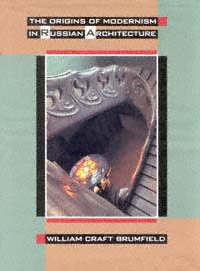 | The Origins of Modernism in Russian ArchitectureWilliam Craft BrumfieldUNIVERSITY OF CALIFORNIA PRESSBerkeley · Los Angeles · Oxford© 1991 The Regents of the University of California |
To my parents
Preferred Citation: Brumfield, William Craft. The Origins of Modernism in Russian Architecture. Berkeley: University of California Press, c1991 1991. http://ark.cdlib.org/ark:/13030/ft1g5004bj/
To my parents
Preface
Russian architecture from the Great Reforms of the 1860s to the 1917 revolution constitutes a prolific episode in a tradition marked by sudden radical shifts in style. During this period Russian society experienced intense, if uneven, change that included among its several ramifications innovative developments in technology, engineering, and the art of building. Yet the period lacks the dominant architectural style that distinguished, for example, the sixteenth and eighteenth centuries, when structure and ornamentation revealed the very spirit of an age.
The sixteenth and eighteenth centuries are not randomly chosen as exemplary periods, for it is precisely the idiosyncratic forms of sixteenth-century architecture, developed in the reign of Ivan the Terrible, and the post-Petrine classicism of the eighteenth and early nineteenth centuries that provided models for an architectural profession in search of a "unifying idea" at the end of the nineteenth century. Although the Russians developed construction methods to meet the needs of rapid urban expansion, Russian architecture, according to its many critics, produced only a formless, chaotic mixture of styles to conceal the monotonous designs of apartment blocks and commercial buildings.
By the turn of the century, however, architecture demonstrated a resurgent confidence, evident in the work of the protean "style moderne," or "new style." The style moderne, like much else in Russian culture of the period, developed from a mixture of tradition and innovation. In its very contradictions, it reflected the cultural disjuncture created by rapid change within the anachronistic social system of late imperial Russia. Although these developments paralleled those elsewhere in Europe during the industrial age, modernization (or "Westernization") in Russia operated with a force intensified by the country's material backwardness and—more important—by a perception of psychological and social differences between Russian culture and that of Western Europe. Even as Russia sought to assimilate the progressive features of a more highly developed technological society, the country both observed and reacted against the new age in Europe; attitudes included suspicion on the part of an officialdom that wished to contain European influence within narrow, technical boundaries and distrust of European spiritual values by certain segments of the Russian intelligentsia.
Yet for all its contradictory manifestations, the Russian reaction to modern European culture led to an extraordinary period of creativity represented by the work of Tolstoi, Dostoevskii, Turgenev, Repin, Mussorgskii, Rimskii-Korsakov, and other artists. Russian literature, music (including opera), and the visual arts rapidly passed beyond imitating and adapting Western forms and began to modify or even reject the conventions of European art. Challenged by the Western example, Russians redefined genre and method to convey what Dostoevskii called a "new word"—a refractory concept that included not simply a peculiar Russian perspective on Western civilization but also an affirmation of Russia's unique contribution to the development of a modern consciousness.
The tension between Russia's search for a national identity and its profound debt to Europe that created a productive environment in literature led also to a narrative emphasis in the other arts. In late nineteenth-century Russian paintings descriptive detail often contained a strong component of social criticism or historical commentary. Similarly, architecture created a text, in the form of a two-dimensional facade, to convey aesthetic criteria as well as to comment on the history and
values of past cultures—most particularly Russia's own. Despite frequent calls for rationalism in design and construction—a logical relation between material, structure, and ornamentation—the structure of major buildings in the late nineteenth century was usually obscured beneath a welter of pseudo-historical ornamental motifs that presumably expressed the national identity in architecture.
The Soviet scholar Elena Borisova interprets the Russian ornamental facade as an "encoded text," in which each decorative motif is a "word" in an "allegorical text." One need not equate text and image so rigorously in order to accept Russian architecture's subordination to textual interpretation during the latter part of the nineteenth century. Indeed, critical articles and project descriptions in architectural journals applied the textual approach by exhorting architects to incorporate in their work elements of the artistic heritage of the Russian people. Furthermore, public—and published— architectural criticism itself testifies not only to the status of architecture as an art form subject to analysis and interpretation, but also to the architectural profession's uncertainty about the meaning of style after the decline of neoclassicism.
Architecture thus had the worst of both worlds: stylistic features depended on expectations derived from a different, verbal, medium, and technical innovations were dismissed or concealed as irrelevant to creative expression. In fact there was no consensus as to what architecture should express. The buildings that received the most attention in the historicist Russian Revival style were theaters, museums, city government buildings, and churches—all of which had obvious uses for decorative references to the national past. Moreover, in Moscow the mercantile emporiums in the historicist style (such as the Upper Trading Rows on Red Square) reflected conservative or nationalist sentiments among the city's merchantry. But both eclectic and historicist styles were used most commonly in apartment buildings whose decorative stucco work conveyed only a sense of fashion and luxury in service to property owners and their tenants.
Architecture's confused loyalties did not, however, lead to a paralysis of creativity. The most florid of the eclectic buildings, such as Moscow's Historical Museum or the large apartment blocks of central Petersburg, played a part in making the colorful, exuberant architectural environment that still defines large areas of Moscow and Leningrad. Although excessive ornamentation was generally condemned as tastes and needs changed, tolerant observers—before the revolution and in recent Soviet scholarship—have noted that architectural eclecticism admirably filled the needs and aesthetic expectations of the times. Indeed, Russian modernist architecture in its early phases also showed a decidedly eclectic willingness to adopt decorative mannerisms from contemporary European styles of architecture and design: art nouveau, the Secession, Finnish "romantic nationalism," and others.
Furthermore, late nineteenth-century Russian eclecticism, despite its perceived irrationality, served as a point of departure for the development of new approaches to architectural design. The critical debates over the proper relation between style and function, ornament and structure, gave rise to far-ranging theoretical discussions whose ramifications would extend well into the twentieth century. Although it emphasized new materials and technology, and opposed ornate stuccoed facades, the style moderne in both Moscow and Petersburg was itself roundly criticized for a facile and indiscriminate borrowing of decorative fashions labeled decadent by conservative critics and superficial by representatives of the avant-garde. The Soviet Constructivist theoretician Moisei Ginzburg attacked all prerevolutionary architecture—that of the style moderne as well as the neoclassical revival—as idle inventions, with no firm sense of purpose or ideological base. From his point of view, prerevolutionary Russian modernism had squandered technological progress on an undirected aestheticism enthusiastic about decorative effects but unable to develop a concept of design for the new urban environment.
There is considerable justification for Ginzburg's view, quite apart from partisan politics. Isolated projects for suburban communities and garden cities, as well as designs for charitable institutions and hospitals, did little to alleviate the crushing needs of the poor in the major cities. In the absence of governmental funding for social reconstruction and public projects, Russian architects themselves depended on private capital. Moreover, with the attenuated development of Russian capitalism and the relatively small number of its middle-class beneficiaries, prerevolutionary architecture could do little to create the infrastructure for a modern, functional urban environment. Luxurious self-contained apartment houses and large commercial structures often relied on
their own sources of electricity and water and thus existed as enclaves of modernity within cities lacking some of the most basic public services.
Yet Russian architecture during the two decades before 1917 not only fulfilled the historical mission of all period styles but also embodied the aesthetic ideals that placed architecture firmly within the artistic revival of Russia's "Silver Age" and gave the art of building a distinctive voice of its own. In this respect one can speak of the parallels between architecture and the other arts, each one pursuing idealistic views of its relation to reality. Novels such as Andrei Belii's Petersburg and the poems of the Symbolists Konstantin Balmont and Aleksandr Blok portrayed a modern urban landscape of madness and alienation; but the new architecture complemented, instead of being defined by, literary Symbolism—which had itself rejected the linear narrative and socio-historical concerns of nineteenth-century realism.
The modern architectural style at its most distinctive combined a more versatile use of space (in both commercial and housing design) with an emphasis on structural decoration that had little to do with a historical program. Even the use of historical motifs in the "neo-Russian" variant of the style moderne appeared in a detached, "aestheticized," context. The aesthetic properties of building materials themselves were emphasized, and the crafts revival of the late nineteenth century led to such decorative devices as ceramic panels and elaborate mosaic work. Thus the new style paradoxically combined decorative aestheticism with modern technology and construction materials such as plate glass and ferroconcrete.
Although this paradox led some to criticize the style moderne as yet another architectural deception, the polychromatic fantasies and sculptured forms of the new architecture convey an extraordinary insight into the heightened emotionalism of Russian—and European—culture at the beginning of this century. Moscow's laroslavskii Station, rebuilt by Fedor Shekhtel in 1902 and still largely preserved on the exterior, and Shekhtel's Riabushinskii house are a part of that agitated spirit so perceptively described in the poetry of Blok and in Osip Mandelshtam's autobiography, The Noise of Time .
Indeed, the era seemed to express itself in a frenzy of sound, as in the music of Scriabin with its ecstatic and Promethean themes. No less appropriate as an expression of Zeitgeist are Schoenberg's post-Romantic compositions, performed in Petersburg with considerable success in concerts organized by the brilliant pianist Aleksandr Ziloti (the Petersburg premiere of Pelleas and Melisande , for example, occurred in December 1911). For many listeners, however, this music—and that of Stravinskii—would have testified to the collapse of aesthetics; and by the same token architectural critics during the decade before 1917 frequently described the proliferation of modern building styles as a cacophony.
Thus the period of this study ends as it began, in search of a monistic idea that would resolve social issues in architecture as well as questions of artistic identity. The all-encompassing idea proved elusive; but in the course of endless critical discussions architects in Moscow and Petersburg demonstrated a receptivity to new currents from the West and an ability to refashion them ingeniously to suit local conditions as well as the aesthetic ideals of architect and patron. Although the results were often picturesque or even trivial—if not positively grotesque—the stylistic revival at the beginning of the century nonetheless bequeathed heroic vitality and individualism to an age dominated by the monotony of social engineering.
A study of the evolution of Russian architecture and the origins of modernism inevitably requires certain choices—some of them difficult—of material. The stylistic movements discussed in the following chapters were represented in most sizable cities in the European part of the Russian empire, and major cities like Kiev, Nizhni Novgorod, and Kazan showed the pervasive local influence of these styles. Nonetheless, this study concentrates on Petersburg and Moscow as the centers of modern architectural development in Russia. Russian architects began their professionalization in these cities, where, moreover, the most varied and distinctive manifestations of both eclecticism and the Russian Revival (or pseudo-Russian) style occurred.
The critical discussions of historicism and eclecticism are the subject of chapter 1; these led at the turn of the century to a new stylistic era, whose pretensions were welcomed or reviled as a harbinger of social change. The cultural and architectural journals surveyed in chapter 2 not only publicized the work of Western architects such as Olbrich, Behrens, Guimard, and Mackintosh but also contributed to the development of Russian thought on the relation between architecture and society.
The polemics and ideas on the new architectural aesthetic often bore scant relation to the dynamics of construction in the modern style. As the material on Moscow in chapter 3 demonstrates, building projects during the period under study were usually funded by private capital, and the construction of apartment and commercial buildings often involved a contradictory relation between aesthetic idealism and financial gain. Yet the variety of innovative architectural forms testifies to the creative vigor that grew out of the relation between private patronage and talent in Moscow at the beginning of the century. The benefits of this relation and the accomplishments of the new style (as well as the onset of its decline) are most amply revealed in the career of Shekhtel, examined in chapter 4.
The style moderne in Petersburg differed considerably from that in Moscow, despite similar forms and the aesthetic ideas shared by the architects of the two cities. Chapter 5 traces the new style as it was influenced both by the capital's distinctive pattern of urban development and by the example of the remarkable Finnish school of architecture. Many of Petersburg's influential critics and architects viewed these developments with serious reservations, however, and chapter 6 is devoted to the reaction against modernism, exemplified by the revival of neoclassicism. Moscow had a similar movement, also discussed in these pages, but the ideology and the major impact of the neoclassical revival were very much products of Petersburg.
There is a balance in the course of this book between Moscow, the center of an idiosyncratic new style in architecture, and Petersburg, which ultimately rejected the style moderne through a renewal of Palladian or Empire forms ranging from the delicate and refined to the pompous and grandiose. Whatever the dominant, "unifying," idea, there is an undeniable pathos in the persistent attempts to create an architecture for a new society (based on capitalist or vague socialist principles) while the old was still in the throes of disintegration and the possibilities of revolutionary transformation were only dimly perceived. In this context the ideas, as well as the buildings, of Russian architects at the beginning of the century acquire a resonance that extends beyond the peculiarities of a local (and long-neglected) style to the central issues of architecture in our time.
Acknowledgments
My research in Russian neoclassicism led me to the unexpected, altogether pleasant, discovery of the varieties of Russian architecture from the late nineteenth century to the revolution. Although it was generally known that various eclectic architectural styles followed the decline of neoclassicism, these styles changed so rapidly that they seemed inconsequent in comparison with the neoclassicism that preceded them and the radical Soviet modernism that followed. I owe my deeper appreciation of this neglected turn-of-the-century era to a small group of Soviet scholars whose published work and personal efforts on my behalf persuaded me to explore a topic with so many cultural and aesthetic ramifications.
In particular I would like to thank Evgeniia Kirichenko, Vladimir Kirillov, Nina Smurova, and Sergei Romaniuk in Moscow and Iurii Denisov in Leningrad. They provided me with research sources and accompanied me on a number of architectural "expeditions" in both cities. In addition, I have benefited greatly from the writings of Elena Borisova, Tatiana Kazhdan, Valerii Isachenko, and Ivan Punin. Their work and that of other Soviet scholars has been of much assistance in my analysis of Russian architecture during the half century before the revolution; that my interpretation differs from their own (especially on the relation between architecture and Russia's developing capitalist system) makes me no less indebted to them.
A number of institutions have supported the writing of this book: the International Research and Exchanges Board, under whose auspices I spent six months in 1983–1984 as a senior research scholar at the Department of Art History, Moscow State University; the Tulane University Committee on Research; and the Kennan Institute for Advanced Russian Studies, Woodrow Wilson International Center for Scholars, which provided an ideal working environment throughout 1989. I also wish to thank the foundations whose generous support has done so much to enhance the appearance of this book.
For microfilm and photocopies of Russian architectural publications from the period of my study, I am grateful to the Library of Congress and the State Lenin Library, Moscow. Further assistance was provided by the Shchusev Architectural Museum, Moscow. The Gorkii Institute of World Literature and the staff at the Gorkii House Museum generously facilitated my work in photographing the magnificent interior of the Riabushinskii house. I would also like to thank Ambassador and Mrs. Arthur Hartman and Ambassador and Mrs. C. Robin Ashwin, the ambassadors to the Soviet Union from the United States and Australia, for permission to photograph the interior of their Moscow residences, the former Vtorov and Derozhinskaia houses.
For their efficiency in providing prints from negatives of my photographs, I am indebted to the staff at the Photographic Archives of the National Gallery of Art. The Department of Photographic Services at the Smithsonian Institution also did invaluable work in printing from copy negatives of prerevolutionary photographs. The Slavic and Baltic Division of the New York Public Library provided access to photographic material in its rich collection of prerevolutionary Russian holdings.
No task of this magnitude could be accomplished without the advice and support of colleagues. In this respect I wish to thank Catherine Cooke—a pioneer in the study of Fedor Shekhtel and the style moderne—for her generosity in sharing arcane but essential bits of information. Equally important have been the assistance and commentary of Milka Bliznakov, John Bowlt, Andrei Gozak, James Curtis, and S. Frederick Starr. At Tulane University, the Department of Germanic and Slavic
Languages facilitated my work in numerous ways, as did the Dean of the Faculty of the Liberal Arts and Sciences. Lori Hylton, research intern at the Kennan Institute, gave much assistance in preparing the final version of the manuscript. At the University of California Press, Stephanie Fay edited the manuscript with her most thorough and beneficial scrutiny, and Sheila Levine immeasurably enhanced whatever virtues this book may possess by her professionalism and editorial support.
W.C.B.
SEPTEMBER 1989
Author's Note
In transliterating from Russian I have used the Library of Congress system, modified by the omission of the soft sign (') in the body of the text. The non-Russian background of many architects in this study raised the question whether to transliterate surnames from the Russian or to revert to a Western form. Although either method, if rigorously followed, would be cumbersome and at times misleading, I have given preference to the transliterated form, which has the advantage of distinguishing Russian subjects of foreign ancestry from the numerous Austrian, German, French, and British architects mentioned in this book. In the case of certain Russified Germans, however, I have given the German form in parentheses after the first reference: Gogen (von Hohen), Kitner (Küttner), and so forth. And I have rejected transliteration where it distorts names (for example, those of such Russians of French descent as Benois and Lanceray) or ignores the subsequent biography of an architect like William Walcot, who left Russia after 1905 and resumed his career in Great Britain.
Almost all the architects whose work is the focus of this study were born in Russia, spent their entire careers there, and, as in the case of Vladimir Shervud (Sherwood), became ardent proponents of a Russian national style in architecture. It is appropriate to recognize these facts in the spelling of their names, which in no way disregards the diverse backgrounds that made Russian architecture at the turn of the century so remarkably vital.
One of the priorities in Western studies of Russian architecture must be adequate photographic documentation. For this book I have drawn such material from two sources. Some two hundred of the black-and-white photographs are reproduced from prerevolutionary Russian architectural publications. These superbly illustrated journals and albums are credited in the captions. Also included are a few prerevolutionary photographs from private archives. The remainder of the black-and-white illustrations and all of the color photographs in this book are my own. Where appropriate, the captions contain accession numbers for my black-and-white photographs now held in the Photographic Archives of the National Gallery of Art. This collection represents a substantial archival resource outside the Soviet Union; it can be used at the National Gallery for purposes of research in the history of Russian architecture.
Chapter One—
The Quest for a National Style
From the 1860s to 1917 the major cities in European Russia were substantially rebuilt. The central areas even of Moscow, which has since permitted extensive new construction in its center, and Leningrad, whose ensembles from the baroque and neoclassical periods overshadow less distinguished structures of later times, are largely the product of the five decades preceding the revolution. In the eighteenth and early nineteenth centuries, state and imperial patronage of architecture had achieved brilliant results in court palaces, buildings for the bureaucracy, and city plans that exemplified neoclassical order. As the role of private capital expanded, however, and as buildings were needed for an increasingly populous and economically complex urban setting, the Russian state and the imperial court lost their preeminence as the source of major architectural commissions. Concomitantly, critics began to condemn as alien and monotonous the great neoclassical harmony that represented the best of the imperial design of Petersburg.[1]
Although this transformation did not begin with the resign of Alexander II, his social policies of the 1860s and the era of the Great Reforms provided the underpinnings for both an enlarged, economically rational use of architectural resources and the development of professional organizations—from training institutes to architectural societies—to define and regulate the practice of architecture in a period of unprecedented growth.[2] These changes in the architectural profession did not ensure the construction of historically and aesthetically significant monuments, nor did they produce architects more proficient than their predecessors. Even the training of architects in the nineteenth century was not absolutely superior to that of the eighteenth, although advances in engineering introduced new possibilities in structural design for architects trained to make use of them.
Rather, the professionalization of architecture accompanied an increased demand for architects competent to construct various buildings (primarily in cities) for a diverse clientele in a cost-effective, reliable way that also, when necessary, met certain aesthetic expectations. In this respect Russian architects followed a path familiar to their counterparts in Britain, France, and Germany.[3] If the members of the Moscow and Petersburg architectural societies did not establish reputations as architects of genius, they nonetheless presided over profound changes that opened Russian architecture to the modern age.
These changes, however tardy in comparison with those in the more advanced countries in Europe, stimulated an increase in the number of architects, although building activity remained subject to the cyclical depressions that affected the Russian economy. Expanded opportunity, however, failed to foster the climate of excellence associated with earlier imperial architecture, in part because of a more "democratic" environment in
which the buildings commissioned were very different from those lavishly subsidized by the court. Here again, Russia reflected the broader stylistic confusion in European architecture during the nineteenth century.[4] In addition, Russian architecture continued to function amid the glaring economic and social contradictions that followed in the wake of the Great Reforms.[5]
However rapidly Russian architects assimilated new building methods after the 1860s (at least in the major cities), they applied advanced technologies and new materials on a smaller scale and less effectively in the 1870s and 1880s than did architects designing for comparable purposes in the major industrial powers.[6] Factory and commercial structure designs of the 1830s that had evolved elsewhere in Europe were re-created in Moscow and Petersburg four decades later. The transition from architecture for the court and the state bureaucracy to architecture for public and private structures built in a competitive environment demanded innovations of a system ill prepared to support them.
Although a number of Russian architects had, for example, used iron for structural purposes as early as the 1830s and 1840s, European advances in technology and structural design were generally of limited use in Russia, where local industry could not produce enough of the necessary materials. Nonetheless, Western and Central Europe continued as a model for those in Russia who recognized the need for a modern architecture.[7] Many Russian architects maintained the tradition, begun in the eighteenth century, of touring and studying abroad after formal studies in their homeland; and it is significant that one of the initiators of the Petersburg Society of Architects, Viktor Shreter, organized informal meetings of architects in 1862, after his return from three years of study at the Berlin Academy of Arts and an extensive tour of Europe.[8] Furthermore, Russian architectural schools, like those in the West, underwent reforms intended to improve the technical aspects of architectural training (cf Eugène Viollet-le-Duc's 1863 program for curricular reform at the Ecole des Beaux-Arts in Paris). The advances in architectural education at schools such as the Academy of Arts and the Institute of Civil Engineering in Petersburg and the Moscow School of Painting, Sculpture, and Architecture owed much to comparable institutions in Berlin and Paris.[9]
Whatever the limitations of tradition and technological backwardness, Russian architecture made impressive progress in meeting postreform social and economic needs, with the results still in evidence today (Fig. 1). Among the innovative structures were shopping arcades (or passages ), large enclosed markets, educational institutions, banks and other financial institutions, hospitals, public theaters, exhibit halls, hotels, and city administrative buildings (the result of a limited extension of local governmental authority in the later part of the century). The intensive construction of railway stations during the 1840s and 1850s continued in Moscow and Petersburg throughout the following decades as new lines opened and some of the early stations were demolished to make way for grander structures.
Although little work on Russian industrial architecture has been published, it is clear that the increasing needs of industry—notably, the metalworking factories—encouraged the development of engineering techniques for the construction of large interiors.[10] Similar techniques were applied to railway platform sheds. In addition to iron columns, long in use, iron and eventually steel beams and girders became essential in building large truss-supported roofs over unobstructed work space (Fig. 2). Considered more the province of engineering than of architecture, these advances, as well as the use of reinforced-concrete and skeletal-frame construction, proved aesthetically significant at the turn of the century, when the functionalism of industrial architecture began to appear in nonindustrial structures.
During the postreform decades, when the population of both Moscow and Petersburg grew rapidly, the greatest need was for housing. Petersburg, with not quite 500,000 inhabitants in 1858, increased to 667,000 in 1869, 861,000 in 1881, and 954,000 in 1890.[11] The rate of growth rose even more rapidly thereafter. Because most of the new inhabitants were peasants seeking work (many of them seasonally), the demand for solid, comfortable housing grew more slowly than the population. The lower classes of both cities lived in overcrowded and poorly designed buildings that rarely figure in histories of architecture.[12]
Nonetheless, the increase in the number and size of apartment buildings was impressive, particularly in Petersburg, which had less usable land than Moscow. According to the census of 1881, 19 percent of Petersburg's houses had one story, 42 percent two stories, 21 percent three stories, and 18 percent four stories.[13] An 1844 law prohibited any structure more than eleven sazhens (20 meters) high—the height of the Winter Palace. By the turn of the century apartment houses in
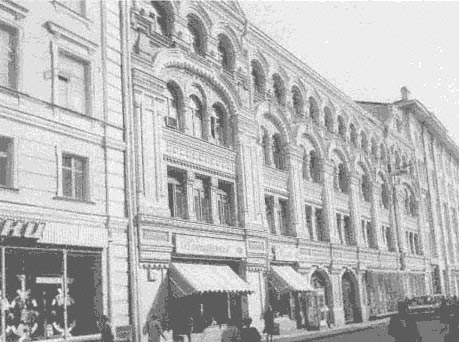
Fig. 1.
Karzinkin Building, Moscow. 1883. Ivan Bogomolov (Brumfield M133-70).
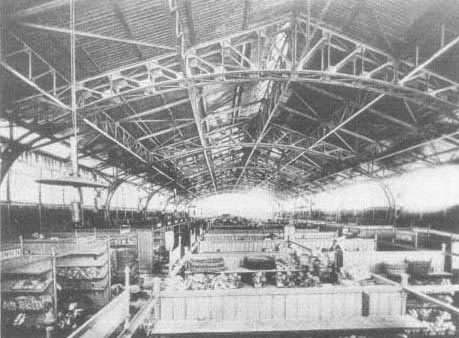
Fig. 2.
Covered market, Haymarket Square. Petersburg. 1883–1885. Ieronim Kitner, G. E. Pauker,
Otto Krel. Zodchii , 1888.
new districts of Petersburg moved toward the limits of this restriction, often in buildings of six stories, but there were no egregious violations of the standard.
Although advances in the design and construction of apartment buildings occurred in both cities, Petersburg's construction boom began earlier, in the 1860s; its disorienting effects, vividly described in Dostoevskii's Crime and Punishment , are still visible in central Leningrad. The rows of apartment blocks dating from the 1860s to the beginning of the century give an impression of stylistic chaos, mitigated by a more or less uniform building height. The facades are invariably flush against the sidewalk; an entryway leads to a small courtyard, or well, that provides light and ventilation for the less desirable interior apartments as well as entry to the various stairwells. The more prosperous the area, the more saturated with decoration the building facades.
Every major architecture style was imitated or paraphrased on the facades of commercial and housing structures in Petersburg during the late nineteenth century: neo-Renaissance, neobaroque, neo-Greek, Louis XVI, Russian Revival, and Moorish. Mixed or unrecognizable styles, however, may in fact have predominated. Most buildings were brick, covered with stucco, which could be adapted readily and cheaply to florid architectural ornamentation; but even so, only the better class of apartment building would have made any pretense to "style."
The Palace of Grand Prince Vladimir Aleksandrovich (Fig 3) represents the extreme of this penchant for stylized or eclectic design. It was constructed in 1867–1872 by Aleksandr Rezanov (appointed the first president of the Petersburg Society of Architects), along with Andrei Huhn, Ieronim Kitner, and Vladimir Shreter, all of whom were to play major roles in late nineteenth-century architecture. The exterior of the palace was rigorously formulated in the style of the early Florentine Renaissance, but the grand rooms ranged from Louis XVI to Gothic to Moorish and at least four other period styles.[14] As one observer has noted, the palace resembles the more luxurious apartment buildings along the quay where it is situated, and it was built with much the same attention to cost and materials: the rustication was stucco and many details were cast in portland cement.[15] Thus Russian imperial taste followed bourgeois taste during the final period when large palaces were still being built for the tsar's family in Petersburg.
The city's wealthiest citizens, however, themselves imitated the opulence of imperial palaces in the eclectic designs of their mansions. The Ratkov-Rozhnov house, a few steps up Palace Quay from the Palace of Vladimir Aleksandrovich, is one such imitation, though it is much smaller than the imperial dwelling (Fig. 4). The project originated in 1875 when the architect Karl Rachau was hired to rebuild the original early eighteenth-century structure on the site. But by the time construction was completed, in 1877, the building had become the property of V. A. Ratkov-Rozhnov, the mayor of Petersburg and owner of seventeen buildings in the city, many of them as eclectic as the house on Palace Quay, with its classical and baroque elements combined with "Egyptian" caryatids.[16] The major rooms of the Ratkov-Rozhnov house, like those in the Palace of Vladimir Aleksandrovich, were designed in a variety of period styles.
Because of a mania for redesigning facades in the latest style, historically significant buildings in Petersburg were defaced, prompting Dostoevskii to note sarcastically in his feuilleton Diary of a Writer for 1873: "More and more people are redoing their facades from old to new, for chic, for 'character.'"[17] In an excursus on Petersburg architecture—which he found lacking in character and susceptible to every imported fashion—he described the postreform building frenzy:
And here, at last, is the architecture of the modern, enormous hotel—efficiency, Americanism, hundreds of rooms, an enormous industrial enterprise: right away you see that we too have got railways and have suddenly discovered that we ourselves are efficient people. And now, and now . . . you really don't know how to define our current architecture. It's a sort of disorderly mess, entirely, by the way, appropriate to the disorder of the present moment. It's a multitude of extremely tall (the main thing is tall) apartment houses, extremely thin walled and cheaply built (they say), with amazing architecture on the facades: here we have Rastrelli, there the late baroque, over here the balconies and windows of some doge, always oeil de boeuf [windows], and always five stories, and all this in the same facade.[18]
The passage concludes with a half-educated property owner's demand that his architect design windows to make his cut-rate building resemble the mansion of a Venetian doge.
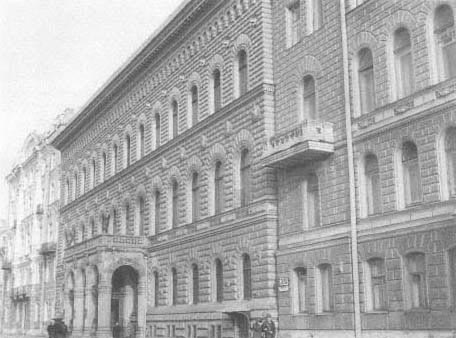
Fig. 3.
Palace of Grand Prince Vladimir Aleksandrovich, Petersburg. 1867–1872. Aleksandr
Rezanov (Brumfield L34-8).
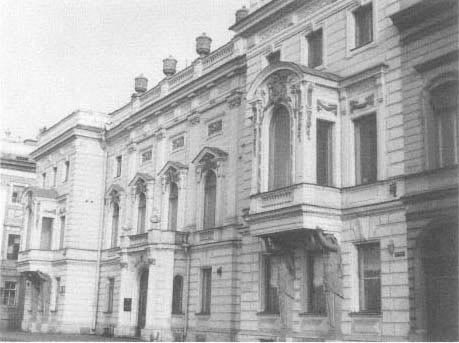
Fig. 4.
Ratkov-Rozhnov house, Palace Quay, Petersburg. 1875–1877. Karl Rachau (Brumfield
L34-11).
Dostoevskii caught the "disorder of the present moment" more acutely than any professional critic. Although the eclecticism he described had begun in Russia before the 1860s, the economic factors he alluded to played an ever greater role during the postreform expansion. To construct more buildings required more professionals who could re-create period styles—if only superficially, on a stuccoed facade. The press—both architectural and lay—noted the saturated facade decoration, initially more pronounced in Petersburg than in Moscow. Architecture increasingly became a matter of public taste and discussion.[19]
Nowhere was this discussion more faithfully recorded than in Zodchii (Architect).[20] Although this journal during the mid-1870s reveals a considerable difference of opinion about the aesthetics of the eclectic facade (again, primarily in Petersburg), it also suggests an awareness of how financial considerations determined the form of housing, which was in effect a commercial product, directed toward pleasing a "public" rather than a patron of art (the usual Russian term for "apartment house"— applied to the prerevolutionary period—translates literally as "profitable or profit-making house" [dokhodnyi dom ]). In an 1875 issue of Zodchii , the architect 1. Merts discussed the work of Petersburg's most prolific designer of eclectic apartment houses, Mikhail Makarov (1829—1873), whose extensive work during the decade preceding his death provided a standard by which the apartment house could be measured. Merts noted in particular his late colleague's success with the public:
Our public liked Makarov. He was one of the first to begin building really original, unique apartment houses that, strictly speaking, could not be related to any one architectural style; but he apparently brought a new element into the creation of houses, and everyone liked him. With his buildings he achieved an obvious superiority over those who affirmed: "We don't need facades; we need a profitable house."[21]
As in Dostoevskii's comments two years earlier, in Merts's account the crude financial speculator spoke, here denying the value of architecture altogether. But Makarov's work, much of which still exists, was no less calculated to produce financial rewards; it simply produced them more stylishly.
An architecture unrelated to any particular style (a pastiche, in other words) seemed desirable to an unidentified critic writing later that year in Zodchii : "The worship of one or another style at the expense of all other directions is harmful to the development of art, because it does not give space to the artist's creativity and usually forces him into trivial borrowing from ready-made motifs and forms." This critic used the term unique , as Merts had used it, praising the free choice of eclecticism[22] and, in effect, linking creativity to the design of commercially successful decorative styles.
But for another of Zodchii's critics in 1875, eclectic decoration had gone too far. Again, Makarov's work offered an illustration: "Everything should have reasonable limits, beyond which one must not go unpunished; for all their effectiveness and beauty, the late Makarov's facades for the most part suffer from a confusion redeemed only by the daring and originality of design provided by a talented hand."[23] The saturated facade, "without a single breathing space," had far exceeded those reasonable limits (Fig. 5); yet it remained "unpunished," apart from an ineffectual rebuke by one of Russia's most prominent cultural critics, Vladimir Stasov:
[Eclecticism] is architecture copied from old models, from books and albums, from photographs and drawings, the architecture of clever people who get smart in class and then with great indifference turn out goods by the yard and by the pound. . . . If it suits you, here are five yards of Greek "classicism"; if not, here are three and a quarter of Italian "Renaissance." Don't like that? Well then, here, if you please, is a little piece of the highest sort of "rococo Louis XV," and if that's not it, here is a nice bit of "Romanesque," six ounces of "Gothic," or a whole gross of "Russian."[24]
For Stasov the architect purveying such architecture-from-the-shelf was like an unscrupulous shopkeeper selling goods to a fickle client. Much of the architectural commentary of the period, from Dostoevskii to Stasov, implicitly questioned the extent to which professional architects had become calculating merchants, with little purpose in the design of buildings beyond pleasing their clients and the public with decorative effects (Fig. 6).
The public had become architectural arbiter to a degree unthinkable before the 1860s, when the periodical press began to enjoy both rapid growth and a measure of official tolerance. From the first, short-lived, architectural publication Arkhitekturnyi vestnik (Architectural

Fig. 5.
Apartment house, Konnogvardeiskii Street, Petersburg. Ca. 1870. Mikhail Makarov
(Brumfield L35-1).
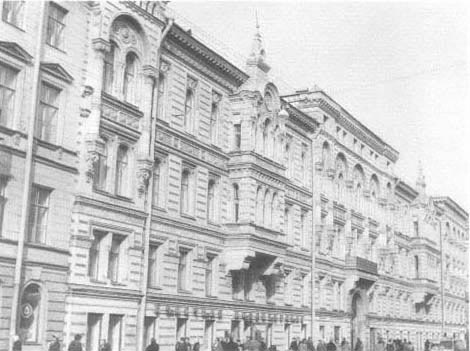
Fig. 6.
Tupikov apartment house, Petersburg. 1876–1877. Iurii Diutell (Brumfield L42-8).
messenger, 1859–1861) to the various journals for both professional and general readers at the turn of the century, public commentary on the art of building had become a substantial enterprise. Moreover, architectural critiques appeared in journals ranging from Grazhdanin (The citizen, Dostoevskii's forum in 1873) to Mir iskusstva (The world of art) and Apollon at the beginning of this century.
The role of public opinion was welcomed by some, including the critic who insisted that excess—everything beyond "reasonable limits"—be punished. In his view the public should be given even more information. Architectural drawings, for example, should be published before construction begins so that the public can discuss the merits of a building:
We are, as it were, afraid to heed the strict but fair judgment of our work or to accept good advice. Is it not understandable then that we [architects] meet everywhere with indifference when we let masons and plasterers participate in creating architectural works but present our creations to the public at a point when it can only look at them or turn away.[25]
This remarkable advocacy of public involvement in architectural planning had little effect on the design of buildings, but the critic's belief that architects need the advice of the public to decorate a facade demonstrates his lack of confidence in the architectural profession. The implicit corollary of an appeal to the public's "strict but fair" judgment was that architects themselves would educate the public taste. Nevertheless public opinion— as projected by the press—played a role not only in developing the architect's professional image but also in the consequent confusion of purpose and aesthetic direction so frequently noted by critics throughout this period.
The mood of frustration and confusion, if not selfpity, is expressed by another architect-critic, V. Kuroedov, who wrote in Zodchii in 1876 on his impressions of architecture in Berlin. The Russian architect was in a poor position vis-à-vis the German:
With us an architect is a hireling, obligated for his remuneration to fulfill someone else's will without thinking; with us, in short, architecture and its practitioners enjoy no respect, rights, or support on a par with those of other specialists; and finally, with us, anyone who has read some architectural notes—or even not read them—boldly announces himself a specialist.[26]
Kuroedov, intolerant of "strict but fair" public involvement in architecture, related the development of professional identity to a rigorous defense of professional prerogatives. His commentary is particularly interesting for its reference to "other specialists," unidentified, whose professional rights and artistic integrity were undisputed. The speculative capitalism that had fostered professionalism in architecture had also become, in the view of many, its bane.
The preceding analysis has focused on Petersburg because of the active role played by the Petersburg Society of Architects and its journal, Zodchii , in defining architects' professional responsibilities. In addition, the concentration of building activity in Petersburg placed greater demands on the profession from the 1860s to the 1880s, revealing the contradictions between the aesthetic ideals of architecture and the economic conditions in which architects worked. As Petersburg continued to grow in the twentieth century, the contradictions remained unresolved. By contrast, in Moscow the effects of architectural innovations during the postreform era were less pronounced. Although Moscow grew as rapidly as Petersburg—the population of the city proper more than doubled between the early 1860s and 1897, from approximately 400,000 to almost 980,000—and its economic growth continued during these decades,[27] the effects were less noticeable there. Because Moscow covered a greater area and had both fewer government institutions and a smaller population (Petersburg in 1881 had 861,000 inhabitants; Moscow in 1882 had 753,000), construction itself was less dense than in Petersburg.
As a result, Moscow's architects did not confront the intensely commercial demands made on those in Petersburg, who designed blocks of speculative buildings, densely constructed and saturated with facade ornamentation. To be sure, eclecticism and historicism also pervaded Moscow, but historicist designs there focused on medieval, pre-Petrine architectural monuments in the city, from the Kremlin and Red Square to the churches in every neighborhood. The ready adaptation of the idioms of medieval Muscovy to the city's architecture during the 1870s and 1880s—stimulated by the historical displays at the 1872 Polytechnic Exhibition and the 1880 All-Russian Arts and Industry Exhibition
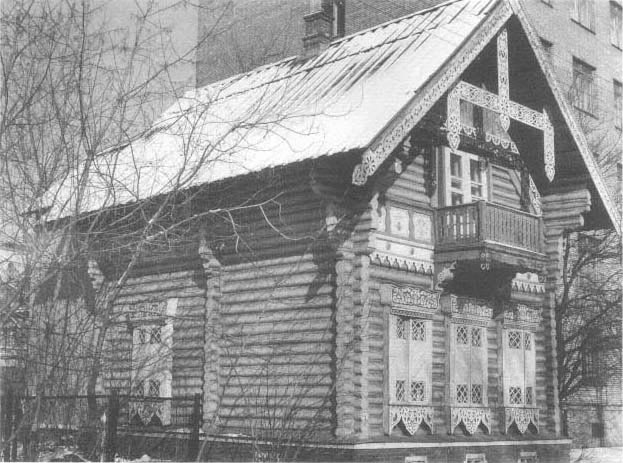
Fig. 7.
Pogodin Izba, Moscow. 1850s. Nikolai Nikitin (Brumfield M74-4).
(both held in Moscow)—frequently led to the saturated application of decorative motifs from the sixteenth and seventeenth centuries. Yet the pre-Petrine revival had its more profoundly creative effects as well, particularly in the architectural experiments at Abramtsevo; but these went largely unnoticed by the profession during the 1880s.
One of the earliest examples of the revival of a Russian vernacular style is Nikolai Nikitin's design of the Pogodin Izba (or hut) for the estate of the prominent historian and writer Mikhail Pogodin. Nikitin (1828–1913), who would later serve as first secretary of the Moscow Architectural Society, created a charming but highly abstracted interpretation of a square log cottage, decorated with elaborately carved bargeboards and window surrounds (Fig. 7). Though artificial, this design for a specialist in Russian history—whose work had a significant impact on nineteenth-century Russian intellectual life—showed that architecture could revive the past and could link traditional Russian culture to the new urban environment.
Among the examples of the wooden vernacular style revived in Moscow during the 1870s, Andrei Huhn's house for the Moscow merchant Aleksandr Porokhovshchikov (1872) is notable for re-creating the decorative and structural elements of traditional wooden architecture, albeit with inside plumbing (Fig. 8).[28] The style here, as in the Pogodin Hut, had an underlying logic. Porokhovshchikov was a leading member of the Slavic Committee, formed to support the liberation of the Balkan Slavs from Turkish rule and, coincidentally, to extend Russian influence into the area under the guise of
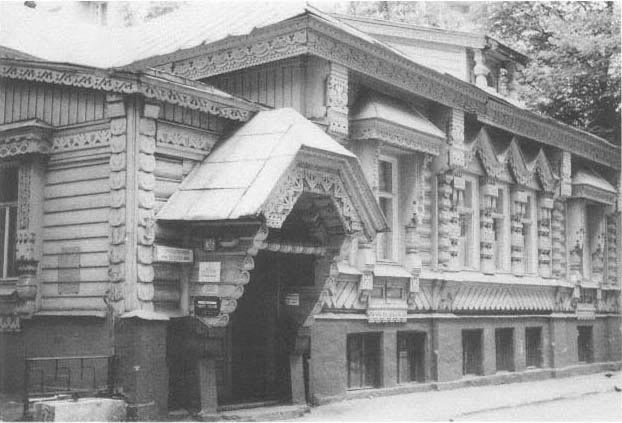
Fig. 8.
Porokhovshchikov house, Moscow. 1872. Andrei Huhn (Brumfield M150-34).
Pan-Slavism.[29] As a major contributor to the nationalist cause, Porokhovshchikov presumably chose the traditional Russian style as a programmatic statement with ramifications beyond the vagaries of eclectic fashion. Concurrently, Huhn had been working with Rezanov in Petersburg on the Palace of Vladimir Aleksandrovich, with its assortment of borrowed styles (including pseudo-Russian). The interpretation of style as part of a broader cultural pattern during the 1870s and 1880s gave the architecture of Moscow, however, more aesthetic coherence and direction than that of Petersburg, where the bureaucracy distrusted the Pan-Slavic movement and where there were few examples of either traditional or pre-Petrine Russian architecture.
Besides merging ideology and culture, the Porokhovshchikov house occupied a plot of land large enough so that the structure, in the very center of Moscow, could be seen in three dimensions. With more land available, architects in Moscow could design structures in the round as well as facades; and although the situation would change toward the end of the century in the city center, architecture in Moscow continued to achieve a depth and plasticity suggestive of medieval architecture. These two qualities, combined with the cultural mission expressed in Russian nationalism, helped to shape Moscow's major architectural monuments during the final decades of the century.
Among these projects, the Historical Museum (1874–1883) is the most imposing and one of the earliest. Both the collection and the impetus to house it derived from the Polytechnical Exhibition of 1872, many of whose display pavilions were located near the eventual site of the museum. The museum was to express Russian historical consciousness on a site in the shadow of the Kremlin walls—an intention clearly conveyed in the announcement of the project competition and the descriptions of the proposals submitted. One account, in the newspaper Golos (Voice) in 1875, noted: "The mu-
seum will tell us loud and clear exactly who we were, who we are, what our worth is as a people, and consequently what place belongs to us in the family of nations of the civilized world. Here is the political meaning of the museum."[30] The same account stated that the winning design had been inspired by the monuments on Red Square (The Kremlin towers and the Cathedral of the Intercession, popularly known as St. Basil's), as well as various sixteenth- and seventeenth-century monuments in Muscovy.
Although the Historical Museum itself may not reflect faithfully the spirit of its medieval antecedents, the competition proposals demonstrate that architects had assimilated motifs from the history of Russian architecture.[31] With the founding of the Moscow Architectural Society by Mikhail Bykovskii, architectural historians—an increasingly vocal group—began to interact with professional architects. Indeed, one of the finalists in the museum competition was both a historian and an architect—Lev Dahl, whose father was the famous ethnographer and lexicographer Vladimir Dahl.[32]
The winner of the competition to design the Historical Museum was, in an irony occasionally visited upon nationalist undertakings, of foreign descent: Vladimir Shervud (Sherwood; 1832–1897), a graduate, in 1857, of the Moscow School of Painting and Sculpture. During his early years as an art student he became acquainted with a group of Moscow intellectuals and artists sympathetic to the Slavophile movement, among them Iurii Samarin, Mikhail Pogodin, Nikolai Gogol, and Ivan Shevyrev. Shervud's account of his meetings with this group reveals that he too came to advocate a renewed Russian sense of identity that could be interpreted in the arts.[33] He thus understood the significance of the Historical Museum and the need for a historical interpretation of the building.
To be sure, the symmetry of his sixteenth- and seventeenth-century decorative motifs had little of the sculpted plasticity of medieval architecture, whose visual impact and structural logic is based on design "in the round" (Fig. 9). Because the museum was located on an elongated site at the northwest entrance to Red Square, with relatively narrow passages on both sides, it has one main facade facing Red Square and another facing Okhotnyi Riad at the exit from Red Square (see Plate 1). In Shervud's design, each facade is a balanced, two-dimensional surface, with projecting porches and towers and medieval decorative elements in bold relief (Figs. 10, 11).
Under pressure to create an emblem of national identity, Shervud designed these facades as an architectural "text" with as many historical (archaeological) references as possible. The result, fragmented and busy with detail, contrasts with the Kremlin towers, austerely monumental, and Saint Basil's, which has a complex centralized plan. Even by the standards of Shervud's contemporaries, the strictly symmetrical adaptation of Russian motifs is cautious—particularly when compared with interpretations of the revived Russian style by Ivan Ropet (Petrov) and Viktor Hartmann (Fig. 12). Many of their most interesting designs were large temporary wooden structures for fairs and exhibitions, such as the People's Theater by Hartmann at the 1872 exhibition. Although few of the structures remain, the architects' drawings and sketches reveal the freedom with which they incorporated traditional Russian decorative elements into asymmetrical plans often echoing the forms of pre-Petrine architecture.[34]
For all the rigidity of Shervud's interpretation of architecture as national identity, the Historical Museum succeeds as an imposing counterweight to the other monuments on Red Square and thus achieves an accord with history. The interior halls were designed and decorated by a collective of artists (including Viktor Vasnetsov) and historians, who chose decorative materials appropriate to the periods of Russian history and prehistory.[35] The structural work and the complex interior plan were supervised by the engineer Anatolii Semenov, who had served as secretary of the Moscow Architectural Society in 1871–1872.
Apart from its stylistic legacy, the Historical Museum demonstrated the aesthetic properties of unsurfaced brick. Earlier exposed-brick structures of the nineteenth century in Petersburg and Moscow were usually utilitarian (for example, Petr Tamanskii's Kronwerk for the Peter-Paul Fortress, 1850–1860). Virtually all other important brick buildings were stuccoed, as they had been since the beginning of the eighteenth century, with Moscow following the example of Petersburg. Moscow's brick churches and secular structures were often painted or whitewashed before the time of Peter the Great, but the texture of the brick remained visible. With the founding of Petersburg, stucco became widely used for both aesthetic and protective purposes. (The Cathedral of SS. Peter and Paul and Peter's Summer Palace, both designed by Domenico Trezzini during the second decade of the eighteenth century, are among the first examples of stuccoed brick.)
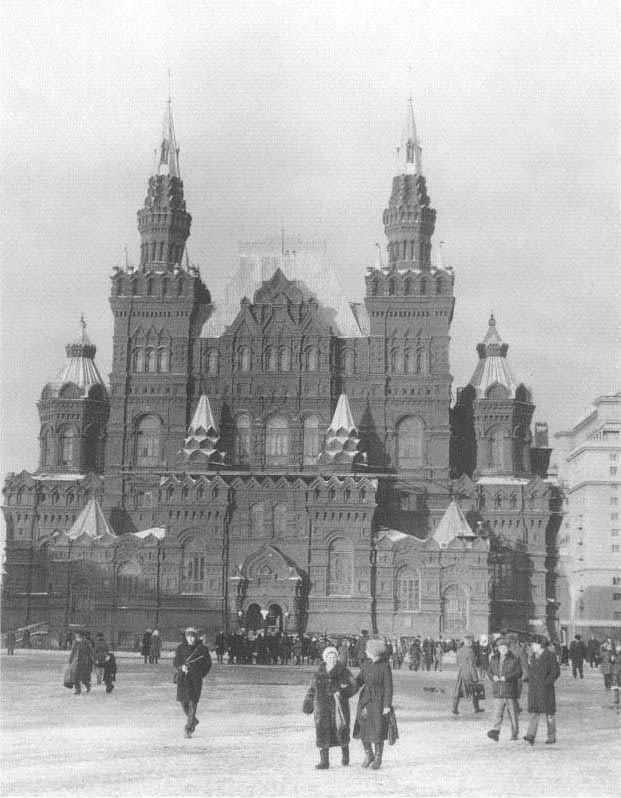
Fig. 9.
Historical Museum, Moscow. 1874–1883. Vladimir Shervud. South facade (Brumfield M104-2).
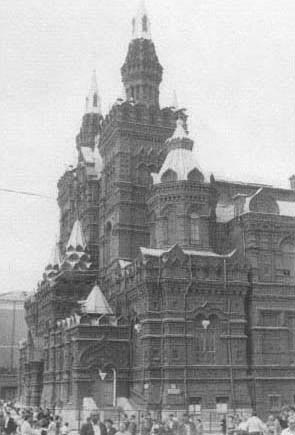
Fig. 10.
Historical Museum, southeast corner (Brumfield M159-30).
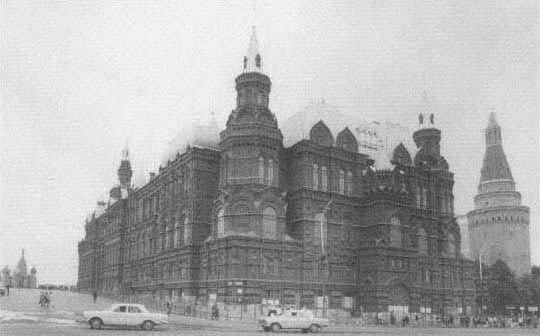
Fig. 11.
Historical Museum, north and east facades (Brumfield M158-3).
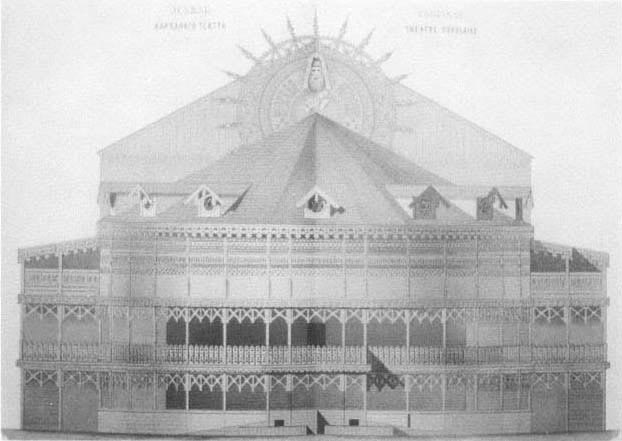
Fig. 12.
People's Theater for 1872 Polytechnic Exhibition, Moscow. Viktor Hartmann. Motivy russkoi arkhitektury , 1875.
Courtesy of the Library of Congress.
In creating the massive brick facades of the Historical Museum, Shervud contributed to the revival of unstuccoed brick as an aesthetic material, cost-effective yet rich in associations with medieval Russian architecture. During the 1880s a number of buildings with brick facades arose in Moscow, the most successful among them Mikhail Chichagov's design for the Korsh Theater (1884–1885). Chichagov made sensible use of Russian decorative and structural elements (such as the pointed decorative gable, or kokoshnik ) but also exploited the plasticity of brick to emphasize the depth of his building and its mildly asymmetrical distribution of shapes (Fig. 13).
On other buildings in the Russian Revival style, however, decorative motifs were applied on a smooth facade of stuccoed brick. The design work for the Polytechnic Museum (1873–1877)—another institution whose origins were linked to the 1872 exhibition—like that for the Historical Museum, was divided between the architect of the facade, Ippolit Monighetti, and the structural engineer, Nikolai Shokhin (Fig. 14). Shokhin, incidentally, presided over the Moscow Architectural Society from 1872 to 1875 and supervised the architectural section of the 1872 Polytechnical Exhibition—an indication of the increasing role of engineers in architecture.[36]
The historical associations that justified the extensive use of plain red brick in Moscow also made possible a more rational and less ornamental use. By the turn of the century, Moscow architects such as Lev Kekushev and Fedor Shekhtel would use brick as a primary aesthetic medium of the style moderne. In the 1870s, however, Petersburg provided the strongest advocates of a "brick style" that related structural function to aesthetics. Although most of the city's nonindustrial buildings
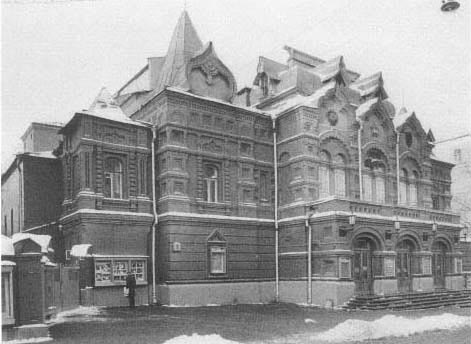
Fig. 13.
Korsh Theater, Moscow. 1884–1885. Mikhail Chichagov (Brumfield M133-33).
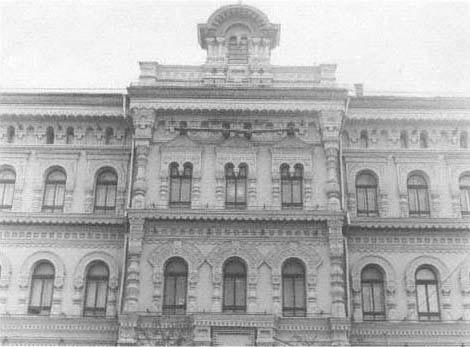
Fig. 14.
Polytechnic Museum, Moscow. 1873–1877. Ippolit Monighetti, Nikolai Shokhin
(Brumfield M54-9).
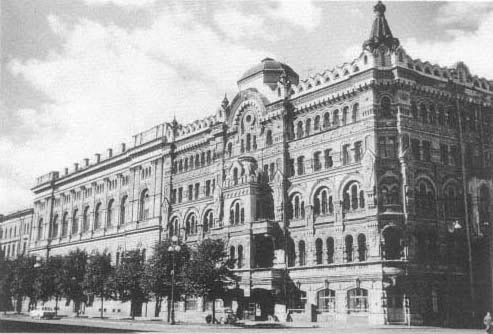
Fig. 15.
Petersburg Credit Society apartment house ( left ). Ca. 1875. Viktor Shreter, E. Kruger. N. P.
Basin apartment house (right ). 1878–1881. Nikolai Basin, Nikolai Nikonov (Brumfield M157-0).
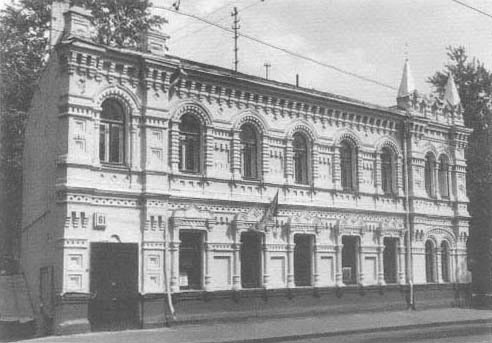
Fig. 16.
House, No. 61 Bolshaia Ordynka, Moscow. Ca. 1880 (Brumfield M70-7).
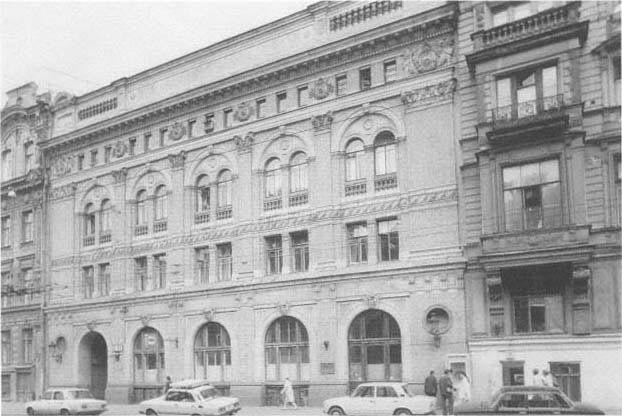
Fig. 17.
Stohl and Schmidt Building, Petersburg. 1880–1881. Viktor Shreter (Brumfield L86-29).
maintained the local tradition of applying stucco over brick (Fig. 15), in Petersburg the very lack of brick medieval monuments freed architects to use brick without the colorful pseudo-historical ornament characteristic of Moscow architecture (Fig. 16).
One of the best examples of the nonhistoricist use of brick is Viktor Shreter's apartment house for V. F. Strauss on Vasilevskii Island (1872).[37] Shreter advocated brick without stucco for its "durability, originality, and rationality [ratsionalnost ]"; it was also economical and relatively easy to maintain.[38] In addition, Shreter demonstrated by using different colors of brick in abstract decorative patterns that the material need not be monotonous or oppressive (Fig. 17). In "Brick Architecture," published in Zodchii in 1872, Ieronim Kitner joined Shreter in advocating a brick style. Like Shreter, Kitner fastened on the word rational to connote qualities opposed to eclecticism, whose florid decoration was particularly well suited to stucco. "A facade of brick facing is incomparably more rational than one of stucco. In our climate a structure with brick facing has greater durability and can be erected in a much shorter period."[39] The architect-critic V. Kuroedov also predicted a great future for brick because of its structural qualities rather than its decorative uses.[40]
Although for Kitner and Shreter the meaning of the terms rational and rationality cannot be equated with the rationalism of the 1920s (in the work of Nikolai Ladovskii and others), they and other proponents of the brick style in the late 1870s nonetheless understood the relation between the functional and aesthetic qualities of such materials as brick, iron, and glass. Both Kuroedov and Kitner were disciples of Apollinarii Krasovskii (1816–1875), the leader in Russian architectural education during the nineteenth century. Krasovskii's textbook Civil Architecture , first published in 1851 and reissued in a second edition in 1886, served as a bible for generations of Russian civil engineers and architects, many of whom studied under him during his thirtyseven-year tenure at Petersburg's Construction School.
(In 1882 the school became the Institute of Civil Engineers as part of an upgrading that Krasovskii had long supported.)
Most of the professionals influenced by Krasovskii built to meet the demands of their clients or the market; they had little reason to pursue the theoretical implications of functionalism Krasovskii presented in the first pages of his book. Indeed, many of the book's illustrations of decorative details seem well suited to the eclectic fashion. Nonetheless, architects and theoreticians who wished to integrate material, structure, and design found support in Krasovskii's views:
Architecture should not tend exclusively toward either the useful or the beautiful; its basic rule is the transformation of the one into the other. . . . Tectonics or construction is the main source of architectural forms. The role of art in the composition consists only in conveying artistic finish to the crude forms of tectonics. . . . The property of a material and the best possible means of applying it determine the means of construction, and construction itself determines the external form of both parts and buildings.[41]
After defining his own approach, Krasovskii categorized architects by their ideas of style: the classicists, the romantics (inclined to the Gothic or the neo-Byzantine), and the rationalists (subdivided into the aesthetes and the technologists), with whom his sympathies lay, although he wished to steer a course between the aesthetes, who placed form above structure, and the technologists, who emphasized the role of function and structural logic over form.[42] Krasovskii's theoretical emphasis on the rational and functional countered what some architects and critics saw as a chaos of borrowed styles.
Krasovskii was equally significant for creating and guiding the new professionalism in Russian architecture, both by teaching and by providing reinforcement for those who wished to reassert the values underlying the practice of architecture. Although interpretations of Krasovskii's terms differed—especially his concept of rationalism, which proved capable of sheltering diverse points of view—the very framing of these issues and their debate in a professional context were tributes to his pervasive influence.
The disparate views of rationalism are particularly evident in the career of one of Krasovskii's most accomplished students, Nikolai Sultanov (1850–1908), who graduated from the Construction School (Stroitelnoe uchilishche) in 1873 and subsequently taught architectural history and theory in Petersburg's institutions of higher learning. Despite Sultanov's allegiance to Krasovskii's concept of the rational in architecture, like many Russian intellectuals of his time he related his professional practice to broader social and cultural questions. In a speech delivered in 1882 at the opening of a new building for the Construction School (now the Institute of Civil Engineering), Sultanov seemed to draw verbatim from Krasovskii's Civil Architecture , emphasizing function and the careful realization of structure. He then called, unexpectedly, for spiritual values transcending the material, and praised the "Russian style" (with its practical reliance on brick): "The new national movement does not contradict our banner—that of the rational movement—but actually coincides with it."[43]
This was not the first time that Sultanov had publicized such views; and Krasovskii's writings even supported his suggestion that architectural decoration could be based on archaeological and historical criteria.[44] Sultanov was a serious student of medieval Russian architecture and felt that it best represented the national genius (see Plate 2). Nonetheless, for those who interpreted rationalism more strictly, Sultanov's speech was an apostasy, announced at an institute established to provide the highest technological training. When the speech was published in Zodchii in May 1882, S. Zosimovskii, a civil engineer, quickly responded, writing in the following number of the journal that artistic concerns are "an abnormal phenomenon for civil engineers," and irrelevant to technology.[45]
Although Sultanov's and Zosimovskii's interpretations of the rational in architecture were incompatible, architects and engineers did not rigidly differentiate their work, nor were engineers inevitably "anti-aesthetic." Krasovskii's career had shown the possibility of common interests, and Sultanov himself would serve as director of the Institute of Civil Engineers from 1895 to 1903. Furthermore, the brick and Russian revival styles in the 1880s and 1890s combined with a vitality and originality that would not have displeased Krasovskii—particularly in buildings such as private houses, which had no complex technical requirements. Nonetheless, building large commercial and industrial structures in Russia's major cities required an ever greater reliance on technology—whatever the facade—and on architects and engineers who understood functional design. If architecture was to become professionalized, institutions
were needed to train architects. It is appropriate at this point to survey the progress of these institutions during the late nineteenth century.
Formal architectural training in Russia began in schools with limited autonomy and resources; only when these schools were transformed into fully accredited centers of higher technical and artistic education would a modern architectural profession develop. Although attempts to instill rigor into the training of architects date from the time of Peter the Great, an extensive, if still far from perfect, system of professional education did not develop until the end of the century.
In Petersburg the oldest center of architectural education was the Imperial Academy of Arts, founded in 1757 as an appendage of Moscow University and granted institutional autonomy by Catherine the Great in 1763. In 1859 the academy established one curriculum for painters and sculptors and another for architects, who were required to study mathematics, physics, and chemistry. This introduction of a technical approach to architecture did not, however, change the primary emphasis of the academy's architectural program on style and design.[46]
Because of its long traditions and imperial support, the academy remained the capital's most prestigious institution for architectural study; a large number of its graduates were among the architects practicing at the beginning of this century. Depending on the extent of their studies, graduates were designated either unclassed artists or classed artists of architecture of the third, second, or first degree (the last awarded to the academy's Gold Medal recipient). After 1893, the classifications were architect-artist or artist-architect, with the former the more qualified in architecture.[47]
The other major institution for architectural education in Petersburg was the Institute of Civil Engineering, which emphasized the technical elements of construction. The institute derived from two schools founded during the reign of Nicholas I: the Architects' School (1830), emphasizing the arts, and the School of Civil Engineers (1832), concentrating on mathematics and engineering. The schools merged in 1842 to form the Construction School, organized on a military basis. After various reforms in the 1850s, the school was transferred to the Ministry of Internal Affairs in 1865 and relieved of its quasi-military status. In 1877 it obtained official ranking with the country's other institutions of higher technical education, as well as a new charter designed to ensure that its five-year course of study would produce competent engineers. (Those entering the school were expected to have completed studies at a gymnasium or realschule.) In 1882, with newly expanded facilities, the school was designated the Institute of Civil Engineering. Between 1842 and 1892 only 1,020 students graduated from the school; in 1892 alone, however, 222 students were enrolled.[48]
Graduates of the institute were given the title civil engineer (changed at the beginning of the century to civil engineer-architect, in the constant wordplay of professional identity and prestige). A number of them were to help shape Petersburg's environment in the two decades before 1917. A recently published list of 390 architects active in Petersburg at the beginning of this century indicates that 168 studied at the Institute of Civil Engineering, with almost all of them graduating, and an equal number graduated from the Academy of Arts. (Eight of those listed attended both institutions.) Of the remaining 62 architects (and engineers) some attended other schools, such as the Riga Polytechnic Institute and the Moscow School of Painting, Sculpture, and Architecture, or were certified by boards of examiners by virtue of their professional qualifications.[49]
Other technical institutions in Petersburg included architecture in their curricula: the Institute of Transportation Engineers, the Mining Institute, the Technological Institute, and Petersburg University. Their teaching staffs occasionally included faculty from one of the major architectural institutions. Apollonarii Krasovskii, for example, taught at the Institute for Transportation Engineers, the Mining Institute, and Petersburg University in addition to his permanent duties at the Construction School. Ieronim Kitner divided his teaching between the Construction School and the Institute of Transportation Engineers. Perhaps no one showed a greater diversity of pedagogical interests than Nikolai Sultanov, who began his career at the Construction School, taught architecture at the Technological Institute (1877–1884), lectured on medieval Russian architecture at the Archeological Institute (1882–1885), and served as director of the Institute of Civil Engineering.[50]
In Moscow the primary center for architectural training during the nineteenth century was the School of Painting, Sculpture, and Architecture, which dates from a series of art classes begun in 1832 and formally organized into the School of Painting and Sculpture in 1843. The architectural component was added in 1865,
when the Architectural School of the Moscow Court Office joined with the School of Painting and Sculpture.[51] Here, as in Petersburg, the curricula for architects and civil engineers emphasized the study of classical architecture and the architectural orders, particularly as interpreted by Vignola and revived by the Renaissance. This emphasis provoked a pedagogical debate in 1905, with opponents claiming its irrelevance to technological innovation; but the grounding in classical architecture undoubtedly refined the style of some of Russia's most distinguished architects at the beginning of the twentieth century.
Another Moscow institution destined to play an increasingly important role in the development of Russian architectural design was the Stroganov Arts and Crafts School. Founded in 1825 by Count Sergei Stroganov as a drawing school for children ten years and older, the school received official recognition in 1843 and in 1869 became the Stroganov School of Technical Design. Although it emphasized the applied arts, its students were frequently involved in architectural projects. Ippolit Monighetti was one of the first to complete the school's six-year course, in 1835.
In Moscow, as in Petersburg, architects frequently trained as apprentices and were subsequently accredited by examination boards. Recent graduates could make the transition from architectural school to professional practice by affiliating with senior architects and by participating in open architectural competitions. The juries in these competitions analyzed the technological and design specifications in projects by both experienced architects and novices; and since a jury's response to major project competitions frequently appeared in journals such as Zodchii , the critique and discussion served an educational purpose.[52]
Although the educational system had little effect on the professional training of exceptionally gifted architects like Fedor Shekhtel, it provided most architects with the essential means of entry into the profession. Of particular value was the opportunity to participate in workshops directed by such distinguished architects and teachers as Leontii Benois, who played a guiding role in the Higher Arts School established as part of the 1893 reform of the Academy of Arts.[53] Indeed, Shekhtel himself taught at the Stroganov School in Moscow; and it is some measure of the regard accorded to teaching that the profession's highest honorific rank was Professor of Architecture. Despite the frequent criticism of their methods as outmoded or uninspired, the architectural institutes prepared their students for the challenge of an increasingly complex environment that demanded teamwork between architect and engineer as well as the ability to compete for major commissions. The schools' success can be measured in one of the most significant projects of late nineteenth-century Russian architecture—the construction of a new building for the Upper Trading Rows on Red Square between 1889 and 1893.
This rebuilding of the Upper Trading Rows was a turning point in Russian architectural history, not only because it represented the apogee of the search for a national style but also because it demanded advanced functional technology applied on a scale unprecedented in Russian civil architecture. The site, facing the Kremlin, at the center of Moscow's wholesale and retail trading district, had been occupied by a neoclassical trading arcade constructed by Osip Bove after the 1812 fire; by the 1860s it had fallen into disrepair and was becoming unmanageable for modern commerce.[54] In November 1888, the Society of City Trading Rows, a private company formed to rebuild the rows, announced a design competition; the winning proposal—one of twenty-three received the following February—was by Aleksandr Pomerantsev (1848–1918), an academician at the Academy of Arts.
Pomerantsev derived his plan from the galleria, or passage , which had been used elsewhere in Europe—most notably in Milan—as well as in Russia for fashionable retail trade throughout the nineteenth century.[55] But nothing equaled the size of the new Upper Trading Rows, with 1,000 to 1,200 shops for retail and wholesale trade (Fig. 18). While the design of this many units with proper access, illumination, and ventilation required a commitment to new technological methods, the location of the Trading Rows demanded a structure whose style would harmonize with the monuments on Red Square.
In reconciling the requirements, Pomerantsev demonstrated the high degree of professionalism Russian architecture and civil engineering had achieved in the preceding decades. After graduating from the Moscow School of Painting, Sculpture, and Architecture in 1874, he compiled a distinguished record at the Academy of Arts in Petersburg, where he was awarded the Gold Medal in 1877 and the academy's scholarship for study abroad. After travels in Italy and France from 1879 to 1887, he returned to Russia, where he was named aca-
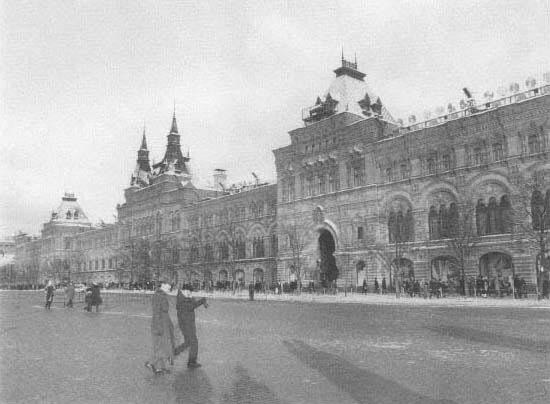
Fig. 18.
Upper Trading Rows, Moscow. 1889–1893. Aleksandr Pomerantsev (Brumfield M166-30).
demician for his drawings of Palermo and joined the faculty of the Academy of Arts. The following year he submitted his project for the competition in Moscow.[56]
In his design for the facades of the Upper Trading Rows, Pomerantsev called on his considerable drafting ability: each facade of the trapezoidal structure shows a different articulation, saturated in motifs borrowed from sixteenth- and seventeenth-century Muscovite architecture (Fig. 19). These motifs, as in Shervud's Historical Museum, had little relation to the structure behind the facade. And Pomerantsev, like Shervud, organized decorative details in a balanced scheme dominated at the main entrance by two symmetrical towers in the style of the Kremlin walls (Fig. 20). The Historical Museum had the compositional advantage of a relatively narrow main facade, in contrast to that of the Trading Rows, which extends for 242 meters; yet Pomerantsev used a sharply molded string course between the floors to emphasize horizontality and to separate the layers of decorated window surrounds and arches. On the main facade each level is a different type of stone: red Finnish granite, Tarussa marble, and limestone—all capped with a massive cornice.[57]
The ostentatious style of the building represented a gesture of historical consciousness on the part of the merchants who paid for it. Considerable ingenuity was required, however, to reconcile the iconography of the heavily encrusted facade with the commercial function of the interior. Inside are three parallel arcades connected by passageways (Fig. 21). Each arcade has three levels, with rows of shops on the first and second and offices on the third. Walkways of reinforced concrete (possibly the first use of this technique in Russia) span each gallery on the second and third levels; iron and glass arched skylights provide illumination (Figs. 22, 23). Among the remarkable achievements of civil engineering in Russia during the nineteenth century, none is more dramatically placed than these iron and glass canopies (see Plate 3). Each weighs some 50,000 puds (819 metric tons) and has over 20,000 panes of glass.
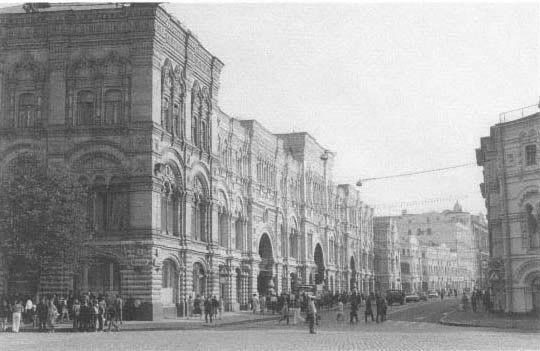
Fig. 19.
Upper Trading Rows, side facade (Brumfield M159-16).
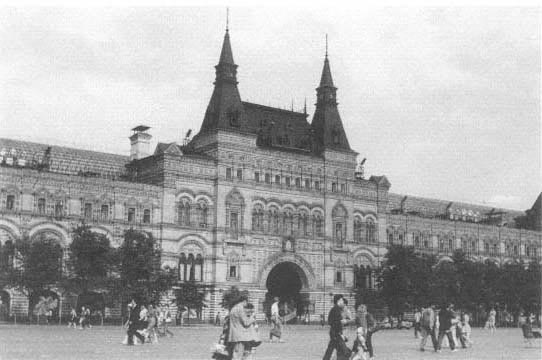
Fig. 20.
Upper Trading Rows, main entrance, with a view of the arched skylights (Brumfield M172-21).
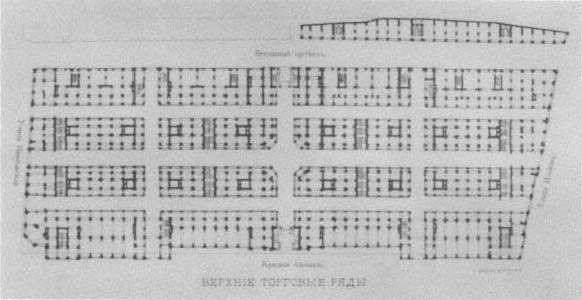
Fig. 21.
Upper Trading Rows, plan.
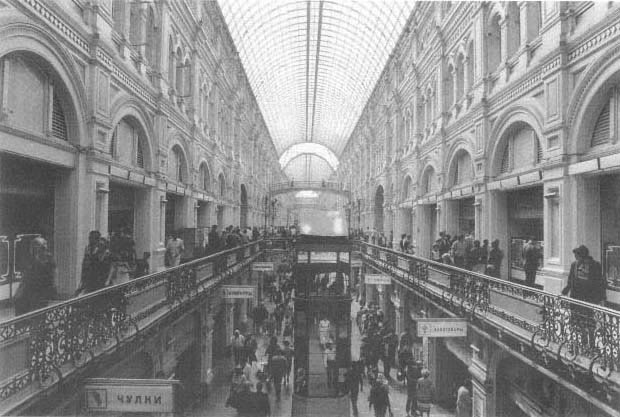
Fig. 22.
Upper Trading Rows, central passage (Brumfield M160-6).
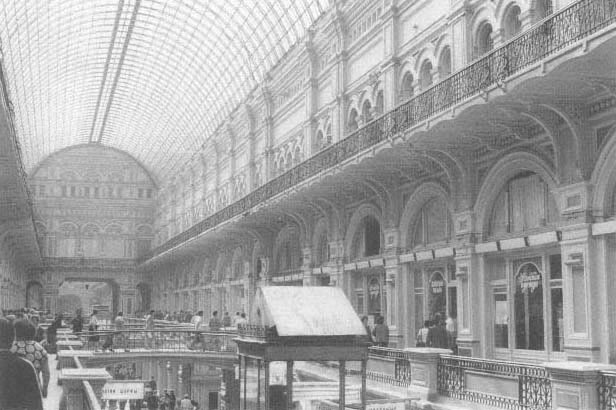
Fig. 23.
Upper Trading Rows, west gallery (Brumfield M160-20).
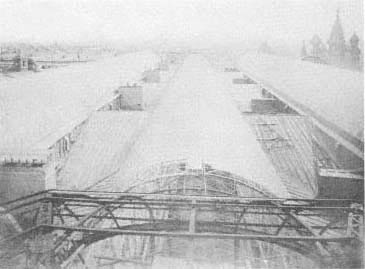
Fig. 24.
Upper Trading Rows. View of iron and glass sky-lights under
construction. Torgovye riady na Krasnoi ploshchadi v Moskve .
Courtesy of the Slavic and Baltic Division, New York Public Library.
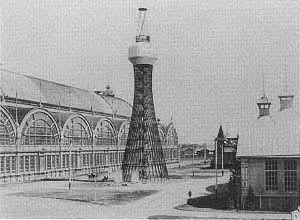
Fig. 25.
Metal "webbed" water tower, 1896 Nizhni Novgorod
Exhibition. Vladimir Shukhov. Vidy Vserossiiskoi
khudozhestvennoi promyshlennoi vystavki 1896 g. v
Nizhnem Novgorode .
Courtesy of the Slavic and Baltic Division, New York
Public Library.

Fig. 26.
Round pavilion, Construction and Engineering Section, 1896 Nizhni Novgorod Exhibition. Engineer: Vladimir
Shukhov. Architect: V. A. Nossov. Section. Vidy rabot proizvedennykh stroitelnoi firmy Bari na Vserossiiskoi
vystavke 1896 v N. Novgorode .
The components were made by Otto Krel, the director of the Petersburg Metal Factory, who had built a number of metal-framed public markets in Petersburg, and were assembled under the supervision of the engineer Ivan Rylskii (Fig. 24).[58]
But the genius behind this union of the aesthetic and the functional was Vladimir Shukhov (1853–1939), one of the most distinguished and versatile of Russia's civil engineers. After graduating from Moscow's Imperial Technical School in 1876, Shukhov spent several months in the United States. Although little is known about his itinerary, it no doubt gave him the opportunity to study examples of American construction technology.[59] After working for two years in the Petersburg office of the Warsaw Railroad, he moved in 1878 to Moscow, where he specialized in designing metal constructions. By the time of the Trading Rows competition, he had acquired a reputation for technical expertise in fields as diverse as bridge construction, petroleum engineering, and the design of large metal-frame arched roofs.
Shukhov's later fame rests primarily on his metal "webbed" towers, including the water tower from the 1896 Nizhni Novgorod Exhibition (Fig. 25) and, in 1922, a 160-meter radio tower in the Shabolovka district of Moscow. At the 1896 exhibition he also built for the Construction and Engineering Section two large pavilions that represented the most advanced use of metal-frame construction for their time and possibly the first use of a metal membrane roof (Figs. 26–29). Although not as daring in concept as Shukhov's pavilions, Pomerantsev's building for the Machinery Hall at the same exhibition (Fig. 30) represents a streamlined version of the design of the Upper Trading Rows.
That the enormous Upper Trading Rows functioned, if imperfectly, is a tribute both to Shukhov's design and to the technical proficiency of Russian architecture toward the end of the century. The use of reinforced concrete for the interior walls and vaulting eliminated the need for thick masonry support walls and provided the space for circulation and light. For maintenance, there
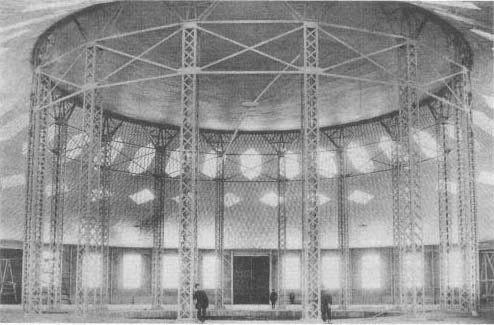
Fig. 27.
Round pavilion, interior. Vidy rabot proizvedennykh stroitelnoi firmy Bari na vserossiiskoi
vystavke 1896 v N. Novgorode .
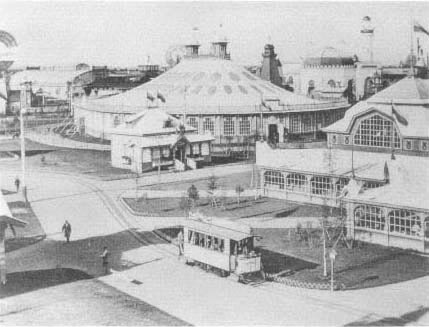
Fig. 28.
Elliptical pavilion, 1896 Nizhni Novgorod Exhibition ( center ). Engineer: Vladimir
Shukhov. Architect: V. A. Nossov. Vidy Vserossiiskoi khudozhestvennoi
promyshlennoi vystavki 1896 g. v. Nizhnem Novgorode .
Courtesy of the Slavic and Baltic Division, New York Public Library.
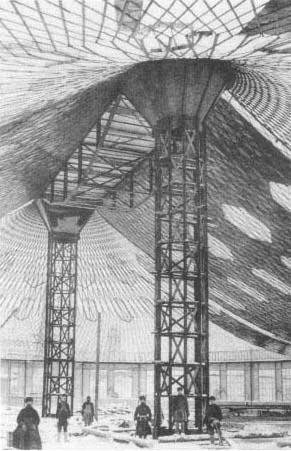
Fig. 29.
Elliptical pavilion, interior. Vidy rabot proizvedennykh
stroitelnoi firmy Bari na vserossiiskoi vystavke 1896 v
N. Novgorode .
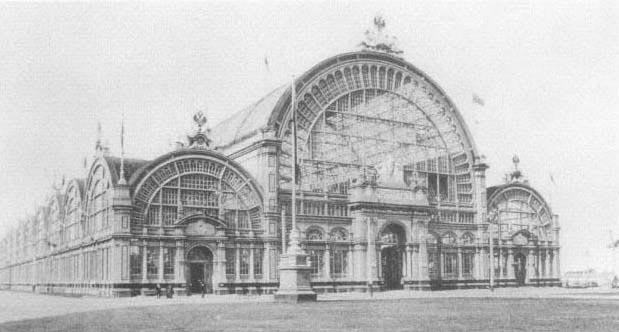
Fig. 30.
Machinery Hall, 1896 Nizhni Novgorod Exhibition. Aleksandr Pomerantsev. Vidy Vserossiiskoi khudozhestvennoi
promyshlennoi vystavki 1896 g. v Nizhnem Novgorode .
Courtesy of the Slavic and Baltic Division, New York Public Library.
was a network of basement corridors, beneath which was a subbasement with heating boilers and an electrical generating station. Every element of professional architecture, from educational institutions to the open competition system, contributed to the project.[60]
Despite these impressive resources, the Upper Trading Rows revealed a fundamental disjunction between the national style and the rational, functional demands of modern urban architecture. It could be argued that Pomerantsev's facades complemented the other structures on Red Square without sacrificing the functional arrangement of the interior. But to apply the motifs of historical reminiscence to a large commercial edifice showed little promise, aesthetic or economic, for other locations. Although reinforced concrete was used extensively in the interior, the stone facades conceal some 40 million bricks (many laboriously salvaged from previous buildings on the site) for the foundation walls and the exterior shell.
As a result of this divergence of style and function, only the upper galleries benefited fully from Shukhov's design in glass and iron. The lower level of shops (more commercially desirable) lacked proper light and ventilation, while the brighter and more spacious upper level was less convenient. Many shopkeepers saw little advantage in moving to the new building, which yielded only a modest return to the investors who had bought 5 million rubles worth of stock in the Society of Trading Rows.
The failings of the Upper Trading Rows did not, however, discourage another major commercial project in the pseudo-Russian style: the Middle Trading Rows (1890–1891), next to the Upper Rows on land that slopes down from Red Square to the Moscow River (Fig. 31). The architect was Roman Klein (1858–1924), who had placed second in the competition for the Upper Rows and became one of the most productive architects in Moscow at the turn of the century. After studying for two years at the Moscow School of Painting, Sculpture, and Architecture, he did drafting for Shervud for the Historical Museum and then proceeded to Petersburg, where he studied at the Academy of Arts from 1877 to 1882. On graduating, he traveled to Italy and France, where he worked for a time in the studio of Charles Garnier, who designed the Paris Opéra. When he returned to Russia in the mid-1880s, he worked in Petersburg before resettling in Moscow, the center of his activity for the next three decades.[61]
Klein's Middle Trading Rows, under construction at the same time as Pomerantsev's building, follows the decorative patterns of the other buildings on Red Square, but with less ornamental saturation. More space separates the window surrounds and arches, and the three-storied structure has a more pronounced segmentation than the Upper Rows. With the larger wall surface, however, little light can enter the structure, which has no skylight design comparable to Shukhov's. In 1909 the society of merchants that owned the building petitioned, unsuccessfully, to enlarge the windows. In 1914, a second petition to rebuild the Middle Rows in the French Renaissance style was granted but not implemented. Klein himself was responsible for the merchants' dissatisfaction with the original style; his own design for the Muir and Mirrielees firm (1906–1908), discussed in chapter 3, demonstrated the superiority of a trading center arranged in an open, unified space. (The merchants submitted their petition for larger windows the year after the completion of the Muir and Mirrielees store.)
In addition to the Upper and Middle Trading Rows, both much larger than any commercial gallery in Petersburg, other trading passages were constructed in Moscow during the 1890s, including the Zaikonospasskii Trading Rows (ca. 1893) by S. T. Preobrazhenskii. Located on Nikolskii Street (now October 25 Street) and perpendicular to the Upper Rows, this smaller structure displayed Russian motifs on long rows of windows whose design was in harmony with Moscow's oldest district (Fig. 32). But by the end of the century such uses of a national style in commercial buildings were outmoded; and wealthy merchants like Vikula Morozov built large emporiums in a more rational style—the Beaux-Arts style, still heavily decorated—with large windows to illuminate display space.[62]
In the same, central, area of the city, the Moscow city government undertook what was to be the city's last major exercise in the Russian style, the city hall. As with other large projects around Red Square, a building for the duma, or city council, had long been under discussion—since the early 1870s, when Aleksandr Rezanov and Andrei Huhn,[63] then completing work on the Palace of Vladimir Aleksandrovich in Petersburg, presented the first design proposals, for a fanciful recreation of the pseudo-Russian style in the manner of Hartman and Ropet. This design was not built, and the site was given over to the construction of the Historical Museum.
The revival of plans for the duma building in 1886 initiated a series of design competitions that demon-
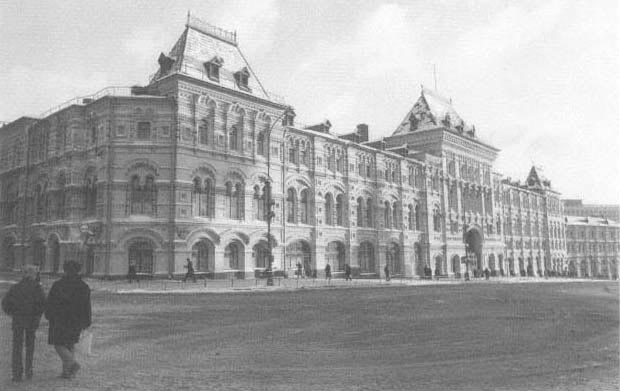
Fig. 31.
Middle Trading Rows, Moscow. 1890–1891. Roman Klein (Brumfield M166-33).
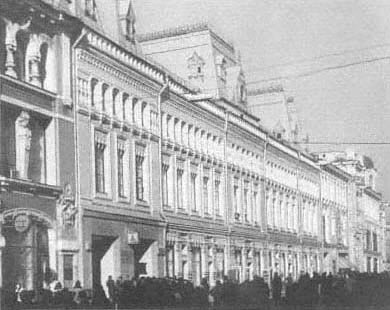
Fig. 32.
Zaikonospasskii Trading Rows, Moscow. Ca. 1893. S. T. Preobrazhenskii
(Brumfield M6-25).
strated the difficulty of reconciling pressures for an "archaeological" Russian style with architects' concepts of structure and purpose. Dmitrii Chichagov (the brother of Mikhail Chichagov, who designed the Korsh Theater in the national style) was one of three architects asked to submit facade designs, but the influential Archaeological Society declared them incompatible with a genuine Russian style.[64] A new proposal by Chichagov, acceptable to the society, did not please the duma. Subsequently, in an open competition Chichagov's entry placed first among the thirty-eight submitted, but he had to resubmit the plan for a final competition among the three prize winners. Again Chichagov's plan placed first, and he was authorized to begin construction (1890–1892).
Dmitrii Chichagov used Russian decorative elements mechanically on the large Duma, in contrast to his brother's skillful distribution on the much smaller Korsh Theater. Medieval decoration lies ponderously along the flat, symmetrical surface of the Duma (Fig. 33) in a scheme more rigid than that of the neighboring Russian Revival structures by Shervud and Pomerantsev. Although the buildings seem related, the Duma is not effectively part of Red Square: its red brick main facade looks toward the great portico of the Bolshoi Theater, thus further violating the stylistic unity of one of Moscow's few remaining neoclassical ensembles. Inside, the Duma demonstrates the technical proficiency of the architects working in the Russian style, which is, however, awkward for any modern structure larger than a house. Indeed, the style was used most successfully in mansions like one designed by Nikolai Pozdeev for N. Igumnov and another by Boris Freudenberg for Petr Shchukin (Fig. 34).
The impact of the Russian Revival style was considerably muted in Petersburg, where other, eclectic, styles dominated—even to the point of obscuring the city's most cherished neoclassical monuments. (The development of Admiralty Quay for private apartment buildings during the 1880s is the most blatant example of this disregard for the city's architectural heritage—in this case Adrian Zakharov's Admiralty, 1806–1823.) Yet even in Petersburg the ideology and aesthetics of the Russian style found expression in one major architectural project of the end of the century: the Church of the Resurrection of the Savior on the Blood (1883–1907), built on the site where in 1881 Alexander II was assassinated by terrorists of the People's Will political movement. After an extensive review of the first designs submitted, all, as frequently happened in such competitions, were judged insufficiently Russian. In the subsequent competition, Alfred Parland received first prize for a design (Fig. 35) based on the sixteenth-century Cathedral of the Intercession on Red Square (to which, in fact, it bears only superficial resemblance).[65]
The exterior of Parland's church, which suggests medieval Moscow, is strikingly disharmonious with the Petersburg ensemble. Even so, however, the church succeeds as a monument to a tsar who had tolerated Pan-Slavism and had involved Russia in a war with Turkey in the Balkans (during his reign many Russians awaited the imminent fall of Constantinople to Russia as part of the Orthodox patrimony). No other structure of the period reveals so clearly the link between architecture and political purpose, and the relation is stated all the more forcefully because the building is so incongruous with its setting.
Alfred Parland (1845–1892) graduated from the Academy of Arts in 1874 and traveled in Europe on a scholarship until 1878, when he returned to the academy as a member of the faculty. Although he specialized in building churches, for this major ecclesiastical project of the late nineteenth century he drew not on the neo-Byzantine (the usual official preference, which characterized many of the projects submitted to the competition jury), but on the more "democratic" Russian Revival style.[66] Although both styles enjoyed official favor, the Church of the Resurrection is distinct from the Russian Orthodox cathedrals constructed in the Byzantine manner not only in Russia proper but also in other parts of the empire, such as Warsaw, and even beyond (in Sofia, Bulgaria).
Considerable technological ingenuity was required to ensure the stability of the massive structure, built on the edge of the Catherine (now Griboedov) Canal. Neither the engineering nor the architecture of the church, however, was as challenging as the mosaic panels on both the interior and exterior of the building (see Plates 4, 5). These increased the time of construction to more than twenty years from the first groundwork in 1886. The exterior panels, designed by Viktor Vasnetsov, Mikhail Nesterov, and other artists for placement in a facade of specially manufactured yellow brick, were made by the firm of A. A. Frolov.[67]
Vasnetsov designed four mosaic scenes of the Crucifixion for the pediments of the church's west entrance porches. Although the scenes reveal his mastery of a demanding medium, their setting is uncongenial to the artist's free interpretation of the Russian style. Parland
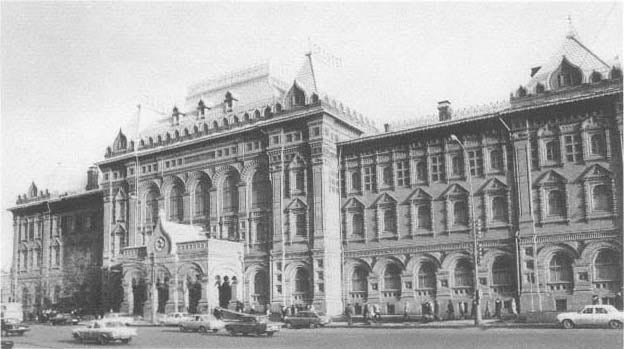
Fig. 33.
Moscow City Duma. 1890–1892. Dmitrii Chichagov (Brumfield M133-36a).
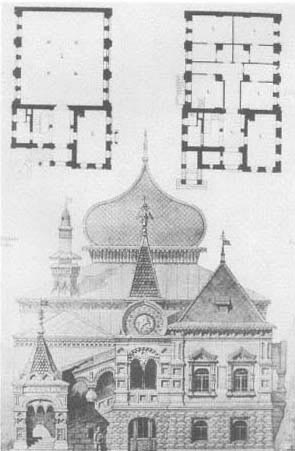
Fig. 34.
Shchukin house, Moscow. 1894. Project sketch by
Boris Freudenberg. Zodchii , 1893.
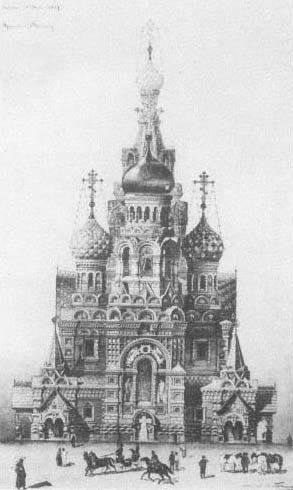
Fig. 35.
Church of the Resurrection of the Savior on the Blood,
Petersburg. 1883–1907. Final project sketch by Alfred
Parland. Zodchii , 1907.
was technically proficient in arranging the decorative elements and stylized towers of the church, but here, as in Moscow, the result of re-creating an architectural style based on archaeological fragments was a building whose scale and exterior decoration had little relation to medieval Russian architecture. However, Vasnetsov's involvement in the mosaic work for the church represents a revival of interest in medieval art forms that would ramify both in his own work as a painter, designer, and architect and in that of other artists, such as Mikhail Vrubel.
Among other major churches of the period that similarly reinterpreted the national past, the most notable is the Cathedral of Saint Vladimir in Kiev, whose construction, from 1862 to 1896, was overseen by a succession of architects, including Ivan Shtrom, Pavel Sparro, Vikentii Beretti, and Rudolf Bernhardt. The artists responsible for the interior wall decoration included Viktor Vasnetsov, Mikhail Nesterov, and Mikhail Vrubel, who was allotted only a secondary role despite his great hopes for this project. In general the new architectural style at the turn of the century developed only in the construction of smaller churches with little relation to official church architecture.
One church that returned to medieval antecedents for its design did so not simply for a decorative or iconographic purpose but for a structural one: to relate the interior and exterior. Because the church was small and its detail demonstrated none of the archaeological fidelity expected of the Russian style (particularly in a church), it elicited little positive response from the architectural profession. Indeed, the church was an amateur produc-
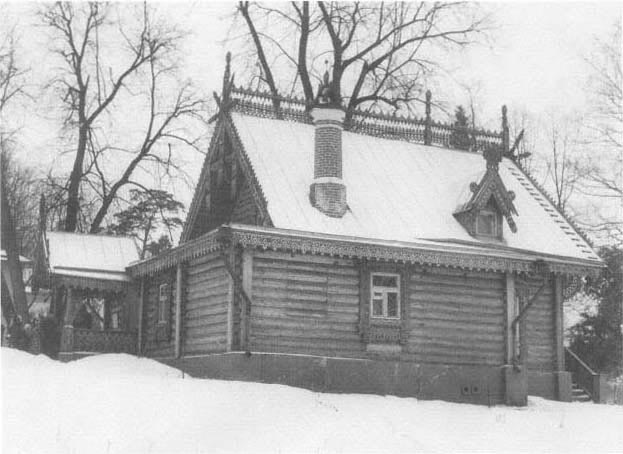
Fig. 36.
Studio, Abramtsevo. 1872. Viktor Hartmann (Brumfield MR11-8a).
tion, unconstrained by committees, academic rules, or complex engineering methods—in short, by those factors that had helped to stabilize the architectural profession during the latter half of the nineteenth century.
The church, at Abramtsevo, the estate of Savva Mamontov, can be seen as an experiment by artists of common purpose, if diverse interests. Mamontov had created the controlled environment for such an experiment after purchasing the estate in 1870 from a daughter of Sergei Aksakov, a prominent Slavophile whose hospitality had made Abramtsevo a haven for noted writers and intellectuals.[68] Although interested primarily in the visual and performing arts, Mamontov also joined artists and friends in a group dedicated to an arts and crafts revival in Russia.
Mamontov purchased Abramtsevo the year after the death of his father, whose considerable fortune he inherited and enlarged as one of Russia's most energetic railway developers. Mamontov's "colony" at Abramtsevo provides a quintessential example of the productive relation between entrepreneur and artist in the postreform period. Although Abramtsevo would be rivaled by another center at Talashkino (Smolensk Province), the estate of Princess Maria Tenisheva, Mamontov's group was unique in its breadth of artistic interests and its influence on architecture and design at the turn of the century.
Both Viktor Hartmann and Ivan Ropet worked at the estate in the early 1870s. Hartmann, shortly before his death in 1873, built a studio at Abramtsevo, with richly carved wooden decorations typical of the crafts revival (Figs. 36, 37). Ropet's teremok bathhouse there, more interesting structurally than Hartmann's work, united asymmetrical shapes under a steep trapezoidal roof that

Fig. 37.
Abramtsevo studio, detail (Brumfield MR11-3a).
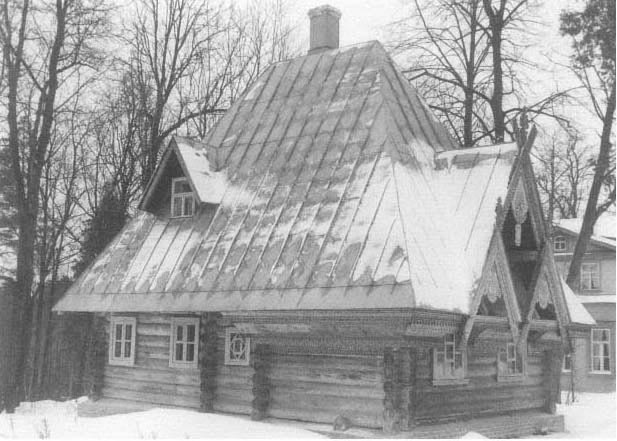
Fig.38.
Teremok bathhouse, Abramtsevo. 1873. Ivan Ropet. (Brumfield MR8-8).
serves as a backdrop for the window and porch gables (Figs. 38, 39). The fanciful manner of the teremok gave a foretaste of freestyle, sculpted architecture at the turn of the century. These modest buildings by leading proponents of the Russian Revival style provided invaluable design precedents for the Abramtsevo church.
The communal effort in building the church, dedicated to the Icon of the Savior "not created by hand" (nerukotvornyi ), has become legendary in Russian art history—the realization of an artistic synthesis by a group dedicated to preserving art in the spiritual life of the people. In her memoirs of Abramtsevo, Natalia Polenova, whose father was the painter Vasilii Polenov, notes that the church was built to embody not only aesthetic but also spiritual ideals. Although the Khotkov Monastery was only three versts away (about three kilometers), frequent floods around Easter convinced Mamontov to build a church on the estate grounds. The religious piety and aesthetic ambience that in Polenova's account characterize Easter services held at the estate house also informed the artists' creation of the church.[69]
The design of the Abramtsevo church (Fig.40) derived not from the Byzantine or seventeenth-century Muscovite styles prevalent in Russian church architecture of the time but from the less grandiose traditions of medieval Novgorod and Pskov. Early sketches for the project by Vasilii Polenov (Fig.41) were based on the Church of the Transfiguration of the Savior on the Nereditsa (1198) near Novgorod. The style of churches near Rostov influenced the painter Viktor Vasnetsov's subsequent refashioning of the design into an architectural project.[70] In recurring to this more intimate style—long appreciated by art historians but little noticed by architects—the Abramtsevo group reclaimed a
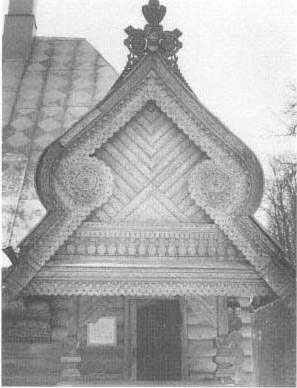
Fig. 39.
Teremok bathhouse, detail (Brumfield MR9-10).
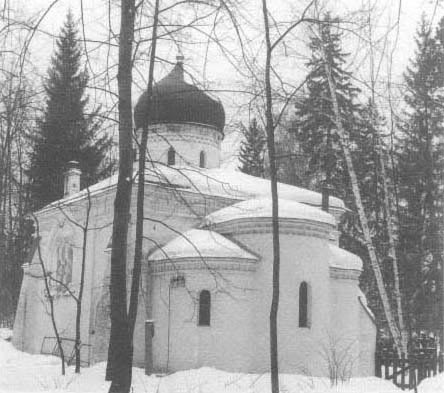
Fig. 40.
Church of the Icon of the Savior Abramtsevo, from the southeast. 1881–1882.
Viktor Vasnetsov (Brumfield MR9-4).
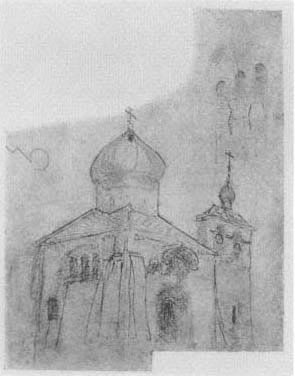
Fig. 41.
Church of the Icon of the Savior, Abramtsevo. Project
sketch by Vasilii Polenov.
part of Russian architecture that emphasized structural clarity and the relation between material and form. Vasnetsov, a painter of historical and semimythical subjects from the Russian past, refashioned the sketches into an architectural project, constructed in 1881–1882.[71] There are few "quotations" in this building: the exaggerated contours, the large curved segmented window on the south wall, and the carved limestone details do not reproduce with archaeological precision the small churches of Novgorod or Pskov—which in any event had been rebuilt extensively over the centuries. Yet the deeper structural similarity is recognizable (Fig. 42), presented without the decorative detail that cluttered most examples of the Russian revival style.
The decoration of the interior and the design of the furnishings involved not only Polenov and Vasnetsov but also the painters Ilia Repin and Apollonarii Vasnetsov (Viktor's brother), the sculptor Mark Antokolskii, and Savva Mamontov's wife, Elizaveta Mamontova, of the Sapozhnikov silk-manufacturing dynasty. Mamontova participated actively in the Abramtsevo crafts circle, whose cause she promoted tirelessly along with Elena Polenova, Vasilii's sister, who founded the Abramtsevo ceramics workshop. The artists' group at Abramtsevo continued to center on the church and its design: ten years after the church was completed Vasnetsov added a chapel on the north facade, where in 1892 Mamontov's invalid son Andrei was buried (see Plate 6). In 1918 Savva Mamontov was buried in the same chapel.
The expressiveness of the church at Abramtsevo can be interpreted as part of a broader Russian cultural pattern at the end of the century that emphasized both aestheticism and higher, spiritual, realms. Natalia Polenova, perhaps idealizing, describes a communal spirit at Abramtsevo that transcended professional divisions in the search for aesthetic harmony. Even the workshops were part of a unity, with each craft contributing to the decoration of the church. The furniture and woodworking shop, established by Elena Polenova in 1882, provided the interior furnishings in an arts and crafts style continued in Vasnetsov's designs at the turn of the century (Figs. 43, 44). The church was also decorated with ceramic tiles: inside, on the traditional Russian stove, and outside, in ornamental strips around the cupola drum and burial chapel. In 1889 Polenova organized the ceramics workshop into a full-fledged enterprise, draw-
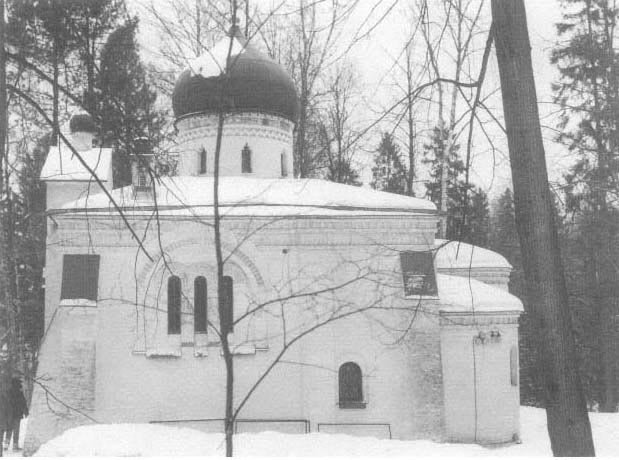
Fig. 42.
Church of the Icon of the Savior, south facade (Brumfield MR9-1a).
ing on the talent of Mikhail Vrubel, whose ceramic designs are preserved in tile stoves in the estate house at Abramtsevo (see Plate 7)[72]
The view that Abramtsevo was the precursor of a general cultural revival at the turn of the century is further supported by the interrelation between the arts that characterized many of the community's activities—not simply the crafts, the visual arts, and architecture but also drama, music, and set design. Participants in the estate's "amateur" productions included Fedor Chaliapin and Konstantin Stanislavskii-Alekseev (another product of the Moscow merchant elite). One of the most notable cultural events at Abramtsevo occurred in 1886, when Rimskii-Korsakov's opera The Snow Maiden was produced. The sets, designed by Vasnetsov, prefigure the neo-Russian element in style moderne architecture fifteen years later.
But the Abramtsevo church itself, in which structure, function, and material are related, links tradition and modernity in Russian architecture, embodying solutions to problems of style and form noted so pointedly at architectural meetings toward the end of the century. Vasnetsov's work at Abramtsevo remained generally unappreciated by architects and critics; in the 1890s Vladimir Stasov dismissed it uncomprehendingly as "without creativity."[73] Not until 1906 did the church receive its due in the architectural press, when photographs of both the interior and exterior appeared in Ezhegodnik Obshchestva arkhitektorov-khudozhnikov (Annual of the Society of Architect-Artists), a lavishly illustrated publication usually devoted to buildings constructed within two years of the issue.[74]
The architectural collaboration at Abramtsevo was not the last occasion when a painter there made an
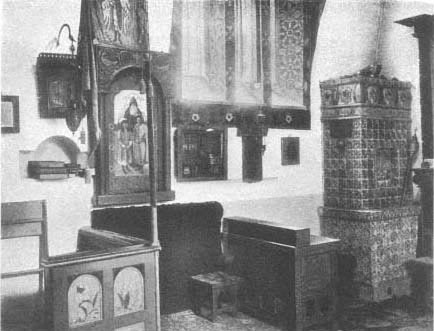
Fig. 43.
Church of the Icon of the Savior, interior. Ezhegodnik Obshchestva
arkhitektorov-khudozhnikov , 1906.
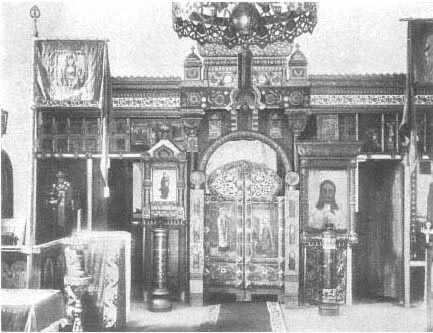
Fig. 44.
Church of the Icon of the Savior, iconostasis, Ezhegodnik Obshchestva
arkhitektorov-khudozhnikov , 1906.
original contribution to Russian architecture. In 1896 Konstantin Korovin, who had painted stage settings for Mamontov's opera productions, designed the Pavilion of the Far North at the All-Russian Arts and Industry Exhibition in Nizhni Novgorod. Though more modest than the large pavilions by Pomerantsev for the same exhibition, Korovin's innovative pavilion exemplified his understanding of structure derived from traditional (in this case wooden) forms. The pavilion has no trace of the ornate "folk" decoration usually associated with Russian wooden architecture in the nineteenth century, instead, Korovin used his materials to create a simply defined sculpted mass (Fig. 45).
Although neither Korovin nor Vasnetsov used technologically advanced materials or construction methods, their approach to architectural form suggested a means to lessen the opposition between technology and historicism. Elena Borisova notes that in architecture the Abramtsevo painters "could satisfy that tendency to the plastic that professional architects felt somewhat later, for which painters still had not found a place on their canvases."[75] Precisely at this juncture, ahead of the new styles in both painting and architecture, the Abramtsevo artists—Polenov, Viktor Vasnetsov, Korovin, and to some extent Aleksandr Golovin—introduced their painterly conception of mass and space into architectonic form.
Members of the architectural profession in the 1890s might well have felt both a sense of accomplishment and some doubt about the future of a practice based on seemingly endless variations of Russian revival or French Renaissance styles. These mixed feelings surfaced in discussions of rationalism in architecture during the Congresses of Russian Architects arranged by the Petersburg and Moscow architectural societies. At the first congress, held in 1892 at the Academy of Arts in Petersburg, the theme of rationalism surfaced early, in Pavel Siuzor's keynote address. In outlining the four sections of the congress he commented on the first (artistic) section:
In the artistic, architectural section there are generally three characteristic directions to be noted: the classical, the national, and the rational or the real, that is, the practical and functional. The first is sufficiently well known, and therefore I will not dwell on it. In the national one speaks of the working out of Russian nationality, of Russian artistic motifs. The architect taking the rational direction ignores the framework presented to him and attempts to satisfy the necessary demands in general terms before turning his attention to an artistic treatment of the required forms.[76]
Because Siuzor's linking of the rational with the real, or the practical, does not preclude the use of eclectic motifs in structural decoration (Fig. 46), his statement represents a retreat from the strict rationalist principle developed by leronim Kitner and others in the 1870s.
Kitner was, in fact, a forceful presence at this congress; but Robert Gedike, whose speech followed Siuzor's, voiced the uncertainty of many architects about the relation of architectural aesthetics to contemporary structures. Gedike had recently become rector at the Academy of Arts; during his thirty years of practice he had established a reputation as a competent architect of no pronounced theoretical position. His sense of crisis was stimulated by the architectural displays at the 1889 Paris Exposition:
The reasons for the obvious decline of taste in the civil architecture of our time lie, one must assume, in the numerous changes that have touched our lives in recent times but are not yet established and therefore prevent our artists from choosing one general and stable direction in all branches of the arts. Every style in architecture expresses the tastes and social currents of a particular time. In our time no close tie exists between accepted concepts about art and their artistic expression in architectural compositions: devices once in use have grown old, and the new have not yet had time to work themselves out in clearly defined forms. At present we are experiencing a struggle in architecture between old and new points of view.[77]
Although unable to predict where new forms of inspiration would arise, Gedike concluded optimistically: "Even now works of architecture sometimes appear in which one senses the creators intent to deny the old traditions and create a new style, using contemporary discoveries and refinements in science and technology." He did not elaborate; his speech is significant not for analysis but for the unambiguous reference to a decline in architectural taste and for the use of the term "new style," which evolved during the 1890s from a catchphrase to the name of Russia's modern architectural movement.
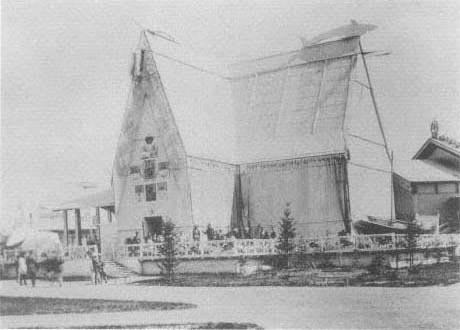
Fig. 45.
Pavilion of the Far North, 1896 Nizhni Novgorod Exhibition. Konstantin Korovin. Vidy
Vserossiiskoi khudozhestvennoi promyshlennoi vystavki 1896 g. v Nizhnem Novgorode .
Courtesy of the Slavic and Baltic Division, New York Public Library.
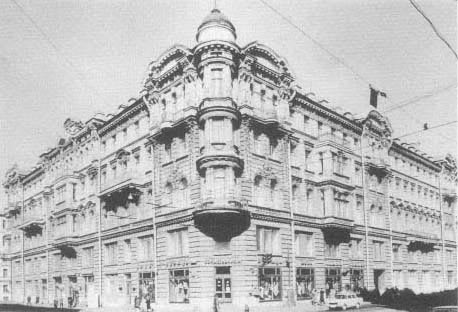
Fig. 46.
Efimov apartment house, Petersburg. 1883–1885. Pavel Siuzor (Brumfield L85-34).
The further discussions of aesthetic issues at the 1892 congress reveal that every professional position on rationalism had become compromised. In a lecture entitled "The Significance of the Study of Ancient Monuments for Contemporary Architecture," Konstantin Bykovskii defended old Russian architecture, which "never had a decorative, applied character or that mannered design that so often distinguishes contemporary buildings."[78] For him pre-Petrine architecture demonstrated an organic link between style and structure. Although certain architects of the "new style" would revive this interpretation, nothing in Bykovskii's remarks—or in current architectural practice—indicated just how the organic link might be re-created. Certainly no one mentioned the dilettantes at Abramtsevo.
In the debate that followed Bykovskii's lecture, Kitner criticized the national, historicist school—but said only that architectural competitions specifying a style were needlessly restrictive and the resulting designs possibly incompatible with function.[79] Bykovskii replied that he would not adopt the Russian style if it contradicted the purpose of a building. The debate never rose above this level, perhaps because neither side was yet prepared to develop new ideas in architecture. Although both Bykovskii and Kitner were to practice for many years after this congress (Bykovskii died in 1906, Kitner in 1929), each had formed his views on style during the preceding three decades. Bykovskii's two major projects during the 1890s—the State Bank in Moscow and the Zoological Museum of Moscow University—are eclectic designs with careful detailing and, in the merging of architectural and zoological form on the facade of the museum, a fine sense of wit; but neither is innovative (Fig. 47).
As for Kitner, although he produced technologically advanced work with metal construction (such as Petersburg's Haymarket), that work seems forgotten in his lecture. "Concerning the Reduction of Tariffs on the Transportation of Natural Stone on All Russian Railroads." Echoing the view that the architecture of the past decade had taken a "false path," Kitner urged that natural materials like stone be used instead of stucco and other "surrogates". Natural stone would impose discipline on architects, who would consequently rid their buildings of superfluous decorative motifs.
For whatever reason, the beginning of the twentieth century indeed witnessed an increasing use of natural stone on building facades and a greater concern with the texture (faktura ) of natural materials. But in Kitner's speech the future of architecture was in the past. "To create any new style characterizing our age seems difficult and fruitless, . . . like flailing at water. " Genuine architectural style had been based on the properties of hewn stone, and only a return to this material would relieve architecture of its self-deception.[80]
In the technical sections at this and subsequent architectural congresses in the 1890s, architects maintained the retrospective view. During the year of the second congress (1895), Vladimir Shervud published his Essay on the Investigation of the Laws of Art: Painting, Sculpture, Architecture, and Ornament , which defined both the general and the specific in national architecture. Like many Russian intellectuals of the 1870s and 1880s, Shervud believed Russia could fulfill its special role in civilization only by returning to certain Russian values. His detailed analysis of pre-Petrine Russian architecture focused on churches, whose dominance in medieval Russian life demonstrated that religion was "virtually the only guide to the intellectual life of man. Therefore, the church style, which expressed the inspiring idea of the people, also made its way into civil architecture."[81]
Shervud drew conclusions in the essay that are evident in the facade of the Historical Museum, completed twelve years earlier but clearly an expression of the same ideas. His analysis is more than an eccentric relic of nineteenth-century cultural nationalism because he imposed an ideational content on architectural form. He proclaimed that "the restoration of all the fullness and multifaceted display of the spiritual idea in architecture is granted to the bearer of the pure Christian faith—to the Russian people."[82] Architecture thus assumed a literary, programmatic aspect transcending aesthetics of the classical system. For Shervud the Renaissance (and, by implication, post-Petrine Russian architecture) had no "clearly defined idea"; but the idea he himself sought had less to do with principles of form and structure than with the expression of the national culture.
To a certain extent Shervud' s ideas grew out of Eugène Viollet-le-Duc's interpretation of architecture and his L'Art russe , published in 1877 and translated by Sultanov in 1879. Viollet-le-Duc believed that Russia had synthesized art forms derived from both East and West; the resulting works were not imitative but bore the stamp of national genius:
Russian architecture at that stage of development which it reached in the seventeenth century is a superb instrument whose broad basic principles
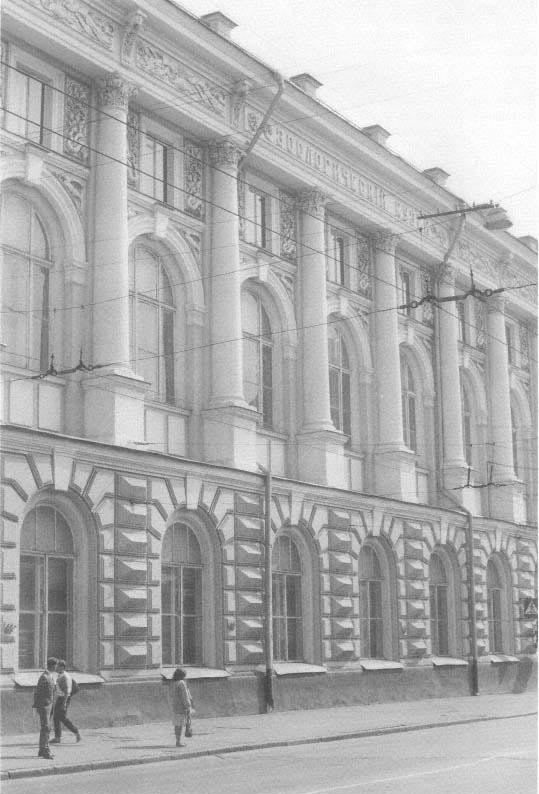
Fig. 47.
Zoological Museum, Moscow University. 1902. Konstantin Bykovskii (Brumfield M162-4).
do not restrict the artist's freedom. It is possible to think up the boldest combinations while remaining faithful to these principles. It remains to the nineteenth century to resume this interrupted work [the Russian architectural synthesis interrupted by Peter the Great]. But a successful conclusion requires the assimilation of the spirit guiding artists in the sixteenth and seventeenth centuries and the abandonment of classical instruction that in Russia and on the European continent has forced art to abandon its logical course in harmony with the spirit of tribes and nationalities.[83]
In discussing Russian architecture, however, Viollet-le-Duc introduced interpretations of artistic detail so capricious that a number of Russians—including his translator, Sultanov—challenged his views.[84] But aside from questions of detail, Viollet-le-Duc's emphasis on national character in architecture must have been welcome to Russians already primed to think in similar terms.
Whatever the similarities between the views of Shervud and Viollet-le-Duc (who would not have shared the Russian's fervent Christianity), the interpretation of Viollet-le-Duc in Russia had less to do with his architectural rationalism—he claimed that the principles of sixteenth-century Russian architecture could be adapted to modern use and technology—than with his belief that architecture expresses a social and cultural purpose. For Bykovskii, Kitner, Shervud, and many of their contemporaries who spoke or wrote about the destiny (or crisis) of Russian architecture, Russia was a unique cultural entity whose architecture must be guided by—and must itself express—a unifying idea.
Paradoxically, the question of national identity in Russian architecture reflected not only the thinking of Russian intellectuals but also that of nineteenth-century British and French theoreticians who had discussed the significance of medieval architecture in the revival of indigenous styles in their own nations.[85] Although once again Russia followed the general European pattern, the Russian architectural profession, in its publications and at its meetings, pursued the issue of national identity with unusual intensity. That the Russian architects linked questions about national purpose and cultural identity to the development of architecture suggests an awareness of social and economic inferiority vis-à-vis more advanced European countries.
Konstantin Bykovskii's address in 1895 to the Second Congress of Russian Architects serves as a central document of the attempt to reconcile the national past with modernity. Although Bykovskii lacked Shervud's ideological certitude, he was unusually well placed to survey the accomplishments of the architectural profession during the past three decades. Two years after debating with Kitner the essence of Russian architecture and its historical roots at the first congress, Bykovskii was chosen president of the Moscow Architectural Society—a post he would occupy until 1903. As the host to the second congress in Moscow, Bykovskii had the responsibility not only of commenting on the activities of the society, founded by his father, Mikhail Bykovskii, in 1867 but also of confronting yet again the unresolved issue of direction in Russian architecture. Bykovskii's lecture was entitled. "The Tasks of Architecture in the Nineteenth Century":
What other century has created so much for the comfort of human life? When have humane considerations led to the housing of workers in colonies according to a strictly conceived plan? When have such hospitals been erected for the good of mankind? When have such palaces of iron and glass been created for international exchange in industry, art, and science? Indeed, can our century, in which exhausted mankind seeks rest primarily in musical harmony, afford to neglect the musical element in architecture, in which a harmonious combination of forms, lines, and colors acts upon us and the sincere feelings infused in them refreshes us? Contemporary humanity seeks an architectural style that would satisfy it but has not yet found it. Despite the great beginnings of the century, an architectural masquerade continues, with buildings decked out in the raiment of various styles. Where did such a phenomenon come from—a symptom in architecture of the general spiritual mood of the age? We inherited it from a long period of the imitative worship of architectural styles. By imitating with no understanding of the organic life of forms, we became infected with the idea that beauty of form is something absolute, unconnected with the conditions that created the form itself. The thought that a building can be beautiful mainly from its decoration became entrenched, and an artificial division appeared between artistic and technical architecture.
The romanticism that embraced Europe in the first half of our century counterposed to clas-
sicism a fascination with the Middle Ages. . . . Instead of imitating classical styles, [architects] attempted to reproduce other styles previously rejected. The material suitable for architectural reworking is overwhelmingly varied, creating an especially difficult position for the architecture of our time. We must orient ourselves in all this material to find a guiding thread that will finally bring us out of empty eclecticism. We must work to assimilate the material from the past so firmly that we can deal with it independently and say in architecture a new original word.[86]
In Bykovskii's statement one sees traces of ideas from many sources, including Ruskin and Viollet-le-Duc. But Bykovskii gives a curiously Russian twist to familiar pronouncements about the need to revive and re-create architecture when he speaks tautologically of "a new original word" in architecture. Dostoevskii frequently expressed the notion that a culture can say a "new word"; Bykovskii's echo of this idea provides further evidence of a literary approach to defining the function of architecture in the culture as a whole.
The insistence by architectural critics, from Stasov to Bykovskii, that architecture express the national character reflects the enormous influence of literature in nineteenth century Russian society. Borisova uses the term literaturo-centrism to refer to this phenomenon in Russia from the 1830s to the the late nineteenth century; the term, however awkward, conveys the expectation that artistic culture, including architecture, should exist as a text correlated to a system of ideas.[87]
The inability of Russian architecture to achieve its expressive potential, according to Bykovskii, was related to the lack of cohesion in Russian society:
They are right who lament the lack of originality in contemporary Russian architecture; but they are wrong in considering none of the complexity of this phenomenon and in paying no attention to the role of social developments, of architects, and of contemporary life, in which one senses the lack of a unifying idea.[88]
Bykovskii concluded by advocating both the assimilation of modern technology and the use of the past as a source of creative inspiration for the architecture of the present.
There is little original thought in this speech, for Bykovskii's ideas of architecture were firmly grounded in the nineteenth century even as he addressed his remarks to the twentieth. Nonetheless, it deserves attention, for it reflects the disputes, ideals, and compromises of the Russian architectural profession during the late nineteenth century. The idea that architecture in an increasingly diverse technological and economic setting might need something other than a "unifying idea" (particularly one derived from a literary or historicist perspective) eluded him. He implied that independent expression in Russian architecture could not go beyond competent, professional work on the one hand and the imposition of ideological imperatives on the other.
Other European countries faced similar difficulties in developing new architectural forms. In Austria, for example, Otto Wagner and his students Joseph Olbrich and Josef Hoffman confronted established critical opinion based on "the fruits of archaeological studies" (to use a phrase from Wagner) in their quest for a modern architectural aesthetics. Coincidentally, the year of Bykovskii's speech (and Shervud's essay) was also the year Wagner completed his theurgic book Die moderne Architektur , which proclaimed a new rationalist aesthetic derived from structure and function; its rallying cry was "Nothing impractical can be beautiful." Wagner's definition of the new architecture recognized the broader meaning of architecture in modern times: "To represent us and our time this new style, the modern, must clearly express a significant change in the former sensibility, the almost total decline of romanticism and the emergence in our works of a purposefulness that usurps virtually everything else."[89] This contrast between the old and the new is all the more striking since Wagner had also worked in the Renaissance manner in the early 1890s.[90]
The work of Wagner, Olbrich, and Hoffmann was well known in Russian architectural circles by the beginning of the twentieth century; and although some Russian architects disparaged Wagner's modernism, Wagner himself was made an honorary member of the Petersburg Society of Architects. What stands clear in his work as a writer and an architect is his rejection of architectural symbolism linked to a historical or literary program: "It should always be seen as a gross error to accommodate inner structure to a favored external motif or even sacrifice it to that motif. Such an accommodation leads to an unavoidable lie and the resulting form is repulsive."[91]
Although in Russian architecture the call to the modern was never expressed so radically before the revolution, the relation between function and structure assumed particular importance in defining new forms.
At the same time, traditional Russian motifs were used flamboyantly in architecture—often with symbolic purpose—in certain works of the "new style." Many Russian architects openly borrowed innovative styles from Vienna, Darmstadt, and Paris but maintained the idiosyncrasy that characterizes Russia's adaptations from the West. In a single decade the greatest architect of the period, Fedor Shekhtel, moved through the entire spectrum—from eclecticism, the Secession, romantic nationalism, and severe functionalism—before returning to retrospective styles after 1909. However eclectic it may appear, Russian architecture during these extraordinary years succeeded in changing its traditional, academic perspective on form and design to one concerned with the "new style, the modern."
Chapter Two—
Russian Architectural Criticism and the Propagation of the "New Style"
The "New Style" in Russian architecture is a thoroughly documented development in an architectural tradition that has often lacked the most basic information about its major buildings. By the beginning of the twentieth century the architectural press had expanded far beyond Zodchii and its supplement Nedelia stroitelia (Builders' weekly), which began to appear in 1881 under the auspices of the Petersburg Society of Architects. To be sure, Zodchii remained the single most important source of information for the profession, despite its often derivative reports culled from foreign publications as well as from established Russian periodicals such as Birzhevye vedomosti (Stock exchange news). Zodchii encompassed North America, Japan, and Europe in addition to publishing detailed articles on construction technology and the minutiae of professional meetings in Petersburg. In 1902 Nedelia stroitelia merged with Zodchii , which thereafter appeared weeky until 1917.[1]
Although no journal rivaled Zodchii in either frequency of publication or comprehensiveness, other, new, periodicals began to offer less conservative forums for the discussion of developments in contemporary European architecture. One of the first of these new journals, Nashe zhilishche (Our housing), demonstrates both the demand for a specialized architectural publication and the importance of an editorial policy that fostered practical, innovative solutions to contemporary problems in urban architecture. Established in Petersburg in December 1894, Nashe zhilishche was edited by Gavriil Baranovskii, a civil engineer whose designs for the Eliseev Store on Nevskii Prospekt and Petersburg's Buddhist temple are among the landmarks of twentieth-century Russian architecture (see chapter 5). Although the journal changed its title to Stroitel (Builder) in 1895, it continued to emphasize the development of an improved living environment in Russia's major cities. To the extent that the new style achieved some of its most impressive results in the design of housing, Stroitel , published until the end of 1905, is a prime source of information on architectural innovation.[2]
Whereas Stroitel was characterized by editorial stability and purpose, other, short-lived, turn-of-the-century publications recorded scattered examples of the new architectural sensibility from Russia, Europe, and America. Arkhitekturnye motivy (Architectural motifs; 1899–1902), founded by Vladimir Berner and printed with illustrations of high quality at the A. I. Mamontov Printing House in Moscow, provided a more accessible view of the new architectural "motifs"—particularly in its photographs—than could be found in either Zodchii or Stroitel . Arkhitekturnye motivy also has the distinction of containing one of the earliest uses of the term "style moderne" to refer to the protean architectural style that appeared in Russia at the beginning of the
century. The reference, however, occurs in an undistinguished setting: at the bottom of a 1900 furniture advertisement for the Muir and Mirrielees department store in Moscow.[3] The term, derived equally from French and from the title of Otto Wagner's book Die moderne Architektur , surfaced thereafter in other Russian publications, although novyi stil (the new style) was used more frequently—and ambiguously.[4]
Arkhitekturnye motivy had a fleeting afterlife as the journal Postroika (Construction) in 1903; but by then it had been supplanted by two other publications espousing the new architecture: Iskusstvo stroitelnoe i dekorativnoe (Building and decorative art; 1903), published in Moscow, and Arkhitekturnyi muzei (Architectural museum; 1902–1903), edited by Vladislav Karpovich and sponsored by the Academy of Arts in Petersburg. Arkhitekturnyi muzei presented important critical analyses of the new style in Russia and reported on contemporary developments in both architecture and the applied arts abroad, particularly Scottish and English work from the Arts and Crafts movement. In the pages of this journal William Morris achieved a position close to sainthood.
It remains only to mention the interest in architecture and contemporary design exhibited by Sergei Diagilev's Mir iskusstva (1898–1904), published in Petersburg.[5] One of the most important manifestations of Russian culture at the turn of the century, this journal and the aesthetic revival it inspired have already received much attention. Among the journal's heroes were the Scottish architect Charles Rennie Mackintosh, the Russian designer-architect Ivan Fomin, and Joseph Olbrich—all of whom had an impact on the new style.
A second wave of journals began to appear after 1905; they provide a record of the maturity, permutations, and architectural reactions against the style moderne near the end of the first decade. Between 1905 and 1908, Konstantin Bykovskii served as editor of Zapiski (Notes), published by the Moscow Architectural Society; and the year following the demise of Zapiski , the same society sponsored the profusely illustrated Ezhegodnik Moskovskogo arkhitekturnogo obshchestva (Annual of the Moscow Architectural Society), which in fact appeared biennially between 1909 and 1916. Its four issues provide the best photographic record of the work of Moscow architects, though it had such competitors as Moskovskii arkhitekturnyi mir (Moscow architectural world; 1912–1915), published annually and edited by E. Levi. (In 1911 Levi had initiated a newspaper-format periodical entitled Arkhitekturnaia Moskva , but it quickly collapsed for lack of support among the profession.)
In Petersburg the most important new architectural publication after 1905 was the Ezhegodnik obshchestva arkhitektorov-khudozhnikov , published between 1906 and 1916. Like the Moscow annuals, it was primarily an illustrated publication printed on high-quality paper and supported with extensive advertising supplements related to the building and decorating trades. The sponsoring Society of Architect-Artists, which represented graduates of the architectural course at the Academy of Arts, held its first meeting in January 1904, but the annual devoted its pages to the work of prominent architects rather than to accounts of meetings and organizational details.[6] The Institute of Civil Engineering, whose graduates also founded a society in 1904, had been publishing a periodical entitled Izvestiia (News) since 1882, with emphasis on technical matters.
In addition to the professional periodicals based in Petersburg, architectural commentary also appeared in city newspapers, such as Peterburgskaia gazeta , and in the cultural journal Apollon (1909–1917), whose editorial sympathies for classical principles in the arts furthered the revival of neoclassicism in architecture.
With these forums the new architecture had ample means to announce itself to both the profession and the general public. The photographs of buildings and modish interiors in the journals sound a clear note of self-promotion, along with advertising supplements that in some issues comprised almost one hundred pages. Furthermore, the reports of elegant contemporary design from Western and Central Europe made the new aesthetic seem fashionable. The ramifications of the style moderne in Russia, however, involved more than changing tastes and fashionable design. In the frequent exchanges between the proponents and detractors of the style, some interpreted the new style as nothing less than a harbinger of change in society as a whole.
One of the earliest and most detailed reports on the new European architecture appeared at the end of 1899 in Stroitel under the heading "Conversations of a Builder."[7] Written by G. Ravich, the report surveyed developments in Belgium, Germany, Austria, and France and included illustrations of interiors and exteriors by Otto Wagner, Victor Horta, Joseph Olbrich, Rudolf Tropsch, and Hector Guimard. Ravich enthusiastically
portrayed the new style as a welcome development that would allow architects "to express the inner content of our life" and permit architecture to join her "sisters," poetry and painting, in the quest for new forms.
Ravich's analysis is hardly profound, but his praise of Otto Wagner's work and his mention of events connected with the Vienna Secession suggest that he knew about contemporary European art and design. Such knowledge was in fact unexceptional, for architects in the major Russian cities had ready access to European journals, including the three important ones Ravich cited as his sources: L'Art décoratif, Der Architekt , and Berliner Architekturwelt . Ravich analyzed Guimard's Castel Béranger (Paris, 1894–1898), which he presented both as a major work of architecture and as an example of comprehensive aesthetic design, from wallpaper to paneling and interior furnishings.[8] The integrated design environment was central to the work of the best Russian architects of the style moderne, many of them familiar with a similar approach at the Abramtsevo workshops.
In one of the October 1899 issues of Nedelia stroitelia a brief unsigned article described two Petersburg apartment buildings with traits of art nouveau design. The commentary is typical of early Russian perceptions of the style as largely decorative: "Decadence in architecture is beginning to appear also among us. . . . The striving for new forms, for a rejection of the cliché, should of course yield quite varied results, some more or less successful. Having created an entire range of new architectural goals, life persistently demands new forms for their expression."[9]
Public response to this small item—and the two apartment buildings—was so spirited that a letter condemning the new style was read at the next meeting of the Petersburg Society of Architects. This episode elicited a sympathetic, if facetious, defense of innovation in Nedelia stroitelia the following month:
The attempt to enrich the decorative aspect of a building with new motifs, instead of those everyone is fed up with—the inevitable acanthus leaves on consoles (which very often fall on the heads of passersby), the false cornices, and the wretchedly sculpted, half-naked caryatids, born in the south and freezing to death without mercy under our sky—these new attempts one can only welcome.[10]
More seriously challenging the new style, "In the Struggle for Art" by V. Shmor in the March 1900 issue of Zodchii raised the question "style or fashion?" The question itself implied the latter; Shmor noted that the new style in Russia was limited largely to the design of furniture and wallpaper. (The Muir and Mirrielees advertisement for style moderne furniture supports his contention that the style was primarily decorative.) The article criticized the eager imitation of foreign design in the name of progress and questioned the durability of the new style, "which seems . . . at present . . . only the unsubstantial blending of various fashions."[11]
After Shmor's article, commentary on the nascent style moderne subsided for several months, but reports describing the new architecture and design elsewhere in Europe appeared regularly in Zodchii and in its supplement Nedelia stroitelia . The April 1900 issue of Zodchii reported on the competition to design the new campus at the University of California, Berkeley—a project endowed by Phoebe Hearst and the subject of much interest in the Russian architectural press.[12] Shortly thereafter, Aleksandr Uspenskii, a graduate of the Institute of Civil Engineering and the son of the prominent populist writer Gleb Uspenskii, surveyed the revival of English vernacular architecture, with references to Charles Voysey and M. H. Baillie Scott.[13]
These early reports demonstrated the Russian architectural journals' receptivity to innovation and their acceptance of European standards as a measure of progress. In 1901 Arkhitekturnye motivy reproduced photographs of two landmarks of the new European architecture: Paul Hankar's building at 46, rue Defacqs in Brussels (1897) and Joseph Olbrich's Secession House in Vienna (1897–1898). In the same year Zodchii gave detailed reports on the applied arts at the Paris Exhibition of 1900.[14]
The first critical assessment of the new style appeared in the February 1902 issues of Zodchii , where Pavel Makarov (1872-?) disputed those who had linked the new architecture to the questionable term dekadenstvo (decadence), which more properly belonged to literature. Makarov, who had graduated from the Institute of Civil Engineering in 1898, rapidly became one of the most vocal supporters of the style moderne. He defined, somewhat hyperbolically, the qualities expected from a revived architectural aesthetic: "Freshness, simplicity, lack of pretension, and a complete rejection of old forms, together with a striving to change the basic principles of the former style and move architecture along the path to
rationality, which so clearly appears in the Gothic and was so completely forgotten during the Renaissance."[15]
Although Makarov classified Viollet-le-Duc as a gifted architect incapable of breaking with the outmoded styles of the nineteenth century, his debt to the French architect is obvious, and he acknowledged Viollet-le-Duc's role in reinterpreting the Gothic. But Makarov gave precedence to England as the source of the new style, especially the work of John Ruskin, who rejected the worn ideas of the Renaissance and offered a renewed, rational, interpretation of the Gothic. Among the British architects and designers inspired by the Arts and Crafts movement, the article mentioned William Morris, Edward Burne-Jones, Ford Madox Brown, and several others. More effective than the names, however, are the illustrations of houses by Charles Voysey (already familiar to readers of Zodchii ), Ernest Newton, James Salmon, and George Walton. The article emphasized that Britain had made an important contribution to the new style by relating the applied arts, interior design, and architecture; Makarov cited in particular the work of William Morris.
Makarov devoted the second article of his survey to the architecture of Belgium, which he saw as more receptive to innovation than tradition-bound France.[16] Ravich had already discussed some of the architects in his 1899 article in Stroitel , but Makarov was the first to examine their work in Zodchii . In his view the new movement's main propagandist was Henry van de Velde, presented as a pupil of Ruskin and Morris who diverged from them in his indifference to the Gothic and his determined embrace of a contemporary idiom in architecture. Although the text focused largely on van de Velde, the accompanying illustrations included Horta's house on rue de Turin in Brussels and Hankar's house at 383, avenue Louise (1898–1899) as well as van de Velde's vestibule for the firm of Keller and Reiner in Berlin and the study he included in an exhibit sponsored by the Munich Secession.
The third, concluding, part of Makarov's survey began by discussing the current situation in France, with emphasis on the designs of Louis Bonnier and Charles Plumet as well as on Guimard's Castel Béranger.[17] Anatole de Baudot was included as a transitional figure between Viollet-le-Duc and the new style. After France, Makarov turned to Germany, which he perceived as a potential leader in the new art by virtue of its diverse cultural centers (Düsseldorf, Munich, Berlin, Darmstadt, etc.). But he discussed only the work of such secondary designers as Bruno Schmitz, Otto Riet, and Ritz Schumacher in addition to the writings of Hermann Muthesius. He seemed unaware of Jugendstil , although he correctly noted van de Velde's great popularity among younger German designers. Nor did he mention Peter Behrens, whose firmer independent modern style later drew much attention in Russia.
Makarov labeled contemporary German and Austrian architecture moderne (another early use of the term in Russia), a word he seems to have taken from Otto Wagner. He concluded his survey of Europe with a commentary on Austria and the Vienna Secession, giving Wagner pride of place for his buildings as well as his project drawings, which were published in German periodicals. He discussed the work of the Secession, particularly that of Olbrich, though no German or Austrian buildings were included in the illustrations. There were, however, photographs of work by Hendrik Berlage and by the Dutch artist Johan Thorn-Prikker. Makarov dismissed Italy and Spain, unjustifiably, as having nothing of interest; this curious ignorance of modern architecture in southern Europe persisted among Russian critics even after Antonio Gaudí and the Italian d'Aronco designed some of their notable buildings.
Indeed, Makarov seemed ignorant of much that was occurring in Russia, although it is only fair to assume that his survey was written in 1901, when a number of significant Russian projects were still under construction or on the drawing boards. Or perhaps, as a resident of Petersburg, he was more familiar with developments elsewhere in Europe than with those in Moscow, where the style moderne achieved its most distinctive forms. In the final paragraphs of his article he dismissed Russian examples of the new style as "blind imitation," an attempt to reproduce Olbrich's and van de Velde's forms without understanding of their "new and fresh thoughts."[18] In this conclusion Makarov appears to have been writing not merely of architectural logic but of the broader democratic implications of the new style.
Although Makarov's interpretation of the style moderne now seems idiosyncratic and inflated, it is significant. It was published in Russia's most prestigious architectural journal and written by an intellectual and architect who, at least implicitly, commented on the relation between art and society at the beginning of this century. For Makarov those who rejected the new style were attempting to contain Russia within a "Chinese Wall"; their efforts were doomed to failure. Therefore, the creative person should not be afraid "to rush to the
principle that nature and the history of civilization demonstrate almost every day, namely, the eternal change of one order for another, that is, evolution."[19] Such is the aesopian language of Makarov's concluding sentences. If these opinions have a political subtext (as his subsequent writings would suggest), then the final words acquire an almost (r)evolutionary tone.
Makarov's other articles for Zodchii in 1902 were similarly democratic and idealistic, as in an article, with drawings from The Studio , praising Charles Harrison Townsend's Horniman Free Museum (1896–1901) and Whitechapel Art Gallery (1899–1901), both in London.[20] Makarov praised these splendid buildings in the Arts and Crafts freestyle for both their design and their purpose: to bring art exhibits to the general public with the support of public and private donations. In contrast to this English sense of civic responsibility, he saw only apathy and indifference in Russia, and one wonders whether he even knew of the Tretiakov bequest in Moscow.
On occasion Makarov's dedication to the new style, which he so insistently linked to social transformation, went beyond the limits of good sense. In his essay "Architectural Musings" he focused on Aleksandr Benois's "Picturesque Petersburg" in the January 1902 issue of Mir iskusstva , which resolutely defended Petersburg's architectural heritage at the expense of its new architecture.[21] Makarov's polemic derived not from his disavowal of the city's baroque and neoclassical monuments but from what he saw as Benois's "aristocratic aestheticism," his disdain for all modern architecture, and his refusal to comprehend the demands contemporary development placed on architecture. Makarov, believing in art—and architecture—for the people, issued the challenge of social responsibility: "If people, by the will of fate, must now clamber up five or six stories, then art should hurry up after them, if only so that they do not die there from vulgarity. This should be the goal of a true and free art, to ennoble and beautify life everywhere—for the poor as well as the rich."[22] Benois and the Mir iskusstva group were "mandarins," who would fetter Russian art anew after proclaiming its freedom from nineteenth-century tendentiousness.
As a revival of classical forms in architecture developed in Petersburg, some critics interpreted it as a rejection of the moderne. This view, however, did not characterize Mir iskusstva , which featured a Moscow exhibit in December 1902 devoted to new design and architecture. Makarov's truculence in "Architectural Musings," then, was a response not only to Benois's praise of classical principles but also to a wider opposition to the new style. Indeed, an expression of this opposition appeared shortly thereafter in "The New in Art," the lead article (unsigned) of the May 5 issue of Zodchii . The piece was directed against Makarov's "New Style and Decadence" and leveled the predictable charges against the moderne as trivial, concerned with superficial fashion, and addicted to decorative clichés.[23] The author gave no credence to Makarov's support of the new style as a rational, democratic artistic expression.
As the verbal sparring continued in Zodchii , so did the reports on style and technology abroad—reports frequently taken from German publications.[24] In 1902 an illustrated commentary appeared on Harvey Ellis's design for the Security Bank in Minneapolis (1891), an important project that affected Louis Sullivan's later work. Although the architect's name was not mentioned, the bank sketch undoubtedly came from American Architect and Building News , a frequent source for Zodchii 's reports on American architecture. Other items included an essay, "The Aesthetics of Iron Construction" by Evgenii Baumgarten; a description of new workers' homes on Bethnal Green in Greater London (the report pointedly noted the official support for the project: King Edward was on hand to open it); and a report on station designs for the Berlin railway. In the June 9 issue, Makarov published an adaptation of an article by F. Knopf entitled "The Architect and Designer Josef Hoffmann" (originally published in 1901 in Makarov's favorite journal, The Studio ). Although only two pages long, Makarov's adaptation—photographs and text—was highly flattering to Hoffmann's designs for commercial and domestic interiors.[25]
More significant than the article on Hoffman was Makarov's report in the August 1902 issues of Zodchii on the Darmstadt Exhibition, from May through October 1901—a report that helped to atone for his omission of the Darmstadt colony from his survey of modern architecture the preceding year.[26] The two articles focused on Olbrich, who was responsible for the general design of the colony and in 1899–1901 built houses for himself and most of the other residents, including Hans Christiansen, Julius Glückert, and Ludwig Habich. Makarov described the work of resident artists such as the sculptor Habich as well as the design of the houses. (Peter Behrens built his own house at the colony; although Makarov did not discuss this structure, he commented on Behrens's activity as a designer.) He also gave an account of the Darmstadt studio—Ernst Ludwig
Haus—built by Olbrich and named in honor of the grand duke of Hesse, the colony's patron and, coincidentally, the brother of Empress Alexandra of Russia.
The first analysis of theoretical writings on the modern style appeared in the December 1902 issues of Zodchii , which contained a three-part essay by Evgenii Baumgarten on the recently published third edition of Otto Wagner's Moderne Architektur . Baumgarten, a graduate, in 1891, of the Academy of Arts, was both attracted to and alarmed by Wagner's insistence that the new architecture was essential to the formation of a modern environment. After summarizing the prefaces to the three editions of the work—in which Wagner states his intentions, attacks those who oppose them, and proclaims his opponents' defeat—Baumgarten discussed the book's contents, occasionally expressing his dismay—for example, at the elevated role Wagner envisioned for the modern architect, which he rejected as a "dithyramb" that posed "a danger for young minds already disposed to delusions of grandeur."[27]
Although Baumgarten did not dismiss Wagner's architectural work, he objected strenuously to his famous dictum "Nothing impractical can be beautiful." Refusing to allow for rhetorical exaggeration, Baumgarten interpreted the statement literally:
Although Professor Wagner's instructions are practical, we are compelled to take a negative view of this theoretical argument. In leaning toward the utilitarian, he falls into an obvious absurdity. Proposing that the contemporary architect "come to terms" with the statement nothing that is not practical can be beautiful , he lowers the architectural art, praised with such feeling, to the level of an applied craft. With such criteria for appraising the beautiful, there is nothing left to say about original artistic creativity.[28]
Wagner attempted to reconcile opposites: elitism and democracy, the supremacy of art and practicality, the utilitarian and the ideal. And the critic's outrage at what he construed as an assault on aesthetics was perhaps greater because he himself tentatively advocated a union of technology and style in the new architecture (as in his article "The Aesthetics of Iron Construction").
Baumgarten felt architects yielded all too readily to the practical and relied on derivative, hackneyed solutions—views in fact irrelevant to Wagner's book:
Under the guise of responsiveness to contemporary needs, the theory of Professor Wagner proposes aesthetic suicide. Of course it is necessary to build houses solidly, cheaply, quickly, and conveniently, but the beauty of a house has no relation to the technique of construction. The human soul requires architectonic beauty just as human vision requires good illumination. And artistic beauty is the higher, the more infectious, when it wholeheartedly reflects the eternal content of the soul, and not the . . . fleeting views of bourgeois contemporaneity. You cannot hide behind this contemporary manner; it is hopelessly dying in each expiring moment. For that reason any inspired artist values the legacy of past geniuses. By a successive link with them he finds the firm ground for independent activity that Professor Wagner vainly seeks in bourgeois contemporaneity, floating "without rudder or sails" along the troubled waters of everyday practical life.[29]
Baumgarten's obsessive use of the term bourgeois indicates certain ingrained cultural attitudes of Russian intellectuals, but his remarks miss the purpose of Wagner's writings. In fact, no Russian architect of the prerevolutionary period reached the radical break with tradition that Wagner advocated and Adolf Loos achieved. The concern with beauty, as defined by Baumgarten, continued to occupy Petersburg and Moscow architects in both commercial structures and apartment houses, virtually all of which were intended for the "bourgeoisie," or Russia's closest equivalent. Baumgarten's unwitting expression of two major directions in twentieth-century Russian architectural criticism—his rejection of both bourgeois values and soulless functionalism—endows his essay with a curious relevance. His views, though undistinguished even by the standards of Russian criticism at the beginning of the century, nonetheless enlarged the Russian perception of contemporary European theory.
As Russian architectural critics introduced the ideas and motifs of the new European architecture and debated its possibilities in Russia, Zodchii was supplemented briefly by a journal significant for propagating the style moderne. Sponsored by the Academy of Arts in Petersburg, Arkhitekturnyi muzei (Architectural museum) unhesitatingly supported new architecture and design. From the first issue in 1902, its illustrated articles described contemporary design in Russia and abroad. In its inaugural article, "The Tasks of Architec-
tural Aesthetics," Ivan Volodikhin interpreted the new architecture in terms that parallel Pavel Makarov's in "The New Style and Decadence," appearing at the same time in Zodchii . Both critics saw the new style as inevitable, and both used political rhetoric: "The stormy bursts of innovation in architecture, unfortunately manifesting their activities in often rude and thoughtless forms, represent as it were the beginnings of an uprising, the toppling of power based on an outlived system, which could not revive itself in time."[30] The subtext is inescapable, and Volodikhin applied the metaphor of revolution through the concluding passage, rife with words like struggle, reaction , and revolution . Arrogant though the old order was toward the young pretenders, its fatal decline had already begun: lest his readers miss the message, Volodikhin noted: "As in the living world, so in architecture there is a struggle between the old and the new."[31]
Volodikhin's and Makarov's righteous fervor was opposed to the "tyranny of the Renaissance" rather than supportive of any particular component of the new style. As in other contemporary manifestos of new art movements, such polemics depended on questionable analogies between art and socio-political phenomena; but no architectural faction went to the extremes of certain Russian futurists, who saw themselves as allies of the revolution. Most commentary in both Zodchii and Arkhitekturnyi muzei displayed little concern for politics beyond espousing the overthrow of old forms ("in architecture as well as real life"). In 1902, for example, Arkhitekturnyi muzei serialized Evgenii Baumgarten's essay "Society and Artistic Architecture," which exhorted Russian architects to assimilate the best of European design and declared that good taste is a moral quality. The article quoted liberally from John Ruskin.[32]
Anglophile sentiments informed several contributions to Arkhitekturnyi muzei , but the most thoughtful assessment of England's role in the revival of the decorative arts and architectural design came from Mikhail Syrkin, the author of The Plastic Arts (1900), on the perception of ornament and architecture. For Syrkin in his essay "The New Style," the rapid evolution of art forms was inevitable as functional buildings were created on an unprecedented scale. "From now on, neither temples nor palaces can serve as instructive and guiding objects, but rather the shipbuilding works, railroad stations, factories, multistoried apartment 'giants,' and other edifices required by contemporary life."[33]
Syrkin, like other Petersburg critics, believed that the new art had been largely content to fill these requirements superficially (he found the pre-Werkbund German decorative trends particularly distasteful). The aesthetic revival in Britain seemed more promising, however, by virtue of its solid crafts design, which the critic linked to the country's political stability. Britain, having avoided the revolutionary upheavals of the Continent, had created a social order that encouraged the development of the private house, which in turn served as a basis for the crafts tradition and its revival.[34] Although Syrkin's praise of the English house seems remote from his discussion of modern life earlier in the article, it is linked to his interest in a new form of Russian domestic architecture, oriented toward British and American models and unrelated to traditional forms of the Russian estate or town house.
By 1903 the new style had achieved precedence in the Russian architectural press (though buildings designed in the academic, eclectic manner still appeared in Zodchii ). It received further support from Russia's first major contemporary design exhibit in Moscow, from December 1902 through January 1903. The show included rooms and furnishings by Mackintosh, Olbrich, William Walcot, Fedor Shekhtel, Konstantin Korovin, Aleksandr Golovin, and Ivan Fomin (Fig. 48). Fomin, who would soon move into the forefront of the neoclassical revival, here demonstrated his thorough mastery of contemporary European design, with a debt to the arts and crafts school.
Though critical responses were not uniformly favorable, no other event associated with the new style received so much attention in the press. The extensive coverage in such journals as Diagilev's Mir iskusstva revealed that the style moderne had established itself in the most influential cultural circles. In particular Diagilev noted that Fomin in his modern furniture designs had assimilated the new international style while remaining a Russian artist (Fig. 49).[35] In a subsequent issue of Mir iskusstva Diagilev published a photographic essay on the show, prominently featuring Fomin's work in addition to a room by Mackintosh, whose work appeared again in the final issue of Mir iskusstva for 1903.[36]
A more skeptical response to the Moscow exhibit appeared under the title "Ist zu wienerisch" in Iskusstvo stroitelnoe i dekorativnoe , a newly formed Moscow journal whose first issues were attacked scathingly in
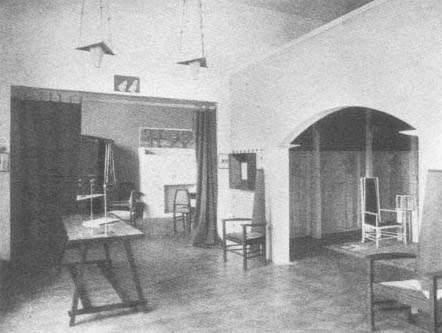
Fig. 48.
The 1902 Moscow Exhibit of Architecture and Artistic Crafts in the New Style. Table,
by Konstantin Korovin; armchairs, by Charles Rennie Mackintosh. At right : a partial
view of the sitting room designed by Mackintosh. Mir iskusstva , 1903.
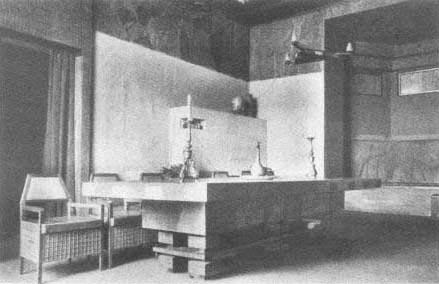
Fig. 49.
Dining room of gray maple, by Ivan Fomin. 1902 Moscow exhibit. Mir iskusstva ,
1903.
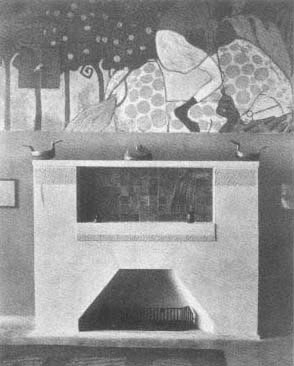
Fig. 50.
Sandstone fireplace with tiles, by Ivan Fomin; frieze, by
Vladimir Egorov. 1902 Moscow exhibit. Mir iskusstva ,
1903.
Arkhitekturnyi muzei .[37] (It is symptomatic of the chaos in Russian art publications that neither journal lasted beyond mid-1903.) Arkhitekturnyi muzei published a generally favorable review of the exhibit by Vladislav Karpovich, who also paid special tribute to the work of Ivan Fomin, though in curious terms (Fig. 50). Fomin's elegantly restrained furniture and interior designs conveyed, according to the critic, an almost overwhelming sense of ennui peculiar to the times: "The pessimism reigning in our time, both in life and in literature, has been expressed quite strikingly in the architectural [i.e., interior] work of I. A. Fomin."[38] Karpovich did not explain how Fomin's work expressed such pessimism, but the somber appraisal seems to link the architect to an illdefined longing associated with Chekhov's plays.
Zodchii published two appraisals of the show, both generally positive. The first, by Aleksandr Dmitriev, summarized the exhibits in detail but offered little critical insight. The second, by N. Filianskii, is interesting for its introductory remarks, which related the Abramtsevo community to the new design on display in Moscow. Filianskii was one of the first critics to comment on this relation; and if, in his opinion, the Abramtsevo workshops had entered an irreversible decline, they had nonetheless planted the "seed" of the modern movement that was now flowering in the work of architect designers such as Fomin and Shekhtel.[39]
The Moscow exhibit was followed almost immediately by one in Petersburg arranged by a group of artists and designers (no professional architects) under the auspices of Mir iskusstva . The show, "Contemporary Art," which opened on 16 January 1903, was the debut of a design atelier of the same name. After a few months of indecisive results, the financial backers abruptly withdrew and the enterprise folded in the fall of 1903. The show itself was a qualified success. Golovin designed a garishly colored teremok , or "residence" (the only room in the neo-Russian style), Korovin an understated tearoom (Fig. 51), and Aleksandr Benois and his nephew Evgenii Lanceray a dining room with wall paintings of idyllic classical scenes, rococo furnishings, and a table set resembling the work of Mackintosh (Fig. 52).[40] Diagilev, in a sympathetic but critical commentary, noted an air of unreality about the designs (with the exception of Korovin's) and suggested that the show needed a practical, knowledgeable architect who could "transform a fairy-tale castle into a livable home and a stage set into [a place for] ordinary life." In contrast to Diagilev's as-
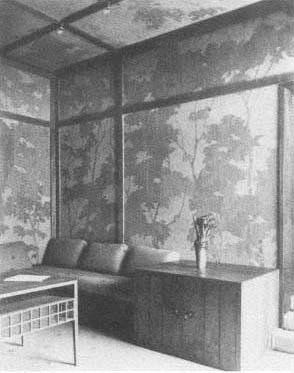
Fig. 51.
Tearoom, by Konstantin Korovin. 1903 Petersburg
exhibit "Contemporary Art." Mir iskusstva , 1903.
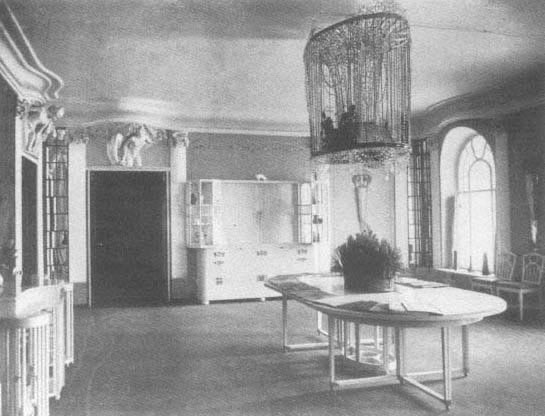
Fig. 52.
Dining room, by Aleksandr Benois and Evgenii Lanceray. 1903 Petersburg exhibit, Mir iskusstva , 1903.
tute criticisms, Evgenii Baumgarten's report on the exhibit in Zodchii complimented the artists and noted Otto Wagner's influence on the furniture design.[41]
Other exhibits in Moscow related to the new style included the Architecture and Art show, in April 1904, which included decorative art from the Stroganov School of Technical Design and the Abramtsevo workshops.[42] A similar exhibit took place in Petersburg in March 1905, with new designs by Fomin and Aleksei Shchusev—including a striking freestyle design by Shchusev for a church-monument at the Kulikovo Pole (Snipe Field) battleground.[43] Although these exhibits had a more limited range than the journal articles, they nonetheless provided exposure and the opportunity for a more direct exchange between the artist and the viewing public. As such they served admirably to further the careers of Fomin and Shchusev, whose considerable talent and professionalism were widely commented on in the journals.
At a time when the Moscow and Petersburg exhibits were demonstrating the variants, both Russian and European, of the new style, critics began to take note of another center of innovative design within the Russian empire. The extraordinary resurgence of architecture, design, and the applied arts in Finland has been studied extensively, and it need only be noted that Russian critics were among its greatest supporters. The ubiquitous Pavel Makarov surveyed current Finnish architecture and design in the same issue of Zodchii (6 April 1903) where he discussed the work of Aksel Gallén-Kallela, known as the illustrator of the Kalevala but mentioned by Makarov for his contributions to the design and crafts revival. Makarov also mentioned Louis Sparre and expressed admiration for the work of Eliel Saarinen.[44] The article included photographs of the landmark Finnish Pavilion for the 1900 Paris Universal Exhibition and the building for the Pohjola Insurance Company (1901), both designed by Saarinen with Herman Gesellius and Armas Lindgren. The similarity of the Pohjola building to Petersburg's commercial buildings suggests a shared "northern moderne" in the architecture of Helsinki and Petersburg.
Russian critical commentary, however, continued to focus on the Vienna Secession and its factions. In the September and October 1903 issues of Zodchii , Aleksandr Dmitriev surveyed recent Secession exhibits at Darmstadt, Düsseldorf, Turin, and Paris. He also commented on the prominence in applied arts of such American firms as Rockwood Porcelain and Tiffany glass.[45] The penultimate December issue of the journal reported on the building of skyscrapers in America—a topic that interested Russian observers, although skyscraper design had little effect on Russian architecture before the 1930s.[46]
In addition to the essays and reports on contemporary architecture, Zodchii continued to provide its readers with references to foreign books both on technical topics and on the work of specific architects such as Wagner, Mackintosh, and Baillie Scott. Among its frequent summaries of items from journals such as Der Architekt and The Studio, Zodchii featured a photograph of Otto Wagner's entrance portal for the telegraph offices of Die Zeit (1902), with a commentary by Aleksandr Dmitriev. Reacting against the curvilinear excesses of the new style, Dmitriev praised the "classical resolution" with which Wagner defined the rectangle of glass and aluminum over an iron framework.[47] Such comments suggest a turn to classical values (as distinct from a neoclassical revival) in Petersburg architecture at the end of the decade (see chapter 5).
By 1904 most of the new architectural journals had passed from the scene, leaving Zodchii and Stroitel as the profession's two major publications—until 1906. Indeed, 1904 was the last year in which the style moderne received extensive coverage in the architectural press. The most entertaining and perceptive critical summary of the new style appeared in Zodchii in 1904 as a four-part article entitled "Contemporary Moscow." The pseudonymous author, an enigmatic "Ivonne d'Axe," presents her impressions through the literary ruse of a foreign observer commenting on native life in a humorous yet sympathetic tone. In the foreword, the editor, "B," carries the mystification further by claiming that the article first appeared as "Moscow moderne" in the dubious French journal La Grille .[48] This mild deception permitted a serious critical view, in both text and sketches, of contemporary architecture in Moscow.
The author comments generally in the first part of the series on the derivative nature of the Russian moderne in its early phases:
Thanks to thousands of illustrated editions and easier travel abroad, the revival of the "end of the century," which gave rise to a tide of new artistic ideas in Europe, found its reflection here [in Moscow] and took a most original form. Especially in the mansions. I was in ecstasy over the
directness, the naïveté, with which an artist here creates and applies a form without the least concern for its content.[49]
The critic pursues this point in remarks on the modern style as a decorative system indifferent to structural problems.
The two following installments of "Contemporary Moscow" concentrated on the work of Viktor Vasnetsov (including the Tretiakov Gallery), Lev Kekushev, and William Walcot, all represented primarily by the private houses that so moved Ivonne d'Axe.[50] The final segment examined work by two of the most important architects of the new style, Fedor Shekhtel and Ivan Fomin, identifying the style moderne as the guiding trend in Russian architecture at the beginning of the century. Yet the critic shrewdly observed that the style, for all its novelty in Moscow, was at one with the city's traditional architecture:
Representatives of past trends sometimes try to resurrect the severe classical style; but now, like it or not, they must come to terms with the contemporary, liberal demands of society. And like it or not, the columns that formerly enclosed half of the visible horizon now cling timidly to the wall. The general direction of Moscow architecture now, however, differs little from that of four centuries ago: the spirit of the people has remained the same. . . . The motifs are just as naive, just as unexpected now and still amaze us with their contrasts, combining prayers to heaven with bows to mammon.[51]
No other critic of the time expressed so clearly the underlying continuity between the traditional architecture of Moscow and the local interpretation of the style moderne—for all its debt to the contemporary architecture of Europe.
"Contemporary Moscow" did not, however, analyze the principles that defined the best of the new architecture. For that one must turn to a small book, The Rational in the Latest Architecture , published in 1905 by Vladimir Apyshkov, who graduated from the Institute of Civil Engineering in 1901 and subsequently taught there while continuing to study at the Academy of Arts. That he wrote the book as a text for architectural courses may explain its concise, lucid presentation. (The text, without the photographs, is sixty-five pages long, with seven chapters and a conclusion.) The chapters—some as brief as five pages—examine contemporary architecture in England, Belgium, France, Germany, Austria, Finland, and Russia.[52]
Apyshkov's information could be found in any number of articles appearing during the preceding four years in such journals as Stroitel and Zodchii . But Apyshkov synthesized the national styles into a coherent movement of architecture from eclecticism to modernism. Although he recognized the shortcomings of much of modern architecture, particularly in Russia, he believed that inevitably architecture would be based on a rational union of structure and form. To this end he brought his readers back to the source of so much common sense in Russian architectural thought—Apollonarii Krasovskii and his book Civil Architecture .
Like many Russian observers of the new style, Apyshkov acknowledged England's importance in healing the nineteenth-century rift between structure and appearance, architecture and decoration. The role of England was "comparable to [that of] Italy during the Renaissance."[53] For Apyshkov, however, John Ruskin, whose works he carefully cited (they had by then been translated into Russian), was less important to modern architecture than Otto Wagner. Apyshkov not only interpreted Wagner's work succinctly—including the dictum on beauty and practicality that so alarmed Baumgarten—but also linked Wagner's work with the rationalism of Krasovskii.[54]
In assessing Russian efforts in the new style, Apyshkov, like several critics who had preceded him, maintained that Russia had accomplished little more than a "blind imitation" of various European trends. His knowledgeable summary included examples from Petersburg (where he saw little of value) as well as Moscow, where the style had achieved an original expression in the work of Walcot, Shekhtel, and Kekushev. Like Ivonne d'Axe he noted the Russian propensity to strive for new forms and decorative effects applied "with no organic link to construction."[55]
No critic of the period was better qualified by training and talent to evaluate this link—or lack of it (unlike Makarov and Baumgarten, Apyshkov was himself a distinguished architect; see chapter 5). As both architect and teacher, Apyshkov no doubt understood the practical and theoretical value of Krasovskii's rational architecture. In the conclusion to his book he offered his greatest insights into the relation between form and structure. The conclusion begins, appropriately, with an epigraph from Krasovskii's Civil Architecture on the
danger of divorcing decoration from structure. Architecture at its best has always arisen from a balanced system that relates function, form, climate, and material—a system epitomized by the architecture of ancient Greece. The ultimate goal of architecture is still to transform "the useful into the beautiful"; to this end Apyshkov rejected what he interpreted, exaggeratedly as the radical functionalism of Leopold Bauer.[56]
Apyshkov's defense of aesthetics is distinguished from Baumgarten's diatribe against Die moderne Architektur by its assured recognition of Otto Wagner's leadership in the aesthetics of modern design. Wagner's bridge at Nussdorf, its massive abutments decorated with two figures of standing lions, exemplified for Apyshkov the union of technology, function, and aesthetics; and his comments on this structure conclude with a passage that echoes Wagner: "A work of architecture that lays claim to artistic significance should not contain lies and deception. . . . The true task of an artist in a given situation is to introduce the decorative element without contradicting utilitarian demands."[57] (In this spirit Apyshkov persistently attacked the use of stucco as both deceptive and unhygienic.) Only when the form of a building fits its purpose can the building's appearance undergo refinement.
In advocating an architecture appropriate to the contemporary urban environment, Apyshkov rejected the "Don Quixotes tilting at windmills" who would deny that commerce influenced architecture: "The disparity between the forms of our architecture and the demands of life . . . becomes still clearer when we see how life, unable to deal with the abstract constraints of academic traditions, pitilessly destroys the old forms and advances its own—perhaps not aesthetic, but nonetheless significant." Apyshkov's approach, like Makarov's, was democratic and antiacademic: "The task of a true artist is . . . not to struggle with the practical and expedient but rather to transform them into the aesthetic."[58]
However diverse its manifestations, the modern movement often united the practical and the aesthetic by drawing on the aesthetic sensibility of artists (Apyshkov mentions the English in this regard but might have said the same of the Russians) and by using innovatively such materials as ceramic facing and iron. The falsity of the stuccoed facade had been exposed, and with it the impracticality and illogic of decorative motifs and details from the academic Renaissance repertory. Without succumbing to a strict functionalism, modern architecture, in Apyshkov's view, had demonstrated a new understanding of structure and ornament, applicable on a broad, socially unrestricted, scale:
A particular feature of the latest architecture is its return to the enlivening effects of color and light that were completely forgotten during the epoch of enthusiasm for "Renaissance" forms.
Here we must also note joyfully another trait of the latest art, based on the deeply held democratic views of contemporary society: its aspiration to serve not only a limited circle of rich people . . . but also the poor folk by carrying light, joy, and warmth into their domiciles.[59]
It must be admitted that the style moderne in Russia did little to exploit the potential of a new architecture for the masses, despite the noble expressions of Makarov and Apyshkov. It continued to depend primarily on the creative relation between bourgeois entrepreneurs and a group of talented architects. Nonetheless, for supporters of an innovative art like Apyshkov, the moderne promised liberation:
Modernism . . . in its best works represents a great liberation from the worn and confining traditions in art.
No one who holds art dear can oppose this movement, whose force is not in the subjective views of individuals but in a deep and solid bond with our culture, our technology, the best democratic aspirations of our century, and the nascent demands of the truly beautiful.[60]
These concluding words of The Rational in the Latest Architecture are the clearest expression of an idealism that guided many proponents of the new style. Although Apyshkov cannot be compared with Otto Wagner as a theoretician, both men believed profoundly in the social mission of architecture and in the need to transmit the values of rationality in architecture to a new generation of builders.
Apyshkov's synthesis of modernist trends and his definition of Russian rationalism from Krasovskii to the latest architecture implied a hope that building design in Russia, firmly grounded in the native social and cultural environment, would soon equal that of the rest of Europe. Even he, however, acknowledged that the beginnings of the new style were tentative, concerned with
form rather than substance. Other critics sympathetic to the new style made this point still more forcefully. Mikhail Syrkian, in his 1903 essay "The New Style," suggested that the proponents of innovation were in danger of missing the essentials, of substituting decorative trends for structural logic:
Contemporary art has continued to devote its attention to the forms themselves rather than to their technical basis in construction. . . . The principle of correspondence between decoration and construction has long been known, but obeisance to it has been rendered only in theory: the organic harmony between these elements in architecture has not been achieved, mainly because no one has seriously looked for it.
In sum, we have created a new art from the wrong end. The artistic in architecture is based on constructive truth, manifested in two ways: in composition that flows from the function of the building and the mechanical properties of the material; and in forms defined by their role as symbolic expressions . . . linking the building and its purpose. Neglect of this truth has cost the past century dearly and is also the basic failing of contemporary architecture: it lacks logic .[61]
Syrkin proclaimed that aesthetic pleasure occurs when architectural form characterizes structure, when all the architectural elements are "tightly interconnected"; to the extent that the new design has overlooked this connection, it is in danger of becoming another discarded stylistic phase.
The trend to a rational interpretation of the style moderne toward the end of the decade is exemplified in the persistent charge of "form without content" leveled against the style by critics sympathetic to the modern movement. The new emphasis on rationalism received its most rigorous theoretical statement in Boris Nikolaev's The Physical Principles of Architectural Form . This book, which appeared in 1905, the same year as Apyshkov's, took a complementary approach:while Apyshkov, having observed the contemporary scene, prescribed an innovative and rational architecture, Nikolaev proceeded directly to a theory of structure based on innate "physical" principles in nature.
Like Apyshkov, Nikolaev advocated a clear statement of architecture's proper values, to be inculcated by architectural schools. As a professor at the Institute of Civil Engineering, he objected strenuously to the routine teaching of an architectural "canon" inherited from the Renaissance. He attacked what he saw as outmoded values—derived from the imitation of architectural systems in their decline—not only in his book but also in Zodchii , where in 1905 and 1906 he wrote extensively on the role of theory in architectural instruction.
For Nikolaev architecture could be reinvigorated only if academic instruction changed: "Everywhere architecture is taught, the clumsy and lifeless canons created four hundred years ago are considered infallible to this day. It is quite natural that youth, whose best years have been lost studying these lifeless objects, creates rough and unfinished things when faced with the demands of life."[62] An insidious pattern of thought based on the imitation of unquestioned values extended even to the reproduction of modern clichés, with equally lifeless results. Nonetheless, Nikolaev found value in the new style (tellingly, in its Moscow variant):
In favor of the latest works of Vasnetsov, Korovin, and others—despite their often childish naïveté, despite their "illiteracy," and even despite the lack of external, formal logic—there is nonetheless something that surpasses both the school and the polish of the academic trend. That something is sincerity as well as the desire to express one's own idea and not repeat for the hundredth time someone else's.
One senses that these naive works reveal thought of great social significance, insofar as it can be expressed in architecture: in them one senses "man" with all his soul and not the decorative material for grand occasions.[63]
Nikolaev openly disdained the pomposity of much "official" Russian architecture at the turn of the century, which continued to flourish in architectural schools. "Life and its demands and logic seem not to exist in the teaching of artistic architecture."[64]
Nikolaev's theory on the decline of architectural systems in The Physical Principles of Architectural Forms is at once eccentric and cogently argued, but his most innovative thought is expressed in the concluding passages on a new approach to design:
Besides logic and judgment, architects can draw ideas from nature itself. . . . The trunks of trees, the bones of animals—the parts that demand solidity and economy of material—in no way remind us in their frame and form of the out-
moded . . . "classical" columns. . . . The main idea that nature follows in her works—usefulness, the shortest path to the achievement of a goal—should also lie at the basis of architectural creativity and academic instruction.
It is time to discard the dead idea that form can have a canon. Form should be as infinitely varied as the conditions creating it; and the only "style" that an artist should strive for in his work is the style of nature, the style where nothing is superfluous, where everything makes sense and serves the basic idea.[65]
To answer Syrkin's call for "constructive truth," Nikolaev derived a concept of structure from the logic of nature itself; in so doing, he proceeded beyond Krasovskii's and Apyshkov's functionalism, with its concern for the aesthetic refinement of structure. Nikolaev's book is the most radical prerevolutionary statement of a new architectural system, one that originated from a reformed approach to architectural education based on logic, reason, and unfettered thought: "Only a firm and precise awareness of the principles of mechanics, only constant attention to the pure source of eternal logic can provide a firm ground for free creativity—unbounded by routine—in life and particularly in architecture."[66] Any other approach inevitably meant that "yesterday's revolutionaries have become conservatives, creating new canons to consolidate their position." Nikolaev's rigor anticipated a pattern in postrevolutionary architectural thought in the 1920s; but the response to his writings on architectural education was generally unsupportive, and apparently the architectural curriculum based on a study of the "Renaissance canon" underwent no significant change.[67]
Although no architectural treatise published before the revolution matched the spirited freedom and innovation of Nikolaev's Physical Principles , essays and other books on architectural questions demonstrated the continuing vitality of professional discourse. The revolutionary events of 1905 had only a peripheral effect on architectural thought, and they were largely ignored by the journals; yet afterward there appears to have been a greater awareness of social responsibility in architecture and, above all, in the related topic of urban planning.
It is clear, however, that the style moderne offered few theoretical underpinnings for a fundamentally new architectural system. As a symbol of the overthrow of old forms, it served for some critics as an intermediate stage—imperfectly realized—in the movement toward a more thoroughgoing innovation in design. And the use of new materials and technology in certain "rationalist" commercial structures of the moderne opened the way for a discussion of the aesthetic possibilities—and challenges—of technology.
Indeed, there were those like Pavel Strakhov, the author of The Aesthetic Goals of Technology (1906), who argued for technology as the basis for a new aesthetic in architecture. Strakhov pointedly criticized John Ruskin for an excessive distrust of technology. According to Strakhov, technology could liberate architecture for new aesthetic standards, particularly if such materials as iron and steel were used to combine beauty, functionalism, and structural integrity on a large scale.[68] Strakhov and other proponents of a new style equated innovations in architecture and technology with a new social order, more just and less exploitative—an approach that led in its extreme meliorist form to a book on city planning with the intriguing title Socialism without Politics , by V. Dadonov (1912).[69]
The notion of an "iron style," proposed by Strakhov and implicitly supported by Nikolaev, probably derived from sources in continental Europe, where ferroconcrete was widely used. In August 1903 the prominent engineer-architect Nikolai Dmitriev published the lead article in Zodchii , illustrating the possibilities of ferroconcrete, with references to German sources.[70] Other articles of the period that advocated a closer link between technology and architectural design in Russia had limited results, especially in comparison with those achieved in the United States.[71] Indeed, Russian architectural critics at the beginning of the century did not accept the technological, functionalist orientation as ineluctable: in 1905 Aleksei Shchusev argued eloquently in Zodchii that great architecture frequently violates strict considerations of structural logic to create new architectural forms.[72]
Critical writing during the decade of the style moderne endorsed a multitude of competing, often contradictory, approaches to architecture. Despite the persistent note of cultural pessimism and frustration, all but the most reactionary critics hoped that a revitalized architecture would bring about a social and aesthetic liberation that in turn would take Russia into the modern. age. At the same time, neither the supporters nor the
architects of the new style could claim the sense of mission evident in the work of Otto Wagner or Frank Lloyd Wright—who was of the same generation as Shchusev and Apyshkov.
With the partial exception of Apyshkov, no important Russian architect of the period articulated a program for the new style, a statement of relevance to the modern age from which it drew its name. For all the idealistic hopes of Makarov, Apyshkov, and others, whose discourse anticipated the critical brilliance of the 1920s, the architectural profession remained beholden to many masters and uncertain of its social or aesthetic accomplishments. Yet despite the banality of designs that repeated the worst excesses of eclecticism, the new architecture flourished with an exuberant variety that was particularly evident in Moscow.
Chapter Three—
The Style Moderne in Moscow
The architectural transformation of Russia's major cities at the turn of the century has no clear point of origin. There were no programmatic statements like Otto Wagner's Moderne Architektur or harbingers like Joseph Olbrich's Secession House in Vienna. Speakers at the Third Congress of Russian Architects, held in Petersburg in 1900, made little reference to new developments in architecture, though they no longer debated the relevance of medieval Russian architecture to the creation of a national style.[1]
Nonetheless, there were signs at the meeting of innovative forces at work beyond the congress hall: the architectural exhibition included project designs by Fedor Shekhtel, the most talented architect at work in Moscow; and presentations on technology at the congress far outnumbered those on "artistic" issues—evidence that new materials were taking the profession beyond historical and ideological discourse toward a new rationalism. Even the traditionalist Alexander Bernardazzi, whose Odessa Stock Exchange (1899) borrowed freely from the Palace of the Doges, spoke approvingly of architects' using glass, steel, and new technology.[2]
This attention to technology at the turn of the century does not, however, imply a neglect of aesthetic issues. Architectural journals frequently referred to John Ruskin, William Morris, the English Arts and Crafts movement, and the work of the Abramtsevo community, demonstrating the vigor of aestheticism in both design and architecture during this era of commercial and industrial expansion. Yet no group of architects—or patrons—established a monopoly on the development of a new aesthetic approach to architecture.
The protean character of the style moderne in Russia reflected its varied sources of inspiration, from Vienna to Glasgow. Even Shekhtel's work, which gave the style a coherent and expressive form, covered an extraordinary range of styles, borrowed and recombined. With its diverse sources and forms the style moderne was eclectic. But this eclecticism was not that of nineteenth-century patterned facades or re-created historicist styles; instead it was characterized by a new integration of structure, material, and decorative motif. Its development, moreover, followed no easily traceable path. Russian practice was adaptable, with a fondness for striking decorative effects, and every notable architect working in the new style interpreted it differently.
If the urge to name a first example of the Russian moderne were irresistible, the odd but charming Gausvald dacha on Petersburg's fashionable Stone Island, by Vladimir Chagin and Vasilii Schöne, would be a good choice (see Fig. 212).[3] But it was in Moscow, during the turn-of-the-century building boom, that the style moderne began to achieve a distinctive expression. The free choice and stylistic extravagance of the 1890s are both well represented in the house that V. A. Mazyrin built in 1894–1898 for Varvara Morozova, a leading fig-
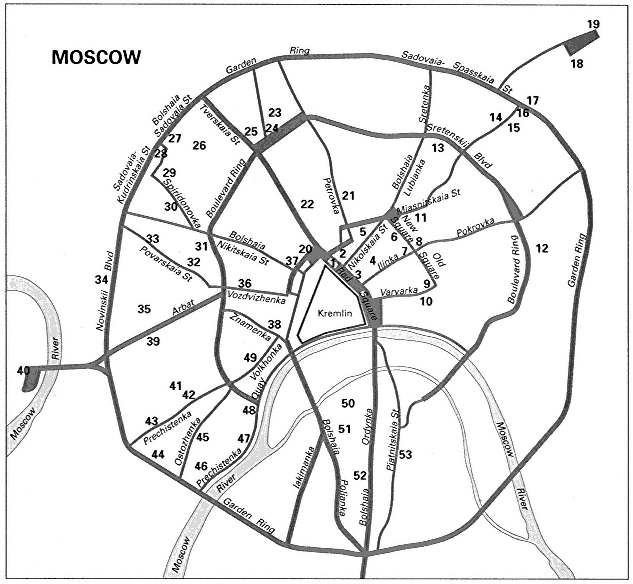
1. Historical Museum
2. Moscow Duma (city hall)
3. Upper Trading Rows
4. Riabushinskii Bank
5. Hotel Metropole
6. Moscow Merchants' Society
7. Nothern Insurance Company
8. Polytechnic Museum
9. Boiars' Court Hotel
10. Delovoi Dvor
11. M. S. Kuznetsov building
12. Podsosenskii Lane apartments
13. Rossiia Insurance Company apartments
14. Kuznetsov apartment house
15. Stroganov School apartment house
16. Levin apartment house
17. Afremov apartment house
18. Kazan Station
19. Iaroslavl Station
20. Hotel Natsional
21. Muir and Mirrielees
22. Moscow Art Theater
23. Moscow Merchants' Club
24. Utro Rossii building
25. Sytin Printing House
26. Levenson Printing Works
27. Shekhtel house
28. Skopnik apartment house
29. Tarasov house
30. Z. Morozova house
31. S. P. Riabushinskii house
32. S. Solovev house
33. Mindovskii house
34. Shcherbatov apartment house
35. Vtorov house
36. A. A. Morozov house
37. Zoological Museum
38. Shamshin apartment house
39. A. T. Filatova apartment house
40. Kiev Station
41. Moscow Homebuilders' Society
42. N. I. Mindovskii house
43. Isakov apartment house
44. Derozhinskaia house
45. Kekushev house
46. Church of the Intercession on Ostozhenka
47. Tsvetkov house
48. Pertsov apartment house
49. Museum of Fine Arts
50. Tretiakov Refuge
51. Tretiakov Gallery
52. Mary-Martha Cloister
53. Korobkov house
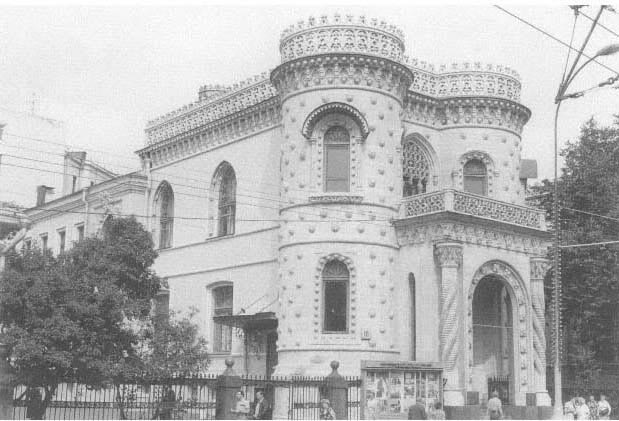
Fig. 53.
Abram Abramovich Morozov house, Moscow. 1894–1898. V. A. Mazyrin (Brumfield M162-12).
ure in Moscow's progressive cultural and intellectual circles. Although estranged from her husband (Abram Abramovich, identified as the owner of the house), she had a large fortune, which she applied unstintingly to this "castle" in central Moscow (Fig. 53). Trees now obscure the extent of the structure, but the twisted columns at the entrance and the shell-encrusted facade identify its source as Portuguese Renaissance, probably copied from the Palácio de Pena at Sintra (itself a nineteenth-century stylization of earlier Portuguese architecture).[4]
The A. A. Morozov mansion is an extraordinary monument to the entrepreneurial spirit, but it was not an isolated example of the Moscow merchant elite's lavish expenditure on its homes. The frenetic eclecticism exemplified in this mansion—beyond historicism but not yet of the new style—had important results, as Boris Freudenberg's ebullient building for the Sandunov Baths demonstrates. The entrance arch of this large structure (1894–1895), which also contained apartments and commercial space, provides a focal point often lacking in Petersburg's commercial and apartment blocks. Rising to the cornice line, the arch establishes the basic motif, reflected in the second-story windows (Figs. 54, 55) and repeated in their mullions. A large dome above the arch completes the design. Although the building, with its riot of high-relief sculpture, is no model of good taste, as public architecture it has a clarity of emphasis and delineation unusual in Moscow architecture of the period.
The transition to the new style and the change it entailed are evident in another monumental structure begun at the end of the century—the Hotel Metropole. The Petersburg Insurance Society commissioned it to provide Moscow with a hotel meeting international standards of design and luxury. The design competition was initiated in 1896, and when Nedelia stroitelia published the results in 1899, a collective of architects (unspecified) placed first. The eventual designer of the
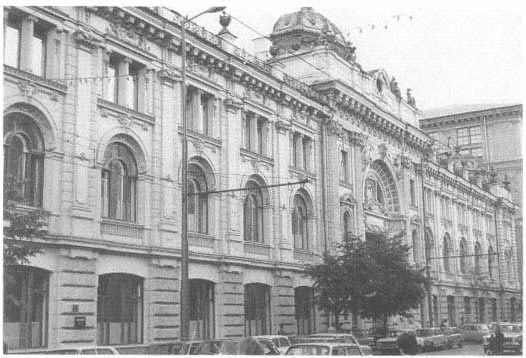
Fig. 54.
Sandunov Baths, Moscow. 1894–1895. Boris Freudenberg (Brumfield M147-37).
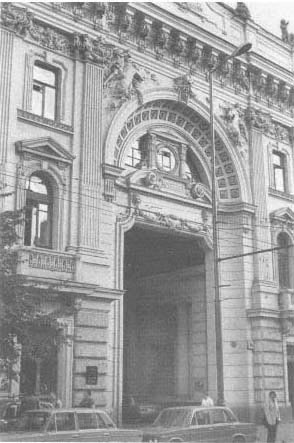
Fig. 55.
Sandunov Baths, central arch (Brumfield M147-35).

Fig. 56.
Project sketch for Hotel Metropole. William Walcot. Zodchii , 1899.
building, however was the English architect William Walcot, who had placed fourth.[5] Even Walcot's design (Fig. 56) was substantially modified—in certain respects almost beyond recognition—before work began in 1899. During the five years of construction (which included rebuilding after a fire in 1901), other artists and architects were involved in the project—most notably Lev Kekushev, who supervised the construction and added elements of his own, but also Adolf Erikhson, Viktor Vesnin, and possibly Fedor Shekhtel.
Walcot, whose career in Russia deserves more study, had designed two large houses in Moscow, one of them among the best examples of the severe "rationalist" moderne (Fig. 57),[6] and had published project sketches in journals such as Arkhitekturnye motivy , all of them more flamboyant than the houses (Fig. 58). None of this work is on the scale of the Metropole; Kekushev's assistance was probably crucial to the final realization of this complex structure, with its immense dome of glass and iron over an interior court.
The Metropole is a landmark of the style moderne, for reasons that include its lack of any reference to the orders of architecture (Fig. 59). Even buildings firmly in the Russian Revival style—the Duma and the Upper Trading Rows—had used components of these orders—pilasters, capitals, and architraves—to delineate the facade, and eclectic structures such as the Sandunov Baths vigorously modified them. The Metropole did neither, though it has elements of horizontal and vertical emphasis, a large arched form above the main facade, and even small turrets or pinnacles along the roof, with their columns arranged in a rotunda—a detail that is hardly noticeable.
The new style replaced hierarchy with tectonics—a structural mass shaped without reference to illusionistic systems of support. Texture and material played a dominant expressive role, exemplified at the Metropole by the progression from an arcade with stone facing on the ground floor to inset windows without decorative frames on the upper floors, which were faced in plaster over
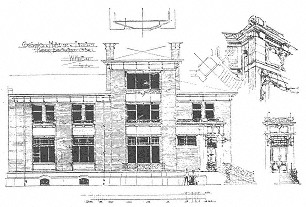
Fig. 57.
House for the Moscow Homebuilders' Society. 1903.
William Walcot. Ezhegodnik Obshchestva
arkhitektorov-khudozhnikov , 1906.
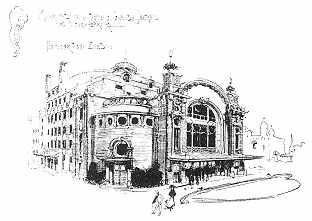
Fig. 58.
Project sketch for theater in Novocherkassk. William
Walcot. Ezhegodnik Obshchestva
arkhitektorov- khudozhnikov , 1906.
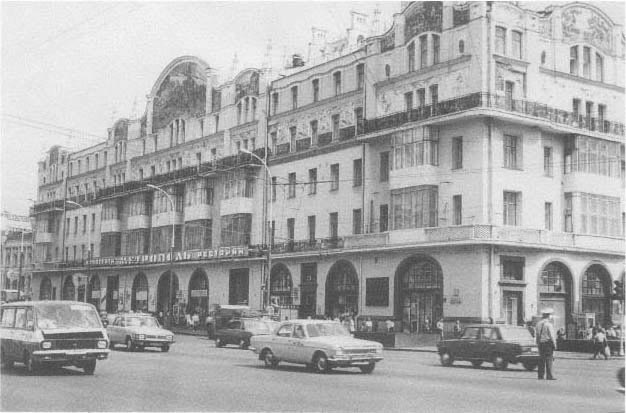
Fig. 59.
Hotel Metropole. 1899–1905. William Walcot (Brumfield M147-18).
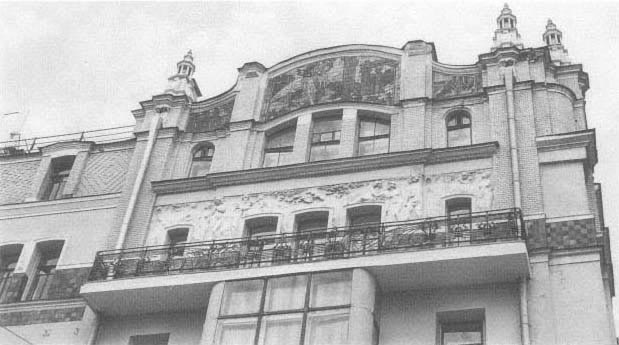
Fig. 60.
Hotel Metropole. Ceramic panel by Aleksandr Golovin and frieze by Nikolai Andreev (Brumfield M147-17).
brick. The two central stories are set between strips of wrought-iron balcony; glass bays in the center and near the corners of the main facade provide vertical accents.
Paradoxically, this new relation between structure and material at the Metropole enabled the architect to use the facade as a ground on which to mount other art forms, such as the plaster frieze by Nikolai Andreev, The Four Seasons (along the fourth floor); seven ceramic panels designed by Aleksandr Golovin above the fifth story (Fig. 60), and, most prominent, the ceramic panel in the great arch at the center of the main facade, The Princess of Dreams , designed by Mikhail Vrubel and based on the play La Princesse lointaine (1895), by Edmond Rostand (see Plate 8). Both Vrubel and Golovin had been active in the Abramtsevo community.[7]
The new aestheticism, which had begun in the modest experiments of "amateurs" at Abramtsevo, now asserted itself on an unprecedented scale in a "first-class hotel" (as it was labeled in the competition projects), a reinforced-concrete building financed by an insurance company and demanding the most advanced technical resources. Other luxury hotels of the period, such as the Natsional in central Moscow, show the same expert use of the decorative arts (see Plate 9). As the first major example of the new style in Moscow, however, the Metropole revealed most clearly a tension between structure and decoration that characterizes early examples of the modern. The attempt to integrate these elements often led in practice to a superficial application of art nouveau motifs or, as in the Metropole, a contest between structural clarity and the facade as a surface for the display of artists' and sculptors' work.
The balance between architecture and decoration appeared most successfully in Viktor Vasnetsov's design for the expansion of the Tretiakov Art Gallery. It is appropriate that this painter-architect who had contributed so much to the success of the Abramtsevo colony should design a building for the first major display of Russian art in Moscow. In his design, architecture harmonizes with the applied arts as in the Abramtsevo church, but here Vasnetsov also applied his idea on a far larger scale in a building not directly related to the religious architecture of medieval Russia.
Vasnetsov did not, in fact, build the entire Tretiakov Gallery. The building that housed the collection was part of a merchant compound that included warehouses
as well as the Tretiakov home. The home and its attached storage structures, enlarged in 1873 to accommodate a private art collection, had become a public museum in 1892, when Pavel Tretiakov donated his collection to the city of Moscow.[8] At the turn of the century Vasnetsov was commissioned to create a new main entrance and facade and in doing so provided a focal point for the structures grouped around a central yard (see Plate 10). The decoration of the new facade can be firmly dated to 1903 and was probably completed in 1905.[9]
Vasnetsov's facade is brick, lightly stuccoed and painted to give it a clear spatial outline and to provide a base for the folk-art decorative bands below the roofline. The topmost band is a ceramic frieze whose design resembles that of a fin-de-siècle symbolist painting; on the wide middle band is a large inscription on a white background, in the style of an old Russian manuscript, and below that, a decorative brick border. The inscription proclaims the gallery as a gift of Pavel and Sergei Mikhailovich Tretiakov; the white and brick red not only re-create a decorative contrast typical of medieval Muscovite architecture but also suggest the colors of medieval Russian icons—particularly fourteenth-century Novgorod icons of St. George on a white horse against a red background. In fact the limestone relief in the center of the facade portrays St. George slaying the dragon—the emblem of the city of Moscow.
Vasnetsov's adaptation of Russian motifs on the Tretiakov Gallery entrance is fundamentally different from that of the Russian Revival style, which encumbered its facades with "archaeological" motifs. For Vasnetsov, a solitary window in a medieval surround serves as a carefully considered reference to an artistic system of the past. The same can be said of the building to the left of the main entrance, whose decorative frieze echoes the ornamental patterns of Russian embroidery. The ogival roof (in the form of a medieval kokoshnik ) that encases the image of St. George suggests an elaborate icon frame.
None of these references to the Russian artistic heritage obscures the union of structure and function realized in the entrance, centered beneath the barrel roof, whose contours point downward to a two-storied window and a porch in the style of medieval Muscovy. Above, the museum skylights echo the pointed forms of the porch and the sculpture of St. George. To be sure, Vasnetsov's task was easier because the gallery specified overhead lighting, thus eliminating the need for windows on the facade. Even so, it is the artist's clarity of vision that endows the tectonic form with the painterly and rational qualities redolent of Russian art yet suited to a modern gallery. Unfortunately, Vasnetsov's combination of the traditional and the modern was a rarity among the art museums constructed in Russia at the beginning of the century.[10]
The Hotel Metropole and the Tretiakov Gallery represent two different tendencies of the style moderne, the first toward an international style and the second toward an innovative use of traditional Russian forms. Both buildings, however, place ornament in a new tectonic system made possible by advanced construction technology. Other large public buildings with similar characteristics will be discussed in this chapter and in the chapter on Fedor Shekhtel. The imaginative possibilities of the style are nowhere more clearly demonstrated than in Shekhtel's Iaroslavl Station, one of the few public projects actually constructed in the style moderne.
The moderne was most frequently applied, however, in the construction of housing—both private homes and apartments—in which the decorative arts were integrated with rationally arranged interior space. The efficiency, comfort, and technological progress represented in the large apartment building that is essentially a product of the new style accommodated the growth of the professional and middle classes living in central Moscow. Despite a desperate housing shortage for the lower classes, much of the city was still underbuilt; large apartment complexes thus made economic sense only if they could attract a reasonably prosperous clientele. To this end Moscow's architects at the beginning of the century assimilated the models of luxury housing in more developed countries.
A notably successful example of this assimilation appeared in two large apartment blocks on Chistoprudnyi Boulevard designed by N. M. Proskurin for the Rossiia Insurance Company (1899–1902). The distinctive style contains Italian Renaissance elements, with a dominant corner tower imitating Spasskii Tower, the main entrance to the Kremlin (Fig. 61), and an attractive open courtyard in the center. Le Corbusier was apparently much taken with the design, which in its way represents a self-contained habitation . Indeed, the primitive services in Moscow at the beginning of the century made it essential that large projects provide their own water, heat, and electricity.[11] In general only insurance com-
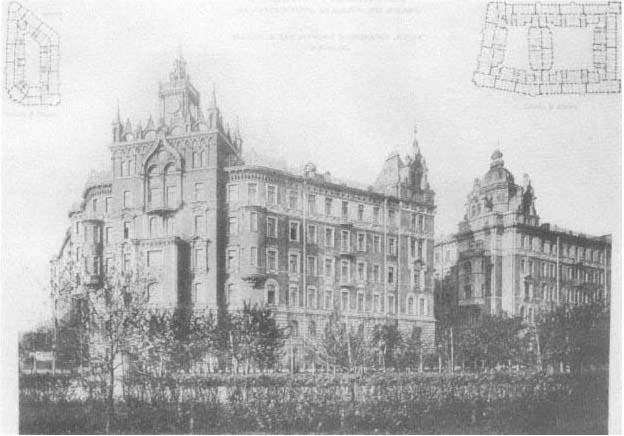
Fig. 61.
Apartment house of the Rossiia Insurance Company, Moscow. 1899–1902. N. M. Proskurin. Zodchii , 1905.
panies had the resources to invest in buildings and services on this scale (such was the case with the Hotel Metropole); the Rossiia firm had already undertaken a large apartment complex in 1898 on Lubianka Square. Although neither project shows much stylistic evidence of the moderne, both depended on the economic and social factors essential for the development of the new style.
On a more modest scale, A. L. Chizhikov's apartment building of 1901 on Sadovyi-Kudrinskii Street is an early example of the moderne aesthetic; its design was rational (that is, economical and spacious, with a convenient floor plan), and it was decorated in art nouveau motifs of plaster and wrought iron (Fig. 62).[12] The facade of the building is clearly delineated into vertical and horizontal components by large windows, a glass shaft in the center for the main stairway, and a projecting bay at either corner—all of which provided ample natural light for the interior. The solid design of this apartment house was well tested when three floors were added to the building in 1940.
To explore plasticity in form and decoration, Ivan Mashkov, in his design for the Sokol apartment house in Kuznetskii Lane (1902–1903), relied on several elements. The form of the building is simple: paired windows set into rectangular shafts in the facade. A curved bay at the center with molded windows and, at the upper floors, two balconies ornamented with ironwork, however, culminates in a ceramic triptych by Nikolai Sapunov, one of the most talented Russian set designers of the time. In it a falcon soars above a billowy sea that expresses the lyrical, romantic component of the style moderne. The ceramic work continues in a decorative frieze along the cornice that repeats the undulating pat-
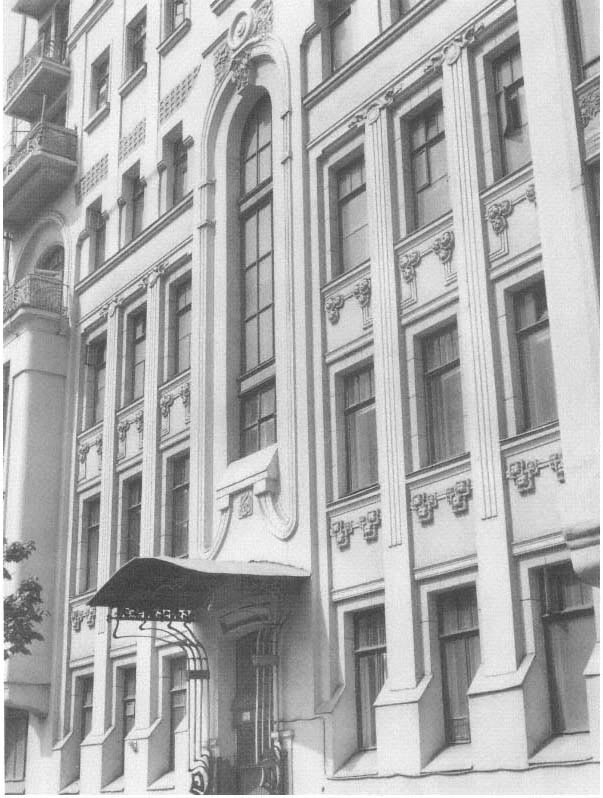
Fig. 62.
Apartment house, Sadovyi-Kudrinskii Street, Moscow. 1901. A. L. Chizhikov (Brumfield M102-6).
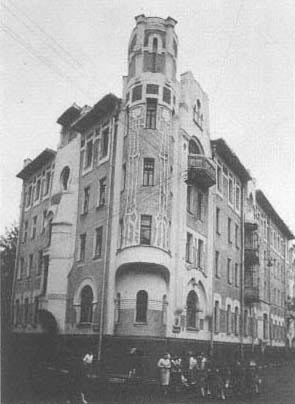
Fig. 63.
Apartment house, Podsosenskii Lane, Moscow. 1905.
Georgii Makaev (Brumfield M154-21).
tern. The use of decorative arts on the facade, now wretched in appearance, is most evident in the central panels, reminiscent of Vrubel and Golovin's work at the Metropole but also perhaps indebted to such Viennese antecedents as Otto Wagner's Majolikahaus (1898–1899).[13]
Structural fantasy appears more obtrusively in Georgii Makaev's apartment building of 1905 on Vvedenskii (now Podsosenskii) Lane. At the corner tower, with its floral plasticity and three-storied tulips, the two main facades intersect (Fig. 63). Although architects in the nineteenth century frequently exploited a corner location with a projecting tower, none remotely resembled Makaev's riotously curving design, which is reinforced by the asymmetrical decoration on each of the facades. The windows of the building are for the most part plain rectangles cut into a wall of roughcast; the undecorated background highlights the plaster strips and window surrounds on the first floor as well as the rounded bay on one facade and the steeply pitched curved pediment on the other. The contrasts in material, from the various stuccos and reinforced concrete cornice to the ironwork of the balconies (Fig. 64), emphasize the relation between structure and texture (in Russian, faktura ). Makaev showed little interest in balancing the forces he had put into play on the facades; but his florid decoration, amateurish in comparison with the Italian stile floreale or with Gaudí's work, nonetheless provides entertaining relief in the Moscow environment.
Lev Kekushev took a more professional approach to the plasticity of material in the new style. In his Isakov apartment house on Prechistenka (Kropotkin) Street (1906) Kekushev, among Moscow's most accomplished architects at the turn of the century, combined the style moderne with a neobaroque use of sculpted figures typical of art nouveau (Fig. 65). But apart from the curved mullions of the windows and the great undulating metal cornice, the main expressive element of the design is Kekushev's molded brick facade. From the projecting bays at either end to the recessed balcony at the center of the building, it is sculpted precisely and knowledgeably in accord with the tensile properties of brick, which had been praised as the ideal medium for rational architecture three decades earlier.[14]
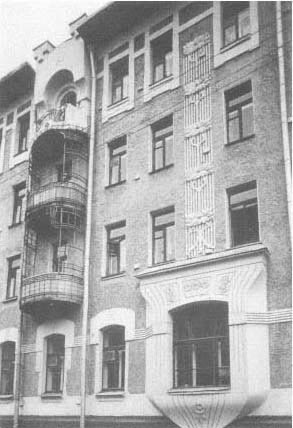
Fig. 64.
Apartment house, Podsosenskii Lane, detail
(Brumfield M154-22).
G. A. Gelrikh, less given to baroque decorative effects, more closely unified the rational and decorative in his style moderne apartment building for P. A. Skopnik (1908) on Sadovyi-Kudrinskii Street—opposite the Chizhikov building. He combined limestone, stucco, pressed brick, reinforced concrete, and roughcast panels (between the windows of the upper stories) to create a curved pattern of bays, towers, and rounded corners (Fig. 66). The corner tower, with a belvedere, rests on four muscular atlantes at the second-story level; although these forms were often squandered in Russian architecture of the nineteenth century, they seem to justify their straining form under the tower's projecting mass. The wave pattern of the overhanging cornice lacks the focus of that on Kekushev's Isakov apartment building and comes close to parodying the organic sculpted form (the projection may, however, serve a purpose during the spring thaw). The main entrance originally had an elegant enclosed porch facing what was then a tree-
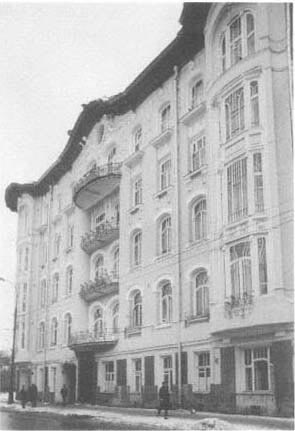
Fig. 65.
Isakov apartment house, Moscow. 1906. Lev Kekushev
(Brumfield M154-25).
lined boulevard; both the trees and the porch disappeared during a reconstruction of the Sadovyi (or "garden") Ring in the 1930s.[15]
Few buildings after the Skopnik apartment house displayed such energetic rhythm on the facade, though neither Kekushev nor Gelrikh approached the free form of Antonio Gaudí. The exterior symmetry of their buildings indicates a conservative structure and floor plan, designed for comfort, convenience, and the efficient use of space. By the end of the decade the distinctive curved forms associated with art nouveau—and with the style moderne at its most flamboyant in Russia—had been dismissed as ephemera of fashion. Nonetheless, apartment buildings for the affluent showed a structural pattern similar to that of the style moderne, as in the "castle" built by V. E. Dubovskii for A. T. Filatova on the Arbat (1913–1914). The curves have been replaced by sharply angled bays and pointed pediments, but the building has a corner tower, a frequent
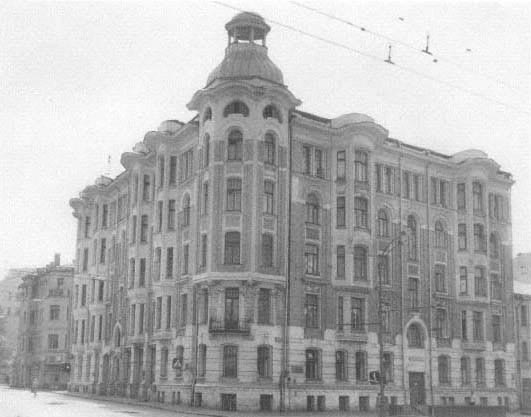
Fig. 66.
Skopnik apartment house, Moscow. 1908. G. A. Gelrikh (Brumfield M102-1).
feature of the style moderne, with armor-clad Teutonic knights perched on a console on either side and flanked by columns (Fig. 67).
Since the beginning of the decade, Dubovskii had specialized in pretentious apartment houses that commanded high rates, for both the architect and the property owner. In 1909 he had completed another building, closer in style to the moderne, for the merchant and rentier Filatov on a prominent site at the head of Ostozhenka Street. The structure's ornament was so peculiar as to provoke comment in the Moscow Weekly : "Every new year brings Moscow several dozen new monstrously absurd buildings, which tear into the city streets with a special abandon peculiar to Moscow. Where else would you find something like the new [apartment] house at the beginning of Ostozhenka . . . ?"[16]
In the midst of these stylistic effusions, other apartment complexes were designed more functionally to fill the need for living space in the central city. One of the earliest examples of middle-level housing on a colossal scale in Moscow was L. Shishkovskii's apartment house for F. I. Afremov (1904) on Sadovyi-Spasskii Street. The building was one of many constructed along the circular Sadovyi Ring, a tree-lined thoroughfare whose segments had names prefixed by the word sadovyi . (The Chizhikov and Gelrikh buildings are on another segment of the ring.) The extension of a tram network in 1904 brought such previously outlying districts within convenient reach of the central city, and the larger sites available near the ring permitted configurations in the apartment blocks other than the rectangular slab or the enclosed courtyard.
The Afremov building was one of the largest of these structures in prerevolutionary Russia—eight stories high (a few buildings in Moscow reached eleven stories; others were planned for thirteen). In addition to its long frontage on Sadovyi-Spasskii Street, the building had perpendicular wings extending from the back, increasing
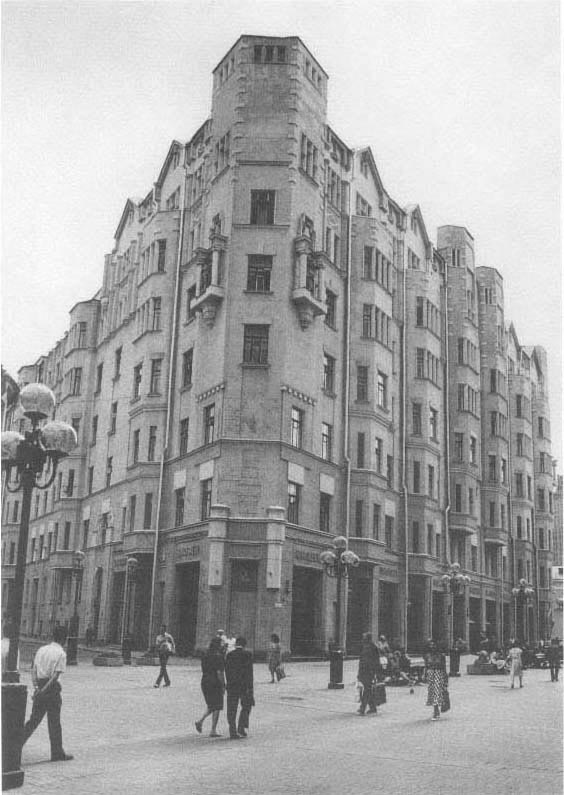
Fig. 67.
Filatova apartment house, Moscow. 1913–1914. V. E. Dubovskii (Brumfield M151-2).
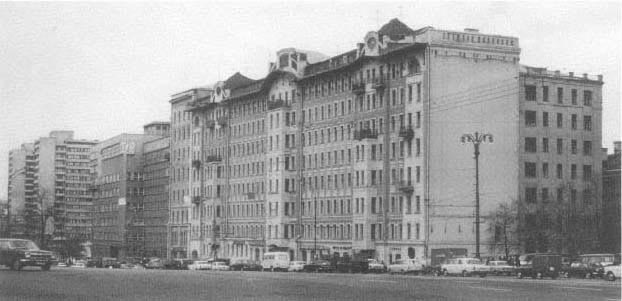
Fig. 68.
Afremov apartment house, Moscow. 1904. L. Shishkovskii (Brumfield M154-24).
its size while allowing for light and ventilation. The brick facade nods to the style moderne in its curved roofline and projecting cornice, supported by wrought-iron brackets; but otherwise this austerely rational structure has few stylistic pretensions (Fig. 68).
Other apartment buildings, similarly large and functional, helped to relieve the city's shortage of affordable, convenient housing. Some, such as E. K. Nirnzee's House of Low-cost Apartments on Bolshoi Gnezdikov Lane (1912) or T. Ia. Bardt's building for the Solodovnikov Low-cost Apartments (1906; Fig. 69), were sponsored by cooperatives or subsidized by foundations and thus had the resources to meet the same structural standards as the more fashionable buildings—albeit with few decorative details or luxuries in apartment design.
Indeed, as the style moderne waned at the end of the decade, austerity became the new fashion. The facade of A. K. Gotman's Levin apartment house on Miasnitskii Passage (1909–1910) used concrete, lightly stuccoed and scored, to create a grid almost bare of ornament (Fig. 70). Yet the ornament is there, in a grotesque, archaic style—neo-Egyptian, with Hellenistic elements; even with such functional material as ferroconcrete, striking decorative motifs remained a part of the moderne aesthetic. Inside, the simple elegance of the building's main stairwell demonstrated the compatibility of the arts and crafts movement with the new functionalist construction techniques: wooden lamp fixtures in the style of Mackintosh are mounted on an undecorated wall, and the balustrade is entirely of squared, stained wood. Little is known of Gotman's work, but the Levin building is another significant example of the link between the moderne and the modernism of the 1920s.[17]
Whatever the differences in their stylistic point of reference—Paris, Vienna, or an idiosyncratic variation—all the apartment dwellings in the preceding survey break with the eclectic or Russian Revival style of the 1890s. Yet traditional motifs could be used in a modern context, as Vasnetsov demonstrated in the Tretiakov Gallery entrance. No one in Moscow used them more dramatically than the artist Sergei Maliutin in his design for the apartment house of N. P. Pertsov at Prechistenka Quay (Fig. 71). Maliutin had already won a reputation for his work in the arts and crafts community at Talashkino (the estate of Princess Maria Tenisheva, a benefactor of the community). In 1901 he designed the famous teremok at Talashkino (Fig. 72), a log structure decorated with fanciful interpretations of Russian folk art and resembling the Russian pavilion designed by Konstantin Korovin and Aleksandr Golovin for the 1900
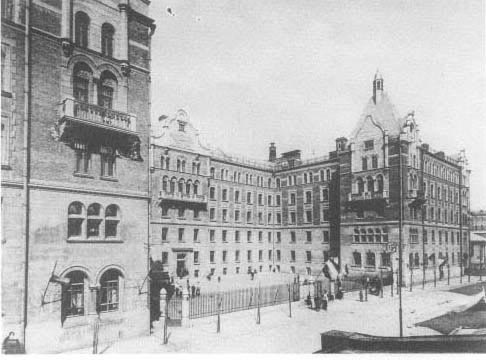
Fig. 69.
Solodovnikov Low-cost Apartments, Moscow. 1906. T. Ia. Bardt.
Photograph ca. 1906.
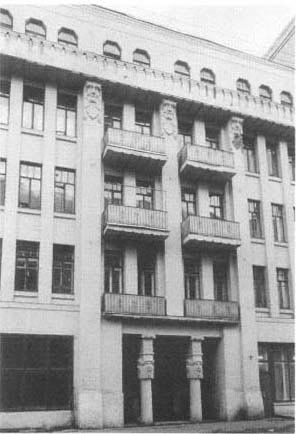
Fig. 70.
Levin apartment house Moscow. 1909–1910. A. K.
Gotman (Brumfield M154-17).
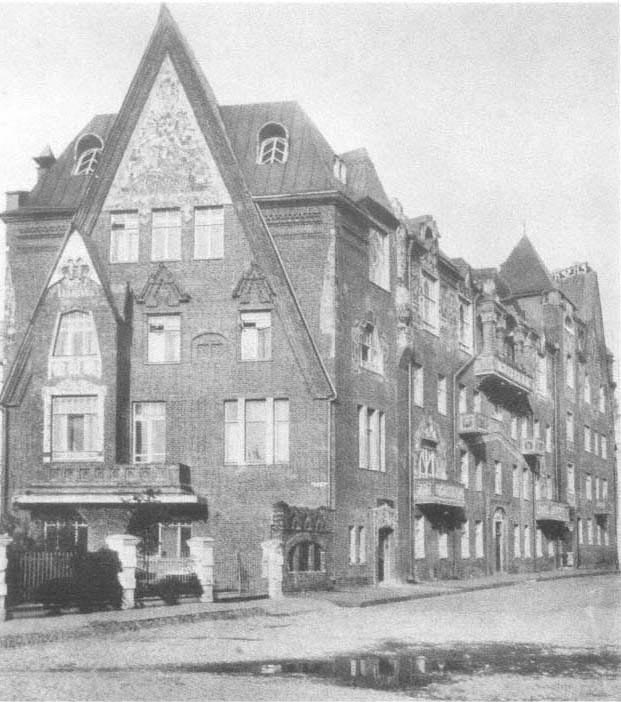
Fig. 71.
Pertsov apartment house, Moscow. 1905–1907. Sergei Maliutin, Nikolai Zhukov. Ezhegodnik Obshchestva
arkhitektorov-khudozhnikov , 1907.
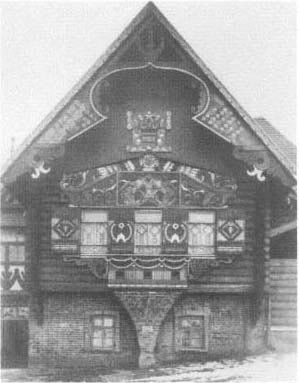
Fig. 72.
Teremok , Talashkino. 1901. Sergei Maliutin. Mir
iskusstva , 1903.
Paris Exposition. Examples of Maliutin's craftwork were displayed at this pavilion.[18]
The prominence of the crafts revival and the use of folk motifs—however stagy—demonstrate a remarkable confluence of purpose and understanding among a group of artists, set designers, and architects at the turn of the century. The Vasnetsov brothers as well as Golovin, Korovin, Vrubel, Maliutin, Shekhtel, Polenov, and others had each explored the connection between architecture and decorative art.[19] The logical bond between material and structure in the medieval or folk traditions of pre-Petrine Russian architecture was given an aesthetic interpretation in the neo-Russian style moderne (Fig. 73). As Grigorii Sternin notes in regard to the Russian decorative arts displayed at the Paris Exposition: "National exotica served here as a means of the atricalization, and spectacle proved to be one of the most important inner properties of the 'neo-Russian style.' The handicrafts from Talashkino demonstrated how completely the 'neo-Russian' style had been incorporated into the style moderne."[20] Sternin argues that although Golovin and Maliutin were dilettantes in their imitations of folk crafts, their purpose was to express the "magic" of folk creativity. "The deliberate conditionality [uslovnost ] of the decorative image was the very basis on which the 'new style' affirmed itself."
Sternin's comments on theatricality in the decorative arts apply also to neo-Russian architectural design. In the Pertsov building (1905–1907), Maliutin used ceramic panels and other ornamentation based on exaggerated abstract representations of folk art. Maliutin's stagy sketch for the building—reproduced in the 1907 issue of the Annual of the Society of Architect-Artists (see Plate 11)—masked the basic structure with a panoply of steeply pitched roofs, towers, elaborately decorated balconies and window surrounds, and large ceramic panels as well as unusual door and window openings (see Plate 12). Maliutin intended to reproduce the asymmetry of the medieval teremok (the word itself includes the concepts of "tower" and "chambers"). The ideal proved beyond reach, however, and Maliutin's original design was considerably modified by Nikolai Zhukov, the architect who constructed the building (Fig. 74).
Although the gap between stage set and rational architecture remained in this large apartment building, Maliutin continued to explore the idea of the teremok as a union of theater, architecture, and interior design—all devoted to a revived awareness of Russian traditions.[21]

Fig. 73.
Sketch for a dacha (in the teremok style) by Sergei Maliutin. Ezhegodnik Obshchestva
arkhitektorov-khudozhnikov , 1909.
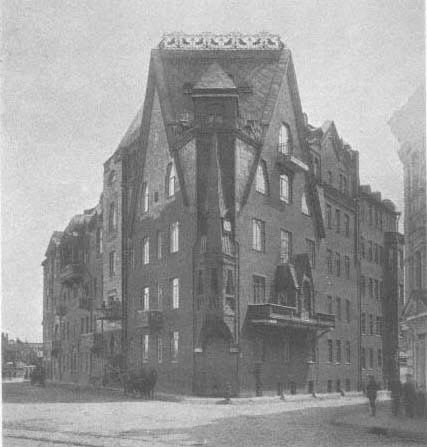
Fig. 74.
Pertsov apartment house. Ezhegodnik Obshchestva arkhitektorov-khudozhnikov ,
1907.
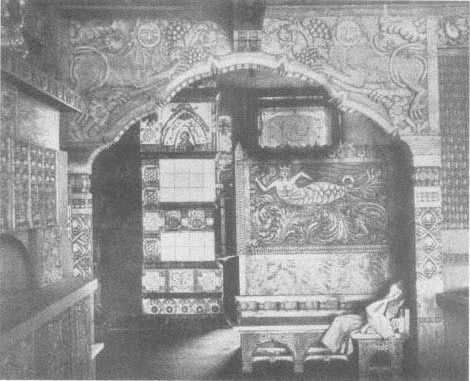
Fig. 75.
Pertsov apartment house. Apartment designed by Sergei Maliutin for Z. O. Pertsova.
Ezhegodnik Obshchestva arkhitektorov-khudozhnikov , 1908.
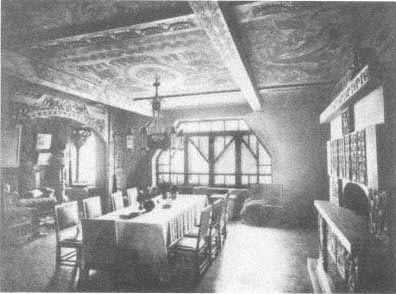
Fig. 76.
Pertsov apartment house. Apartment for Z. O. Pertsova. Ezhegodnik
Obshchestva arkhitektorov-khudozhnikov , 1908.
In a rare attempt to adapt the teremok to an actual living area, he designed the lavish interior of the Pertsovs' own apartment with stylized carving, patterned wall designs, and hand-crafted furniture in the traditional crafts style (Figs. 75, 76). But the artist's interior design proved as impractical as his original design for the exterior. Most of the apartments were small, their plans undistinguished; and the one interior where he gave his imagination free reign looked affected, perilously close to cluttered eclecticism.[22]
Maliutin's defenders have argued that because the theatrical facade in the neo-Russian variant of the new style endowed the apartment dwelling with aesthetic significance, the disjunction between the exterior and the interior of the prosaic apartments themselves was justified. It even affirmed the importance of the theater by countering, through the "magic" of mythic symbol and theatrical design, the modern urban tendency toward conformity and alienation.[23] This argument, so appropriate to the period's view of the role of art and theater in life, is also consistent with Maliutin's original intention, no doubt influenced by his experience at Talashkino, to include apartments for artists, with studios on the top floor.
Russian decoration was used in a different but equally exuberant manner in an apartment house built by P. K. Michini (ca. 1909) on Chistoprudnyi Boulevard for the Church of the Trinity "on the Mire." Located a few blocks from the large apartment complex by Proskurin, the building was actually designed by the artist Sergei Vashkov, known for his church furnishings, offered through the firm of P. I. Olovianishnikov and Sons.[24] Vashkov, who knew the decorative traditions of the Russian church, applied to the exterior of the building an elaborate pattern of flora and fauna derived from the limestone carvings of twelfth-century Vladimir churches (Figs. 77, 78). Inside he limited the neo-Russian decoration to the style of medieval Pskov and a wrought-iron railing that used traditional decorative motifs. Although it lacked the color of the Pertsov building, Vashkov's building demonstrated how elements of medieval architecture could be integrated into the material, texture, and form of the style moderne. (In 1945 two stories were added to this apartment house in a sensitive conversion by B. L. Topaz.)
A more rational interpretation of the neo-Russian style appeared in Nikolai Kurdiukov's design (ca. 1910) for a refuge, or communal house, endowed by Pavel Tretiakov for the widows and orphans of artists (Fig. 79). The Tretiakov Refuge, now disfigured almost beyond recognition, was on Lavrushinskii Lane, not far from the Tretiakov Gallery, whose entrance provided the dominant tone for the ensemble.[25] A comparison with the Pertsov apartment house reveals many of the same materials and design elements: brick walls, ceramic decoration, the steep roofline, and architectural details borrowed from medieval Russia. Limited financial resources, however, imposed an economy of form on the refuge and dictated a more subdued use of traditional motifs.
The refuge has small apartments and rooms along the shaft of its T-shaped plan; these have large windows whose slightly arched forms created an arcade on both the first and second floors. The space for common rooms at the head of the building rose above the rest of the structure with a steeply pitched roof in the manner of Russian palaty (chambers) from the sixteenth and seventeenth centuries. The large arched windows on the second floor indicate the main room, and the walls of this section also contain decorative elements, such as the ceramic work on the front facade. As at the Tretiakov Gallery the centerpiece is a heraldic representation of St. George and the Dragon, framed in molded brick over a ceramic inscription giving the name of the building and its patron. The clearest quotations from medieval architecture appear on the side pediment, with its small window openings and modest brick ornament in the begunets (angled-brick) pattern of fourteenth-century Novgorod churches (cf. also the late fifteenth-century palace at Uglich). The porch over the corner entrance follows a similar medieval pattern. Every functional element, from the iron roof to the drainspouts, enhances the total form.
The disfiguring of this building is regrettable because its economical use of material and sure grasp of architectural tradition suggest that the neo-Russian style might have answered the urgent need for housing in Moscow. Kurdiukov's emphasis on the aesthetic properties of the simple brick facade, unencumbered with extensive decoration, resembles the work of Philip Webb, whose use of the red-brick style in private dwellings during the 1860s significantly affected the design of public housing sponsored by the London County Council at the turn of the century.[26] Whether the Moscow duma would have supported the construction of similar low-income housing is a moot point, but Kurdiukov's work demonstrates that
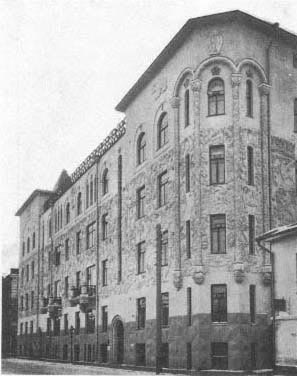
Fig. 77.
Apartment house of the Church of the Trinity "on
the Mire," Moscow. Ca. 1909. Sergei Vashkov, P. K.
Michini. Ezhegodnik Moskovskogo arkhitekturnogo
obshchestva , 1909.
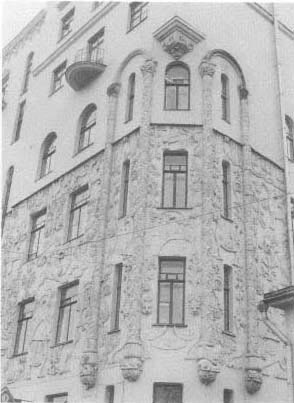
Fig. 78.
Apartment house of the Church of the Trinity, detail
(Brumfield M89-5).
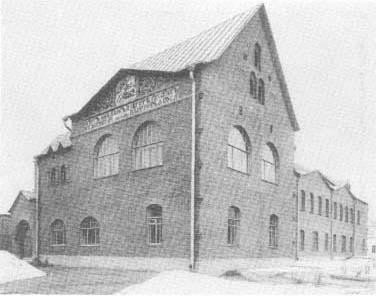
Fig. 79.
Tretiakov Refuge, Moscow. Ca. 1910. Nikolai Kurdiukov.
Ezhegodnik Moskovskogo arkhitekturnogo obshchestva , 1910–1911.
in brick structures the traditions of Russian vernacular architecture could be combined with the rationalism of the style moderne.
Although apartment construction in Moscow accelerated noticeably during the first decade of the twentieth century, almost all projects with any claim to architectural distinction remained beyond the reach of the vast majority of the city's population.[27] Advances in building technology, along with a concern for functionalism, comfort, and hygiene, sustained the new style, which contributed considerably to the development of Moscow. Yet these functional and aesthetic innovations could not adequately address the larger social concerns of the city: the economic system that supported the speculative construction of apartment complexes remained untouched by social reform, despite the rise of housing cooperatives and housing subsidized by benefactors such as Solodovnikov.
Furthermore, although prerevolutionary journals discussed the possibility that improved technology, rationally applied, could lead to new solutions in the design and financing of workers' housing, apartments in style moderne buildings were designed and sold for the comfort of those who could afford a measure of luxury. In them the three or four main rooms overlooked the street, and the bedrooms and service areas (kitchen, storage, bathroom) were in the building's interior.[28] Such apartments had two staircases, one at the front entrance and one at the back, service, entrance. The apartments themselves offered considerably improved living space, but they were exceptions to the general housing situation. Upon their expropriation after the revolution, when the housing crisis became still more severe, the spacious floor plans were converted into communal apartments, with one family per room.
If apartment buildings in the new style frequently failed to integrate decorative effects and structural functionalism, the design of individual houses offered greater flexibility in uniting these elements, particularly in Moscow, where detached private dwellings were constructed even in the core of the city. During the eighteenth and nineteenth centuries, the houses of the wealthy either fronted the street or lay behind a small garden, sometimes walled, with formal entrance pavilions.[29] In either case the houses were detached (unlike mansions in Petersburg) but generally presented only one facade to public view. This pattern changed in the latter half of the nineteenth century, as architects such as Andrei Huhn, Nikolai Pozdeev, and Viktor Vasnetsov began to adapt the asymmetrical and three-dimensional characteristics of old Russian architecture to their work in both wood and brick. Vasnetsov's own house-studio is an excellent example of this adaptation (Fig. 80), whereas his design of a house for I. E. Tsvetkov (1897) on the Prechistenka Quay uses pre-Petrine architectural elements in a more conservative, symmetrical fashion (Fig. 81).
The tendency was to create a structure that, whatever its form, could be observed in the round. Fedor Shekhtel turned to the neo-Gothic style in the 1890s to explore the relation between interior space and exterior projection. William Walcot, in contrast, adopted the straight lines of a wholly contemporary style, relying at times on the sinuous ironwork of art nouveau but usually content with the angularity of glass and brick blocks. Shekhtel's own work rapidly evolved in a similar modernist direction at the turn of the century.
The most prolific of those who designed private houses in the new style was Lev Kekushev (1863–1919). After he received his professional training at Petersburg's Institute of Civil Engineering between 1883 and 1888, Kekushev moved to Moscow, which remained the center of his practice. His early projects, such as the T. I. Korobkov house on Piatnitskaia Street (1894), derived from the Beaux-Arts tradition, but at about the same time, Kekushev designed wooden service buildings along the Vologda-Arkhangelsk railway that are completely functional, with no attempt at "folk" decoration.[30]
Kekushev was an accomplished eclectic, with an inexhaustible repertoire of stylistic mannerisms. Although he designed apartment buildings (see Fig. 65), his houses give a true measure of his work. In the late 1890s they ranged from a half-timbered dacha (Fig. 82) with steep gables for I. I. Nekrasov (it was described as an "American house" in a 1903 issue of Zodchii )[31] to such conservative neo-Renaissance designs as the Panteleev house on Maiden Field in Moscow. By the end of the century he had achieved a breakthrough in his house for E. List on Glazovskii Lane (1898–1899), which shows the new style both in its use of brick and stone and in its asymmetrical rectangular structural components (Fig. 83).[32]
Kekushev reveled in the plasticity of both materials and structure in the houses he designed in the 1900s—most notably in the one he built for himself in 1901 on Ostozhenka Street (Fig. 84). As with so many Moscow
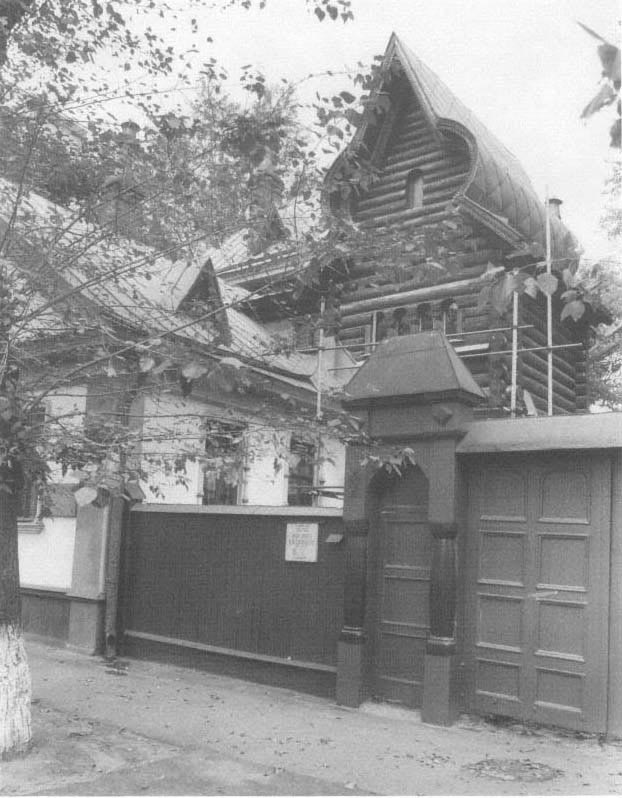
Fig. 80.
Viktor Vasnetsov house, Moscow. 1892 (Brumfield M173-22).
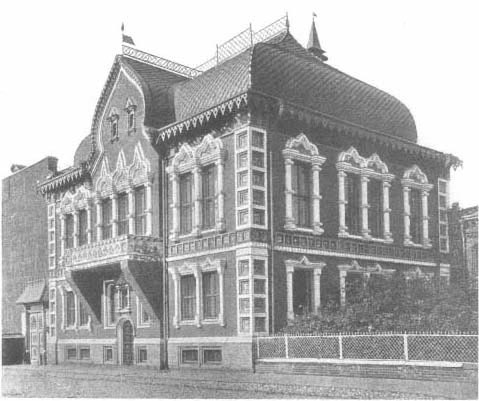
Fig. 81.
Tsvetkov house, Moscow. 1897. Viktor Vasnetsov. Ezhegodnik Obschestva
arkhitektorov-khudozhnikov , 1906.
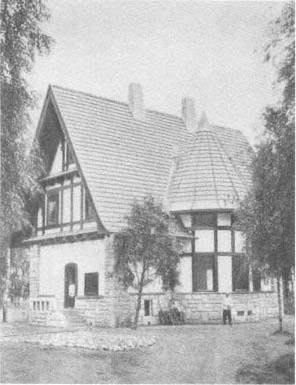
Fig. 82.
Nekrasov house, Raiki estate. Ca. 1900. Lev
Kekushev. Arkhitekturnye motivy , 1900.
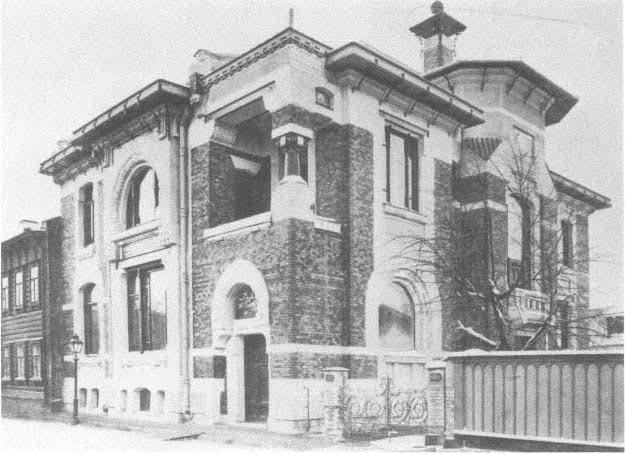
Fig. 83.
List house, Moscow. 1898–1899. Lev Kekushev. Zodchii , 1901.
houses of the period, the quality of both brick and brickwork is outstanding, and Kekushev used the texture of the brick facade as a counterpoint to the massive stonework, from the rusticated granite base to the sculpted trim that defines the upward movement of the main surface and the corner tower. Artificial stone, made from granite powder and a binding substance, was increasingly used for greater economy in molded work, and the details of the central windows and pediment were probably concrete, scored to resemble stone. The central pediment was originally capped with a large and quite absurd statue of a lion, used by the architect as a signature (from his name Lev, or Leo). The main structural element of the design is the tower, or polygonal bay, which projects from the corner and serves as a hinge for the front and side facades.
Toward the end of the decade Kekushev experimented freely with contour, to the point of the grotesque in his Mindovskii house on Povarskii Street (1903–1904). The structure is now obscured by trees and has lost the statuary group of a mother and two children originally mounted above a large curved gable (Fig. 85). Nonetheless, much of the relief sculpture, ornamental ironwork, and decorative stucco has survived. The contrast between masonry and glass is developed in large plate windows divided by sinuous mullions and set into a curved, projecting cornice.
Kekushev adopted a different manner for the residence of V. D. Nosov on Vvedenskii Square (1903) in Moscow. The house, rambling from tower to block under an overhanging cornice, had a veranda on three sides (Fig. 86). Russian country houses at this time
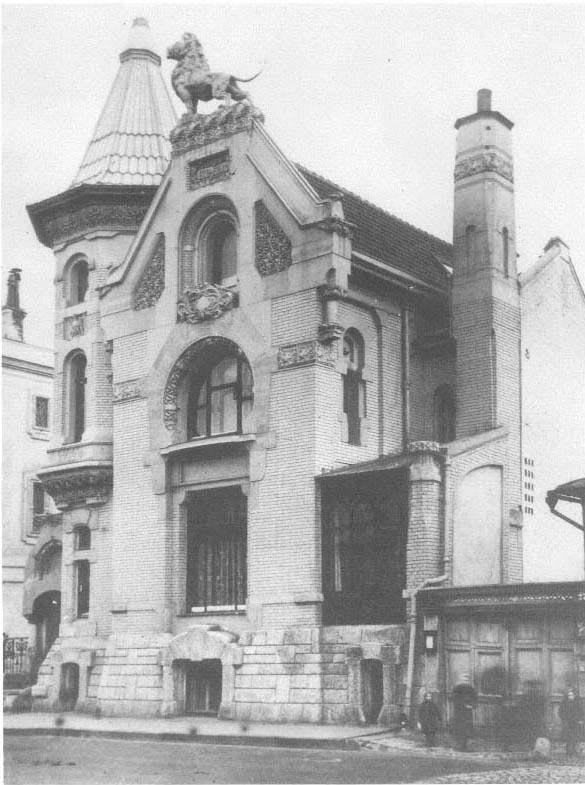
Fig. 84.
Kekushev house, Moscow. 1901. Lev Kekushev.
Photograph ca. 1905.
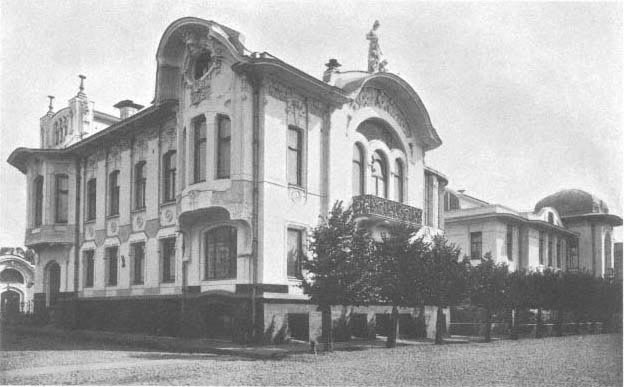
Fig. 85.
Mindovskii house, Moscow. 1903–1904. Lev Kekushev. Ezhegodnik Moskovskogo arkhitekturnogo obshchestva ,
1910–1911.

Fig. 86.
Nosov house, Moscow. 1903. Lev Kekushev. Ezhegodnik Moskovskogo
arkhitekturnogo obshchestva , 1910–1911.
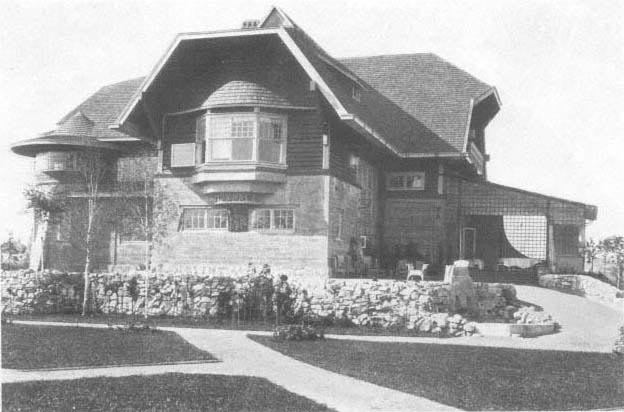
Fig. 87.
Nosikov dacha, near Moscow. Ca. 1909. V. A. Simov, Leonid Vesnin. Ezhegodnik Moskovskogo arkhitekturnogo
obshchestva , 1910–1911.
sometimes had verandas, but the one at the Nosov house bore little relation to traditional designs. Moreover, instead of a low, extended structure with an enfilade of rooms, Kekushev adopted for the Nosov house an American-style plan, with two and a half stories arranged around a central core. As a result the architect seems to have created the ambience of a "neighborhood" rather than the traditional Muscovite enclosed domestic compound (the dvor or the gorodskaia usadba ). If Kekushev was in fact familiar with the design of American homes—as the Zodchii designation for his Nekrasov dacha implies—then the Nosov house was remarkably like the prototype.
An American influence on Russian domestic architecture is by no means improbable, despite its apparent incongruity. In 1906, for example, the prestigious Annual of the Society of Architect-Artists contained an advertisement for a "patented American water-supply system" for private homes. With the text was an illustration from an American magazine showing a suburban home owner watering the grounds of his half-timbered frame house, with septic system and pumping equipment drawn in cutaway.[33] It is difficult to imagine that in a year of social crisis and violence Russian architects would be eager to build for middle-class suburban dwellers. And indeed the Nosov house remained a rarity, both in its design and in its open landscaped setting.
In Moscow's outlying areas, however, certain houses in the new domestic style were comparable in scale and appearance to American suburban mansions. The most striking for its modern design was the seemingly anomalous dacha built around 1909 for V. A. Nosikov by V. A. Simov and Leonid Vesnin (Fig. 87). Vesnin was the oldest of three brothers who would make major con-
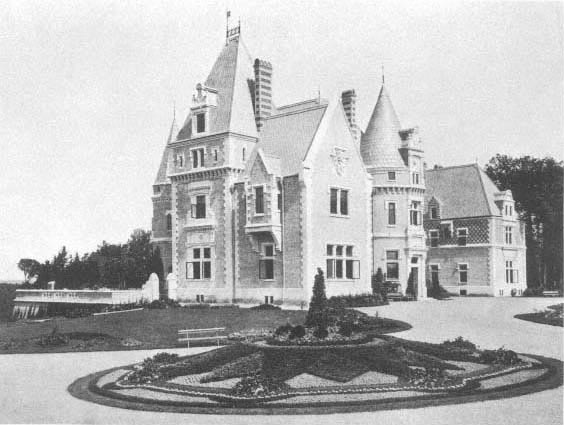
Fig. 88.
Verigina house, Podushkino estate. Ca. 1909. Petr Boitsov. Ezhegodnik Moskovskogo arkhitekturnogo
obshchestva , 1910–1911.
tributions to Soviet architecture; the Nosikov house demonstrates that he, like many accomplished Soviet architects of the 1920s and 1930s, was firmly grounded in architectural practice before the revolution.
The dacha (not extant) was located in the northwest Moscow suburb of Ivankovo. In its broad sweep it combined elements from Norman Shaw, Charles Voysey, and the American shingle style as developed in the 1870s and 1880s by Henry Hobson Richardson—one of the few American architects whose work appeared frequently in Russian journals.[34] The shingled gambrel roof, which gave the house its distinctive shape, covered the various wings as well as a corner tower and a large bay window. The textural contrast between the rough stone of the first floor and the wooden siding of the second was very much in the style moderne, albeit rusticated for the suburban setting; but the interior design was still more modern, with simple, angular furniture resembling English and Scottish work from the late period of the Arts and Crafts movement.[35]
Such modernity was by no means the rule for large suburban or country houses: some of the most imposing were unabashed historicist re-creations, such as the French château built around 1909 by Petr Boitsov for N. A. Verigina on her estate, Podushkino, near Moscow (Fig. 88). Still more extravagant, if less derivative, was the mansion built on an unidentified estate near Moscow by Aleksandr Kuznetsov, a civil engineer who later became one of the leading Soviet authorities on industrial construction. Even before the revolution, he had made a reputation for his use of reinforced concrete; yet his huge, rambling mansion (ca. 1913) showed no trace of austerity (Fig. 89). From its fieldstone base to the shingle and stucco facade to the half-timbered Tudor bays of the upper story, the estate house proclaimed rural luxury on the grandest scale.[36] In a pattern typical
of houses in the style moderne, Kuznetsov arranged the rooms around a central stairwell, designing the main rooms on both floors for a maximum exposure to light and, through balconies and terraces, to the open air (Fig. 90). The similarities to English and American vernacular architecture suggest an international variant of the style moderne extending to Petersburg and Finland as well as Moscow.
Equally distant from Russian traditions is Kuznetsov's house in a park, its owner and location also unidentified, though it was presumably in the Moscow area (Fig. 91). This is the most innovative of the architect's designs, with a modernized columnar motif that extends from the main porch to an enclosed terrace and reappears in the chimneys. The windows are arranged in dark two-storied shafts set against a light stuccoed facade. The roof, as in Kuznetsov's other country houses of the period, projects far beyond the gables, although without the complexities of the gambrel (see Fig. 87) or hip roof. The modernity of these cosmopolitan houses might have created a new pattern of domestic architecture for Russia's newly rich had events not intervened; but Kuznetsov's main interests lay in industrial architecture and building technology—which received high priority after the revolution.
The style moderne stimulated not only copies of art nouveau and Western domestic architecture but also the use of Middle Eastern elements. In the 1910–1911 Annual of the Moscow Architectural Society , Leonid Vesnin published a sketch of a house with distinct traces of such elements, including a pointed Persian arch and Islamic decorative motifs (Fig. 92).[37] Although this project remained unbuilt, other houses of the period drew from Mediterranean or Eastern traditions to achieve another variant of freestyle modern design. Similarly, Ilia Bondarenko's projected house for P. A. Guskov near Arkhangelskoe (ca. 1914) used stylized Russian motifs (Fig. 93). Bondarenko, known primarily for his Old Believer churches in Moscow (discussed later in this chapter), freely interpreted medieval Russian
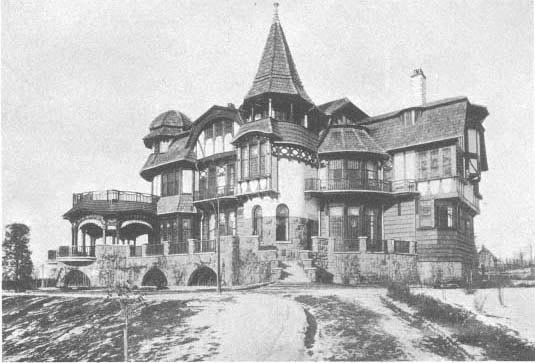
Fig. 89.
Estate house, near Moscow. Ca. 1913. Aleksandr Kuznetsov. Ezhegodnik Moskovskogo
arkhitekturnogo obshchestva , 1914–1916.
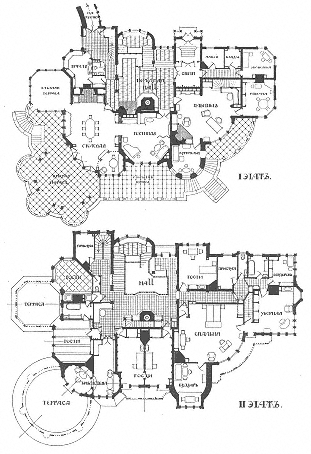
Fig. 90.
Estate house plan. Aleksandr Kuznetsov. Ezhegodnik
Moskovskogo arkhitekturnogo obshchestva , 1914–1916.
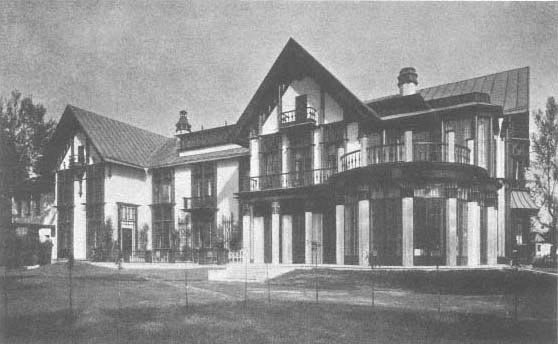
Fig. 91.
House in a park, near Moscow. Ca. 1913. Aleksandr Kuznetsov. Ezhegodnik Moskovskogo arkhitekturnogo
obshchestva , 1914–1916.
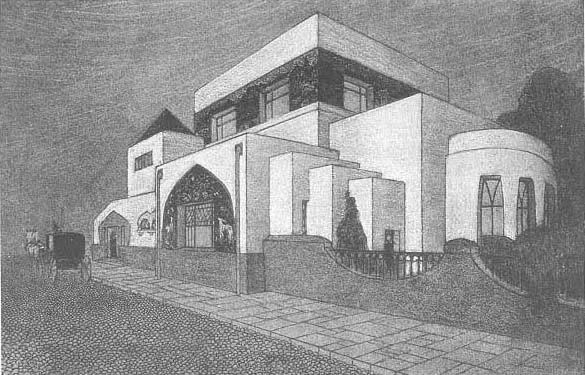
Fig. 92.
Sketch for a private house. Leonid Vesnin. Ezhegodnik Moskovskogo arkhitekturnogo obshchestva ,
1910–1911.
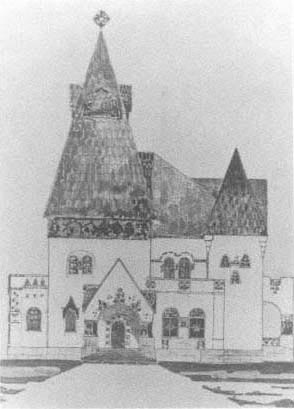
Fig. 93.
Project for Guskov estate house, Arkhangelskoe, near
Moscow. Ilia Bondarenko. Ezhegodnik Moskovskogo
arkhitekturnogo obshchestva , 1914–1916.
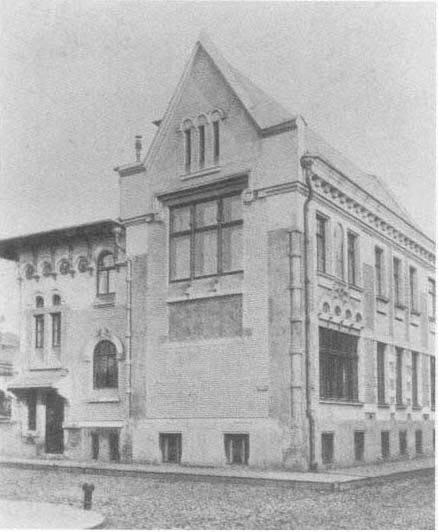
Fig. 94.
Solovev house, Moscow. Ca. 1908. Sergei Solovev. Ezhegodnik Obshchestva
arkhitektorov-khudozhnikov , 1909.
motifs in this fantasy design, which demonstrated that the structural plasticity of the moderne was still a creative presence in Russian architecture as late as 1914.
It might seem paradoxical that the design and construction of private houses demonstrated such vitality in the decade before the outbreak of the war; yet a period of relative stability and prosperity—after the revolutionary disturbances of 1905–1906—promised great economic growth, both for foreign investors and for the Russian entrepreneurs who commissioned most of the architectural work in the cities. Despite fundamental contradictions in the country's economic system, the new generation of entrepreneurs created an environment favorable to the building of large private mansions, though proportionately fewer were constructed in Russia than in the United States during the Gilded Age.
The domestic architecture of Fedor Shekhtel and of the neoclassical revival will be examined in subsequent chapters. Among the many other houses of architectural interest built during the two decades before the revolution, that of the architect Sergei Solovev ranks as one of the period's most distinctive—a self-conscious mixture of classicism and the Romanesque resembling that of Richardson's urban houses (Fig. 94). In general
Solovev's work has the stylistic versatility of Kekushev's and Shekhtel's: from the sculpted neo-Russian forms of his building for the Tretiakov Charitable Institution (ca. 1906) to his re-creation of Moscow's Empire style for the Higher Women's Courses (an educational institution; 1913), Solovev projected the purpose of each building in his interpretation of a particular style.
Boris Velikovskii, in his house for the Iaroslavl-Kostroma Land Bank (ca. 1914), designed a more austere structure that was nonetheless linked to the moderne in its treatment of structure as a clearly defined sculpted form. This house, an angular structure with an attached tower, was designed in what might be called a stripped Romanesque style, virtually devoid of decoration (Fig. 95). Velikovskii was among those architects whose best work occurred in the Soviet period—as in his Constructivist building for Gostorg on Kirov Street. Although other young architects, including Aleksei Shchusev, changed their architectural style radically after the revolution, the clarity and precision in Velikovskii's house continued to mark his work as a Constructivist.[38]
At the other extreme lies the work of Aleksandr Zelenko, whose creative imagination veered to the fantastic and bizarre. He was unique among prerevolutionary Russian architects for the geographical range of his work, which included a rambling Moorish-style house with a courtyard and minaret in Sacramento, California (ca. 1910)—apparently built as the owner's re-creation of the Alhambra.[39] His most capricious design, however, was the Pfeffer dacha (ca. 1912) in the Moscow suburb of Sokolniki Park. The fairy-tale form of this rustic wooden house flaunts reason (Fig. 96). Irregularly shaped, from the contoured roof to the latticed windows and polygonal rooms, the dacha had an oval floor plan and a central hall. A covered passageway linked the main part of the structure to a kitchen tower that served as an entrance to the house. Zelenko designed the dacha and its furnishings to complement the forest setting, using fieldstone and logs in the structure and wood throughout the interior. Contemporary photographs show the elaborately contorted interior, wooden chairs with smirking chair backs, and tree limbs extending from the walls as in the log retreats of the Adirondacks.[40]
Like most of Moscow's suburban houses in the style moderne, the Pfeffer dacha was destroyed after the revolution. But another structure by Zelenko remains in Moscow that could be characterized as a house, though it served as a progressive school for the Children's Work and Play Society (ca. 1912). The building (Fig. 97), on Vadkovskii Lane, is now abandoned and in disrepair; yet the free-form contours of its roughcast walls make it the ultimate statement in style moderne sculptural architecture. With its streamlined central tower and observatory dome, the Vadkovskii Lane school is the one work of prerevolutionary Russian architecture comparable to the work of Gaudí and of the Expressionist architect Eric Mendelsohn.[41] Because little is known of Zelenko's career, it is difficult to establish a conscious quoting of advanced European projects; it is unlikely, however, that he knew Mendelsohn's early sketches, though he might have known Antonio Sant'Elia's architectural fantasies.
This sampling of houses in the style moderne illustrates not only the redirection of housing design in Moscow at the beginning of the century but also the diversity of the style. The changes in form during this brief period are not evolutionary but rather individual, as architects adapted Western prototypes known in Russia at the beginning of the century. A series of articles entitled "Contemporary Moscow," published in Zodchii in 1904, makes this point explicitly:[42]
Thanks to thousands of illustrated editions and easier means of travel abroad, the end-of-the-century revival that gave rise to a tide of new artistic ideas in Europe found its reflection here [in Moscow] and took a most original form.
Especially in the mansions. I was in ecstasy over the directness, the naïveté with which an artist here creates and applies a form without the least concern for its content.[43]
Although the critic's reference to "thousands of illustrated editions," like the article as a whole, is lightly ironic, the Russian architectural press had indeed reported on most of the current trends in housing design in the West. Articles on houses and interior designs by Horta, Hankar, van de Velde, and Guimard had appeared as early as 1899; and in 1902 Zodchii published a major series of articles on the Darmstadt colony, emphasizing the work of Joseph Olbrich in the design of the colony houses.[44] Although Frank Lloyd Wright was not mentioned—his work was hardly known in Europe at that time—houses by Henry Hobson Richardson were illustrated in Zodchii 's 1905 survey of American architecture.
The one constant in new designs for private dwellings was the English and Scottish example. Russian critics were sympathetic to the English Arts and Crafts
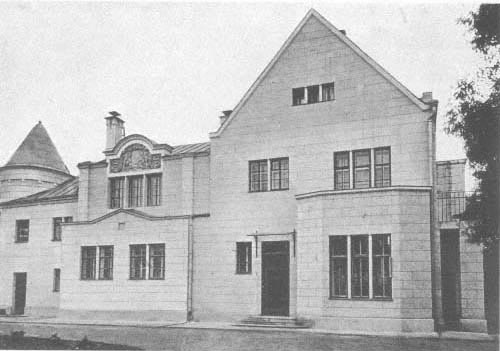
Fig. 95.
House for Iaroslavl-Kostroma Land Bank, Moscow. Ca. 1914. Boris Velikovskii. Ezhegodnik
Moskovskogo arkhitekturnogo obshchestva , 1914–1916.
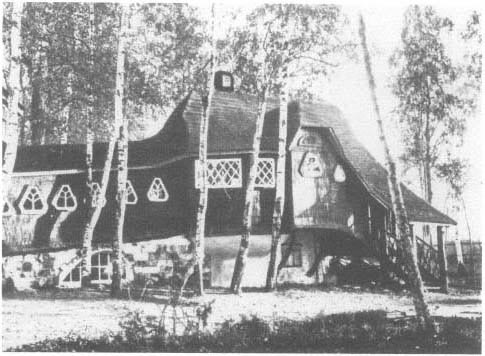
Fig. 96.
Pfeffer dacha, Sokolniki Park, Moscow. Ca. 1912. Aleksandr Zelenko. Moskovskii
arkhitekturnyi mir , 1914.
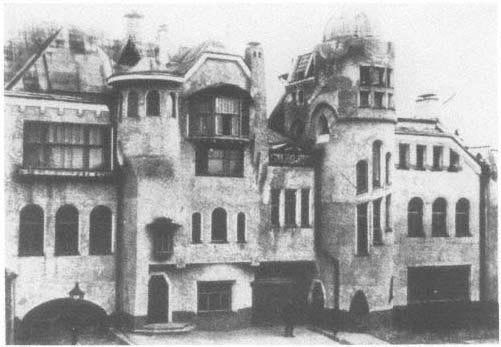
Fig. 97.
Vadkovskii Lane school, Moscow. Ca. 1912. Aleksandr Zelenko.
movement at the turn of the century (all the more because it paralleled Russia's own crafts revival), and architectural journals contained essays praising the work of Ruskin and Morris and their successors.[45] The English architects' incorporation of the applied arts into interior as well as exterior housing design spoke to a basic principle of the style moderne; it is therefore not surprising that Charles Voysey and Charles Rennie Mackintosh were frequently mentioned in the Russian press.
The Russian appreciation of modern British domestic architecture, however, extended beyond style and decoration to the social setting that enabled the English to realize the value of privacy in the individual home. Mikhail Syrkin, writing for Architectural Museum in 1903, saw the aesthetic revival in Britain as one of the most encouraging developments in European design and linked it to the country's political stability. Having avoided the revolutionary upheavals of the continent, Britain (in Syrkin's view) created a continuity of social order essential for the flourishing of the private house, which in turn served as the basis for the crafts tradition and its revival.[46]
Syrkin's praise of the English house reflected an admiration for the English social system and an interest in a new form of Russian domestic architecture on British and American models (as in the country houses of Kuznetsov, Vesnin, et al.). Nonetheless, Russian social institutions bore little similarity to those of Britain, and the appearance of new suburban homes in Moscow and Petersburg by no means implied the social stability or values Syrkin perceived in the work of Ruskin, Norman Shaw, Walter Crane, and other English architects and designers.
There is a certain pathos in Aleksandr Uspenskii's publishing, in 1900, an article on the revival of English "folk" architecture that praised Voysey and M. H. Baillie Scott.[47] English folk, or vernacular, architecture had little to do with even the more benign elements of the radical Russian populism Uspenskii espoused. His sympathy for the revolutionary events of 1905–1906 in Petersburg and his death (possibly suicide) at the age of thirty-three in 1907 elicited an impassioned commentary on architecture and social justice. Yet the style moderne in his work as an architect and critic shows no relation to the democratic values advocated by some of the style's most ardent proponents.[48] Indeed, the build-
ing of private suburban houses might only have exacerbated the perception of social and economic inequalities that led, after 1917, to revolutionary violence against the propertied class. All that can be said with certainty about the social implications of European domestic architecture is that Russian architects adeptly assimilated the new ideas and adapted them for patrons whose wealth derived from the country's short-lived but vigorous affair with capitalism.
Although the style moderne had its most obvious impact on the design of both private and apartment houses in Russia, it displayed an equal, if not greater, vitality in the design of churches. Most of the significant church designs at the beginning of the century were commissioned by private groups or individuals—not by the official Orthodox hierarchy, which preferred the historicist designs of the nineteenth century. It is not surprising, then, that the spirit of enterprise and individualism that underlay secular architecture in the style moderne should also appear, mutatis mutandis , in the design of churches.
In fact, much that is innovative in Russian church architecture at the beginning of the twentieth century can be attributed to Old Believer communities, whose release from legal restrictions after 1905 stimulated a surge of church construction in Moscow and, to a lesser extent, in Petersburg. Despite the paradox of architectural innovation in churches supported primarily by a socially and culturally conservative merchant class, scions of some prominent Old Believer families actively sought in innovative art forms a means of cultural identity.[49]
This support for innovation was reinforced by an understandable reluctance among Old Believer communities to follow the styles of Orthodox church architecture established during the preceding decades, because of cost and differences in religious observances. Forbidden for centuries to build places of worship (except briefly during the reign of Catherine the Great), the Old Believer communities frequently adapted simple medieval forms antedating the great Schism of the seventeenth century—in other words, they turned to the churches of Novgorod and Pskov that had inspired the Abramtsevo artists. Thus the circle was complete, from the beginnings of the modern movement at Abramtsevo to the use of the moderne to regain the old traditions in religious architecture without following the literal, formalistic repetition of decorative elements in official church architecture.
Ilia Bondarenko designed at least three Old Believer churches in Moscow: one for the Maritime Community (Pomorskoe soglasie) on Tokmakov Lane (1907–1908); another for the Intercession-Dormition Community on Gavrikov Lane (1911); and a third for the Nikola-Rogozh Community (1912). The church for the Pomorskoe soglasie, dedicated to the Resurrection of Christ and the Intercession of the Mother of God, is the most curious of the three, with the pitched roof of its bell cote on truncated pillars over the narthex (Fig. 98). Although Bondarenko derived the form from wooden architecture of the far north, he interpreted it idiosyncratically. Two angels are portrayed carrying an icon on the gable beneath the tower roof, in a mosaic or in ceramic tiles set into the high-quality pressed brick of the main facade. By applying modern techniques such as reinforced concrete for the vaulting, Bondarenko created an unobstructed interior space capable of accommodating five hundred people, in addition to the narthex with separate coat rooms for men and women. A lower floor, or half-basement, had five meeting rooms and service space for maintenance and heating.
An elaborately carved iconostasis in the church contained a number of valuable icons. The function of this iconostasis, however, differed from that of iconostasis in Orthodox churches separating the altar space from the congregation. In this church for bespopovtsy (those without priest or altar), the church ritual occurred in front of the iconostasis, and the space behind it was used as a council room for the community elders. Additional icons, much revered by Old Believer communities, were placed along the walls. The simplicity of the interior, illuminated by large tinted windows, resembled that of a Protestant meeting house. Nonetheless, contemporary accounts noted the considerable effort applied to furnishing this church—now vandalized almost beyond repair—in antiqued bronze, silk, carved stained oak, and wrought iron.
The most distinctive part of this church—the one part that could still be restored—is the exterior. In the curious distortion of historical perspective characteristic of nineteenth-century church architecture, the adaptation of pre-seventeenth-century architectural styles actually seemed innovative, as is evident in the concluding comments in Zodchii 's report on the church: "The style of the church is a departure from the usual type. It has the traits of northern architecture, primarily of the
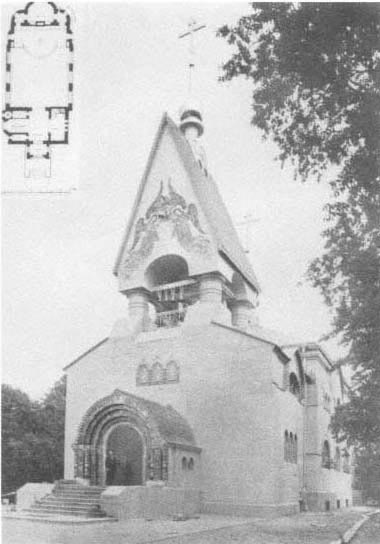
Fig. 98.
Church of the Resurrection of Christ on Tokmakov Lane, Moscow.
1907–1908. Ilia Bondarenko. Ezhegodnik Obshchestva
arkhitektorov-khudozhnikov . 1908.
Novgorod-Pskov churches, and the models for the iconostasis and furnishings are derived from some of the most ancient objects of Russian art."[50]
Bondarenko's Church of the Intercession (1911), for the Intercession-Dormition Community on Gavrikov Lane, also freely interpreted the Novgorod style, but it used the more traditional cross-inscribed plan, with heavily sculpted gables and a dome over the center of the structure (Fig. 99). Like the church for the Pomorskoe soglasie, the Intercession-Dormition church had a narthex (not common in Orthodox architecture), to which Bondarenko attached an unusual bell tower supporting an elongated "tent" roof. The gilded ceramic tiles affixed to both the main cupola and the tower gave the exterior a brilliant effect. Each of the main structural elements can be traced to wood and masonry motifs of the northern style, yet Bondarenko's combination represented an emphatic departure from typical church design—one that in some ways reflected the differences between official Orthodoxy and the Old Belief.
The Intercession-Dormition church, for all its traditional motifs, displayed some features of the new style,
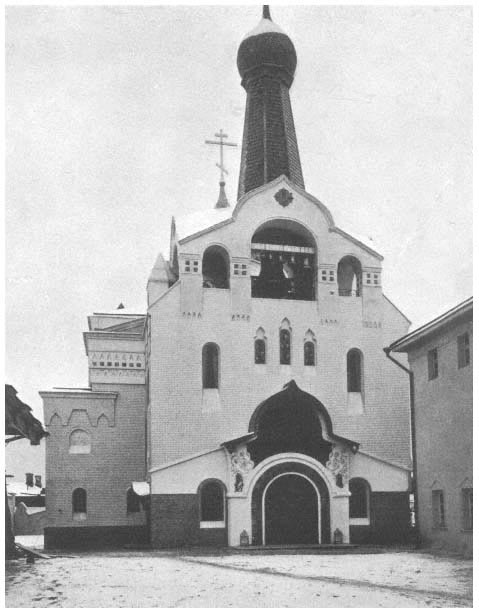
Fig. 99.
Church of the Intercession on Gavrikov Lane, Moscow. 1911. Ilia Bondarenko.
Ezhegodnik Moskovskogo arkhitekturnogo obshchestva , 1910–1911.
both in its plasticity of form (in the contoured outlines of the cream-colored pressed-brick walls) and in such advanced construction techniques as its use of ferroconcrete for the walls, the vaulting, and even the drum and cupola.[51] Bondarenko used ferroconcrete still more extensively in the third of his Old Believer churches in Moscow, the Church of St. Nicholas the Wonder-Worker, for the Nikola-Rogozh community (1912; at Malaia Andronovka and Third Rogozhskaia streets). This structure, combining elements of both Muscovite and Novgorod architecture, was the largest of the three churches and had the most complex design, with numerous cupolas and three spires over the entrance portal, whose facade portrayed two angels hold-
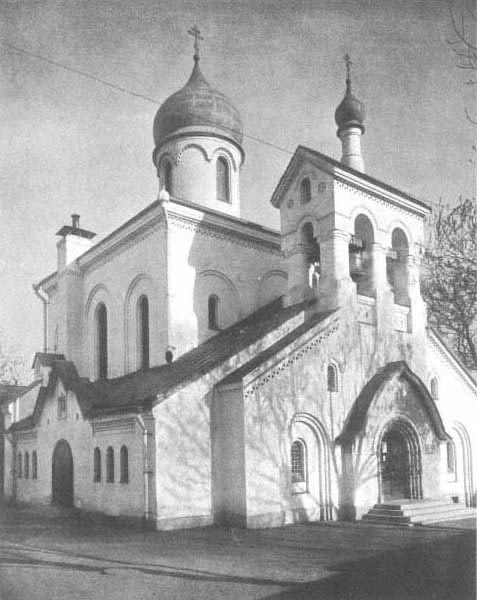
Fig. 100.
Church of the Intercession on Ostozhenka, Moscow. 1908–1910. V. D. Adamovich,
V. M. Maiat. Ezhegodnik Moskovskogo arkhitekturnogo obshchestva , 1910–1911.
ing an icon. The repetition of this image in Old Believer churches testifies to the reverence extended to the old, prereform, religious motifs. The Nikola-Rogozh church, like the Intercession-Dormition church, included a large bell tower with a tent roof, though here the tower was freestanding, linked to the main structure by a gallery at the northwest corner.[52]
Among other Old Believer churches in Moscow that applied medieval motifs in modern form, one of the most sensitive was the Church of the Intercession of the Mother of God, built for the Ostozhenka Community with funds provided by the Riabushinskii brothers (Fig. 100).[53] The architects of the church, V. D. Adamovich and V. M. Maiat, are known primarily for their contri-
bution to the neoclassical revival in Moscow, including the Vtorov mansion (see Figs. 299, 300). Here they skillfully adapted the architecture of fifteenth-century Pskov to the requirements of the Ostozhenka Community. This was "archaeologically" the most faithful medieval stylization in a Moscow Old Believer church; it had the begunets and other decorative patterns in brick and a thin layer of white stucco over the brick facade.
The various Old Believer communities constructed at least fifteen freestanding churches in Moscow from 1900 to 1917, including one more by Adamovich in 1915. The four just described gained the most attention from the contemporary architectural press, which viewed them as models of the new style in church architecture. Sectarianism or religious dissent was not, however, a prerequisite for artistic inspiration, nor was the design of Russian Orthodox churches either mediocre or hopelessly entangled in bureaucratic regulations. The intensive study of medieval Russian monuments had created opportunities for something greater than a pale or trivial imitation of seventeenth-century forms. Indeed, by the turn of the century, religious architecture had become an essential part of the curriculum in leading architectural schools such as Petersburg's Institute of Civil Engineering, where architecture students had to submit two diploma projects, one in secular and the other in church architecture. Thus church design eventually attracted some of the most talented architects of the new generation, including a number who later attained distinction in the resolutely secular environment of Soviet architecture.
None who approached the revival of church architecture understood better the harmony between medieval forms and the new aesthetic than Aleksei Shchusev (1873–1949). Although his career has been closely linked with the vicissitudes of Soviet architectural policy (to which he adapted with astonishing facility), church architecture was central to his prerevolutionary work and writings. Educated at the Academy of Arts, from which he graduated in 1897, Shchusev rapidly assumed a prominent position in the Petersburg Society of Architects before moving his practice to Moscow after 1905. At a meeting of the Petersburg Society in 1905, he delivered a talk entitled "Thoughts on Creative Freedom in Religious Architecture" (subsequently published in Zodchii ), roundly condemning the tasteless brilliance of official Orthodox church design. The decline had been caused by unwarranted interference in the design process by clergy, donors, and official institutions and the inability of architects themselves to devise anything more than a crude, uninformed imitation of historical prototypes.
Shchusev defined principles to counter the reigning mediocrity and regain the vitality of traditional Russian architecture. In his view the worst offense of recent church architecture was not simply the haphazard imitation of assorted medieval forms:
No, architects go further and try to correct them [the old forms], to endow them with so-called proportions in the Franco-Italian manner, which in the end destroys even the typicality of old forms and gives us not churches whose forms and interior furnishings are conducive to prayer but simply some sort of dance or concert hall, loudly and crudely painted and gilded. With their false grandeur and glitter, such creations bring joy to the clergy and parishioners and instead of developing the taste of the simple folk, impart to them a love for all that glitters, but not for the artistic.[54]
In his desire for a new creative interpretation of medieval forms, beyond thoughtless imitation, Shchusev followed the path of the Abramtsevo artists; it is telling that in his article he commented approvingly on artists' rediscovering the beauty and sincerity of medieval art and architecture: "Architects too must grasp and sense the sincerity of ancient times and creatively imitate it not in the copying out and correcting—that is, distorting—of old forms but in the creation of new forms that express, just as sincerely and beautifully as of old, the idea of a place of communion between the people and God."[55] The primary goal is to create a place of worship whose interior and exterior exemplify that "endearing, naive, and at the same time diverse sense of artistry of the Orthodox church."
Shchusev's first contribution to the revival of church architecture was presented to the public when in 1905, the same year he published his article, he displayed his design for a church-monument at the Kulikovo Pole battleground during the Art and Architectural Exhibit in Petersburg. A revision of the project in 1908 further revealed his attempt to recapture the "naïveté" of medieval church architecture while emphasizing the plasticity of material and contour of the modern architectural aesthetic (Fig. 101).[56] The project was not realized until 1913, but in the meantime Shchusev embarked on the construction of other churches.
Like the monument at the Kulikovo Pole battle-
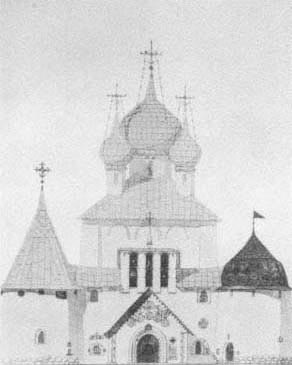
Fig. 101.
Project sketch for church-monument at Kulikovo Pole.
Third (final) variant, 1908. Aleksei Shchusev. Ezhegodnik
Obshchestva arkhitektorov-khudozhnikov , 1911.
ground, most of Shchusev's churches were constructed at sites far from Moscow and thus have no direct bearing on the new style in an urban setting. Nonetheless, two of these projects deserve mention as important expressions of the new aesthetic in religious architecture. Trinity Cathedral (1905–1912), constructed at the Pochaev Monastery (Lavra) near Kremenets in the Ukraine, was the largest of Shchusev's churches and his most determined modern re-creation of medieval prototypes—in this case, the early twelfth-century cathedrals at Novgorod's Iurev and Antoniev monasteries (Figs. 102, 103). It incorporated, and in subtle ways exaggerated, such features of the Novgorod prototypes as an attached tower leading to the choir gallery and a large central dome with a helmet-shaped cupola. The whitewashed brick walls of the building provided a backdrop for mosaic panels and wall paintings, designed by Shchusev and Nikolai Roerich, over the portals on the south, west, and north facades. At the time of its completion the cathedral was accorded the rare distinction of a special illustrated supplement—thirteen splendidly re-
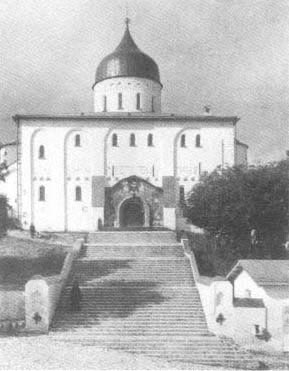
Fig.102.
Trinity Cathedral, Pochaev Monastery, Ukraine, south
facade. 1905–1912. Aleksei Shchusev. Ezhegodnik
Moskovskogo arkhitekturnogo obshchestva , 1912–1913.
produced photographs—in the 1912–1913 Annual of the Moscow Architectural Society (Figs. 104, 105).[57]
Shchusev's most idiosyncratic use of the medieval tradition occurred in Kharkov Province, where he designed a church for the wealthy merchant V. A. Kharitonenko. Completed in 1912, the Church of the Savior at Natalievka was marked by an outsize bulbous cupola (Figs. 106, 107). The walls were of ashlar limestone (rather than the more common brick), with stylized ornamental carving on the west facade and on the drum. The most distinctive feature of this free combination of elements from medieval Novgorod and Suzdalia was the large attached bell tower, whose sloping pylons framed openings extending over half its length.[58]
Shchusev was also responsible for the reconstruction of the twelfth-century Church of St. Vasilii at Ovruch, in the Ukraine—a project of major historical significance; when it was completed in 1910, the architect was named Academician of Architecture at the Academy of Arts.[59] Shchusev's work at Ovruch included the design of adjoining convent buildings (completed in 1912), with
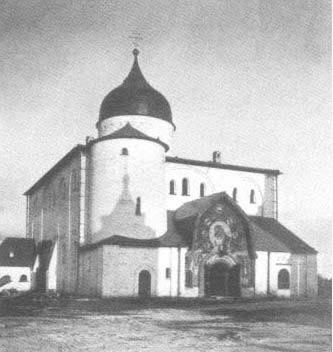
Fig. 103.
Trinity Cathedral, Pochaev Monastery, west facade. Ezhegodnik
Moskovskogo arkhitekturnogo obshchestva , 1912–1913.
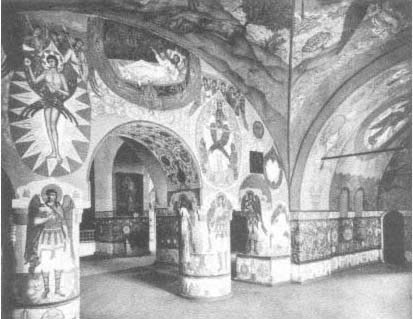
Fig. 104.
Trinity Cathedral, Pochaev Monastery, interior. Ezhegodnik Moskovskogo
arkhitekturnogo obshchestva , 1912–1913.
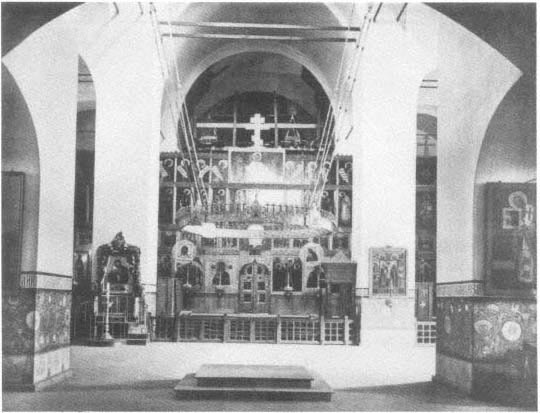
Fig. 105.
Trinity Cathedral, Pochaev Monastery, view toward iconostasis. Ezhegodnik Moskovskogo
arkhitekturnogo obshchestva , 1912–1913.

Fig. 106.
Church of the Savior, Natalievka. 1912. Aleksei
Shchusev. West facade. Ezhegodnik Obshchestva
arkhitektorov-khudozhnikov , 1915.
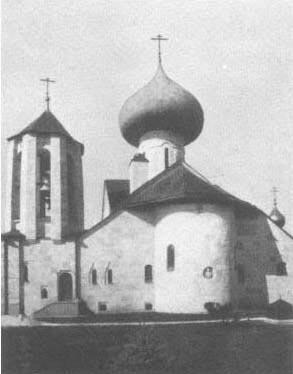
Fig. 107.
Church of the Savior, Natalievka. East facade. Ezhegodnik
Obshchestva arkhitektorov-khudozhnikov , 1915.
whitewashed brick walls and steeply pitched roofs derived from the architecture of medieval Pskov (Fig. 108).
During this remarkably productive period Shchusev undertook one major church project in Moscow: the Church of the Intercession (1908–1912) at the MarthaMary Cloister, a religious and charitable foundation supported by Grand Duchess Elizaveta Fedorovna. Like the Trinity Cathedral at Pochaev—and many of his other churches—the Church of the Intercession shows an affinity with the style of twelfth-century monastery churches in Novgorod, but interpreted abstractly (Fig. 109). The unstuccoed walls of uniform brick, the pointed gables, and the exaggerated proportions of both the apse and the west extension have no direct antecedents in Novgorod churches, nor does the ornamental limestone carving freely placed on the walls of the north porch.
The Church of the Intercession in fact combines elements from several medieval traditions—such as that of late twelfth-century Vladimir, with its carved limestone portals—and thus is directly related to its predecessor in the free style at Abramtsevo, which also combined
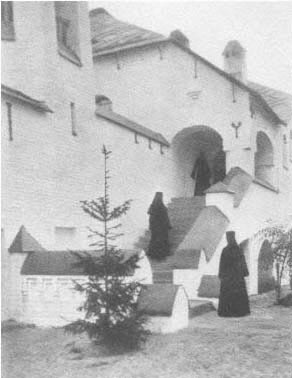
Fig. 108.
Convent at Ovruch. 1912. Aleksei Shchusev. Ezhegodnik
Moskovskogo arkhitekturnogo obshchestva , 1912–1913.
Suzdalian limestone carving with the plasticity of Novgorod brick churches. Only the simplified, or "naive," outlines of the structure suggest the debt to the tectonic clarity of Novgorod and Pskov. To recapture the medieval spirit in decoration as well as architecture, Mikhail Nesterov, who painted the interior of the church, imitated some of the stylized effects of medieval frescoes, though his paintings on mystical and religious themes were known primarily for their detailed, realistic technique in oil.[60]
One critic has noted that although Shchusev understood that the forested northern landscape would be the appropriate setting for such a stylized design, the Church of the Intercession was located in a thickly populated section of Moscow (on the Ordynka in Zamoskvoreche), where it seems like a "theatrical trinket," not entirely isolated from its surroundings by a high wall and a small park.[61] Shchusev indeed originally intended to situate the church on a forested plot, nonetheless the critic is excessively literal in view of the Moscow environment, where a seventeenth-century parish church
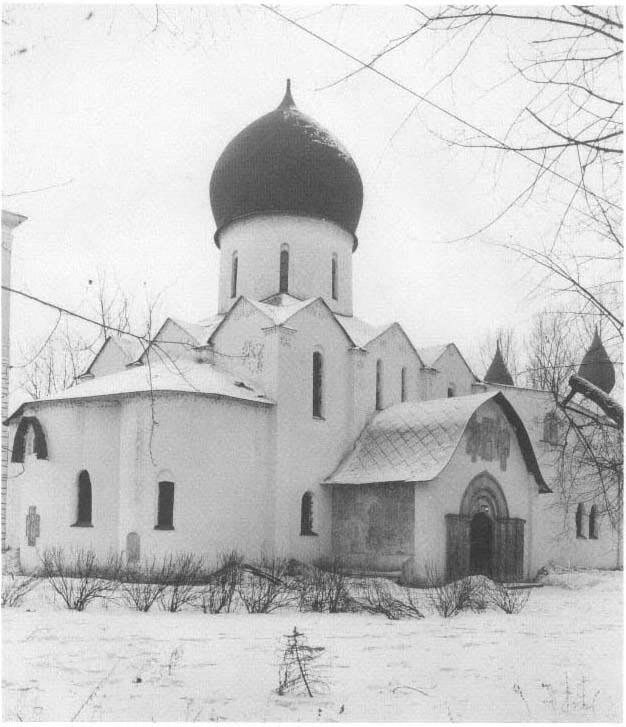
Fig. 109.
Church of the Intercession, Mary-Martha Cloister, Moscow. 1908–1912. Aleksei Shchusev (Brumfield M123-10).
can exist next to an apartment block. Furthermore, Shchusev's careful attention to the design of the cloister wall and gates, whose wrought-iron grate frames a view of the church, suggests that he had in mind the walled monastery compounds common in Russian towns during the medieval period.
The traditional tent form of the tower church assumed greater picturesqueness in the Church of the Resurrection in Sokolniki (1909–1913), by P. A. Tolstykh (see Plate 13). Although the style moderne—at least in its highly decorative, flamboyant manner—had waned in Russian secular architecture by 1909, its emphasis on the molding of structure influenced Tolstykh's treatment of the bays and apse and his use of color: the stuccoed brick was painted white and green, with the white used to outline the main structural components of the building. A brilliant array of cupolas surrounds the central tower.
This functioning Orthodox church, still maintained in excellent condition, represents a significant social element in the revival of church architecture, for it was built as a result of local initiative, with construction funds raised by a neighborhood committee headed by the priest I. I. Kedrov.[62] The project thus suggests an alternative to both the officially sponsored (and designed) Orthodox church and the private chapel or estate church. Although the Old Believer communities had already established the principle of local initiative in the construction of churches, the Church of the Resurrection represents the new style in Orthodox church architecture as an expression of revived religious values in an urban community.
The juxtaposition of religious and secular architecture in the work of numerous Moscow architects demonstrates the extent to which medieval architecture inspired new approaches to structure. Three of the most prominent Moscow architects of Soviet Constructivism, the brothers Leonid, Viktor, and Aleksandr Vesnin, designed several churches during the decade before the revolution, including at least four constructed in Nizhni Novgorod Province and one in Moscow Province.[63] Indeed, as students at the Institute of Civil Engineering, Viktor and Aleksandr Vesnin had designed a tent-tower church for Balakovo (1908) that is considerably more flamboyant than Shekhtel's later church in the same town (Fig. 110). Aleksandr Vesnin, moreover, was an on-site architect during Shchusev's rebuilding of the Church of St. Vasilii at Ovruch.
The Vesnins' church designs, like the others discussed above, used structural elements from medieval churches in a detached, aestheticized manner that spoke to the architects' interest in new forms and tectonic principles. The clarity and structural logic of old Russian church architecture were highly regarded both by architects of the style moderne and by those, such as the Vesnins, who effected the transition between the moderne and modernism. Although some of the historical references may have been nostalgic, churches designed in the new style balanced an aesthetic view of old church architecture with the concept of the church as a force in contemporary society—much as the freestyle churches did in England during the same period. The renewal of Russian church architecture proved short-lived, yet its results attest to the vitality of the style moderne as a medium of social and aesthetic expression.
For all of the diversity of the style moderne in private houses and apartment buildings as well as in churches, each kind of structure had recognizable common characteristics. The application of the style to commercial and public buildings, varied in scale and function, presents a more complex picture. Even with the considerable growth in Moscow, relatively few office or commercial buildings were constructed. (The greater number of such buildings in Petersburg reflects that city's position as a conduit for foreign capital.) Nonetheless, between 1900 and 1914, Moscow witnessed fundamental changes in the design of its office buildings, retail stores, hotels, restaurants, museums, and other public institutions.
The application of the style moderne to the architecture of commerce frequently entailed a compromise between eclectic and academic styles and new concepts of spatial and structural planning. Although the differences between the Beaux-Arts Sandunov Building and the Hotel Metropole highlighted the new style, the change proceeded less dramatically in the construction of most buildings, which may have had reinforced concrete frames and plate glass windows but still displayed decorative elements (cornice, pediments, molding) from the time when load-bearing brick walls were covered in stucco.[64]
In commercial architecture, the work of Adolf Erikhson is distinctive for its consistent, if moderate, approach to structural innovation and the articulation of the facade. A graduate, in 1883, of the Moscow School of Painting, Sculpture, and Architecture, Erikhson demonstrated the same eclectic proficiency as Kekushev and
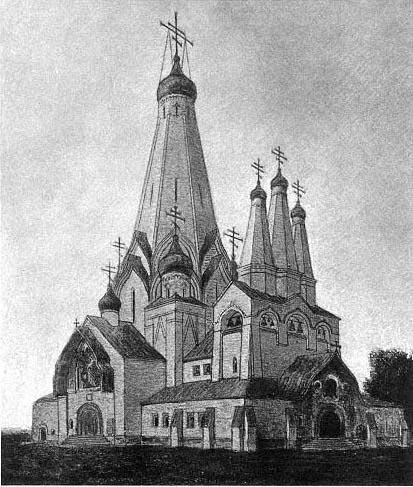
Fig. 110.
Project sketch for church at Balakovo. Viktor and Aleksandr Vesnin. Ezhegodnik
Moskovskogo arkhitekturnogo obshchestva , 1909.
other architects; it is evident in the mansion-cum-museum he created in the late 1890s for Petr Shchukin (Fig. 111).[65] This late exercise in the Russian Revival, derived from the client's specifications, soon gave way to more rational, modern impulses in the building that Erikhson designed for the publishing magnate Ivan Sytin.
The indefatigable Sytin published not only the major newspaper Russkoe slovo (The Russian word) but also enormously popular mass editions of Russian and foreign literature. (Anton Chekhov was among his close friends and supporters.) Sytin required an efficient multipurpose structure with both commercial and production areas. Erikhson's design for the Sytin Printing House (1905–1907) incorporated the walls of a two-storied mansion from the beginning of the nineteenth century, within which he erected a four-storied structure, with attic, whose frame and floors were ferroconcrete (Fig. 112). The top floor and the attic were reserved as living quarters for the Sytin family, while the second and third floors housed the editorial offices.[66]
The concrete and metal frame permitted an open, unobstructed interior work space, illuminated by large windows that fill most of the main facade. At the turn of the century Shekhtel had already exploited this design, but Erikhson pushed its decorative possibilities still further with a variety of windows, including circular and modified venetian openings with the curved ornamental
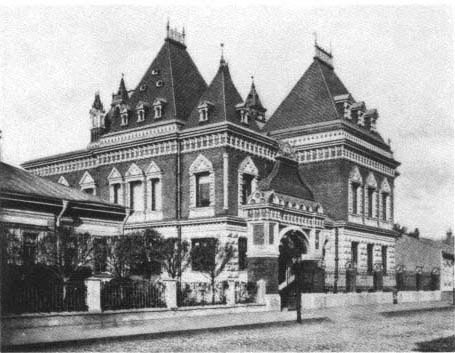
Fig. 111.
Petr Shchukin house, Moscow. 1897–1898. Adolf Erikhson. Arkhitekturnye motivy , 1899.
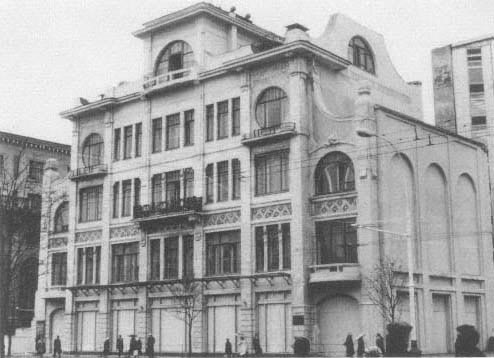
Fig. 112.
Sytin Printing House, Moscow. 1905–1907. Adolf Erikhson. (Brumfield M-44).
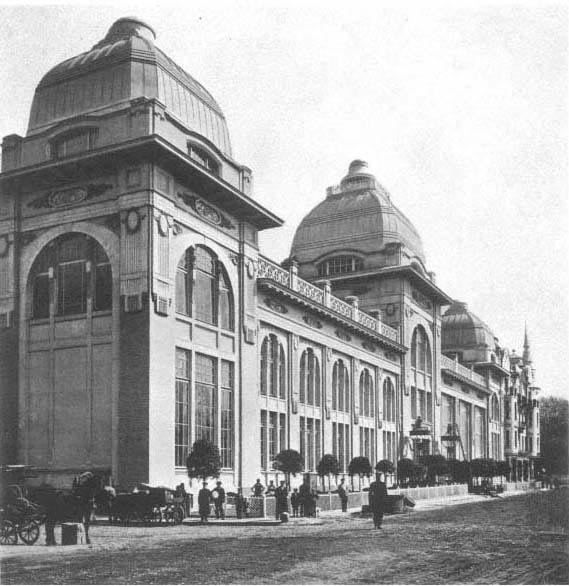
Fig. 113.
Iar Restaurant, Moscow. Ca. 1909. Adolf Erikhson. Ezhegodnik Moskovskogo arkhitekturnogo
obshchestva , 1910–1911.
mullions common in the early moderne. The frame of the main facade is sheathed in lightly glazed brick, with moderne decorative details (including a female mask) sparingly applied in stucco under the cornice and at the corners of the building.[67] The spandrel between the second and third floors has a ceramic band in a floral pattern, and the wrought-iron work on the balcony railings restates the facade's curvilinear motif. Whereas the decorative details resemble those of contemporary Viennese design, the grid pattern is typical of Moscow commercial architecture in the new style.
The Sytin Printing House is the most proficient of Erikhson's commercial projects, combining function, innovative technology, and elegant decorative work. These same elements appeared in a much larger, diffuse, structure built to contain the Iar Restaurant, a pleasure palace in suburban Petrovskii Park (Figs. 113, 114). The building (ca. 1909), which has been substantially altered,
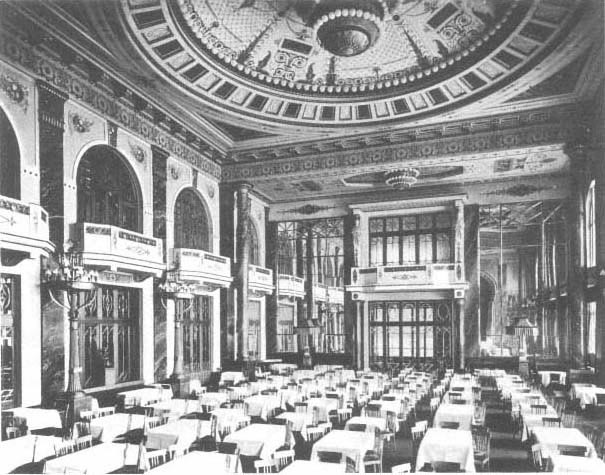
Fig. 114.
Iar Restaurant, Winter Hall. Ezhegodnik Moskovskogo arkhitekturnogo obshchestva , 1910–1911.
originally resembled a large pavilion with an arcade formed by two-storied windows. Inside were banquet halls decorated with the arabesques and grotesquerie of the early nineteenth-century Moscow Empire style. Although the Iar Restaurant itself can be considered a part of the neoclassical revival, already in force by the time of the building's construction, the structure and exterior detail (for example, the Secession touches on the corner blocks) belong to the moderne.
The function and design of Erikhson's palatial restaurant grew out of ideas about public accommodations introduced to Russia with the building of the Hotel Metropole (Erikhson designed that hotel's main dining hall). But the luxuriousness of his work in the restaurant and hotel is uncharacteristic; most of Erikhsons commercial buildings—the Sytin project is another exception—were austere exercises in brick over a reinforced-concrete frame, implemented with an understanding of the subtleties of the arch, the window proportions, and the use of decorative ironwork.
In the realm of public architecture, few building types in Moscow developed more rapidly at the turn of the century than the museum; the moderne, however, had little impact on museum design, which passed from the Russian nationalist style of the Historical Museum to a full-blown interpretation of the international classical style. Apart from Vasnetsov's Tretiakov Gallery, which established the neo-Russian variant of the style moderne, the only major museum project in the new style was the north wing of the Polytechnic Museum.
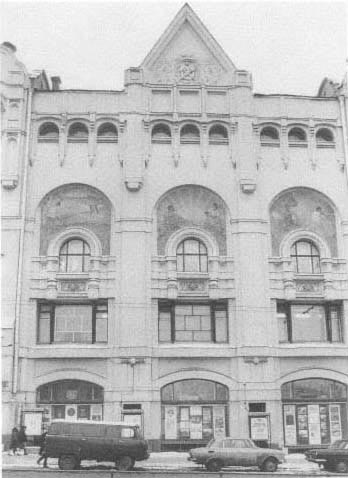
Fig. 115.
Polytechnic Museum, north wing, Moscow. 1903–1907. P. A.
Voeikov, V. I. Eramishantsev, G. I. Makaev (Brumfield M121-23).
The design of the south wing (1896) had been implemented by Nikolai Shokhin, who also engineered the original, central, structure. Although the south wing has less ornamentation, its style is close to that of the building's core.
The north wing, however, represents a fundamental change and thus provides an unusual opportunity to trace the evolution from historicism to the moderne in a complex of buildings that preserves an overall harmony of parts (Fig. 115). Although precise details are lacking, it is generally accepted that Georgii Makaev, the architect of the florid apartment building on Vvedenskii Lane, supervised the construction of the north wing between 1903 and 1907. The actual design, however, is attributed to P. A. Voeikov and V. I. Eramishantsev; the painted triptych on the wing's facade is the work of the versatile Makaev.[68] The scenes idealize, in the English spirit, the progress of labor from agriculture to industry and, ultimately, to a shining future based on education.
Whoever its designer, the north wing demonstrates how earlier embodiments of the new style, characterized by a surface laden with decorative variations on traditional Russian forms, yielded to a sculpted design in which every element refers to the structure in its entirety. The facade remains unified in form and contour from the ground-floor arcade, intended for commercial purposes, to the main windows of the three central bays, to the top windows, arranged in a machicolated pattern, three to a bay, and on to the central pediment. All the elements, as well as the wall paintings, are contained be-
tween the shafts of the two corner towers, also modeled in bold relief. The new aesthetic sensibility is most clearly evident in the rhythm of the arches, set into the stucco surface of the wall with barely a reference to Russian historicism. The massive surrounds of the three central windows echo the decorative work of the earlier museum building, but in a highly stylized, nonarchaeological manner; and even this reference is daringly, almost illogically, suspended over the plate-glass windows immediately below.
The new wing acknowledges both the historical surroundings of the museum and the national culture that it celebrates: the machicolated strip reflected the great Nikolskii Tower of the sixteenth-century Kitai-Gorod wall, then directly west of the museum (the tower and most of the wall have since been razed). In addition, the sculpted ornamentation that appears sparingly on the facade recalls old Russian motifs. Thus the north wing honors the intention and style of the museum while maintaining its own stylistic identity. Its decorative facade is appropriate to both the building's location—overlooking the broad expanse of Lubianka Square—and its function as one of the city's major lecture halls.
The sharpest contrast between historicism and new style appeared in buildings for retail trade, epitomized by Roman Klein's design for the firm of Muir and Mirrielees. Klein's earlier emporium for the wholesale trade, the Middle Trading Rows (see chapter 1), was an attempt, not wholly successful, to reconcile historicism with serviceable commercial space. Klein made use of the experience in his work for Muir and Mirrielees, who wished to expand beyond their retail building on Kuznetskii Bridge. They intended to offer shopping convenience unprecedented in Moscow in a setting that would attract customers and at the same time rationalize retail merchandizing in a single store.
Even today, the structure Klein built in 1906–1908 is impressive, although like the Hotel Metropole—which it faces from a distance of one block—it stands in disharmony with the neoclassical Bolshoi Theater and flanking buildings. In designing a reinforced-concrete skeleton to support the structure, Klein emphasized the grid of the facade, in the manner of Sullivan and the Chicago school (Figs. 116–118). The store was probably the first structure in Moscow to use a system of suspended exterior walls; the strips of plate glass that provided natural illumination for the interior were inserted between elements of the skeletal frame.[69]
Klein retreated, however, from creating a totally unadorned rationalist structure: like some of his American contemporaries, he used English Gothic decorative devices, particularly noticeable along the roofline and on the corner tower. In addition to the pinnacles, lancet windows, and crockets, he placed a large rose window within the pediment on the south facade. It has been said that in this building Klein bypassed the style moderne by moving directly from the eclecticism of the 1890s to the retrospectivism fashionable in the decade before the revolution; yet the Gothic touches do not substantially alter the building's functional grid.[70] In the 1890s architects such as Shekhtel had used the Gothic to redefine the link between form and structure, but in the Muir and Mirrielees facade, Gothic elements are largely ornamental. The ornament itself is made of such modern, functional materials as zinc (overlayed with copper to simulate bronze) and marble aggregate.
Such is the varied nature of the style moderne in Moscow that any structurally innovative building that was not overtly academic or eclectic might be labeled "new," from Maliutin's neo-Russian apartment building to the international style of the Sytin Printing House. Whatever their superficial resemblances, the commercial buildings surveyed in this chapter are essentially unrelated to the masterpieces of contemporary architecture in Central and Western Europe; yet all of them reveal how far beyond the narrow search for a national style architecture in Moscow had moved, without the loss of local idiosyncracies.
While some critics decried the lack of rigor or logic in the new Russian architectural aesthetic, others recognized the traditional Russian methods of assimilating new ideas. With perceptive humor, the observer of "Contemporary Moscow" noted the similarity of the city's architecture in 1500 and 1904:
In the new buildings, as in the old, the same melody sounds, in which the accustomed ear can detect the motifs of different epochs, different peoples, joined primitively into one colorful whole. The motifs now are just as naive, just as unexpected, and still amaze us with their contrasts, combining prayers to heaven with bows to mammon.[71]
The style moderne in Moscow reflected the city's diverse architectural heritage while adapting contemporary European architecture to an entrepreneurial social
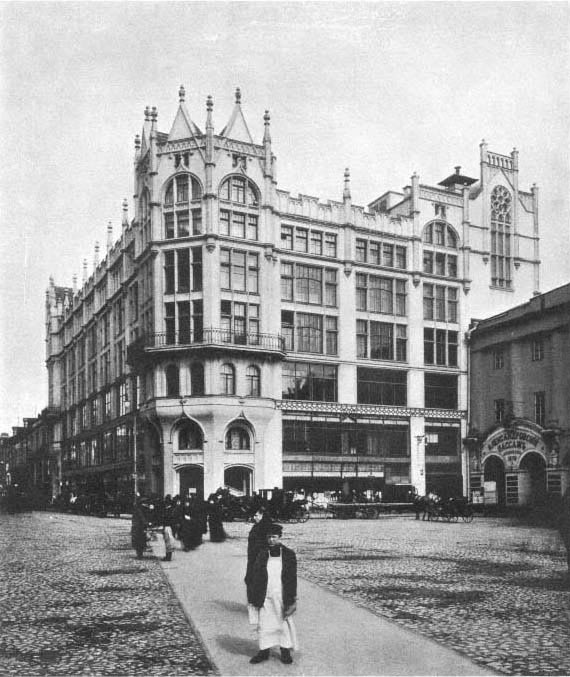
Fig. 116.
Muir and Mirrielees department store, Moscow. 1906–1908. Roman Klein. Ezhegodnik Moskovskogo
arkhitekturnogo obshchestva , 1909.
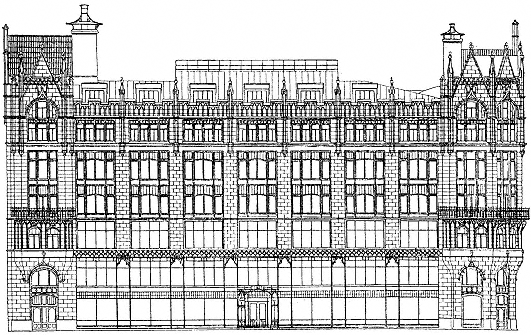
Fig. 117.
Muir and Mirrielees department store. Facade. Ezhegodnik Moskovskogo arkhitekturnogo
obshchestva , 1909.
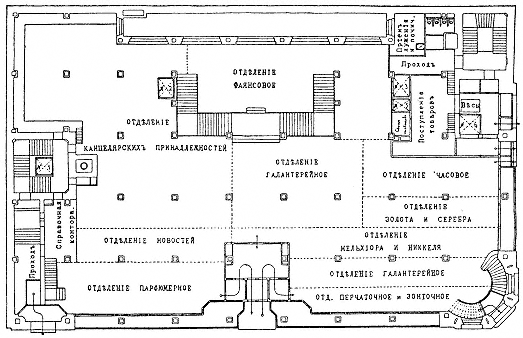
Fig. 118.
Muir and Mirrielees department store. Plan. Ezhegodnik Moskovskogo arkhitekturnogo
obshchestva , 1909.
milieu. The contradictions inherent in that milieu are apparent in the architecture; Moscow had not fully entered the modern age either architecturally or socially, yet the new style—at times subtly, at times theatrically—used the past to develop to a vision of modernity. In this flourishing, if "naive," artistic setting, one architect, understanding how to unify the contrasts, interpreted Moscow's variety and color in his own articulation of the moderne. Although Fedor Shekhtel's work was not limited to the new style, the thought and purpose of his designs at the beginning of the century gave that style its most profound expression.
Chapter Four—
Fedor Shekhtel:
Aesthetic Idealism in Modernist Architecture
Fedor Shekhtel is unique among Russian architects at the turn of the century, not only in his record of accomplishments over three decades but also in his coherent expression of the cultural aspirations—and contradictions—of an era that transformed Russia. More than that of any other architect, Shekhtel's work embodied and enlarged the creative possibilities of the style moderne; yet he retreated from modernism after 1908 and returned to the forms of traditional Russian architecture. His career, supported by Moscow's enlightened, progressive merchant patrons, ultimately demonstrated the limits of aestheticism in a milieu dominated by commerce and industry.
Born in 1859, Fedor (Franz) Shekhtel grew up in a close-knit community of German immigrants in the Volga town of Saratov. His father, who died in 1867, was a civil engineer, and his mother—Daria, née Zhegina—was of merchant background, with numerous relatives in both Saratov and Moscow. In 1875, after attending a Catholic secondary school, Shekhtel joined his family in Moscow, where his mother's connections provided security for her children and furthered Shekhtel's education and career.[1] There seems to have been no doubt concerning his talent for drawing and love for the theater.
Indeed, Shekhtel's early work belongs more properly to various forms of decorative and theatrical art than to architecture. School records show that Shekhtel was not a very diligent student during his two years (1875–1877) in advanced classes at Moscow's School of Painting, Sculpture, and Architecture; but at the same time, he pursued design work ranging from title pages for books and journals to theater posters to sets and theater decoration in collaboration with such impresarios as Mikhail Lentovskii.[2] His mother's position as household manager for Pavel Tretiakov gave Shekhtel ready access to art patronage in Moscow, and his extraordinary natural abilities as both painter and designer removed whatever stigma might have attached to his lack of a formal degree.
From the mid-1870s to about 1882 Shekhtel served his apprenticeship in the office of Aleksandr Kaminskii, an architect much sought after by Moscow's merchant elite in the 1870s and the recipient of numerous commissions from Pavel Tretiakov.[3] During this period Shekhtel appears to have designed at least one private house; but more important, Kaminskii's extensive connections complemented those Shekhtel had formed with the Tretiakovs. In the mid-1880s Shekhtel worked in the office of Konstantin Terskii, who had studied both at the Moscow School and at the Petersburg Academy of Arts, where he received a degree in 1875.[4] Like most fashionable Moscow architects of the time, Terskii had adopted the Russian Revival style, and it was under his auspices that Shekhtel designed the highly ornamented facade of the Paradise Theater (1886; Fig. 119). This was
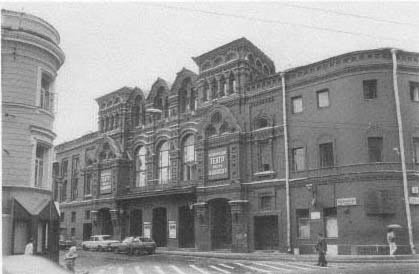
Fig. 119.
Paradise Theater, Moscow. 1886. Konstantin Terskii, Fedor Shekhtel
(Brumfield M174-6).
the first major exterior design by Shekhtel to be realized, with an exuberance of detail that rivals Chichagov's Korsh Theater (1885; see Fig. 13).
Even as his interest in architecture developed, theater remained indispensable to Shekhtel's artistic imagination; appropriately, one of his closest friends among fellow students at the Moscow School was Nikolai Chekhov, the older brother of Anton, who arrived in Moscow two years later.[5] Shekhtel's close and early acquaintance with the Chekhov family established him among contemporaries whose interests paralleled his own; moreover, it fostered a close friendship between Shekhtel and Anton Chekhov, two of the leading participants in Russia's cultural renaissance at the turn of the century. From 1886, when Shekhtel designed the title page for Chekhov's first published collection of stories, to 1910, when he built a library-museum in Chekhov's birthplace, Taganrog, as a memorial to the writer, Shekhtel and Chekhov found support in each other's work.
By 1890 Shekhtel had designed and built his first independent projects, including the spectacularly stagy house for S. P. von Dervis at Kiritsy (near Riazan) that combined Gothic, Moorish, and Russian elements on a "neoclassical" terrace. The scant evidence of other estate and country houses he built at the same time (including one for the textile magnate Vikula Morozov) suggests that these were competent but youthful efforts, theatrical and shamelessly eclectic (Fig. 120). In fact, at this point Shekhtel was not yet officially licensed to practice as an architect. After passing a series of examinations in January 1894, he obtained his professional certificate along with the title technician-builder, which allowed him to pursue what had now become his primary career in Moscow.[6]
The project that gained Shekhtel his new status was the large pseudo-Gothic townhouse for Zinaida Morozova, the wife of the Maecenas and industrialist Savva Morozov.[7] Construction of the design, which dates from 1893, took some three years, and although both the interior and exterior display the ostentatious striving for effect typical of that time (cf. Fig. 53), the project is more than an accomplished rendition of late nineteenth-century baronial splendor (Fig. 121). Like Viollet-le-Duc and Ruskin, a number of Russian critics interpreted the Gothic as the repository of authentic structural values, of an organic unity between appearance and structure, between interior and exterior. Whether Shekhtel knew of these ideas or merely assimilated a widespread fashion, in this house he developed a Gothic stylization of interior space that went beyond the decorative elements.
On the exterior, Shekhtel discarded symmetry in favor of a balanced combination of forms that reflected the design of the interior. He used stylized elements on the exterior—the lancet windows, the Gothic tracery,
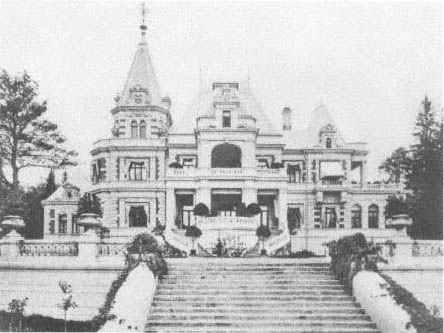
Fig. 120
Vikula Morozov house, Odintsovo-Arkhangelskoe, near Moscow. Ca. 1895. Fedor
Shekhtel. Zodchii , 1899.
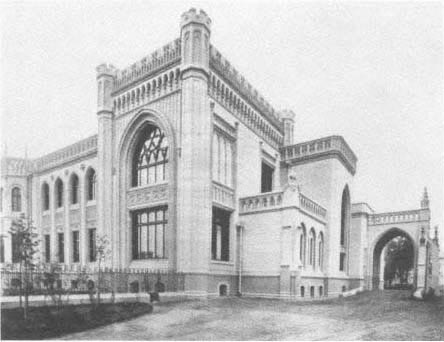
Fig. 121.
Zinaida Morozova house, Moscow. 1893–1896. Fedor Shekhtel. Arkhitekturnye
motivy , 1899.
the crenellated parapet—as well as in the interior, with its woodwork and stonework. But the advantage of the Gothic structure for Shekhtel lay in its adaptability to a free interpretation. The windows of the main facade, of varying sizes, not only reflect the arrangements of rooms but also create distinctive areas of light.
Although the exterior is imposing, the rooms are compactly arranged—in relative terms, of course. Not even the largest rooms extend the full two stories: the lower half of the great Gothic window facing the street illuminates the dining room, the upper half Zinaida Morozova's bedroom suite. Neither room is small; but it is hard to imgine an architect in New York or Petersburg ignoring the possibilities of a two-storied hall behind this window. The other rooms on each floor were arranged along a corridor and designated for family use. This practical, if unimaginative, arrangement, which corresponded to the traditional separation of state and living rooms in Russian houses of the neoclassical era, would be superseded by the centralized core plan of the Stepan Riabushinskii house.
Shekhtel also built a one-storied extension to the house for a lavish baroque ballroom, connected to the main structure through the vestibule (Fig. 122). (For this vestibule, with its stairway to the second floor, Mikhail Vrubel created a stained glass panel, The Knight , in 1896.) Although the extension is not immediately visible from the street, the Gothic window that projects from the front marks its axis. In this project Shekhtel demonstrated a masterful grouping of structural components that enabled exterior accents to reveal interior function.
Shekhtel's professionalism in designing the Zinaida Morozova house did not, however, represent his emancipation from a traditional, academic approach to building. Gothic theatricality had yet to run its course in Shekhtel's imagination, as is evident from the dacha he built in 1895 for Ivan Morozov in Petrovskii Park, a suburban playground for Moscow's rich. The timber hammer-beam roof over the great dining hall—a rustic variant of the Gothic—dominated the structure (Figs. 123, 124); and Shekhtel used similar pseudo-Gothic motifs in remodeling the interiors of other Moscow houses belonging to the Morozovs (Fig. 125).[8]
A more austere, if hardly modest, interpretation of the pseudo-Gothic appeared in Shekhtel's house for K. V. Kuznetsova (1896).[9] The stonework of the house had medieval touches, but the placement of the windows in rectangular shafts, outlined in stone on brick, suggests the Renaissance rather than the Gothic (Fig. 126). These stylistic features, though they emphasized the tectonic clarity of the building, seem to have been a matter of fashion. In this respect the Kuznetsova house is particularly helpful in marking the transition from Shekhtel's historical stylizations of the mid-1890s to his style moderne designs such as the Derozhinskaia house (see Figs. 148–157), whose facade borrowed elements from the central bay of the Kuznetsova house.
In the midst of that transition, Shekhtel pursued a series of major projects that led him from private to public architecture. An 1897 project for a People's House (Narodnyi dom ) in Moscow displayed a heavy Shervudian historicism, with flanking Kremlin-style towers and other seventeenth-century Muscovite details, though the upper structure and cupola echo the Russo-Byzantine style of the mid-nineteenth century. The idealistic, populist tendencies of Shervud's work and writings suffused Shekhtel's, in keeping with the purpose of the People's House to provide theatrical entertainment for the masses.
Anton Chekhov served as an intermediary between Shekhtel and the group of civic-minded women willing to support a "People's Palace." In a letter to Chekhov, Shekhtel noted that although the term "People Palace" (his English) might be acceptable in America, it was inappropriate for Russia.[10] He chose instead the name People's House—as in Victor Horta's Maison du Peuple, then under construction in Brussels. (Whatever Shekhtel's qualms, Soviet planners readily adopted the term palace in naming the structures for culture and rest built throughout the Soviet Union beginning in the 1920s.) Shekhtel included in the design of the People's House a large theater, lecture halls, a library and reading room, a teahouse, and commercial space for shops. The "Muscovite" decorative style affirmed the Russian cultural heritage (as did the Historical Museum) and appealed to popular taste. Although only a few of the People's Houses designed before 1917 were ever contructed, the concept itself attests to a growing sense of social awareness in architecture.
Indeed, Shekhtel designed a number of other public projects (all unbuilt), including a wooden People's Theater for Sokolniki Park (1897) whose floor plan prefigured the three-wedged design Konstantin Melnikov would use for the auditorium of his Rusakov Club (1929). Although Shekhtel's published drawing for the Olympus Concert Hall (1898) displays an entirely different aesthetic standard, with its Beaux-Arts facade (Fig.
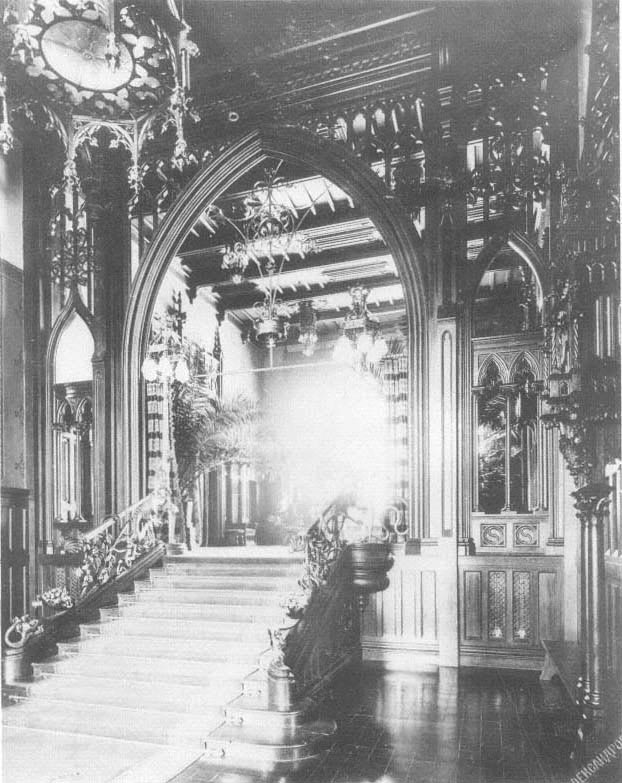
Fig. 122.
Zinaida Morozova house, vestibule.
Photograph ca. 1898.
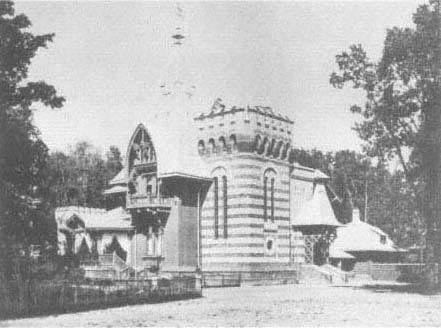
Fig. 123.
Ivan V. Morozov dacha, Petrovskii Park, Moscow. 1895. Fedor Shekhtel. Zodchii ,
1899.
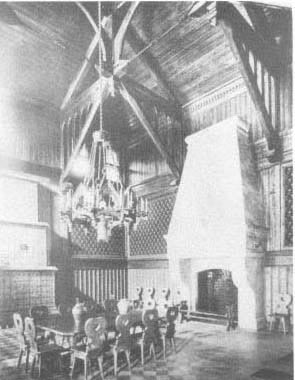
Fig. 124.
Ivan V. Morozov dacha, dining hall. Zodchii , 1899.
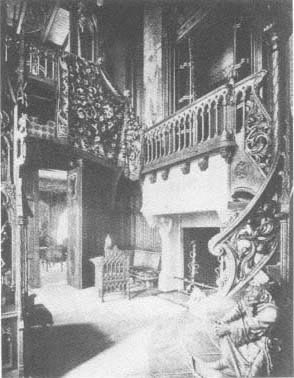
Fig. 125.
A. V. Morozov house, Moscow. Ca. 1897. Fedor
Shekhtel. Hall. Arkhitekturnye motivy , 1899.
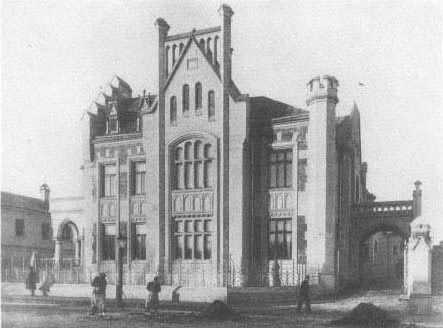
Fig. 126.
K. V. Kuznetsova house, Moscow. 1896. Fedor Shekhtel.
Photograph ca. 1897.
127), he had not abandoned his fascination with the popular theater. In 1902 Zodchii reproduced his drawing for a People's House of the Society for the Diffusion of Educational Popular Entertainment in Moscow, designed not in the historicist or eclectic manner but in a colorful neo-Russian variant of the style moderne with complex intersecting planes, steeply pitched roofs, and large arched windows, echoed by a two-storied arch over the principal entrances (Fig. 128).[11] It resembles Shekhtel's other "neo-Russian" projects of the period, such as the pavilions for the 1901 Glasgow exhibition and the Iaroslavl Station.
Besides private houses and unfulfilled visions of public buildings, Shekhtel designed several commercial structures during the late 1890s. His earlier effort in commercial architecture, a store for Penskii and Levenson on Petrovka Street (not precisely dated but before 1890), has not survived. In 1898 he designed the headquarters of the M. S. Kuznetsov company (Fig. 129), a leading producer of porcelain, glassware, and ceramics in Russia.[12] He had already designed a house for M. S. Kuznetsov, and his handling of the showrooms and office space for the firm on Miasnitskaia Street reveals a thorough understanding of commercial architecture and its technical requirements. The display rooms, though not large by American standards, required open space, which Shekhtel created by using iron columns and loadbearing reinforced-concrete walls—structural elements frequently used in Russian commercial architecture at the turn of the century.[13]
By eliminating the need for extensive vaulting on the interior, Shekhtel was able to open the exterior wall with four three-storied arched windows, with recessed spandrel beams at floor level. This arrangement not only flooded the interior with light but also lessened the weight on both wall and foundation. The fourth floor, used for offices, rests incongruously on the massive arcades (a fifth floor was added after the revolution), but Shekhtel's glass surface at the Kuznetsov building heralded the modern age in commercial space for central Moscow. This tectonic development was prefigured in Shekhtel's earlier work—the masonry and glass facade of the Zinaida Morozova house, for example.
The vertical shafts separating the large glass planes of the Kuznetsov Building are still in the neo-Renaissance style, however, as massive rustication on the ground floor gives way to the heavy quoins (the "Gibbs surround") at the second and third stories. Not content
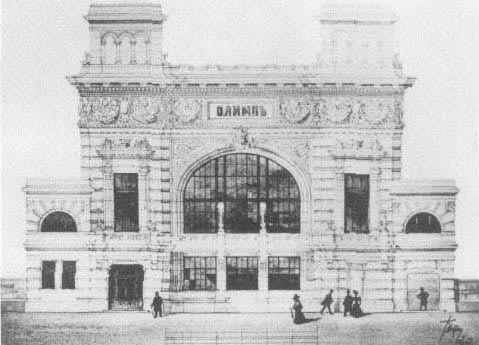
Fig. 127.
Project drawing for Olympus Concert Hall, Moscow. 1898. Fedor Shekhtel. Zodchii , 1899.
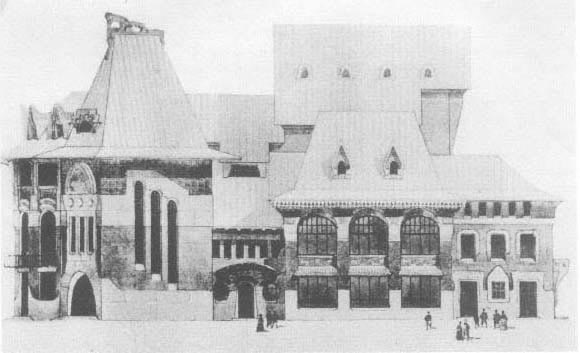
Fig. 128.
Project for People's House, Moscow. Fedor Shekhtel. Zodchii , 1902.
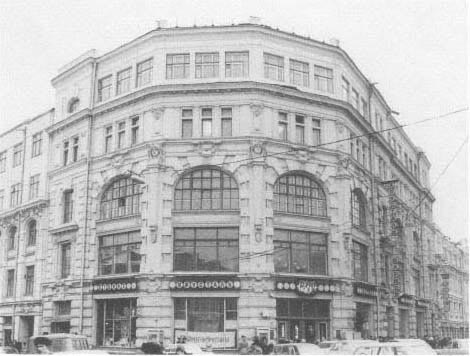
Fig. 129.
Kuznetsov building, Moscow. 1898. Fedor Shekhtel (Brumfield M121-22).
with this ponderous detailing of the sandstone, Shekhtel separated the windows with large terms surmounted by outsize female masks. This decorative device became a cliché on cornices and elsewhere on facades, and many Moscow buildings adorned in the new style display these masks (the moderne's answer to the bucranium), which represent a fin-de-siècle ideal of feminine beauty.
The following year, 1899, Shekhtel repeated many of these elements in a smaller commercial building for the V. F. Arshinov firm in the old Kitai-Gorod district (Fig. 130). A three-storied arched window occupies most of the narrow facade, providing light for the display rooms that extend to the back of the building, which has iron columns for floor supports. The fourth floor, for office use, counterbalances the glass arch with a strip of narrow windows along the facade. Here, in contrast to the Kuznetsov building, the skeletal frame is lightly outlined by the mullions and spandrels of the central window, while the stonework blends onto the surface of lightly glazed blue brick. As in many of Shekhtel's designs of the 1890s, the facade is defined by verticals (in this case window shafts) on either side of the center—a solution suited to the restricted scale of the Arshinov building. Despite the Renaissance allusions of the facade, Shekhtel's use of glass and glazed brick anticipates a rationalism in which aesthetic properties derive from the material and the proportions of the frame.
During the 1890s Shekhtel defined his interest in yet another building type—the Russian church. Although his numerous designs for the construction and decoration of churches are related to his early endeavors in painting icons, his first commissions, in 1897, were to redecorate the interior of a church at Moscow's Danilov Monastery and the Church of St. Pimen on Vorotnikov Lane. The extent of this work is not well documented, but neither church would have required major structural changes. These projects no doubt helped Shekhtel to obtain the commission for the large Church of the Savior in the city of Ivanovo-Voznesensk, a textile center some three hundred kilometers northeast of Moscow.
Shekhtel's design for this church relied on the neo-Byzantine style typical of Orthodox church architecture in the later nineteenth century (Fig. 131). The pentacupolar structure, faced in cut stone, followed the usual cross-domed model of medieval Orthodox churches; but the plan was highly centralized, with the four corner
bays reduced to small spaces between the arms of the cross. The appearance and the details of the Church of the Savior—from the hemispheric domes to the window design—were broadly related to the High Paleologan style; yet there is no evidence that Shekhtel studied late Byzantine architecture. Nor would he have needed to: his design closely resembles Andrei Huhn's 1886 project for a cathedral at Glukhov (in Chernigov Province), even to the placement of the corner cupolas on polygonal arcades rather than on enclosed drums. Although the features of the Church of the Savior reflected the wishes of the church authorities who commissioned it, the design Shekhtel submitted was a conservative one, unrelated to experiments in freestyle church architecture at the beginning of the century.
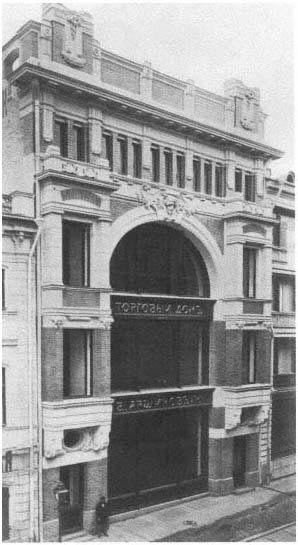
Fig. 130.
Arshinov building, Moscow. 1899. Fedor Shekhtel.
Zodchii , 1902.
In 1899 Shekhtel created a more imaginative design for a new cathedral at the Rozhdestvenskii (Nativity) Convent in Moscow (Fig. 132). If it was intended to replace the old cathedral, we are fortunate that it was never built, for the original building is one of the few extant examples of Muscovite architecture at the beginning of the sixteenth century. Shekhtel's design was nonetheless original in its muting of Byzantine elements and its emphasis on verticality, which suggests the sixteenth-century tower churches in the Moscow area—such as the Church of the Decapitation of John the Baptist at Diakovo. The bulbous cupolas are a traditional Russian element, but the exterior decorative work—particularly the large panel (perhaps mosaic) portrayed in the elevation—announces that this is no
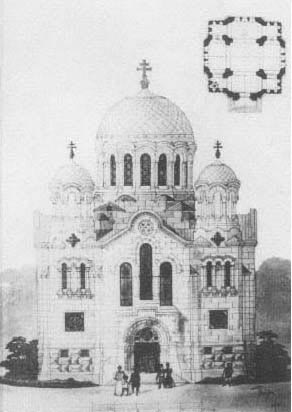
Fig. 131.
Church of the Savior, Ivanovo-Voznesensk. 1898.
Fedor Shekhtel. Arkhitekturnye motivy , 1899.
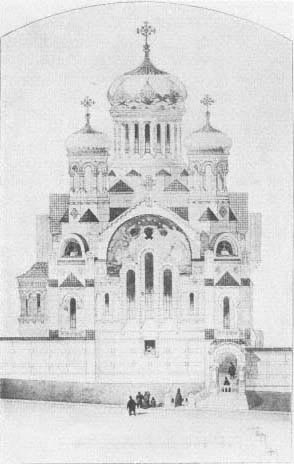
Fig. 132.
Cathedral, Rozhdestvenskii Convent, Moscow. 1899.
Fedor Shekhtel. Arkhitekturnye motivy , 1899.
simple stylization but rather a product of the crafts revival. With its stone facing and complex geometric relations, this project represents Shekhtel's closest approach to freestyle church design.[14]
In 1899 Shekhtel also designed two chapels: a private chapel for G. A. Zakharin in the distant Moscow suburb of Kurkino and an addition to the Church of St. Vasilii Kessariiskii in the Tverskaia-Iamskaia district (Moscow; not extant), which commemorated the wedding of Nicholas II and Alexandra (1894). The latter chapel had a tent spire on a square limestone tower with seventeenth-century decorative detail (Fig. 133).[15]
By the end of the century, the forty-year-old Shekhtel had amassed an impressive list of works, built or
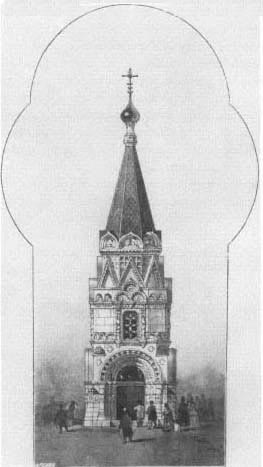
Fig. 133.
Commemorative chapel, Church of St. Vasilii
Kessariiskii, Moscow. 1899. Fedor Shekhtel.
Arkhitekturnye motivy , 1899.
projected, ranging from neo-Gothic mansions to functional commercial buildings. He had also become known as a master of interior design, integrating the applied arts into architectural space. In a profession concerned with publicizing its product in the press, Shekhtel (along with Kekushev) had become one of the most frequently published architects. Photographs and sketches of his work appeared not only in the Moscow periodical Arkhitekturnye motivy but also in the major professional journal, Zodchii . To be sure, such publicity reflected the stature of Shekhtel's clients as much as it did his own talent.
The roster of his patrons was impressive: the Kuznetsovs, Levensons, and multitudinous Morozovs as well as lesser-known people of means in Moscow. Although Shekhtel was aware of broader social purposes in
architecture, he was in a sense constrained to work in the taste of his wealthy clientele, the late nineteenth-century Muscovite merchantry. Even though the mansion he built for Savva and Zinaida Morozov marked an important stage in his mastery of architectural space, this and other Shekhtel buildings of the period show scant evidence of an innovative vision. Yet that vision existed, for without it one would be at a loss to explain Shekhtel's surge of creativity at the beginning of the century.
Both continuity and evolution are evident in his design for the A. A. Levenson Printing Works on Mamontov Lane (1900), a building that re-created a historical style (a French château of the early Renaissance) in a functional commercial and industrial structure.[16] Yet Shekhtel clearly maintained the dichotomy between romantic historicism and functionalism, even if it is not immediately visible. The front part of the building—the "château"—contained editorial and business offices on three floors under a steeply pitched roof like that common to Russian Revival buildings of the late 1890s (Figs. 134, 135).
The complex roofline is characteristic of Shekhtel projects at the beginning of the century (particularly his People's House design of 1902), with its antecedents in various Russian historical stylizations. At the same time, the vertical accents and steeply pitched roof show a similarity with art nouveau, as in the work of Emile André at Nancy and of Hector Guimard. And in the details of the main facade, constructed of yellow brick and stucco scored to resemble ashlar, an even greater variety of aesthetic currents was combined.
At the top of the central, projecting, window shaft, in a framework defined by large rectangular bays, Shekhtel placed a circular window; he used arches in the windows of the third story, in the mullions on the second story, and in the ground-floor entryway, where an arch shelters a bentwood door frame—now sadly defaced but still showing the outlines of perhaps the best example of an art nouveau motif in Moscow architecture.[17] The influence of art nouveau also appeared in the curved wrought-iron brackets originally framing the entrance and in the thistles on either side of the central bay in front and at the base of the projecting corner bay. An inset stucco panel on the facade portrays printers at work in a tableau that suggests the dignity of labor espoused by William Morris and the English Arts and Crafts movement.[18]
This agglomeration of elements reflects the often contradictory impulses of the early style moderne. Behind the relatively small office structure, with its idealized representation of craft labor, is the purely functional printing plant itself, which extends from the back wall of the offices. Despite its unadorned surface, the plant displays the same attention to detail as the rest of the building. The large window bays are supported by piers of pressed yellow brick, and the floors rest on a double row of iron columns that obviate the need for interior support walls—a construction typical of Shekhtel's commercial architecture. By the middle of the decade Shekhtel would bring this structural rationalism "up front" in the most advanced of his commercial building designs, for the Riabushinskii brothers.
Even in 1900, however, when Shekhtel had only begun to explore the romantic interpretation of the new style and its aesthetic possibilities, the Riabushinskiis were prominent supporters of his work, as the Morozov clan had been in the 1890s. Although the diverse cultural, political, and economic interests of the large Riabushinskii family cannot be reduced to a brief summary, the shared purpose that informs the Shekhtel-Riabushinskii collaboration demands that something be said of these cultured representatives of the Moscow merchantry.
The family members for whom Shekhtel worked were all sons of Pavel Mikhailovich Riabushinskii, himself the son of an Old Believer peasant who had clerked for a shop in Moscow's Merchants' Yard (Gostinnyi dvor, behind the Upper Trading Rows) during the 1820s and 1830s. This Mikhail Riabushinskii acquired the Moscow shop in 1844, afterward purchasing a series of textile mills that gave him control over both supply and retail operations. When he died in 1858, his two sons, Pavel and Vasilii, controlled the business; Pavel proved the more productive in every sense.
Born in 1820, he was the true founder of the Riabushinskii conglomerate, the guide of the Trading House of the Riabushinskii Brothers (founded in 1867) as well as the patriarch of a wealthy Russian bourgeois family. Pavel Mikhailovich, who married twice, had six daughters from his first marriage, which ended in divorce in 1859, and sixteen more offspring from his second marriage (in 1870), including nine sons, six of whom achieved prominence in Moscow's political, financial, and cultural circles. The firm of P. M. Riabushinskii and Sons, organized from the earlier Trading House in 1885,
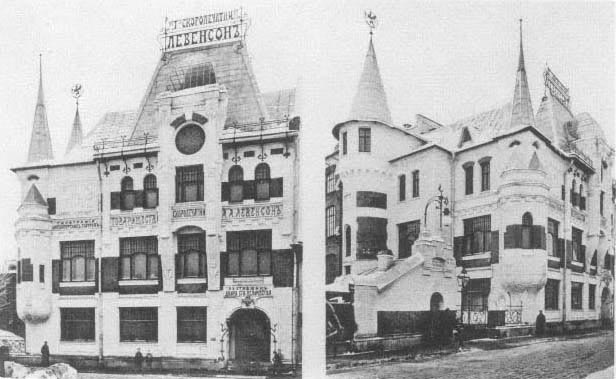
Fig. 134.
Two views of the Levenson Printing Works, Moscow. 1900. Fedor Shekhtel. Zodchii , 1902.
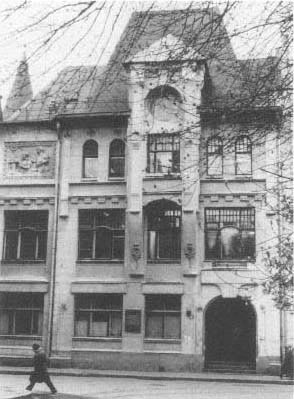
Fig. 135.
Levenson Printing Works, main facade (Brumfield M-42).
passed unchanged to the sons after Pavel's death in 1897; and although the family diversified its holdings during the 1900s, textile mills continued as the basis of the family's wealth.[19]
Shekhtel's successes among the leading merchant families in Moscow would easily have come to the attention of the Riabushinskiis; but he did no work for them before 1900, probably because until then power was concentrated in one patriarch's hands. Only after Pavel Mikhailovich's death would the individual sons establish households or make major changes in the family business. Indeed, at the turn of the century, the sons were still in their twenties—or younger. (The Morozovs, by contrast, had branched much earlier and represented a more "mature" fortune.) Although no specific evidence, such as correspondence, is yet available on the collaboration between Shekhtel and the Riabushinskiis, it is fitting that the only private house he built for them was commissioned by Stepan, one of the most dedicated and knowledgeable icon collectors of his time.
Despite Stepan's relative seniority among the brothers (he was the fourth, born in 1874), he was only twenty-six when the house was built—a fact that may explain why Shekhtel emphatically used the modern style in both architecture and decoration (see Plate 14). Although elements of his earlier work are evident here, the form departs significantly from anything he had previously built or projected. The blocked, rectangular outlines of the structure had a precedent in Kekushev's house for E. List (see Fig. 83); and the work of William Walcot further demonstrated the possibilities of applying brick, iron, and glass in a new housing design that owed little to traditional decorative or stylistic patterns.[20] All three architects, viewed as the leading Russian modernists by contemporary critics, had moved toward a plan that grouped components around a central space. As for precedents in the decorative arts, Kekushev had included ceramic panels on the exterior of the List house, and similar designs appeared on a larger scale in contemporary apartment houses.
Having acknowledged these antecedents, one is still confronted with the remarkable novelty of the Riabushinskii house in Moscow, where no other private dwelling displayed the new aesthetic with such panache and so thorough a knowledge of contemporary design—from Hector Guimard to Joseph Olbrich. Indeed, Olbrich's detached private dwellings—in contrast to the art nouveau townhouses of Paris and Brussels—closely resemble Shekhtel's design for Riabushinskii (particularly the house Olbrich built for the sculptor Ludwig Habich at Matildenhöhe, with the same block arrangement of mass and a flat overhanging roof). The Riabushinskii house, begun in 1900 and completed around 1902, however, is contemporary with—or predates—the house designs of Olbrich near Darmstadt.[21]
Shekhtel also incorporated modernized Russian motifs into his design: the heavy porch is like the kryltso (porch) attached to the entrance of seventeenth-century Muscovite churches; and the two small windows on the upper right front facade, in contrast to the art nouveau contours of the main windows, suggest the narrow windows of a medieval Muscovite terem , a dwelling with a tower. Although the ebullient exterior ornament—the mosaic frieze and the wrought-ironwork, for example—seems far removed from traditional Russian architectural ornament, it refers to both the crafts revival in Russia and the polychromatic patterns of medieval Russian architecture. At the Riabushinskii house, Shekhtel merged the old Muscovite concept of the teremok and the palaty with the most contemporary interpretation of the osobniak , or detached private dwelling.
This counterpoint of the historical and the modern is only one of several contrasting elements Shekhtel developed. The yellow walls of glazed brick provide a backdrop for a rich array of ornamental effects: large windows with bentwood mullions, wrought-iron balcony railings in a fish-scale pattern, and a mosaic frieze depicting irises against clouds and an azure sky. The frieze, with its colors and luxuriant forms, is the most arresting feature of the exterior, for the way in which it defines and seems to enlarge the house. What might have been dead space is unified by this band of color whose subtlety is a tribute to the revival of mosaic work in Russian church architecture (see Plate 15). The oneiric world Vrubel had portrayed in ceramic at the Hotel Metropole (in The Princess of Dreams ) is here enhanced by the reflective smalti that give the mosaic frieze the luminosity and pointillist effect of impressionism. Of the many art nouveau decorative conceits in European architecture, Shekhtel's mosaic ranks among the most daring technically; moreover, it denies tectonic logic even as it unifies the spatial contours of the house. The portrayal of the sky negates the materiality of the upper walls, for it suggests not an enclosure of interior space but a view beyond.
Following the principle of textural juxtaposition, Shekhtel created two large porches, one at the main entrance and the other on the side of the house, facing an
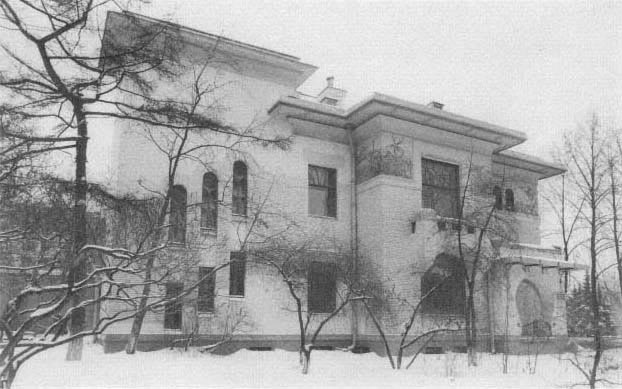
Fig. 136.
Stepan Riabushinskii house, Moscow. 1900–1902. Fedor Shekhtel. Side facade (Brumfield M169-11).
enclosed yard (Fig. 136). In each case the molded concrete is the antithesis of the rectilinear basic structure. This is particularly evident in the arched openings of the side porch adjacent to the dining room (see Plate 16). The front porch also exploits the plasticity of the material in a rusticated treatment that suggests the entrance to a cave or grotto. The suggestion is not accidental, for the aquatic theme (as in the fish-scale pattern in wrought iron) continues on the great mahogany door, with its brass lotus pattern in the block style of the Secession.
This theme re-emerges in the vestibule, where the mosaic ripple pattern of the floor suggests a shallow pool. The walls, scored like those of the porch, are painted pale green in the central area of the house; but within this submarine ambience are areas of brilliant color, as in the large stained glass panels flanking the passage from the vestibule to the hall (Fig. 137). These panels, now hidden by cabinets, represent the diaphanous wings of a dragonfly, its form outlined in wrought iron, its craning neck culminating in a "head" of rough crystal (since replaced by an ordinary frosted-glass globe).[22]
This display of the grotesque conveys the impression of an unbalanced world, although there is no reason to link the impression to Stepan Riabushinskii. Indeed, the socio-cultural implications coexist with the sheer inventiveness of contrasting material, texture, and color. The simplicity of mahogany and brass on the pale walls (where every detail bespeaks Shekhtel's design) provides a setting for brilliant decorative work, as did the simple detailing of the exterior brick walls. An additional stained glass panel in the hall—above the large mirror facing the entrance—portrays a stylized landscape devoid of human figures.
The essence of Shekhtel's centralized plan for the Riabushinskii house is the space created for the central stairway, beyond the stained glass panel. Although most of the rooms open onto this central space, each room also communicates with those adjacent to it; every element is integrated in a plan that extends from the central core and ultimately shapes the exterior (Fig. 138). Shekhtel's plan represents a concept of structure—from interior to exterior—characteristic of the style mod-
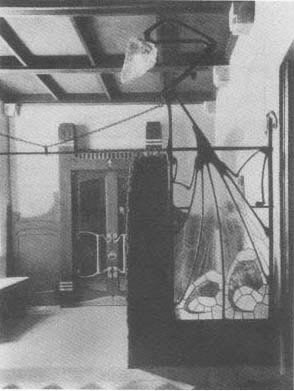
Fig. 137.
Riabushinskii house, vestibule.
Photograph ca. 1903.
erne. But another source of inspiration originated in the form of the medieval Russian church. Like the Riabushinskii house, the church structure developed from a central core: the main drum and cupola, supported by four piers. In the traditional plan, the length and width of the aisles (the arms of the cross) derived from the dimensions of the center space; all other components, from interior to exterior, followed therefrom. And just as the windows of the main drum lighted the central area of the church, a pitched skylight (visible from the exterior) and a large stained glass window illuminated the center of the Riabushinskii house.
Like Viktor Vasnetsov, who in the Abramtsevo church reinterpreted the structural logic of the early medieval church, Shekhtel himself created a centralized plan combining the moderne and the medieval, leaving exposed two columns extending upward through the core space in an allusion to the piers of the church. Although references to medieval architecture are highly abstracted in this secular environment, Stepan Riabushinskii housed his icon collection in this setting, with
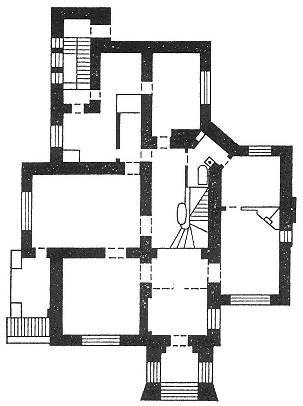
Fig. 138.
Riabushinskii house, plan.
its contemporary "decadent" motifs. This contrast between the religious and the secular was resolved elsewhere in the house (see pp. 136–39).
For the main part of the interior, Shekhtel turned to the extravagant and the grotesque, as he had in designing the house for Zinaida Morozova. Again his approach to decoration was comprehensive, as he applied the arts of wood, fabric, stained glass, plaster, brass, wrought iron, and wall painting in modern ways that were nonetheless related to the Russian crafts tradition. Although his designs suggest isolated similarities to sources as diverse as Mackintosh, Hoffman, Olbrich, Eugène Gaillard, and Louis Majorelle (in the wood veneer with marquetry), Horta and Tiffany (in the stained glass), and August Endell, Shekhtel's application of the decorative arts remained highly idiosyncratic.
Nowhere is the idiosyncrasy more obvious than in the design of the central stairway (see Plate 17). The stairwell is lit dramatically by natural and electric sources, each with its own theatrical effect. The stained glass window at the back corner of the stairwell, where two
walls intersect, extends the full height of the structure, although the glass panels are in three segments. The largest rises from the middle landing to the ceiling; in it a spiral or conch surrounds a light-colored center of frothy bubbles (see Plate 18). By filtering the light for the central part of the house through this screen, Shekhtel created here the most convincing impression of a submarine environment in the house. (The light is doubly filtered, since the architect placed a passageway between the stained glass panel and the exterior window that admits the light.) Riabushinskii, it seems, wished to surround himself with a sea kingdom comparable to the one brilliantly portrayed in contemporary stage sets for Rimskii-Korsakov's opera Sadko (1896), whose hero obtains fabulous wealth after descending to the realm of the Sea King. Both patron and architect would have been familiar with the contents and the staging of this opera, which premiered in Moscow in January 1898.[23]
The elaborate stagecraft of the stairwell extends to the main source of electric light—and the balustrade to which it is attached. The balustrade is in every sense the centerpiece of Shekhtel's structure, dominating the core space and marking the ascent of the dogleg staircase from the first floor to the middle level (where there is an alcove) and the second floor (see Plates 19, 20). Its sinuous mass is composed of an aggregate known in Russian as artificial marble; more precisely, it is a type of gray terrazzo—cast concrete mixed with marble and granite fragments and polished to a high gloss. (Russian architectural journals of the period contain frequent references to this material under the trade names Scagliola and Terrazzino.)
Shekhtel contained the descent of the frozen wave in a twisting surge that provides a column for a Tiffanystyle lamp, whose light bulbs are placed within stalactitic or medusan tentacles (Fig. 139). The effect here, like that of much art nouveau decoration, is baroque; but the massiveness is atypical of art nouveau—as is evident in a comparison of the balustrade with what could be its prototype: August Endell's delicate wroughtiron stairway in the vestibule of the Atelier Elvira (Munich, 1897–1898; not extant).
At the top of the stairway, the grotesquerie culminates in a polished red column capped by a bronze capital swarming with reptilian forms (see Plate 18). Despite the decadent ornamental touch, the column emphasizes the structural purpose of the core space, supporting and giving shape to the building at its central point. But both the arched opening supported by the column (an opening that faces the central "court" of the structure) and the design of the capital, whose grotesque ornament bears comparison with that on late Romanesque capitals in France, also suggest a cloister. With this column and the large stained glass window, Shekhtel refers to the medieval art of Western Europe, just as his centralized structure is related to the Russian medieval heritage.
By comparison with the central space, the individual rooms are considerably less dramatic, although Shekhtel was attentive to their details and materials. Indeed, the luxury of his materials (wood, fabric, brass) is most obvious in intimate rooms such as the library and the study. There is no attempt to create a grand room. Each space is ultimately subordinate to the central area, which is readily at hand yet can easily be excluded. The largest space is the dining room, the only room with a door to the outside—it leads to the garden at the side of the house.
The dining room is a modest version of the banquet hall Shekhtel had created for the Morozovs—with oak wainscoting and simple furniture (Fig. 140). But caprice and fantasy are also at work here: in addition to strips of plaster swirls on the ceiling and curved ironwork over the window, the room originally had as its centerpiece a large white scagliola mantel portraying a dragonfly nymph. The adjoining library, while smaller, displays greater luxury, with walls covered in silk brocade and extensive marquetry in the door panels. The ceiling (Fig. 141), in another of Shekhtel's elaborate conceits, resembles the surface of a pond, with its undulating plaster aquatic plants and large marine snails along the border. The centerpiece of the ceiling is a cartouche of yellow daisies on an azure background. Although the other rooms are generally more restrained in their decoration, all are scrupulously crafted.
One area of the house, however, exists apart, both aesthetically and physically, from this interrelated system of private rooms and open common space. At the back corner is a square tower at whose base is an entrance to the house. The stairway in the tower, marked by ascending windows (see Fig. 136), leads to an area above the second floor and secluded from the rest of the structure. Although this space has been modified since the beginning of the century, enough remains (or has been restored) to reveal it as the family chapel and to define its place in Shekhtel's design.
The Riabushinskii family adhered to the Old Belief, whose role in Russian architecture at the beginning of the century is noted in chapter 3. Frequently persecuted,
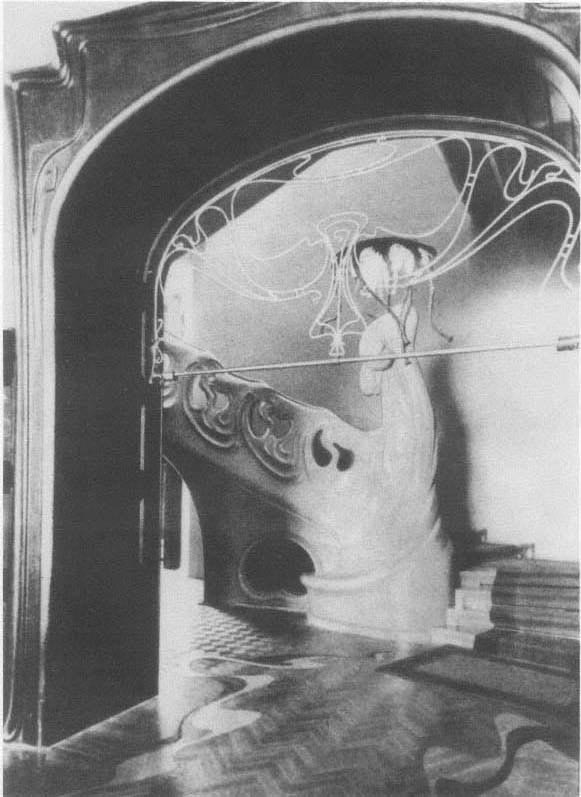
Fig. 139.
Riabushinskii house, stairway, lamp (view from dining room).
Photograph ca. 1903.
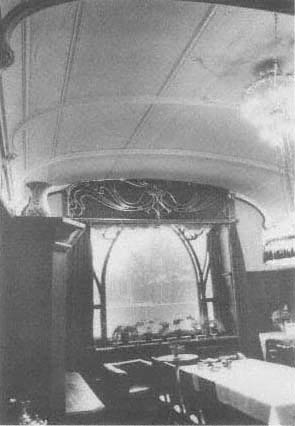
Fig. 140.
Riabushinskii house, dining room (Brumfield M135-15).
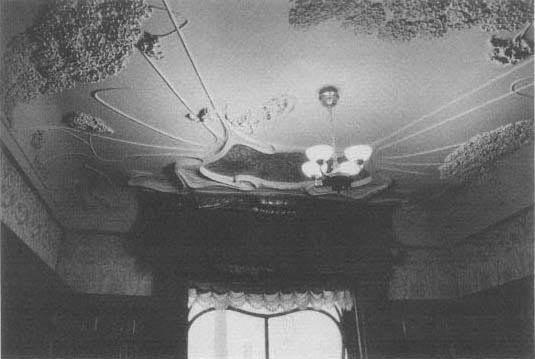
Fig. 141.
Riabushinskii house, library (Brumfield M135-11). Light fixture is not the original.
Old Believers maintained a strong sense of solidarity that characterized their business as well as religious communities; but in addition to this deeply conservative attitude toward matters of faith, Old Believers were known for their reverent and knowledgeable preservation of religious art, primarily medieval Russian icons. Stepan Riabushinskii's dedication to collecting icons—for aesthetic as well as religious reasons—would have been close to Shekhtel's own interests. Nonetheless, the general design and "iconography" of the Riabushinskii house are secular, albeit with touches of symbolist otherworldliness.
While the living quarters of the house incorporated the latest in contemporary design, the chapel served as the repository of traditional religious values. Shekhtel created a visual effect based on the colors of early medieval icons, using bright red for the pendentives and gilt work for the interior of the dome (which supports a small lantern-skylight). Because of its modest proportions, the entire chapel glows with the brilliance of the dome and pendentives, which are decorated with the traditional allegorical depictions of the four Evangelists (see Plate 21). Light enters both through the lantern and through three narrow windows reminiscent of the earliest Russian church architecture. The windows, on the eastern side of the chapel, are slightly recessed from the arch and pendentives, providing enough space for a small altar behind the icon screen required by Orthodox usage. No photographs of the screen were published, but a 1904 report in Zodchii on the architecture and arts exhibit in Moscow referred to the display of a carved iconostasis designed by Shekhtel for an Old Believer chapel in the Riabushinskii house.[24]
The walls beneath the dome combine traditional and contemporary elements, including the stylized towel motif typically used on the lower portion of church walls. The contemporary is most apparent in the black tendril pattern on the dark green walls and on the gold intrados of the chapel's two arches (Fig. 142). Although derived from the grape-cluster motif on the extrados of the same arches, with its religious connotations of the Eucharist and the parable of the laborers in the vineyard, the tendril pattern also resembles ornamental backgrounds in the paintings of Gustav Klimt, suggesting Shekhtel's fluency in interpreting traditional motifs and symbols in the new aesthetic idiom.
The secular and the religious elements combined in the Riabushinskii house reflect the culture of the entire family, but particularly of Stepan Pavlovich. The family's wealth testified to its skill in modern commercial methods, and the political views espoused by Vladimir and Pavel Riabushinskii later in the decade made clear their expectation that a capitalist economic order would lead Russia into the modern age.[25] At the same time, the Old Believer heritage remained central to their personal identity, both public and private. The chapel, like Stepan Riabushinskii's collection of icons, revealed his aesthetic values and reaffirmed his commitment to a set of religious beliefs that retained their vital force.
Nonetheless, the peculiar conditions of Russia's social transformation at the beginning of the century nurtured an impulse toward radical innovation; and Moscow entrepreneurs like the Riabushinskiis could declare their status and independence in displays of new and contemporary art, however outré. (The life of Stepan's brother Nikolai offers an extreme example of such an ostentatious display.)[26] Although contemporary critics found fault with the house (the entrance porch and the large windows of the first floor, in particular, were described as inconvenient, tiresome, and illogical) they also noted the "boldness" and "courage" of Shekhtel's design,[27] qualities that would have appealed to the owner of the house, however conservative his cultural origins and religious allegiance. Remarkable by any standards of contemporary European modernism, the Riabushinskii house signaled a new era in Moscow architecture; yet it was only the first in a series of structures that ensured Shekhtel's position as a pioneer of modernism in Russia.
Although Shekhtel's next major project—initiated while the Riabushinskii house was still under construction—seems to have little in common with contemporary design, in it he continued to develop a coherent structure expressive of both function and the decorative arts. When the Russian government commissioned a series of pavilions for the 1901 Glasgow International Exhibition, Shekhtel turned to the traditional forms of Russian wooden architecture for the buildings housing exhibits on mining, forestry, and agriculture as well as for the central pavilion (Fig. 143). Despite its mundane intention to market Russian products in Great Britain, the Ministry of Finance exercised unusual aesthetic judgment in entrusting the design to an architect of "advanced" views and in generously supporting the project. In contrast to the eclectic structures elsewhere at the ex-
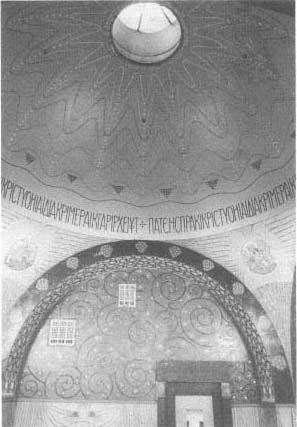
Fig. 142.
Riabushinskii house, chapel (Brumfield M135-0).
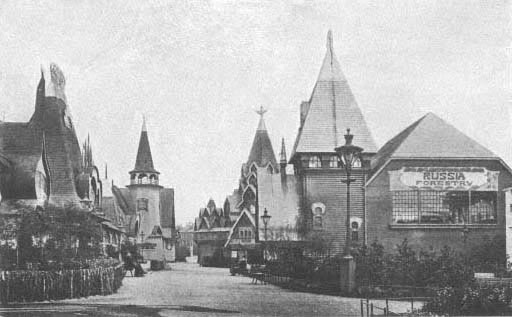
Fig. 143.
Russian section, 1901 Glasgow Exhibition. Fedor Shekhtel. Ezhegodnik Moskovskogo
arkhitekturnogo obshchestva , 1909.
hibition, the Russian pavilions created a strong—if not always favorable—impression with their bold silhouettes and polychromatic decoration.[28]
During the two years preceding the commission from the ministry Shekhtel's work had reached well beyond Moscow's business circles. The first issue of the illustrated journal Arkhitekturnye motivy contained his sketch for a chapel to commemorate the wedding of Nicholas II and Alexandra (see Fig. 133); the project's considerable size and Russian decor must have impressed the proper circles in St. Petersburg. Shekhtel had also designed a triumphal arch with a Gothic tower for the entrance of Their Imperial Highnesses to the 1896 Nizhni Novgorod exhibition, as well as a pavilion—modest, but decorated in the Russian Revival style—for the firm of Kharitonenko at the 1900 International Exposition in Paris.[29]
At Glasgow, the ministry provided Shekhtel with 30,000 rubles in construction funds and a skilled labor force of 210 peasant carpenters, supplemented by the six graduates of Moscow's prestigious Stroganov School of Technical Design who carried out Shekhtel's design for the ornamental painting.[30] The carpenters provide the key to the architect's intention: a modernized interpretation of native wooden structures, which are among the most ingenious forms of Russian architecture. By returning to the organic building material par excellence, Shekhtel continued the work of Hartman in the massive wooden structures for the 1872 Polytechnical Exhibit and Ropet in the designs at Abramtsevo.
Shekhtel had already designed a wooden theater for Sokolniki Park in Moscow, but it was austerely functional, unlike the picturesque Glasgow pavilions, based in part on wooden churches of the far north but in other respects wholly the product of Shekhtel's imagination. Around the central pavilion—the building closest to the traditional prototypes with its pyramidal silhouette and large tent roof—the rest of the Russian buildings were grouped (Fig. 144). Having stated the central motif of the Russian "village," Shekhtel freely interpreted the wooden structures of the other pavilions, with references to folk or traditional elements in both construction and decoration. The modernity of this interpretation appeared most striking in the agriculture pavilion; with its exaggerated contours and asymmetry, the building itself seems to have germinated (Fig. 145). The bulges and spires (which mask a conservative rectangular floor plan) can also be traced to some of the more inventive examples of wooden architecture in the far north: the roof tower over the central entrance of the side facade was decorated with a burst of arched forms and capped by a metallic "coxcomb," or crown, enclosing a large double-headed eagle in fretwork.
References to Russian traditional architecture on the smaller mining pavilion included the octagonal corner tower, reminiscent of the semidetached bell towers of large wooden churches (Fig. 146). The entrance porch veered toward parody with its enormous horseshoe- and barrel-shaped arches. Of all the pavilions, this one was closest in style to art nouveau. In contrast, the massive forestry pavilion incorporated ornament with greater restraint (Fig. 147). Apart from an entrance tower with a pyramidal roof and a few decorative bochka (barrel) gables, the exterior form of the building followed the interior plan. For the large panel that identified the pavilion Shekhtel designed a painted border of conifers and three gargantuan mushrooms, symbolizing the wealth of Russia's forests.
Indeed, all the pavilions displayed vivid polychrome in their carved and molded details and their facades. According to contemporary British accounts, the agricultural pavilion was painted "pale green and salmon," with red shingles, and the central pavilion was painted salmon, with brown shingles.[31] Three pavilions had plank siding; the forestry pavilion, however, was constructed of notched, unplaned logs assembled in the time-honored Russian fashion by the peasant carpenters. This log pavilion (painted light brown) gave exhibit visitors a firsthand look at the ingenuity and artistry of Russian wooden architecture.
The mining and agricultural pavilions used minerals and plant forms for decorative effects more modestly than the forestry pavilion used its logs, though these other pavilions had caps of brilliant sheet metal (gilded zinc, aluminum) on their towers and on many of their pitched roofs. The entire project took seven months to complete and required four supervisory visits from Shekhtel.[32] Although the critical notices were mixed and the critics occasionally uninformed about the architect's identity, Shekhtel's work did not go unrecognized: the Royal Institute of British Architects made him an honorary member, and in Russia he attained the rank of Academician of Architecture.[33]
In addition, the Glasgow Exhibition must have given Shekhtel the opportunity to see the work of Charles Rennie Mackintosh. Although Mackintosh was not chosen as one of the exhibition architects, Shekhtel surely knew of his work by 1901; and on his journeys to Glasgow
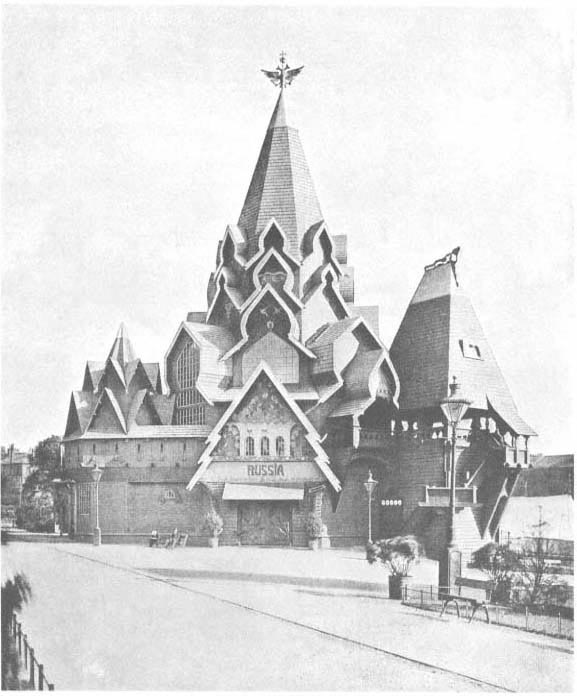
Fig. 144.
Central pavilion, Russian section, 1901 Glasgow Exhibition. Fedor Shekhtel. Ezhegodnik Moskovskogo
arkhitekturnogo obshchestva , 1909.
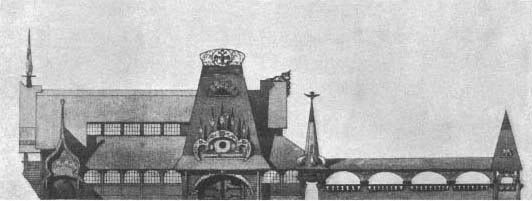
Fig. 145.
Sketch of agricultural pavilion, Russian section, 1901 Glasgow Exhibition. Fedor Shekhtel. Ezhegodnik
Moskovskogo arkhitekturnogo obshchestva , 1909.
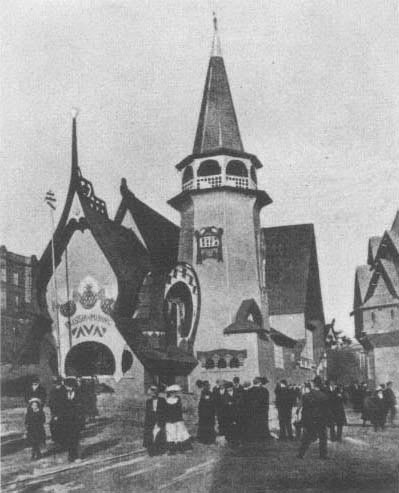
Fig. 146.
Mining pavilion, Russian section, 1901 Glasgow Exhibition. Fedor Shekhtel.
Zodchii , 1902.
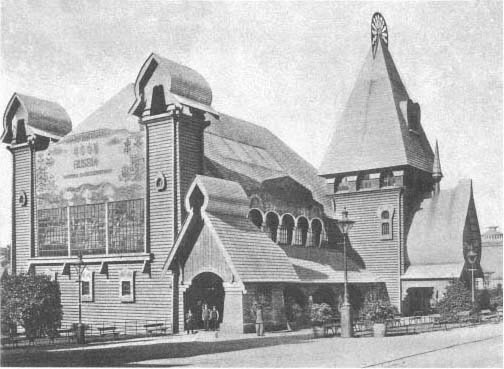
Fig. 147.
Forestry pavilion, Russian section, 1901 Glasgow Exhibition. Fedor Shekhtel. Ezhegodnik
Moskovskogo arkhitekturnogo obshchestva , 1909.
he would probably have visited the recently completed Glasgow School of Art (1897–1899), Mackintosh's most notable building in that city. The effects of Shekhtel's acquaintance with Mackintosh's work soon appeared in Moscow: Mackintosh's furniture figured prominently in the exhibit "Architecture and Artistic Crafts of the New Style," co-organized by Shekhtel at the end of 1902; and Mackintosh's spirit pervaded the architecture and interior design of another of Shekhtel's modernist experiments—the house of Aleksandra Derozhinskaia.
It is a mark of Shekhtel's diverse approach to the new style that the Riabushinskii and Derozhinskaia houses should appear to have so little in common, although the dates of their construction overlap. The Derozhinskaia house was built in 1901, while work on the interior of the Riabushinskii mansion apparently continued through 1902—a disproportion in construction times that reflects differing approaches to design: in the Riabushinskii house an elaborate display of the decorative arts and in the Derozhinskaia house a rejection of such decoration in favor of monumental mass and space (Fig. 148). Nonetheless, the Derozhinskaia house has carefully worked details, such as a wrought-iron railing (with a rotating triangle motif also used frequently for the interior design) and the glazed green brickwork of the facade, which in both houses is carefully integrated with the window transoms and the massive concrete cornice.
Here, instead of the ceramic frieze and capricious window designs of the Riabushinskii house, Shekhtel massed the structural elements and volumes at a central point with a minimum of decoration. The main window, which extends to the cornice line of the two-storied structure, indicates a proportional system for the house and, as it projects from the facade, serves as a triumphal arch. This central part of the house culminates in two concrete cylinders joined by ferroconcrete over a window strip that suggests, with perhaps unintended symbolism, the fortifications and gun emplacements of the machine age.
As at the Riabushinskii house, the plan evolves
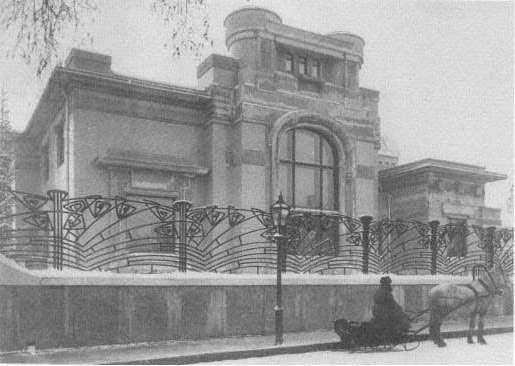
Fig. 148.
Derozhinskaia house, Moscow. 1901. Fedor Shekhtel.
Photograph ca. 1902.
around a structural core. For this purpose Shekhtel replaced the grand stairway of the earlier house with a two-storied main hall behind the center of the facade, creating one of the most heroic spaces in Russian domestic architecture of any period (Figs. 149, 150). (The hall measures 12.6 by 10.7 meters and is 11.2 meters high.) A Soviet specialist has described it as "the concluding chord of a heroic symphony in the spirit of Scriabin's Poem of Ecstasy ," and yet this room also shows exquisitely crafted details (see Plate 22).[34]
The vast hall and the wainscoting, of suitably heroic proportions, display the simplicity of the Scottish baronial style without the decorative extravagance that had marked Shekhtel's earlier work for the Morozovs. The fireplace, opposite the main window, is flanked by a male and a female torso in scagliola—melancholy captive figures that suggest the turmoil of the subconscious in Chekhov's final plays (Fig. 151). The fireplace mantel, with its panel of deeply incised trunks and foliage, resembles a similar motif on the corners of Olbrich's Secession Building, and the intricate lighting fixtures suspended from the ceiling are also similar to Olbrich's designs.
Similarities to Mackintosh's work emerge more clearly in other, smaller, rooms, where the integration of furniture and design becomes apparent (Figs. 152, 153). Like Mackintosh, Shekhtel took seriously the relation between the decorative arts and architecture; although the details of his furnishings for the Derozhinskaia house are not comparable to those of the Glasgow school, similar principles informed the work. The design and placement of furniture clarified architectural space rather than filled it. The colors and patterns of fabric and furniture—designed by Shekhtel—enhanced the architect's concept of the complete aesthetic environment (Figs. 154, 155).[35] Such a totality of vision required a large area so that the architect's furniture would not impede either the perception of ensemble and space or the use of the room. The Derozhinskaia mansion, unlike the Riabushinskii house, with its undistinguished furnishings, contained a series of comprehensively designed spaces (see Plate 23). The more compact design of the
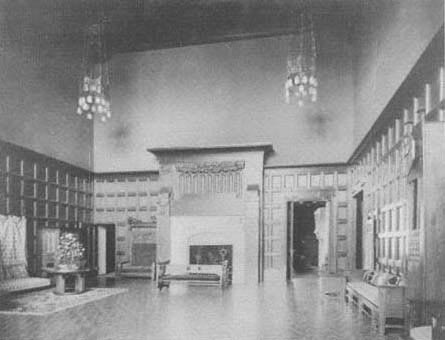
Fig. 149.
Derozhinskaia house, main hall.
Photograph ca. 1902.
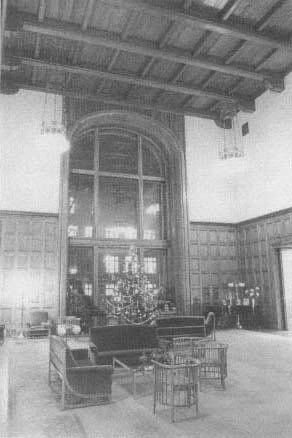
Fig. 150.
Derozhinskaia house, main hall (Brumfield M165-24).
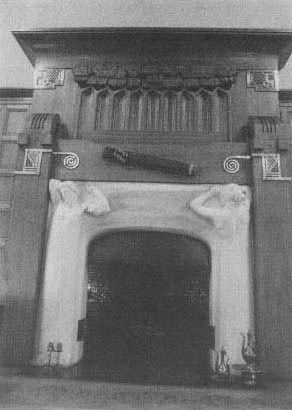
Fig. 151.
Derozhinskaia house, main hall, fireplace (Brumfield
M165-37).

Fig. 152.
Derozhinskaia house, dining room.
Photograph ca. 1902.
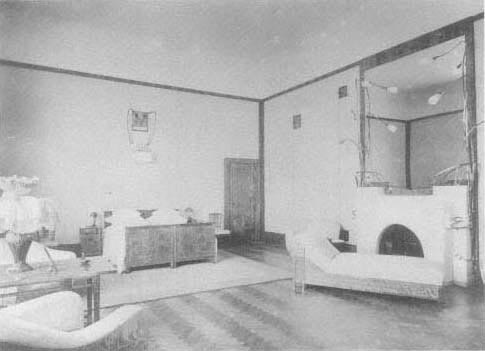
Fig. 153.
Derozhinskaia house, master bedroom.
Photograph ca. 1902.
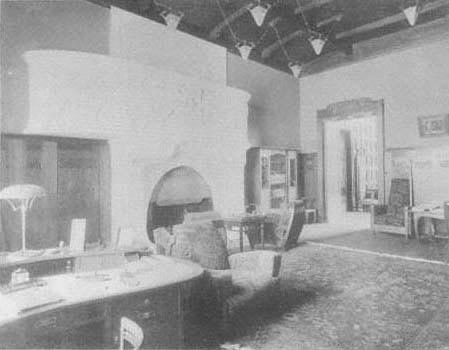
Fig. 154.
Derozhinskaia house, study.
Photograph ca. 1902.
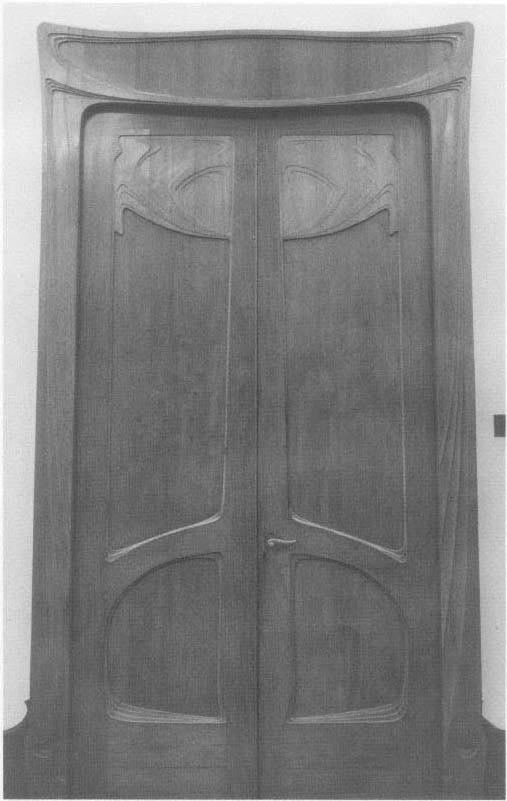
Fig. 155.
Derozhinskaia house, door to library (Brumfield M166-6).
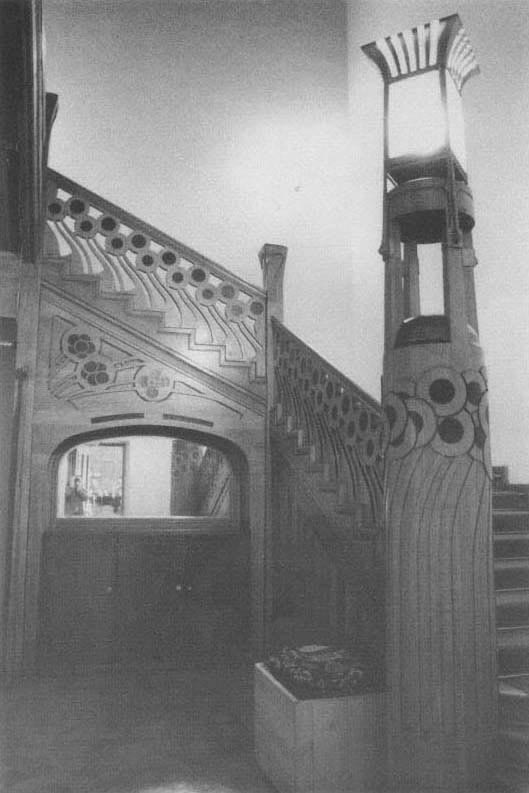
Fig. 156.
Derozhinskaia house, main stairway (Brumfield M165-19).
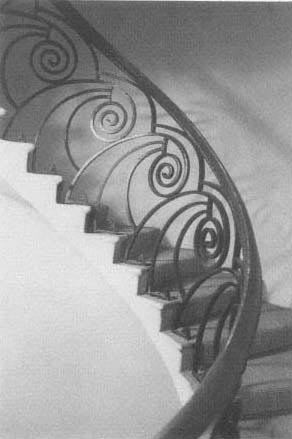
Fig. 157.
Derozhinskaia house, spiral stairway. (Brumfield
M165-28).
Riabushinskii rooms, arranged around the central stairway, did not encourage such a development; nor, paradoxically, did its exuberant decoration, which directed attention to the walls and ceiling.
From the smaller decorative details in brass, iron, fabric, wood, or wall painting to the major structural units, the houses display parallel ideas differently interpreted. In addition to its great hall, the Derozhinskaia house has a central staircase that unites the living areas around a central core. Although the carved oak stairway of this house contrasts with the plasticity of that in the Riabushinskii house, Shekhtel created a counterpart to the cascading effect of the Riabushinskii balustrade in the wave pattern of the carved balusters (Fig. 156). The large newel post to which the light fixture is attached repeats the wave as well as the tree motif that appears throughout the paneled interior of the house.
In all, the house has three staircases, each designed with attention to detail and each leading to separate groups of rooms (Fig. 157). In the main living quarters on the second floor, for example, an interior corridor links three of the rooms at the rear of the house, creating a private environment. The complexity of this plan—rumored to mirror the complex social relations of the inhabitants—tends to obscure the logic that operated so clearly in the houses for Zinaida Morozova and Stepan Riabushinskii. Yet Shekhtel created a new center in the great hall, whose five doors and magisterial proportions brought together the disparate elements of the house and provided an area suitable for entertainment on a grand scale.[36] So large, in fact, is the hall that it resembles public space in a domestic setting—not inappropriate, in view of Shekhtel's design, the following year, of the Iaroslavl Railway Station and the interior of the Moscow Art Theater.
Like most of Shekhtel's sponsors, the Moscow Art Theater had connections with the city's merchant elite, not only through its director, Konstantin Stainslavskii,
but also in the person of Savva Morozov. After the success of The Sea Gull at its Moscow premiere, Morozov ensured the company's financial stability in 1899 by contributing large amounts of money and persuading other stockholders of this private company to do the same. With the further triumph of Chekhov's plays and other productions in the repertoire, the theater required a larger, more technically advanced space.
Shekhtel was the logical choice as architect. He was well known to Morozov, whose magnificent house he had designed; his recent accomplishments had established his reputation as an architect at the height of his creative powers; he had known and corresponded with Chekhov since the 1880s; he had demonstrated his own devotion to the theater from his apprenticeship in the 1880s to his design of people's theaters (see Fig. 128) at the turn of the century. Shekhtel also understood the complex technical requirements involved in building for a theatrical group dedicated to innovation and high production standards.
Shekhtel was able to accommodate a large revolving stage that represented the latest in technology and also provided a spacious support area for members of the company. In both endeavors he clearly had Morozov's active support. Stanislavskii noted in his memoirs that "Morozov spared no expenses for the stage and its paraphernalia, for the dressing rooms of the actors. . . . He lavished special love on the stage and its lighting."[37]
Shekhtel's accomplishment, however, is all the more remarkable in that he began with an existing structure. Morozov's generosity had its limits, and the most economical plan involved remodeling a building that dated back to the beginning of the nineteenth century, when it was a private mansion. Subsequently rebuilt and expanded into an apartment house (1852), the structure was remodeled in 1880 as the Liazonov Theater according to a design by the architect Mikhail Chichagov, author of the Korsh Theater in the same neighborhood as well as several other theaters for the impresario Mikhail Lentovskii, with whom Shekhtel had worked as a young designer.[38] By keeping the foyer small, Shekhtel managed to increase seating to thirteen hundred and to install the large stage without substantially changing the walls of the previous theater.
Shekhtel's approach can be attributed to his limited budget (he refused to accept a fee for his own work at the theater); but his decorative scheme was also appropriate to the spirit of the Art Theater ensemble—from the patterned designs to the choice of color and material. Here a comparison with Mackintosh's work is especially apposite—with the interior of private homes such as Windyhill (1899–1901) and with public spaces such as the Buchanan Street Tea Room (1897–1898), for which Mackintosh designed murals.[39] Most prominent among the abstracted geometric patterns of the interior is Shekhtel's seagull design, which appears on the walls of the foyer and serves as the emblem of the Moscow Art Theater. The calculated effect of Shekhtel's designs in preparing the audience for the performances of the theater must be considered a significant innovation in his work. Rather than draw attention to the seating area, the design focuses attention on the stage through the sweeping contours of the balconies and the modernistic pattern of lines extending from the ceiling to the simple theater walls.
Stanislavskii's description of the interior reveals that he understood and appreciated this understated approach:
A high wooden panel with cloth in frames; above the panel portraits of great writers, poets, actors, and artists; along the panel wooden benches with cushions, white walls with a slightly dark border—that was the foyer, simple, modest, without one spot of color. The auditorium was finished in seasoned oak and the balustrades of the boxes and balconies, the furniture, the doors, the embrasures and panels were made of the same wood. The walls were also white, with hardly noticeable borders, without any bright spots or gilding. All the other rooms for the use of the audience were finished in the same style. This was done so as not to tire those sitting in the auditorium and to save all the color spots and effects for the stage.[40]
(This description suggests a similarity between Shekhtel's work at the theater and his restrained interior design at the Derozhinskaia house.)
Although a lack of funds after the completion of the interior prevented the rebuilding of the facade specified by Shekhtel (Fig. 158), the details of the windows and doors and the wrought-iron lanterns and brackets show his usual care and mastery. The lantern design has itself become a symbol of the theater. In addition, Anna Golubkina's stucco relief The Wave billows over and around the entrance on the right side (each of the three doorways—left, center, and right—is protected by a simple glass and iron awning). The fragments of the human torso and faces emerging from the chaos symbolize captivity and struggle in a more dynamic form than
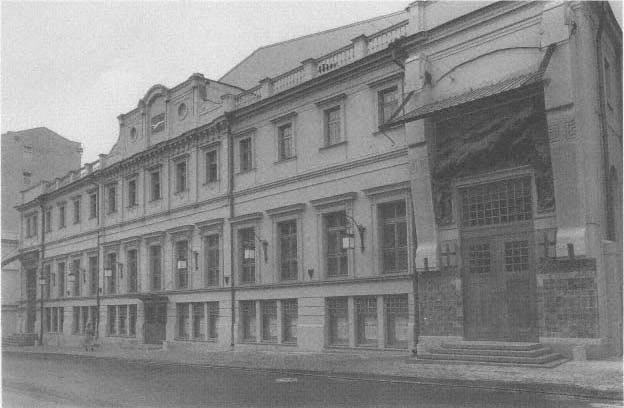
Fig. 158.
Moscow Art Theater. 1902. Fedor Shekhtel (Brumfield M171-19).
does the sculpted mantel of the Deroshinskaia house (see Fig. 151). Ceramic facing at the entrance (from the Abramtsevo workshop) contains the rotating triangle motif used throughout the Derozhinskaia house (see Plate 24).
The psychoanalytic connotations of The Wave are appropriate for a company whose critical reputation was founded on its interpretation of Chekhov's and Ibsen's plays. Moreover, the exterior lantern brackets and the decorative strip along the top of the foyer walls echo the wave motif, as does the decorative line pattern over the proscenium. Indeed, that pattern suggests another elemental force related to developments at the turn of the century that affected the theater itself. In describing Morozov's efforts on behalf of the ensemble, Stanislavskii noted that Morozov was fascinated with electrical lighting—to the point of turning parts of the magnificent house Shekhtel had built for him into an electrical workshop.[41] As a result, the Moscow Art Theater was at the forefront in using electric stage lighting, and Shekhtel's design of the light fixtures for the theater reflects his interest in the electric lamp as a modern art form. Within this context the linear geometric patterns leading to the stage from both the ceiling and the walls suggest not only a surging but also a conduit of energy hovering over the proscenium.
Shekhtel's other major project of 1902, the Iaroslavl Railway Station, shows little of the abstract, modern style of design characteristic of the Derozhinskaia house and the Moscow Art Theater. The building is linked, however, to the Russian pavilions at Glasgow, both in form and in decoration. The station, like the theater project, involved rebuilding an existing structure, in this instance the terminus of the Moscow-Iaroslavl Railway (1859–1862), designed by Roman Kuzmin. The occasion for expanding an existing station was the extension of the Iaroslavl line to Arkhangelsk and the acquisition of virtually every other major northeastern rail line to form a vast, if sparsely developed, network that promised access to the region's great natural resources.
The architect of this capitalist venture was Savva Mamontov, whose community at Abramtsevo had such far-reaching ramifications for Russian art and architecture. By the time Shekhtel began work on the station, Mamontov no longer controlled the railway, for his attempt to extricate himself from financial difficulties had led to economic collapse and to his arrest in September 1899 on charges of illegal financial transactions.[42] His acquittal in 1900 did not restore his fortune; but the railway network he had created retained its importance, and the Moscow-Iaroslavl line, the route north, required a suitably imposing terminal at Moscow's major concentration of stations on Kanchalevskii Square.
Although Shekhtel had never worked with Mamontov, he was well prepared for this major commission by his work at home and abroad. Indeed, the work abroad may have significantly influenced the project: Shekhtel's Glasgow pavilions, with their wooden architectural forms of the far north, anticipated the Russian motifs re-created in masonry at the Iaroslavl Station (Fig. 159).[43] The roof tower with its decorative crown over the main entrance closely resembles the entrance of the agricultural pavilion at Glasgow, as do the station's plasticity of form and its polychromatic building materials (wood, brick, and tiles) and ornamentation (see Plate 25).
Shekhtel's "neo-Russian" architectural style can be related to wooden prototypes, but the towers at each corner of the station are modeled more directly on brick kremlin and monastery walls, as is evident from the machicolation of the right corner tower. Both Moscow and Iaroslavl, key points in this railway network, are rich in such forms, and Shekhtel's free interpretation of them evokes the picturesque asymmetry of medieval architecture (Fig. 160). A brief report in the first issue of Zodchii for 1905 referred to the symbolism of the recently completed station and its decorative elements:
This railroad, connecting Moscow with the north of Russia, itself determined the style of the facade; a northern Russian character was considered most appropriate for the new reconstruction. The larger part of the facade is faced in gray brick. Under the main tower is a relief portraying St. George the Dragon Slayer, the Archangel Michael, and a bear with a poleax—the emblems of Moscow, Arkhangelsk, and Iaroslavl. All other decorations are of colored majolica tiles prepared according to designs by Academician F. O. Shekhtel at the Abramtsevo workshop of S. I. Mamontov. The left corner tower contains a water cistern. In the main waiting room on the level of the frieze there will be panels by the artist K. A. Korovin that portray scenes of the northern region.[44]
In homage to Savva Mamontov, this account notes Shekhtel's use of the Abramtsevo workshop for the ceramic tiles used in the green and brown frieze along the main facade and in ceramic panels beneath windows on the main and side facades (see Plate 26). Both the frieze and the gray brick facade merge into the massive towers on either side of the main entrance, at which point the decorative possibilities of ceramic, stucco, and iron are explored with careful attention to texture and symbolism. Although some of the decoration was changed in a postwar renovation of the building (the stucco emblems of the cities above the main entrance were substantially modified), the polychrome tiles and much of the stucco work remain as Shekhtel designed them.
Shekhtel's most playful facade ornaments are the floral motifs in plaster and ceramic, such as the wild strawberries in the ceramic frieze flanking the entrance (Fig. 161), and the stylized folk-art conifer pattern on the left tower. These elements, like the mushrooms painted on the forestry pavilion at Glasgow, symbolize the richness and beauty of the northern forests. Northern fauna—wolves, polar bears, cormorants spearing fish, and reindeer—are also used ornamentally. In re-creating these animal forms in white stucco, Shekhtel appears to have borrowed from Konstantin Korovin's Pavilion of the Far North (see Fig. 45) at the 1896 Nizhni Novgorod exposition, on which polar bears and reindeer are represented in white stucco and wood. The white stucco suggests the snowy northern landscape, but some of the representations also allude to the intricate bone carving of native artisans. In the Korovin pavilion this allusion is particularly evident in the reindeer pattern of the porch railing; in the Iaroslavl Station it reappears in the antler motif on the side towers.
Korovin in fact provided the painted panels for the decorative frieze inside the station, which were originally displayed in the Pavilion of the Far North, supported by Savva Mamontov (an enlightened expression of his interests in that region).[45] Thus all roads ultimately return to Abramtsevo: to its workshops; its artists, who contributed so much to the new art and architecture at the turn of the century; and its patron, who,
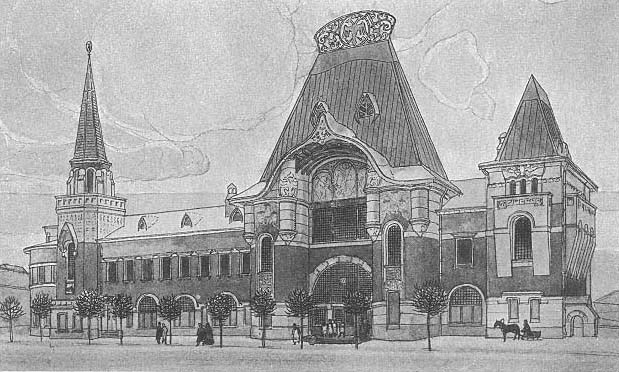
Fig. 159.
Sketch for Iaroslavl Railway Station, Moscow. 1902. Fedor Shekhtel. Ezhegodnik Obshchestva
arkhitektorov-khudozhnikov , 1906.
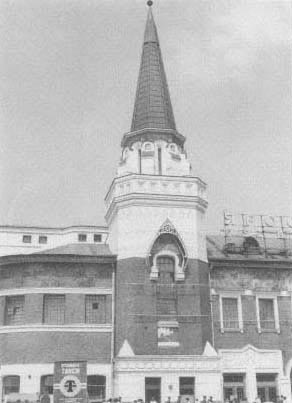
Fig. 160.
Iaroslavl Railway Station, left tower (Brumfield M101-10).
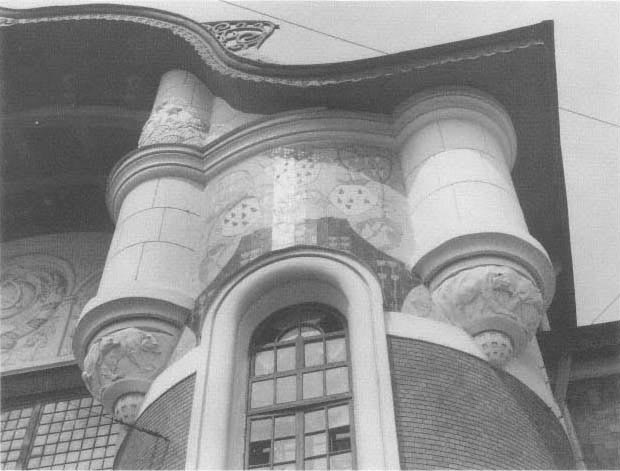
Fig. 161.
Iaroslavl Railway Station, main entrance, detail (Brumfield M101-3).
after losing his fortune, continued to participate in the Abramtsevo crafts movement.
The spirit of Abramtsevo that suffuses this station and other projects in the same style, however, is most truly represented by Viktor Vasnetsov, whom Shekhtel called his teacher in a letter written during the early stages of work on the Iaroslavl Station.[46] It is fitting that Vasnetsov should have been involved in a major architectural project of his own in Moscow at the beginning of the century Indeed, the Tretiakov Gallery and the Iaroslavl Station have much in common: both projects involved rebuilding an existing structure, both reinterpreted traditional Russian architecture and ornamentation (including the iconographic motif of St. George and the Dragon), and both used brick and ceramic tiles extensively for aesthetic as well as structural purposes.
Shekhtel turned to a different culture for one component of the station's main entrance. Travelers struggling with bundles and bags are unlikely to notice the great arched beams supporting the curved gable between the two entrance towers, but they play a significant part in shaping the central archway. Although at first glance they might resemble forms in traditional wooden structures, no exposed curved beams function as major supports in such Russian buildings. They do, however, serve this function in Japanese temple and palace architecture, in the traditional "rainbow" beam (koryo ) in early Buddhist temples and in the so-called Chinese gate (Karamon ) to the courtyard of Japanese feudal palaces.[47] The similarity of the Chinese gable (Karahafu ) to the arched gable of the Iaroslavl Station is all the more appropriate in that both define the major point of entry.
Such references to Japanese design were common in Europe at the turn of the century, especially in interior furnishings. Mackintosh used Japanese elements in his Glasgow School of Art as well as exposed beam-and-bracket systems that suggest Japanese provenance.[48] European exhibits of Japanese art and Russia's own expanding contacts with its Far Eastern neighbor and rival would have introduced Russian architects to these motifs. This stylistic connection extends to the main windows of the Iaroslavl Station, whose lattice grid is like that of the sliding screens (shoji ) of Japanese domestic architecture.
Unfortunately, virtually nothing remains of Shekhtel's design for the main vestibule. Photographs of the period show an open, functional space, brightly illuminated and modestly decorated with Korovin's panels, simple oak wainscoting a tile floor, and suspended light fixtures in the modern style.[49] In its general impression the interior suggests contemporary work by Josef Hoffmann, who enjoyed a considerable reputation in Russia and whose interior designs were illustrated in the Russian architectural press. Shekhtel, too, emphasized both decorative and functional components in developing a new aesthetic for commercial and public space; his main hall at the Iaroslavl Station resembles the interiors of his office buildings in Moscow after 1900.
The station was criticized as "facade architecture" (the same could be said of the Tretiakov Gallery). Zodchii , for example, misleadingly implied that Shekhtel could not be considered the author of the structure, since the old plan—with the exception of the vestibule—had remained intact during the construction of the main facade.[50] Whatever the technical validity of this claim, it overlooks the new space and new sense of structure created by merging international modernism and "neo-Russian" fantasy in the facade.
Fantasy, however, had little part in Shekhtel's urban, commercial architecture after 1900. His 1901 building for the Moscow Insurance Society on Old Square (behind the Kitai-Gorod wall) represents a turning point in his approach, a shift from Renaissance decoration in a facade dominated by the arch to an orthogonal grid framework (Fig. 162). Although the Insurance Society building—more commonly known as Boiars' Court, after the hotel located in it—uses familiar decorative devices from his previous buildings, rationalism predominates in its design.
The great horizontal sweep of the building, segmented by the verticals of narrow brick piers, suggests the Chicago school (the Carson Pirie Scott department store by Sullivan, for example), though without its technical innovations in structure. Despite the emphasis on the grid, skeletal construction was virtually unknown in Moscow before the revolution, and Shekhtel relied here—as throughout the decade—on construction with brick piers and reinforced concrete.[51] The piers are surfaced with green glazed bricks; the horizontal elements are yellow stucco.
In his later work Shekhtel largely avoided ornamenting his rational designs. Here, however, the massive Kitai-Gorod wall, parallel to the facade of Shekhtel's building, obscured the view of the lower three floors from the Old Square.[52] In this context the decoration and narrow window segments of the two upper floors provided a counterpoint to the crenellated wall, as did Shekhtel's central tower with attic (in the Secession style) that marked the main entrance and was paired with one of the ancient bastions. Now that the wall no longer exists, the entire building—its considerable length, the ground-floor arcade, the balconies, and the stuccowork—can be seen as a transitional episode in Shekhtel's movement toward a more functional interpretation of the style moderne.
The next step occurred in 1903 with the rebuilding of the Riabushinskii Brothers Bank, in the center of Moscow's financial district on Karuninskii Square (one block from the Upper Trading Rows). Pavel, Mikhail, and Vladimir Riabushinkii established the bank in 1901 to increase and diversify the income from their textile factories, and over the next decade they expanded banking operations to over a dozen cities. In redesigning the existing structure as the headquarters of the Riabushinskii financial concern, Shekhtel applied his usual construction technique, brick and reinforced concrete.
The result, however, is a radical departure from the Levenson Printing works or the Boiars' Court. In his commercial architecture Shekhtel had used plate glass in a masonry grid, but here the new structural methods are expressed without the ornament or tectonic illusionism of the ground-floor arcade of Boiars' Court or the heavy stonework of the Kuznetsov store.[53] The vertical and horizontal lines of the bank building define a precise four-storied grid of glass and brick, above which is a fifth story with narrow windows and a smooth stucco surface (Fig. 163). The only decorative concession, apart from modest garlands above the brick piers,
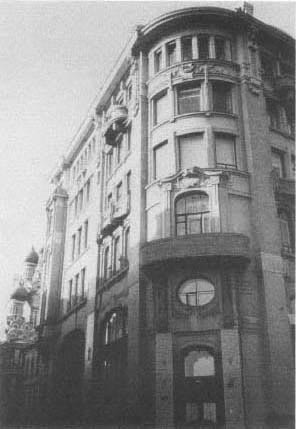
Fig. 162.
Moscow Insurance Society building (Boiars' Court).
1901. Fedor Shekhtel (Brumfield M-43).
is the use of off-white brick facing to highlight the contours of the facade. (This bank appeared several years before Adolf Loos's rejection of historicism and ornament in his 1910 building on Michaelerplatz in Vienna.)[54] Indeed, the modernism of the original Shekhtel design for the Riabushinskii bank has been obscured by later modifications (including A. V. Kuznetsov's addition of a sixth story in 1913) and by careless maintenance of the stucco facade on the upper stories.[55] Nonetheless, the building signifies a turn to rational, functional design and with it a decreasing reliance on the decorative aestheticism characteristic of the style moderne in Moscow.
Shekhtel did not, however, abandon the decorative arts in architecture, as is demonstrated by his construction in 1904 of an apartment house on Miasnitskaia Street for the Stroganov School of Technical Design. This structure combines the weight of unrendered brick walls with the delicacy of polychromatic decoration (Fig.
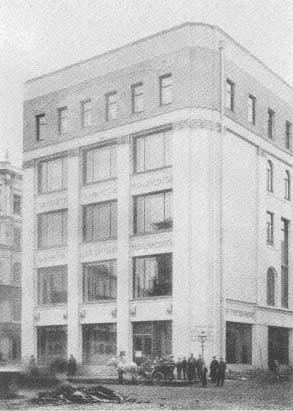
Fig. 163.
Riabushinskii Brothers Bank, Moscow. 1903. Fedor
Shekhtel. Ezhegodnik Obshchestva
arkhitektorov-khudozhnikov , 1906.
164). The light brown brick surface, skillfully applied, has not dimmed appreciably even after years of neglect. The decorative element shows most clearly in the ceramic tile panels near the corners of the main facade that extend from the lower balcony level to the cornice. On the panels are small vignettes of pastoral scenes and a larger pattern of ethereal rococo garlands and "vines" on a pale background. In a period of overblown decorative effects on the exterior of apartment buildings, Shekhtel designed housing for people of middle income, while indulging a chromatic fantasy comparable to that on the ceramic facades of contemporary Viennese apartments.
The facade, marked by a clear statement of vertical and horizontal lines, rests on a ground floor of reinforced concrete, which made technically feasible the large squares of plate glass for shop windows on the street level.[56] The inclusion of such amenities was not common in Moscow; retail commercial outlets were generally located in galleries and trading rows at the center of
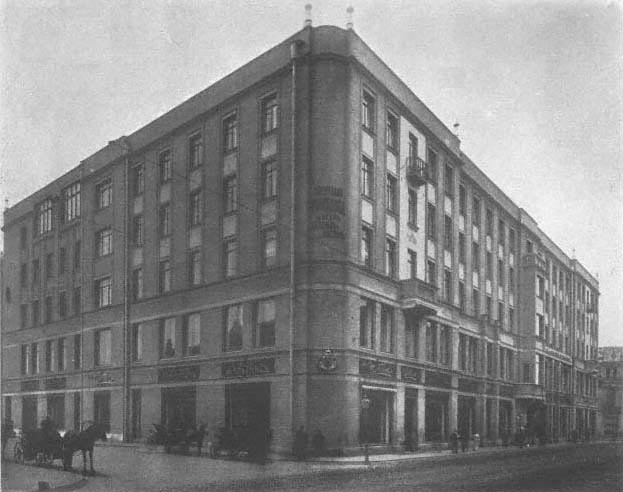
Fig. 164.
Stroganov School apartment house, Moscow. 1904. Fedor Shekhtel. Ezhegodnik Obshchestva
arkhitektorov-khudozhnikov , 1907.
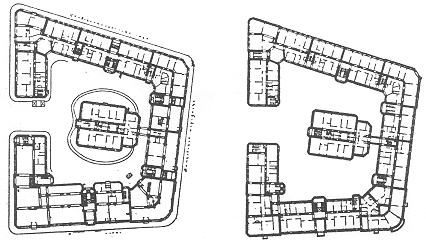
Fig. 165.
Stroganov School apartment house plan.
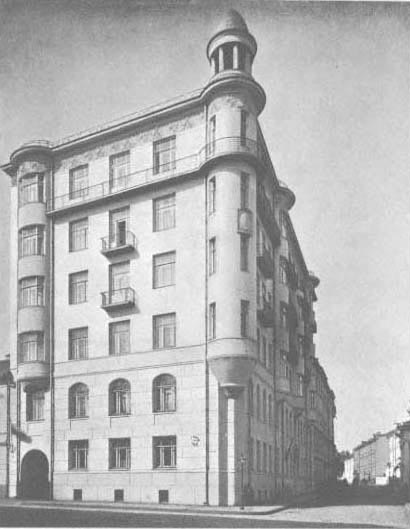
Fig. 166.
Shamshin apartment building, Moscow. 1909. Fedor Shekhtel. Ezhegodnik
Moskovskogo arkhitekturnogo obshchestva , 1910–1911.
the city. In addition to including shops (even a small clinic) in the building, Shekhtel devised a ground plan that solved the problem of enclosed courtyard space by creating a small park around a wing attached to the back of the main facade (Fig. 165). In this project Shekhtel was able to adopt a comprehensive approach to residential planning; the Stroganov School, with its emphasis on the decorative arts, proved an ideal patron for the rational aestheticism devised by Shekhtel—who also served on the school's faculty.
Shekhtel's only other venture in apartment construction occurred in 1909, when he designed a building for A. I. Shamshin on Znamenka Street (just west of the Kremlin).[57] Although the decorative elements in this project are few (they include an abstract cornice frieze and simple iron railings), Shekhtel exploited the location of the building—on the crest of a sharp incline—to dramatic effect. The smooth facade of light brick was molded at the corner of Znamenka and Little Znamenskii Lane to create a four-storied turret capped by a rotunda (Fig. 166). The castellated form of the Shamshin building is suited to the area near the Kremlin but is free of the decorative panoply of either historicism or the early moderne.[58]
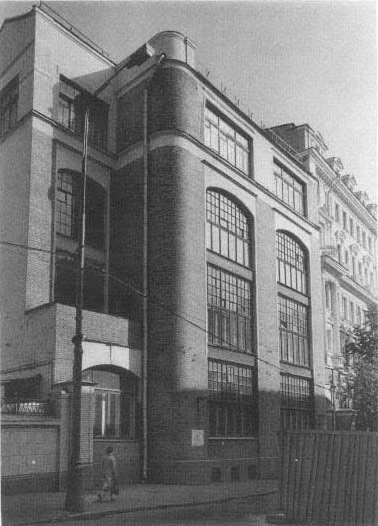
Fig. 167.
Utro Rossii printing office, Moscow. 1907. Fedor Shekhtel (Brumfield
M133-80).
The clearest expression of rationalism in Shekhtel's work occurs in two buildings constructed toward the end of the decade: the printing works of the newspaper Utro Rossii (1907) and the office building of the Moscow Merchants' Society (1909). The printing works, appropriately enough, reflects the aesthetics of the machine age, as well as the social idealism of the Riabushinskii family.[59] The newspaper belonged to, and served the political goals of, the Riabushinskii circle under the guidance of Pavel P. Riabushinskii, who presided over an editorial board consisting of his brother Vladimir, Sergei Tretiakov, and a few other like-minded members of the merchant elite who wished to create a progressive, economically liberal political apparatus to further the interests of capitalist development in Russia.[60]
They viewed their approach as an eminently rational one to achieve the modernization of the country. Shekhtel succeeded in projecting the rational ethos into his design of the Utro Rossii offices. The three-storied window shafts, broken only by iron spandrel beams between the floors, and the rounded, undecorated corners of the brick facade also represent an aesthetics of material and function in architectural design (Fig. 167). Although the facade has since been modified, particularly
on the attic level, where windows now break what had been a solid brick strip with the newspaper's name, Shekhtel's design remains largely intact and functional. One regrets that Shekhtel did not work more extensively in industrial design; with rare exceptions (primarily in Petersburg), factory construction in Russia was considered within the purview of engineering, not architecture.[61]
Shekhtel's rationalist approach culminates in his office building for the Moscow Merchants' Society on New Square (1909). Although it is much smaller than Boiars' Court, at the other end of the Kitai-Gorod wall on Old Square, and larger than both the Utro Rossii printing works and the Riabushinskii bank, its construction is the same: reinforced concrete for the floors and structural members of the main facade, load-bearing brick walls, and iron columns for interior support.[62] Although Russian building methods lagged far behind those that had been available to American architects for two decades, the design itself cedes nothing to the rationalism of American commercial architecture at the turn of the century.
The site of the Moscow Merchants' Building allowed Shekhtel to design the structure from the perspective of three adjacent streets. The articulation of the front facade—originally facing the Nikolskii Tower within the Kitai-Gorod wall—is the most complex: a glass bay containing a stairwell extends the height of the building on the left side, uninterrupted by the horizontal spandrel beams that separate the floors (Fig. 168). To the left of this vertical shaft Shekhtel placed an arched entryway to a narrow interior courtyard. The glass bay and the entryway are flanked by piers that segment the facade and support the flat projecting roof of reinforced concrete (since modified). The ensemble of arch, glass shaft, and grid reflects the function of the main structural components; Shekhtel's use of geometric forms and proportions anticipates the Constructivist designs of the late 1920s (for example, Grigorii and Mikhail Barkhin's Izvestiia Building).[63]
Here, as in Shekhtel's other rationalist structures, there are modest concessions to the earlier style moderne: the polished brick surface and the rounded edges of the piers; the curved, indented articulation of the building corners; the niches containing decorative masks within the piers on the top floor. These elements in no way impinge on the use of a large open floor area for offices and merchandise display rooms. Instead of treating the top floor as an attic—with or without narrow window openings—Shekhtel in effect extended the window bays to the roofline, with only a slight modification of the grid pattern. The names of the firms were integrated into the spandrel beams, thus transforming the advertisements that otherwise disfigured Moscow's commercial buildings into an integral part of the facade.
The Moscow Merchants' Society building was the last of Shekhtel's commercial structures in Moscow. Although he submitted designs for other such buildings in the city (including one for the Moscow Merchants' Society on Kuznetskii Most), none was realized.[64] There is no reason to assume that Shekhtel's interpretation of rationalism in commercial architecture had reached an impasse; but in comparison with other major office projects during the years before the war, his work appears too refined, too closely linked with the style moderne to accommodate the scale demanded by the large insurance and financial companies, which funded much of the capital construction in Moscow. At the same time, he was unable to adapt to new commercial architecture with little concern for detail or finish.
For almost five years, between 1902 and 1907, Shekhtel had neglected the design of private houses in favor of larger projects such as the Stroganov apartments; but in 1907 he began work on a residence for S. P. Patrikeev in what is now Khimki-Khovrino, in the northwest area of Moscow.[65] This two-storied country villa, now used as a clinic, is a predecessor of the large suburban houses other architects built in the same area during the next few years (see chapter 3) and is related in form to the 1907 design for a smaller house, surfaced in natural stone, on the estate of F. A. Golovin (Fig. 169). The Patrikeev house, a modern design with long horizontal lines, has two attached towers; the capacious cylinder at the corner suggests a "Pils" tower, capped by the helmet shape of a medieval Russian dome (Fig. 170). Despite the historicist reference, the tower and freestyle design also recall elements of Gesellius, Lindgren, and Saarinen's work at Suur-Merijoki (1902–1903), a country house near Vyborg built for the Petersburg industrialist Maximilian Neuscheller.[66] Both houses quote recent British vernacular architecture, widely publicized throughout Europe.
Instead of the sheets of glass he used in his major town houses (for Z. Morozova, Riabushinskii, and Derozhinskaia), Shekhtel in the Patrikeev house placed a series of french windows along a veranda, rectangular
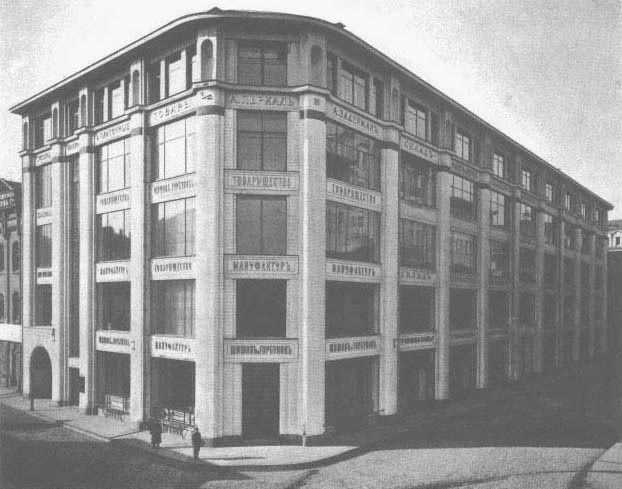
Fig. 168.
Moscow Merchants' Society building, Moscow. 1909. Fedor Shekhtel. Ezhegodnik Moskovskogo arkhitekturnogo
obshchestva , 1910–1911.
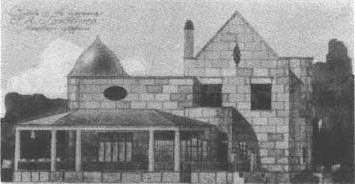
Fig. 169.
Sketch of F. A. Golovin estate house, near Moscow. 1907. Fedor
Shekhtel. Ezhegodnik Obshchestva
arkhitektorov-khudozhnikov , 1908.
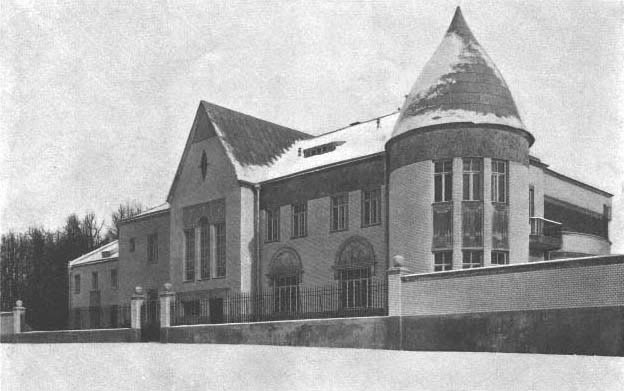
Fig. 170.
Patrikeev house, Khimki-Khovrino, near Moscow. 1907. Fedor Shekhtel. Ezhegodnik Moskovskogo arkhitekturnogo
obshchestva , 1909.
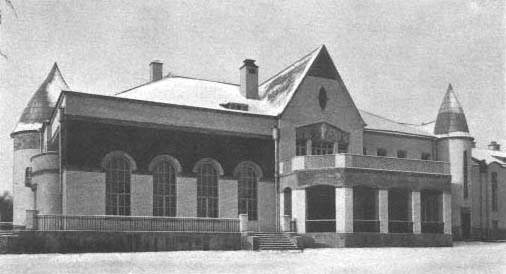
Fig. 171.
Patrikeev house. Ezhegodnik Moskovskogo arkhitekturnogo obshchestva , 1909.
Plates
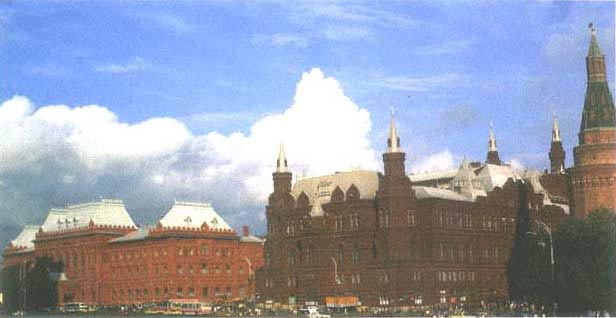
Plate 1.
Historical Museum, Moscow, north facade, facing Okhotnyi Raid. Left : Moscow City Duma. 1890–1892.
Dmitrii Chichagov.
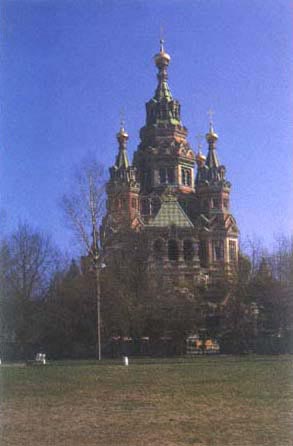
Plate 2.
Court Church of SS. Peter and Paul, Peterhof.
1895–1904. Nikolai Sultanov.
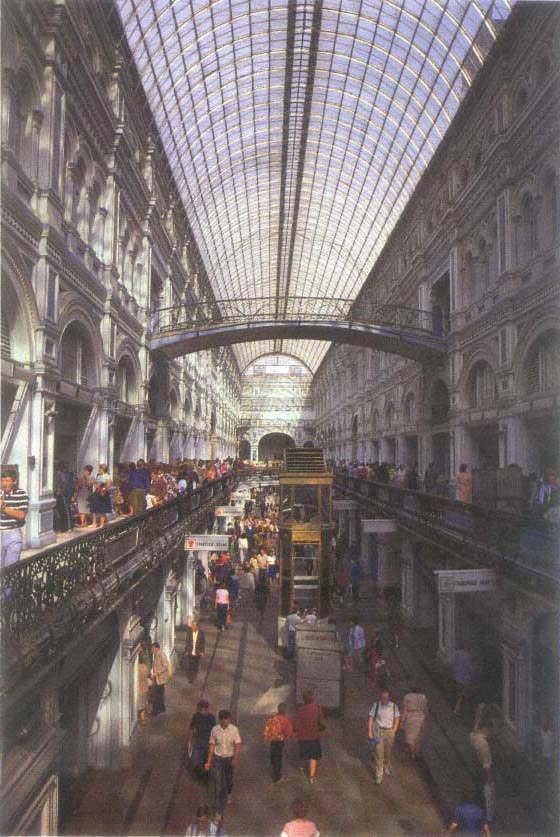
Plate 3.
Upper Trading Rows, Moscow. 1889–1893. Vladimir Pomerantsev. Central arcade.
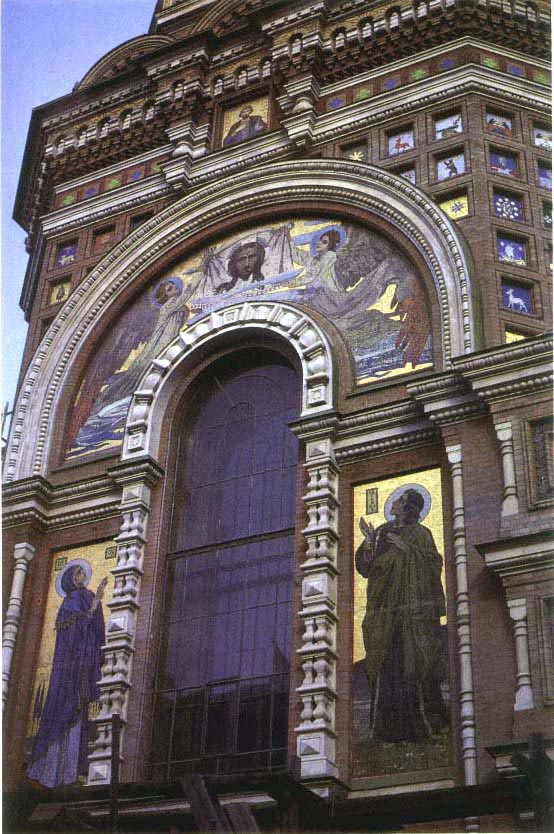
Plate 4.
Church of the Resurrection of the Savior on the Blood, Petersburg. 1883–1907. Alfred Parland.
Detail, west facade.
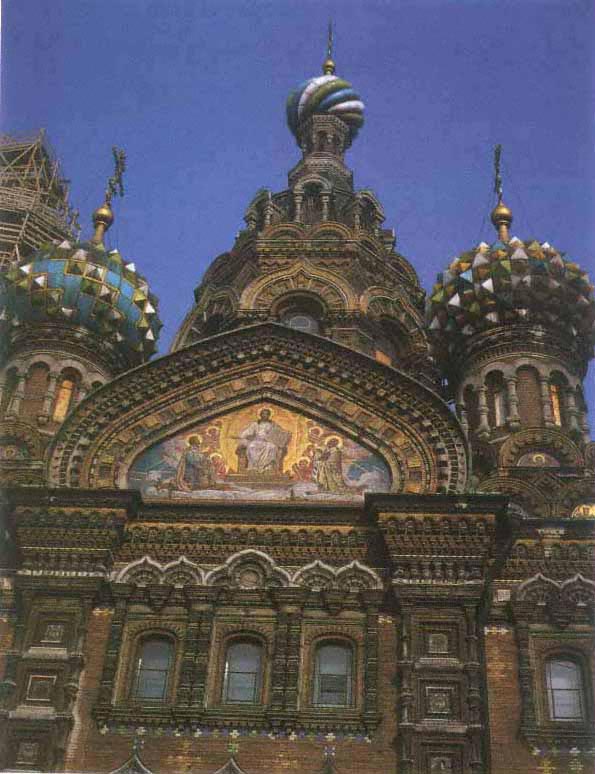
Plate 5.
Church of the Resurrection of the Savior on the Blood, Petersburg, detail, south facade.
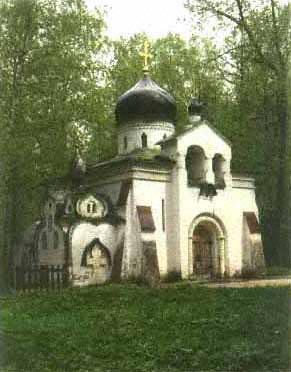
Plate 6.
Church of the Icon of the Savior, Abramtsevo.
1881–1882. Viktor Vasnetsov.
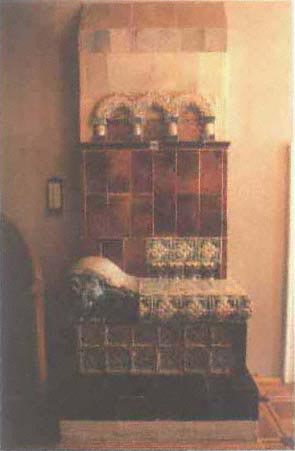
Plate 7.
Ceramic stove, Abramtsevo. 1890s. Mikhail Vrubel.
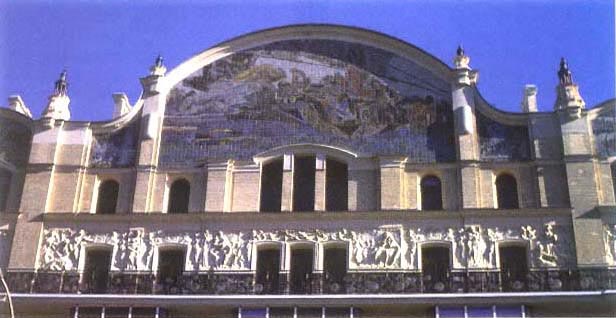
Plate 8.
Hotel Metropole, Moscow. 1899–1905. William Walcot. Ceramic panel "The Princess of Dreams" by Mikhail Vrubel.
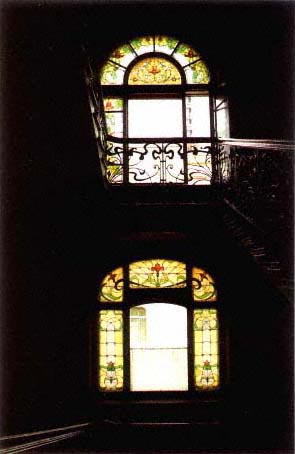
Plate 9.
Hotel Natsional, Moscow. 1901–1903. A. I. Ivanov.
Stained glass, main stairway.
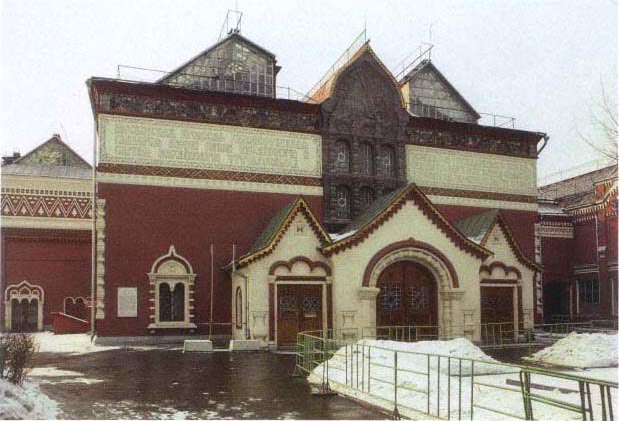
Plate 10.
Tretiakov Gallery, Moscow. 1902–1905. Viktor Vasnetsov.
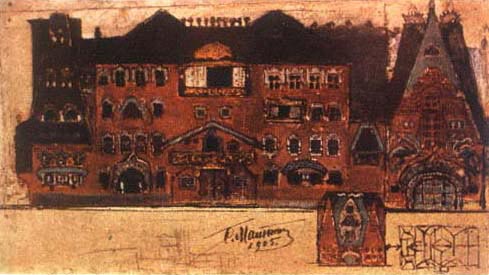
Plate 11.
Project sketch for Pertsov apartment building, Moscow. 1905. Sergei Maliutin.
Ezhegodnik Obshchestva arkhitektorov-khudozhnikov , 1907.
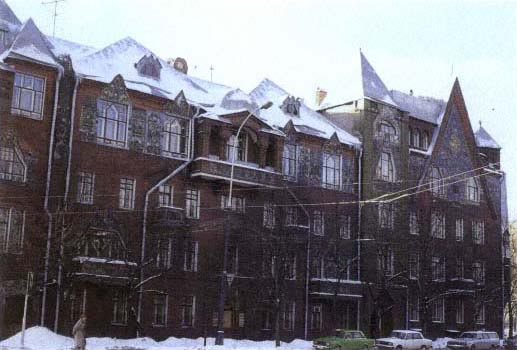
Plate 12.
Pertsov apartment building.
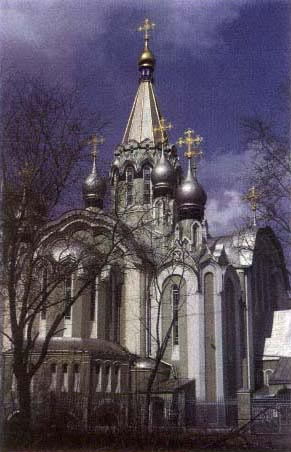
Plate 13.
Church of the Resurrection in Sokolniki, Moscow.
1909–1913. P. A. Tolstykh.
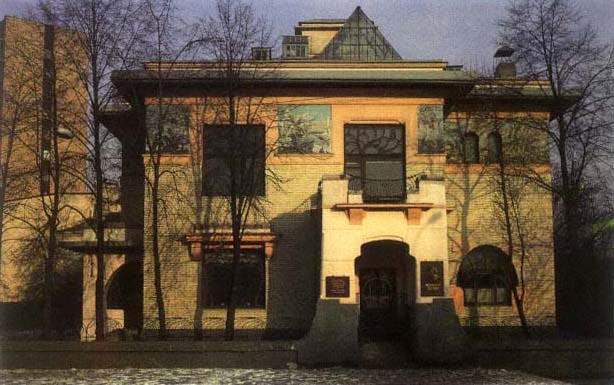
Plate 14.
Riabushinskii house, Moscow. 1900–1902. Fedor Shekhtel.
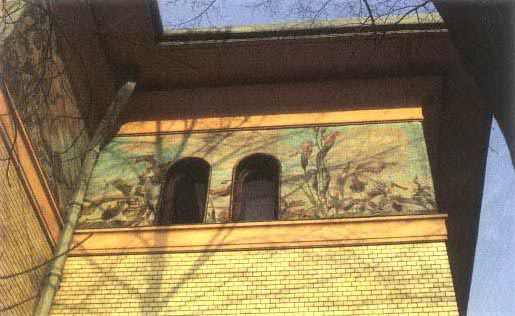
Plate 15.
Riabushinskii house, mosaic detail.
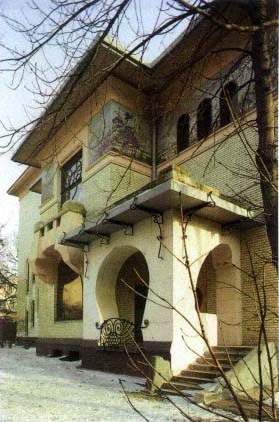
Plate 16.
Riabushinskii house, side facade.
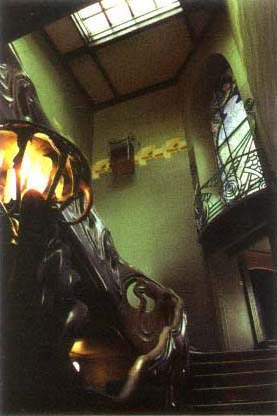
Plate 17.
Riabushinskii house, central space.
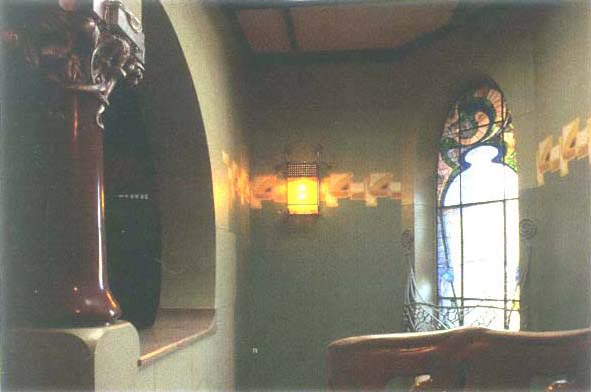
Plate 18.
Riabushinskii house, stained glass window, upper level.
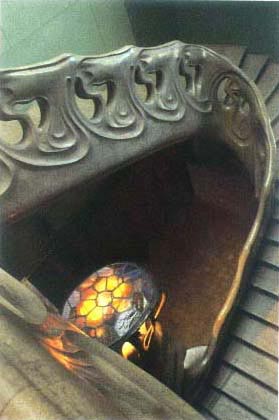
Plate 19.
Riabushinskii house, main stairway.
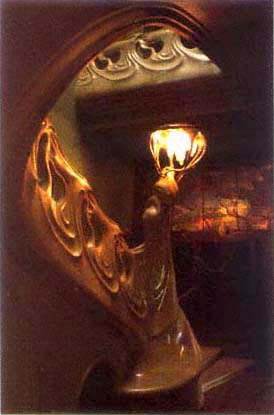
Plate 20.
Riabushinskii house, main stairway.
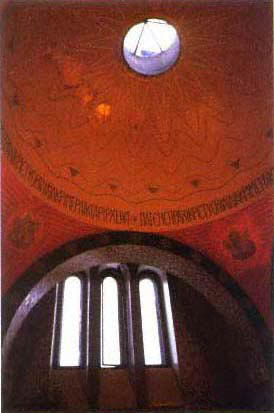
Plate 21.
Riabushinskii house, chapel.
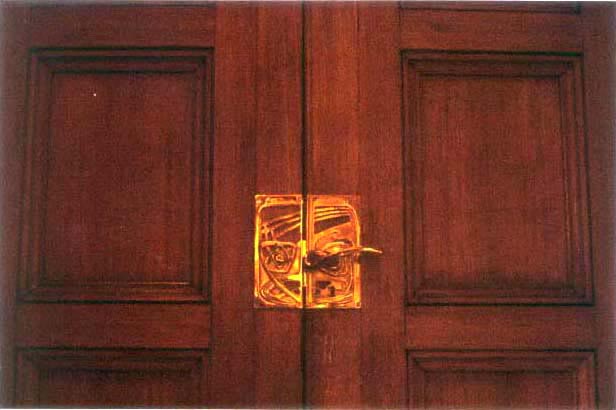
Plate 22.
Derozhinskaia house, Moscow. 1901. Fedor Shekhtel. Door handle, main hall.
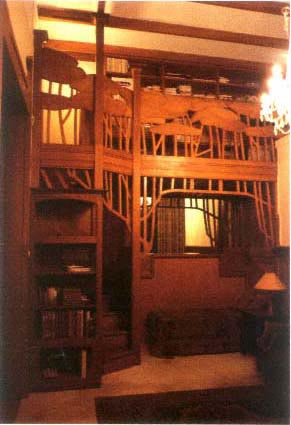
Plate 23.
Derozhinskaia house, library.
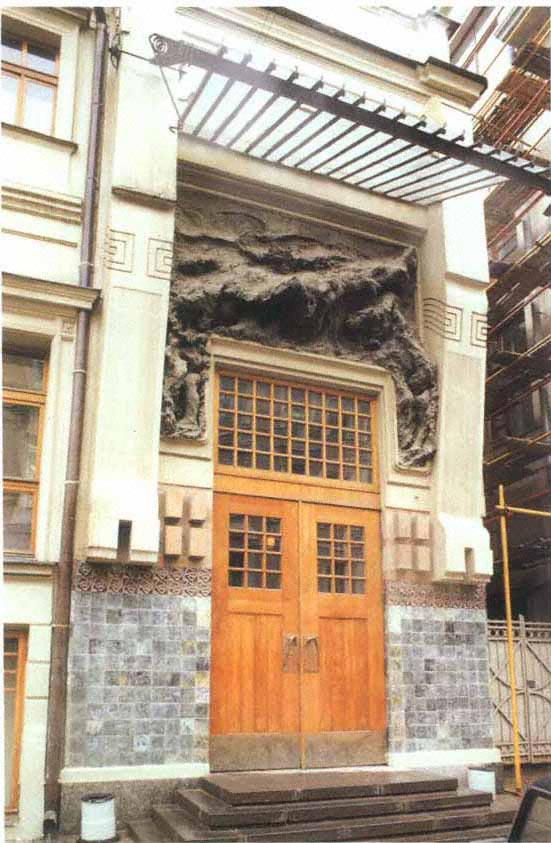
Plate 24.
Moscow Art Theater. 1902. Fedor Shekhtel. Right entrance.
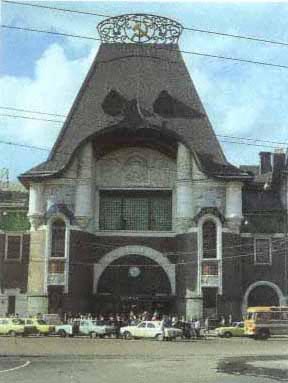
Plate 25.
Iaroslavl Station, Moscow. 1902. Fedor Shekhtel.
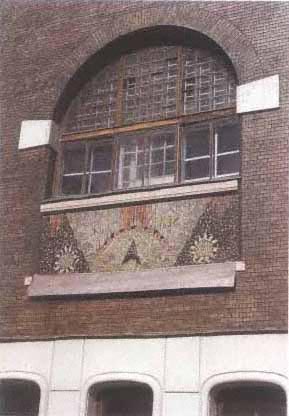
Plate 26.
Iaroslavl Station, ceramic detail, side facade.
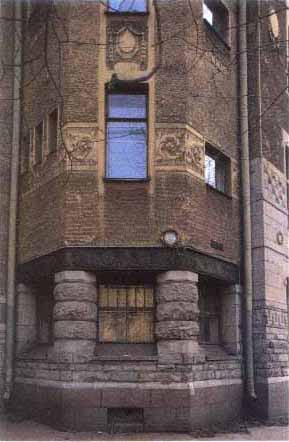
Plate 27.
Lidval apartment house, Petersburg. 1899–1904.
Fedor Lidval. Detail.
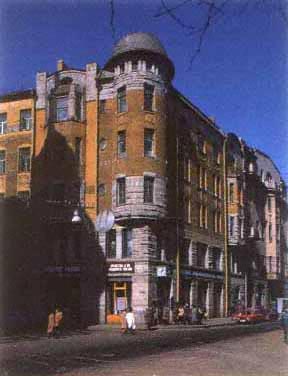
Plate 28.
Meltser Building, Petersburg. 1904–1905. Fedor Lidval.
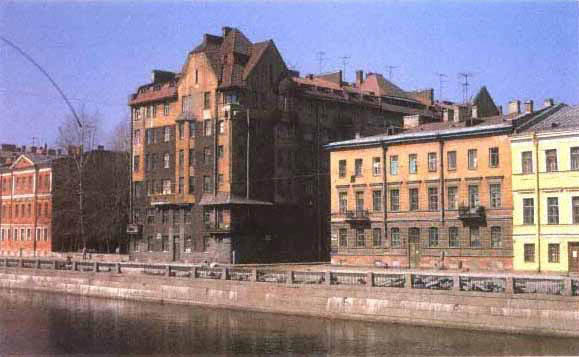
Plate 29.
Apartment house, No. 159 Fontanka Quay, Petersburg. 1910–1911. Aleksei Bubyr.
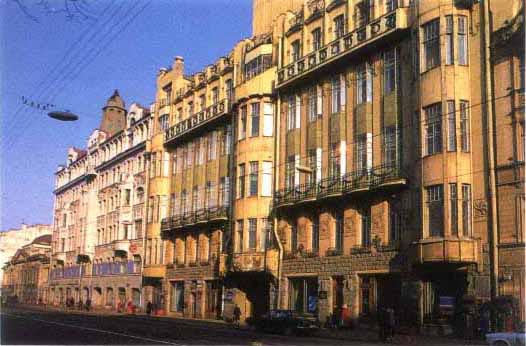
Plate 30.
Apartment house, No. 21 Bolshaia Dvorianskaia Street, Petersburg. 1911. Karl Baldi.
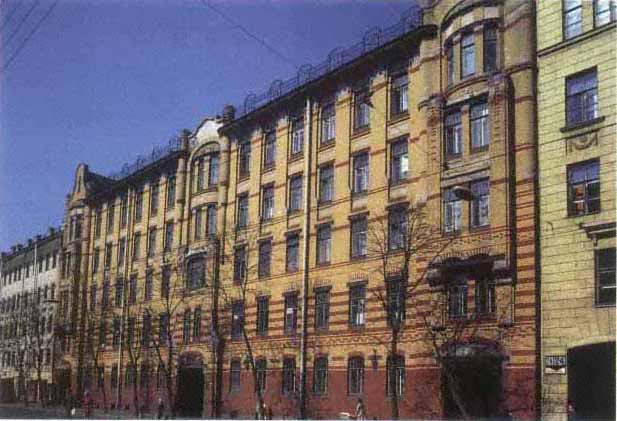
Plate 31.
Shults apartment house, Petersburg. 1901–1902. Karl Shmidt.
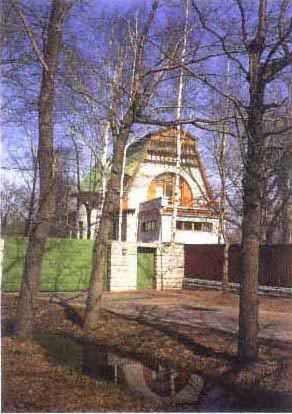
Plate 32.
Schöne house, Stone Island, Petersburg. 1902–1904.
Vasilii Schöne.
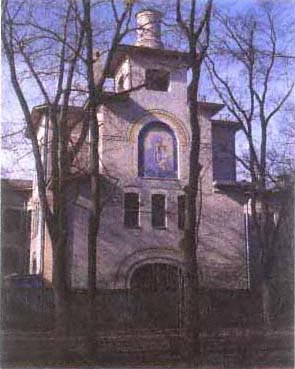
Plate 33.
Orthopaedic Institute, Petersburg. 1902–1905.
Roman Meltser.
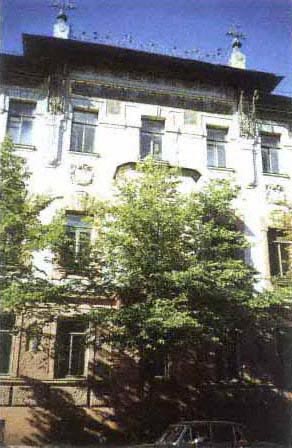
Plate 34.
E. I. Nabokova house, Petersburg. 1901–1902.
Mikhail Geisler.
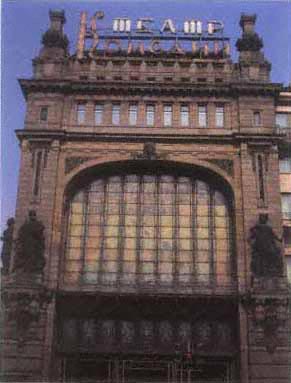
Plate 35.
Eliseev Building, Petersburg. 1902–1904. Gavrii
Baranovskii.

Plate 36.
Chapel of the Blessed Kseniia, Vasilevskii Island, Petersburg. 1900. Valentin Demianovskii.
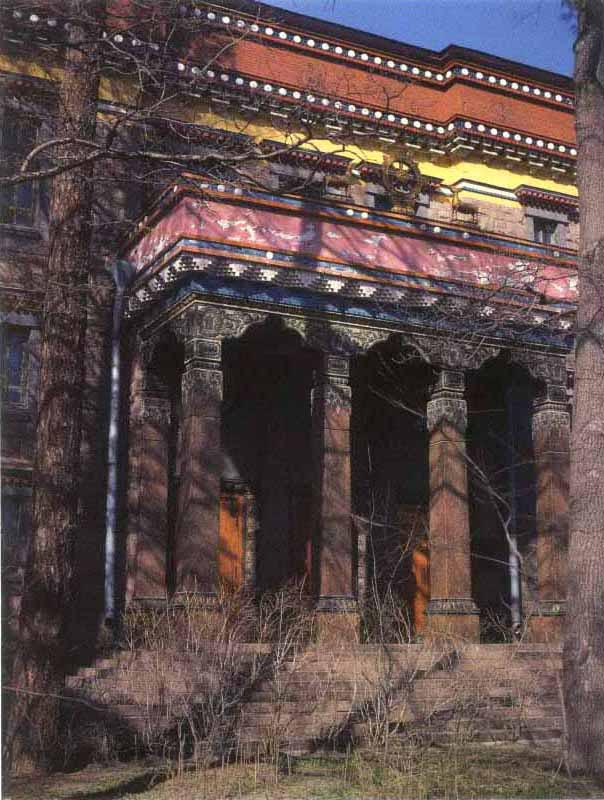
Plate 37.
Buddhist Temple, Petersburg. 1909–1915. Gavriil Baranovskii.
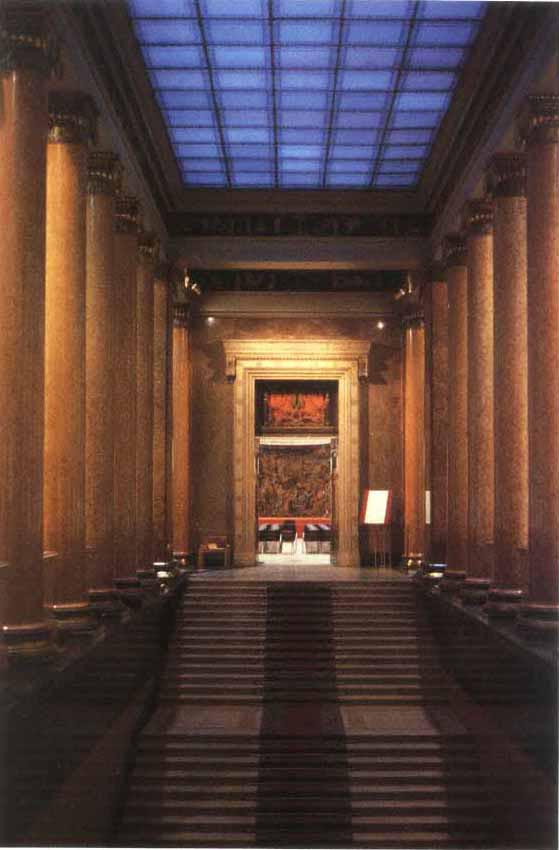
Plate 38.
Museum of Fine Arts, Moscow. Interior. 1897–1912. Roman Klein.
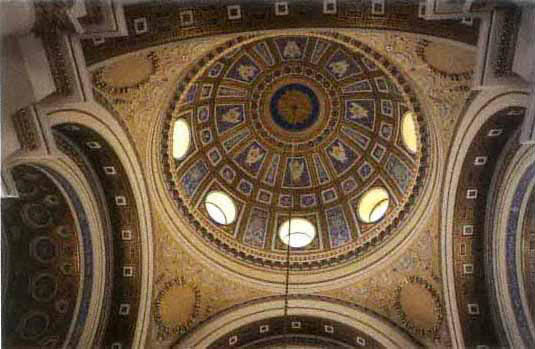
Plate 39.
Iusupov Mausoleum, Arkhangelskoe. Interior. 1911–1916. Roman Klein.
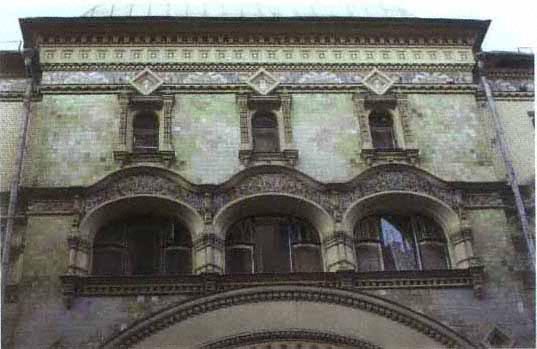
Plate 40.
Savvinskoe Podvore building, Moscow. 1907. Ivan Kuznetsov. Detail, main facade.
windows with simple mullions on the second floor and in the corner tower, and a large venetian window at the center of the front facade. The only curves appear in arches over the first-floor windows; there is not a single bent mullion among them. The few ornaments on the exterior show similar restraint, although Shekhtel did not apply them timidly. A broad frieze with an abstract botanical pattern stretches along the upper part of the front facade and wraps around the corner tower, emphasizing the shape of the structure. One can see a remnant of the Riabushinskii design in the width of the frieze, but the polychromatic whimsy has vanished.
On the back of the house, dark tiles contrast with light brick (Fig. 171), the material whose properties are most thoroughly explored in the precise lines and rounded towers of the villa. The combination in the brick of aesthetic and functional qualities underscores the movement toward a new architecture, devoid of ornament, as in the design of the Shamshin apartments and the Moscow Merchants' Society building. This development in Shekhtel's work of the 1900s conforms to a later phase of the style moderne. As Kirichenko has noted: "The moderne evolves from the representational to the abstract and nonrepresentational form, from the plastic and organic to visually strict forms and relatively strict compositions with measured divisions and repetitions, with hard machine lines and shapes."[67] At the same time the picturesque silhouette of the house suggests that traditional forms remained a source of inspiration—as Shekhtel's subsequent projects were to demonstrate.
Before he returned to a sustained use of the neo-Russian style, Shekhtel at the end of 1909 experienced a classical interlude related to, but not defined by, the contemporary neoclassical revival in Moscow and Petersburg. The scale of the two buildings in question—Shekhtel's house on Bolshaia Sadovaia Street (part of the Garden Ring) and the Chekhov Library and Museum in the southern town of Taganrog—is intimate, and both structures involved a deeply felt personal meaning. That Shekhtel should build a memorial to his friend Chekhov in the same style as his own house suggests an empathy expressible only through the traditional verities of classicism. The semiotic element in the classical design of Shekhtel's house is affirmed by the low-relief panel over the arch leading to a courtyard at the side of the house: it portrays Pallas Athena flanked by the muses of architecture, sculpture, painting, and music (Figs. 172, 173).[68]
This is not to imply that either in the house or the Chekhov museum Shekhtel reproduced neoclassical models precisely. The Petersburg critic Vasilii Kurbatov decried the tendency of contemporary neoclassical revivalists to derive excessive and trivial ornamentation from early nineteenth-century buildings (see chapter 6). But in Shekhtel's case he gave his qualified approval: "Only at the Shekhtel house are the Empire details applied entirely appropriately; that is, each one is surrounded by sufficient free space, although in its basic idea the facade has nothing in common with Empire."[69] This brief appraisal reveals Shekhtel's use of classical elements to define a complex system of spatial relations in a deceptively modest structure. The main hall, which establishes the proportions of the other rooms of the house, is given proper weight on the exterior by a classical portico, while the more modest rooms on either side are marked on the facade by windows with dimensions appropriate to their scale.[70] The entire structure is developed within a system of proportions determined by the constraints of a narrow urban lot.
During the next few years Shekhtel adapted the classical revival to other, commercial, projects including the Ice Palace (1912) on Arbat Square. This grandiose structure, centered on a large two-storied arch with a Doric portico, contained a cinema with six hundred seats (the Art Electro-Theater) as well as a skating hall surrounded by an arcaded gallery whose columns supported a trussed metal roof.[71] The Ice Palace, although not built to the original specifications, represents the extreme point of Shekhtel's classical phase, with classical statuary—Apollo and racing chariots—above the cornice of the central block (Fig. 174). In contrast to this rhetorical use of classical elements, Shekhtel's 1915 design for an exhibition hall on Kamerger Street (near the Moscow Art Theater) uses a few details of the classical entablature to adorn what is otherwise a functional grid typical of his commercial structures.[72]
Although Shekhtel adapted the vocabulary of the neoclassical style to domestic and commercial architecture, in most of his work between 1908 and 1914 he reinterpreted traditional Russian architectural forms. Many of his projects after 1907 were built in or designed for provincial cities such as Nizhni Novgorod, which perhaps were closer to the national "spirit" than Petersburg and Moscow. (The design for the Kazan Railway Station in Moscow is a notable exception.) Shekhtel's headquarters for the S. M. Rukavishnikov firm in Nizhni Novgorod (1908–1912) combines old Russian
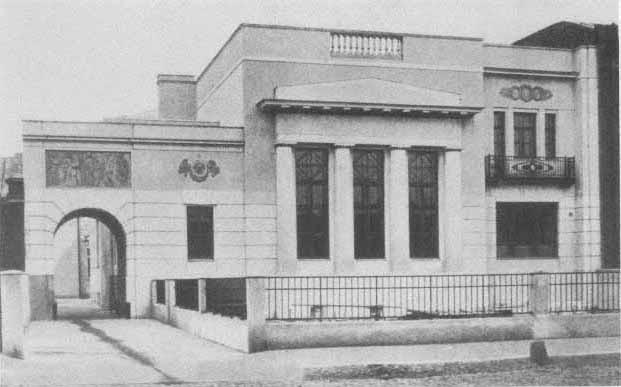
Fig. 172.
Shekhtel house, Moscow. 1909. Ezhegodnik Obshchestva arkhitektorov-khudozhnikov , 1910.
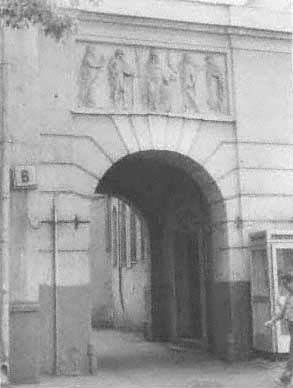
Fig. 173.
Shekhtel house, entrance to courtyard (Brumfield
M102-10).
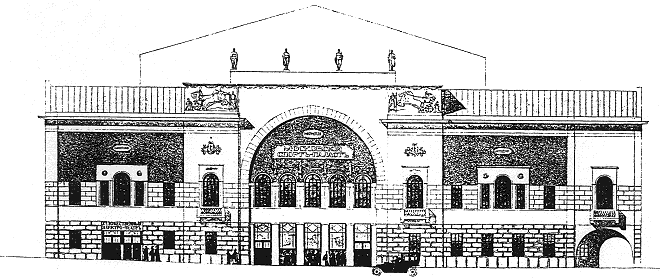
Fig. 174.
Project for Ice Palace, Moscow. 1912. Fedor Shekhtel Ezhegodnik Moskovskogo arkhitekturnogo obshchestva , 1912–1913.
elements with what might be called Hanseatic medieval, yet in its grid and plate glass the structure maintains the functional approach to commercial architecture.[73]
In the same city, Shekhtel's project for a branch of the State Bank (1910) shows less ornamentation but greater depth in its arrangement of volume. The focal point of the design is a corner tower, in the style of medieval Russian kremlins, that not only contains the main entrance but also serves as a pivot for the office blocks that extend at oblique angles in an asymmetrical arrangement (Fig. 175). Although the blocks are only two or three stories high, their steeply pitched roofs form a picturesque silhouette. In contrast to the Rukavishnikov building, the decoration is restrained, consisting primarily of a strip of recessed squares (shirinki ) and other traditional ornamental patterns.[74]
Although Shekhtel's project for the bank was not accepted, the basic plan resurfaced in 1913 in his design for the Nizhni Novgorod Provincial Museum—dedicated to the tercentenary of the Romanov dynasty. The front block (Fig. 176) is capped with a high tent roof similar to that of both Shekhtel's pavilions at Glasgow and the Iaroslavl Station; the side block adheres to the more modest outlines of the bank project. Shekhtel devoted special attention to the artistic formulation of the interior, which was to have had extensive wall paintings.[75]
The third of Shekhtel's large projects (all unbuilt) in the Russian retrospective style was his design for the Kazan Railway Station on Kalanchevskii Square (1911). With its towers and pitched roofs, the station resembles both the Glasgow pavilions and the blocks of the Nizhni Novgorod bank. The decorative detail on the facade derives primarily from the late seventeenth century, when ornament was heavily used in Russian architecture; yet the horizontal sweep of the building and the large area devoted to windows—of many sizes and shapes—suggest that functional principles were applied in the design and illumination of the large waiting halls (Fig. 177). The tall square clock tower resembles numerous adaptations of the campanile in railway stations throughout the West (Shekhtel knew the one in Eliel Saarinen's 1904 design for the Helsinki Railway Station).
Had he won the competition, Shekhtel would have had the unique honor of designing two major stations facing one another—both drawing on historical motifs, both arranging space functionally, both emphasizing points of entry with large arched portals, and both exploiting the free style to create an asymmetrical structure. The Iaroslavl Station, however, is more unified, not only in its contoured outline (the sprawling Kazan Station exhibits a multiplicity of shapes) but also in its proclamation of modernity—traditional decorative elements notwithstanding. Each of the projects has a picturesque facade, but the Kazan Station—based
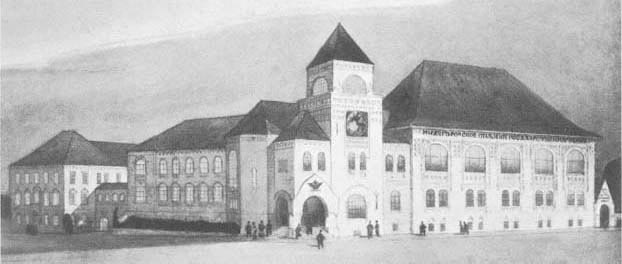
Fig. 175.
Project for State Bank, Nizhni Novgorod. 1910. Fedor Shekhtel. Ezhegodnik Moskovskogo arkhitekturnogo
obshchestva , 1910–1911.
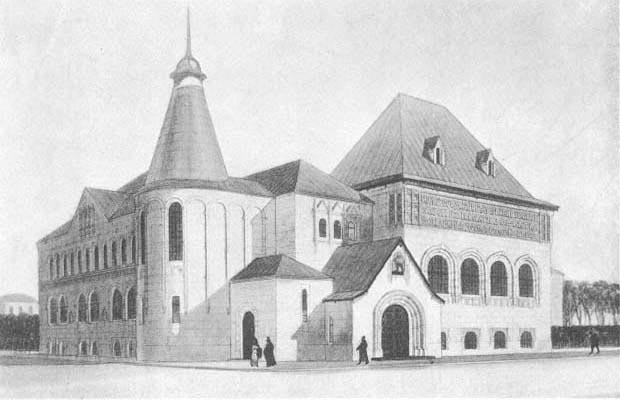
Fig. 176.
Project for Nizhni Novgorod Provincial Museum. 1913. Fedor Shekhtel. Ezhegodnik Moskovskogo arkhitekturnogo
obshchestva , 1914–1916.
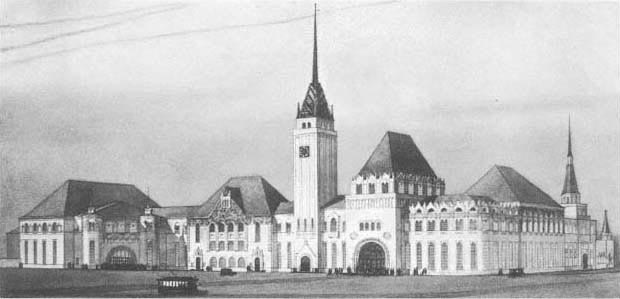
Fig. 177.
Project for Kazan Railway Station, Moscow. 1911. Fedor Shekhtel. Ezhegodnik Moskovskogo arkhitekturnogo
obshchestva , 1910–1911.
on seventeenth-century monuments in Kazan and Moscow—represents a clear retreat from the aesthetics of modern design. Of the remaining choices, rationalism and retrospection, Shekhtel chose the latter—as stipulated by the design competition. In the event, the winning design by Aleksei Shchusev was similar to Shekhtel's in concept and reproduced seventeenth-century prototypes even more closely.[76]
Although a number of his projects were rejected between 1910 and the outbreak of war, Shekhtel experienced success in one area that had long claimed his attention—the design of churches.[77] Unlike his earlier churches, with their conservative architectural form (usually in the neo-Byzantine style), those from 1910 to 1914 used traditional Russian prototypes in a modern interpretation. This melding of tradition and innovation also characterized the work of Shchusev, Bondarenko, and Pokrovskii, all of whom turned to pre-Petrine architecture for inspiration in designing churches.
For Shekhtel the sixteenth-century tower church, with its elongated pyramidal tent roof, was the quintessential expression of the centrally organized structure; he used the tent-tower motif in the pavilions at the Glasgow exposition as well as in smaller structures in the 1890s. In his 1910 design of an Old Believer church at Balakovo (on the Volga River between Samara and Saratov), Shekhtel restored the motif to its semiotic function as a feature of the Russian church before the schism, or raskol , of the mid-seventeenth century.[78] The ashlar structure, with attached bell tower, follows the cross-inscribed plan, but the freely interpreted tent tower (here over a large cuboid structure) and subtle additions to the central cube convey an innovative approach to the medieval form (Fig. 178).
Shekhtel's final church, built in 1914 in the Moscow suburb Petrovsko-Razumovskoe, is his most sensitive and faithful re-creation of a traditional architectural form. Dedicated to St. Nicholas the Miracle Worker, the church took its shape from the most popular Russian building material—wood.[79] Shekhtel's ingenuity in wooden construction had been demonstrated at Glasgow. The church, understandably, does not have the decorative profusion of the pavilions, but the adherence to the forms of the traditional wooden church is so rigorous—a tent-roofed octagonal tower over a square—that one might assume the building to be a replica.
In fact the shape of the building (not extant), with its plank siding, placed a modern emphasis on fluid contours, from the central tower to the large extensions (each with its own roof) on the north, south, and west
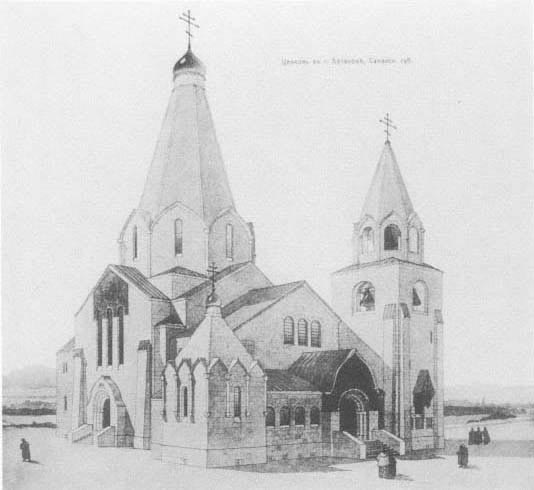
Fig. 178.
Sketch of Old Believer church, Balakovo. 1910. Fedor Shekhtel. Zodchii , 1911.
(Fig. 179). The spatial unity of interior and exterior was complemented by the iconostasis and furnishings, which Shekhtel also designed (Fig. 180). Like Viktor Vasnetsov at Abramtsevo some three decades earlier, he found in the church the ideal way to integrate structure and the decorative arts.
Prerevolutionary photographs of the building show an exquisite interior, contrasting the elaborate carving of the iconostasis with the pattern of unpainted knotty pine for the walls. Shekhtel stated his fondness for this project in messages on photographic postcards showing the church. To one of his nephews he wrote: "If you should by chance meet a devotee of the Russian northern style, give him this, my favorite little church, which worked so well for an atheist such as myself." His postcard to the architect and designer Ivan Mashkov said simply: "In my opinion this is the best of my buildings."[80]
After 1914 the strain of the First World War on the Russian economy led to a sharp decline in architectural commissions (apart from military and industrial projects) and the virtual collapse of the private housing market. Shekhtel had received few commissions even in the years just before the war, but his financial position was secure, and he still worked for those who had supported him earlier in his career. At some point between 1910
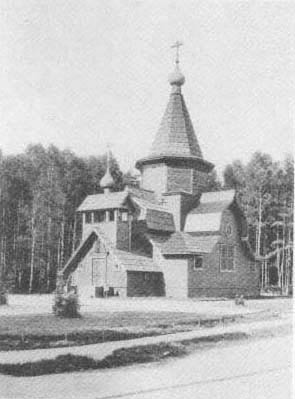
Fig. 179.
Church of St. Nicholas, Petrovsko-Razumovskoe, near
Moscow. 1914. Fedor Shekhtel. Ezhegodnik Moskovskogo
arkhitekturnogo obshchestva , 1914–1916.
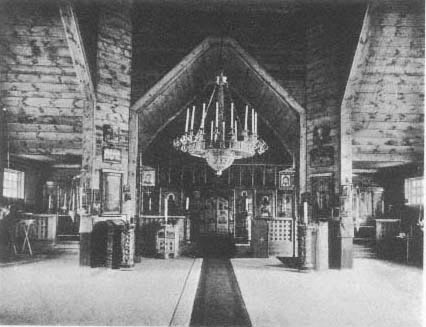
Fig. 180.
Church of St. Nicholas, interior. Ezhegodnik Moskovskogo arkhitekturnogo
obshchestva , 1914–1916.
and 1914, he rebuilt the two-storied manor house on the estate of Gorki (south of Moscow) for Zinaida Morozova-Reinbot—the widow of Savva Morozov—for whom he had designed the first of his major houses in Moscow.[81] Shekhtel interpreted the neoclassical revival in this project so unobtrusively and harmoniously that at first glance the design seems a product of an earlier period; yet such details as the portico for this stuccoed brick building (dating from the end of the eighteenth century) and the classical frieze beneath the cornice are subtle, stylized references to Russian neoclassicism.
During the war Shekhtel's project designs ranged from a sanatorium in the Crimea to an apartment house not far from the Levenson printing works in Moscow.[82] None of these were built, and after the revolution his livelihood, like that of many artists and intellectuals, became tenuous. Moreover, Shekhtel and his family were evicted from their house, which was expropriated by the state in 1918. A fragment from the memoirs of Ilia Bondarenko, once Shekhtel's apprentice but in 1918 the director of the Office for the Preservation of Monuments of Art and Antiquity, suggests the destitution of Moscow's architects at that time:
Architects came eagerly to the office; they had little to do. My former chief, F. O. Shekhtel, arrived and asked to be assigned any sort of work. I assigned him to investigate grave markers in Moscow cemeteries, where there were still many interesting structures and statuary that had to be preserved and restored. Shekhtel carried out a few surveys and sketches, but the matter did not go beyond that.[83]
The best of Moscow's cemeteries indeed warranted preservation, and Shekhtel had earlier designed some remarkable examples of funerary art (mausoleums, grave markers).[84] Nonetheless, Bondarenko's account suggests that Shekhtel was less than enthusiastic about make-work. He did not, however, fade from view, nor did he reject the new era. Among his many professional duties, he served as president of the Moscow Architectural Association (a post he had held since 1906) and for a brief period (1921–1923) directed the Architectural and Technical Council of the Committee for State Construction.[85]
His projects between 1921 and 1925 (during the economic revival of the NEP years) included an optical factory near Moscow, with detached houses for the workers; the Turkestan pavilion at the first Agricultural Exhibition in Moscow (constructed); a design for the Lenin mausoleum; and a comprehensive project for the Dnieper River hydroelectric dam. Having devoted much of his career to designing mansions and commercial structures, Shekhtel no doubt welcomed the opportunity to use his talents for a broader segment of society; yet he did not adopt the radical vision of Constructivism—unlike Aleksei Shchusev, who skillfully applied the Constructivist aesthetic until it too went out of favor. As he had done before the revolution, Shekhtel employed a functional or a retrospective approach, according to the purpose of a given project.[86]
In addition to his administrative and design work, Shekhtel continued to teach at the Stroganov School, reorganized in 1920 as Vkhutemas. His affiliation with the school dated from 1896, and it was there, in 1919, that he delivered to a group of students his only surviving pronouncement on architectural aesthetics. The lecture, "A Tale of Three Sisters: Painting, Architecture, Sculpture," surveyed architecture as a synthesis of the arts and defended Shekhtel's own work in the style moderne.[87] Though brief, it is a valuable commentary on what he considered his major accomplishments. The reference in his title to the muses as three sisters, undoubtedly an homage to Chekhov, also reminds one of the classical panel above the entrance to his house on Bolshaia Sadovaia.
After reaffirming the fundamental role of "work, love, and art" in life, Shekhtel noted the importance of painting and sculpture to great works of architecture, from the dawn of civilization through the flourishing of Egyptian, Greek, Islamic, Byzantine, Gothic, and Renaissance architecture. In this survey of architecture as an evolving, unified tradition, Shekhtel illuminates aspects of his own work, such as color and rhythm in the definition of structure. For example, his comments on the Islamic monuments of Central Asia can be seen within the context of his own use of polychromatic designs on the Riabushinskii house.[88]
That Shekhtel also appreciated the genius of Russian architecture—particularly in medieval Novgorod and Moscow—suggests a closer, native, source for his synthesis of architecture and the decorative arts: "Russian architecture from the very beginning of its independent existence proceeds inextricably with painting."[89] With this statement he turned to his own time and work, emphasizing his relation to Vrubel and to Viktor Borisov-Musatov. He juxtaposed the monumental wall paintings in Kiev and Nizhni Novgorod by Vrubel with the
painter's work at various houses by Shekhtel (including two for the Morozov family). As for the Derozhinskaia house: "Borisov-Musatov began a cycle of romantic panels from reminiscences of the 1840s, but his premature death prevented him from finishing them."[90]
Shekhtel's retrospection concluded with what he justifiably considered one of the high points of his career: the pavilions at Glasgow. He recounted proudly their synthesis of art and architecture and their exemplary combination of traditional Russian forms and materials with the style moderne aesthetic:
I remember with great pleasure the collaborative work of painting the churches I built and [of painting] the pavilions of the Russian section at the International Exposition in Glasgow . . . with my former students from the Stroganov. This small community brilliantly fulfilled its task, and the stern British loudly cheered the color of these wall paintings. . . . The building of the Russian section was carried out by a group of two hundred Russian workers, whom I sent by sea to England, and [the buildings] were of Russian timber exported from Arkhangelsk.[91]
One wonders how this vade mecum was received by his students in revolutionary Moscow, with their ideals of radical transformation in the arts; but it is characteristic of Shekhtel that he acknowledged generously his debt to an earlier group of students, just as he fulfilled his professional responsibilities toward a new generation. And he was by no means unaware of theoretical insights associated with the use of color in modern art: his final comments on the properties of color in enhancing or modifying the perception of space could be related to work by Vasily Kandinsky, as well as other contemporary artists.[92] Nonetheless, postrevolutionary criticism was not sympathetic to the aesthetic principles Shekhtel had maintained.[93]
Russian critics acclaimed Shekhtel's work—even when he was at the height of his creativity—less than that of his contemporaries in Central Europe. In this light it is revealing to examine an extensive commentary on his work by Vasilii Kurbatov—one of the few to appear during Shekhtel's lifetime. Kurbatov, surveying architecture since 1900, placed Shekhtel in the front ranks of Russian architects, but always with reservations:
Of much greater importance is the striving for simplicity and rationality. English architects have succeeded at this, as have Germans such as Olbrich, Hoffmann, et al. Among the Russians, Shekhtel approached such a resolution, but not once did he succeed in carrying it through to the end: all of his buildings are brilliantly conceived, technically superb, but none achieves a culmination. The buildings at the exposition in Glasgow are decorative, but they do not have the poetry of Korovin's village [at the 1900 Paris Exposition]. The church in Samara Province skillfully resolves the problem of a tent roof over a large space, but all the same it lacks poetry. Perhaps because of the stunning variousness of his talent he could not perfect any of the building types.[94]
Kurbatov's comments were often perceptive, but a critique derived from a subjective notion of "poetry" could hardly do justice to Shekhtel's fusion of aetheticism and modernity, which expressed the vitality of a transitional age rife with contradiction. The new economic and social forces of this period demanded a large-scale application of functionalism to modern building technology while other forces—romantic, retrospective, or simply reactionary—encouraged a return to picturesque, colorful, anachronistic forms. Shekhtel explored each of these trends with rare fluency, yet his work is never limited by them. The manifold nature of Shekhtel's creativity is in fact the great strength of this architect, as it was of contemporaries such as Josef Hoffmann.
At the same time, Shekhtel cannot reasonably be considered one of the leading innovators in modern European architecture. There is, perhaps, a comparison to be made between the Riabushinskii brothers' fruitless search for an ideology to support their vision of the future and Shekhtel's limited means for designing and building in this century. Although the style moderne provided a necessary antidote to the stylistic welter of the late nineteenth century, it was transitory, quickly superseded throughout Europe. Shekhtel seems to have understood this, but he advanced no other vision of architecture and society in the modern age—nor was he particularly concerned to do so. His sense of architecture as the design of aesthetic objects remained a constant, whatever he chose to create. He lived to see his architectural values discarded; yet it is unlikely that as an architect at the end of a successful career he would have minded, knowing as he did that most styles are the product of their age.
Chapter Five—
The Ambiguities of the Moderne in St. Petersburg
In both a social and topographical sense, Moscow at the turn of the century was particularly receptive to the style moderne. Despite the increasing density of construction, its unusually open environment permitted the design in depth of mansions and commercial buildings on large lots in the central districts of the city. On almost every matter of importance in architectural design, Petersburg contrasted with Moscow. Its buildings, tightly constructed and contiguous, were arranged in a city plan that, though not rectangular, followed the straightedge wherever its deltaic terrain permitted.[1] The city in fact had many open or underbuilt sites; but major construction in such areas followed the eighteenth-century practice of linking buildings in an extended facade. (The city's height restrictions also encouraged such perspectival, if not stylistic, uniformity.) In this setting the plasticity of structure emphasized in the style moderne aesthetic frequently assumed a two-dimensional form dependent on the texture of materials and the shaping of the facade.
As for architectural patronage, Petersburg's socioeconomic structure created a financial elite composed not of self-made entrepreneurial dynasties from the Russian heartland but of financiers and entrepreneurs with little of the desire to declare their cultural identity that marked the Morozovs, Riabushinskiis, and other Moscow merchants. The detached mansions built in the new style in a few areas of Petersburg at the turn of the century interpreted the moderne less flamboyantly than in Moscow, drawing on the more austere characteristics of the Secession.
Even the exceptions to this austerity illustrate characteristic differences between the new style in Moscow and in Petersburg. The rustic, expressive shapes of the Scandinavian (particularly Finnish) moderne appeared in the private houses on Petersburg's Kamennyi Ostrov (Stone Island); Moscow's suburban mansions drew on English and American domestic architecture. By 1910 those who commissioned large houses in the Petersburg suburbs showed a clear preference for either the neoclassical revival in the Empire style or the Italian villa (see chapter 6).
The new style first appeared in apartment facades at the turn of the century. Vasilii Shaub's design for the apartment house of Aleksandr Baryshnikov (himself an architect and engineer), although devoid of structural innovation, is one of the earliest examples of moderne decoration on an extensive scale. Baryshnikov modified Shaub's design but retained some of its bizarre decorative elements. Completed in 1899, the building was described in a brief article, with photographs, in the March 1900 issue of Zodchii .[2] This journal not only featured the Baryshnikov building in its pages but also published other sketches by Shaub, including an American-style gabled suburban house with large art nouveau curves applied to the veranda.[3] In October 1899
Nedelia stroitelia praised two apartment buildings—one by Shaub, the other by Aleksandr Gogen—that displayed a new "decadence in architecture." The author, who noted that these structures overcame the current clichés in eclectic decoration, failed to see that a new set of purely decorative devices represented little more than an extension of eclecticism.[4]
The publicity given these early manifestations of a new decorative style (discussed in chapter 2), however, did not signify the critics' unqualified approval. Some attacked the favorable opinions of the style expressed by the author of the article in Nedelia stroitelia , while others, like Pavel Makarov, sympathetic to modern architecture, questioned the purpose of superficial, decorative aestheticism.
Does the new style really consist only in finishing a facade divided in a completely ordinary way with stucco ornament of the so-called decadent style, in replacing window and door surrounds, and in covering rooms with the type of wallpaper that is beginning to appear now in Petersburg? The meaning of the new style does not reside at all in these trifles, the execution of which is quite unskilled; no, it resides much deeper, and the only architect who can be called original is the one who knows how to create something really original in the general appearance of the entire building, in the grouping of its mass and in the arrangement of the rooms.[5]
Although the rational, comprehensive approach to architectural design Makarov proposed was a principal ideal of the style moderne, it required an organic, stereometric interpretation of structure not often found in the Petersburg environment. Of the several hundred building projects undertaken in Petersburg between 1898 and 1915, only a small fraction applied the new style in anything other than a fragmentary, decorative manner.[6] Nonetheless, architects of exceptional talent defined a distinctive and comprehensive variant of the new style in Russia, known as the northern moderne.
Fedor Lidval (1870–1945) was one of the most productive architects during the two decades before the revolution. The phases of his career included the early moderne as well as a more austere idiom related to Petersburg's classical revival. Not only do Lidval's buildings epitomize the protean, multifaceted stylistic developments of his time, but they also represent the capitalist financing of large projects in Petersburg. Most of his designs were for apartment houses and banks.
Lidval studied at the Academy of Arts from 1890 to 1896 where he affiliated with the workshop of Leontii Benois, whose conservative adherence to the Renaissance style for his own buildings in no way hampered the imagination of his students.[7] Indeed, the first of Lidval's major projects—an apartment house listed under the name of his wife, I. B. Lidval—is also one of the clearest expressions of the new style in Petersburg. Begun in 1899, the building integrates modern structural and decorative elements in a plan that departs radically from the city's typical unbroken facade (Fig. 181).
To Lidval's advantage, the building site was a large asymmetrical plot bounded by four streets, including the beginning of Kamennoostrovskii Prospekt, the main thoroughfare through a new area of intensive apartment construction on the Petersburg Side (across the Neva River north of the city center). Lidval's building was the first in this region, which by 1910 had become a showcase for middle-class and luxury apartment housing. Its first component was a relatively modest affair at the rear of the lot (facing Maliy Posadskii Street); but when the entire project was completed in 1904, it formed a central p -shaped plan with two facades on Kamennoostrovskii Prospekt and a landscaped courtyard in the center (Fig. 182). With this design, soon to be used by other architects, Lidval eliminated the cramped inner courtyard characteristic of Petersburg's apartment blocks, creating an open, parklike setting that also gave the building a sense of depth.[8]
Lidval's successful assault on the closed facade occurred at the expense (quite literally) of rentable space. Such an arrangement was feasible only in an under-developed area where land prices were relatively low and the plan of the structure itself was intended to attract the desired clientele.[9] Just as the expansion of Moscow's tram system spurred the construction of apartments on the Ring Circle, the opening of a permanent bridge (the Troitskii) to the Petersburg Side in 1903 and the laying of tracks to the north enabled architect-developers like Lidval to predict a stable housing market away from the crowded central districts.
Lidval's exercise in the new style was innovative in more than its comprehensive plan, however. The facade of this complex structure exploited a variety of materials and shapes to create a texture and plasticity unusual in Petersburg architecture before 1900 (see Plate 27). The
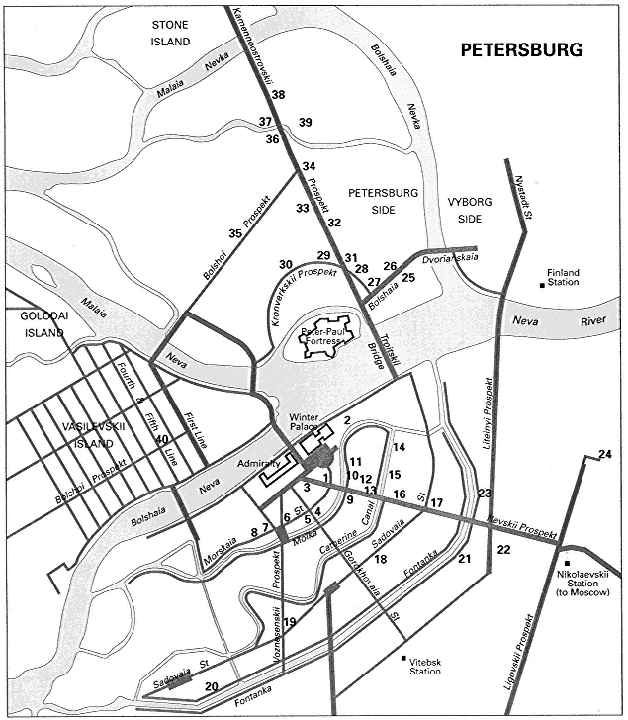
1. Azov-Don Bank
2. Abamalek-Lazarev house
3. Vavelberg building
4. Fabergé building
5. Esders and Scheefhals building
6. Hotel Astoria
7. German embassy
8. E. I. Nabokova house
9. Mertens building
10. Guards' Economic Society
11. Meltser building
12. Swedish Church apartment building
13. Singer building
14. Church of the Resurrection of the Saviour on the Blood
15. Nobel Brothers apartment building
16. Hotel Europe
17. Eliseev building
18. Second Mutual Credit Society
19. City Institutions building (Lishnevskii)
20. Fontanka apartment building (Bubyr)
21. M. P. Tolstoi apartment building
22. Stremiannyi St. apartment building
23. New Passage
24. Basin Cooperative Society apartments
25. Bolshoi Dvorianskii St. apartments (Baldi)
26. Shults apartment building
27. Kshesinskaia house
28. Mosque
29. Barsova apartment house
30. City Institutions building (Peretiatkovich)
31. Lidval apartment building
32. Voeikova apartment building
33. First Russian Insurance Company apartments
34. Rozenshtein apartment buildings
35. Putilova apartment building
36. Emir of Buhhara apartments
37. Pokotilova house
38. Markov apartment buildings
39. Savina house
40. Forostovskii house
rusticated stone blocks on the ground floor yield to a broad swath of roughcast on the upper floors, with vertical ornamental strips between the windows. (Fig. 183). The outlines of the windows facing the street frequently deviate from the rectangular, complementing the molded textures of the building.
By way of contrast, the courtyard facade of the central structure shows both ingenuity and restraint in its articulation of a five-storied window grid (Fig. 184). Although the openings are defined simply, incisions in the roughcast surface link—or separate—levels of windows. In contrast to apartment buildings in the late nineteenth century, with their surfeit of stucco elements, Lidval's facade exploited texture in the bay above the main entrance, with its stucco pilasters scored and decorated in the Secession style. The two levels of the bay are separated by a decorative panel in cast iron; the structure culminates in a rounded gable enclosing a large figure of an owl. In addition to integrating structural materials, Lidval used ornamental ironwork extensively: in railing and gate lanterns in front of the courtyard, as well as in the balconies, with their arachnid pattern. Inside, the main stairwells display stained glass, wrought iron, and ceramic floor tiles—all applied functionally as well as decoratively.
By the time Lidval completed his apartment building on Kamennoostrovskii Prospekt, he was already at work on numerous other, smaller scale, apartment designs—for example, his apartment house at No. 92 Bolshoi Prospekt, on Vasilevskii Island. In 1904 the Swedish Lutheran Church commissioned a large apartment building on Malyi Koniushennyi Street (now Sofia Perovskaia Street), within a block of Nevskii Prospekt. This six-storied structure utilized the contrasting textures of glazed brick for the lower two floors and roughcast for the upper levels as a background for various ornamental motifs (Fig. 185). The free asymmetrical design quoted both the classical and the baroque in a context that emphasized the plasticity of material. Lidval expressed his antipathy to the flat surface in projections from the facade, not only in window bays but also in a complicated balcony structure flanked by attached window bays supporting turrets with cupolas. In isolating one part of the facade with elaborate structural molding beneath a curved pediment, he attempted an illusionistic transformation of the two-dimensional Petersburg facade.
Lidval created a molded structure with less decorative effort in an apartment house (1904–1905) for N. A. Meltser on Bolshoi Koniushennyi, parallel to and one block from the Lutheran apartments. For the building, which occupied a corner lot, Lidval, in typical fashion, designed a corner tower projecting over the street level (see Plate 28). Although relatively uncomplicated in design, this compact building is the most tactile of his apartment projects, exploiting the contrast between natural stone facing on the lower floors and ochre roughcast above. Here as in his other apartment houses in the central district of the city, he adapted the ground floor for commercial use—in this case for the Petersburg office of the Kodak Camera company.
Lidval's subsequent apartment designs continued to use molded structural elements (such as window bays in two- and three-storied shafts) to create a textured facade in which materials were the basis of decoration. The apartment house for A. F. Zimmerman at No. 61 Kamennoostrovskii Prospekt (1906–1907) elaborates all of Lidval's earlier stylistic devices: a swath of brick above the rusticated stone base meets the roughcast of the upper stories in an ornamental strip of brick and stucco (Fig. 186). By 1910 Lidval had abandoned these obvious motifs of the style moderne florescence for more austere classical elements, at times massively articulated. In this sense his work exemplifies the reaction against the new style in Petersburg (discussed in chapter 6) even as it retains many of the structural features of the moderne.
Many other architects in Petersburg explored the new style with mixed results. Indeed, the proliferation of buildings answering the demand for housing reduced the
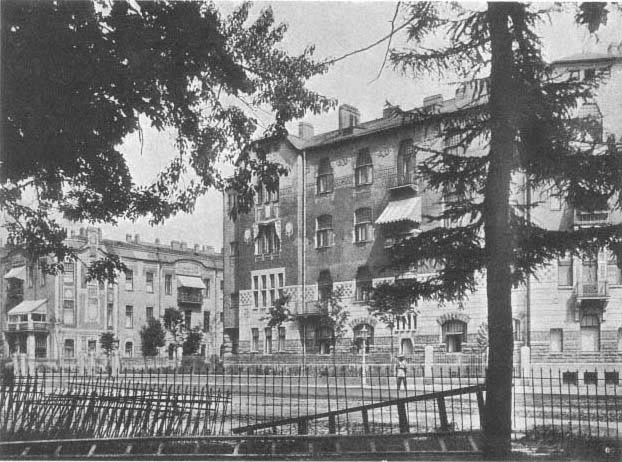
Fig. 181.
Lidval apartment house. 1899–1904. Fedor Lidval. Ezhegodnik Obshchestva arkhitektorov-khudozhnikov , 1906.
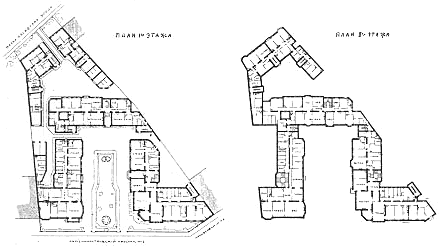
Fig. 182.
Lidval apartment house plan. Ezhegodnik Obshchestva arkhitektorov-khudozhnikov ,
1906.
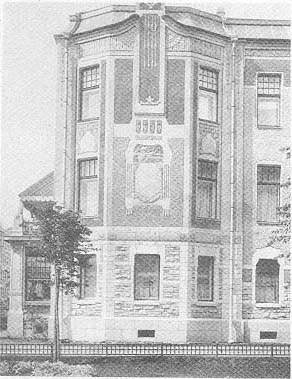
Fig. 183.
Lidval apartment house, detail. Ezhegodnik Obshchestva
arkhitektorov-khudozhnikov , 1906.
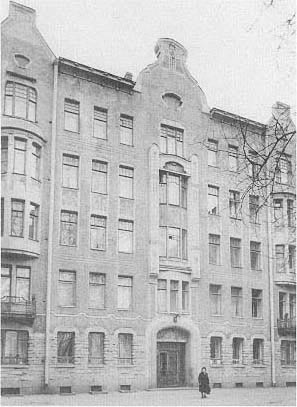
Fig. 184.
Lidval apartment house, central courtyard facade
(Brumfield L70-26).
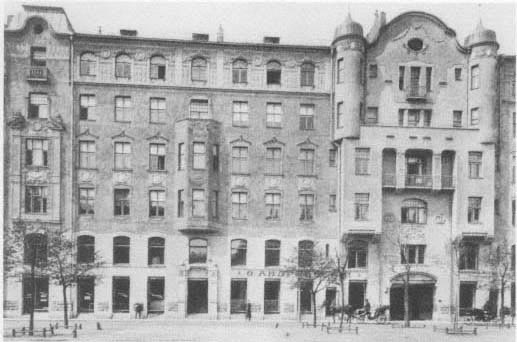
Fig. 185.
Swedish Lutheran Church apartment house. 1904. Fedor Lidval. Ezhegodnik Obshchestva
arkhitektorov-khudozhnikov , 1907.
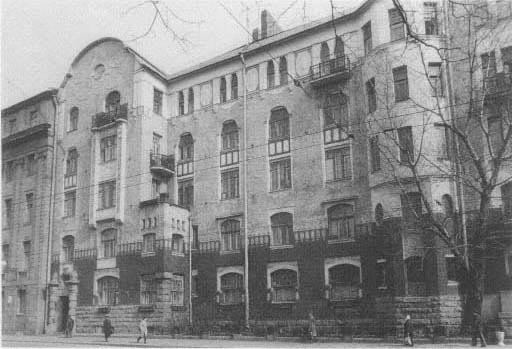
Fig. 186.
Zimmerman apartment house. 1906–1907. Fedor Lidval (Brumfield L73-38).
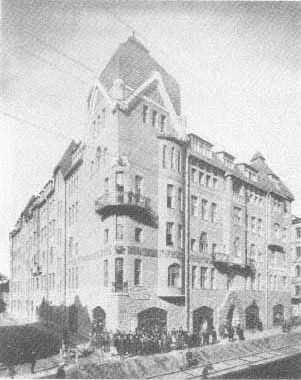
Fig. 187.
Putilova apartment house. 1906–1907. Ippolit Pretro.
Ezhegodnik Obshchestva arkhitektorov-khudozhnikov ,
1907.
style to the superficiality noted by early critics of the moderne. Moreover, because Petersburg architects specialized to an unusual degree, those who built apartments generally did little else, thus increasing the chances for a routine application of a stylistic pattern. By contrast, those who achieved distinction during this period did so primarily with the texture and crafting of building materials rather than with ornament.
Ippolit Pretro (1871–1938?), for example, designed thirty-one buildings between 1902 and 1914, including twenty-eight apartment houses, only one of which is a distinctive example of the moderne. After graduating from the Academy of Arts in 1901, he quickly adopted the new style, rarely rising above technically proficient mediocrity.[10] The notable exception was his apartment house at No. 44 Bolshoi Prospekt (Fig. 187), on the Petrograd Side (1906–1907), built for N. T. Putilova, whose family owned the gigantic Putilov metalworking factory in Petersburg. This massive apartment house resembles contemporary Finnish structures by the team of Eliel Saarinen, Herman Gesellius, and Armas Lindgren. Although none of these architects worked in Petersburg, the proximity of Helsinki and the appearance of major articles on Finland in the architectural press suggest that a shared approach to materials and design was possible. In April 1903, for example, Pavel Makarov published an article in Zodchii on the work of Saarinen, Gesellius, and Lindgren (in addition to other Finnish designers), with photographs of the 1901 building for the Pohjola Insurance Company (Fig. 188).[11] The heavily rusticated stone facing of this structure became a trademark of the Finnish national style in Helsinki (cf. Gesellius's building for the National Museum), and a number of Petersburg architects similarly used the texture of natural stone (usually granite) as a distinctive feature of the northern moderne.
A comparison of the Putilova building with the Lidval apartments on Kamennoostrovskii Prospekt reveals the dramatic sculptural possibilities of stone in Pretro's work. Whereas Lidval's stone base for his roughcast facade is light, both in color and in the modest rustication of its surface, Pretro's is heavy and rough-hewn (the technique is aptly characterized as cyclopean rustication), especially where it frames the building's striking cavelike entrances (Fig. 189). In fact Pretro created an elaborate conceit, masking a modern urban housing complex behind forms evocative of the Dark Ages. (The triangular shapes and the crude arches echo such primitive structures of early medieval Europe as the Saxon Crypts in Britain.)
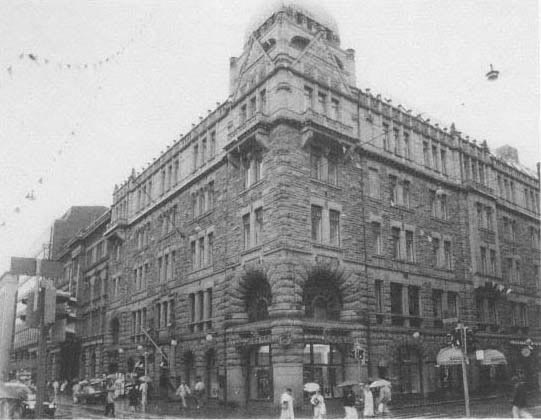
Fig. 188.
Pohjola Insurance Company, Helsinki. 1901. Architects: Eliel Saarinen, Herman Gesellius, and Armas
Lindgren (Brumfield H3-20).
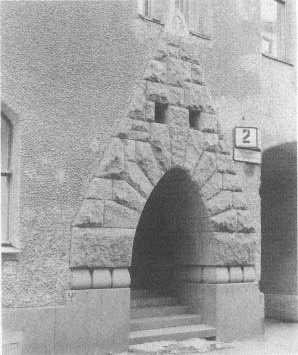
Fig. 189.
Putilova apartment house, detail (Brumfield L89-12).
The conceit itself seems to reflect an emotional fascination—in part a romantic, nationalist reaction to the industrial age—with primal myths and bold primitive expression in the arts. This fascination had ramifications throughout modern European culture, but Russian artists seem to have been uniquely receptive to primitivism, much of it related to the national past and folk art. As Finnish artists and architects portrayed the Kalevala epic (in the decoration of the Pohjola building, for example), Russian architects alluded to the legend and mystery of the northern forests. Shekhtel used these themes in the Glasgow pavilions and the Iaroslavl Station; Pretro, less involved in the decorative arts, placed totemic owls of carved granite on either side of the main entrance to his rusticated structure.
Above the granite of the first floor, Pretro applied gray roughcast that matches the stone and gives a monolithic impression. The windows, devoid of decoration, seem chiseled into the surface; their occasional trapezoidal shape suggests the outlines of windows in the Lidval apartment building (Fig. 190). The most distinctive features of the main facade are the three window bays, whose smooth surfaces contrast sharply with the roughcast walls. Whimsical openings (including a circular window and several narrow apertures) complement the plasticity of these bays, as does their arrangement in diminishing size from left to right: the first extends four floors, the second three, the third two. All end at the roofline, above which rise corner towers with idiosyncratic gables (the left tower originally had a shingled "box" cupola that has since been replaced with a less bizarre, pyramidal, roof).
The site of the Putilova building, though narrow, is unusually deep. Pretro's plan includes the usual interior courtyards (with some creative modifications), but on the side-street facades Pretro developed the shape and texture of materials with the same ingenuity he had applied to the main facade (Figs. 191, 192). On the side facades the rough stone surface along the ground floor has been removed, except for the triangular portals, thus revealing the superficiality of the stonework. Yet because of the durability of the roughcast surface used in Petersburg at the beginning of the century, the exterior has withstood time and the elements remarkably well.
Indeed, few structures used the roughcast technique to such impressive effect as the Putilova building; in this respect it exemplifies a feature of the northern moderne. In Moscow, by contrast, brick remained the preferred material for wall surfaces, with such refinements as glazed brick and ceramic panels in the work of Shekhtel. In some cases brick walls were covered with a smooth layer of stucco or stuccoed cement, as in the Levin apartments, by A. K. Gotman; but examples of the rough surface are rare in Moscow, and only the Makaev apartment building demonstrates its textural uses on a large scale (see Fig. 63).
Moscow has nothing to compare with the monolithic, hewn character of the Putilova building, but in Petersburg a number of other buildings approach material and structural mass as Pretro did in his single masterpiece. The combination of rusticated stone and gray roughcast appears in the apartment building designed by Evgenii Morozov for E. K. Barsova on Kronwerk Prospekt (1911). As with the Putilova building, the arched entries are simple, massive forms (Figs. 193, 194). The central arch rests on crouching totemic beasts that seem to derive equally from Aztec architecture and the Pohjola building (the usual carved owls are also present, at the side arches). The structure shows only one facade to the street, but the familiar variations in window shape and projecting bays create a sense of depth and contour. In view of Morozov's skillful handling of the facade, it is curious that he established virtually no professional reputation in contemporary architectural publications. Although he is known to have graduated from the Institute of Civil Engineering in 1889, the Barsova building is the only project attributed to him.[12]
In the design of modern apartment buildings in Petersburg, the work of Aleksei Bubyr (1876–1919) surpasses that of Pretro in approaching structure as a sculpted, textured block. Bubyr, a 1902 graduate of the Institute of Civil Engineering, was inexplicably neglected by the illustrated annuals of the architectural societies, although his name is mentioned in Zodchii in connection with a number of projects during the first decade of the century.[13] He often collaborated as an engineer with Lev Ilin and Nikolai Vasilev. Yet he himself developed a distinctive, if somewhat austere, interpretation of the rationalist side of the style moderne, with equal attention to aesthetics and engineering. He pioneered in the use of reinforced concrete for the walls as well as the floors of apartment buildings; this familiarity with new construction methods is reflected in the free style of even his largest structures.[14]
Although the buildings that he co-designed with Vasilev displayed decorative elements prominently, the apartment house that he built in 1910–1912 at No. 159
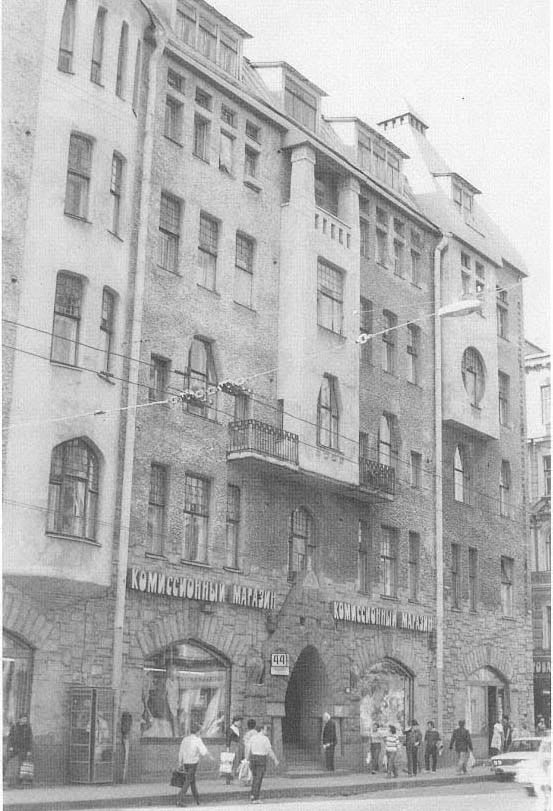
Fig. 190.
Putilova apartment house (Brumfield L89-5).
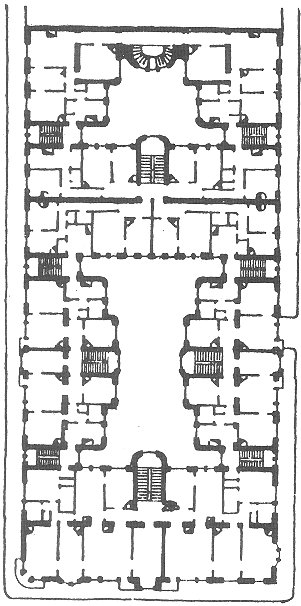
Fig. 191.
Putilova apartment house plan. Ezhegodnik Obshchestva
arkhitektorov-khudozhnikov , 1906.
Fontanka Quay is striking for its lack of ornamentation as well as its massive outline (see Plate 29), which looms above the largest of Petersburg's canals just below the Egyptian Bridge, with its colorful sphinxes of gilded and painted metal. Bubyr used unfinished granite on the lower facade up to the first-floor window ledge. Most of the walls are covered with gray rouchast; but at the top floor and corner bays a smooth light stucco frames the facade, revealing the clarity of line and giving the apartment house a brighter, less forbidding exterior than that of Pretro's building for Putilova. Bubyr emphasized the tectonic character of his building with multistoried win-

Fig. 192.
Putilova apartment house, detail (Brumfield L89-11).
dow bays that intensify the vertical lines of the facade and also provide light for the main rooms of each apartment. The complex roofline begins as a sheet-metal mansard with low, narrow dormers (in effect, a seventh story) and rises at the corners to high gables and pyramids covered with ceramic roofing tiles. Between these forms Bubyr inserted balconies and alcoves.
Besides the apartment buildings he designed or codesigned in Petersburg (none as dramatic as the one on Fontanka Quay), Bubyr constructed theaters, churches, schools, and Petersburg's Institute of Metrology, a project initiated under the auspices of the chemist Dmitrii Men-
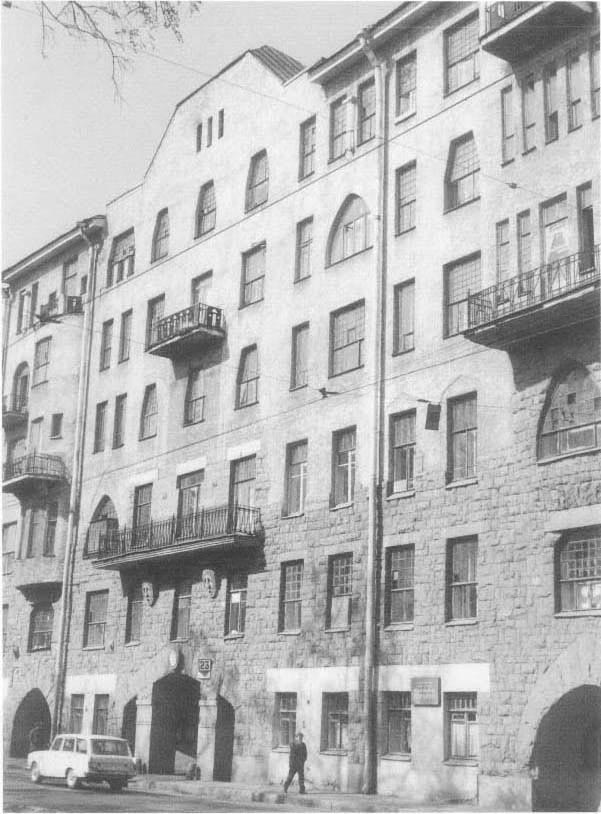
Fig. 193.
Barsova apartment house. 1911. Evgenii Morozov (Brumfield L48-10).
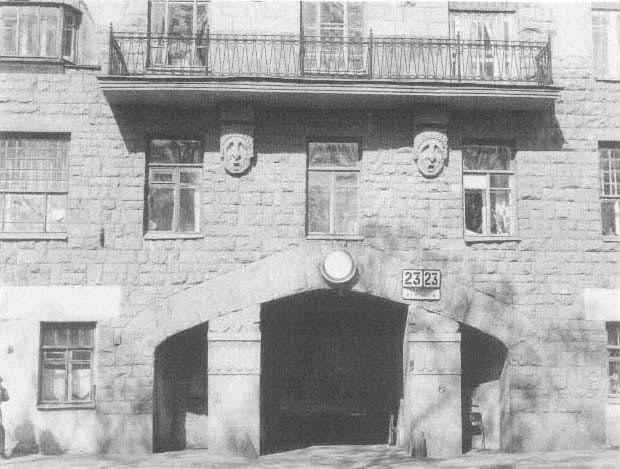
Fig. 194.
Barsova apartment house, main entrance (Brumfield L48-11).
deleev. His practice ranged well beyond Petersburg: between 1910 and 1913, he was active in the Baltic port city of Tallinn (Revel), where he collaborated with Nikolai Vasilev in such style moderne projects as a private house and an apartment building for A. M. Luther, both of which unite the plasticity of the moderne with the high gables of Tallinn's indigenous architecture (Fig. 195).[15] In addition, Vasilev and Bubyr's design for the Estonian Drama Theater (1910) bears comparison with the work of Eliel Saarinen, who was also active in project competitions in both Tallinn and Riga during this period.[16] Although in their creative union Bubyr is assumed to have emphasized engineering and Vasilev the aesthetic detail of the exterior, each was capable of a fully developed architectural statement combining rational structural design and the style moderne.
Nikolai Vasilev (1875–1941) studied with distinction at the Institute of Civil Engineering between 1896 and 1901 and in 1904 graduated from the Academy of Art, where, like other talented architects of his generation, he benefited from the direction of Leontii Benois. Vasilev was not among Petersburg's most prolific builders: with one major exception (the New Passage, or shopping gallery, on Liteinyi Prospekt), he preferred to collaborate with other architects, especially Bubyr.[17] Indeed, large urban projects were increasingly collaborative efforts that required complex engineering and the combined expertise of an architectural team. Vasilev contributed to some of the major architectural works of the period—buildings such as the Petersburg mosque and the department store of the Guards Economic Society, which will be discussed later in this chapter.
In domestic architecture, Vasilev's variant of the style moderne reached its most idiosyncratic expression in
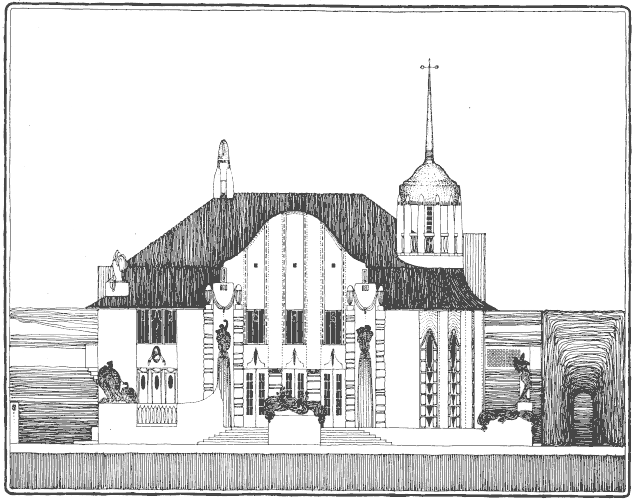
Fig. 195.
Project sketch of Luther house, Tallinn. 1910. Aleksei Bubyr, Nikolai Vasilev. Ezhegodnik Obshchestva
arkhitektorov-khudozhnikov , 1909.
projects that were never realized. His 1906 design for the Ushakova house—its size indicates its intended use for apartments—blends devices peculiar to the moderne, from the juxtaposition of textures to an extravagant emphasis on the plasticity of structure (Fig. 196). The ground floor rustication, its massiveness unequaled in any building constructed during this period, contrasts with the light glazed brickwork of the walls. On the upper part of each facade is a bay of smooth stucco with high gables, large molded balconies, ceramic decorative panels, and windows in various irregular shapes. The steeply pitched pyramidal roof appears to be derived from Shekhtel's Iaroslavl Station.
Like Maliutin's sketch for the Pertsov apartment house in Moscow (see Plate 11), the design for the Ushakova house represents not so much a feasible project as an expression of romantic striving for the color, decoration, and free asymmetrical form of traditional Russian architecture. The Pertsovs found an architect, Nikolai Zhukov, to adapt Maliutin's fantasy to reality; Vasilev himself, however, seems to have incorporated elements from his Ushakova design into an apartment house he built with Bubyr in 1907 on Stremiannyi Street (Fig. 197).[18]
On a more practical level Vasilev helped to plan large apartment complexes, including one with Aleksandr Dmitriev for Kamennoostrovskii Prospekt (1910). His sketches for these projects convey a sense of ensemble
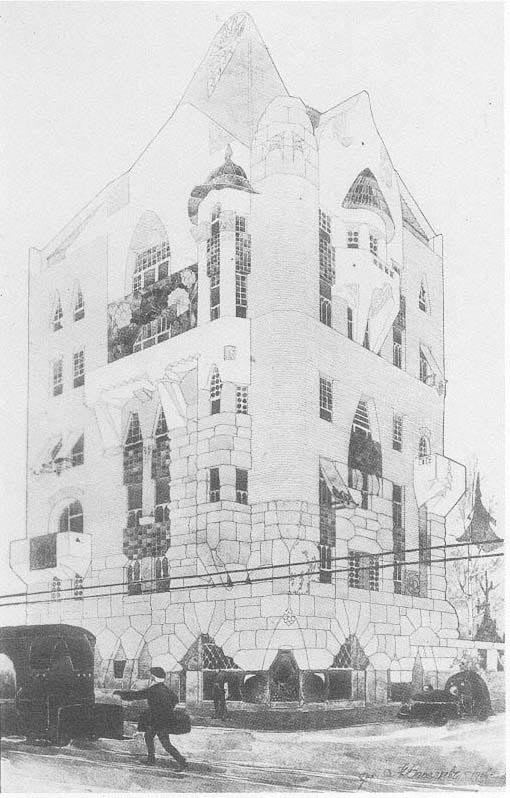
Fig. 196.
Project for Ushakova house. 1906. Nikolai Vasilev.
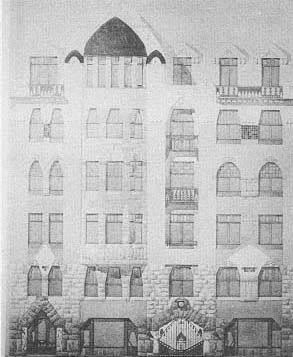
Fig. 197.
Project sketch of apartment house at No. 11 Stremiannyi
Street. 1907. Nikolai Vasilev, Aleksei Bubyr. Zodchii , 1906.
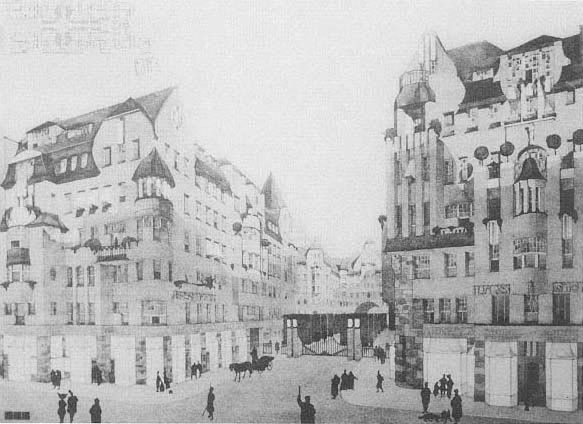
Fig. 198.
Project sketch for apartment complex on Troitskii Street for the Petersburg Merchants' Council. Nikolai Vasilev.
Zodchii , 1910.
and modernity that makes them among the most original visions of Petersburg's development in the new century (Fig. 198). Vasilev also participated actively in the construction of apartment buildings, including a housing complex for the Basin Cooperative Society with Bubyr, Ernest Virrikh, and Aleksei Zazerskii (1912–1917). His project for Kamennoostrovskii Prospekt was unique, however, in the freedom of its style.[19] In 1923 Vasilev emigrated to the United States, where he continued his architectural career, but without the milieu that had given inspiration to his unusual melding of romantic, national elements with modern design. Indeed, that milieu had vanished in Russia itself. Nonetheless, Vasilev remained interested in Russian architecture; his entry in 1931 for the Palace of Soviets competition combined late Constructivism and Art Deco.[20]
Although Vasilev's most advanced designs were not implemented, something of their streamlined, modernist aesthetic appeared in 1910 in a large apartment house at No. 79 Bolshoi Prospekt, designed by Sergei Korvin-Krukovskii. A graduate of the Institute of Civil Engineering in 1899, Korvin-Krukovskii appears to have worked primarily as an engineer on projects designed by others.[21] No. 79, however, one of the few buildings attributed solely to him, was part of the extensive housing development (one of Petersburg's largest) on Bolshoi Prospekt between Kamennoostrovskii and the Karpovka Embankment. A number of buildings were constructed at the same site between 1910 and 1914 (including one by Bubyr and Vasilev); No. 79 is unusual, however, in its discreet classical details—for example, Ionic capitals on the mullions of the curved window bays (Figs. 199, 200). The ground floor has the usual rusticated granite blocks; the remaining five floors are stuccoed in white, with the facade defined by a grid of vertical and horizontal lines below the high gables that flank the recessed central facade. Ornamental flourishes and garlands above the grid suggest the Queen Anne style, as does the Dutch outline of the gables. The contour of the facade represents an attempt to vary an otherwise continuous wall of apartment buildings; from the intersection of Bolshoi Prospekt and Kamennoostrovskii Prospekt the building conveys the impression of an ensemble of houses, rather than the unbroken horizontal perspective.
In both concept and appearance, the apartment house by Korvin-Krukovskii approximates Vasilev's picturesque, romanticized architecture; in the adjacent buildings by Rozenshtein and Belogrud, however, a revival of historicism predominates. For all the emphasis on texture and contour in the designs by Petersburg architects, there is little evidence of their innovative use of building materials. An exception is the 1911 apartment house by Karl Baldi on Bolshaia Dvorianskaia Street (now No. 21 Kuibyshev Street). Although its firm horizontal outline is not especially inventive—indeed, it was designed to create a continuum with its undistinguished neighbors—the facade suggests a new aesthetic in the use of glass and iron (Fig. 201). Three semicircular bays break the horizontality; on either side of the central bay are five smaller window bays in which a shaft of glass and metal extends from the third to the fifth floor. Although hardly revolutionary, the design is unusual in Petersburg, and only a surfeit of decoration obscures the functional union between material and design (see Plate 30). The shafts are unornamented apart from a modest scroll in the middle of the metal casing that separates the bays. The windows in the masonry part of the facade are also largely devoid of decoration; but it is the glass bays that bring natural light into the interior according to a new standard in Russian architecture.[22] Shekhtel, in his Shamshin apartment building, and Baldi were pioneers in the rationalist design of walls as membranes transmitting light to the interior of a structure. At the same time, neither architect possessed the building technology and materials suitable to skeletal construction and its open walls.
The northern suburbs offered the space for what was Petersburg's last major construction site. The development of Bolshoi and Kamennoostrovskii as well as adjacent streets on the Petersburg Side therefore provides a concentrated sampling of the new architecture. At least one other major housing project (New Petersburg) was planned shortly before the outbreak of war; but the speculative apartment buildings in the style moderne and in the classicized variant that superseded it met only a fraction of the city's housing needs. The extensive subdividing of these relatively spacious apartments after the revolution reveals not only the economic decline of the time but also the disparity between the nascent middle class for whom they were built and the much larger population that could not possibly afford to live in such buildings.
There were, however, limited attempts to design new workers' housing, most notably the Harbor Workers' Village (Gavanskii rabochii gorodok ) built by Nikolai Dmitriev at the western end of Vasilevskii Island. Dmitriev, a graduate, in 1876, of the Petersburg Construction School (shortly before it became the Institute of
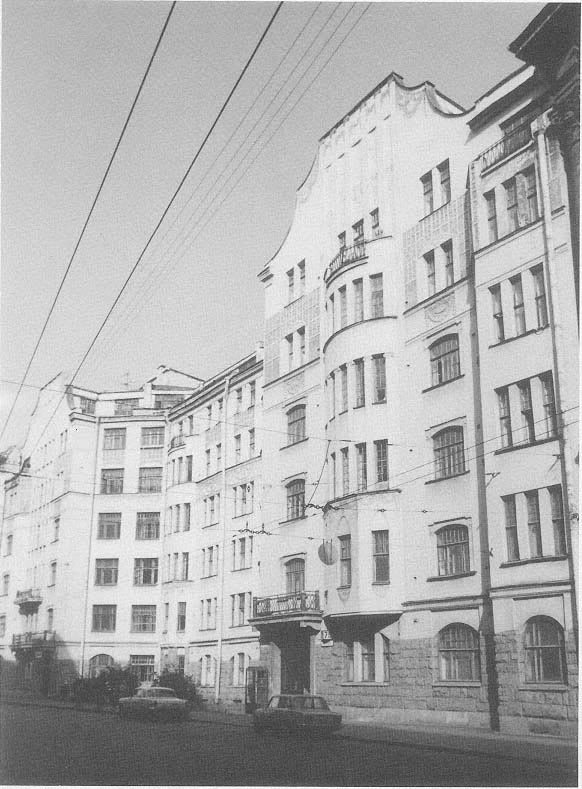
Fig. 199.
Apartment house, No. 79 Bolshoi Prospekt, Petrograd Side. 1910. Sergei Korvin-Krukovskii (Brumfield L89-33).
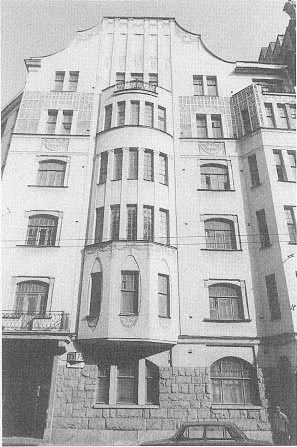
Fig. 200.
Apartment house, No. 79 Bolshoi Prospekt, detail
(Brumfield L89-32).
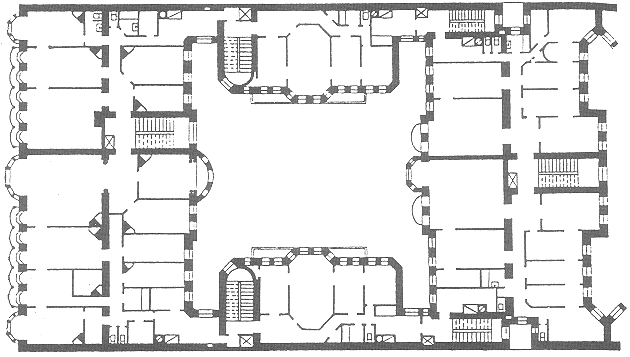
Fig. 201.
Apartment house, No. 21 Bolshaia Dvorianskaia Street. 1911. Karl Baldi. Plan.
Civil Engineering), represented the older generation of architects at work in Petersburg at the turn of the century. His buildings from the 1880s and 1890s follow a more restrained, "rational," version of eclecticism, with little stucco ornamentation. His large complex projects intended to fill social needs include the Building for the Care of Widows and Orphans (1887–1890s) and his integrated design for the A. F. Marks publishing house (1898–1899), which comprised a technologically advanced printing plant, apartments, and educational facilities.[23] Brick in various colors and textures was used on the exterior of this large building, but the facade followed the usual Petersburg pattern of eclectic decoration and rows of windows separated by pilasters and a string course.
Dmitriev's concern with housing assumed a more definite character when he began to participate in the Society for the Construction and Improvement of Housing for the Needy Population. After traveling to Western Europe to investigate the housing question, Dmitriev lectured before the society in 1903 on his findings, which were published as a booklet, The Struggle with Housing Needs .[24] The five buildings of the housing project in which he attempted to implement his views—begun in 1904 on Vasilevskii Island—included housing, shops, and service units.[25] The undeveloped area chosen for the project allowed a spacious arrangement that eliminated the unhygienic enclosed courtyard typical of Petersburg's overpopulated housing blocks.
The style of the Harbor Workers' Village represents a radical departure from Dmitriev's previous eclectic designs. Although the buildings display none of the flamboyant decorative devices of the style moderne, the project nonetheless belongs to the new style because it clearly defines the contrasting properties (textures) of the brickwork and stuccowork and rejects eclectic detail (Fig. 202). The windows in Dmitriev's project form a symmetrical pattern of rectangles arranged in vertical shafts; stucco pilasters delineate the main bays and frame the corners of each building. The union of decoration and function is most clearly expressed on the plain stucco cornice, where carved wooden consoles are placed in pairs under both the eaves and the pitched gables common to domestic architecture throughout the West during this period—from English cottages to the American Gothic. The appearance of such Western architectural details became increasingly common in Russia at the beginning of the century, particularly in detached homes (cf. Fig. 86). Dmitriev was familiar with recent Western European domestic architecture and adapted its idioms to Russian needs. A comparison of the Harbor Workers' Village with London County housing projects, such as the red-brick Millbank estate, suggests the Russian assimilation of Western standards as well as the distance between the rationalist aesthetic in English public housing and the Russian insistence on linking aesthetic design to decorative motifs, however restrained.
Dmitriev's success in building the workers' village could not be readily duplicated. Despite the integrity of his design, which resulted in a group of buildings that to this day function as Dmitriev intended, the scale of the project and its economic base were inadequate to the need for new low-cost housing for Petersburg. The situation was discussed during a meeting of the Petersburg Society of Architects at the beginning of 1907. The main speaker, Mikhail Dikanskii, a leading Russian specialist on urban planning, analyzed the measures taken in England, Germany, and America to produce affordable and humane workers' housing.[26] After Dikanskii's presentation, the president of the Society for the Construction and Improvement of Housing, D. A. Dril, spoke of the dismal and worsening situation in Petersburg.[27]
To illustrate, Dril assessed Dmitriev's model project on Vasilevskii Island, noting that even under the most favorable conditions, Russian society was not prepared to mobilize the resources necessary to create decent urban housing. The Harbor Workers' Village had been sponsored by Dril's organization and the Society for the Preservation of the People's Health, which, Dril noted, was interested in the problem of alcoholism and its relation to unhygienic and overcrowded workers' housing.[28] Both the state and the city had offered low-interest loans, and the plot of land had been purchased "extremely cheaply" from Princess Saksen-Altenburg. Here the "forces of culture" had joined to subsidize housing that would raise the standard of living and, in turn, promote a more civilized existence for the working class.
Despite its architectural virtues, Dmitriev's project revealed how weakly and inefficiently the existing system addressed the extensive social problems Dril described:
Unfortunately society itself reacted slowly to this new business: despite wide publicity, we did not succeed in interesting the broader circles of society. Indeed, the side most involved presented even less favorable ground; for if society itself revealed only indifference, the workers and needy people displayed complete mistrust and an inability to accumulate financial resources to achieve
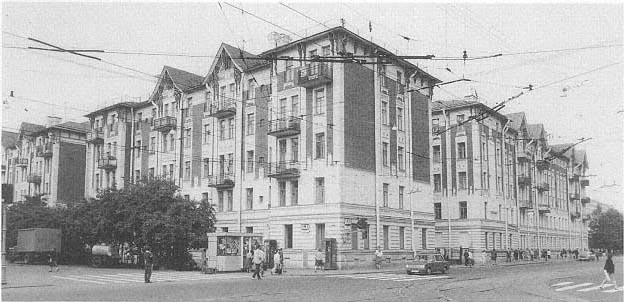
Fig. 202.
Harbor Workers' Village. 1904–1908. Nikolai Dmitriev (Brumfield L89-36).
their own well-being. With around five hundred members of the enterprise, the number of renters who could afford the village on their own resources did not even reach two dozen. It is true that the purchasing power of the Russian worker is insignificant, and however small the rents in the gorodok [village]—from 4 R 30 k for a room and from 7 R 40 k for an apartment—they require from one-third to one-fifth of his wages.[29]
Dril demonstrated that good housing design was inadequate without a major economic restructuring that would, above all, increase the availability of cheap credit from both government and private sources. The following speaker, L. B. Skarzhinskii, expanded on this point by describing credit plans for workers' housing in Belgium, Germany, and Warsaw. Dril had implied, however, that massive subsidies for housing construction would be insufficient unless better wage rates enabled tenants to pay the monthly rent.
In its modest way the discussion following Dikanskii's lecture comments on the possibilities for Russia's economic, political, and social evolution on the eve of the First World War.[30] While pragmatic optimists like Dikanskii expected "young Russia" to draw on the experience of more developed countries to deal with its "incredible" poverty, economic realists like Dril could only point to structural obstacles in the path of improvement. As for Dmitriev's Harbor Workers' Village, it offered more than the usual amenities for low-cost housing, which perhaps explains why work on the project lasted from 1904 to 1908. Dikanskii's own assessment of the gorodok as "the pearl of Russian creativity in this area" also implies it rarity.[31]
The aestheticism of these buildings (which, incidentally, limited their feasibility as models for large-scale housing) suggests an attempt to sweep the proletariat into a new state of middle-class existence—or, in Dril's words, to "raise the well-being of the needy." This improvement could not have occurred under existing conditions in Russia. The benefits of apartment housing in the new style in Petersburg accrued only to the developing middle class, as had been predicted at the Second Congress of Russian Architects in 1895.[32] Whether architects might have done more to solve the housing problem is a moot point in view of the circumstances under which they worked; in any event, the solid apartment houses they built before the war were eminently serviceable after the revolution.
As for the opposite, moneyed, end of the spectrum, apartment construction in Petersburg proceeded so rapidly—stimulated by new money, increasing demand, and limitations on urban space—that one might wonder
whether the detached house was even a factor in the development of the northern moderne. Nonetheless, the relatively few private houses built in Petersburg during this period offer some of the most innovative examples of the new style.
To build a mansion in Petersburg proper was an extravagance on a scale beyond that of building all but the most lavish Moscow mansions, and the greatest concentration of freestanding houses in the moderne appeared in such suburbs as Stone Island or in prosperous dacha communities. The Gausvald dacha (see Fig. 212) by Chagin and Schöne, one of the earliest examples of the new European style in Russian architecture, was soon followed by other variants of the moderne in the neighboring lanes of Stone Island, to be discussed later in this chapter. The few mansions constructed within the city, however, illustrate both the development of the new style and its economic support among wealthy entrepreneurs.
One of the architects of these mansions, Karl Shmidt (1866-?), designed a series of major projects in Petersburg—from apartment, commercial, and educational buildings to dachas and private homes.[33] An 1893 graduate of the Academy of Arts, Shmidt assimilated the rationalism of the Petersburg "brick style" in its waning days and adapted it both to improved construction technology and to the decorative motifs of the style moderne. In the designs for two of his Petersburg mansions at the turn of the century Shmidt, like Shekhtel, applied modernized Gothic elements.
Shmidt's house for V. V. Tiess, built in 1897, is the more superficial of the two, with "Gothic" ornamentation and a picturesque corner tower superimposed on a polychrome structure of ceramic tile and brick. The second house is of greater architectural and social interest. Built in 1900–1901 on the Fourth Line of Vasilevskii Island, the building was intended not only as a dwelling for P. Forostovskii but also as a storage facility and shipping office for the family mercantile operations. The complex plan, with several wings and entries, consisted of a large basement for storage (a considerable technical feat in view of the island's high water table), a first floor for business and service quarters, and the family living area on the second floor, which included a conservatory and an entire wing of rooms for the children.
In his design of the exterior of the Forostovskii mansion (Fig. 203) Shmidt freely interpreted the Gothic style, emphasizing the plasticity of the masonry with a projecting tower and curved entryways and opening the walls with large window bays—as Shekhtel had done in the houses for Zinaida Morozova and the Kuznetsovs. The result resembles contemporary structures in Paris and Nancy, although Shmidt shaped his material less flamboyantly than French architects. The main facade was surfaced with yellow imported brick (which usually came from Germany, where technological advances in brick making produced a polished surface much desired by Russian architects with money to spend).[34] The base was of red granite, as was much of the stonework, with molded window details of cement stucco (the "artificial stone" used extensively by Kekushev) and majolica tile panels—also imported—which separated the large windows of the first and second floors.
In a brief article written for Zodchii during the construction of the house, the architect noted both the technical aspects of the project and his careful attention to the needs of the family. The public or business rooms were isolated from private family rooms like those in the children's wing, whose main windows were on the "sunny side," overlooking a garden court.[35] The appearance of this self-contained merchant enclave in the center of Petersburg is ironic, for its purpose and design seem to derive clearly from the Moscow tradition of enclosed merchant "courts" exemplified in the nineteenth century by the Tretiakov family compound that became an art museum.
The expansion of Russian business empires had made these agglomerations of living space, offices, and storage—with various outbuildings attached to the main structure around a courtyard—quaint and outmoded. But the design suited the modest fortune of the Forostovskiis, who spent 180,000 roubles on the project—more, apparently, than Nikolai Dmitriev spent on the entire Harbor Workers' Village.[36] After completing this anomalous undertaking, Shmidt turned his attention to larger structures, among them an apartment building of his own (1901–1902), into which his family moved. Like Lidval, he wished to profit directly from the boom in apartment construction, and he had the financial resources to do so. At the same time, he built a large apartment house with a polychromatic brick facade for G. A. Shults on the Petersburg Side (Bolshaia Dvorianskaia Street) and continued to work in this area through the beginning of the next decade (Fig. 204; see Plate 31).
The most luxurious application of the style moderne to the design of a private house in Petersburg is located
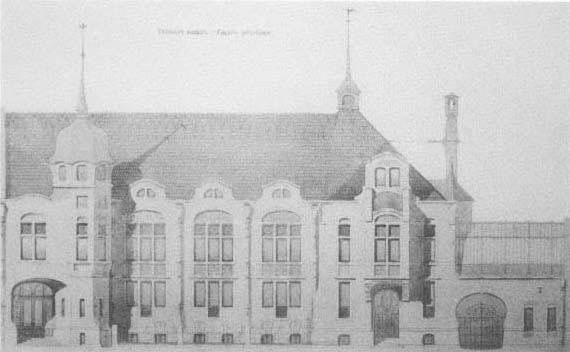
Fig. 203.
Forostovskii house. 1900–1901. Karl Shmidt. Zodchii , 1901.
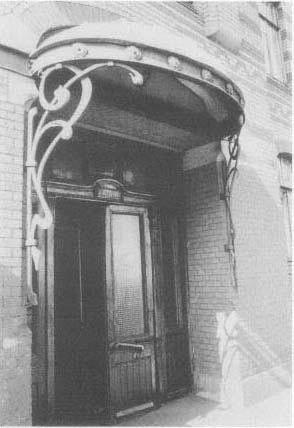
Fig. 204.
Shults apartment house, detail. 1901–1902. Karl Shmidt
(Brumfield L84-29).
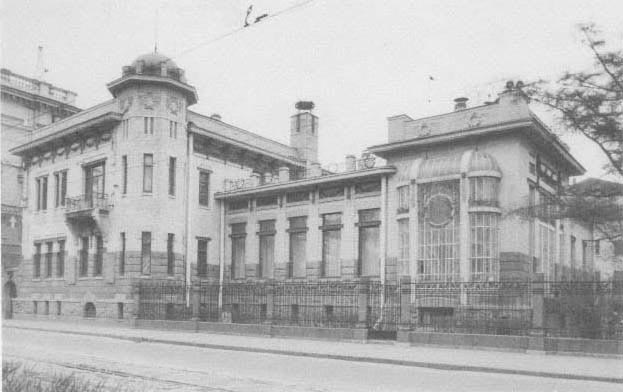
Fig. 205.
Kshesinskaia house. 1904–1906. Aleksandr Gogen (Brumfield L57-19).
on Bolshaia Dvorianskaia, not far from the Shults building. Designed for the prima ballerina Matilda Kshesinskaia by Aleksandr Gogen (von Hohen, 1856–1914), the mansion suggests a determined reinterpretation of contemporary Viennese architecture as defined by Otto Wagner and the Secession.[37] Although Zodchii published no information on the cost of this mansion, the quality of the materials and construction seems without equal among private houses in Petersburg at the time (construction began in 1904; the building was completed in 1906). Gogen's design emphasizes a precise use of material. Not even Shekhtel's great houses, for Stepan Riabushinskii and Aleksandra Derozhinskaia, display a rectilinearity of structural outline and detail as uncompromising as that of this severely elegant building (Fig. 205).
The rigorous exterior form is not altogether in harmony with Gogen's interior. Because Kshesinskaia maintained close relations with the imperial court (she had been Nicholas's mistress before his marriage and accession to the throne) as well as a position in the theatrical world, she entertained lavishly. Thus Gogen, like Shekhtel in his commission for Derozhinskaia, had to combine a family dwelling with a grand social space. He did not, however, create a central core for the structure, nor did he devise a coherent decorative pattern for the interior. Each of the main rooms on the first floor (arranged in two rows: vestibule, great hall, conservatory; dining room and two living rooms) expresses the owner's expensive tastes in a decor derived from period styles—as in mansions and palaces built two decades earlier.[38]
The second-floor family rooms are arranged along an axis perpendicular to that of the enfilades below and do not in fact extend over the high-ceilinged main rooms of the first floor (Fig. 206). The scale of luxury did not lessen in this private area, where Kshesinskaia's bedroom and bath occupy almost a third of the space. The main staircase between the two floors leads directly to the large door of her bedroom.[39] Varvara Morozova and Aleksandra Derozhinskaia notwithstanding, no mansion in Moscow testified so clearly to the will and convenience
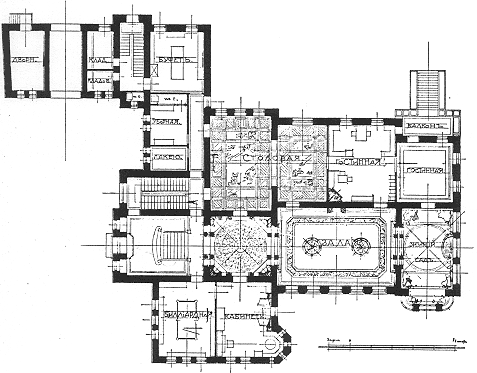
Fig. 206.
Kshesinskaia house plan, main floor. Zodchii , 1905.
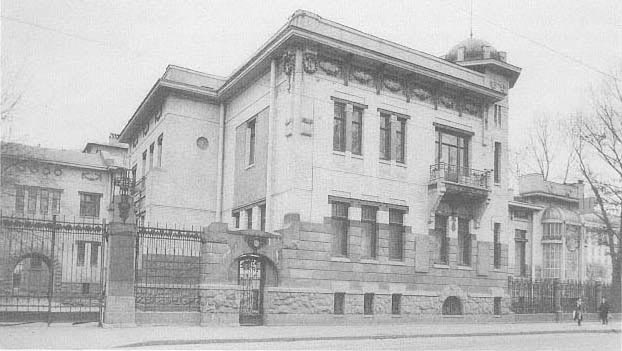
Fig. 207.
Kshesinskaia house (Brumfield L57-18).
of the patroness. Although Gogen lacked Shekhtel's ingenuity, he understood his function as creator of a space commensurate with Kshesinskaia's role in Petersburg society. (He may have come recommended to Kshesinskaia through his own connections to the imperial family, which he served until his death in 1914.)[40]
Gogen interpreted the new style on the exterior of the house coherently, if austerely. Although the architecture has been criticized as "dry, cold, uninviting," and not to be compared with the Riabushinskii house,[41] Gogen uses material, texture, and ornament to relate structure and decoration. The materials of the walls are progressively refined, from a rough stone base to a rusticated granite facing to a surface of pale yellow pressed brick (Fig. 207).
Gogen's decorative work on this durable facade, by Moscow standards, is indeed dry and cold, muted in color, and dominated by heavily articulated ironwork: iron garlands on a dark ceramic tile frieze segmented by large wrought-iron consoles; iron wreaths on the corners of this street facade and the upper walls of the entrance courtyard; and an iron fence whose sole decoration is an abstract floral motif. Every section of the mansion has ornamental ironwork in the linear patterns of the Secession—from the cupola railing to the iron clasps on the granite pylons at the main courtyard gate. Gogen also used iron structurally in the lintels of the front windows, as Shmidt had three years earlier in his apartment building for G. A. Shults, two blocks from the Kshesinskaia house. More noticeable still is the curved glass and metal bay of the conservatory.
The formidable character of the Kshesinskaia mansion, whatever the intentions of architect and owner, seems to symbolize the increasing isolation of the imperial court and its followers from the rest of Russian society at the beginning of the twentieth century. Although the house was designed in 1904, its fortresslike plan seems like an oblique response to revolutionary disorders at the time of its construction. There is no direct access to the building from the street: the two main entrances are both in the courtyard. The use of glass and the large balcony on the street facade, however, provide communication with the outside; Vladimir Lenin in fact delivered a number of radical speeches from the requisitioned Kshesinskaia house during the spring of 1917.[42]Aedificia habent sua fata .
Gogen's interpretation of the modern style was in some respects exceeded in the house Vladimir Apyshkov designed for the financier S. N. Chaev (1906–1907). (Apyshkov's work as a discerning critic of the style moderne is discussed in chapter 2.) Unlike most writers who supported the new style, he was an accomplished architect and engineer capable of applying theoretical principles to his own work. Nonetheless, he devoted most of his career to teaching (an occupation he continued after the revolution at the Academy of Military Engineering) and was not a prolific builder.[43] The complex plan of the Chaev house therefore can be viewed as a somewhat abstract statement of the possibilities of the new style (Fig. 208).
Like the Riabushinskii house, the Chaev house reveals a consistent logic in development from an interior core to the exterior surface. But Apyshkov interpreted the centralized plan more rigorously than Shekhtel, as if he meant to test a theory. In this respect Apyshkov was well served by his patron's insistence that the house have no "dark or even half-dark corridors."[44] Apyshkov's solution was to create an "atrium"—a circular hall extending from the first floor through the third—to illuminate the central area of the house. All rooms communicate in one way or another with this hall, which had galleries on the two upper floors (Fig. 209).
The hall in itself qualifies the Chaev house as a radical experiment in Petersburg; but Apyshkov's design is still more ingenious: the second-floor gallery was built as a picture gallery, from which one could see the central space as well as the conservatory, which contained the main staircase. One of the most unusual features of the house was the design of the third floor, which contained a large kitchen and laundry. Whereas mansions of this period usually placed such facilities either in a wing off the main living and dining areas or in the basement (as in the Kshesinskaia house), Chaev stipulated that they occupy the uppermost floor to "prevent odors associated with such spaces from penetrating the reception or living rooms."[45] Such fastidiousness did not, apparently, extend to the servants' quarters, where the dining area, in the third-floor gallery, consisted of a narrow table attached to and encircling the gallery railing. The translucent glass plates of the floor allowed light into the picture gallery below (the servants' dining hours must have been very restricted).
The centralized plan of the Chaev house involves additional circular areas that link the components of the blocklike structure. The rooms are grouped around a circular core—one of three rounded spaces on an axis that runs diagonally through the structure. The smallest is the tower, which has an entrance from the courtyard
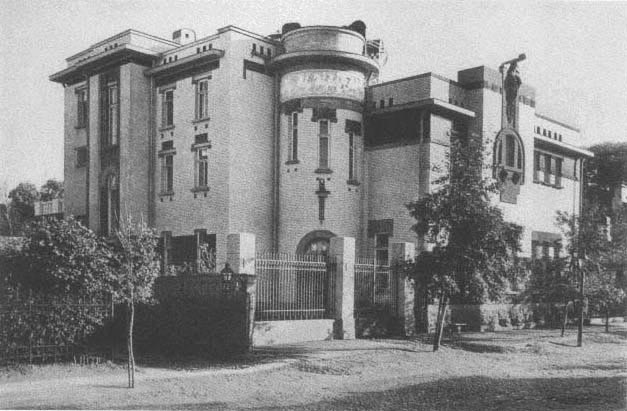
Fig. 208.
Chaev house. 1906–1907. Vladimir Apyshkov. Zodchii , 1908.
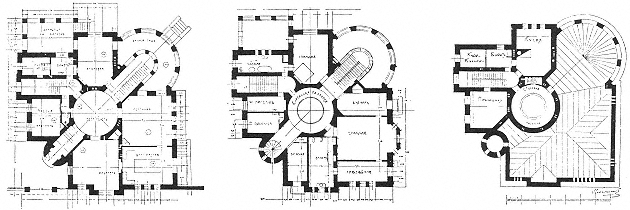
Fig. 209.
Chaev house plan. Zodchii , 1908.
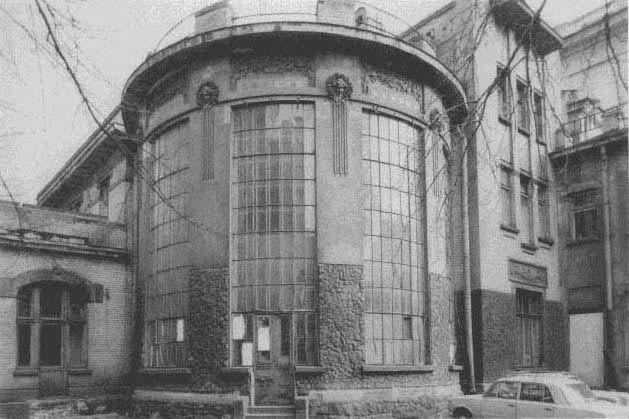
Fig. 210.
Chaev house, conservatory (Brumfield L70-17).
to the central vestibule. The main stairway of the house is in the conservatory at the opposite end of the diagonal, in a much larger cylinder of glass and iron that looks over the back courtyard (Fig. 210). Residents and guests proceeding from one floor to the next ascended through an illuminated tropical garden, with a special ventilation system that prevented the moist air from pervading the house. This play of cylinders and circles suggests the far more radical, if less luxurious, design by Konstantin Melnikov for his own house some two decades later.[46]
Apyshkov did not, however, achieve the aesthetic harmony that characterized Shekhtel's work for his Moscow patrons. Despite the panache of modernity evident in the Chaev house and much of its interior design, three of the main rooms of the house were elaborately decorated in period styles (Louis XVI and Empire) to match the Chaevs' furniture. The other rooms, according to the correspondent from Zodchii , "followed the principle of simplicity—smooth ceilings with simple cornices that do not gather dust; smooth stuccoed walls."[47] A list of the rare woods and stone used for the walls, doors, and balustrades suggests that this "simplicity" did not entail a decrease in expense. Indeed, elements of the house unrelated to architecture, such as the tropical growth surrounding the main stairway, all bespoke luxury.
The inclusion of conservatories in Petersburg mansions—the Forostovskii, Kshesinskaia, and Chaev houses each have one—though it may have been simply a fashion, may also reveal different interpretations of the style moderne in the two cities. In Moscow the botanical motif, characteristic of art nouveau generally, is much in evidence, from abstracted curvilinear ornament to the thistles, tulips, irises, and arboreal patterns (as in the library of the Derozhinskaia house) that appear on both the exterior and interior of style moderne houses and apartment buildings around 1900. Apart from a few floral patterns on apartment facades, the Petersburg moderne is considerably less effulgent. Architectural forms
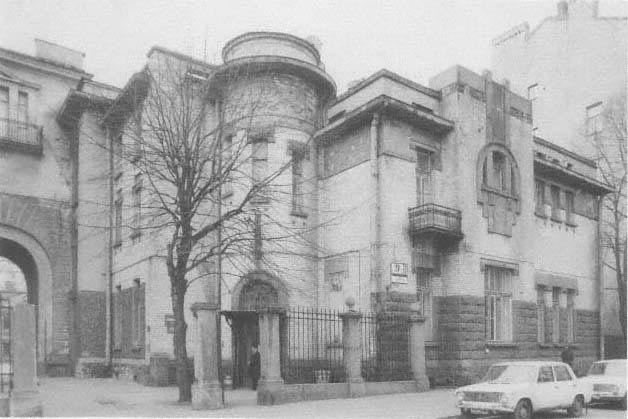
Fig. 211.
Chaev house in 1984 (Brumfield L70-15).
tended toward the rectilinear rather than the curvilinear; even the circular spaces of the central axis in the Chaev house appear as precise geometric abstractions. The plasticity—or fluidity—of the Moscow moderne from 1900 to 1906 is offset in Petersburg by insistent straight lines and corners—two of the most distinctive features of Petersburg's regulated cityscape. The conservatory (or "winter garden" in a literal translation from the Russian) served as an organic antidote to the austerities of modernism in the northern capital.
The exterior of the Chaev house has its decorative elements, as did the Kshesinskaia mansion, which it resembles in its use of contrasting textures: rusticated granite, pressed brick, majolica tiles, and some stuccowork. The flat angularity of the roof and its parapet was originally broken by a streamlined statue of a female nude, poised between two granite pillars above the arched window of the central bay.[48] The statue has been removed, but the stucco frieze of horsemen around the tower is still in place (Fig. 211). Although Apyshkov was able to incorporate Chaev's considerable stipulations for the house into his modern, rational design, the structure as a whole reveals an awkward dissipation of the architect's principles, a deflection from a unified aesthetic purpose. Had Apyshkov built more, perhaps he could have maintained more forcefully the principles he supported as a teacher and critic. The crowning irony in his relation to modernism would occur six years later when he designed a second Chaev mansion (discussed in chapter 6), whose conservative adherence to the neoclassical revival contrasts sharply with the modernism of both his earlier work and that of the neighboring houses on Stone Island.
Stone Island was, in fact, the one area of Petersburg where the style moderne came close to achieving a new aesthetic unity in architecture and the decorative arts—a success due in large part to the island's parklike setting. A resort and dacha community throughout the
nineteenth century, the island began to be developed as a suburb for the wealthy only at the turn of the century.[49] The large lots and rustic ambience encouraged a freer articulation of architectural form than was possible in Petersburg's urban areas. In particular the widespread use of wood for structural as well as decorative purposes provided a flexibility suited to such experiments.
Vasilii Schöne and Vladimir Chagin's dacha for E. K. Gausvald (1898), one of the earliest examples of the new style, was built largely of wood on a foundation of fieldstone, with a one-storied annex of light pressed brick for the main entrance and terraces (Fig. 212). The large sculpted curve of the entrance and its wrought-iron decoration evoke similar details on art nouveau town houses in France and Belgium; the two-storied wooden part of the house, with a steep gabled, tiled roof and large projecting bays, however, permitted considerable latitude in the design of the interior space. The rooms, with their unusual shapes—round, triangular, trapezoidal, and rectangular—are all skillfully related to the landscape. In her description of the house V. A. Vitiazeva emphasizes its openness to a "poetic view" of nature and the stereotomic approach to form that results in multiple picturesque perspectives of the house.[50]
Schöne spent two years designing his next project on Stone Island—his own house, which was to have included an extensive complex of surrounding buildings. The house itself (1902–1904) is the architect's greatest work, an interpretation of domestic architecture equal to that of the best houses of Shekhtel and Kekushev. Schöne's design bears some relation to the English vernacular style—as in the work of Charles Voysey and H. M. Baillie Scott that had received prominent attention in Zodchii at the beginning of the century;[51] well-informed Petersburg architects would probably have known of this style even earlier through British and German architectural publications.
Schöne, like Voysey, drew on certain features frequently associated with vernacular traditions in European domestic architecture, such as the pitched roof and white rendered walls (Fig. 213). The steeply sloping roof (originally tiled), more than half the total height of the structure, determines the outline of the house. Schöne's scrupulous relation of details to the whole of his design is particularly noticeable in the second-floor balcony, which is protected by an extension of the roof. The arrangement is a modification of a gambrel roof, here separated into two planes, with the upper roof overhanging the lower—a device found in traditional Russian wooden architecture. Joseph Olbrich, whose work was also well known in Petersburg, used a similar roof design for the Keller house (1900) at Matildenhöhe; and indeed Olbrich's own house of the same year has details similar to those of the Schöne house. Both architects seem to have drawn on native vernacular traditions, while owing a common debt to the English, who pioneered the vernacular revival.[52]
The gable structure is complex at both ends of the house: at one end, the upper incline projects over a grid of timber beams and encases the upper part of a chimney—a design similar to that of the Keller house, which has a simpler pattern of beams. At the opposite end, with an identical timber grid, the gable encloses a large circular window overlooking a balcony above the second entrance to the house (see Plate 32). Within the circle, a square of wooden beams and latticework suggests the contemporary fashion for oriental elements. The large glass area on this southwest facade takes maximum advantage of the sun, and the conjunction of white stucco walls and the stained wood pattern within the circle exemplifies what the new style could achieve without great cost or pretentious effects.
Schöne built two other projects on Stone Island, neither as complex or inventive as his own house, though both display a similarly modern style of domestic architecture. The house for Iakov Belzen (1903) resembles Schöne's house, albeit in a somewhat simplified form (Fig. 214). The green tile of the steep gambrel roof over the entire second story provided a picturesque contrast to the stuccoed walls of the asymmetrical structure, which had exposed timber beams at the tops of its gables. Nowhere is the vernacular more evident in Schöne's work than in this comfortable barnlike design; yet the Belzen house, even more than Schöne's own, resembles Olbrich's Keller house—the simplest of his dwellings at Matildenhöhe.
In view of Schöne's extensive activity on Stone Island, it might seem that the Petersburg architect had undertaken to construct his own model community—less richly endowed, however, than the one near Darmstadt. (Second-floor studios in both the Belzen and Schöne houses—as in Olbrich's designs for his artist colleagues—were illuminated by large windows on the south facades.) In 1904, Schöne began work on a complex of buildings for G. A. Gau. Because the main house was altered substantially after the prominent pediatrician Karl Rauchfuss purchased it in 1915, only the service structures surrounding the house convey the archi-
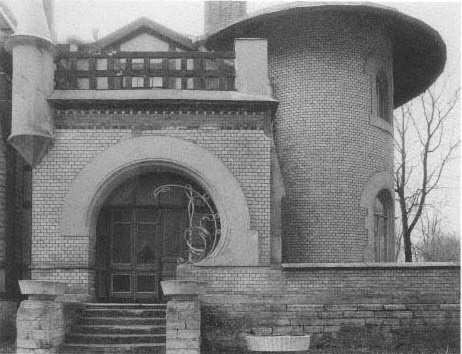
Fig. 212.
Gausvald dacha, Kamennyi Ostrov (Stone Island). 1898. Vasilii Schöne, Vladimir
Chagin (Brumfield L72-36).
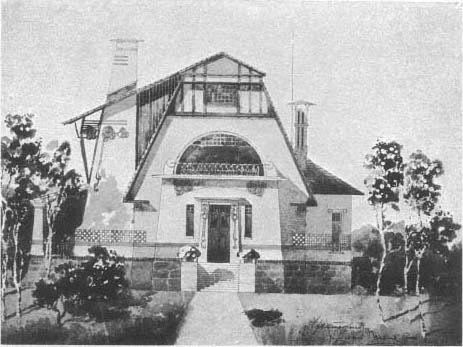
Fig. 213.
Project sketch for Schöne house, Stone Island. 1902–1904. Vasilii Schöne.
Ezhegodnik Obshchestva arkhitektorov-khudozhnikov , 1906.
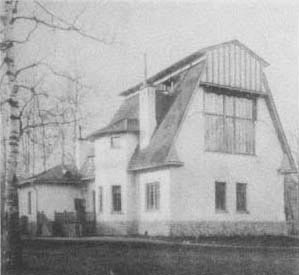
Fig. 214.
Belzen house, Stone Island. 1903. Vasilii Schöne.
Zodchii , 1906.
tect's original design. In their modest scale they reveal the compatibility of vernacular domestic architecture and Schöne's approach to the new style. Wooden buildings like the carriage shed and the keeper's lodge display elements of a traditional rural style, but Schöne also gave them the steep roofs, broad eaves, battered chimneys, and curvilinear wooden shapes of his larger houses.[53]
By the time the Gau estate was completed, in 1907, Schöne was designing not individual dwellings but apartment buildings, including three constructed in partnership with the technical engineer Ivan Artemev in 1912–1913. But the end of Schöne's work on Stone Island did not mean the end of the style moderne there, as is demonstrated by the two houses built by Roman Meltser (1860–1929),[54] a graduate in 1884 of the Academy of Arts. Meltser was active in interior design as well as architecture; his enterprises ranged from commissions for the imperial court to the production of affordable furnishings for the middle class. In each case he drew on the resources of the large interior furnishings factory founded by his father Friedrich Melzer. From 1885 to 1888 he worked under the supervision of the Court architect Nikolai Gornostaev, creating exterior ornamental ironwork for the Winter Palace, including the massive gates at the main entrance, facing Palace Square. It is generally assumed that he was involved in renovating a number of the palace rooms during the 1890s, though scholars have recently questioned the extent of his work.[55] In 1899 he designed a wrought-iron fence for the park at the southwest facade of the Winter Palace.
Meltser built his first house on Stone Island for himself, between 1901 and 1904. Located opposite Schöne's house, the dwelling reveals a different aspect of the style moderne, but one just as firm as Schöne's in its reference to vernacular architecture. In Meltser's house the style is related not to British or Central European models but to the traditions of northern Russia and of Finland, whose arts and crafts revival was easily accessible to Petersburg designers (Fig. 215). The fieldstone lower walls on two sides of the house (the other sides are red brick) contrast with the upper walls of logs, as in the rustic exercises of contemporary Finnish architects—most notably, Saarinen, Lindgren, and Gesellius at Hvitträsk, completed in 1902. Meltser's work as well as that of the Finnish architects was displayed at the 1900 Paris exhibition.
Other elements of Meltser's design, such as the large carved sunburst over the main entrance, resemble Maliutin's work at Talashkino, also exhibited in Paris. Maliutin's teremok (ca. 1900) for the Tenisheva estate at Talashkino resembles the Meltser house structurally, with its rounded log walls over a brick base, carved bargeboards, and decorated gables (see Fig. 72). The visual impact of the Meltser house derives from both the contrasting materials of its walls and its great height; a battered brick chimney towers above the structure's steeply pitched roofs at the very center. Although the rectangular rooms are arranged in a relatively simple
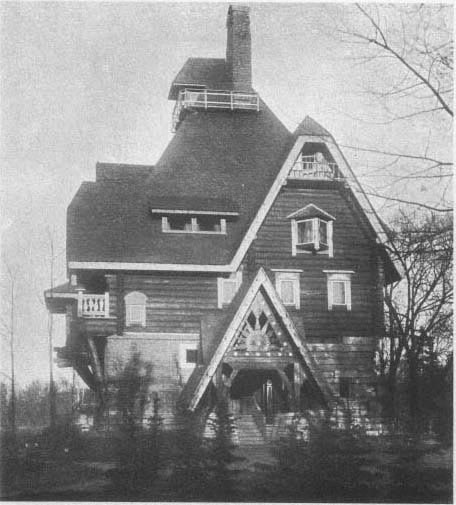
Fig. 215.
Meltser house, Stone Island. 1901–1904. Roman Meltser. Ezhegodnik Obshchestva
arkhitektorov-khudozhnikov , 1906.
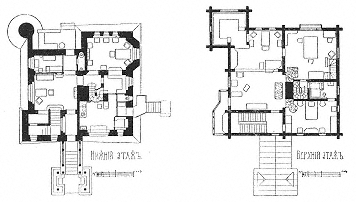
Fig. 216.
Meltser house plan. Ezhegodnik Obshchestva
arkhitektorov-khudozhnikov , 1906.
plan, the chimney and adjacent spiral staircase form a core that represents yet another variant of the centralized structure that figures so large in the style moderne (Fig. 216).
From its multitude of balconies, its dormer windows, and its aerie at the summit of the main pyramidal roof, the Meltser house provides views of the forested park with ponds and canals on three sides of the building. The original furnishings were chosen for domestic comfort and adaptability to the rustic surroundings; the furniture ranged from simple padded leather armchairs to wooden chairs and tables that adapted traditional Russian motifs to the style moderne.[56] In addition to the rustic furniture and the wall hangings of the living room (Figs. 217, 218), the interior decoration included ceramic tile stoves and carvings on the log structural elements. Like the architect-artists Sergei Maliutin and Viktor Vasnetsov, Meltser drew on the rich tradition of Russian folk art for modern domestic design.
The second house Meltser constructed on Stone Island actually began in 1903 as Vasilii Schöne's project for E. G. Vollenweider. In the spring of 1904, a year after approving Schöne's plan for the house and grounds, Vollenweider transferred the project to Meltser, who was then almost finished with the structural work for his own house. Although Meltzer's success with his house may have motivated Vollenweider's change of mind, the design the architect created for his new client differs substantially from that of his own house, apart from its asymmetry, its soaring roofline, and its rusticated granite blocks on the lower walls (Figs. 219, 220). The white exterior walls—now repainted a dull gray—and the curved pyramidal roof at the center of the front facade gave the house its descriptive name, the "sugar loaf." These features, together with a dark-red tile roof and high battered chimneys, suggest the freestyle domestic architecture of Britain. Meltser's approach, nonetheless, differed considerably from that of Schöne, who seems to have used Olbrich as an intermediary in assimilating the vernacular style.
The emphasis on plasticity and freely modeled form appears in the tower at the northwest corner overlooking a wide terrace; the central "sugar-loaf" tower, with its own arched gable at the front; the bay and arch of the south facade; and various other balconies, recesses, and extensions that give the walls a chiaroscuro effect. The placement of windows, many of which contain stained glass, accentuates the structure but also provides the views of the landscaped island's park and waterways important for all the houses by Schöne and Meltser on Stone Island. (The large windows and balcony of the south facade of the Vollenweider mansion overlook the Great Canal, which bisects the island.)
The spacious interior of the house has the same comfortable informality of other houses by Schöne and Meltser, with particular emphasis on living space for the family and relatively little on rooms for social occasions. The plan includes a conventional corridor, with the main staircase and vestibule constituting the one dramatic interior space. The ironwork of the stair railing is a rare element of style moderne design on the interior (Fig. 221), where Meltser used oak paneling extensively and, on the ceilings, neoclassical plasterwork and painted motifs. The unity of decorative design that distinguished the Meltser house is lacking in the Vollenweider residence, but a large wooden service structure and carriage house originally on the grounds exemplified Meltser's talent for designing wooden buildings in a modernized style.[57]
Meltser's versatility as an architect manifested itself in his design of workers' housing (1906) for the Nobel factory north of the city, adjacent to the site of his earlier People's House and Reading Room (1897–1901), sponsored by E. L. Nobel. His building for the Orthopaedic Institute (1902–1905), on the Petrograd Side, with walls of pale pressed brick, is one of the best examples of a restrained, functional use of the moderne for the design of institutional buildings in Petersburg. Its chapel facade has a ceramic panel of the Madonna and Child, designed by the artist Kuzma Petrov-Vodkin (see Plate 33). Meltser also continued to design houses for wealthy patrons such as V. E. Brandt, whose mansion was next to Kshesinkaia's on Bolshaia Dvorianskaia Street. Built in 1909, the Brandt house displays the classical motifs that had superseded the style moderne in Petersburg, although its white glazed tiles are characteristic of the innovative materials in the moderne aesthetic. On a far grander scale, Meltser's palace for Grand Prince Mikhail Aleksandrovich (1910–1913, on Peter the Great Quay, across the Neva from the Summer Garden) was Petersburg's last imperial dwelling, in a hypertrophied version of the neoclassical style.
Other style moderne houses in Petersburg include one by Mikhail Geisler for the actress Maria Savina at the northern end of the Petersburg Side (1905) that displays characteristics of the moderne: contrasting textures, an emphasis on the curvilinear, and the use of majolica tiles and floral stucco ornament on the facade
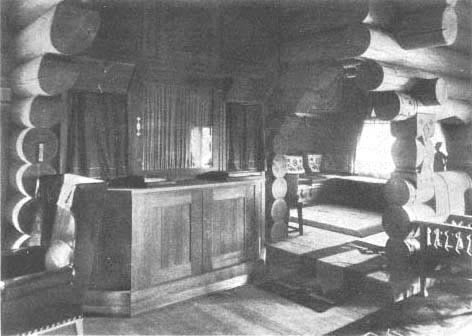
Fig. 217.
Meltser house. Ezhegodnik Obshchestva arkhitektorov-khudozhnikov , 1907.
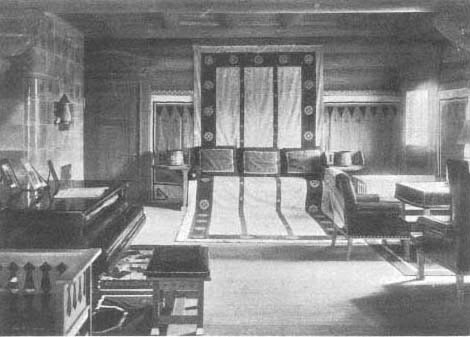
Fig. 218.
Meltser house. Ezhegodnik Obshchestva arkhitektorov-khudozhnikov , 1907.
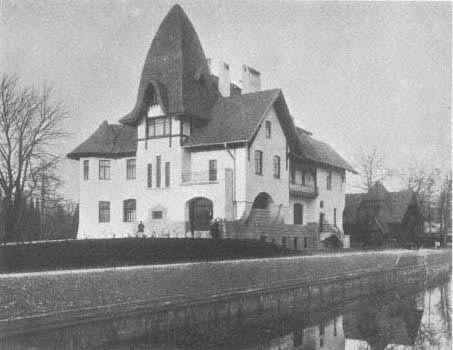
Fig. 219.
Vollenweider house, Stone Island. 1904. Roman Meltser. Ezhegodnik Obshchestva
arkhitektorov-khudozhnikov , 1907.
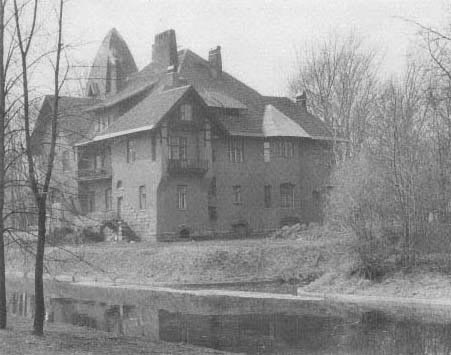
Fig. 220.
Vollenweider house in 1984 (Brumfield L72-44).
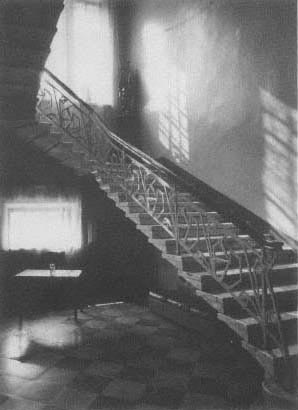
Fig. 221.
Vollenweider house, main stairway (Brumfield L72-24).
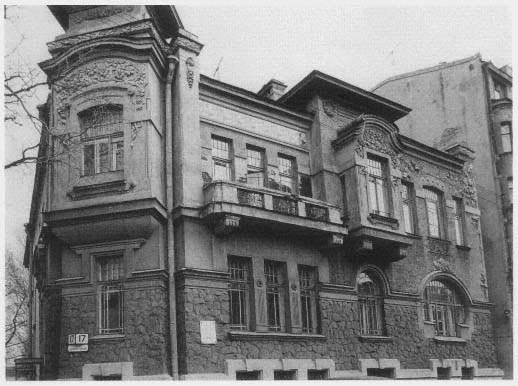
Fig. 222.
Maria G. Savina house. 1905. Mikhail Geisler (Brumfield L71-6).
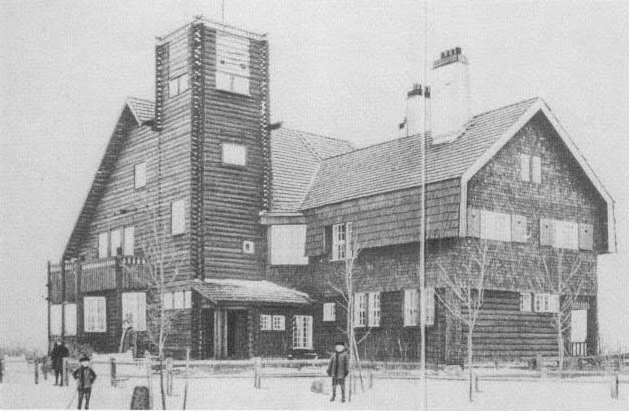
Fig. 223.
Leonid Andreev dacha, Vammelsuu (Gulf of Finland). 1908. Andrei Ohl.
Photograph ca. 1910.
(Fig. 222). In 1901–1902 Geisler used decorative ceramic and ironwork extensively in his rebuilding of a house for Elena I. and Vladimir D. Nabokov at No. 47 Morskaia Street. This was the childhood residence of the writer Vladimir Nabokov (see Plate 34).
Beyond the city suburbs to the north, Andrei Ohl (1883–1958) designed a spacious dacha at Vammelsuu for the writer Leonid Andreev that is one of the most impressive applications of the new style in wooden architecture. Even before graduating from the Institute of Civil Engineering, in 1910, Ohl had worked with some of the leading exponents of contemporary architecture in Petersburg and Finland. When the institute was temporarily closed because of revolutionary agitation in 1905, Ohl obtained a position with the Saarinen firm in Helsinki; in 1906 he began to work with Fedor Lidval, with whom he maintained close professional relations until Lidval left Petrograd after the revolution. Ohl's familiarity with the work of Gesellius, Lindgren, and Saarinen is apparent in his 1908 design for the Andreev dacha (Figs. 223, 224), which resembles Hvitträsk more closely than does the Meltser house on Stone Island. Like Meltser, Ohl was also a capable interior designer; his furnishings for the dacha unified the architecture and interior design.[58] Ohl was not, however, a major participant in the style moderne: his generation of architects came to maturity as the style waned, and most of his work would reflect the neoclassical revival (discussed in chapter 6).
Both apartments and detached houses in the new style in Petersburg embodied stylistic features related to varieties of modernism in Central and Western Europe. In the design of public buildings for banking and commerce, however, the style evolved rapidly toward a stripped, modernized classicism. The harbingers of the new style in commercial architecture included Karl
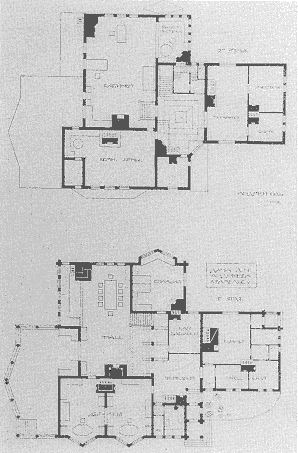
Fig. 224.
Andreev dacha plan. Ezhegodnik Obshchestva
arkhitektorov-khudozhinkov , 1909.
Shmidt's building for the firm of Carl Fabergé (1899) near Nevskii Prospekt (Fig. 225). Like the Forostovskii house, the Fabergé building displayed trappings of pseudo-Gothic architecture in the detailing of the gables and the windows of the top floor; yet the stylized Gothic motifs also made possible a functional use of space, particularly in the design of plate-glass windows. The Fabergé building, moreover, exploits the texture of hewn stone, from the polished red granite columns and facing of the first-floor arcade to the rough-cut and smooth blocks of gray granite on the upper floors. Much of the interior structure, of brick with iron reinforcing elements, remains from an earlier building on the site; it is the facade that makes the Fabergé building an example of the "proto-moderne."[59]
More conservative designs in the Renaissance style continued to characterize commercial architecture in central Petersburg, as in Leontii Benois's building for the Moscow Merchants' Bank (1901–1902) at No. 46 Nevskii Prospekt, which had the additional virtue of conforming to the scale and general style of the city's main thoroughfare. Other structures on Nevskii Prospekt emphatically proclaimed their modernity, most flamboyantly the Eliseev building and food emporium, built by Gavriil Baranovskii in 1902–1904 and enlarged in 1906 (Fig. 226). The architect had already designed and decorated three houses for G. G. Eliseev in Petersburg, one of them with a suite of rooms whose lavish rococo decoration represents the extreme in ostentation.[60]
The Eliseev building, at No. 56 Nevskii Prospekt, represents a similar ostentation on a larger scale. The ground level of the main structure has a large high-ceilinged hall once used to display Petersburg's most luxurious selection of wine and comestibles. The hall was richly decorated with metalwork, wood, marble, and glass, with curved iron beams supporting the ceiling. The next level contained a large theater, a reflection of Eliseev's passion for that art form; and on the slightly
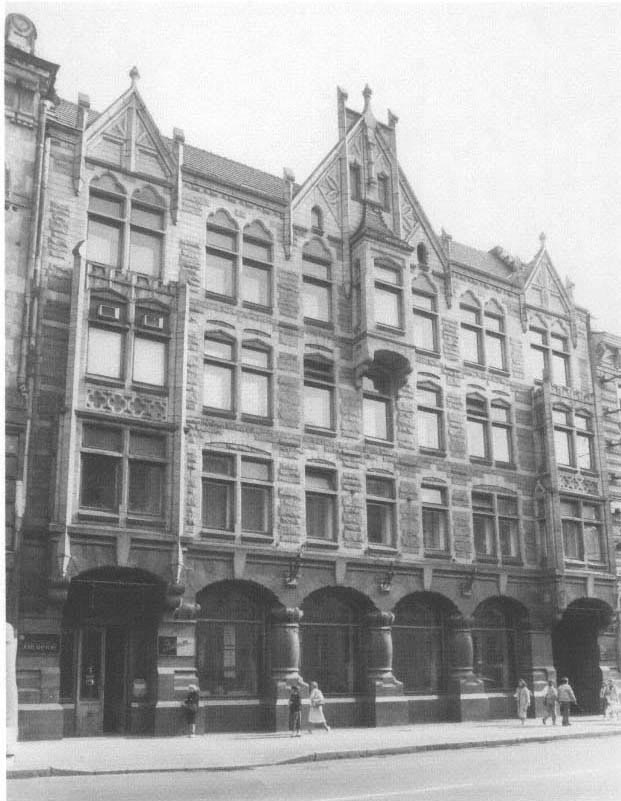
Fig. 225.
Fabergé building. 1899. Karl Shmidt (Brumfield L100-18).
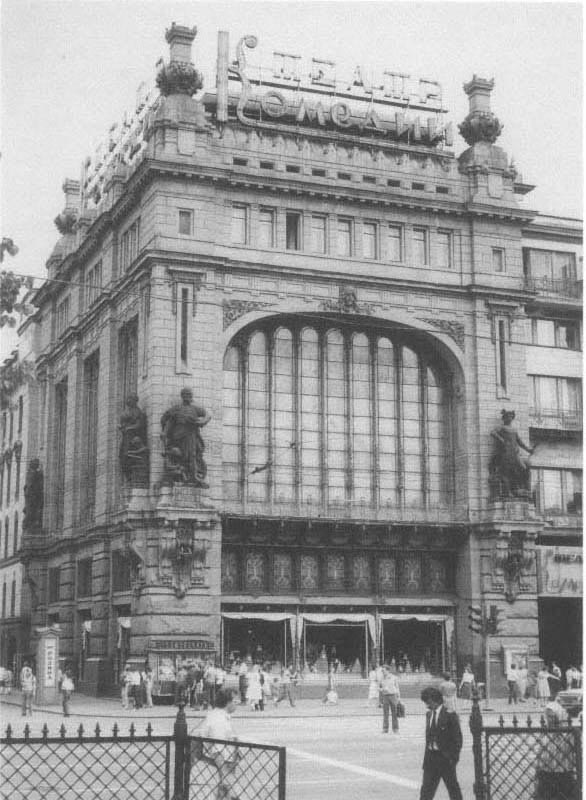
Fig. 226.
Eliseev building. 1902–1904. Gavriil Baranovskii (Brumfield L78-35).
recessed attic level of the rectangular structure, Baranovskii included office space. Each level still serves its original purpose, though not as luxuriously as before.
The building's soaring arches and expanses of glass proclaim modern engineering technology by one of its leading practitioners. Baranovskii graduated from the Institute of Civil Engineering in 1885; his career extended beyond Petersburg to Moscow, Nizhni Novgorod, and Estonia. He also edited Stroitel , a leading professional journal at the turn of the century. His design for the Eliseev building did not, however, place a premium on tectonic logic. The brick piers that support the structure—reinforced with iron—are surfaced with red granite and reach the top of the fifth floor. On the side of the building facing Malaia Sadovaia Street, the space between the piers is occupied by two-storied glass shafts ending at a classical architrave beneath the cornice line of the third floor. Although the arrangement provides a sense of structural support, the outsized scale of the window shafts obscures the division of floors within the building.
This impression of monumentality is further exaggerated on the front facade, with its three-storied arch between massive corner piers that do not in fact bear the weight of the structure; nor does the facade accurately convey the interior structure.[61] In the metal used decoratively above the first story and as a frame for the two-storied stained glass window (see Plate 35), the Eliseev building displays aesthetic details of the new architecture in Vienna, Paris, and Brussels; but its emphasis on material weight and ponderous ornament—the bronze allegorical statues at the corners of the building and the towers above the attic—belie any rationalist conception of design based either on the interrelation of interior and exterior or on the efficient use of technology and materials. Its bulk, however, establishes it as a landmark on the north—and less impressive—side of Nevskii Prospekt. In an era when construction was no longer possible on the monumental scale of the Stroganov Palace, the Kazan Cathedral, the Aleksandrinskii Theater, and the Anichkov Palace (all on the south side of Nevskii and all completed before the middle of the nineteenth century), a building such as the Eliseev provided important visual relief.
Another, more noticeable, landmark from the same period is the headquarters of the Singer Sewing Machine Company (1902–1904), at the corner of No. 28 Nevskii Prospekt and the Catherine (now Griboedov) Canal. Its architect, Pavel Siuzor (1844–1919), graduated from the Academy of Arts in 1866, and his career thus spans virtually the entire period of this study, from eclecticism to the style moderne and the neoclassical revival. The dean of Petersburg architects at the beginning of the century, Siuzor had produced about a hundred original projects and reconstructions (of which over sixty are extant), successfully adapting to various stylistic and technical innovations.[62] He played a leading role in founding the journal Zodchii , taught at the Institute of Civil Engineering, served as president of the Society of Architect-Artists from its founding in 1903 until 1917, and tirelessly organized and participated in professional meetings. He delivered major speeches at the first and second congresses of Russian architects, including the keynote address at the first (discussed in chapter 1).
From the 1870s until 1900, Siuzor constructed apartment houses in an eclectic style that included stuccoed facades and statuary. The strong element of unified planning in his buildings gained him so many clients that he could design streets and areas rather than isolated facades. With rusticated ground floors, long rows of windows separated by string courses, and prominent cornices, Siuzor's apartment houses amplified the sense of ensemble in central Petersburg, even though the buildings are rarely distinguished in themselves.[63] These apartments were designed to be accessible to renters of various income levels, and in them comfort as well as sanitation (one of Siuzor's primary concerns as architect and teacher) were better than in most contemporary dwellings.
The innovations in Siuzor's Singer building illustrate the considerable distance between American and Russian practice at the turn of the century. Although Ernest Flagg was still a few years from completing two office buildings for Singer in Manhattan (1907 and 1908), American architects had long been building towers far larger than anything Russian cities either needed or could afford.[64] Therefore, the Singer building must be seen in its context, as the tallest commercial edifice in Petersburg (Fig. 227).
Among the building's technical advances is its approach to a skeletal structural system. The exterior facades are supported with a ferroconcrete and brick frame, while the interior floors (also reinforced concrete) rest on iron columns. By surfacing the arcade of the first two floors with rusticated blocks of polished red granite and using a lighter, gray, granite for the upper stories, Siuzor created a visual base for the structure, which develops with a vertical emphasis on the granite-surfaced
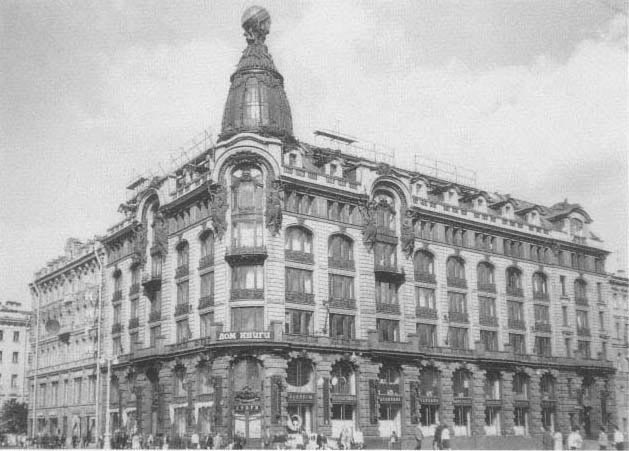
Fig. 227.
Singer building 1902–1904. Pavel Siuzor (Brumfield L-42).
piers and the window shafts that extend from the third to the sixth floor in a secondary arcade pattern. The plate-glass windows, divided by two mullions, reach from floor to ceiling; within the glass shafts the base of each floor is marked by a spandrel and a bronze balcony rail with art nouveau tracery. Unlike the Eliseev building, Siuzor's Singer building refers clearly to the structural frame and its divisions.
Siuzor, however, used bronze sculptural elements liberally. Nude helmeted females carrying spears (by the sculptor Amandus Heinrich Adamson) rise like ship's figureheads from under the arches of the three main window shafts. The focus of the Singer building is its corner, which originally displayed, in addition to the Beaux-Arts statuary, a large bronze American eagle with a shield, by Artur Ober, above the arch of the window shaft. The culminating architectural motif of the corner, and of the building, is the metal-ribbed glass cupola, atop which two bronze females support a globe with the Singer logo. The cupola and globe could be illuminated; because they were not considered a usable part of the structure, the Singer company managed dramatically to exceed the height restrictions on Nevskii Prospekt.
The discussion of this and other points of the Petersburg building code—according to a report in Zodchii —caused the Singer representatives some concern:
Besides the stairway, the building has three Otis elevators. The owners agreed reluctantly to construct the stone stairways common here, which take up so much space on all floors; in the United States one would be content with elevators and only one stairwell for the entire building in purely commercial (not housing) structures like this one. The owners were also amazed by the
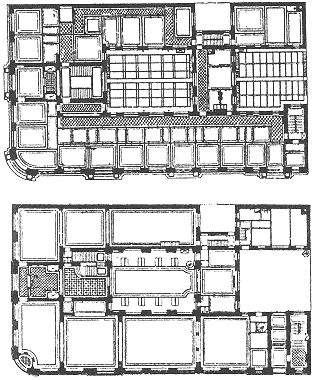
Fig. 228.
Singer building Plan of third floor ( top ) and first floor
(bottom ). Ezhegodnik Obshchestva
arkhitektorov-khudozhnikov , 1906.
building height limitation of eleven sazhens [23.4 meters] in Petersburg—which they did not know when they purchased such a good site. It is indeed strange that such a limitation should still be preserved in Petersburg, even on lots where the adjoining space would permit the construction of a tall building.[65]
Whether or not the company agents knew of the height restriction, they paid a high price for the prominent location (opposite the great square of the Kazan Cathedral)—more than one million rubles.[66] At this cost the rational arrangement of the interior for commercial use assumed priority: Siuzor designed seven functioning floors for a height that ordinarily permitted five (Figs. 228, 229). (Almost all Siuzor's apartment buildings in this central area have five stories.) By using modern techniques in structural engineering, Siuzor
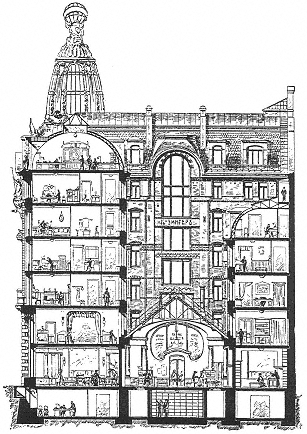
Fig. 229.
Singer building, section. Ezhegodnik Obshchestva
arkhitektorov-khudozhnikov , 1906.
was able to reduce the load-bearing weight of the building and open the walls with plate-glass windows to provide proper illumination.
Common standards of the time also required an interior courtyard, or light well, designed in this instance with mullioned windows and faced with white ceramic brick that added an aesthetic component usually ignored in such areas. The first floor of the well was covered with a glass roof and used for banking (Otto Wagner used the well similarly, though on a more impressive scale, in his Post Office Savings Bank in Vienna). The larger part of the ground floor and much of the second provided display space for the Singer Company and for fabrics of the Northern Trading Company. According to Zodchii , the area above the second floor was for "private offices of the Anglo-American type, opening onto a common corridor and sharing a service room, dining room, conveniences, etc. This type of office is com-
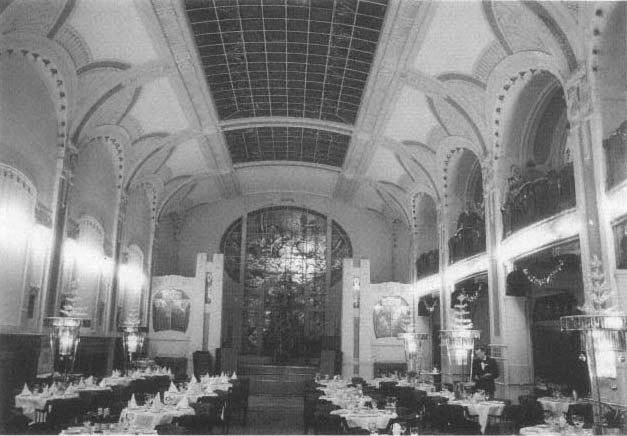
Fig. 230.
Hotel Europe, main dining room. 1905. Karl Makkenzen. In the center, a stained glass panel of Helios in his chariot
(Brumfield L98-37).
pletely new for us."[67] The seventh floor, under the mansard roof, was used for the Singer Company offices; it was lit by the dormer windows as well as by a skylight strip. A full waterproof basement housed machinery for the elevators, central heating, plumbing, electrical power, and so forth.
Despite its eclectic combination of Beaux-Arts and art nouveau decorative elements in a functional grid design, the Singer building represented a major step in the development of modern commercial architecture in Petersburg. No doubt the standards of the American clients were largely responsible for the building's innovative features as well as the efficiency of the design, in which Siuzor was assisted by well-known Petersburg architects such as Evgenii Baumgarten and Marian Peretiatkovich.[68] The project, like Petersburg's swank new hotels (Figs. 230–232), symbolized Russia's integration into the capitalist economic system of bourgeois Europe and America. Other, economic, aspects of this integration may have been more important, but no bank or other foreign enterprise in Russia had a more forceful architectural presence than the Singer Company.
The closest imitation of the Singer building was the design by Constantine de Rochefort and Vladimir Lipskii for the Esders and Scheefhals department store on the Moika Quay at Gorokhovaia Street (1907–1909). Rochefort had graduated from the Institute of Civil Engineering in 1900; after the completion of the department store, he turned to the construction of apartment houses from 1909 to 1912.[69] The building for the clothiers Esders and Scheefhals, his only foray into commercial architecture, was also one of his earliest independent projects. Its reinforced-concrete structural frame displays Rochefort's familiarity with advanced construction techniques (Fig. 233). But the functionalism of the design, reflected in the grid of the first four stories, is at
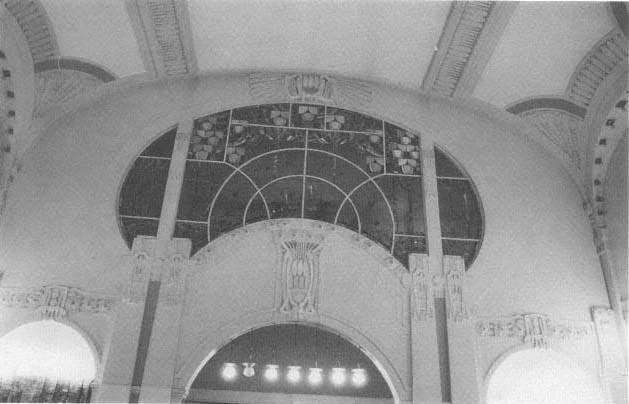
Fig. 231.
Hotel Europe, main dining room. Stained glass, wood, and plaster decorative elements over main entrance.
(Brumfield L98-35).
odds with the eclectic decoration of the two upper levels of the building, where details include baroque pediments for the dormer windows. The projecting cornice beneath the attic makes the ornamental facade of the fifth floor look like an entablature, supported by the arcaded window shafts of the main structural grid; thus the building has a sense of proportion and tectonic logic appropriate to central Petersburg; at the same time, it resembles commercial architecture of a decade earlier. The profuse ornamentation, part moderne, part Italianate, over the stuccoed brick walls of the upper level is presumably Lipskii's work, which represents the architectural taste of an "older" generation (Lipskii finished his studies at the Academy of Arts in 1896).
The stylistic duality of Rochefort and Lipskii's building—no doubt a compromise to achieve a grand and hightoned effect—distinguishes it from the Singer building, even though both display eclectic ornamentation. Similar elements of the two structures include a reinforced-concrete frame for the window grid and, most notable, the glass and iron cupola at the corner above the main entrance. Like that on the Singer building, the Esders and Scheefhals cupola could be lit; and it, too, exceeded the height limitation on structures in the central city. But Rochefort and Lipskii went beyond all reasonable measure: a large spire above the cupola rose from a base with four outstretched wings and culminated in a caduceus of monumental scale.[70] The entire assemblage nearly equaled the height of the building, which seems to have benefited from its removal after the revolution.
Toward 1910, the style moderne largely disappeared from use as a decorative system for commercial architecture; it was replaced by rectilinear, rational designs that often referred to the classical orders in a modern
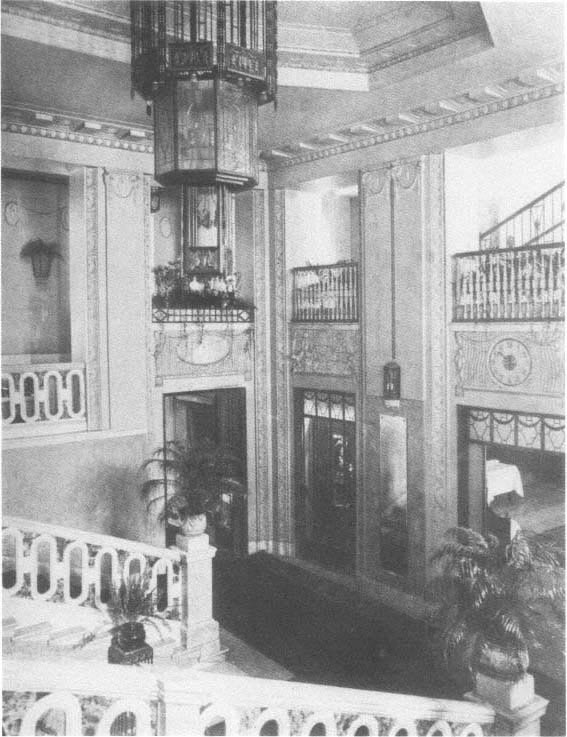
Fig. 232.
Hotel Europe (remodeled 1908–1910), main stairway. Fedor Lidval. Ezhegodnik Obshchestva
arkhitektorov-khudozhnikov , 1910.
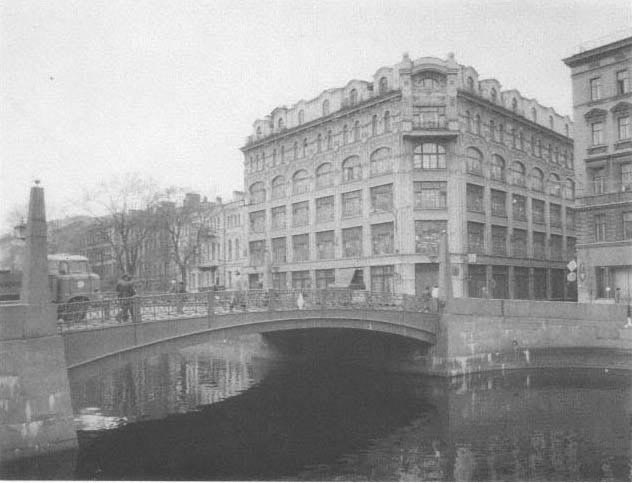
Fig. 233.
Esders and Scheefhals building. 1907–1909. Constantine de Rochefort, Vladimir Lipskii (Brumfield L61-1).
tectonic system. The building of the Guards' Economic Society, for example, was based on the rationalist component of the moderne and its innovative use of materials. Built in 1908–1909 by a team of architects that included Ernest Virrikh, Stepan Krichinskii (who later participated in the design of the Petersburg mosque), and Nikolai Vasilev, the building served as a department store for the elite Petersburg Guards regiments. At the time of its completion it was the city's most modern integrated facility for retail trade, comparable to Roman Klein's Muir and Mirrielees department store in Moscow. Like that building, the one in Petersburg was essentially a ferroconcrete structure that used plate glass extensively and, where necessary, brick infill for the walls (Fig. 234). The concrete and masonry were surfaced with natural stone (Radom sandstone); unlike Klein, however, Virrikh did not clothe the structure in a period decorative style. Although it has some classical motifs—in the rotunda above the corner of the building, for example—the facade is shaped by the alternation of structural elements and a membrane of iron and glass.
The first three stories display the new construction methods and structural design, with large glass bays divided by pairs of concrete piers. Narrow glass shafts project between the paired columns, and the floors are marked by iron spandrels the length of the glass facade. (Karl Baldi used similar glass bays in his 1911 apartment
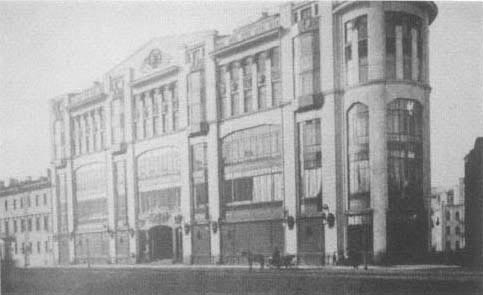
Fig. 234.
Guards' Economic Society. 1908–1909. Ernest Virrikh, Stepan Krichinskii, Nikolai Vasilev.
Zodchii , 1910.
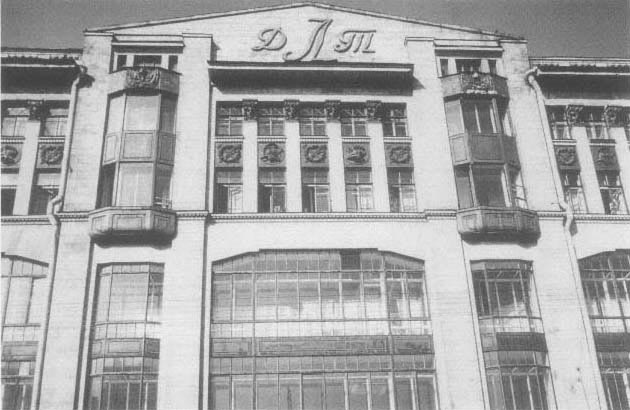
Fig. 235.
Guards' Economic Society, detail (Brumfield L84-20).
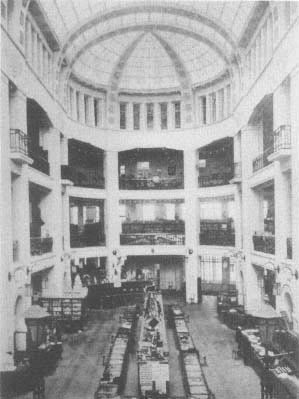
Fig. 236.
Guards' Economic Society, main hall. Zodchii , 1910.
building [see Plate 30].) The fourth and fifth floors, by contrast, show little attempt to develop the sweeping tectonic statement of the lower levels, beyond a simple alternation of windows and pilasters. The central part of the facade is marked by a pediment that originally displayed a large eagle within a wreath (the Guards' insignia). The stylistic uncertainty of the period is exemplified by neoclassical elements in a modern structural design that also relies on style moderne ornamental clichés such as the row of female masks above the pilasters (Fig. 235).
The interior of the building provides convincing evidence of Virrikh's reputation as a leading Russian specialist in using ferroconcrete. The main trading hall, rising the full height of the building, is surrounded by three gallery levels, all simply defined by ferroconcrete elements (Fig. 236).[71] The dramatic reinforced concrete arches over the hall are decorated, incongruously, with coffers and rosettes; yet the classical details do not distract from the clear functional definition of this central space, with an arched roof of glass in an iron frame.
The Guards' Economic Society building rests on an unseen but important feature of advanced construction technology: a concrete slab 80 centimeters thick under the structure, 3.4 meters below street level.[72] Although piles continued to be an essential feature of foundation work in Petersburg, architects increasingly resorted to a solid concrete base for walls of unusual height and structural stress—such as that created by the ferroconcrete piers of a skeletal frame. Furthermore, the concrete base provided a reliable barrier to Petersburg's high water table—Parland had used such a base to prevent seepage in the Church of the Resurrection of the Savior on the Blood (discussed in chapter 1). The success of Virrikh's design led in 1913 to the addition of a smaller merchandise hall (an extension of two more bays in the direction of Nevskii Prospekt) in which the architect, Ivan Balbashevskii, introduced virtually no stylistic changes.
A new passage , or trading rows, on Liteinyi Prospekt (Fig. 237), designed in 1911 by Nikolai Vasilev, represents an evolution of the rationalist principle of style moderne architecture long after the decorative features of the style had lost currency. The Guards' building shows a similar development, with its restrained classi-
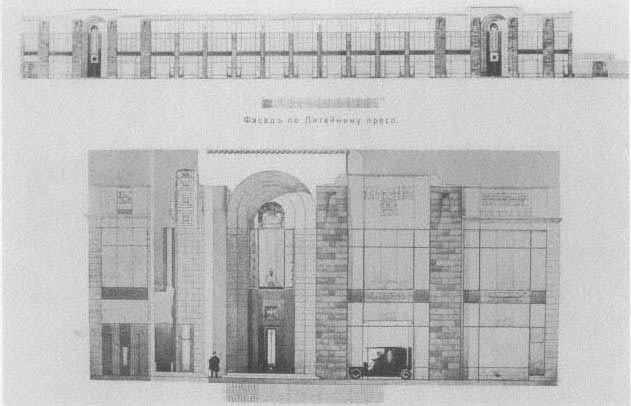
Fig. 237.
Liteinyi Prospekt Trading Rows. 1911–1913. Nikolai Vasilev. Zodchii , 1913.
cal motifs on a modern, functional design; but the passage , constructed in 1912–1913, has no superficial decorative elements. In the midst of an austerely functional facade—plate glass in a two-storied masonry grid—Vasilev introduced a "romantic" national element characteristic of the moderne in Petersburg—and in Finland. The ferroconcrete piers between the window bays are surfaced with rusticated gray granite reminiscent both of the new style's emphasis on the texture of material and of Saarinen's heroic use of red granite for the Helsinki Railway Station.[73]
The passage on Liteinyi Prospekt exemplifies the complex logic by which modernism in Russian architecture during the decade before the revolution not only evolved from the rationalist impulse present in the style moderne but also assimilated a rational interpretation of classical tectonics. Vasilev's design for the passage is particularly telling: its massive granite-clad piers, supporting a broad undecorated attic, suggest post-and-lintel construction. This reference to a simplified, "archaic," classicism must be seen in the context of Vasilev's other work of the period, such as his 1912 project sketches for a Noblemen's Assembly building in Petersburg and a contract hall in Kiev (Figs. 238, 239).[74] Each building is surfaced in natural stone (heavily rusticated granite in the Noblemen's Assembly); and each refers to classical architecture, in isolated fragments of statuary on the facades, in an arcade, and in a clear hierarchy of ascent in the rectangular structure. Neither, however, refers specifically to the classical orders.
The blocklike mass in Vasilev's sketches, with no concession to surface ornamentation, is a proto-Constructivist development comparable to that in project drawings by Viktor Vesnin, in collaboration with A. N. Miliukov (Fig. 240). Although the Miliukov-Vesnin sketches contain elements of the classical orders (no doubt Vesnin's deference to his senior colleague), the hypertrophied scale of the attached columns and capitals, the undifferentiated natural stone, and the bays of plate glass distinguish them (one a passage , the other a "cinematography" for the Roll firm of Moscow) from the usual products of the neoclassical revival.[75]
Indeed, the reduced, "stripped," classicism after 1910 appears to have derived not so much from the neo-
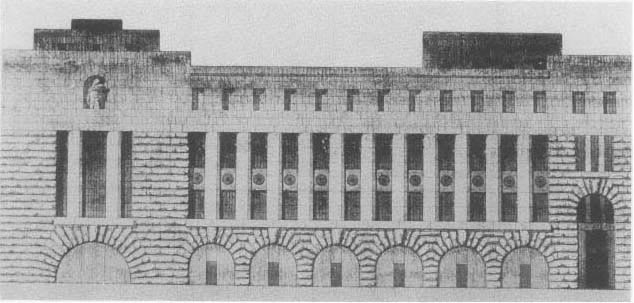
Fig. 238.
Project sketch for Petersburg Noblemen's Assembly. 1912. Nikolai Vasilev. Zodchii , 1912.
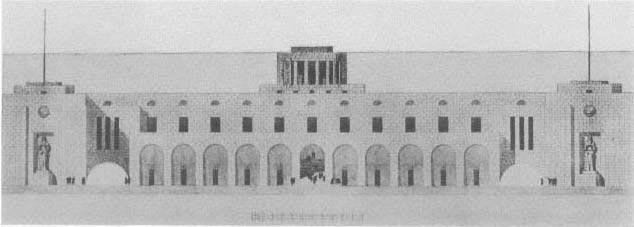
Fig. 239.
Project sketch for contract hall, Kiev. 1912. Nikolai Vasilev. Zodchii , 1912.
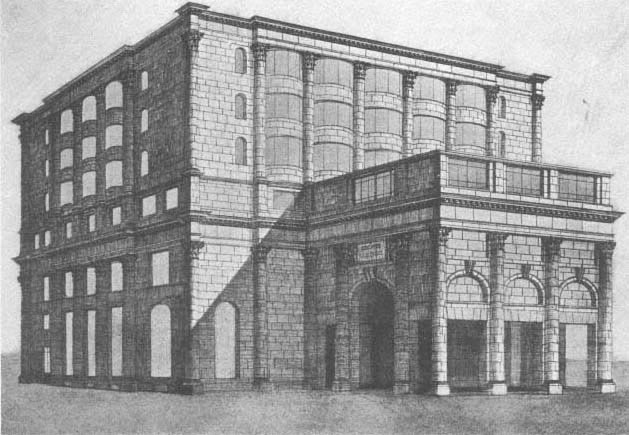
Fig. 240.
Project sketch for Roll building. Viktor Vesnin Nikolai Miliukov. Ezhegodnik Moskovskogo
arkhitekturnogo obshchestva , 1914–1916.
classical revival in Moscow and Petersburg as from the monumental design by Peter Behrens for the new German embassy in Petersburg (1911–1912). Behrens received less attention in the Russian press than his Viennese contemporaries, whose designs would have been better suited to commercial architecture in Russia; yet this leading representative of the Werkbund was undoubtedly known to Petersburg architects through German architectural journals, which in any event provided much of the copy for the Russian professional press.[76]
Although Soviet scholarship has ignored the German embassy building—now Intourist headquarters in Leningrad—it was one of the most impressive structures built in Petersburg just before the war (Fig. 241). Indeed, the silence on it—as well as the negative comments of some Russians at the time of the building's completion—is undoubtedly related to its uncompromising projection of the power of the German Reich ; yet it was highly praised by the anonymous author of an article, accompanied by three pages of photographs, in the 1913 issue of Moskovskii arkhitekturnyi mir .
The article noted the success of Behrens's approach to a difficult trapezoidal site by joining two independent structures surfaced in rough-hewn red granite. To the main part, facing St. Isaac's Square and containing the embassy's state and reception rooms, Behrens attached a second rectangular structure—extending along the side street and containing consular offices and staff quarters—at an angle to the main facade. This ingenious arrangement interlocks the two parts, which are nonethe-
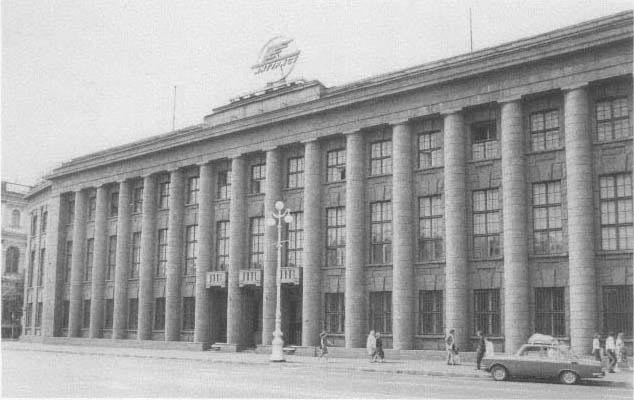
Fig. 241.
German embassy. 1911–1912. Peter Behrens (Brumfield L78-9).
less separate and have separate identities. (The angle of placement hides the front edge of the side wing from the cathedral square.)
What is particularly interesting about this commentary on Behrens's design—in a Moscow journal—is the praise of the austere, noble simplicity of the facades:
On St. Isaac's Square a facade rises with fourteen gigantic columns of three stories, with beautifully spaced, very modest windows. The three windows over the main portal are distinguished by balconies. Nothing breaks the simplicity and severity of the architectural lines, the proud rhythm of the stonework. The integrity and unity of the architectural impression is nowhere disturbed by any ornamentation.
The entire system of attached columns and windows on the main facade is enclosed in a well-proportioned frame: a small base below, two wide pilasters on the sides, and a high cornice above, crowned with a stepped roof with an impressive [statuary] group of horses and handlers. Now one comprehends the idea of the artist, who deliberately refrained from continuing the columns along the entire facade; it is also clear that the criticism of the exterior architecture for lacking unity is unjustified.[77]
The critic associated integrity, unity, and simplicity of structure with an absence of architectural ornamentation. Neither the style moderne nor the neoclassical revival had approached form and function so rigorously; Behrens had abandoned the historicism decried by Otto Wagner without vitiating the symbolic authority of monumental architecture.
Similarly, Vasilev, at each end of the passage on Liteinyi Prospekt, devised massive archways that frame the main entrances and create points of emphasis in the facade. Within these arches is the building's one decorative concession: on the second floor above each entrance a modern grid of bronzed iron. Eliel Saarinen had
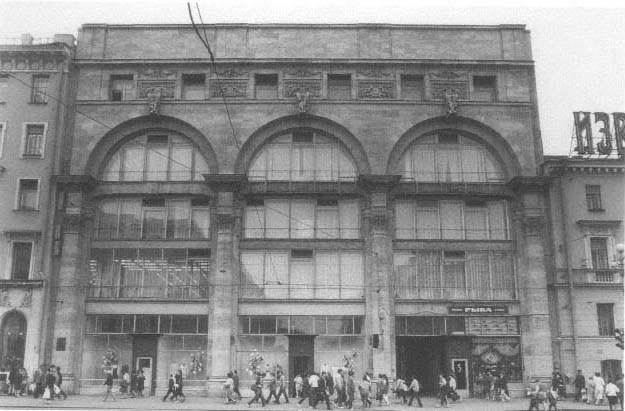
Fig. 242.
Mertens building. 1911–1912. Marian Lialevich (Brumfield L101-27).
used comparable architectural elements to organize the perception of structure in his Helsinki Railway Station and his design for the station at Vyborg, with its wide centered arch on a plain facade. (A critic commenting on the Vyborg station asked: "Is this not a classical work, though devoid of the external elements and architectural forms of classicism?")[78]
Vasilev's range of stylistic interpretations—from the florid style moderne to stripped classicism and functional commercial architecture—is repeated by many of his contemporaries such as Lidval, Apyshkov, Ohl, and Marian Lialevich (1876–1944). Lialevich, who studied with Leontii Benois and graduated from the Academy of Arts in 1901, designed at least one apartment building in a pallid version of the moderne before establishing a reputation in 1909 as a leading proponent of rational neoclassical designs for apartments and commercial structures. The monumental classical details and clarity of design in his building for the trading firm of F. Mertens (furriers) on Nevskii Prospekt (1911–1912) illustrate the fine distinctions to be made in tracing the rationalist legacy of the moderne during the ascendancy of the neoclassical revival (Fig. 242).
Is the Mertens building a classicized variant of the moderne or a rejection of the style? So pervasive is the rational impulse derived from the style moderne—whatever the decorative system of the facade—that one might question the need for such distinctions, were it not for the clear and often trenchant rejection of the moderne by those who supported the neoclassical revival. As will be seen in chapter 6, architects building in a commercial, urban environment could hardly abandon advances in construction technology and design introduced as part of the new style, however retrospective or stylized their own use of architectural ornament. Rather, the attack on moderne assumed an ideological character, with only a tangential relation to aesthetics and none at all to contemporary technology. Indeed, for architects like Vasilev and Lialevich and some of their contemporaries in Moscow, the opposition between the
moderne and various retrospective styles—particularly neoklassitsizm —was largely irrelevant.
The moderne in Petersburg had its greatest effect on the development and style of apartment houses, private residences, and commercial buildings. A number of these architects, who defined the new style, such as Lidval and Vasilev, subsequently emphasized the rationality of structural and facade design at the expense of plasticity and idiosyncratic decorative forms. For others the moderne was an episode in architectural fashion; their contributions, while not particularly innovative, demonstrate the creative versatility of the style. The work of Aleksandr Lishnevskii, who graduated from the Academy of Arts in 1892, illustrates the eclecticism that characterized much of Petersburg's architecture during the two decades before the revolution.[79] Lishnevskii's City Institutions building (1904–1906), a multipurpose administrative and commercial structure, could be defined as a pseudo-Gothic, Victorian-era town hall, including a massive corner tower at the apex of the triangular site (Fig. 243). With its picturesque silhouette and dark ornamental detail on a light stuccoed facade, Lishnevskii's design involves a play of tectonic and decorative elements with little relation to structure (as in the false side gables) or function. The architect also designed apartment houses, one with a heavily sculpted facade of stylized elements from fourteenth-century Novgorod churches and others with contrasting textures and prominent bays in the manner of Lidval, Bubyr, and Vasilev (all of whom helped to build one of Lishnevskii's apartment designs in 1906).
An even broader stylistic range ensued from the workshops of the brothers Vasilii, Vladimir, and Georgii Kosiakov. They collaborated in only one project: the Noblemen's Assembly (1912–1914), a building with classical details in the manner of the sixteenth-century Renaissance. Vasilii and Georgii Kosiakov, however, worked together on several apartment buildings, including one on Znamenskii Street whose elaborately decorated facade, considered the epitome of elegance in the new style on its completion in 1906, resembles the work of Dubovskii in Moscow.[80] The design of the Demidov apartment house by Vladimir and Georgii Kosiakov, on Bolshoi Prospekt of Vasilevskii Island (1910–1911), is more rational, with large undecorated windows on the first six floors and studio windows on the mansard level (Fig. 244). The brick facade above the stuccoed ground floor is divided into two horizontal bands—light brick for the lower floors and red brick for the upper two—with vertical strips framing the windows of the main stairwells. The elegant simplicity of the design as well as the aesthetic use of building material provided a model for the further development of urban middle-class housing.
Vasilii Kosiakov, the oldest of the brothers, played an important role in reopening the Institute of Civil Engineering after the revolutionary disorders of 1905; in 1906 he became its first elected director, continuing in that position until his death in 1921. His fame as an architect rests primarily on a series of churches in the neo-Byzantine style that he built between 1891 and 1913, the most impressive among them the gargantuan Naval Cathedral at Kronshtadt (1902–1913).[81] Although Vasilii Kosiakov's church designs integrated architecture and the decorative arts (including mosaic work by A. A. Frolov at the Church of the Epiphany, 1891–1899), they are as ponderous and derivative as most officially sponsored Russian Orthodox architecture of this period.
In Petersburg, as in Moscow, the creative exceptions to Orthodox architecture resulted from the lifting of restrictions against Old Believer communities, of which there were fewer in Petersburg. The church designed by Dmitrii Kryzhanovskii for the Pomorskii Covenant of Old Believers (1906) is the city's primary example of church architecture related to the moderne; Kryzhanovskii emphasized plasticity and an unobstructed perception of structure (Fig. 245). The church has little surface decoration; its form derives from fourteenth-century Novgorod churches, with trefoil gables. Set back from the street, the structure was enclosed within a low wall, which had a freestanding bell gable (zvonnitsa ) at the entrance gate. The church walls were brick on a granite base, with a stuccoed surface. Within the ferroconcrete vaults of the cross-inscribed church a cubic structure supported five cupolas—a deviation from the style of medieval Novgorod comparable to the free combination of medieval elements in the church at Abramtsevo. The large central drum and cupola provided natural light for the interior. The author of an extensive report on the church in Zodchii noted approvingly the unpainted smooth-stuccoed interior walls, which clearly revealed the contours of the vaulted structure.[82] As usual in Old Believer churches, the primary ornament of the interior was the icon screen.
In addition to the numerous archaeological-historical church designs by architects such as Vasilii Kosiakov and
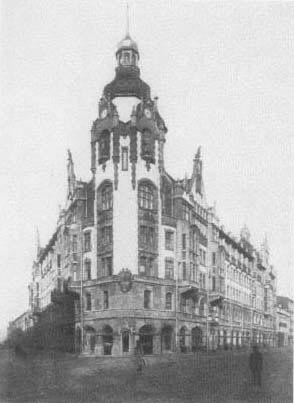
Fig. 243.
City Institutions building. 1904–1906. Aleksandr
Lishnevskii. Zodchii , 1907.
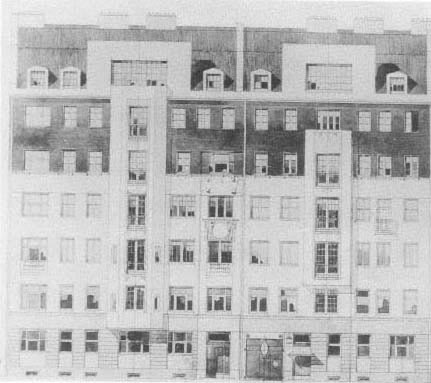
Fig. 244.
Project sketch for Demidov apartment house. 1910–1911. Vladimir Kosiakov,
Georgii Kosiakov. Zodchii , 1911.
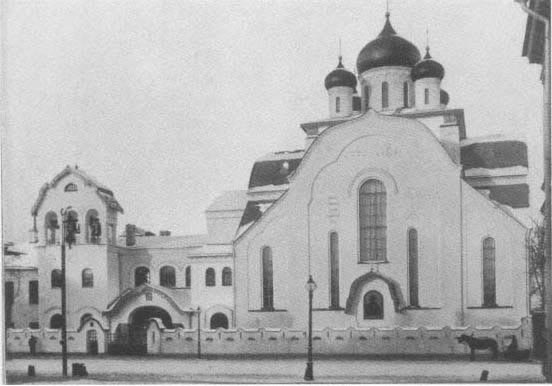
Fig. 245.
Old Believer church for the Pomorskii Covenant. 1906. Dmitrii Kryzhanovskii. Ezhegodnik Obshchestva
arkhitektorov-khudozhnikov , 1908.
Stepan Krichinskii there was also a vigorous return to a neo-Russian style based on Muscovite prototypes of the sixteenth century, exemplified by the work of Vladimir Pokrovskii (Figs. 246–249). These churches, with their emphasis on monumental tower designs, are related to the free style of the new church architecture; yet they constitute the final phase of the retrospective movement before the First World War. Other, far more modest, designs for chapels include some of the most picturesque examples of church architecture in Petersburg (see Plate 36).
Among the new houses of worship in the imperial capital, the large Friday Mosque (1910–1913) by Nikolai Vasilev, assisted by Aleksandr Gogen and Stepan Krichinskii (Fig. 250), symbolized the cultural and ethnic diversity of the Russian empire. One of the major projects of its time, the mosque received frequent attention in the architectural press.[83] Its setting, in a park one block from Gogen's Kshesinskaia mansion on the Petersburg Side, allows a clear view of the contrast between the massive granite block of the main structure and the intricate ceramic ornamentation on the minarets, dome, and portals—combined to complement both Petersburg and Central Asian architectural traditions. A similar cultural melding is represented by Gavriil Baranovskii's design for the Buddhist temple (1909–1915) on the right bank of the Bolshaia Nevka north of the city's islands.[84] Major Russian scholars of Oriental studies advised the architect on the design of the temple, based on ancient Tibetan architecture (see Plate 37). In 1908–1910, Iakov Gevirts constructed a synagogue and ancillary buildings at the Jewish cemetery in Petersburg (Fig. 251). The monolithic domed cube of the central structure is supplemented by wings that form a courtyard for funerary sculpture—some of which Gevirts also designed.[85]
These houses of worship demonstrate the artistic culture and technical proficiency of Petersburg's architects at the beginning of the century as well as their ability to recast in a new form architectural models from very diverse sources. Despite critical opposition to the style
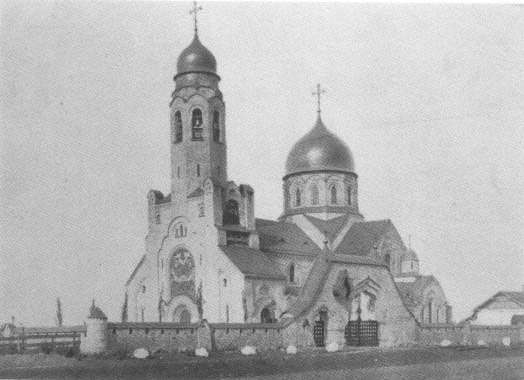
Fig. 246.
Church of the Intercession at Parkhomovka (near Kiev). 1903–1906. Vladimir Pokrovskii.
Ezhegodnik Obshchestva arkhitektorov-khudozhnikov , 1908.
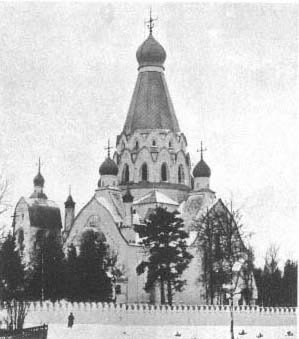
Fig. 247.
Church at Powder Factory, Schlisselburg. 1906. Vladimir
Pokrovskii. Ezhegodnik Obshchestva
arkhitektorov-khudozhnikov , 1907.
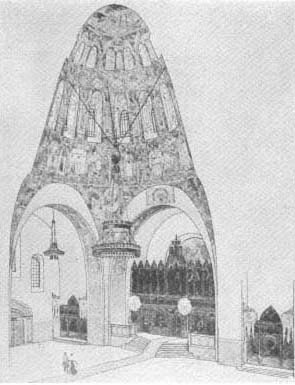
Fig. 248.
Church at Powder Factory, Schlisselburg. Sketch of
interior. Ezhegodnik Obshchestva arkhitektorov-
khudozhnikov , 1906.
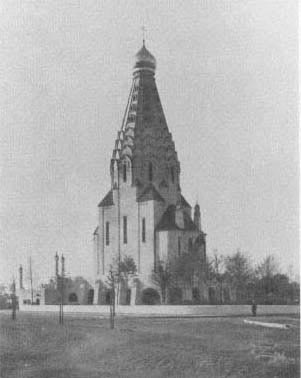
Fig. 249.
Church-monument commemorating the victory over
Napoleon, near Leipzig. 1912. Vladimir Pokrovskii.
Ezhegodnik Obshchestva arkhitektorov-
khudozhnikov , 1914.
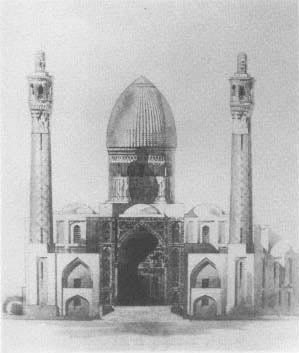
Fig. 250.
Project for Petersburg mosque. 1910–1913. Nikolai
Vasilev. Zodchii , 1908.
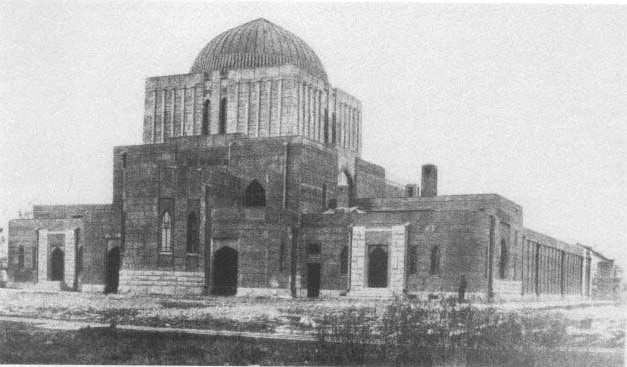
Fig. 251.
Synagogue and Jewish cemetery. 1908–1910. Iakov Gevirts. Ezhegodnik Obshchestva arkhitektorov-
khudozhnikov , 1911.
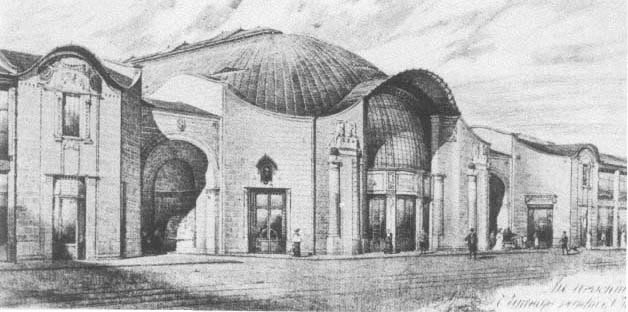
Fig. 252.
Project sketch for Sytnyi Market. Marian Lialevich, Marian Peretiatkovich. Ezhegodnik Obshchestva
arkhitektorov-khudozhnikov , 1910.
moderne in Petersburg, all major building types were affected by the technological and aesthetic changes that accompanied—and defined—the style. The main section of Stanislav Brzhovskii's design for the Vitebsk Railway Station (1902–1904) closely resembles the Eliseev emporium by Baranovskii; at one time the interior of the station displayed accomplished art nouveau decoration by Semyon Minash. German Grimm's 1907 building for the progressive high school of Karl Mai is an excellent example of the open, brightly lit interior of the new style applied to the learning environment.
In the area of market design, advances in iron and glass architecture produced an expressionistic yet functional plan by Lialevich and Peretiatkovich for the Sytnyi Market on the Petersburg Side (Fig. 252).[86] Even as late as 1917, the Architectural Publishing House of M. G. Strakun published handbooks for private houses in the new style that reduced innovations to patterns with an air of unreality at a time of social and economic crisis in Russia.[87] Yet the style moderne had waned as a coherent aesthetic system at least a decade earlier—as it had elsewhere in Europe. In the meantime the retrospective styles of the last decade of the Russian empire often rejected both the moderne and, in the opinion of some critics, the social ideals of a bourgeois, democratic society that had been associated with it.
Chapter Six—
Modernism Reconsidered:
Style and Ideology in the Neoclassical Revival
The Diverse and protean style moderne, ranging from the Secession to the neo-Russian to austere rationalism, stimulated an equally protean reaction that embodied not simply a rejection of the style but an evolution of it. During the first decade of the century, the moderne was replaced by a renewed interest in historicism—in itself related to the neo-Russian variant of the moderne—as well as a vigorous revival of neoclassicism that, particularly in large commercial buildings, was often little more than an extension of the moderne with different stylistic markers. In the design of private houses, the neoclassical revival adhered more rigidly to the precepts of Russian neoclassicism (the Empire style) established during the 1820s and 1830s.
The neoclassical revival encompassed both artistic and intellectual life in the decade before the revolution. The Acmeist poets, for example, rejected the Symbolists, whose "decadent" aesthetic mannerisms are analogous to the early decorative motifs of the style moderne, which was also labeled decadent in Russia (see chapter 2). In music, moreover, Stravinsky and Prokofiev turned to the clarity and precision of classicism during this period. Although extensive comparisons of the arts would be misleading because of chronological and stylistic differences, Russian culture before the First World War included not only futurism and modernism but also an aestheticism, defined by its classical sympathies, that prevailed in several art forms—not the least of which was architecture.
The journal Apollon stood in the forefront of the neoclassical movement. It began to appear in 1909, edited by the poet and critic Sergei Makovskii. Although it was primarily a literary journal with a strong interest in the visual arts, in the very first issue Georgii Lukomskii characterized the new classicism in Moscow's architecture:
"Classical" tendencies in architecture have replaced the sinuously agitated, "temperamental," and riotously "dashing" modernistic efforts of architects like Kekushev, as well as the simplified structures faced with brilliant walls of yellow brick of architects like F. Shekhtel.
This is reassuring.[1]
By 1913 Apollon was publishing lengthy articles, copiously illustrated, on the neoclassical revival and its ideological significance. It defended the revived classical form in Russian architecture as an expression of nobility and grandeur opposed to the questionable (bourgeois) values of the new style.
The neoclassical revival in Russia began just when the style moderne had entered its most productive phase.[2] In view of the rapid shifts in architectural style at the beginning of the century, it is not surprising to find that the architect responsible for reappraising the
Russian Empire style was Ivan Fomin (1872–1936), one of the most gifted young architects and designers in the style moderne and an assistant to Fedor Shekhtel. Fomin's paripatetic career, like that of many of his contemporaries, was influenced by political events, such as student protests and disturbances in Petersburg's institutes of higher education. After one such incident in 1896 Fomin interrupted the studies he had begun at the Academy of Arts in 1894; he spent a year in France and returned to Moscow as an architectural assistant. His architectural mentors at the turn of the century included Kekushev and Shekhtel, a discerning judge of ability who recommended Fomin to Ilia Bondarenko for work on the Russian pavilion in Paris (1900).[3] Fomin also helped to design the interior of the Moscow Art Theater and both organized and contributed to the Moscow exhibit of architecture and the decorative arts in the new style (December 1902-January 1903).[4] His sketches for designs of houses in the modern style were considered brilliant: one was reproduced in the Zodchii article "Contemporary Moscow" (1904); others appeared in the Moscow and Petersburg architectural annuals, which included Fomin's work in almost every issue (Fig. 253).
His work in the new style remained almost entirely on paper, with notable exceptions such as his furniture designs for the 1902 Moscow exhibit (discussed in chapter 2). Because of his interrupted education, he had no architectural degree or certificate at the beginning of the century, and his sketches of modern houses were incomprehensible to contemporary Moscovites. Fomin had gone beyond the moderne without participating in the movement; but his attention was soon redirected. In 1902 Aleksandr Benois published "Picturesque Petersburg" in Mir iskusstva , on the need to resurrect Petersburg's neoclassical architectural heritage. The article provoked a furious response from the modernist Pavel Makarov (see chapter 2); and, as Makarov had feared, the article had contemporary ramifications beyond the preservation of architectural monuments.
In 1903 Fomin entered a design competition for a country house in the classical style on the estate of P. P. Volkonskii. Although Fomin's modernized interpretation of classical elements was unlike his neoclassical work to come, he was already at the point of abandoning the style moderne (Fig. 254). In 1904 he published his own panegyric to the neoclassical architecture of Moscow. His emotional description deliberately opposed the rationalism of modern architecture:
The poetry of the past! An echo of the inspired moments of the old masters! Not everyone can understand the feeling of sadness at the faded beauty of the past, which at times gives way to an involuntary thrill before the grandiose monuments of architecture, Egyptian in their force and combining strength with the delicacy of noble, truly aristocratic forms.
. . . multi-storied buildings are already replacing these amazing structures from the epoch of Catherine II and Alexander I. Because so few of them remain, they are all the more valuable; I love them all the more.[5]
Fomin's article was accompanied by excellent photographs, but as a brilliant draftsman he himself sketched Moscow's neoclassical monuments and reproduced them in a series of postcards. The success of this venture and the critical acclaim of his article led him to write more extensive essays on the history of Russian neoclassicism after he completed his formal architectural training. He returned in the fall of 1905 to the Academy of Arts, where he was accepted for advanced study in the architectural studio of Leontii Benois. Benois played a major role in the career of many Petersburg architects, including some of the most talented representatives of the style moderne; but Fomin may have found Benois's classical-Renaissance sympathies especially congenial, for he had moved irrevocably into a period of neoclassical aestheticism.
The results of this shift appeared in Fomin's masterful student sketches, including his 1909 diploma project for a resort or mineral baths (kurzal ) on a heroic scale (Fig. 255). On a more practical level, Fomin designed a series of rooms for the apartment of the Pomer family on Vasilevskii Island. His treatment of structure and contour was modern, but the classical details, clarity of outline, and symmetry of the furniture ensembles (all painted white) demonstrated a classical sensibility (Fig. 256).
More significant was Fomin's participation in preparing an exhibit for the Petersburg Society of Civil Engineers that was to survey Russian architecture during the eighteenth and nineteenth centuries. The scholarly and archival work involved proved overwhelming, and the exhibit, originally scheduled for 1908, did not open until 1911. In 1908, however, Fomin published a statement of the exhibit's purposes in what had become his preferred journal, Starye gody (Bygone years).[6] He explained
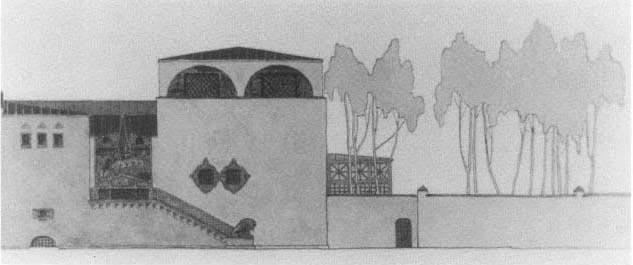
Fig. 253.
Project sketch for an artist's house. Ivan Fomin. Ezhegodnik Obshchestva arkhitektorov-khudozhnikov , 1906.
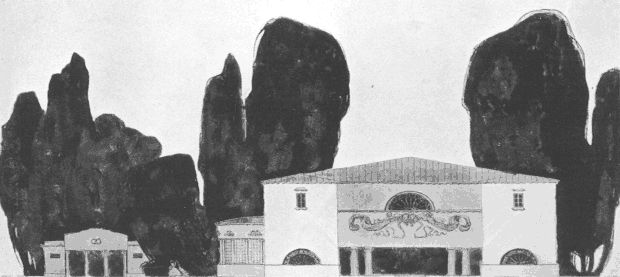
Fig. 254.
Project sketch for house of Prince Volkonskii. Ivan Fomin. Ezhegodnik Obshchestva
arkhitektorov-khudozhnikov , 1906.
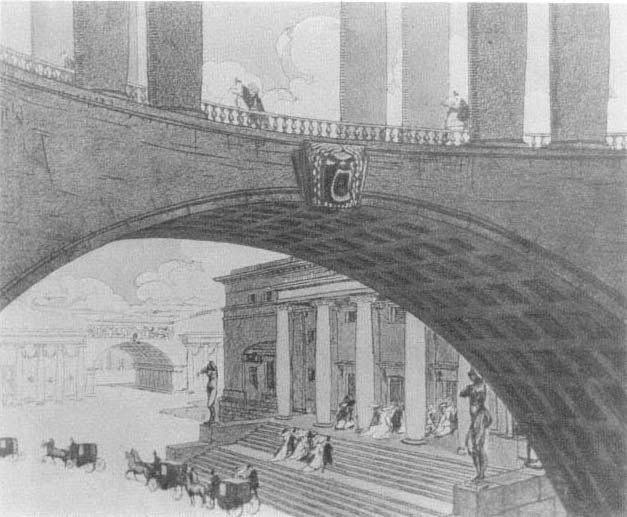
Fig. 255.
Project sketch for a resort. Ivan Fomin. Ezhegodnik Obshchestva arkhitektorov-khudozhnikov , 1909.
confidently that the exhibit would help to overcome the neglect of post-Petrine architecture and argued that modern architecture lacked some essential force present in even the work of less distinguished artists from the neoclassical era:
[Their work] characterizes the epoch even more than the work of first-class artists. In it one grasps the basis, the elements that are the essence of the style. . . . When the style was being formed, all the masters in the capital and the provinces worked toward the same end, not fearing to imitate one another. And in this is the guarantee of strength.
In our time, on the contrary, everyone scurries about trying to be individual; everyone wants to invent "his own," to do things deliberately not like others. As a result, there is no reigning style, nor does one see even those guides (vozhaki ) who might in the future stand at the head of a movement deserving expression as something new.[7]
Fomin thus established a tone that would underlie all further ideological claims on behalf of the neoclassical revival. Rather than shapeless individuality, neoclassicism provided the nobility of an immutable idea to be shared by all. The totalitarian implications of this thought were then far removed from his thinking, but
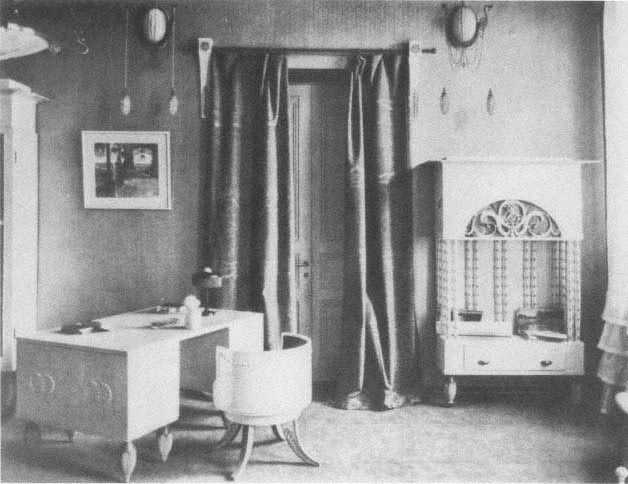
Fig. 256.
Interior design for Pomer apartment, Petersburg. Ivan Fomin. Ezhegodnik Obshchestvat
arkhitektorov-khudozhnikov , 1908.
Makarov sensed that the new style threatened individualism, even as he underestimated the appeal of a return to classical forms. The "unifying idea" loudly called for at end-of-the-century architectural congresses was about to be expressed in a form that no congress participant would have dared suggest: neoclassicism.
In the spring of 1909 Fomin won the graduation prize at the academy and was awarded a year's travel abroad, which he spent, not surprisingly, in Greece, Italy, and Egypt. On returning in 1910, he continued as chairman of the committee for the architectural exhibition, which opened at the Academy of Arts in March 1911. The display of architectural drawings and models from the eighteenth and nineteenth centuries was not an end in itself, however; the research findings that underlay the enterprise were published or preserved in museum collections. The most important publication was Fomin's own survey of Petersburg neoclassicism in the multivolumed History of Russian Art , edited by Igor Grabar.[8]
By 1911 the reappraisal of neoclassicism had been generally accepted, largely through Fomin's efforts. The return to the classical model in the architecture of Petersburg and Moscow, however, had variant forms. Accord-
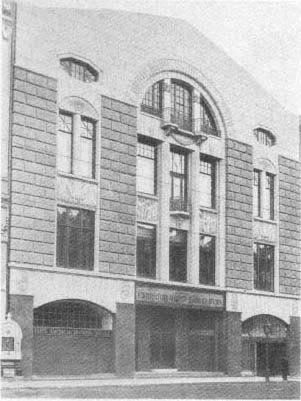
Fig. 257.
Second Mutual Credit Society building, Petersburg.
1907–1908. Fedor Lidval. Ezhegodnik Obshchestva
arkhitektorov-khudozhnikov , 1909.
ing to one interpretation, it first appeared as a modification and outgrowth of the style moderne; in a second phase it followed prototypes from the Italian Renaissance and Russian neoclassicism of the early nineteenth century.[9] But both stylization and modernized adaptation characterized neoklassitsizm throughout the decade 1905–1915, when it developed as an extension of modernism, an expression of nostalgia for bygone cultural values, and a reformulated sense of imperial monumentality on a modern urban scale.
As noted in chapter 5, Petersburg was especially receptive to the classical orders in its commercial architecture based on structural principles that had first appeared in the moderne. The design by Virrikh, Krichinskii, and Vasilev for the emporium of the Guards' Economic Society (see Figs. 234–236), for example, integrated classical elements into one of the city's most advanced functional commercial structures. Nikolai Vasilev, once a practitioner of the flamboyant style moderne, explored a simplified, modernized form of classical tectonics even more radically in projects like the passage on Liteinyi Prospekt (1911–1913) and the Noblemen's Assembly (see Figs. 237, 238).
Fedor Lidval, who became a leading practitioner of the neoclassical revival, built two banks in the style between 1907 and 1909. Although the one for the Second Mutual Credit Society (1907–1908) on Sadovaia Street is the more austere of the two, its design is richly articulated, from its three open bays on the ground level, whose massive piers establish visual support for the upper stories (Fig. 257), to the dark rusticated blocks of the central stories and the central window shaft, surmounted by the light granite ashlar blocks of an undecorated pediment.
Lidval's Azov-Don Bank (1908–1909) has a larger and more complex facade, centered on four three-storied Ionic columns that frame the central banking hall (Fig. 258). Above the columns, rectangular windows, without mullions, are separated by oval medallions carved in relief by the sculptor Vasilii Kuznetsov, who also created the frieze of laborers on the lower level.[10] In both banks Lidval exploited the texture and color of granite as well as the sculptural qualities of natural stone in the decoration of the facade, and in both he used iron structural components in the large transaction halls (Fig. 259).
Lidval applied modern construction methods to clas-
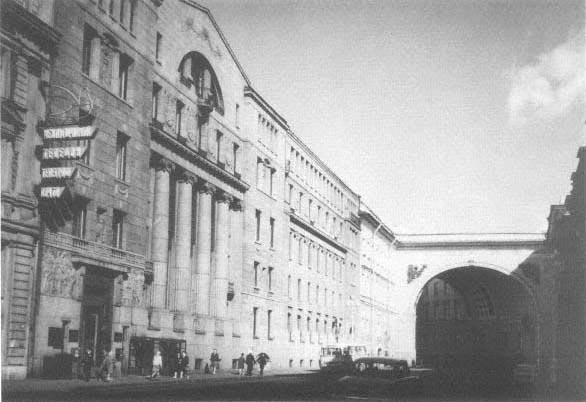
Fig. 258.
Azov-Don Bank, Petersburg. 1908–1909. Fedor Lidval (Brumfield L-50).
sical architectonics to suggest the solidity and strength of major financial institutions. Georgii Lukomskii was quick to see the implications of Lidval's work. In his commentary in the first issue of Apollon , he noted the transition in Petersburg from buildings too light for their environment (Lidval's early apartment buildings) to monumental structures appropriate to an imperial capital—structures like the Azov-Don Bank:
Though fashioned in the style of our "Empire," this building is, by virtue of its material and the very articulation of the stone surface, more harsh in its lines, more "foreign" in its forms. Its style approaches that of buildings of the German "Empire" (theaters in Leipzig and Danzig), while in the resolution of structure it is [closer] to the Swedish-Finnish "new" type of building (banks in Stockholm and Helsingfors).[11]
The reference to Helsingfors is especially apposite in view of the publicity given the designs of financial institutions by Gesellius, Lindgren, and Saarinen as well as other Finnish architects. Although such designs had little to do with neoclassicism, the use of natural stone by these architects anticipated a development in Petersburg. Lukomskii noted that the extension of railway lines to quarries in Russia and the lowering of tariffs for transporting stone provided an abundance of "material for the facing of structures in the capital." Although the use of natural stone militated against the richness of detail and form characteristic of Petersburg's Alexandrine neoclassicism—or Empire style—with its intricate stucco detailing, Lukomskii found compensations in the unmistakable "monumentality" of Lidval's Empire colonnade on the Azov-Don Bank.
To be sure, the new classical style had entered the service of an empire of commerce; Lukomskii commented on this fundamental shift in economic power. The Azov-Don Bank had "none of the 'nobility' of our Empire structures" because "the goal of a bank—a bourgeois palace—excludes it."[12] Lukomskii was less ambivalent in appraising the building of the Second Credit Society, whose subtler relation of parts suggests the genius of Russian neoclassicism in its final phase. Even without "noble perfection" Lidval's adaptation of neoclassical elements promised the new approach to architecture Lukomskii fervently desired: "Lidval's structures are the
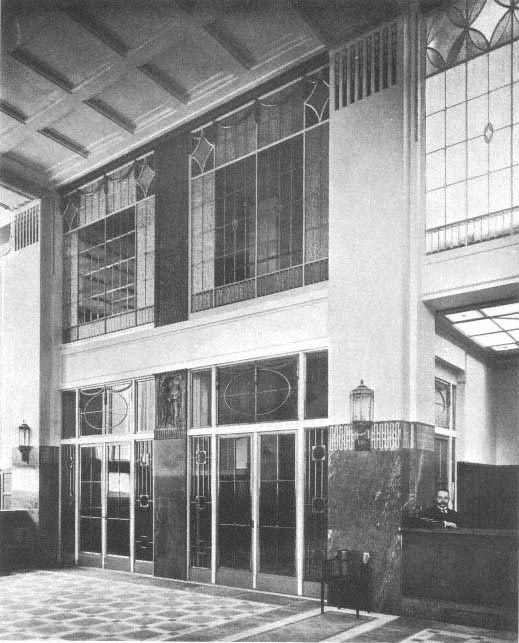
Fig. 259.
Azov-Don Bank, interior. Ezhegodnik Obshchestva arkhitektorov-khudozhnikov , 1909.
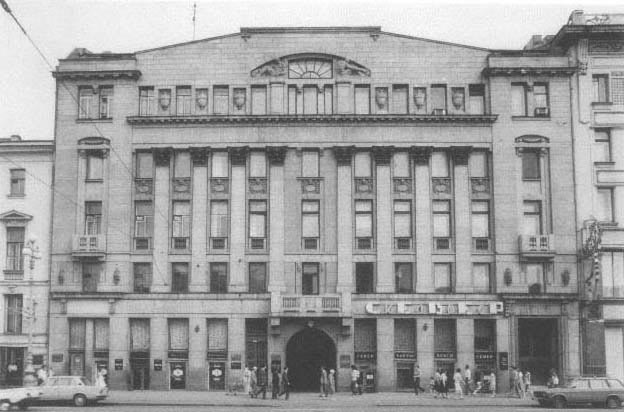
Fig. 260.
Siberian Trade Bank, Petersburg. 1909–1910. Boris Girshovich (Brumfield L78-29).
type that, in all likelihood, will harmonize the 'new' construction with the principles and traditions of historical architecture in Petersburg."[13]
Lukomskii's essay on Lidval's work, with its carefully chosen, superbly reproduced photographs, helped to disseminate the aesthetic principles of the neoclassical revival. Other commentary followed rapidly as the style matured; but Lidval was among the first to meld rational structural innovation and the aesthetics of monumental architecture.
Lidval was not the first architect to design new banking space in Petersburg: in 1896–1898 Boris Girshovich had constructed the Azov Commercial Bank at No. 62 Nevskii Prospekt; and in 1897–1898 Stanislav Brzhovskii, the architect of the Vitebsk Railway Station, built the International Commercial Bank at No. 58 Nevskii Prospekt. In 1898 Leontii Benois reconstructed a building for the Volga-Kama Bank (No. 38 Nevskii Prospekt, rebuilt in 1948 with its earlier neoclassical facade); and in 1901–1902 he designed the Moscow Mercantile Bank (No. 46 Nevskii Prospekt) in the eclectic Renaissance style that characterized his work at the turn of the century.[14] Indeed, with minor variations, these bank buildings had the eclectic stuccoed facades typical of Petersburg architecture after 1850. The only significant use of a stone facade in the central district at the beginning of this century was Karl Shmidt's design for the Fabergé building.
Lidval's example rapidly changed that situation. In 1909–1910 Girshovich built the Siberian Trade Bank (No. 44 Nevskii Prospekt), which closely resembles Lidval's work, with its gray facade of granite ashlar and its modernized reference to classical motifs (Fig. 260).[15] Instead of Lidval's strongly centered approach, Girshovich's facade has a row of Corinthian pilasters stretched across it. The pilasters and the three-storied window shafts
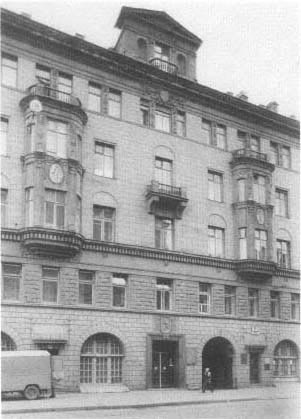
Fig. 261.
Salamander Insurance Company building, Petersburg.
1908–1909. Marian Peretiatkovich, Nikolai Verevkin
(Brumfield L61-11).
give a vertical accent to the building; but horizontality predominates in Petersburg: the large cornice (originally with the name of the bank) limits the vertical development and provides a base for the top floor, decorated, in the manner of the Azov-Don Bank, with panels containing classical urns in high relief. The urns separate the plain rectangular windows without mullions (another device introduced by Lidval). Beneath the capped pediment, Girshovich, subtly quoting Lidval, placed a fan window with neoclassical tracery flanked by classical nudes. The contorted nudes seem to parody the heroic frieze of the Azov-Don Bank, and suggest a mannered play both on the decorative elements of the neoclassical era and on their revival.
From 1910 to 1914, when virtually every major Petersburg bank constructed new headquarters, the dominant presence in bank construction was Marian Peretiatkovich (another of Leontii Benois's many pupils), who approached classical monumentality through the Italian Renaissance.[16] In 1908–1909, with Nikolai Verevkin, he designed a building for the Salamander Insurance Company, with understated Renaissance motifs on a granite facade (Fig. 261). His unrestrained design for the Vavelberg Banking House (No. 7 Nevskii Prospekt), however, combined features of the Florentine quattrocento—such as the rusticated stone work of Michelozzo's Palazzo Medici—with the double arcade form of the Palace of the Doges in Venice (Fig. 262).
Because of its location at the corner of Nevskii Prospekt and Morskaia Street, the Vavelberg building can be seen in three dimensions. The architect's imitation of the palazzo style on the narrow facade included even the Medici coat of arms! The open arcade at ground level had been introduced by Shmidt in his Fabergé building, yet the grotesquely massive form of the Vavelberg building is unique—in sharp and obtrusive contrast to the great imperial monuments at the head of Nevskii Prospekt.
In Peretiatkovich's subsequent design for the Russian Bank of Trade and Commerce (1912–1914) on Morskaia Street, the references to the Renaissance palazzo reappear on the heavily rusticated granite surface; but
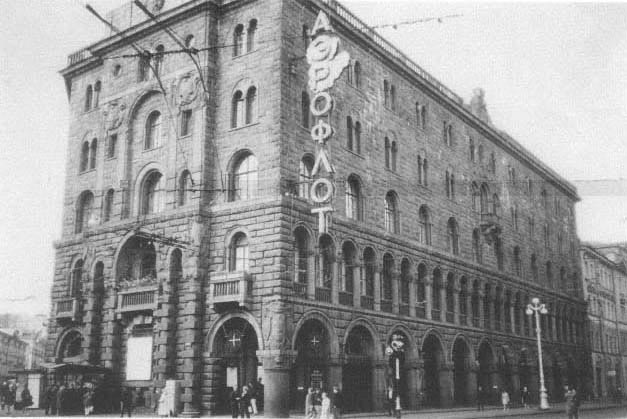
Fig. 262.
Vavelberg building, Petersburg. 1910–1912. Marian Peretiatkovich (Brumfield L84-19).
the narrow site gives greater focus to the facade, which ascends to a Doric portico enclosing the upper two stories (Fig. 263). This design, with its sense of proportion, was the most successful product of the architect's fascination with Italian architecture, which he had studied closely in 1906. He modified the style in the large City Institutions Building (1912–1913), whose facade shows elements of the palazzo but is defined by end blocks and a central tower that suggest such monuments of Petersburg neoclassicism as the Admiralty (Fig. 264).
Despite the professionalism of Petersburg's neoclassical revivalists, their work often reflects the tension between monumentality and the functional requirements of modern architectural design. These contradictions were ably noted by Marian Lialevich, the designer of the Mertens Building on Nevskii Prospekt (see chapter 5), who frequently collaborated with Peretiatkovich on neoclassical projects but who also acknowledged the significant innovations of the style moderne. Among his several publications, perhaps the most theoretically interesting was his response to "On Style and Pseudostyles," an article by the prominent critic and art historian Vasilii Kurbatov, published in 1908 in Zodchii . Kurbatov decried the pseudostyles that resulted from the "inability [of architects] to find new decorative and architectural forms as quickly as the conditions and demands of life change."[17] Despite their technical proficiency, architects had created no daring, aesthetically innovative style. Kurbatov hoped that an authentic style would develop in which social needs and technical innovations would merge; but his prognostications were either dogmatic—he insisted that "monumental" buildings should continue to be constructed of natural stone in the Roman manner—or simply misguided.
In response Lialevich defended nineteenth-century eclecticism: if life indeed creates the architecture suitable to its demands, there is no reason to posit preconditions for an appropriate style:
In linking the appearance of architectural forms with the qualities of steel and concrete, it seems that we so restrain our concept of the development
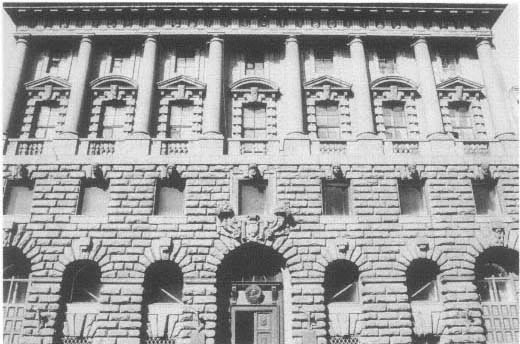
Fig. 263.
Russian Bank of Trade and Commerce, Petersburg. 1912–1914. Marian Peretiatkovich
(Brumfield L84-25).
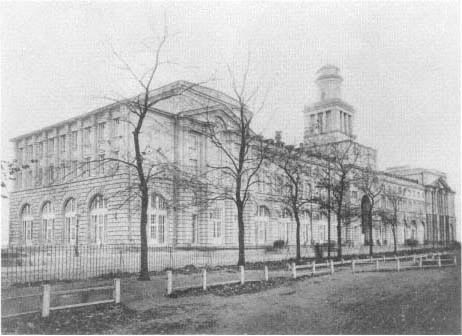
Fig. 264.
City Institutions Building, Petersburg. 1912–1913. Marian Peretiatkovich,
Marian Lialevich.
Photograph ca. 1914.
of architecture as an art that we repeat the very mistakes we attribute to architect-theoreticians of the nineteenth century (Semper, Schinkel). . . .
A genuine style will appear not from the properties of steel and concrete but from more deeply based elements, from the strivings and ideals of society in the broadest sense [obshchestvennost ].[18]
Lialevich justified the style moderne as a "historical necessity," whose passing was entirely natural. The most important contribution of the moderne may have been its sense of freedom from normative, academic tendencies:
For the full reflection of life, art needs freedom. . . . It is horrible to think that after art had been able to spread its wings but had not defined the direction of flight, such [proscriptive] tendencies would force it back onto its academic course . . . Elevate the meaning of life—not by studying steel and concrete—and the work of human hands will change.[19]
After the revolution, Lialevich returned to his native Poland; but during his career in Russia at the beginning of the century, he worked in the style moderne and the neoclassical revival style as well as in a combination of the two. His response to Kurbatov implies a suspicion of the dogmatic aesthetic principles of classical, academic architecture. Fomin's comments in Starye gody that same year had advocated just such principles; and although his own work effectively interpreted these values, the architectural critics who promoted the neoclassical revival wrote in increasingly preemptory tones.
Despite the publicity given the neoclassical revival in commercial architecture, the style asserted itself most emphatically in Petersburg (and to a lesser extent in Moscow) in the design of apartment buildings. Lidval, once again, was at the forefront of stylistic change. Having defined the style moderne in apartment buildings at the beginning of the century, he was prepared to effect the transition to a style that placed less emphasis on texture and plasticity and borrowed elements from the classical era in Petersburg.
The first notable example was his reconstruction of an apartment house on the Moika Canal for the firm of the Nobel brothers (1909). The building is a model of restraint, in harmony with the scale and style of the adjoining structures in this historic central district of the city (Fig. 265). The neoclassical window pediments in alternating configurations on the first floor are the major decorative feature of the stuccoed facade; the undecorated ovals between the windows of the top floor refer discreetly to Petersburg neoclassicism.
Lidval exercised greater freedom in designing an apartment house on the Fontanka Quay for M. P. Tolstoi (1910–1912). The roughcast facade has a few understated motifs from the neoclassical and baroque styles (Fig. 266), but the building's form represents a "rationalist" development of the style moderne. Its dominant feature is the three-storied arch framing the entrance to the courtyards that lead to a street on the opposite side of the structure. The heroic entrance—unusual in Petersburg buildings—created a dynamic relation between the building and the streets on either side of it; the arches, with their flanking pilasters and obelisks, suggest the grandeur of Roman classicism. A similar approach characterized Lidval's design for the deluxe Hotel Astoria on St. Isaac's Square (1911–1912), a six-storied building with a few highly visible decorative elements, such as the classical urns and channeled pilasters along the austere granite facade.
In 1910–1912 Lidval designed an apartment house for E. L. Nobel—one of the Nobel brothers—at the eastern fringes of the city on Lesnoi Prospekt, across from a private residence Lidval had built for the same patron in 1910. The apartment building has the textural contrast of the style moderne, with rusticated stone on the ground level and roughcast on the upper floors, and the unadorned rectilinearity of modern functionalism. Classicism, however, reappears in the articulation of the large triple arch leading to the central courtyard.
The most ambitious application of classical elements in Petersburg apartment construction occurred on Golodai Island, a largely undeveloped area north of Vasilevskii Island across the narrow Smolenka River. In 1911 an English investment firm initiated a project, called New Petersburg, for a community to occupy much of the western part of the island (about 232,000 square sazhens).[20] The technical problems were considerable, since the low-lying area was subject to flooding and inadequately protected by a dike; with a special dredging and pumping system, the area was raised eight feet to the level of the dike with sand taken from the bottom of the Neva estuary. Because of the city's rapid growth, its
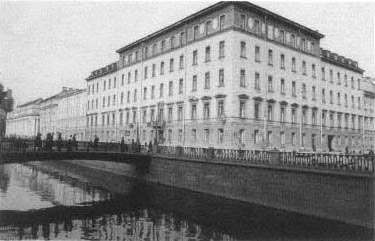
Fig. 265.
Nobel Brothers apartment house, Petersburg. 1909. Fedor Lidval
(Brumfield L86-6).
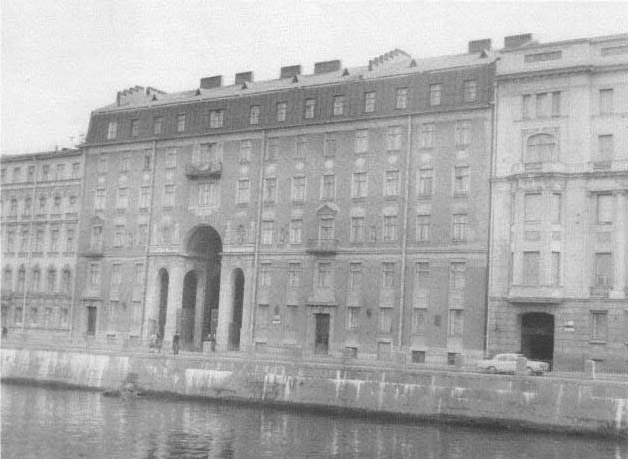
Fig. 266.
M. P. Tolstoi apartment house, Petersburg. 1910–1912. Fedor Lidval (Brumfield L40-9).
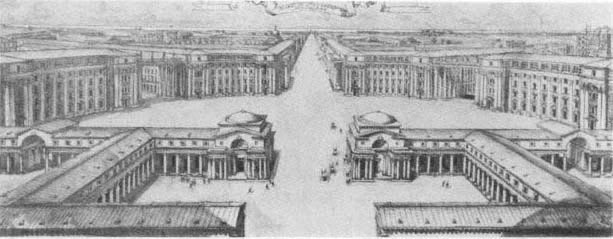
Fig. 267.
Sketch for New Petersburg (housing development on Golodai Island). Ivan Fomin. Ezhegodnik Obshchestva
arkhitektorov-khudozhnikov , 1913.
dearth of housing and suitable land for construction, and the cramped and unhealthy environment of the central city, the entrepreneurs expected a good return despite the expense of improving the site.
The general design for the project was entrusted to Ivan Fomin, who had built relatively little but had established a reputation as one of the most capable of Petersburg's neoclassical architects. He had demonstrated his ability to think in large terms in his 1909 diploma project (see Fig. 255); the influence of that project is evident in the sketches for New Petersburg, with its Roman arches, colonnades, and receding horizontal vistas (Fig. 267). Fomin fully intended to re-create the monumentality of imperial Petersburg in a housing development for what might be called the city's new middle class. Paradoxically, Kurbatov, in "On Style and Pseudostyles," had defended classical monumentality for major buildings but rejected it for housing, predicting the development of single-family suburban dwellings on the model of the English housing estate.[21]
Kurbatov's prediction proved inaccurate, while Fomin's vision turned out to be prophetic of Soviet architecture in the 1930s and 1940s, as well as of Western postmodern developments of middle-class monumentality (notably the work of Ricardo Bofill near Paris). But little of the New Petersburg project was built. In 1912 Fomin undertook the construction of one of the five-storied apartment blocks whose facades were to follow the curve of the semicircular entrance park. The buildings made heroic reference to Roman architectural motifs (the Claudius Aqueduct), with a rusticated facade segmented by four-storied Corinthian pilasters and a fifth, attic, floor above the cornice. The buildings were to have been linked by colonnaded arches, beneath which the major radial streets of the development originated.[22] Although the radial arteries have been preserved, the only remnant of Fomin's work is the one apartment building, since adapted for use as a school.
Another component of the project consisted of housing blocks on the major thoroughfare leading to the entrance square from the east. Fedor Lidval designed these buildings in 1912. In praising the New Petersburg project, Georgii Lukomskii compared Lidval's undistinguished designs with the German regency style and with provincial architecture in Holland during the reign of Louis XIV. Such labored comparisons suggest an eagerness to welcome the revival of neoclassicism, which restored timeless architectural values and proved adaptable to changes in the contemporary social structure—even to housing the working class. In Lidval's apartment buildings (only one building was constructed), Lukomskii noted,
The channeled pilasters, extending the height of the building, and the modest decorations and shallowly outlined frames of the windows will suggest that these are apartment houses primarily for workers.
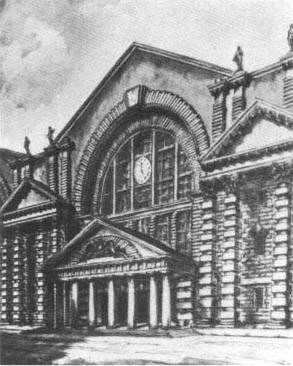
Fig. 268.
Project sketch for Nikolaevskii Station, Petersburg.
Ivan Fomin. Ezhegodnik Obshchestva
arkhitektorov-khudozhnikov , 1912.
But not all the buildings planned for construction here will serve this goal. Once the second streetcar line reaches here, the more prosperous classes of Petersburg will flock to this part of town on the sea, with its open horizon.[23]
In the event, construction halted after the initial stages. Lukomskii's fervent support of the project reflected his desire for a "part of the city with a truly European appearance and a strict unity of classical architectural ensembles, situated on the shores of an open sea."[24] Whether reality could ever have matched the critic's vision, which included not only parks and seaside promenades but also tennis courts and soccer fields, is open to question. Even before the war, the project was impeded by the lack of transportation and other services to bring to the area the "more prosperous classes," on whom the investors depended for a return on their large outlay. In an ironic reversal, the completed fragments of the development were left primarily to the working class, presumably inured to primitive transportation.
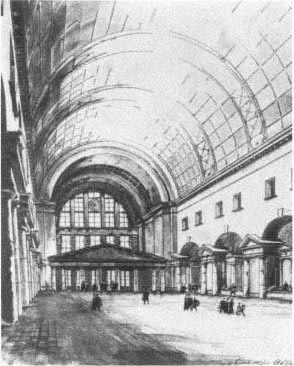
Fig. 269.
Project sketch for Nikolaevskii Station. Ezhegodnik
Obshchestva arkhitektorov-khudozhnikov , 1912.
When Fomin abandoned work on the New Petersburg project in 1913, he continued to devise neoclassical urban projects on a large scale, submitting a design for the rehabilitation of the area around Antonio Rinaldi's buildings for the Tuchkov Wharf (Tuchkov Buian, originally constructed in the 1760s).[25] Fomin had frequently used motifs from the work of Andrei Voronikhin, one of the greatest Russian architects at the beginning of the nineteenth century. The grand portico of Voronikhin's Institute of Mines, on the Neva embankment of Vasilevskii Island, figured in both Fomin's 1911 design for the competition to build a museum of the 1812 war and his project of 1912 to rebuild the city's main railway terminus, the Nikolaevskii (now Moscow) Station (Figs. 268, 269). The rusticity and scale of the three massive arched caverns in the project sketches suggest the work of Piranesi. Fomin did not win any of these competitions; nor did the projects themselves ever materialize. Almost all his completed work before the revolution consisted of private houses, of which more will be said later in this chapter.
Despite the failure of New Petersburg, the neoclassical revival style remained dominant in the design of apartment houses. New Petersburg may have lacked transportation, but the area along Kamennoostrovskii Prospekt had flourished since the beginning of the century, when the tramline appeared and Lidval completed his first major apartment complex. No comprehensive plan governed development, yet the buildings on the Prospekt and some intersecting streets shared an imposing scale and a look of prosperity unique to contemporary Petersburg; those of any distinction for the most part followed the neoclassical revival style. In 1913 Stepan Krichinskii, who had collaborated with Virrikh and Vasiliev on the building for the Guards' Economic Society and with Vasiliev on the Petersburg Mosque, built an imposing apartment house for the emir of Bukhara in the style of a Renaissance palazzo, with rustication on the ground floor and a triple arch for the entryway, which led to monumental courtyards (Fig. 270).
One of the largest apartment complexes on Kamennoostrovskii Prospekt was commissioned by the First Russian Insurance Company, which had already financed a number of such buildings in Petersburg and Moscow. The competition announcement stipulated the highest standards of comfort and hygiene. The apartments were to range in size from four rooms to twelve, with the majority between six and eight rooms; each was to have basic services (a kitchen, a pantry, a minimum of two water closets, a bathroom). In addition, the competition required living areas for servants, a garage area, and a laundry. Like the Pertsov apartment house in Moscow, this project encouraged the inclusion of artists' studios on the top floor. In stylistic terms the competition program specified that "the design of the building, on both exterior and interior, must be simple but refined and solid. The style of the so-called Decadence is not permitted."[26]
A group headed by Iulii and Leontii Benois submitted the winning entry, an imposing but conservative design that is the antithesis of decadence, or the style moderne. The Benois design centered on a large courtyard, open to the street (as required by the competition) and entered through a one-storied colonnade (Fig. 271). Lukomskii commented rhapsodically on the building's place in the ensemble of Kamennoostrovskii Prospekt, which "gives hope that a part of the city really can be designed in the European manner."[27] Lukomskii had already expressed his wish that Petersburg attain the contemporary look of a modern, prosperous European city; such expressions belong to a sporadic preoccupation among Russian intellectuals with "catching up." But the distinction he attributes to this building is largely a matter of the high quality of its materials and furnishings:
How comfortable the slightly recessed windows of the bel étage, divided by fluted, gently profiled columns; how intimate the greenery that will grow around the balustrade and the balconies; how noble the wide courtyard set with fir trees! To be sure, the design of the building—with its careful, finely drawn details—cannot pretend to be a new word in architecture.[28]
Other architectural interpretations of the neoclassical revival on Kamennoostrovskii Prospekt not only were more original than that of the Benois brothers but also established patterns that would reappear in the 1930s. The leader in this development was Vladimir Shchuko, who graduated from the Academy of Arts in 1904 and, like Fomin, was awarded a diploma trip to Italy. Parallels in the two architects' early careers include the effect of Italian architecture on their work; their appreciation for the varieties of Russian neoclassicism, brilliantly reinterpreted in Shchuko's pavilions for the 1911 Rome and Turin exhibitions (Figs. 272, 273); and their sketches of classical structures, which belong to the realm of architectural fantasy.[29]
Although Shchuko built little in Petersburg, he had greater success than Fomin with large forms. In 1908–1910 he built his first apartment house, at No. 63 Kamennoostrovskii Prospekt, for Konstantin Markov, a military engineer and real estate developer who had done the initial design for the building. With its fifth story above the profiled cornice, the building represents a variation on the Italian Renaissance style, with Ionic pilasters inscribed in a facade of roughly finished ashlar (Fig. 274). The central portion of the facade is recessed from the sidewalk; the larger of the two wings has loggias on the interior corner. The decorative motif of carved panels bordering the loggias would recur in Shchuko's work and that of other architects in Moscow and Leningrad during the 1930s. Indeed, at Nos. 69–71 on the same street is Nikolai Lanceray's apartment house for the Institute of Experimental Medicine (1935–1936), replete with loggias.
Shchuko's debt to the Italian Renaissance is evident in the Markov building; and Lukomskii, whose critical writings demonstrate his own love for Italian culture, wrote approvingly of the creative path Shchuko had taken:
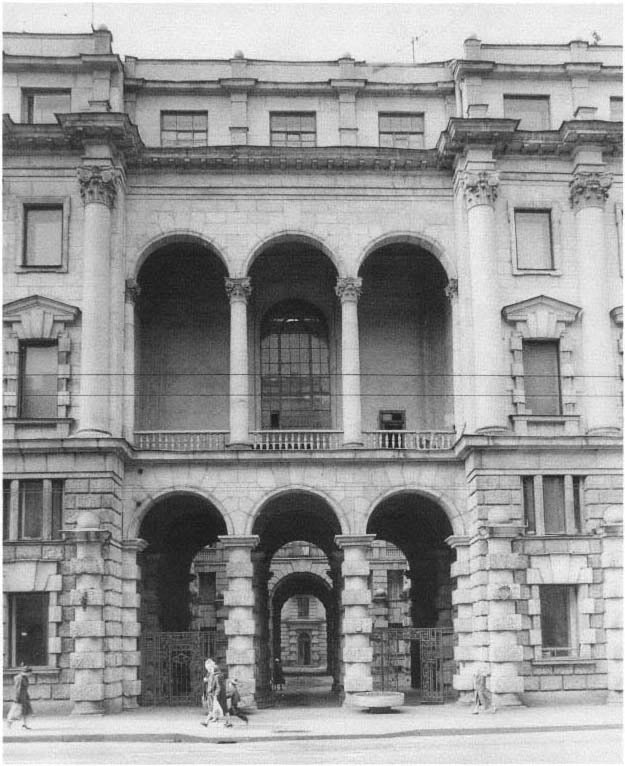
Fig. 270.
Residence of the emir of Bukhara, Kamennoostrovskii Prospekt, Petersburg. 1913. Stepan Krichinskii
(Brumfield L71-80).
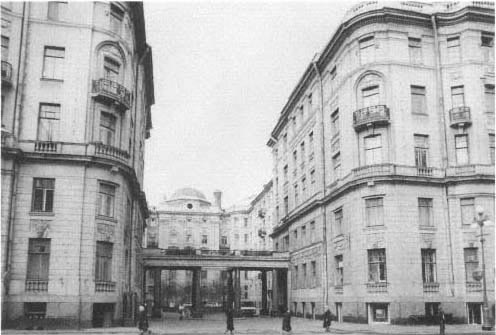
Fig. 271.
Apartment house of the First Russian Insurance Company, Kamennoostrovskii Prospekt,
Petersburg. 1911–1913. Iulii Benois, Leontii Benois (Brumfield L70-2).
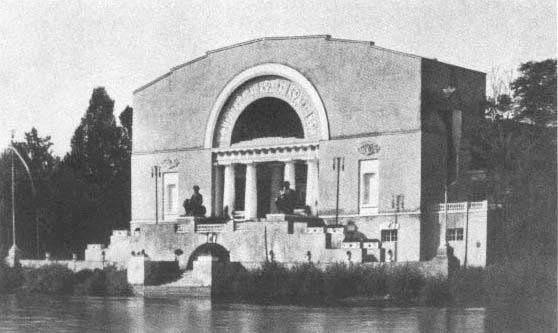
Fig. 272.
Russian Pavilion at 1911 Turin International Exhibition. Vladimir Shchuko. Ezhegodnik
Obshchestva arkhitektorov-khudozhnikov , 1911.
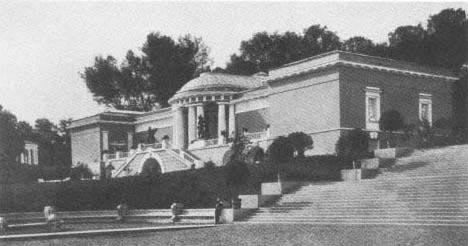
Fig. 273.
Russian Pavilion at 1911 Rome International Exhibition. Vladimir Shchuko.
Ezhegodnik Obshchestva arkhitektorov-khudozhnikov , 1911.
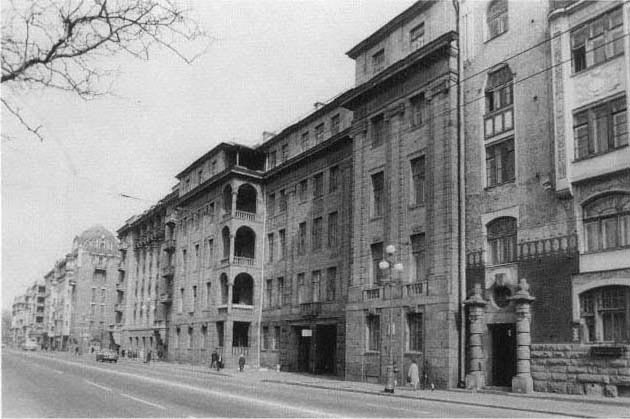
Fig. 274.
Markov apartment house No. 63 Kamennoostrovskii Prospekt, Petersburg. 1908–1910. Vladimir Shchuko.
At left, adjacent to No. 63, is the second of Shchuko's buildings for Markov, No. 65 (Brumfield L73-36).
After his trip to Italy [in 1905], mainly to study Palladio in Vicenza and to take measurements of the work of Giulio Romano in Mantua, Shchuko became noticeably Italian, as is evident . . . in one of the facades of the Markov building on Kamennoostrovskii Prospekt. The second facade [No. 63], with its marvelous loggias, is already executed in the forms of the rinascimento ; the treatment of ornament is charming, displayed in the strip carving of the stone.[30]
The Markov apartment house at No. 63, however, is no simple stylization, for it combines classical elements in a monumental design that is neither historical nor modern. Shchuko developed a style appropriate for contemporary urban architecture, one that provided material evidence of the classical values propagated by Lukomskii:
The buildings designed by the architect V. A. Shchuko (Nos. 63–65 Kamennoostrovskii Prospekt) were the first classical structures in the new sense of that word; and indeed, not only their general forms but their details were borrowed from the originals and applied to the new conditions of the apartment house.
Implementation itself, moreover, is beginning to play an important role: both the design and the working out of details matter.[31]
The most striking attention to detail appears, paradoxically, in the undecorated rectangular windows. Generally the windows of an apartment building advertised its interior comfort and aesthetic pretension. Yet Shchuko used the simplest of designs, recessed in a flat stone surface and without surrounds or mullions.
His subsequent, adjacent, apartment house for Markov (No. 65; built in 1910–1911) adopted a more histrionic approach in its massive articulation of the classical orders (Fig. 275). The attached Ionic columns rise four floors, from the second floor to the attic, which is designed like a colossal broken cornice. The shafts of projecting window bays are wedged between columns that balance practicality and architectural fantasy. Much as he had praised the loggias and the subtle details of No. 63, Lukomskii was even more impressed by the hypertrophied forms of No. 65, which seemed to prove that the classical orders could be applied on a scale commensurate with the needs of a modern city:
Undoubtedly Shchuko's greatest service is to have solved that most difficult problem of designing the facade of an apartment building. The corner building for Markov [No. 65] is superb in its integrity; the order of the columns is maintained through all the floors, one of which [the fifth] is even inserted between the breaks in the entablature. The device of the Casa del Diabolo in Vicenza has found a clever application. The details of the building are also executed successfully. The graceful capitals of the pilasters are superb. Less successful are the consoles of the first-floor balconies, in a baroque spirit that does not suit the architecture of Palladio.[32]
Shchuko, rejecting all trace of the moderne, had created a form that would prove influential in the second "revival" of neoclassicism (and concomitant rejection of modernism) in the 1930s. Although the second phase of the Markov apartments had its clearest influence in Ivan Zholtovskii's design for an apartment building on Marx Prospekt in Moscow (1935), the ramifications of Shchuko's neoclassicism appeared in many other, less obvious, forms during the retrospective phase of Soviet architecture—indeed, until the late 1950s. The artistic sensitivity of neither Shchuko nor Lukomskii, however, obscures the contradictions in their determined rejection of a modern architectural idiom. Lukomskii, seizing on the success of Shchuko's work, rejected a future he professed was inevitable in favor of a past he dared not relinquish.
With the disavowal of modernism, Russian architectural discourse again turned to the questions of guiding ideals and the threat of aesthetic chaos. When Aleksandr Benois published in 1910 an article entitled "The Death of Architecture," Kurbatov testily responded in his "Decline or Death?":
The decline of architecture in Russia! . . . How could it be otherwise when the major patron—the government—has not been guided by artistic demands since the mid-nineteenth century and when the wealthy during the same period have built nothing for themselves. That leaves apartment buildings. If you build them in the form of a box, with no decoration whatsoever, it would be no loss. . . . In Petersburg each of them screams, magnifying the cacophony.[33]
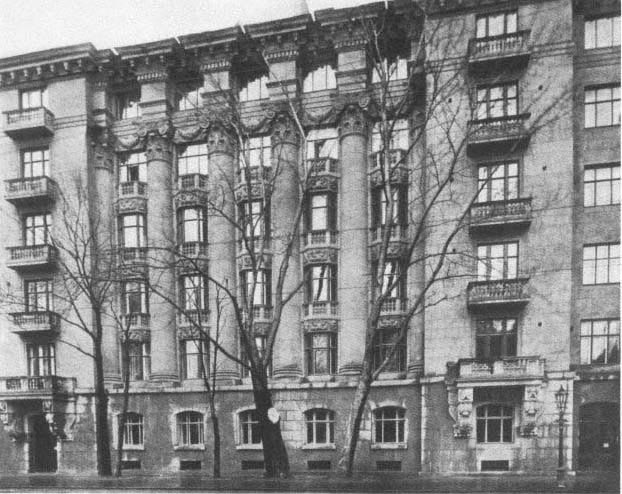
Fig. 275.
Markov apartment house, No. 65 Kamennoostrovskii Prospekt. 1910–1911. Vladimir Shchuko. Ezhegodnik
Obshchestva arkhitektorov-khudozhnikov , 1911.
At the Fourth Congress of Russian Architects, held in Petersburg in January 1911, Lukomskii succinctly defended the neoclassical revival as the proper style of the times. Having dismissed the style moderne as a rootless invention of "a little decade-long epoch of individualism," he noted with relief the return to eternal principles in architecture:
Convinced, after an epoch of agitated searching for a new form, new beauty and ornamentation, that bright achievements are impossible without new constructive devices and materials, architecture—like art—became ashamed of its irrationality. It is again joyously repeating and taking as its base the old national forms while waiting for the decisive discoveries of an iron architecture that has not yet found its superb form.[34]
In his sketch of the neoclassical revival, Lukomskii, like Aleksandr Benois, criticized the facile Empire motifs ("pastry-cake Empire") but approved the "stern taste of Italian [Renaissance] architects" exercised by Shchuko, Lialevich, Lidval, and Girshovich—all active in Petersburg.[35] Lukomskii's comments on the as-yet-undiscovered aesthetic properties of modern architecture were disingenuous; he overlooked advances in design that had
appeared in Moscow, particularly in the recent commercial buildings of Shekhtel. But then Moscow had been far more receptive to the style moderne and was correspondingly less active in the neoclassical revival.
Although many apartment buildings in Moscow followed the new fashion for neoclassical detail, few of them constituted coherent expressions of the revival style. Among the exceptions are the Shcherbatov apartment house, built in 1912–1913 by A. I. Tamanov (Tamanian) on Novinskii Boulevard, which resembles a hypertrophied version of a Moscow urban villa from the late Empire period (Fig. 276), and the I. E. Kuznetsov apartment house on Miasnitskaia Street (1910), another massive Empire design by A. N. Miliukov and Boris Velikovskii, assisted by the future Constructivists Viktor and Aleksandr Vesnin (Fig. 277).[36]
For Lukomskii, Moscow's aberrant preference for the style moderne was typical of the city:
Nowhere did these strivings for the new appear so curiously as in Moscow, where the bizarre refrains of this new movement achieved outlandish results and forms. As in the architecture of all the epochs that are so distinctly and willfully manifested in Moscow, so in the buildings of the new epoch there is a display of that peculiar Moscow variety.[37]
For Lukomskii, as for Lialevich, architecture developed not in materials and technical innovations but as an expression of the national spirit. Although many before him had reasoned similarly to justify a nationalist architecture, Lukomskii rejected the idiosyncratic variant of the Russian architectural tradition represented by Moscow and—surprisingly—located the national spirit in the move to Europeanize the country that was symbolized by the Western architecture of the imperial capital. Although the church was no longer creative, and the state and society had not yet produced a secular order for the new architecture to reflect, Lukomskii was optimistic: "For the time being we are again in an epoch of renewal, purification, peace, and diligent study, striving to apply this study to the needs of our days."[38]
In light of subsequent events few statements have proved more illusory; even during the relatively prosperous lull between 1906 and 1914, a psychic tension underlay the new architectural forms of Petersburg, compounded of bombastic assertion and grotesquerie. This trait, already mentioned as a characteristic of banks, appeared as well in the heart of the Kamennoostrovskii Prospekt, whose elegant luster gave Lukomskii so much hope for the European future of the city.
By 1910 the upper reaches of the street had a crucial "anchor" in the square where Bolshoi and Kamennoostrovskii, the two major thoroughfares of the Petersburg Side, intersect. When the civil engineer and developer Konstantin Rozenshtein convinced city authorities to extend Bolshoi Prospekt northeast of the square to the banks of the Karpovka River, this small stretch, the equivalent of a few blocks in length, immediately became one of the city's most active building sites for new apartment houses.[39] The area adjacent to the square belonged to Rozenshtein, who required an imposing, assertive style for the two apartment houses he planned to construct on a trapezoidal site. By 1911 he had sketched the rough outlines of the two buildings; for the design of the facades he turned to the architect Andrei Belogrud, who had graduated from the Academy of Arts the preceding year.[40]
Belogrud's designs were shocking, even by the effusively "rhetorical" standards of the time. The first apartment house, at No. 77 Bolshoi Prospekt (1912–1913), was a variation on Shchuko's second Markov building; colossal attached composite columns dominate the facade (Figs. 278, 279). Whereas Shchuko's facade was wide enough to frame the columns, Belogrud's has only the six columns with flat square windows between them (Shchuko's design has projecting bays). Above the sixth floor a large broken cornice with massive dentils projects over the column shafts—but not as a culmination, as Shchuko would have had it, for above it six classical statues stand on a second cornice. The entire facade, surfaced in gray granite, is visually subordinate to this statuary.[41]
Although statues were common on Petersburg's baroque palaces, as on Renaissance structures (including, of course, those by Palladio), the grotesque concentration of them on an apartment house was unprecedented. The effrontery of the design gives the building panache, but the decoration is nonetheless disorienting. Even Fomin's design of New Petersburg had not projected such an incongruous use of Roman classicism. The pomposity of the facade is intensified by granite nude forms in high relief crouched between the capitals above the fifth story (cf. Girshovich's Siberian Trade Bank, Fig. 260). The tension expressed in these contorted figures is repeated in the massive keystones of the central windows.
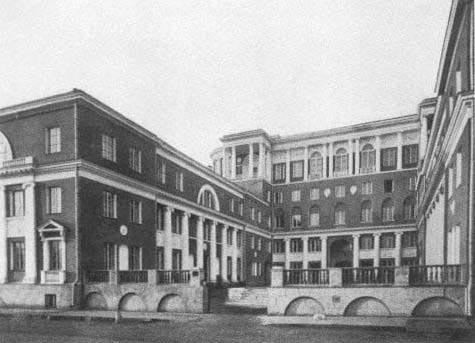
Fig. 276.
Shcherbatov apartment house, Moscow. 1912–1913. A. I. Tamanov (Tamanian).
Ezhegodnik Obshchestva arkhitektorov-khudozhnikov , 1912.
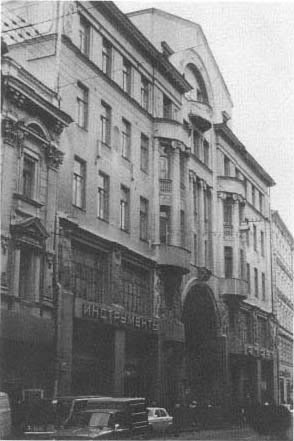
Fig. 277.
Kuznetsov apartment house, Moscow. 1910.
A. N. Miliukov, Boris Velikovskii (Brumfield M154-16).

Fig. 278.
Rozenshtein apartment house, Petersburg. 1912–1913. Andrei Belogrud (Brumfield L89-28).
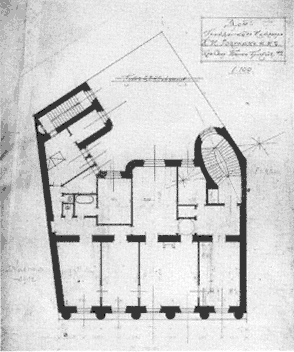
Fig. 279.
Rozenshtein apartment house plan.
In his second apartment building for Rozenshtein, at No. 35 Kamennoostrovskii Prospekt (1913–1915), Belogrud replaced the Renaissance forms with a rustic interpretation of medieval provincial Italian architecture (Figs. 280, 281). Although pretentious, the building nonetheless fits its site, on a large city square. The two towers flanking the main entrance suggest medieval town fortifications, but the picturesque quality derives primarily from the rusticated quoins and lancet window surrounds on the massive stuccoed walls.
Although Belogrud later handled the rustic Italianate form with restraint, eclectic decoration still prevails in the second Rozenshtein building.[42] As a result, Rozenshtein's development project, dominated by Belogrud's strikingly different designs for two major structures (a third was further up Bolshoi Prospekt) produced what critics called a cacophony of styles (Fig. 282). Even Lukomskii, who approved the Italian character of Belogrud's work, doubted the aesthetic wisdom of construction guided only by speculative commercial interests:
One must regret . . . that in this area, where a new city might gradually form, no general plan was worked out in advance, and now this "fortunate" street presents a conglomeration of buildings in all styles, from the medieval to the moderne. And how can one fight this evil [a variety of styles and devices] when the same architect [Belogrud] constructs in one area, in two to three years, three buildings of undoubted architectural interest but all in a different character? This means that eclecticism still looms large, or that even a good master must resort to various styles to satisfy various commissions.[43]
Although Lukomskii was responding specifically to Belogrud's work, his rhetoric suggests both postrevolutionary regulatory goals and Soviet attacks on "chaotic" design and construction under capitalism. The cult of individualism both Fomin and Lukomskii had criticized in the style moderne now flourished in the neoclassical revival—even in its "Italian" branch. Having ignored the economic implications of the fashionable Europeanized Petersburg he envisioned, Lukomskii revealed his unease with the entrepreneurs essential to the development of private apartment buildings.
Developers like Rozenshtein competed for the same prosperous clientele that had stimulated the construction of apartments in the new style. The stylistic identity of each building advertised its amenities—and justified the price of a fashionable address. In praising the
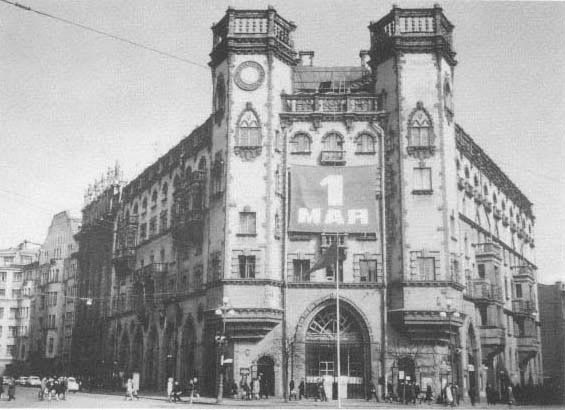
Fig. 280.
Rozenshtein apartment house, No. 35 Kamennoostrovskii Prospekt. 1913–1915. Andrei Belogrud
(Brumfield L-49).
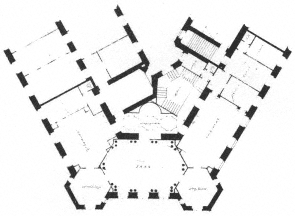
Fig. 281.
Rozenshtein apartment house, No. 35 Kamennoostrovskii
Prospekt. Plan. Ezhegodnik Obshchestva
arkhitektorov-khudozhnikov , 1915.
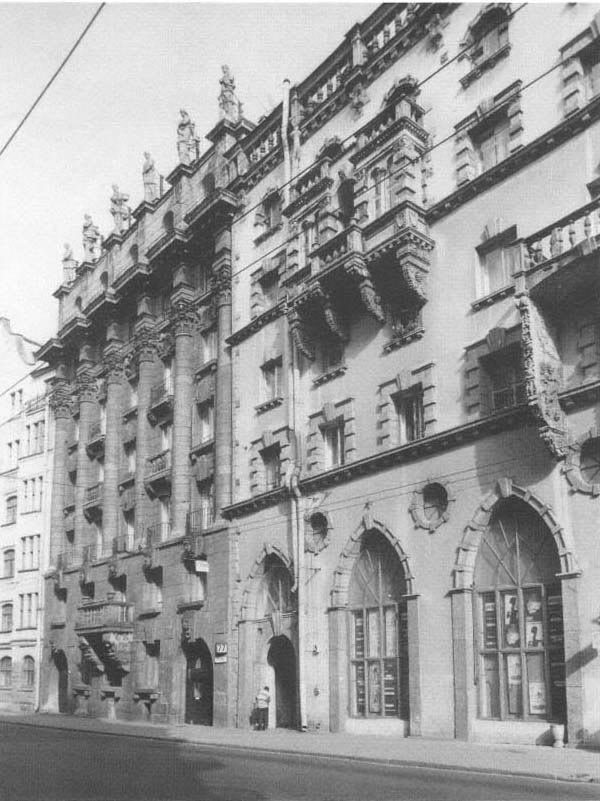
Fig. 282.
Rozenshtein apartment houses (Brumfield L89-25).
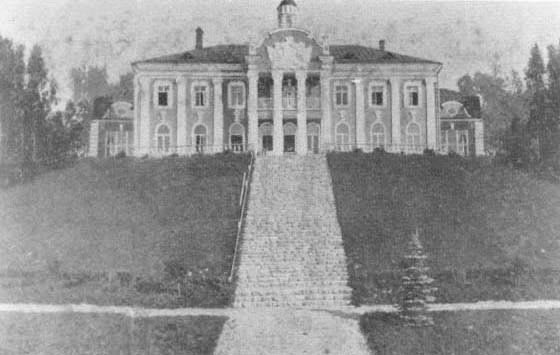
Fig. 283.
House of Prince A. V. Obolenskii, Lake Saimaa, Finland. 1911. Ivan Fomin. Ezhegodnik
Obshchestva arkhitektorov-khudozhnikov , 1913.
classical monumentality of contemporary urban housing—particularly in unrealistic projects on the scale of New Petersburg—Lukomskii attempted to impose a precapitalist architectural ideal in a capitalist environment. That he did so consciously is evident in his comments on Fomin in a survey of neoclassical architecture in Apollon :
The unquestioned beauty of Fomin's work is close to the very basis of Old Petersburg; so it is unforgivable not to make use of this master! Moreover, Fomin's art does not at all correspond to the contemporary economic spirit of calculation and triviality, of contemporary cheapness and bad workmanship; this, of course, makes it difficult for him to work on the construction of apartment houses. Therefore, . . . the development of an entire area of the city [Golodai Island], with new apartment houses and other structures . . . wholly based on splendid traditions and implemented so that not one detail would detract from the impression of the whole, is not, it seems, to be realized.[44]
One might dismiss Lukomskii's views as those of a disgruntled aesthete did they not express a fundamental intellectual opposition to capitalism itself in Russia.
Indeed, the most refined evocations of a heroic past in Fomin's work, and that of the neoclassical revival generally, were in private mansions, an architectural genreremote from the major concerns of contemporary urban architecture. Fomin, the undoubted master of this genre in Petersburg, created houses and interiors derived primarily from the late Empire style in Russia, but modified to exaggerate certain tectonic features and simplify decorative elements of the exterior. His talent for interior work had already appeared in his furniture designs as well as in the Pomer apartments; many of his early neoclassical projects were interiors. In 1909 he began the interior of the house of Princess Maria Shakhovskaia (on Fontanka Quay at the Anichkov Bridge), completing it after his return from Italy in 1911. At the same time, he rebuilt a country villa for Prince A. V. Obolenskii on Lake Saimaa (in Finland) that interpreted the classical style in the manner of early Petrine architecture (Fig. 283). In 1912 he constructed a more typical
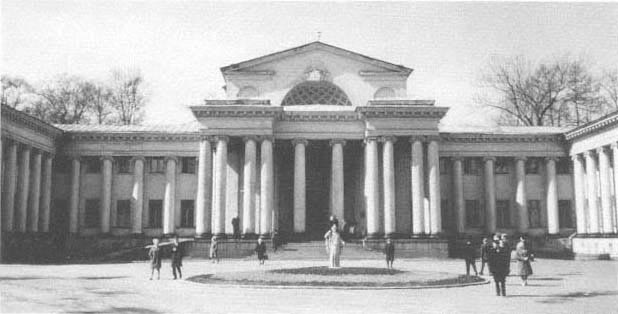
Fig. 284.
Polovtsev dacha, Stone Island, Petersburg. 1911–1913. Ivan Fomin (Brumfield L-45).
neoclassical country house for Prince A. G. Gagarin on his estate of Kholomki (east of Pskov).[45]
Fomin's greatest achievement in the neoclassical revival took shape on Stone Island, where a number of private houses had been built in the style moderne. The site of Fomin's house for the prominent diplomat A. A. Polovtsev was perhaps the most desirable on the island: directly across the Middle Nevka River from Rossi's magnificent Elagin Palace. Karl Shmidt conceived the original plan for the project in 1909, adopting the new fashion of neoclassicism; when the senior Polovtsev died, his family hired the more talented Fomin to produce a new design.[46] Drawing on motifs of the Russian Empire style, Fomin applied them on a large scale—as though he could reaffirm classical values only by amplifying them.
The courtyard facades follow a late eighteenth-century design, but the central structure and its relation to the parts are grander than in even the most luxurious neoclassical houses (Figs. 284, 285). Both the wings and the central structure contain an Ionic colonnade with a simple entablature and oversized dentils that mark the upper level of the two-storied structure. A double-columned portico, extended forward on either side, frames the central enfilade, whose pediment rises above the rest of the structure. The entrance is defined by a semicircular niche with a coffered ceiling that serves as a light trap.
The attention to detail and the scale—more appropriate to a museum than a dwelling—continues on the interior, where a circular vestibule leads to the heroic Gobelin Hall (so named for the five tapestries it contained, with its chandelier and arched, coffered ceiling; its gilded white doors in the Empire style; and the pattern of the black and white marble floor (Fig. 286). Distant echoes of Pompeii (excavations there were discussed in Zodchii ) are reinforced by wall paintings of classical ruins (in the style of Paestum) on the lunettes beneath the vault.[47]
Beyond the double doors is the White-Columned Hall, whose scagliola columns support a ceiling of three vaults, the main one preserved from the early nineteenth-century dacha of Baron Ludwig Stieglitz originally on the site.[48] The Italian ceiling, apparently preserved from this dacha, is comparable to that of the great White Hall in Carlo Rossi's Mikhailovskii Palace, whose design, however, is more elaborate. The main enfilade concludes with a semicircular conservatory, from which the Elagin Palace across the river can be seen.
The other rooms of the main structure show the
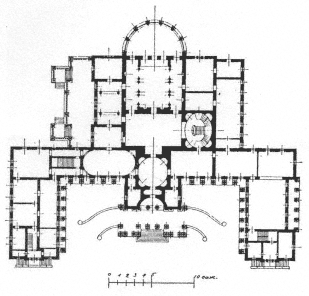
Fig. 285.
Polovtsev dacha plan. Ezhegodnik Obshchestva
arkhitektorov-khudozhnikov , 1916.
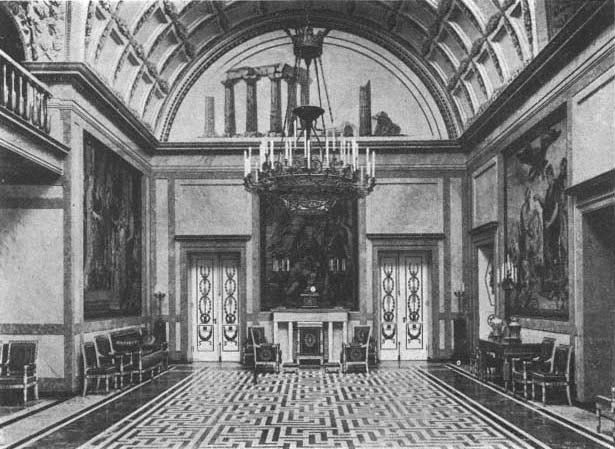
Fig. 286.
Polovtsev dacha, Gobelin Hall. Ezhegodnik Obshchestva arkhitektorov-khudozhnikov , 1916.
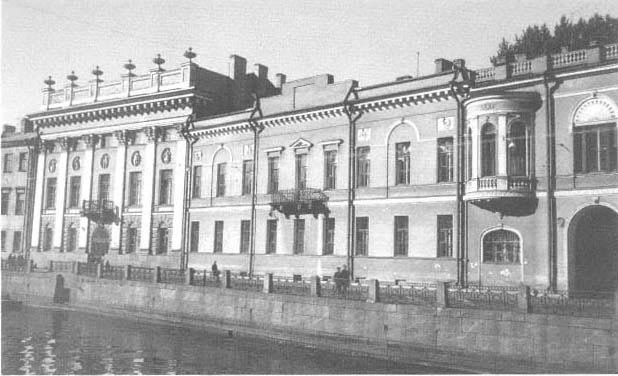
Fig. 287.
Abamalek-Lazarev house, Petersburg. 1913–1915. Ivan Fomin (Brumfield L-46).
same attention to spatial design and decorative detail, though on a smaller scale. This house (the Polovtsevs had an equally palatial residence in the city) might well have been the greatest built in Petersburg at the beginning of this century—and one of the last. The extensive interior decoration, which involved the work of Roman Meltser and the painter Ivan Bogdaninskii, was completed in 1916; since the revolution, its grand halls and rooms, with wall and ceiling paintings preserved, have been used variously as a retirement home and a sanatorium.
In 1913–1915 Fomin built the second of his neoclassical revival houses, for Prince S. S. AbamalekLazarev at No. 23 Moika Quay. In effect the house, in a densely constructed central area of the city, included three buildings from the eighteenth century; each had its own distinctive facade on the Moika and on Millionaia Street (the west side of the lot). Fomin's commission was to rebuild a four-storied structure on the Moika, with a neoclassical facade and greatly expanded state rooms (Fig. 287). On the stuccoed surface six Corinthian pilasters extend from a rusticated ground floor to a third level, whose small windows are barely noticeable between the Corinthian capitals. The pilasters frame five medallions with plaster reliefs of dancers in classical attire. Though faithful to the spirit of the Empire style, the details are so prominent in the constricted space of a Petersburg townhouse that they comment on, rather than reproduce, the old style.
The classical features on the interior are similar to those of the Polovtsev house but are even more ingenious in view of Fomin's spatial limitations. Most of the smaller, private, rooms were in the other parts of the structure; Fomin designed a grand staircase, a banqueting hall, and a theater—all luxurious re-creations of the nineteenth-century neoclassical ambience, with coffered ceilings, false marble columns, delicate parquetry, plaster relief medallions, and wall and ceiling paintings (Figs. 288, 289). Here, as at the Polovtsev mansion, Fomin enshrined a past epoch in what is virtually a museum setting.[49]
In retrospect Fomin's burst of creativity in designing neoclassical revival mansions and interiors seems like an effort to accomplish as much as possible in his elegiac
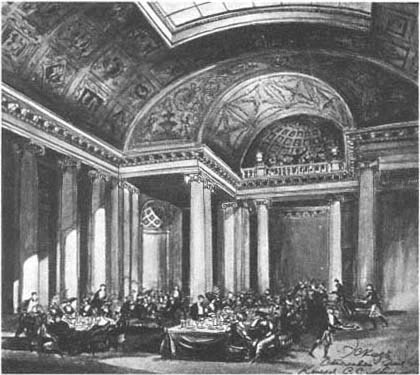
Fig. 288.
Abamalek-Lazarev house. Sketch of dining hall. Ezhegodnik Obshchestva
arkhitektorov-khudozhnikov , 1913.
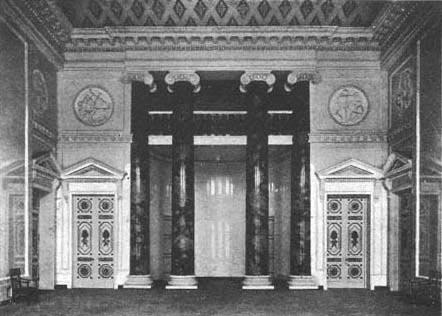
Fig. 289.
Abamalek-Lazarev house. Ezhegodnik Obshchestva arkhitektorov-khudozhnikov ,
1916.
style before the deluge. In addition to the work just discussed, he constructed at least four estate houses in Finland and in Podolsk Province, as well as a number of other interiors in Petersburg—including those for houses of the Ratkov-Rozhnov family, Count Ivan Vorontsov-Dashkov, and Senator D. B. Neidgardt.[50] Each of these interior designs is notable for decorative details and applied techniques based on an exhaustive study of the Russian neoclassical style (Fig. 290). At the same time, each displays the abstract, cerebral quality of a stylization.
Other Petersburg architects also excelled in designing neoclassical revival houses. Although Georgii Lukomskii criticized Marian Lialevich's Italian villa for M. K. Pokotilova (1909) on Kamennoostrovskii Prospekt (Fig. 291) for its "timid proportions" and "excessively precious and saccharine handling of details," it represented a first step toward Lialevich's mature use of classical elements in the Bykovskii apartment building and in his work for Mertens.[51] A nobler effort, not mentioned by Lukomskii, was Andrei Ohl's exquisite townhouse for T. V. Belozerskii on Bolshaia Dvorianskaia (1913). Like many of his contemporaries, Ohl had moved from the style moderne to the neoclassical revival; although his dacha for V. A. Planson on Stone Island (1912; destroyed in 1968) showed both modern and classical elements, the Belozerskii house offers an assured interpretation of neoclassicism in the manner of Matvei Kazakov, whose late eighteenth-century mansions in Moscow are the quintessential expression of this style of domestic architecture.[52]
The greatest concentration of neoclassical revival houses is on Stone Island, whose rapid development during the years just before the war produced a wide range of interpretations of the style. In 1913 Vladimir Apyshkov built a grand mansion for S. N. Chaev. The architect's earlier style moderne townhouse for Chaev (see Figs. 208–211) represents one extreme of fashion and the mansion, with its circular, open colonnade above a large Ionic portico, another: the monumentality of Palladian architecture (Fig. 292). Not far from the Chaev house is the F. Mertens mansion (1911) by Lialevich; both houses are abstracted compilations of classical devices, primarily Italian; unlike Fomin's work, they bear little resemblance to Russian prototypes in the Empire style. Somewhat smaller but no less luxurious is Nikolai Verevkin's Italian Renaissance villa for Elena Krilichevskaia (1914) in the central part of the island (Fig. 293).
Although Italian imitations predominated in the last phase of construction on Stone Island, the Russian neoclassical, or Empire, style appeared in Moisei Siniaver's design for the M. A. Vurgaft mansion (1913) and in Mikhail Devishin's smaller dacha (1914) for Doctor V. M. Bekhterev, the noted Russian neuropathologist.[53] The Bekhterev house combines the complex plan of the style moderne (as in Shekhtel's neoclassical house) with such classical elements as the channeled Greek Doric columns of the entrance porch and, to the right of it in Figure 294, the exterior of the sitting room. Although plaster motifs from the Empire period decorate the elevated pediments of both the main and south facades, the structure itself and the eaves suggest a late nineteenth-century cottage rather than an Empire-style country house. This charming design, by a virtually unknown architect, demonstrates the pervasiveness of the neoclassical revival in even modest, "vernacular" architecture. Whereas Fomin's neoclassical work was commissioned primarily by the Russian nobility, most of the other houses were built by "new money," presumably emulating the social values of the ancien régime.
The neoclassical revival style was applied less extensively in Moscow than in Petersburg, yet it served Moscow effectively as a monumental expression of new wealth and cultural respectability. No critic promoted the revival there as the representation of social stability through classical architectural principles. Moscow accommodated the style as the latest fashion. The most prominent of Moscow's new classicists was Ivan Zholtovskii, who graduated from the Academy of Arts in 1898 and the following year joined the faculty of the Stroganov Institute, where his colleagues included Fedor Shekhtel. Zholtovskii's first major work, the headquarters of the Racing Society in Petrovskii Park (1903–1906), demonstrated both his self-assurance and his original approach to classical form (Fig. 295). Elena Borisova has argued persuasively that the Racing Society building embodies not a single interpretation of Russian neoclassicism but a combination of Empire and Renaissance forms (the latter on the interior) that owes much to the stylistic experimentation of the style moderne.[54]
The power of architecture to express wealth is no-where demonstrated more amply than in Zholtovskii's mansion for Gavriil Gavriilovich Tarasov on Spiridonovka Street (1909–1912). Tarasov's father and two uncles made a fortune in the wholesale trade of manufactured goods in southern Russia (Ekaterinodar) and
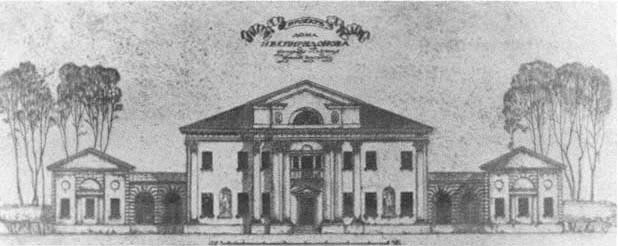
Fig. 290.
Project sketch for house of N. V. Spiridonov, Finland. Ivan Fomin. Ezhegodnik Obshchestva
arkhitektorov-khudozhnikov , 1913.
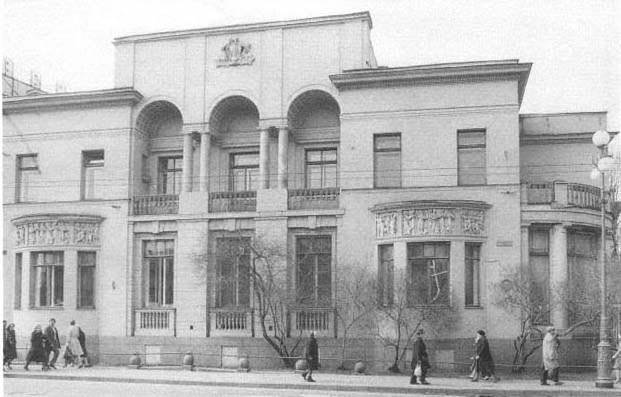
Fig. 291.
Pokotilova house, Kamennoostrovskii Prospekt, Petersburg. 1909. Marian Lialevich (Brumfield L71-86).
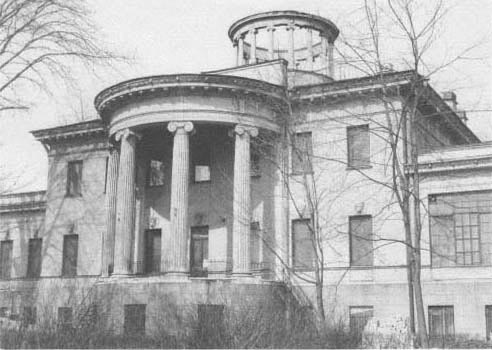
Fig. 292.
Chaev house, Stone Island, Petersburg. 1913. Vladimir Apyshkov (Brumfield L49-10).
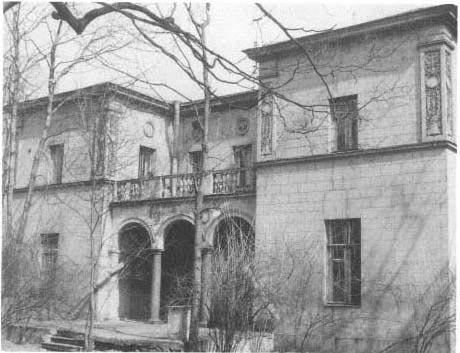
Fig. 293.
Krilichevskaia house, Stone Island, Petersburg. 1914. Nikolai Verevkin
(Brumfield L49-6).
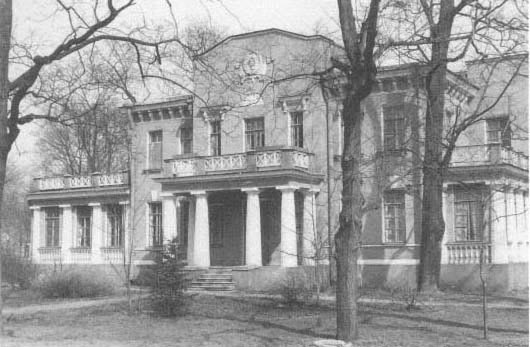
Fig. 294.
Bekhterev house, Stone Island, Petersburg. 1914. Mikhail Devishin (Brumfield L49-3).
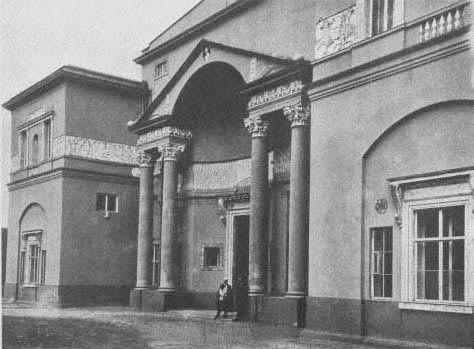
Fig. 295.
Moscow Racing Society. 1903–1906. Ivan Zholtovskii. Ezhegodnik Obshchestva
arkhitektorov-khudozhnikov , 1907.
subsequently moved to Moscow. Like many of Russia's wealthy merchants, the Tarasov brothers were legendary eccentrics, but the second generation moved rapidly into the cultural world.[55] Indeed, it would be difficult to imagine a more assertive statement of high culture than Zholtovskii's design of the Tarasov mansion, modeled on Palladio's Palazzo Thiena in Vicenza. According to the merchant chronicler Pavel Buryshkin, it "immediately became one of the landmarks of Moscow."[56]
No other Moscow house resembles it; and though the form, derived from the Renaissance, might seem a comic pretense on the part of a family from the southern steppes, the association with the merchants of Renaissance Italy has a certain logic (Fig. 296). With its heavily rusticated granite facade and chiseled Latin inscriptions—including one beginning Gabrielus Tarassof Fecit—the mansion symbolized the arrival of the merchant class; yet, as with the Petersburg banks of Peretiatkovich and Girshovich, such massive pretentiousness undercut the very notion of social stability. The lavish interior includes extensive wall and ceiling paintings by Ivan Nivinskii and Evgenii Lanceray.[57]
Lukomskii, of course, approved of the house as a brilliant interpretation of Renaissance forms:
It is already evident how well the mansion blends with the Moscow landscape surrounding it, consisting of stylistically varied imitations—the "Gothic chambers" of the Morozovs, the Vienna "moderne" of the Riabushinskii house [both by Shekhtel]. This new, seemingly authentic, Italian palace is a valuable ornament in this architectural mosaic.[58]
Lukomskii here seems to recognize tacitly the distinctiveness of the detached house as an expression of Moscow's individualistic, entrepreneurial culture.
The other major example of the neoclassical revival as an expression of new wealth in Moscow was the design by the firm of V. D. Adamovich and V. M. Maiat for the mansion of Nikolai Vtorov (completed by 1914). Adamovich and Maiat, both as a team and individually, were prolific architects who worked in a variety of styles (see Fig. 100). Their major work involved the design of classically inspired houses for the very rich, including two of the Riabushinskii brothers: Vladimir and Nikolai. The house for Nikolai Riabushinskii, in Petrovskii Park, provided a setting for the outré style of life maintained by this leading proponent of the artistic avant-garde.[59] Though decorated in a modernist fashion inside, the exterior was that of a conservative neoclassical villa whose white stuccoed walls belied the sobriquet of the house: "the Black Swan" (Figs. 297, 298).
The Riabushinskii brothers' wealth, however, paled in comparison with that of Nikolai Vtorov, whose father, Aleksandr Aleksandrovich, made a fortune through wholesale trade in Siberia. Nikolai—like the Tarasovs—resettled in Moscow, where he continued the Vtorov firm's interest in wholesale distribution while expanding into banking and manufacturing.[60] The design of the Vtorov house, derived from Moscow's neoclassical mansions of the early nineteenth century (particularly the work of Domenico Giliardi and Osip Bove), seems to have been inspired by a wish to re-create the Empire style on a scale twice as large as the original (Figs. 299, 300). The main hall, around which the house is organized, is almost 25 meters high, with an enormous silver and crystal chandelier suspended from its midpoint. The other rooms, in the rococo or neoclassical style, display equally luxurious decorative details that are scrupulously maintained in what is now Spaso House, the residence of the American ambassador to the Soviet Union.
Although other examples of the neoclassical revival in Moscow's mansions, such as the Mindovskii house by N. G. Lazarev (Fig. 301), offered little more than Adamovich and Maiat's competent reworking of a historical style, the revival achieved a measure of originality in large-scale public architecture, particularly the work of Ilarion Ivanov-Schitz, who used a modernized form of classical tectonics. The recessed Ionic portico of his Merchants' Club on the Dmitrovka (built in 1907–1908; now the Komsomol Theater on Chekhov Street) is flanked by square towers with classical elements whose form owes much to the Vienna Secession (Fig. 302). The advanced style is even more evident inside, where decorative shapes—streamlined, abstract—resemble those of contemporary Viennese design (Wagner, Hoffmann, Loos) and anticipate modern design in the West during the 1920s (Figs. 303, 304).[61] Ivanov-Schitz used a similar blocklike, classicized form on a much larger scale in his building for the Shaniavskii People's University (Fig. 305).[62]
The most versatile and productive adherent of the neoclassical revival in Moscow was Roman Klein, whose major contributions to the Russian Revival style (the Middle Trading Rows) and the moderne (the Muir and Mirrielees store) have already been discussed. Of some
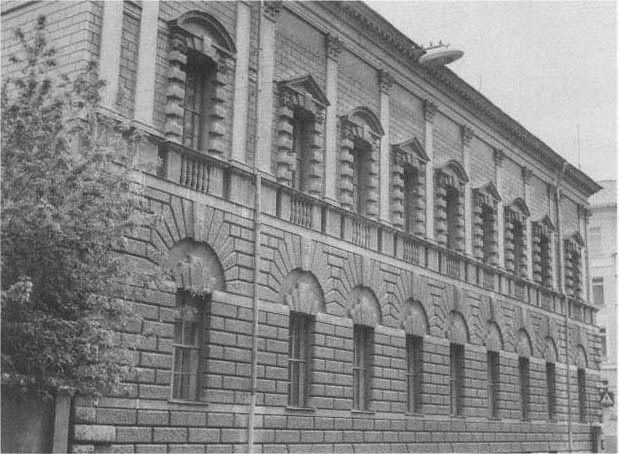
Fig. 296.
Tarasov house, Moscow. 1909–1912. Ivan Zholtovskii (Brumfield M103-3).
sixty buildings he completed in Moscow, the majority follow a variant of classicism—a reflection of his trip to Italy in 1882, a year after his graduation from the Academy of Arts. The most prominent of these buildings was the Museum of Fine Arts, established by Professor Ivan Tsvetaev (father of the poet Marina Tsvetaeva) under the auspices of Moscow University. In 1897 Klein won the design competition, sponsored by the Academy of Arts. A large part of the unfinished building was damaged by fire in December 1904; and from 1906 to 1908 further work was threatened when a financial depression affected the largess of Iurii Nechaev-Maltsev, a leading glassware manufacturer in Russia and the major private donor to the museum.[63]
In 1912, Klein received the title Academician of Architecture from the Academy of Arts in recognition of his work on the monumental structure (Fig. 306). Indeed, with its combination of Greek and Roman elements and the highly professional finish of both its interior and its granite- and marble-clad exterior, it is comparable to contemporary museums and public buildings erected elsewhere in Europe and in America. The eclectic design has been justified as an effort to incorporate elements of classical architecture into a museum originally intended for ancient and Renaissance art (see Plate 38).[64] Klein had studied the latest forms of museum construction in Europe, and he built a temple to the arts that expressed civic pride and private patronage, thus pleasing his benefactor, Nechaev-Maltsev, and creating what Lukomskii would have called approvingly a "European" building, noticeably different from the public and commercial buildings whose neoclassicism derived from the local Empire style.
Klein's building for the Institute of Mineralogy and
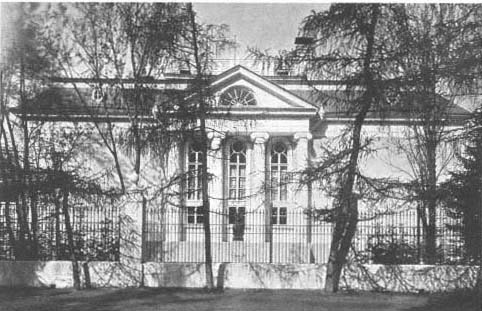
Fig. 297.
Nikolai Riabushinskii villa, Moscow. Ca. 1909. V. D. Adamovich, V. M. Maiat.
Ezhegodnik Moskovskogo arkhitekturnogo obshchestva , 1910–1911.
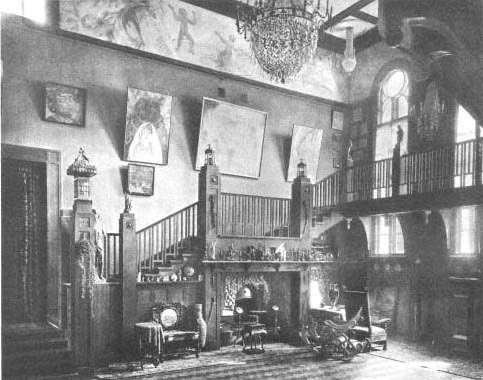
Fig. 298.
Nikolai Riabushinskii villa. Ezhegodnik Moskovskogo arkhitekturnogo
obshchestva , 1910–1911.
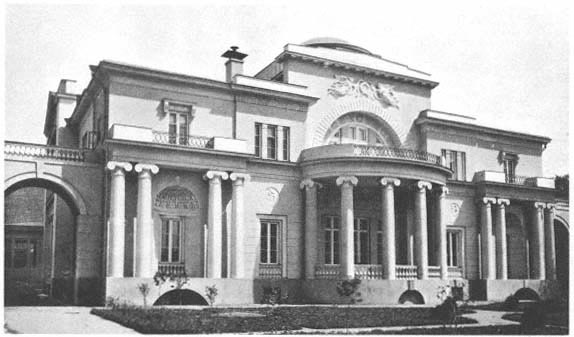
Fig. 299.
Vtorov house, Moscow. 1912–1914. V. D. Adamovich, V. M. Maiat. Ezhegodnik Moskovskogo
arkhitekturnogo obshchestva , 1914–1916.
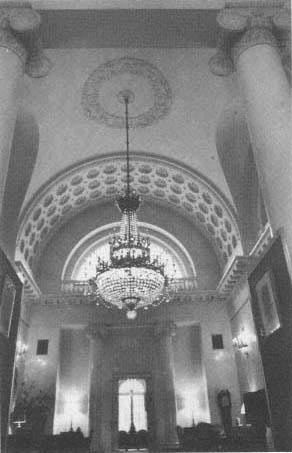
Fig. 300.
Vtorov house, main hall (Brumfield M140-14).
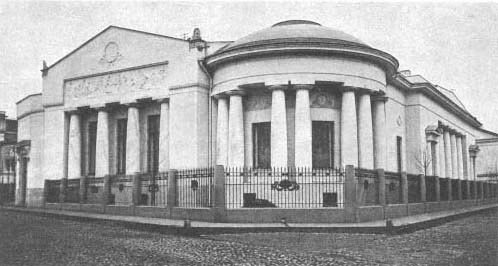
Fig. 301.
Mindovskii house, Moscow. Ca. 1908. N. G. Lazarev. Ezhegodnik Moskovskogo
arkhitekturnogo obshchestva , 1909.
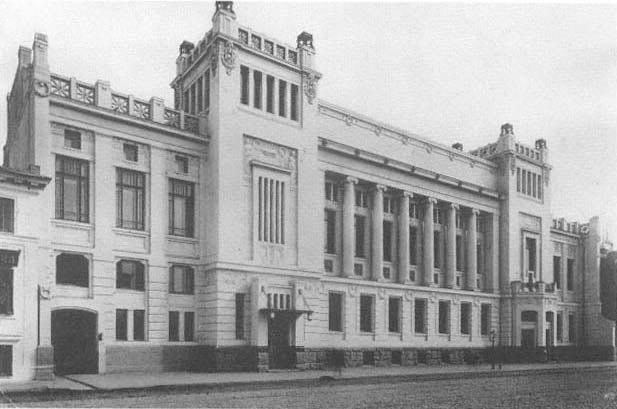
Fig. 302.
Merchants' Club, Moscow. 1907–1908. Ilarion Ivanov-Schitz. Ezhegodnik Moskovskogo
arkhitekturnogo obshchestva , 1909.
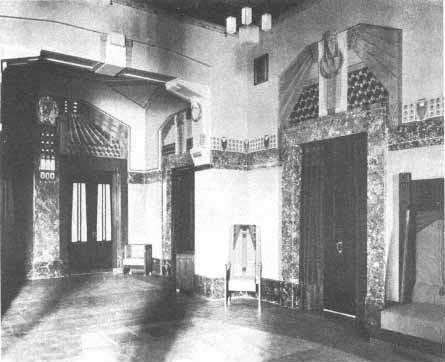
Fig. 303.
Merchants' Club, vestibule. Ezhegodnik Moskovskogo arkhitekturnogo
obshchestva , 1909.
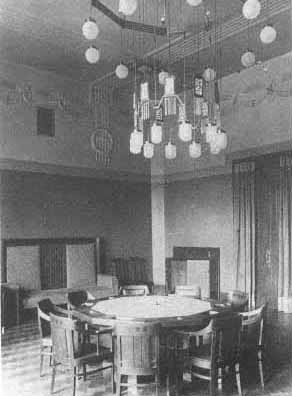
Fig. 304.
Merchants' Club, meeting room.
Photograph ca. 1908.
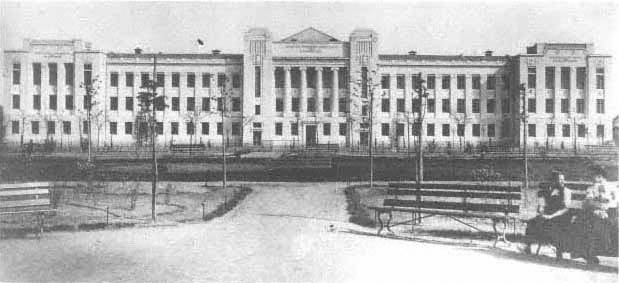
Fig. 305.
Shaniavskii People's University, Moscow. 1910–1913. Ilarion Ivanov-Schitz.
Photograph ca. 1914.
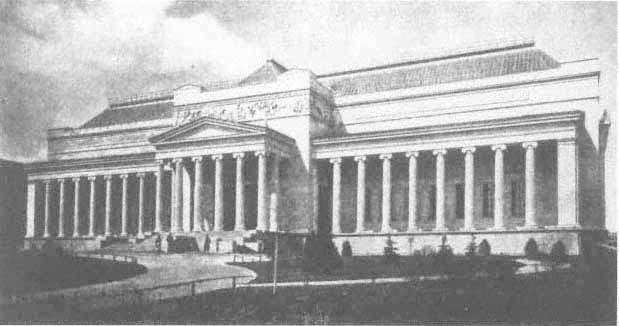
Fig. 306.
Museum of Fine Arts, Moscow. 1897–1912. Roman Klein. Moskovskii arkhitekturnyi mir , 1913.
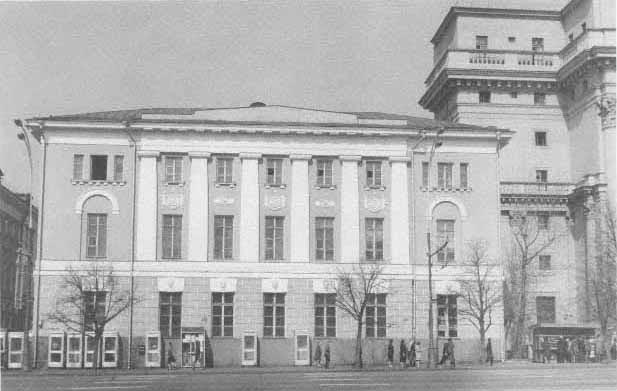
Fig. 307.
Institute of Mineralogy and Geology, Moscow. 1914–1918. Roman Klein (Brumfield M55-6).
Geology, constructed in 1914–1918, exemplifies precisely the local Empire style; it follows faithfully Giliardi's post-1812 reconstruction of the main building of Moscow University, in the adjacent block (Fig. 307), whose renovation Klein was supervising at the same time. But he did his most ambitious work in the retrospective manner at Arkhangelskoe, near Moscow, where he constructed a mausoleum (1911–1916) for the Iusupov family in the Palladian style, with a domed chapel and curved double colonnade extending from either side.[65] The design and materials (including gray granite and marble) were of the highest quality, and the building has been carefully maintained in its cold magnificence (Fig. 308). Ivan Nivinskii, who had directed the wall painting of the Museum of Fine Arts, decorated the interior (see Plate 39).
Klein's later work drew on a number of historical styles. His building for the Moscow Choral Synagogue had a neoclassical exterior and a Byzantine interior.[66] The facade for his Coliseum Cinema on Chistoprudnyi Boulevard (1914) suggests a classical temple (freely interpreted), with a semicircular Ionic portico and a recessed entrance framed by a large arch beneath the central pediment (Fig. 309). Although the neoclassical reference is clearly stated, the articulation of volume and the oversized decorative motifs derive indisputably from the style moderne (as in Fomin's early designs for country houses). No movie house in Petersburg was so impressive; and one might speculate on the expectations placed upon the new art medium in the creation of such a monumental structure.[67]
Indeed, by 1910 Moscow was being refashioned by monumental neoclassicism as classically inspired structures arose at dominant points in the city landscape. Klein's Museum of Fine Arts and Ivanov-Schitz's Shaniavskii People's University are two of the many examples of neoclassical revival buildings on squares or near major intersections. Another example is Sergei Solovev's building for the Higher Women's Courses (1910–1912) on Malaia Pirogovskaia Street, near the
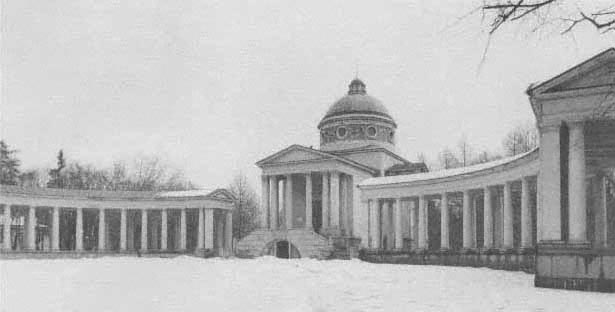
Fig. 308.
Iusupov mausoleum, Arkhangelskoe. 1911–1916. Roman Klein (Brumfield MR13-8).
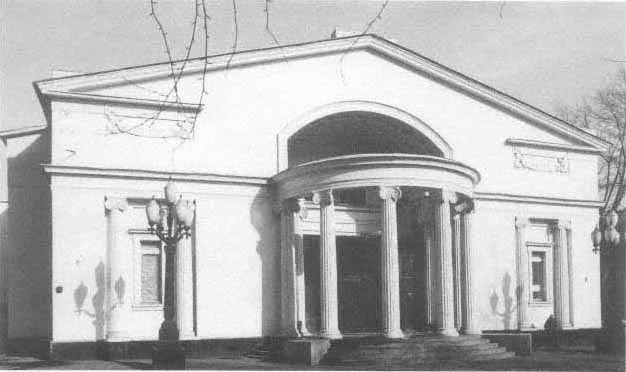
Fig. 309.
Coliseum Cinema, Moscow. 1914. Roman Klein (Brumfield M132-1).
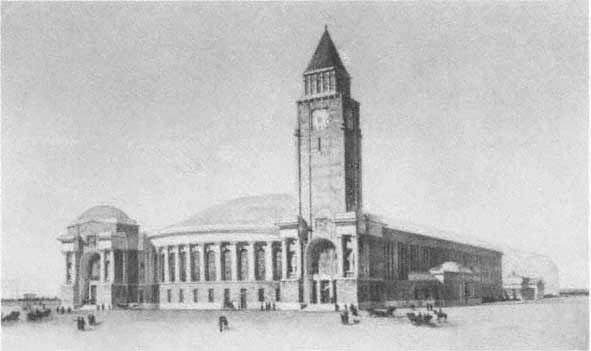
Fig. 310.
Project sketch for Kiev Railway Station, Moscow. 1914–1920. Ivan Rerberg. Ezhegodnik Moskovskogo
arkhitekturnogo obshchestva , 1912–1913.
Novodevichi Convent, with its elongated wings extending at an acute angle from a large corner rotunda in the Doric order.[68] The main auditorium in the space between the wings was more elaborately fitted in the Corinthian order.
A far more monumental neoclassical exercise in public architecture and city planning was Ivan Rerberg's design for the Kiev (or Briansk) Railway Station, across the Moscow River via Klein's newly rebuilt Borodino Bridge (1912–1913), also in the neoclassical style. Rerberg, who graduated from Petersburg's Institute of Military Engineering in 1896, served as Klein's assistant in the construction of the Museum of Fine Arts and thus was no stranger to the use of classical elements on a grand scale. Work on the station began in 1914; by 1917 the basic structure was complete, although the final details were not finished until 1920 because of the revolution and civil war. Rerberg designed the main building in a conservative neoclassical style, with attached Ionic columns on the main facade and, on the right corner, a clock tower that dominates the entire ensemble (Fig. 310). In contrast to the retrospective station building, Vladimir Shukhov's great platform shed displayed the beauty of industrial design in its iron and glass grid (47 meters wide, 30 high, and 231 long).[69]
Although the neoclassical revival replaced both the pseudo-Russian style and the style moderne as a stable, "dignified" model appropriate for cultural institutions and similar public edifices, it did not provide a ready solution for administrative and commercial office buildings in Moscow's rapidly expanding financial center in the old Kitai-Gorod district.[70] Architects like Rerberg, however, applied classical details on asymmetrical structures of modern design whose scale far exceeded that of Petersburg's neoclassical bank buildings. In Rerberg's office building for the Northern Insurance Company (1909–1911; co-designed by Marian Peretiatkovich, with the assistance of Viacheslav Oltarzhevskii), the basic structure of the four connected five-storied buildings was defined by a functional grid of reinforced cdoncrete and large plate-glass windows (Fig. 311).[71] Classical elements (garlands or festoons, masks, etc.) appear sparsely on the facade, except for a tower on Ilinka Street and two corner rotundas on the side facing the
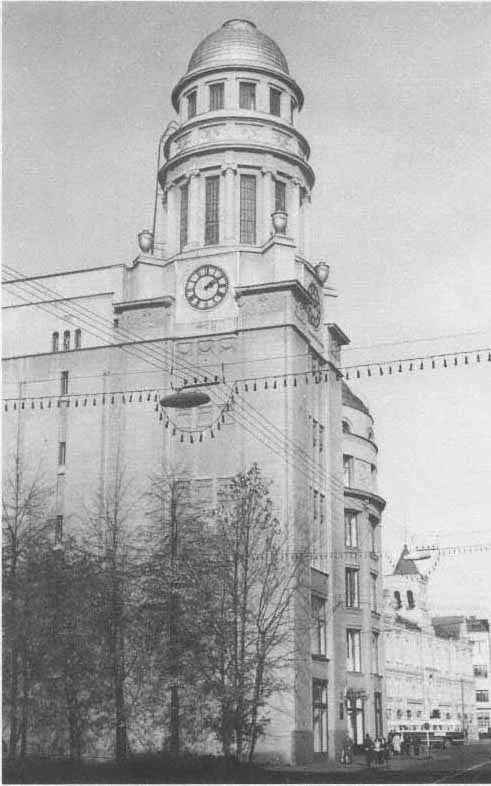
Fig. 311.
Northern Insurance Company building, Moscow. 1909–1911. Ivan Rerberg, Marian
Peretiatkovich, Viacheslav Oltarzhevskii (Brumfield M59-32).
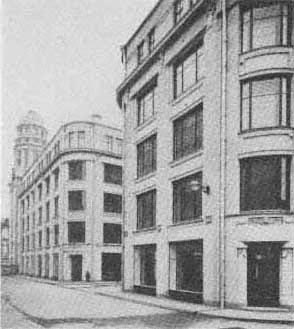
Fig. 312.
Northern Insurance Company building. Ezhegodnik
Moskovskogo arkhitekturnogo obshchestva , 1910–1911.
Kitai-Gorod wall (Fig. 312). The use of classical detail at such strategic points suggests that the vertical columns of the grid are components in a modernized classical tectonic system.
Ivan Kuznetsov's nearby Business Court (Delovoi Dvor , 1912–1913), a hotel and office complex located on New Square, takes a similar approach but is even more austerely functional. Kuznetsov already had built a large office structure in the neo-Russian variant of the style moderne—the Savvinskoe Podvore (1907), on Tverskaia Street, with fanciful designs in polychrome tile covering the main facade (Fig. 313; see Plate 40). The articulation of the facades is simpler in Delovoi Dvor but the plan is more complex; it includes an elongated hotel in three attached segments and a trapezoidal office building for wholesale trade—each structure five to six stories high (Fig. 314).
The initiator of the project was Nikolai Vtorov (the builder of Spaso House), who, in the words of a contemporary observer, was the "first to break the age-old traditions in favor of a rational and intelligent organization of commercial business."[72] To this end Vtorov located his project just beyond the Kitai-Gorod wall and stipulated the most advanced design for the offices and the hotel. Kuznetsov complied, but he also provided a neoclassical "cover"—no doubt to mitigate the unusually rigorous grid design on the exterior and to designate the main entrances. The hotel entrance on New Square (Fig. 315) is marked by the familiar neoclassical rotunda, while the main entry to the office block has a Corinthian portico over the entrance arch (Fig. 316). This irrational play at window dressing in a historical style contrasts with the unornamented side facades of the building, which display the clean lines and sense of proportion characteristic of a new rationalist aesthetic.
In their work Ivan Kuznetsov and Rerberg, among others, demonstrated the significance of reinforced concrete as a construction material in Russian architecture, even though their success at creating modern, functional buildings was vitiated by a return to the nineteenth-century concept of architecture as decoration (in this case neoclassical) applied over structure. Lukomskii and even Lialevich were skeptical of an aesthetic based on new materials such as ferroconcrete; and architectural journals decried separation of architecture from engineering, without proposing how to end it.
One architect, however, addressed the issue with every intention of proposing a solution. Aleksandr Kuznetsov graduated from the Institute of Civil Engineering in 1896, completed a supplementary course at the Berlin Polytechnikum, and in 1899 began work as an assistant to Shekhtel.[73] Before the revolution Kuznetsov
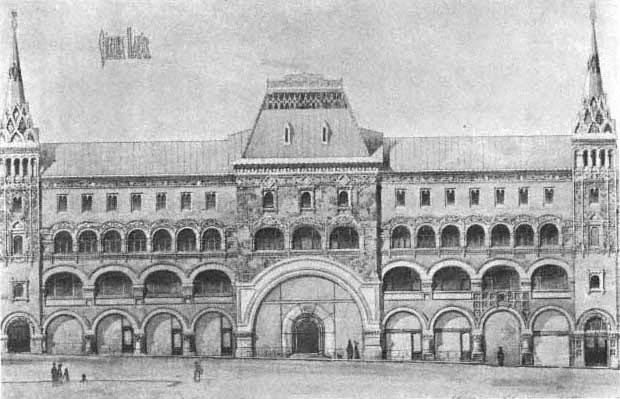
Fig. 313.
Savvinskoe Podvore building, Moscow. 1907. Ivan Kuznetsov. Project sketch. Ezhegodnik Obshchestva
arkhitektorov-khudozhnikov , 1909.
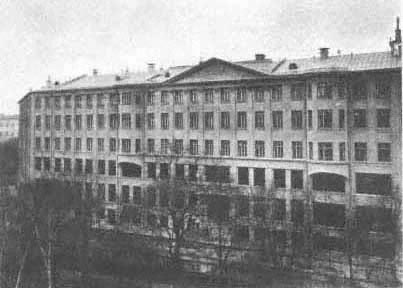
Fig. 314.
Delovoi Dvor, Moscow. 1912–1913. Ivan Kuznetsov.
Ezhegodnik Obshchestva arkhitektorov-khudozhnikov , 1913.
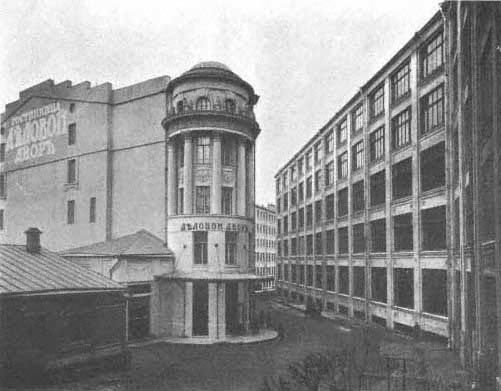
Fig. 315.
Delovoi Dvor. Ezhegodnik Obshchestva arkhitektorov-khudozhnikov , 1913.
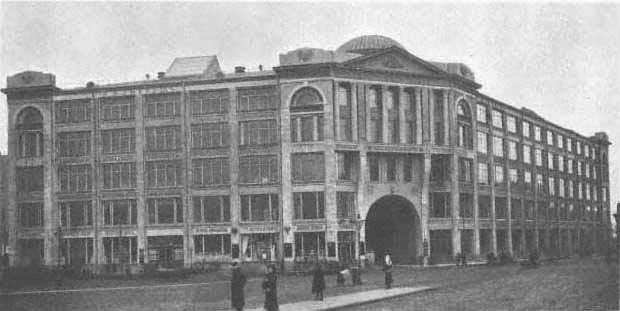
Fig. 316.
Delovoi Dvor. Ezhegodnik Obshchestva arkhitektorov-khudozhnikov , 1913.
designed mostly large industrial plants, particularly textile mills. This "industrial" architect-engineer was commissioned to design a large building to house the Stroganov School workshops (1914), in which all the structural components were reinforced concrete. The structure's glazed walls and clear lines suggest the functional aesthetic of the Werkbund , although Kuznetsov subtly varied the neoclassical rotunda in his design of the central entrance, at the right angle where the two main wings are joined.
The building for the Stroganov Workshops illustrated a program Kuznetsov had propounded at the Fifth (and final) Congress of Russian Architects, held in Moscow in 1913. Whereas the proceedings emphasized the split between engineering and architecture, Kuznetsov argued against it (his presentation eventually appeared on the pages of Zodchii ).[74]
In ferroconcrete we have not only a new material, but—even more important—new methods for constructing and designing buildings. Thus we should abjure old traditions and undertake new tasks. We should not leave ferroconcrete in the raw form it takes at the present time in the hands of construction engineers. We should not rework a new material in old forms—those of stone and wood. To create forms organically derived from the essence of ferroconcrete, one must master it technically and scientifically. . . . In work with ferroconcrete, as nowhere else, a technical education is necessary. An architect will not express his epoch if he does not make full use of contemporary technology. Architecture is the harmony of science and art.[75]
Because of the theoretical significance of ferroconcrete and the greatly increased freedom it provided in the design of buildings, Kuznetsov concluded that the properties and uses of this material should be taught extensively in all architectural schools.
Kuznetsov's views would rapidly be assimilated after the revolution; but evidence suggests that at least some Russian architects were poised even before then to accept a technological revolution, irrespective of politics. Zodchii in 1915 included two major articles surveying advanced functional design, with an emphasis on German architecture. In a two-part article on industrial architecture the engineer A. Stepanov gave the first detailed survey of the German Werkbund in a Russian journal, noting in particular (with photographs) Peter Behrens's work for AEG (Allgemeine Elektrizitäts Gesellschaft).[76] Shortly thereafter, A. M. Ginzburg published an article entitled "The Role of Germany in the Russian Construction Industry," in which he listed the areas in Russian construction most affected by innovations from Germany. Ginzburg was not a disinterested observer: he considered the Russian "dependence" on Germany a dangerous result of Russian economic and technological inadequacies that threatened to make Russia—even without the war—an economic colony of Germany.[77]
Ginzburg's own work demonstrated how thoroughly Russian architects could assimilate modern, rational construction techniques. His widely varied designs include a vaguely neoclassical resort community as well as some of the most modernistic structures in prerevolutionary Russia, at least one of which he constructed before the onset of war.[78] This House of Public Meetings (1912) in Ekaterinoslav (now Dnepropetrovsk, Ukrainian SSR) testifies to Ginzburg's thorough knowledge of ferroconcrete, in both the asymmetrical plasticity of its structural design and the futuristic shape of its window openings (Fig. 317).[79] No other contemporary architect used molded, free-form ferroconcrete as inventively. Little is known of Ginzburg after the revolution (he is not to be confused with the prominent Constructivist architect and theoretician Moisei Ginzburg), but his idiosyncratic visionary projects are comparable to those of Antonio Sant'Elia and Tony Garnier.
The rapid acceptance and rejection of solutions to problems of style, technology, and urban planning by Russian architects and critics reflects the ferment in Russian society as well as larger developments in building in both Europe and America. No cogent theory of a new architecture emerged from Russia, however, and the cry for a "unifying idea," still to be heard, was still unanswered. Nonetheless, occasionally a critic assessed accurately what had transpired in Russian architecture. In 1914 Zodchii published two closely related articles that not only offered a reasoned appraisal of contemporary Russian architecture but also proved prescient. Although the name of the author, V. Machinskii, does not appear in the lists of architects, his comments indicate that he knew current architectural practices (particularly in Moscow) and was interested in parallel developments in literature, theater, and the visual arts.
Machinskii, like Lukomskii, attacked the link be-
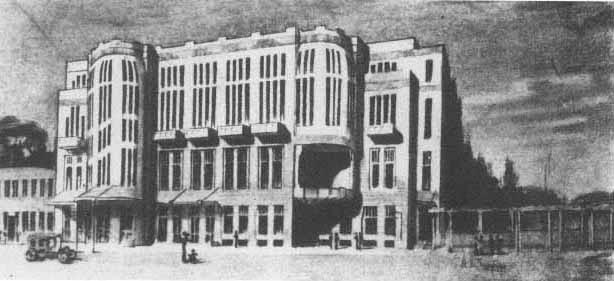
Fig. 317.
Public theater and club, Ekaterinoslav. 1912. A. M. Ginzburg. Moskovskii arkhitekturnyi mir , 1913.
tween individualism in the arts and changing fashion: "Our own architecture, for all its undoubted color and caprice, lacks the most valuable component of artistic individualism, a self-sufficient content, a guiding principle (if one does not accept as such the tendency toward lack of principle)."[80]
If recent modernism was flawed by lack of seriousness, the resurgence of eclectic, facilely reproduced historical styles was no better. Machinskii criticized not simply the aesthetic vacuity of most such reproductions but also their implicit lack of purpose: "Let us repeat that this . . . tendency to seek motifs in the past, to reproduce in new conditions old, long exhausted styles—all this in itself characterizes an epoch of creative impotence, a period of artistic stagnation [bezvremenia ]."[81] After dismissing the retrospective tendency and implicitly rejecting Lukomskii's neoclassicism, Machinskii offered a detailed critique of the "superficial, vapid, often mechanical character" of the "style moderne" (a term he used interchangeably with "new style"). Indeed, he despised modernism in the arts generally, including Symbolism and, most particularly, futurism.[82]
Having enumerated the clichés of the new architecture on the facades of Moscow buildings, Machinskii analyzed Russian society on the eve of the First World War. The stability of earlier architectural styles reflected the dominance of the class whose values these styles reflected. The class's loss of hegemony resulted in a process of "mutual struggle and self-definition" among competing social groups, which in turn produced a "muddle" in aesthetic thought. Machinskii believed that even in the West the working class would ultimately triumph over the bourgeoisie.
Although Machinskii greatly oversimplified the issue of class struggle in the West, he accurately perceived the weakness of the Russian bourgeoisie. Despite the cultural contributions of "individuals, families, and narrow circles," the class as a whole did not guide society; nor would it in the future because by the time of its maturity,
Its enemies will also have grown up.
That is why contemporary art vainly thrashes about in its searchings, impotent to offer anything other than superficial, mechanical changes. For the time being it has no place from which to take a new, substantive, view of the world, of new realities, goals, needs, and tastes that are not forced, since as of yet there is no new special basis for creativity. Obviously, this can appear only after the social struggle now under way, as a result of the newly formed social entities. At present there can only be intimations of future needs and tastes, inasmuch as the classes moving toward dominance in the future exist, take their form, and grow in the present.[83]
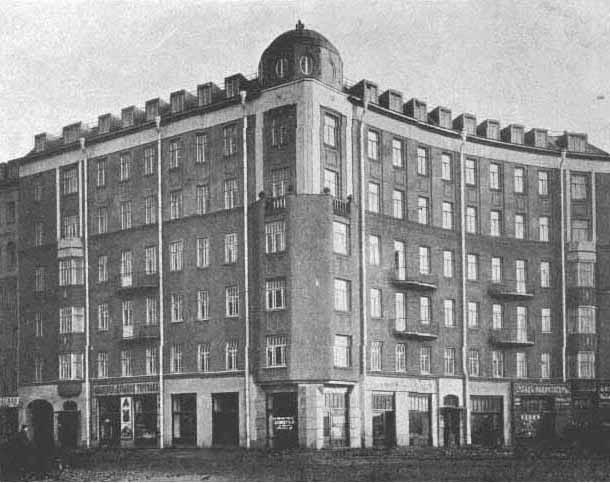
Fig. 318.
Zavadovskii house, Petersburg. 1912–1913. Oskar Munts. Ezhegodnik Obshchestva
arkhitektorov-khudozhnikov , 1913.
Despite its simplistic determinism, Machinskii's sociopolitical analysis not only looked toward a new social and cultural order—as had Bykovskii, Makarov, and Lukomskii in their different ways—but also saw its beginnings in an unavoidable class struggle.
Machinskii was not alone in criticizing contemporary architecture: at the Fifth Congress of Russian Architects at least two speakers—S. M. Serebrovskii and A. L. Krasnoselskii—trenchantly evaluated it. Although the conference presentations were not published, Zodchii recorded that both critics attacked the style moderne; Serebrovskii in particular counterposed the "exhausted moderne" to the "coming rationalism."[84] The moderne was indeed exhausted by 1913, and one is surprised to see it dealt with so seriously at this point (Zodchii reported "heated objections" to Serebrovskii's speech but gave no details).
Nonetheless, the emphasis on rationalism implied a rejection of all retrospective styles as well as the moderne. Two years later Oskar Munts's critical essay "The Parthenon or St. Sophia," a response to a recent article by Aleksandr Benois praising neoclassicism, noted these implications.[85] Benois seems to have had an unfailing ability to arouse the opposition of "modernist" critics, from Makarov to Munts. But Makarov's advocacy of the "new style" as an aesthetic decoration for the urban environment differed considerably from Munts's sober rationalism (Figs. 318, 319).
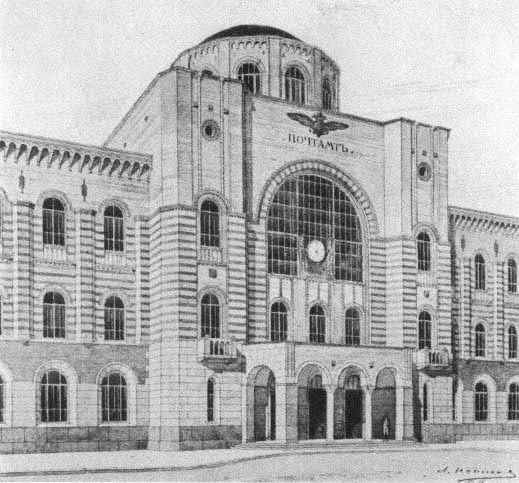
Fig. 319.
Moscow Post Office, project sketch. 1911. L. I. Novikov, Oskar Munts. Ezhegodnik
Obshchestva arkhitektorov-khudozhnikov , 1912.
In his article Munts, an 1896 graduate of the Academy of Arts with a thorough grounding in classical architecture, discussed the two great monuments of Greek civilization as examples of opposing principles in architecture: the Parthenon, a statement in pure form, perfect in detail; and St. Sophia, an expression of purposeful, utilitarian structural logic, imperfect in detail. Although the Romans and their Renaissance successors creatively adapted ancient classicism, the modern age could choose only the constructive principle symbolized by St. Sophia. After reviewing the familiar explanations for the neoclassical revival—as a reaction against the "unceremonious moderne" and a reflection of the creative stagnation of the age—Munts rejected the application of a supposedly eternal stylistic system over an unrelated modern structure:
It is both significant and horrible that this [contemporary] neoclassicism, like the infatuation with free decorative forms [the moderne], threatens . . . to completely separate so-called artistic architecture from construction itself, with its technical, engineering innovations. . . .
To avoid this catastrophe, it is necessary to return architecture to its eternal source—to purposeful, intelligent construction, whose principle is so imposingly expressed in the temple of St. Sophia.[86]
It is a measure of Munts's idealism that he did not dismiss the possibility of returning to the aesthetic principles of the Parthenon in some future age; his own work as an architect, however, reflected a pragmatic alliance between construction logic and a relatively subdued form of the style moderne in its last phase—although he also submitted a plan in 1913 for the reconstruction of Tuchkov Buian in the neoclassical style.[87] After the revolution Munts participated in designing one of the first major industrial projects in the Soviet Union (the Volkhov GES, or hydroelectric power station); in subsequent years he continued to support the concept of rational design—to the extent that conditions permitted during the 1930s—in both his architectural work and his teaching at the Academy of Arts. (He died in 1942 during the siege of Leningrad.)[88] Indeed, Munts's career as an architect could serve as an example of the persistent opposition between rationalism and decorative monumentality in Soviet architecture.
The two positions achieved no compromise in the few years remaining before the revolution. While supporters of rationalism attacked both the moderne and retrospective styles in the name of a new age in architecture, neoclassicists like Lukomskii and Lialevich, who professed to believe in the coming of a new age, continued to advocate classical tectonics. To them the neoclassical revival remained the only basis for architecture—despite the split between architecture and engineering and the demands placed on architecture as a component of comprehensive, large-scale urban planning. For Lukomskii, architecture's mission was to hold out against future chaos by following the aesthetic principles that represented the moral fiber of a great people. Lukomskii saw these principles in neoclassical architecture, imagined them in a series of sketches of idealized Russian provincial towns of the early nineteenth century (Fig. 320), and praised architecture that faithfully recreated them in contemporary Petersburg (Fig. 321).
There could be no clearer statement of this opposition to the modern age than the introduction to Lukomskii's article "New Petersburg." Taking a frankly monarchist position in the year of the Romanov tercentenary, the critic insisted that great architecture must derive from the power of the state and church:
All efforts to present a "New Petersburg" based only on the economy and on hygiene can lead to nothing other than pale, gray facades. For this reason, the entire epoch of bourgeois and democratic modernism has given Petersburg nothing . Only the restoration of previous architectural canons can increase the beauty of our city. . . . A completely ideal [solution] is unthinkable. We do not have the conditions to create it. We must limit ourselves to retrospectivism.[89]
Ironically, architectural projects sponsored by the imperial court during this period retreated ever further into the Muscovite past (Fig. 322), in contrast to the glories of Lukomskii's favored Petersburg monuments, which had assumed a rather dowdy, neglected appearance.
Although Lukomskii's purposes differed from Machinskii's, his openly antidemocratic sentiments reveal yet another variant of the Russian intelligentsia's lack of faith in governance by the bourgeoisie. Makarov's implied link between the new style and democratic (bourgeois) values had been turned on itself in the attack (by Fomin, Lukomskii, Machinskii, and others) on bourgeois individualism and modernism. Whether the antibourgeois critics advocated a rationalist or a retrospective antidote to the perceived architectural cacophony, each camp demonstrated its readiness to accept a radical, "hegemonic," solution.
The ultimate ramifications of this train of thought can be found in Lukomskii's book Contemporary Petrograd , published a few months before the first (so-called bourgeois) revolution in February 1917:
It is more and more evident that contemporary Petrograd is losing its national, noble character; is becoming more and more trivial, European. Only a common, amicable labor in construction, only an artistic dictatorship in the distribution of building sites and the attraction of the best resources will save the capital and give it an even more powerful and beautiful appearance than it had during its best days in the epoch of Alexander.[90]
Among the interesting details in this passage is Lukomskii's turn against the very "European" ideal (irredeemably bourgeois) he had so fervently advocated in his earlier writings on a "New Petersburg."
More remarkable, however, is his reference to an "artistic dictatorship." He evidently had in mind a "planning czar" in city development; but in the nostalgic reference to Petersburg during the golden age of Alexander I, a century earlier, Lukomskii distanced himself from the collapse of contemporary Petrograd—and
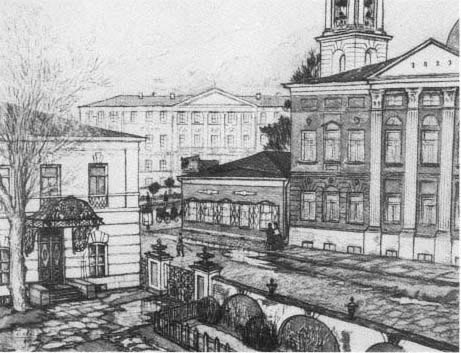
Fig. 320.
Idealized drawing of Russian provincial capital, mid-nineteenth century. Georgii
Lukomskii. Ezhegodnik Obshchestva arkhitektorov-khudozhnikov , 1911.
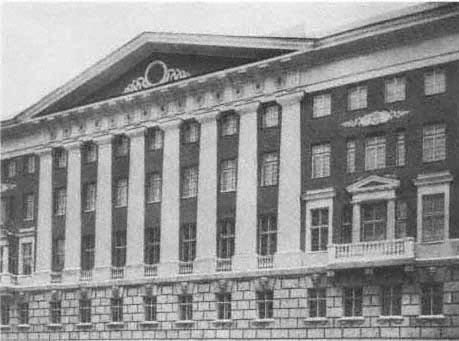
Fig. 321.
Voeikova apartment house, Petersburg. 1911–1912. Semyon Minash.
Photograph ca. 1913.
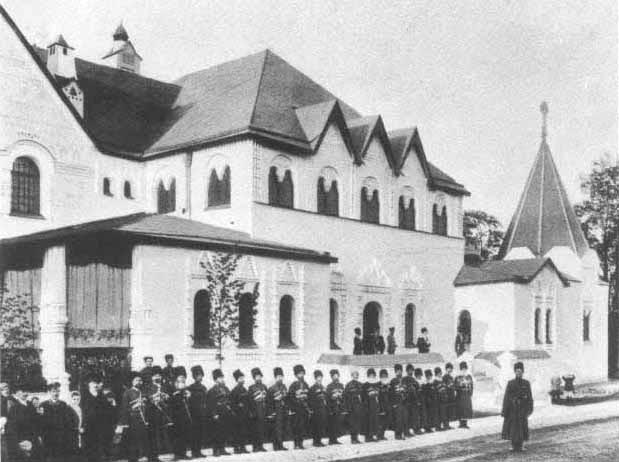
Fig. 322.
Officers' Quarters of the Emperor's Personal Guard, Peterhof. 1910–1911. Vladimir Pokrovskii.
Ezhegodnik Obshchestva arkhitektorov-khudozhnikov , 1911.
of imperial Russia. (Lukomskii often equated Russia with Petersburg.) The collapse did indeed bring about a dictatorship, ostensibly of the proletariat, although not one immediately concerned with aesthetic or planning issues. Machinskii's response to the new power of the proletariat is unrecorded, but Lukomskii found it expedient to emigrate.[91]
From the perspective of the postrevolutionary period, particularly the 1920s, Russian architecture of the early twentieth century—whether moderne or neoclassical—had achieved little as an expression of the modern age. In a relatively short time and with limited economic resources, Russian capitalism had provided architects with an approach to the problems of the modern urban environment but not a solution. More damning than the inability to address immediate issues, however, was the lack of a coherent theory to guide architecture toward uniting technology and design in fulfillment of its responsibility to the age. On this point the leading theoretician of Russian Constructivist architecture, Moisei Ginzburg, dismissed prerevolutionary modernism in his seminal book Style and Epoch (1924):
It is possible to recognize, without any particular difficulty, that such tendencies as the "Moderne" and the "Decadence," as well as all our "neo-classicisms" and "neo-Renaissances," cannot in any way stand the test of modernity. Having origi-
nated in the minds of a few highly cultivated and refined architects and, as a result of their considerable talent, often yielding rather accomplished images, this superficial aesthetic crust, like all other possible eclectic manifestations, represents an idle invention that appealed for a time to the taste of a narrow circle of connoisseurs but reflected nothing other than the decadence and impotence of an obsolescent world.[92]
This passage is striking for the ease with which any number of prerevolutionary critics (and architects) could have accepted it—Munts, Aleksandr Kuznetsov, Machinskii, and Lialevich. To be sure, none of them displayed the theoretical flair of Ginzburg, who had not only traveled in France and Italy but had studied in the centers of European modernism. In addition, Ginzburg (born in 1892) was younger and had completed his formal education at the excellent Riga Polytechnical Institute, which was less encumbered than the Academy of Arts with traditional approaches to architectural training. His primary advantage, however—short-lived though it was—lay in his ability to look back across the divide at those who had appealed for a new age without understanding the social terms in which it would appear.
Nonetheless, those lost in the wilderness of the prerevolutionary epoch had established the basis for Soviet architecture, not simply by delivering technical expertise to the state but also by pursuing the new architecture. While Aleksei Shchusev and Vladimir Pokrovskii retreated into elaborate reconstructions of the medieval Russian style (particularly in the design of churches) between 1912 and 1916, Viktor Vesnin was publishing sketches of stripped classical commercial buildings that foreshadow the volumetric Constructivist designs of the Vesnin brothers in the 1920s.[93] If the new architecture derived much of its technical vocabulary from prerevolutionary modernism, particularly in the use of ferroconcrete, it could also adapt the devices of neoclassicism to its heroic scale and monumentality—as did the so-called Red Doric, derived from Fomin, Belogrud, and other Soviet neoclassicists, as well as the more abstract forms of early experimental architecture.[94] Even the critical cacophony of the decade before 1917 provided the terms and a point of departure for the more radical, unified, theories that followed.
A number of articles, primarily in Zodchii , had advanced ideas for planned communities based on European theory and practice, notably the work of Ebenezer Howard as set forth in his 1902 book Garden Cities of Tomorrow and realized in the development of Letchworth, the first of England's "garden cities." In 1910 A. K. Ensh wrote a lengthy series of articles for Zodchii entitled "Garden Cities" (published as a book in 1913); and over the next six years, similar works appeared by V. Semenov, Nikolai Dmitriev, Mikhail Dikanskii, and V. Dadonov—whose 1913 book Socialism without Politics reveals an ameliorist tendency in the attempt to improve housing conditions without a radical political doctrine.[95] Apart from a few modest company suburban communities, little came of these discussions; but early Soviet projects for planned communities show a continuity with prerevolutionary ideas.
The first decades of Soviet architecture were not entirely dependent on prerevolutionary experience. The younger generation of the avant-garde, in architecture as well as the visual arts, had ready access to contemporary European theory (as the example of Moisei Ginzburg shows; Fig. 323); much of their work—at least on paper—represented a radical departure from prerevolutionary practice. But a comparison of projects published in architectural annuals before the revolution with work by the same architects during the next four decades reveals not only a remarkable transformation in certain individual careers (that of Shchusev or Lev Rudnev) but also an unmistakable transposition of pre-1917 ideas, as in the 1930s classicism of Zholtovskii and Shchuko.
The problematic relation between modernism and revived interpretations of historical styles continued into the late 1950s, although the "unifying ideas" of the early theoreticians of Constructivism and rationalism soon yielded to a different, draconian, cultural unity in the 1930s, with a concomitant return to traditional—frequently neoclassical—expressions of monumentality in architecture. During the 1960s the quest for style dwindled to insignificance with the engineering triumph of industrialized construction.[96] In this context the "superficial aesthetic" of early twentieth-century architecture—and above all, the style moderne—has regained a certain luster, not as an active architectural principle but as a reminder of discarded values whose individualism and unprogrammed variety seem all the more valuable for their absence in contemporary architecture.[97]
Such an approach assumes the risk of reducing architecture to an applied decorative system—theatrical, derivative, and perhaps dilettantish. Had the Russian social and economic order provided a more rational use of
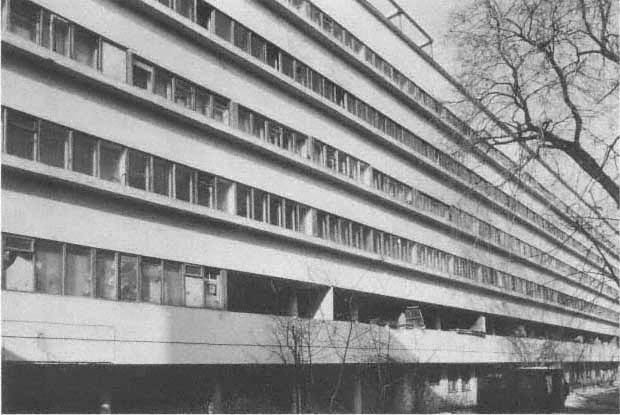
Fig. 323.
Apartment house of People's Commissariat of Finance. 1929. Moisei Ginzburg (Brumfield M155-10).
resources before the revolution, architecture, in all probability, would have reflected a greater sense of purpose and rationalism in construction. (Paradoxically, a primary characteristic of early twentieth-century architecture is its practicality: the apartment houses railway stations, theaters, commercial buildings, and museums of the period show a functionalism and durability inconceivable in most Soviet architecture, whatever its style.) Yet the theatrical vitality and even "bourgeois" individualism associated with the style moderne, attacked relentlessly in architectural criticism after 1905, suggest an alternative to monistic interpretations of art and society, however idealistic and theoretically rigorous. If each epoch has its own style, the stylistic diversity of Russian architecture at the beginning of this century represents an expression of cultural freedom essential to the modern age—and to the future of Russian culture.
Notes
Chapter One— The Quest for a National Style
1. For a detailed analysis in English (with references to Russian sources of data) of the transformation of Petersburg's built environment after 1860, see James H. Bater, St. Petersburg: Industrialization and Change (Montreal, 1976), especially pp. 321-53. In addition Elena A. Borisova's Russkaia arkhitektura vtoroi poloviny XIX veka (Moscow, 1979) refers frequently to the relation between capitalist development and architectural practice, especially in chapters 3 ("Obraz goroda vtoroi poloviny XIX v.") and 4 ("Razvitie novykh tipov sooruzhenii i ego vliianie na arkhitekturno-khudozhestvennyi protsess").
2. A sense of professional cohesion in architecture led to the formation of two major architectural associations: the Moscow Architectural Society (1867) and the Petersburg Society of Architects (1870). The founder and first president of the Moscow group was Mikhail Bykovskii (1801-1885), a noted architect whose work during four decades ranged from church and palace architecture to commercial structures. He was also the father of Konstantin Bykovskii, president of the Moscow society from 1894 to 1903 and one of its most active spokesmen. For a detailed study of the elder Bykovskii's work, see Evgeniia I. Kirichenko, Mikhail Bykovskii (Moscow, 1988).
The first president of the Petersburg society was Aleksandr Rezanov, a prominent architect and, from 1871, rector of the Imperial Academy of Arts. In 1872 the Petersburg society initiated the journal Zodchii (Architect). For forty-five years, until the end of 1917, this publication not only served as a record of the architectural profession throughout Russia but also provided a conduit for technical information and ideas developed in Russia, as well as in Europe and the United States. For information on the founding of the societies and of various architectural journals, see Iu. S. Iaralov, ed., 100 let obshchestvennykh arkhitekturnykh organizatsii v SSSR, 1867-1967 (Moscow, 1967). See also V. Shreter, "K istorii S-Peterburgskogo Obshcestva Arkhitektorov," Zodchii , 1894, no. 5:35-37; and L. N. Benois and M. F. Geisler, "25-letie osnovaniia S-Peterburgskogo Obshchestva Arkhitektorov," Zodchii , 1895, no. 11:82-90.
3. See Joan Bassin, Architectural Competitions in Nineteenth-Century England (Ann Arbor, Mich., 1984), pp. 4-12, for a discussion of the professionalization of English architecture during the nineteenth century. Although English economic and social structures differ greatly from the Russian, a professional identity among architects developed similarly in the two countries—in both cases because of rapid economic and industrial growth. See also Barrington Kaye, The Development of the Architectural Profession in Britain: A Sociological Study (London, 1960).
4. Robert Macleod notes this (sometimes creative) confusion in nineteenth-century British architecture in Style and Society: Architectural Ideology in Britain, 1835-1914 (London, 1971). His interpretation of the effects of professionalism and a market economy on architecture in Britain amplifies that of Bassin (see pp. 123-26). See also Bassin, pp. 6-7, on the patronage of "corporate groups" in the expansion of architectural opportunity.
5. Borisova, Russkaia arkhitektura , pp. 168-72, discusses the interrelation of social change and architectural development in Russia during the latter half of the century. For a study of the impact of industrial development on the urban setting, see James H. Bater, "The Industrialization of Moscow and St. Petersburg" in Studies in Russian Historical Geography , ed. James H. Bater and R. A. French (London, 1983), pp. 279-303.
6. For a detailed survey of developments in Russian construction technology during the nineteenth century, see M. A. Kozlovskaia, "Razvitie nauchno-tekhnicheskoi bazy arkhitektury i stroitel'stva" in Konstruktsii i arkhitekturnaia forma v russkom zodchestve XIX-nachala XX vv. , ed. Iu. C. Lebedev (Moscow, 1977), pp. 12-40. The 1872 Moscow Polytechnical Exhibition, presented as part of the bicentennial observance of Peter the Great's birth, is a landmark in Russian cultural history, with ramifications for both the arts and technology. Its sponsor, the Society of Lovers of the Natural Sciences, Anthropology, and Ethnography, arranged for some twelve thousand exhibits at sites throughout Moscow, many of which became the basis of collections continue
at the Polytechnical Museum and the Historical Museum in Moscow. In the architectural section, sponsored by the Moscow Architectural Society, models of major monuments and architectural documents from both Petersburg and Moscow were displayed. In addition, the exhibition also featured new construction technology. See Borisova, Russkaia arkhitektura , pp. 155-57; and Evgeniia I. Kirichenko, Moskva na rubezhe dvukh stoletii (Moscow, 1977), p. 26. For a detailed contemporary account, see V. Kuroedov, "Obzor arkhitekturnoi chasti politekhnicheskoi vystavki v Moskve," Zodchii , 1872, no. 7:105-12; and no. 8:139-42.
7. In Russia the symbol of the progressive union of technology and architecture was Joseph Paxton's Crystal Palace. Although the enormous glass and iron hall, built in 1851 for London's Great Exhibition, was for Dostoevskii during the 1860s the emblem of a soulless, dehumanized modern society, Vladimir Stasov, one of the most influential Russian cultural critics, praised the structure (and the country that produced it) for breaking courageously with the lifeless principles of the classical Renaissance style and for asserting the primacy of architecture among the arts in the modern age. Stasov expressed these views, at varying length, in a number of articles, culminating in the section on architecture in his survey of nineteenth-century European art Iskusstvo XIX veka , first published in a special issue of the journal Niva in 1901 and subsequently expanded before his death in 1906. See V. V. Stasov, Izbrannye sochineniia v trekh tomakh (Moscow, 1952), 3:499-502. Evgeniia I. Kirichenko appraises Stasov's architectural criticism in the latter part of the nineteenth century in Russkaia arkhitektura 1830-1910-kh godov (Moscow, 1978), pp. 124-25.
8. Iu. S. Iaralov, ed., 100 let , p. 12; and Borisova, Russkaia arkhitektura , pp. 309-10.
9. The connections with German schools were most closely developed. Two prominent architects teaching at the Academy of Arts in Petersburg were educated in Germany: Ludwig Bonstedt (1822-1885) at the Bauakademie and the Berlin Academy of Arts; and Harold Bosse (1812-1894) in Darmstadt. Although born in Petersburg, Bonstedt left Russia for Germany in 1863, after five years as a professor at the Petersburg Academy of Arts. In 1872 he won first prize in the competition for the design of the Reichstag, but his design was not built. See the biographical sketch by V. S. Shreter in Zodchii , 1872, no. 5:112-14; and the obituary, also by Shreter, in Zodchii , 1886, no. 1:1-3. A contemporary gives a brief account of Bosse's work in Zodchii , 1894, no. 12:91; see also. V. Andreev," G. E. Bosse—arkhitektornovator," Arkhitektura SSSR , 1988, no. 1:88-95.
10. An excellent Soviet study of nineteenth-century industrial architecture is A. L. Punin's Arkhitekturnye pamiatniki Peterburga: Vtoraia polovina XIX veka (Leningrad, 1981), particularly pp. 63-92; the impact of Joseph Paxton's Crystal Palace is noted on p. 75. See also two essays in Lebedev, Konstruktsii i arkhitekturnaia forma : N. A. Smurova, "Inzhenernye sooruzheniia i ikh vliianie na razvitie russkoi khudozhestvennoi kul'tury" (with particular emphasis on the work of Vladimir Shukhov), pp. 60-93; and Iu. P. Volchok, "Stanovlenie novykh tektonicheskikh sistem v promyshlennoi arkhitekture," pp. 94-126.
11. See B. M. Kochakov, ed., Ocherki istorii Leningrada , vol. 2, Period kapitalizma (Moscow-Leningrad, 1957), p. 173, for precise data and sources.
12. For examples of the poverty and overcrowding in Moscow, see Joseph Bradley, Muzhik and Muscovite: Urbanization in Late Imperial Russia (Berkeley, 1985), pp. 55-60 passim. See also James H. Bater, "Modernization and Municipality: Moscow and St. Petersburg on the Eve of the Great War," in Bater and French, 2:305-27.
13. Entsiklopedicheskii Slovar ' (Petersburg, 1900), s.v. "Sankt-Peterburg."
14. For a contemporary report on the palace, including a cost analysis, see "Dom E. I. V. Velikogo Kniazia Vladimira Aleksandrovicha," Zodchii , no. 3:41-42; nos. 4-5:63-64; and nos. 7-8:89-90. Zodchii also included detailed drawings and plans of the structure (which the editors call a house) in the volumes for 1875 and 1878.
15. Punin, Arkhitekturnye pamiatniki Peterburga , p. 166.
16. Ibid., p. 169. For a biography of Karl Rachau (1830-1880) and illustrations of several of his buildings, see "K. K. Rachau," Zodchii , 1882, no. 1:12-13.
15. Punin, Arkhitekturnye pamiatniki Peterburga , p. 166.
16. Ibid., p. 169. For a biography of Karl Rachau (1830-1880) and illustrations of several of his buildings, see "K. K. Rachau," Zodchii , 1882, no. 1:12-13.
17. F. M. Dostoevskii, Polnoe sobranie sochinenii v tridtsati tomakh (Leningrad, 1980), 21:106.
18. Ibid., p. 107.
17. F. M. Dostoevskii, Polnoe sobranie sochinenii v tridtsati tomakh (Leningrad, 1980), 21:106.
18. Ibid., p. 107.
19. Borisova places the origins of this relation between public opinion and architecture to the period 1830-1850, during which the periodical press in Russia (above all, the newspapers) increasingly scrutinized the built environment, both descriptively and prescriptively. See Russkaia arkhitektura , p. 15.
20. Before the publication of Zodchii in 1872, the most frequent and detailed commentary on architecture in Russia appeared in Khudozhestvennnia gazeta (Art gazette), founded in 1836. The issues from the early 1840s help to pinpoint the beginnings of the speculative building rush in Petersburg, although the activity of that period was modest in comparison with the boom of the 1860s and subsequent decades.
21. I. Merts, "Iz Pamiatnoi knizhki" Zodchii , 1875, no. 2:20.
22. "Dom F. L. Guna v S-Peterburge," Zodchii , 1875, nos. 7-8:91.
23. From "Khronika," Zodchii , 1875, no. 10:118.
24. This passage appeared in the introduction to "Nasha arkhitektura," the third section in Stasov's four-part survey of the arts in Russia during the reign of Alexander II, "Dvadtsat' piat' let russkogo iskusstva," first published dur- soft
ing 1882 and 1883 in the journal Vestnik Evropy . Quoted from Stasov, Izbrannye sochineniia v trekh tomakh , 2:499. In the same article Stasov writes approvingly of attempts to create a Russian national style in architecture, even though such attempts were a part of the eclecticism that he criticized.
25. "Khronika," Zodchii , 1875, no. 10:119.
26. V. Kuroedov, "Berlinskaia arkhitektura. Putevye zametki," Zodchii , 1876, no. 7:79.
27. Population figures are from Akademiia Nauk SSSR, Institut Istorii, Istoriia Moskvy , vol. 4, Period promyshlennogo kapitalizma (Moscow, 1954), p. 227. The same volume also has extensive information on the economic growth of Moscow during the latter part of the nineteenth century.
28. For a description of the Porokhovshchikov house, see D. Liushin, "Dereviannyi dom g-na Porokhovshchikova," Zodchii , 1872, no. 2:16. This volume also contains a plan and architectural drawings of the structure.
29. On the involvement of Moscow's merchants in PanSlavism (with specific reference to Porokhovshchikov), see Thomas Owen, Capitalism and Politics in Russia: A Social History of the Moscow Merchants, 1855-1905 (New York, 1981), pp. 89-93.
30. "Moskovskie zametki," Golos , 1875, no. 235:1 (quoted in Borisova, Russkaia arkhitektura , p. 294).
31. For a detailed analysis of the competition process for the design of the Historical Museum, see E. I. Kirichenko, Moskva na rubezhe , pp. 36-39, and "The Historical Museum: A Moscow Design Competition, 1875-83," in Uses of Tradition in Russian and Soviet Architecture , ed. Catherine Cooke (London, 1987), pp. 24-26. In their programmatic statement The Sense and Meaning of the [Historical] Museum (1873), A. S. Uvarov and I. E. Zabelin noted: "The path that neglects history has never led to good. . . . A people wishing to achieve greatness must know its history, under the pain of ceasing to be a great people. . . . Museums are one of the most powerful means for the achievement of a people's self-awareness—the highest goal of history." Quoted in E. I. Kirichenko, "Arkhitektor V. O. Shervud i ego teoreticheskikh vozzreniia," Arkhitekturnoe nasledstvo 22 (1974): 4.
32. Lev Dahl's views on Russian architecture, in particular, his belief that a revived Russian style would be compatible with the demands of "rational architecture," are summarized in T. A. Slavina, Issledovateli russkogo zodchestva (Leningrad, 1983), pp. 102-4.
33. For excerpts from Shervud's notebooks, see V. Voropaev, "'Menia ochen' zanimal Gogol' . . . ': Iz 'Zapisok' V. O. Shervuda," Literaturnaia gazeta , 9 April 1986, p. 6. The notebooks are in the Manuscript Division of the Lenin Library in Moscow. In her article on Shervud, Evgeniia I. Kirichenko gives a detailed analysis of his effort to establish a scientific basis for a Russian architectural style, exemplified by the design of the Historical Museum. To rise above historically based decorative detail in forming a national style proved difficult, if not impossible. In a letter of May 1874 to the historian Ivan Zabelin, Shervud complained that his preliminary designs for the museum produced only "nice architectural houses for a wealthy client or, even more, for provincial city halls" ("Arkhitektor V. O. Shervud i ego teoreticheskie vozzreniia," pp. 3-7).
34. Ropet's work and his view of the role of historical interpretation in architecture are discussed in Evgeniia I. Kirichenko, "Arkhitektor I. P. Ropet," Arkhitekturnoe nasledstvo 20 (1972): 85-93. Despite Ropet's attempt to incorporate stylistic features of Russian vernacular architecture into his work, Kirichenko notes that his use of the "Russian style" was not antithetical to eclecticism but rather another eclectic manifestation (p. 87). Reproductions of the designs of both Hartman and Ropet were included in a series of illustrated volumes entitled Motivy russkoi arkhitektury (Petersburg, n.d. [apparently 1890s]). See particularly vol. 2, for the year 1875.
35. See Evgeniia I. Kirichenko, "Istorizm myshleniia i tip muzeinogo zdaniia v russkoi arkhitekture serediny i vtoroi poloviny XIX v.," in Vzaimosviaz' iskusstv v khudozhestvennom razvitii Rossii vtoroi poloviny XIX v. , ed. G. Iu. Sternin (Moscow, 1982), pp. 135-42.
36. On the competition for the Polytechnic Museum project, see Kirichenko, Moskva na rubezhe , p. 48. Although Nikolai Shokhin (1819-1895), who graduated from the architectural school attached to the Kremlin Court Office, had extensive experience in restoring medieval Russian monuments in the Kremlin and elsewhere in Moscow, his original design for the museum was Italianate. Monighetti redesigned the facades in the Russian style.
37. V. Shreter, "Dom V. F. Shtrausa v S-Peterburge," Zodchii , 1874, no. 12:145-47, with illustrations.
38. V. Shreter, "Obyvatel'skii dom i fabrika shelkovykh izdelii A. I. Nissena," Zodchii , 1873, no. 2:139.
39. I. S. Kitner, "Kirpichnaia arkhitektura," Zodchii , 1872, no. 6:84. For the role of Ieronim Kitner and of his sons Maksim and Richard in the architectural profession in Petersburg, see Iu. I. Kitner, "Dinastiia arkhitektorov," Stroitel'stvo i arkhitektura Leningrada , 1978, no. 4:24-25.
40. V. P. Kuroedov, "Berlinskaia arkhitektura. Putevye zametki," Zodchii , 1876, no. 7:79.
41. A. Krasovskii, Grazhdanskaia arkhitektura (Petersburg, 1886), pp. 5, 12. For further work on Krasovskii, see A. L. Punin, "Idei ratsionalizma v russkoi arkhitekture vtoroi poloviny XIX veka," Arkhitektura SSSR , 1962, no. 11:55-58. An assessment of Krasovskii's work by his contemporaries is contained in his obituary in Zodchii , 1875, no. 9:102-3.
42. Krasovskii, Grazhdanskaia arkhitektura , pp. 27-29.
43. N. V. Sultanov, "Odna iz zadach stroitel'nogo uchilishche," Zodchii , 1882, no. 5:71. break
44. Krasovskii, Grazhdanskaia arkhitektura , p. 11. Sultanov's debt to Krasovskii on this issue is discussed in Slavina, Issledovateli russkogo zodchestva , p. 145.
45. S. Zosimovskii, "Po povodu rechi grazhdanskogo inzhenera Sultanova 'Odna iz zadach stroitel'nogo uchilishcha'," Zodchii , 1882, no. 6:85.
46. Entsiklopedicheskii Slovar ' (St. Petersburg, 1890), s.v. "Akademiia Iskusstv."
47. Valerii G. Isachenko, et al., Arkhitektory-stroiteli Peterburga-Petrograda nachala XX veka (Leningrad, 1982), pp. 4-5. For a more detailed description of the architecture program at the Academy of Arts, see K. N. Afanas'ev, A. V. Shchusev (Moscow, 1978), pp. 181-82.
48. Entsiklopedicheskii Slovar ' (Petersburg, 1894), s.v. "Institut grazhdanskikh inzhenerov imp Nikolaia I." For a recent Soviet account of the institute, see Nina Smurova, "Arkhitekturnaia shkola Instituta grazhdanskikh inzhenerov," in Problemy istorii sovetskoi arkhitektury , ed. A. A. Strigaleva (Moscow, 1985), pp. 31-41.
49. Institutional affiliations are derived from the listing of architects in V. G. Isachenko, Arkhitektory-stroiteli .
50. Borisova, Russkaia arkhitektura , p. 308.
51. N. A. Dmitrieva, Moskovskoe uchilishche zhivopisi, vaianiia, i zodchestva (Moscow, 1951).
52. For comments on the professional function of the competition system in British architecture, see Bassin, Architectural Competitions in Nineteenth-Century England , pp. 9, 13-16. The parallel phenomenon in Russia is examined by Nina Smurova, "Organizatsiia konkursnogo dela v Rossii," in Problemy istorii sovetskoi arkhitektury (Moscow, 1983), pp. 14-21.
53. The career of Leontii Benois (1856-1928) as both architect and pedagogue is surveyed in V. G. Lisovskii and L. A. Iudina, "Zamechatel'nyi zodchii i pedagog," Stroitel'stvo i arkhitektura Leningrada , 1979, no. 2:35-38.
54. See Kirichenko, Moskva na rubezhe , pp. 41-42, with references to archival sources on the design competition for the Upper Trading Rows.
55. A brief sketch of the architectural evolution of the passage in Petersburg is presented in Punin, Arkhitekturnye pamiatniki Peterburga , pp. 97-100; see also Lebedev, Kontruktsii i arkhitekturnaia forma , pp. 143-57. For the larger context of iron and glass galleries and halls in Britain and France, see Bassin, Architectural Competitions in Nineteenth-Century England , pp. 65-66.
56. Borisova, Russkaia arkhitektura , p. 306. Detailed photographs of the old trading rows, as well as a history of the construction of the new building for the Upper Trading Rows appeared in the album Torgovye riady na Krasnoi ploshchadi v Mokve (Kiev, 1893).
57. I. P. Mashkov, ed., Putevoditel' po Moskve (Moscow, 1913), pp. 259-62. A description and detailed plan of the Upper Trading Rows are also contained in A. I. Komech, ed., Pamiatniki arkhitektury Moskvy , 2d ed. (Moscow, 1983), pp. 404-5.
58. The Bavarian Otto Krel's contributions to the development of technical resources for Russian architecture and civil engineering are chronicled in his obituary in Zodchii , 1914, no. 14:165-66.
59. For an account of Shukhov's trip to the United States, see G. M. Kovelman's biographical study Tvorchestvo pochetnogo akademika inzhenera Vladimira Grigorevicha Shukhova (Moscow, 1961), pp. 16-19. The growing Russian interest in American architecture and construction technology is exemplified by Sergei Kuleshov's extensive travel account "Eskizy amerikanskoi arkhitektury i tekhniki," Zodchii , 1877, no. 4:32-34; nos. 5-6:48-56; nos. 11-12:100-105; (1878), no. 1:1-8. See also William Craft Brumfield, "Russian Perceptions of American Architecture, 1870-1917," in Architecture and the New Urban Environment: Western Influences on Modernism in Russia and the USSR (Washington, D. C., 1988), pp. 54-57. Shukhov's work at the 1896 Nizhni Novgorod exhibition is illustrated in Vidy robot proizvedennykh stroitel'noi firmy Bari na vserossiiskoi vystavke 1896 v N. Novgorode (Moscow, 1896). See also Nina Smurova, "Arkhitekturno-stroitel'nye dostizheniia Vserossiiskoi vystavki 1896 g. i ee rol' v razvitii otechestvennoi arkhitektury," in Problemy istorii sovetskoi arkhitektury (Moscow, 1976), 2:14-19.
60. Fedor Shekhtel and Karl Shmidt are among the apprentice architects who, according to various sources, worked on the Upper Trading Rows project.
61. Smirnova surveys Klein's life and work in the chapter "R. Klein," in Zodchie Moskvy: XV-XIX vv. , ed. Iu. S. Iaralov and S. M. Zemtsov (Moscow: 1981), pp. 288-300.
62. A photograph of the Vikula Morozov building, designed by Aleksandr Ivanov, appeared in Zodchii , 1899, plate 21. The Khludov emporium, designed in a similar Beaux-Arts style by Lev Kekushev, appeared in Arkhitekturnye motivy , 1899, no. 1, plate 1.
63. Rezanov's article "Proekt zdanii gorodskoi dumy v Moskve," Zodchii , 1876, nos. 8-9:93-94, summarizes his original design for the Duma. Although Rezanov's project was not chosen in the final competition, his design for the facade was more original than that in Chichagov's final proposal. Rezanov's drawing of the main facade appeared in Zodchii , 1876, plate 36 (plate 18 shows the ground plan); his revised version of the facade—co-designed with Andrei Gun—was published in Zodchii , 1888, plate 58.
64. Kirichenko, Moskva na rubezhe , p. 47.
65. The 1882 volume of Zodchii contains excellent illustrations of competition designs (four prizes and one honorable mention by architects including Kitner and Gun, Leontii continue
Benois, Shreter, and Ivan Bogomolov), none of which resemble the Russian style eventually chosen.
66. Parland's detailed self-justifying account of the design and construction of the Church of the Resurrection appeared in Zodchii , 1907, no. 35:374-78, with illustrations. The church was also the subject of a lavishly produced brochure, with plans and architectural drawings: Kratkii otchet o postroike Khrama Voskreseniia Khristova sooruzhennogo na meste smertel'nogo poraneniia v Boze pochivshiego Imperatora Alekandra II (Petersburg, 1907).
67. A report on the mosaic work of A. A. Frolov (including the Church of the Resurrection) is contained in Nedelia stroitelia (Builders' weekly, the supplement to Zodchii ), 1900, no. 29:180-82. Frolov also did designs for secular structures, including mosaic panels for the Upper Trading Rows. A partial listing of these projects is contained in the obituary "A. A. Frolov," Stroitel' , 1897, nos. 13-14:539-40.
68. For a commentary on Mamontov's transformation of Abramtsevo, see G. Iu. Sternin, "Abramtsevo: ot 'usad'by' k 'dacha'," in Russkaia khudozhestvennaia kul'tura vtoroi poloviny XIX-nachala XX veka (Moscow, 1984), pp. 187-88. See also E. R. Arenzon, "Ot Kireeva do Abramtseva: K biografii Savvy Ivanovicha Mamontova, 1841-1918," Panorama iskusstv 6 (1986):359-82.
69. Sternin, "Abramtsevo," p. 198; Borisova, Russkaia arkhitektura , pp. 256-57. Natalia Polenova's account is presented in her Abramtsevo: vospominaniia (Moscow, 1922), pp. 30-43.
70. Reproductions of project sketches by Polenov and Vasnetsov appear in Polenova, pp. 33, 35, and 36. Polenov's drawing reflects the Church of the Savior on the Nereditsa in the nineteenth century, when it looked different (particularly in the roofline) from the present church, which is based on a turn-of-the-century reconstruction.
71. For a detailed account of the design of the Abramtsevo church, see N. V. Masalina, "Tserkov' v Abramtseve," in Iz istorii russkogo iskusstva vtoroi poloviny XIX-nachala XX veka , ed. Elena A. Borisova (Moscow, 1978), pp. 47-58.
72. For a history of the subsequent development of the Abramtsevo ceramics workshop into a commercial enterprise located in Moscow, see E. R. Arenzon, "'Abramtsevo' v Moskve. K istorii khudozhestvenno-keramicheskogo predpriiatiia S. I. Mamontova," in Muzei 10 , ed. A. S. Loginova (Moscow, 1989), pp. 95-103.
73. In a letter to Elena Polenova, 4 January 1895. See V. V. Stasov, Pis'ma k deiateliam russkoi kul'tury (Moscow, 1967), 2:58-59. A subsequent, and more favorable, assessment of the Abramtsevo church appeared in Stasov's article "Viktor Mikhailovich Vasnetsov i ego raboty," Iskusstvo i khudozhestvennaia promyshlennost ', 1898, nos. 1-2:65-97; and no. 3:137-83 (see particularly p. 165).
74. Ezhegodnik Obshchestva arkhitektorov-khudozhnikov , no. 1 (1906), pp. 15 (exterior) and 110 (interior).
75. Borisova, Russkaia arkhitektura , p. 264.
76. Pavel Siuzor, in Trudy I s"ezda russkikh zodchikh , p. xii. For a detailed commentary on the prerevolutionary architectural congresses (albeit with a Marxist critical bias), see N. I. Sokolova, "Arkhitekturnye s"ezdy v Rossii," Akademiia arkhitektury 3 (1935): 63-71.
77. Robert Gedike, "Rech' predsedatelia 1-go otdela," in Trudy I , pp. 1-2.
78. Konstantin Bykovskii, "O znachenii izucheniia drevnikh pamiatnikov dlia sovremennogo zodchestva," in Trudy I , p. 5.
79. Ibid., pp. 13-14.
78. Konstantin Bykovskii, "O znachenii izucheniia drevnikh pamiatnikov dlia sovremennogo zodchestva," in Trudy I , p. 5.
79. Ibid., pp. 13-14.
80. Ieronim Kitner, "O ponizhenii tarifa na provoz estestvennogo kamnia po vsem russkim zheleznym dorogam," in Trudy I , p. 248.
81. V. O. Shervud, Opyt issledovaniia zakonov iskusstva: Zhivopis', skul'ptura, arkhitektura, i ornamentika (Moscow, 1895), pp. 129-30. For a detailed analysis of Shervud's treatise in its intellectual and historiographic context, see E. I. Kirichenko, "Arkhitektor, V. O. Shervud i ego teoreticheskie vozzreniia," Arkhitekturnoe nasledstvo 22 (1974):7-18.
82. Shervud, Opyt issledovaniia zakonov iskusstva , p. 126.
83. Eugène Viollet-le-Duc, Russkoe iskusstvo: Ego istochniki, ego sostavnye elementy, ego vyshee razvitie, ego budushchee (Moscow, 1879), p. 187. For an analysis of Viollet-le-Duc's influence in Russia, see Robin Middleton, "Viollet-le-Ducsky?" Architectural Design , February 1970:76-78; and Catherine Cooke, "Russian Perspectives," in Eugène Emmanuel Viollet-le-Duc, 1814-1879 (London, 1980), pp. 60-63.
84. N. V. Sultanov, "Russkoe zodchestvo v zapadnoi otsenke. V," Zodchii , 1880, no. 12:104-6. See also Slavina, Issledovateli russkogo zodchestva , p. 79.
85. The English notion of a revived indigenous architecture from medieval sources is exemplified by the following comments of George Gilbert Scott, from Remarks on Domestic and Secular Architecture, Present and Future (London, 1857), p. 111:
I want . . . to show the public that we aim not at a dead antiquarian revival, but at developing upon the basis of the indigenous architecture of our own country, a style which will be pre-eminently that of our own age, and will naturally, readily, and with right good will and heartiness, meet all its requirements, and embrace all its arts, improvements, and inventions.
Macleod quotes this passage in Style and Society , pp. 18-19, which has numerous references to the broader question of continue
architecture and national identity in nineteenth-century Britain.
86. Konstantin Bykovskii, "Zadachi arkhitektury XIX veka," in Trudy II s"ezda russkikh arkhitektorov , p. 18.
87. Borisova, Russkaia arkhitektura , p. 259. For a concise, lucid discussion of the relation between eclectic architecture and other semiotic systems, see her "Znak stilia," Arkhitektura SSSR , 1984, no. 1:21-22.
88. Bykovskii, "Zadachi arkhitektury XIX veka," in Trudy II , p. 18.
89. The convoluted German prose of this passage, printed entirely in capitals in the original, reads "Dieser Neustil, die Moderne, wird, um uns und unsere Zeit zu repräsentieren, eine deutliche Änderung des bisherigen Empfindens, den beinahe volligen Niedergang der Romantik und das fast alles usurpierende Hervortreten der Zweckerfullung bei allen unseren Werken deutlich zum Ausdrucke bringen müssen." From Die Baukunst unserer Zeit (Vienna, 1914), p. 41. Despite the change in title, this work is the fourth printing of Die moderne Architektur , with a new foreword.
90. See Heinz Geretsegger and Max Peintner, Otto Wagner, 1841-1918 (Salzburg, 1964), pp. 11-14.
91. "Als grober Fehler wird es immer zu bezeichnen sein, einem favorisierten Aussenmotiv die verlangte Innenstruktur anzupassen oder gar diesbezüglich Opfer zu bringen. Die Lüge ist dann unvermeidlich and widrig wie diese wirkt die daraus resultierende Form" (Otto Wagner, Die moderne Architektur , 3d ed. [Vienna, 1902]).
Chapter Two— Russian Architectural Criticism and the Propagation of the "New Style"
1. Detailed publication data on Zodchii and other architectural journals of the period can be found in the four volumes of L. N. Beliaeva, ed., Bibliografiia periodicheskikh izdanii Rossii, 1901-1916 (Leningrad, 1961).
2. The practical emphasis of Stroitel ' is indicated by its subtitle: "Messenger of Architecture, Homeowning, and Sanitary Building." Although Zodchii devoted some attention to the problem of workers' housing toward the end of the nineteenth century, Stroitel ' was the first Russian journal to show a sustained concern, with its surveys (in 1895 and 1896) of solutions in more advanced industrial countries and its extensive report on the project competition for workers' housing at the Petersburg factory of the Russian-American Rubber Company. See "Koloniia rabochikh pri fabrike t-va Rossiisko-Amenkanskoi resinovoi manufaktury, v S.-Peterburge," Stroitel ', 1897, nos. 9-10:321-54.
3. Arkhitekturnye motivy , no. 6 (February-March 1901):18, advertising supplement.
4. For a discussion of the term "style moderne" as applied to design and architecture in Europe at the turn of the century, see Stephan Tschudi Madsen, Sources of Art Nouveau (rpt. New York, 1976), pp. 76-82. During the same period the term was also used in the visual arts by Russian critics such as Igor Grabar'. The development of the style moderne in France and its relation to the late nineteenth-century political alliance between France and Russia are examined in Debora L. Silverman, Art Nouveau in Fin-de-Siècle France: Politics, Psychology, and Style (Berkeley, 1989), pp. 159-85.
5. The most comprehensive history of the journal is N. P. Lapshina, " Mir iskusstva " (Moscow, 1976), copiously documented with the reminiscences—from published and unpublished sources—by associates of the World of Art movement. Of particular significance are the two volumes of memoirs by Aleksandr Benois, Zhizn' khudozhnika: Vospominaniia (New York, 1955). The World of Art movement and the journal are also the subjects of extensive monographs by two Western scholars: Janet Kennedy, The "Mir iskusstva Group and Russian Art, 1898-1912 (New York, 1977); and John E. Bowlt, The Silver Age: Russian Art of the Early Twentieth Century and the "World of Art" Group , 2d ed. (Newtonville, Mass., 1982).
6. A notice of the first meeting of the Society of Architect-Artists appeared in Zodchii , 1904, no. 2:11.
7. G. Ravich, "Besedy stroitelia," Stroitel ', 1899, nos. 11-12:411-46.
8. Ibid., pp. 435-46.
7. G. Ravich, "Besedy stroitelia," Stroitel ', 1899, nos. 11-12:411-46.
8. Ibid., pp. 435-46.
9. "Novye veianiia v arkhitekture," Nedelia stroitelia, 1899 , no. 42:303.
10. Signed "O. E-i," "Eshche raz po povodu novykh veiianii v arkhitekture," Nedelia stroitelia , 1899, no. 45:319-20.
11. V. Shmor, "V bor'be za iskusstvo," Zodchii , 1900, no. 3:30-33; no. 4:46-47.
12. "Premirovannyi proekt universiteta v Berkli Kaliforniia," Zodchii , 1900, no. 4:37-38.
13. A. G. Uspenskii, "Neskol'ko slov ob angliiskoi narodnoi arkhitekture," Zodchii , 1900, no. 4:47-52. The article was taken from a lecture delivered to the Petersburg Society of Architects on 1 February 1900.
14. P[avel] Marseru, "Prikladnye khudozhestva na vsemirnoi vystavke 1900 goda," Zodchii , 1901, no. 8:104-14; no. 9:116-24; no. 10:127-33.
15. "Novyi stil' i dekadentstvo," Zodchii , 1902, no. 6:65-70; no. 8:89-92; no. 9:101-5. The passage quoted appears on page 66. The series of articles was signed "P. M-v," but the author's identity is clear from information provided in the entry on Pavel Makarov in Valern G. Isachenko, et al., Arkhitektory-stroiteli Peterburga-Petrograda nachala XX veka (Leningrad, 1982), p. 91.
16. Zodchii , 1902, no. 8:89-92.
17. Zodchii , 1902, no. 9:101-5.
18. Ibid., p. 105. break
19. Ibid.
17. Zodchii , 1902, no. 9:101-5.
18. Ibid., p. 105. break
19. Ibid.
17. Zodchii , 1902, no. 9:101-5.
18. Ibid., p. 105. break
19. Ibid.
20. Pavel Makarov, "Novye obshchestvennye zdaniia v Londone," Zodchii , 1902, no. 14:169-71.
21. Aleksandr Benois, "Zhivopisnyi Peterburg," Mir iskusstva , 1902, no. 1:1-5.
22. Pavel Makarov, "Arkhitekturnye mechtaniia," Zodchii , 1902, no. 13:161. Benois responded with further statements on the relevance of Petersburg's architectural past to the needs of the present in "Arkhitektura Peterburga," Mir iskusstva , 1902, no. 4:82-85; and "Krasota Peterburga," Mir iskusstva , 1902, no. 8:138-42. It has been noted, however, that even Benois was not consistently negative in his approach to modern European design. See Lapshina, " Mir iskusstva ," pp. 70-71.
23. "Novoe v iskusstve," Zodchii , 1902, no. 18:213-15. The article is signed "E. S."
24. See, for example, A. Dmitriev, "Iz inostrannykh arkhitekturnykh zhurnalov," Zodchii , 1902, no. 12:143-45, for a report on the contents and editorial direction of Architektonische Rundschau and Berliner Architekturwelt .
25. "Arkhitektor i dekorator Iosif Gofman," Zodchii , 1902, no. 23:263-64.
26. "Darmstadtskaia vystavka 1901 goda," Zodchii , 1902, no. 33:371-74; no. 34:379-82.
27. Evgenii Baumgarten, "Sovremennaia arkhitektura," Zodchii , 1902, no. 48:543-47; no. 49:556-60; no. 50:567-71. The passage quoted appears on p. 545.
28. Ibid., p. 558. Wagner's phrase "Etwas unpraktisches kann nicht schön sein" appears in Die moderne Architektur , 3d ed. (Vienna, 1902), p. 70.
27. Evgenii Baumgarten, "Sovremennaia arkhitektura," Zodchii , 1902, no. 48:543-47; no. 49:556-60; no. 50:567-71. The passage quoted appears on p. 545.
28. Ibid., p. 558. Wagner's phrase "Etwas unpraktisches kann nicht schön sein" appears in Die moderne Architektur , 3d ed. (Vienna, 1902), p. 70.
29. Baumgarten, "Sovremennaia arkhitektura," p. 571.
30. Ivan Volodikhin, "Zadachi arkhitekturnoi estetiki," Arkhitekturnyi muzei , 1902, no. 1:2-3; no. 3:23. The passage quoted appears on p. 3.
31. Ibid., p. 23. Noting that the conclusion to Volodikhin's article was never published, "for reasons not dependent on the editorial board," Kazhdan suggests that Volodikhin's revolutionary rhetoric may have been cut by the censor (Tatiana P. Kazhdan, "Arkhitektura i arkhitekturnaia zhizn' Rossii kontsa XIX-nachala XX veka," in Russkaia khudozhestvennaia kul'tura kontsa XIX-nachala XX veka , 1895-1907, ed. A. D. Alekseeva [Moscow, 1969], 2:275, n. 1) .
30. Ivan Volodikhin, "Zadachi arkhitekturnoi estetiki," Arkhitekturnyi muzei , 1902, no. 1:2-3; no. 3:23. The passage quoted appears on p. 3.
31. Ibid., p. 23. Noting that the conclusion to Volodikhin's article was never published, "for reasons not dependent on the editorial board," Kazhdan suggests that Volodikhin's revolutionary rhetoric may have been cut by the censor (Tatiana P. Kazhdan, "Arkhitektura i arkhitekturnaia zhizn' Rossii kontsa XIX-nachala XX veka," in Russkaia khudozhestvennaia kul'tura kontsa XIX-nachala XX veka , 1895-1907, ed. A. D. Alekseeva [Moscow, 1969], 2:275, n. 1) .
32. Obshchestvo i khudozhestvennaia arkhitektura," Arkhitekturnyi muzei , 1902, no. 3:24-25, no. 4:33-34, no. 5:43-45; no. 6:54-57. The reference to Ruskin is on p. 24.
33. "Novyi stil'," Arkhitekturnyi muzei , 1903, no. 2:25-28; no. 3:45-47. The passage quoted is from p. 28. The first issue of this journal contained an essay on William Morris, "The Rebirth of Decorative Art," by Zinaida Vengerova; the second issue contained a report on Scottish artists, the MacDonald sisters; and the third, final, issue informed readers about the latest Arts and Crafts exhibit in London.
34. Ibid., pp. 45-47.
33. "Novyi stil'," Arkhitekturnyi muzei , 1903, no. 2:25-28; no. 3:45-47. The passage quoted is from p. 28. The first issue of this journal contained an essay on William Morris, "The Rebirth of Decorative Art," by Zinaida Vengerova; the second issue contained a report on Scottish artists, the MacDonald sisters; and the third, final, issue informed readers about the latest Arts and Crafts exhibit in London.
34. Ibid., pp. 45-47.
35. S[ergei] Diagilev, "Vystavki arkhitekturnaia i '36-ti,'" Mir iskusstva , 1903, no. 1:8-10.
36. The photographs of the Moscow exhibit appeared in Mir iskusstva , 1903, no. 3. Windyhill, a house built by Mackintosh in 1899-1901, was featured in a series of photographs reproduced from a 1902 issue of Die Kunst . See Mir iskusstva , 1903, no. 12.
37. A. Mikhailov, author of "Ist zu wienerisch," wrote that Fomin's interior design represented the "caprice of a strange artist who interprets the dining room of a wealthy home as a place for torturing raving lunatics" ( Iskusstvo stroitel'noe i dekorativnoe , 1903, no. 3:20; quoted in Elena A. Borisova and Tatiana P. Kazhdan, Russkaia arkhitektura kontsa XIX-nachala XX veka [Moscow, 1971], p. 228, n. 4).
38. Vladislav Karpovich, "Arkhitektura i khudozhestvenno-promyshlennaia vystavka v Moskve," Arkhitekturnyi muzei , 1903, no. 2:31-32.
39. Aleksandr Dmitriev, "Vpechatleniia ot vystavki 'arkhitektury i khudozhestvennoi promyshlennosti novogo stilia v Moskve'," Zodchii , 1903, no. 9:113-15. Dmitriev noted chattily, "The participation of Olbrich is explained, in all probability, primarily by the sponsorship of the exhibit by Grand Princess Elizaveta Fedorovna, a native of Darmstadt." See also N. Filianskii, "Po povodu Moskovskoi vystavki," Zodchii , 1903, no. 9:115-18.
40. For a more detailed account of the "Contemporary Art" enterprise and its sponsors, Prince Sergei Shcherbatov and V. V. von Mekk, see Lapshina, " Mir Iskusstva ," pp. 152-61. See also Sergei Shcherbatov, Khudozhnik v ushedshei Rossii (New York, 1955), pp. 148-78. One of the few orders for the atelier furniture displayed at the exhibit came from Shcherbatov himself, who eventually placed the dining room set in his Moscow apartment house, designed by A. Tamanov.
41. Sergei Diagilev, "Sovremennoe iskusstvo," Mir iskusstva , 1903, no. 3:22-24; Evgenii Baumgarten, "Sovremennoe iskusstvo," Zodchii , 1903, no. 16:211-13.
42. The 1904 Moscow exhibit is described briefly in the "Khronika" column of Zodchii , 1904, no. 15:181, with an interesting reference to a carved iconostasis by Fedor Shekhtel.
43. "Khudozhestvenno-arkhitekturnaia vystavka v Akademii Nauk," Zodchii , 1905, no. 10:125-26.
44. Pavel Makarov, "Finliandskoe dekorativnoe iskusstvo," Zodchii , 1903, no. 14:183-87.
45. Aleksandr Dmitriev, "Sovremennoe dekorativnoe iskusstvo," Zodchii , 1903, no. 39:543-57; no. 40:469-71. References to Tiffany and the American crafts appear on p. 455. break
46. "Postroika mnogoetazhnikh domov v Sev. Amerike," Zodchii , 1903, no. 51:605-8.
47. Aleksandr Dmitriev, "Aliuminievyi portal redaktsii 'Die Zeit,'" Zodchii , 1903, no. 29:353.
48. Ivonne d'Axe [pseud.], "Sovremennaia Moskva," Zodchii , 1904, no. 15:177-80; no. 16:189-92; no. 17:201-3; no. 18:213-15. The foreword appears on pp. 177-78. The obvious fiction of "Ivonne d'Axe" has recently been discussed in a brief essay by E. G. Kozlova, "Ocherk Ivon D'Aks 'Sovremennaia Moskva' i ego avtor," F. O. Shekhtel' i problemy istorii russkoi arkhitektury kontsa XIX-nachala XX vekov: Sbornik (Moscow, 1988), pp. 111-14. According to Kozlova, the author must have been closely associated not only with the editorial board of Zodchii in Petersburg but also with Ivan Fomin personally, because his published design sketch for a modern house was later destroyed. Kozlova's candidate is Boris Nikolaev, a prominent Petersburg critic and a participant in the Moscow exhibit of modern design that had been co-organized by Fomin in December 1902. Another possibility is Ivan Apyshkov, also a well-known critic and architect in Petersburg, whose views on Moscow modernism are similar to those expressed in the Zodchii series. (Both Apyshkov's and Nikolaev's writings are discussed later in this chapter. I am grateful to Catherine Cooke for providing the Kozlova article in response to my query). The importance of the Zodchii essays is indicated by their republication a year later as a separate volume Sovremennaia Moskva: Arkhitekturno-kriticheskie ocherki (Petersburg, 1905).
49. d'Axe, "Sovremennaia Moskva," p. 179.
50. Ibid., pp. 189-92, for a survey of the work of Viktor Vasnetsov in Moscow. Kekushev and Walcot are discussed on pp. 201-3.
51. Ibid., p. 215.
49. d'Axe, "Sovremennaia Moskva," p. 179.
50. Ibid., pp. 189-92, for a survey of the work of Viktor Vasnetsov in Moscow. Kekushev and Walcot are discussed on pp. 201-3.
51. Ibid., p. 215.
49. d'Axe, "Sovremennaia Moskva," p. 179.
50. Ibid., pp. 189-92, for a survey of the work of Viktor Vasnetsov in Moscow. Kekushev and Walcot are discussed on pp. 201-3.
51. Ibid., p. 215.
52. Vladimir Apyshkov, Ratsional'noe v noveishei arkhitekture (Petersburg 1905). On the title page, Apyshkov is identified as a "repetitor" (tutor) at the Nikolaevskii Engineering Academy, and his essay is defined as a "trial lecture for the position of instructor at the academy."
53. Ibid., p. 11.
54. Ibid., pp. 39-42. Apyshkov notes: "The slogan of that artist [Wagner] is the 'transformation of the useful into the beautiful.' It is precisely this direction that A. Krasovskii points to as the true one for architecture" (p. 42). Although Apyshkov stretches the point, in effect he juxtaposes Europe's most prominent spokesman for a rational architecture with a venerated figure in the Russian rationalist tradition.
55. Ibid., p. 54.
56. Ibid., p. 56. In mentioning Bauer, Apyshkov no doubt refers to Bauer's praise of the Eiffel Tower and the bicycle as examples of the perfect union of material and form, and therefore more satisfying aesthetically than the Basilica of St. Peter. According to Apyshkov, Bauer's views are derived from Gottfried Semper, Der stil in den technischen und tektonischen Künster, oder praktische Aesthetik (Munich, 1860-1863).
52. Vladimir Apyshkov, Ratsional'noe v noveishei arkhitekture (Petersburg 1905). On the title page, Apyshkov is identified as a "repetitor" (tutor) at the Nikolaevskii Engineering Academy, and his essay is defined as a "trial lecture for the position of instructor at the academy."
53. Ibid., p. 11.
54. Ibid., pp. 39-42. Apyshkov notes: "The slogan of that artist [Wagner] is the 'transformation of the useful into the beautiful.' It is precisely this direction that A. Krasovskii points to as the true one for architecture" (p. 42). Although Apyshkov stretches the point, in effect he juxtaposes Europe's most prominent spokesman for a rational architecture with a venerated figure in the Russian rationalist tradition.
55. Ibid., p. 54.
56. Ibid., p. 56. In mentioning Bauer, Apyshkov no doubt refers to Bauer's praise of the Eiffel Tower and the bicycle as examples of the perfect union of material and form, and therefore more satisfying aesthetically than the Basilica of St. Peter. According to Apyshkov, Bauer's views are derived from Gottfried Semper, Der stil in den technischen und tektonischen Künster, oder praktische Aesthetik (Munich, 1860-1863).
52. Vladimir Apyshkov, Ratsional'noe v noveishei arkhitekture (Petersburg 1905). On the title page, Apyshkov is identified as a "repetitor" (tutor) at the Nikolaevskii Engineering Academy, and his essay is defined as a "trial lecture for the position of instructor at the academy."
53. Ibid., p. 11.
54. Ibid., pp. 39-42. Apyshkov notes: "The slogan of that artist [Wagner] is the 'transformation of the useful into the beautiful.' It is precisely this direction that A. Krasovskii points to as the true one for architecture" (p. 42). Although Apyshkov stretches the point, in effect he juxtaposes Europe's most prominent spokesman for a rational architecture with a venerated figure in the Russian rationalist tradition.
55. Ibid., p. 54.
56. Ibid., p. 56. In mentioning Bauer, Apyshkov no doubt refers to Bauer's praise of the Eiffel Tower and the bicycle as examples of the perfect union of material and form, and therefore more satisfying aesthetically than the Basilica of St. Peter. According to Apyshkov, Bauer's views are derived from Gottfried Semper, Der stil in den technischen und tektonischen Künster, oder praktische Aesthetik (Munich, 1860-1863).
52. Vladimir Apyshkov, Ratsional'noe v noveishei arkhitekture (Petersburg 1905). On the title page, Apyshkov is identified as a "repetitor" (tutor) at the Nikolaevskii Engineering Academy, and his essay is defined as a "trial lecture for the position of instructor at the academy."
53. Ibid., p. 11.
54. Ibid., pp. 39-42. Apyshkov notes: "The slogan of that artist [Wagner] is the 'transformation of the useful into the beautiful.' It is precisely this direction that A. Krasovskii points to as the true one for architecture" (p. 42). Although Apyshkov stretches the point, in effect he juxtaposes Europe's most prominent spokesman for a rational architecture with a venerated figure in the Russian rationalist tradition.
55. Ibid., p. 54.
56. Ibid., p. 56. In mentioning Bauer, Apyshkov no doubt refers to Bauer's praise of the Eiffel Tower and the bicycle as examples of the perfect union of material and form, and therefore more satisfying aesthetically than the Basilica of St. Peter. According to Apyshkov, Bauer's views are derived from Gottfried Semper, Der stil in den technischen und tektonischen Künster, oder praktische Aesthetik (Munich, 1860-1863).
52. Vladimir Apyshkov, Ratsional'noe v noveishei arkhitekture (Petersburg 1905). On the title page, Apyshkov is identified as a "repetitor" (tutor) at the Nikolaevskii Engineering Academy, and his essay is defined as a "trial lecture for the position of instructor at the academy."
53. Ibid., p. 11.
54. Ibid., pp. 39-42. Apyshkov notes: "The slogan of that artist [Wagner] is the 'transformation of the useful into the beautiful.' It is precisely this direction that A. Krasovskii points to as the true one for architecture" (p. 42). Although Apyshkov stretches the point, in effect he juxtaposes Europe's most prominent spokesman for a rational architecture with a venerated figure in the Russian rationalist tradition.
55. Ibid., p. 54.
56. Ibid., p. 56. In mentioning Bauer, Apyshkov no doubt refers to Bauer's praise of the Eiffel Tower and the bicycle as examples of the perfect union of material and form, and therefore more satisfying aesthetically than the Basilica of St. Peter. According to Apyshkov, Bauer's views are derived from Gottfried Semper, Der stil in den technischen und tektonischen Künster, oder praktische Aesthetik (Munich, 1860-1863).
57. Apyshkov, Ratsional'noe v noveishei arkhitekture , p. 58.
58. Ibid., p. 62.
59. Ibid., p. 65.
60. Ibid.
57. Apyshkov, Ratsional'noe v noveishei arkhitekture , p. 58.
58. Ibid., p. 62.
59. Ibid., p. 65.
60. Ibid.
57. Apyshkov, Ratsional'noe v noveishei arkhitekture , p. 58.
58. Ibid., p. 62.
59. Ibid., p. 65.
60. Ibid.
57. Apyshkov, Ratsional'noe v noveishei arkhitekture , p. 58.
58. Ibid., p. 62.
59. Ibid., p. 65.
60. Ibid.
61. Mikhail Syrkin, "Novyi stil'," Arkhitekturnyi muzei , 1903, no. 2:27.
62. Boris Nikolaev, "K voprosu ob arkhitekturno-khudozhestvennom obrazovanii," Zodchii , 1905, no. 1:9.
63. Ibid., pp. 11-12.
64. Ibid., p. 11.
62. Boris Nikolaev, "K voprosu ob arkhitekturno-khudozhestvennom obrazovanii," Zodchii , 1905, no. 1:9.
63. Ibid., pp. 11-12.
64. Ibid., p. 11.
62. Boris Nikolaev, "K voprosu ob arkhitekturno-khudozhestvennom obrazovanii," Zodchii , 1905, no. 1:9.
63. Ibid., pp. 11-12.
64. Ibid., p. 11.
65. Boris Nikolaev, Fizicheskie nachala arkhitekturnykh form (Petersburg, 1905), p. 148. (This passage also appeared in his article of the same title in Zodchii , 1906, no. 8:66.)
66. Nikolaev, Fizicheskie nachala arkhitekturnykh form , p. 149.
67. A critical response to Nikolaev's initial article on architectural education appeared the following month: A. Netyska, "Neskol'ko slov po povodu stat'i B. N. Nikolaeva 'K voprosu ob arkhitekturno-khudozhestvennom obrazovanii,'" Zodchii , 1905, no. 8:95-96.
68. Pavel Strakhov, Esteticheskie zadachi tekhniki (Moscow, 1906). For a detailed summary of Strakhov's book, see Vladimir V. Kirillov, Arkhitektura russkogo moderna (Moscow, 1979), p. 35.
69. V. Dadonov, Sotisializm bez politiki: Goroda-sady budushchego v nastoiashchem (Petersburg, 1912).
70. Nikolai Dmitriev, "Zhelezo-beton v primenenii k vysokim sooruzheniiam," Zodchii , 1903, no. 31:369-71.
71. The relation between technology and construction at the turn of the century in Russia is examined in Iu. S. Lebedev, ed., Konstruktsii i arkhitekturnaia forma v russkom zodchestve XIX-nachala XX vv (Moscow, 1977), whose bibliography lists numerous prerevolutionary publications on the topic (pp. 170-73). For a survey of articles on American technology and architecture in the Russian press (primarily Zodchii ), see William Craft Brumfield, "Russian Perceptions of American Architecture, 1870-1917," in Architecture and the New Urban Environment: Western Influences on Modernism in Russia and the USSR (Washington, D.C., 1988), pp. 51-70.
72. Aleksei Shchusev, "Mysli o svobode tvorchestva v religioznoi arkhitekture," Zodchii , 1905, no. 11:132-33. break
Chapter Three— The Style Moderne in Moscow
1. The only reference to medieval monuments at the third congress occurred in Nikolai Sultanov's plea to preserve Russia's ancient architectural heritage: "O neobkhodimosti sokhraneniia nashikh drevnikh pamiatnikov," Trudy III s"ezda russkikh zodchikh (Petersburg, 1905), I:58. The Artistic Section, whose issues had occupied the center of debate in earlier congresses, was represented by only six papers, of which one dealt with Schopenhauer's views on architecture.
2. Alexander Bernardazzi, "Narodnyi muzei budushchego" (The folk museum of the future), Trudy III s"ezda , I:59-62. At the same time that Bernardazzi advocated a union of technology and a new style he was also expressing democratic aspirations by creating for public use great buildings (people's museums) whose scale and function would reinvigorate architecture. The speech was first published at the time of the congress in Zodchii , 1900, no. 8:107.
3. A photograph of the Gausvald dacha appeared in Zodchii , 1900, plate 56. Vladimir Apyshkov mentioned the house as one of the few worthy Russian examples of the new style in his Rational'noe v noveishei arkhitekture (Petersburg, 1905), p. 52.
4. The A. A. Morozov house was photographed frequently as one of Moscow's marvels (see Arkhitckturnye motivy , 1900, no. 3, plate 58). Leo Tolstoi responded to it in a perceptive passage on the economics of conspicuous architectural display in his novel Resurrection (completed in December 1899). At the beginning of part 1, chapter 12, the novel's protagonist, Nekhliudov, rides past it and muses on the absurdity of this "stupid, unnecessary house for some stupid, unnecessary person" who exploits the very workers swarming over the scaffolding. Nekhliudov's cabby objects—"If they're building it, someone must need it"—and observes, unassailably, that the peasants pouring into Moscow from the impoverished villages must have work. The scene is based on Tolstoi's thorough knowledge of the economic dislocation in Russia during the 1890s and its impact on Moscow.
5. Nedelia stroitelia , 1899, no. 28:208-9; see also the supplement of plates on the Metropole in Zodchii of the same year. Interest in the project was so intense that the publisher of Arkhitekturnye motivy , Vladimir Berner, announced the sale of a special album containing the sketches for seven competing designs; by some insight the sketch he chose for his advertisement in the journal (1899, no. 3) was that of Walcot, submitted under the logo "Female Head." Further details of the construction history of the Metropole are provided in V. M. Chekmarev, "Obnovlenie gostinitsy 'Metropol,'" Arkhitektura i stroitel'stvo Moskvy , 1987, no. 6:22-25; and by the same author, "Mir khudozhestvennykh obrazov gostinitsy 'Metropol,'" in Muzei 10 , ed. A. S. Loginova, pp. 35-47.
6. For a discussion of the Walcot houses, see Ivonne d'Axe, "Sovremennaia Moskva" (Contemporary Moscow), Zodchii , 1904, no. 17:201. A survey of Walcot's education and career in Russia is contained in Sergei Romaniuk, "Vil'iam Val'kot (1874-1943)," Stroitel'stvo i arkhitektura Moskvy , 1986, no. 6:24-27.
7. Aleksandr Golovin's designs for the Metropole panels were published in Mir iskusstva , 1901, no. 11-12:151-56. Vrubel's sketch for the panel The Princess of Dreams , originally displayed at the 1896 Nizhni Novgorod exposition, appeared in Mir iskusstva , 1903, no. 10-11, after p. 158. The ceramic work for the Metropole, as for a number of other major architectural projects, was implemented by Savva Mamontov's "Abramtsevo" factory in Moscow, under the supervision of the noted craftsman P. K. Vaulin. One of the more curious features of the Metropole decoration was a ceramic strip at mid-level with a Nietzschean inscription (part of which is still visible): "The same old story: when you have built a house, you notice that you have learned something." Apart from the specific meaning of this cryptic aphorism, the form of the Metropole exemplifies the aestheticization of reality associated with Nietzsche's philosophy.
8. The most authoritative history of the gallery is D. Ia. Bezrukova, Tretiakov i istoriia sozdaniia ego galerei (Moscow, 1970). There are numerous other accounts of the gallery's founding, including, in English, Beverly Kean, All the Empty Palaces (New York, 1983), pp. 66-69.
9. Vasnetsov's work on the facade in 1903 is mentioned in Zodchii , 1903, no. 36:427 ("Khronika"). A photograph of the completed building appeared in the 1906 issue of Ezhegodnik Obshchestva arkhitektorov-khudozhnikov , pp. 16-17. For a discussion of the gallery in relation to other work by Vasnetsov, see Tatiana P. Kazhdan, "Arkhitektura i arkhitekturnaia zhizn' Rossii kontsa XIX-nachala XX veka," in Russkaia khudozhestvennaia kul'tura kontsa XIX-nachala XX veka , 1895-1907 , ed. A. D. Alekseeva (Moscow, 1969), 2:305-8.
10. Russia witnessed a flurry of museum construction at the turn of the century, and most of the major buildings—particularly those that housed art collections—followed some variant of the classical temple (Roman Klein's museum of fine arts is discussed in chapter 6).
11. The Proskurin design is analyzed in detail in Elena Volkhovitskaia and Aleksei Tarkhanov, "Dom 'Rossiia,'" Dekorativnoe iskusstvo , 1986, no. 7:34-38. See also Zodchii , 1905, plates 23-25.
12. A brief description of the building and subsequent modifications appears in Iurii Fedosiuk, Moskva v kol'tse sadovykh (Moscow, 1983), p. 376.
13. For a drawing of the Sokol apartment house as originally projected, see Evgeniia I. Kirichenko, Russkaia arkhitektura 1830-1910-kh godov (Moscow, 1978), p. 236. Mashkov's continue
career, including his work for Sokol, is surveyed in B. Brandenburg and Ia. Tatarzhinskaia, "I. P. Mashkov," Arkhitektura SSSR , 1984, no. 2:86-93.
14. Photographs of the Isakov apartment house and other buildings by Kekushev appeared in Ezhegodnik Moskovskogo arkhitekturnogo obshchestva , no. 2 (1910-1911), p. 57.
15. See the photographs in ibid., pp. 47-48.
16. Quoted in Fedosiuk, Moskva v kol'tse sadovykh , p. 79.
17. Photographs of the Levin apartment house appeared in Moskovskii arkhitekturnyi mir , no. 1 (1912), pp. 32-34. Soviet sources make scant reference to German's work, although an album by Evgeniia I. Kirichenko (with text in English) contains photographs of the Levin building, including the stairwell: Moscow: Architectural Monuments of the 1830-1910s (Moscow, 1977), pp. 234-37.
18. Maliutin is the subject of a brief but informative article by Sergei Diagilev: "Neskol'ko slov o S. V. Maliutine," in Mir iskusstva , 1903, no. 4:173-75. The article is accompanied by excellent photographs of Maliutin's work, primarily at Talashkino.
19. See William Craft Brumfield, "The Decorative Arts in Russian Architecture, 1900-1907," Journal of Decorative and Propaganda Arts 5 (1987): 12-27.
20. Grigorii Iu. Sternin, ed., Russkaia khudozhestvennaia kul'tura vtoroi poloviny XIX-nachala XX veka (Moscow, 1984), p. 179.
21. Many Russian artists elaborated upon the teremok theme—in art, architecture, and stage design. An early example is Ivan Ropet's teremok bathhouse at Abramtsevo (discussed in chapter 1). By the beginning of the century, both Viktor and Apollonarii Vasnetsov, as well as Aleksandr Golovin and Maliutin, had published or displayed (in some cases, built) variants on the teremok . Diagilev ecstatically praised Maliutin's teremok at Talashkino as the expression of a genuinely national, non-Western, architectural form. In Diagilev's view, Maliutin, together with the Finnish painter and designer Gallén-Kallela, had established in northern Europe the basis for a "second rinascimento" that would eventually lead to a "new aesthetic, a new Florence" ("Neskol'ko slov o S. V. Maliutine," pp. 159-60).
22. Written some five years before the completion of the Pertsov building, Igor Grabar's critical analysis of Russian folk motifs applied to contemporary furniture design and the decorative arts seems particularly relevant to the interior of the Pertsov apartment. Although pleased with the success of the Russian pavilion—based on the arts and crafts revival—at the 1900 Paris Exposition, Grabar was concerned about the deliberate crudity with which Russian artists such as Golovin and Polenova incorporated folk art as part of modern design. Acknowledging the aesthetic pleasures of genuine folk art, Grabar nonetheless feared that the excessive imitation, rather than creative reworking, of these motifs leads to cliché—and to furniture that is "hellishly uncomfortable." He noted that "one wants to eat and rest in comfort, without having to face endless lines and colors crawling at you from the wall." His own solution was not to modernize folk art but to revive Russia's Empire furniture designs of the turn of the nineteenth century—thus anticipating the revival of neoclassicism in both architecture and interior design toward 1910. "Neskol'ko myslei o sovremennom prikladnom iskusstve v Rossii," Mir iskusstva , 1902, no. 3:51-56. The artist and photographer Ivan Bilibin, one of the most dedicated students of the traditional art and architecture of the Russian north, also criticized the modern "Russian style" for its superficiality and tendency toward a stereotyped representation of the past: "Narodnoe tvorchestvo severa," Mir iskusstva , 1904, no. 11:303-18 (accompanied by seventy of Bilibin's photographs of folk handicrafts and wooden architecture, primarily churches in the far north).
23. The Pertsov building was the main subject of a laudatory illustrated essay (unsigned) on the neo-Russian style: "Mastera russkogo stilia," Moskovskii arkhitekturnyi mir , no. 2 (1912), pp. 43-49. Elena Borisova presents a sympathetic analysis of Maliutin's design for the Pertsov building in her chapter on the neo-Russian style in Elena A. Bonsova and Tatiana P. Kazhdan, Russkaia arkhitektura kontsa XIX-nachala XX veka (Moscow, 1971), pp. 162-63. For an illuminating theoretical discussion of the neo-Russian variant of the style moderne and its theatrical quality, see Bonsova, "Neorusskii stil' v russkoi arkhitekture predrevoliutsionnykh let," in Iz istorii russkogo iskusstva vtoroi poloviny XIX-nachala XX veka (Moscow, 1978), pp. 59-71. An early expression of support for theatricality in the design of apartment houses appeared in P. Sokolov, "Krasota arkhitekturnykh form," Zodchii , 1912, no. 49:490.
24. Illustrations of Vashkov's work for the Olovianishnikov firm appeared frequently in the architectural annuals, which also contained elaborately designed advertisements for the same firm. See, for example, Ezhegodnik Moskovskogo arkhitekturnogo obshchestva , no. 1 (1909), p. 19. Photographs of the apartment house appeared in the same issue. V. P. Vygolov refers to Vashkov's work at the Trinity Church apartments in "Inter'er," in A. D. Alekseeva, Russkaia khudozhestvennaia kul'tura kontsa XIX-nachala XX veka, 1908-1917 (Moscow, 1980), 4:369, 371.
25. Little has been written on Kurdiukov's work, although Borisova offers a perceptive commentary on this building in Borisova and Kazhdan, Russkaia arkhitektura , p. 154. See also "Mastera russkogo stilia," pp. 46, 48.
26. Cf. Paul Thompson's comments on "the ousting of stucco by brick" in London during the latter part of the century and Webb's influence on the transition, in Peter Kidson, Peter Murray, and Paul Thompson, A History of English Architecture (Harmondsworth, 1969), pp. 284-85. For a more detailed reference to housing sponsored by the London County Council, see Alastair Service, Edwardian Architecture (New York, 1977), pp. 100-101. In 1913-1914 Kur- soft
diukov built a large apartment house for the School of Painting, Sculpture, and Architecture in a functional brick style.
27. S. Ia. Timokhovich, in a lecture delivered to the Second Congress of Russian Architects and published in Trudy II s"ezda russkikh zodchikh v Moskve (Moscow, 1899), pp. 179-85, admitted that architects could do little about housing in Russian cities. The lecture, "Proekt blagoustroennikh kvartir v gigienicheskom i sanitarnom otnosheniiakh," assessed the need for "well-organized apartments from a hygienic and sanitary point of view" in four categories of housing: (1) luxury apartments, (2) mid-level ( srednei ruki ) apartment houses, (3) cheap apartments and furnished rooms, and (4) attics, basements, and flophouses. Only in the second category could architects offer immediate improvements in design; Timokhovich dismissed the lower categories as beyond the capabilities of architecture. The Soviet scholars P. Gol'denberg and B. Gol'denberg examine the disparity between housing levels at the beginning of the century in Planirovka zhilogo kvartala Moskvy (Moscow, 1935); pp. 126-78.
28. Vladimir V. Kirillov analyzes in detail the arrangement of apartment space typical in fashionable buildings of the period in Arkhitektura russkogo moderna (Moscow, 1979), pp. 90-93. A more general survey can be found in Gol'denberg and Gol'denberg pp. 136-39. For a discussion of the design of apartment houses in major European cities during this period, see Donald J. Olsen, The City as a Work of Art: London, Paris, Vienna (New Haven, 1986). The well-pre-served interior of a style moderne apartment designed around 1910 on Moscow's Tverskaia (now Gorkii) Street is described in O. B. Strugova, "Unikal'nyi moskovskii inter'er epokhi moderna," in Musei 10 , ed. A. S. Loginova, pp. 48-56.
29. For a discussion of spatial arrangements in Moscow's neoclassical homes, see L. V. Tydman's article "Ob" emnoprostranstvennaia kompozitsiia domov-dvortsov XVIII v." In Pamiatniki russkoi arkhitektury i monumental'nogo iskusstva , ed. V. P. Vygolov (Moscow, 1985), pp. 127-47. Cf. also Evgenii Nikolaev, Klassicheskaia Moskva (Moscow, 1975), pp. 184-210.
30. The railway building designs appeared in the illustrated supplement to Zodchii in 1896. No monographic study of Kekushev has been published in the Soviet Union.
31. "Amerikanskii dom," Zodchii , 1903, no. 14:187-88 (text, with photograph and plan).
32. An excellent photograph of the List house (since modified) appeared in Arkhitekturnye motivy , 1900, no. 1:2. Kekushev's own report on the house was published as "Dom O. A. Lista v Moskve," Zodchii , 1901, no. 4:48. The cost of construction was listed at 100,000 rubles.
33. Ezhegodnik Obshchestva arkhitektorov-khudozhnikov , no. 1 (1906), advertising supplement, p. xxxviii.
34. Although the Russian architectural press gave less attention to American than to continental architects, Aleksandr Dmitriv included H. H. Richardson's work in his extensive account of a trip through America, published in several issues of Zodchii for 1905, beginning with no. 27:313-14. See William Craft Brumfield, "Russian Perceptions of American Architecture, 1870-1917," in Architecture and the New Urban Environment (Washington, D.C., 1988), pp. 63-64.
35. For photographs of the Nosikov dacha, see Ezhegodnik Moskovskogo arkhitekturnogo obshchestva , no. 2 (1910-1911), pp. 85-86. Although there is no specific information on Simov and Vesnin's division of labor in designing the dacha, Simov's share in the work is suggested by his prominence and innovations as a set designer in Moscow at the beginning of the century; he had a number of major productions at the Moscow Art Theater to his credit. See M. V. Davydov, "Teatral'no-dekorativnoe iskusstvo" in Alekseeva, Russkaia khudozhestvennaia kul'tura kontsa XIX-nachala XX veka, 1895-1907 (Moscow, 1969), 2:222-29.
36. Photographs of suburban houses designed by Aleksandr Kuznetsov appeared in Ezhegodnik Moskovskogo arkhitekturnogo obshchestva , no. 4 (1914-1916), pp. 54-57.
37. Apart from the Islamic elements, the Vesnin sketch resembles the early work of the French architect Rob Mallet-Stevens. See Jean-Francois Pinchon, ed., Rob Mallet-Stevens: Architecture, Furniture, Interior Design (Cambridge: M.I.T. Press, 1989).
38. For a view of the Gostorg building, see William Craft Brumfield, Gold in Azure: One Thousand Years of Russian Architecture (Boston, 1983), p. 351. Most of Velikovskii's work before the revolution belongs to a stripped classical style that prefigures his Constructivist work. For example, see his apartment buildings in Moskovskii arkhitekturnyi mir , no. 3 (1914), pp. 68-69.
39. Moskovskii arkhitekturnyi mir , no. 3 (1914), pp. 55-59.
40. Ibid., pp. 51-54. For a study of log homes in the Adirondacks during the same period, see Harvey Kaiser, Great Camps of the Adirondacks (Boston, 1982).
39. Moskovskii arkhitekturnyi mir , no. 3 (1914), pp. 55-59.
40. Ibid., pp. 51-54. For a study of log homes in the Adirondacks during the same period, see Harvey Kaiser, Great Camps of the Adirondacks (Boston, 1982).
41. See Moskovskii arkhitekturnyi mir , no. 3 (1914), p. 76.
42. The first installment of "Sovremennaia Moskva" appeared in Zodchii , 1904, no. 15:177-80. See chapter 2, n. 48.
43. "Sovremennaia Moskva," Zodchii , 1904, no. 15:179.
44. "Darmshtadtskaia vystavka 1901 goda," Zodchii , 1902, no. 33:371-74; no. 34:379-82.
45. See particularly Zinaida Vengerova's article on William Morris, "Vozrozhdenie dekorativnogo iskusstva" (The rebirth of decorative art) in Arkhitekturnyi muzei , 1903, no. 1:1-9.
46. Mikhail Syrkin, "Novyi stil'" (The new style), Arkhitekturnyi muzei , 1903, no. 2:25-28; no. 3:45-47. break
47. A. G. Uspenskii, "Neskol'ko slov ob angliiskoi narodnoi arkhitekture" (A few words about English folk architecture), Zodchii , 1900, no. 4:47-52.
48. Makarov was the most visible of those who linked the style moderne with the social values of Russia's nascent bourgeoisie. For example, the third part of his survey of the new architecture associates architectural innovation with a general principle of social evolution in the history of civilization. See "Novyi stil' i dekadenstvo" (The new style and decadence), Zodchii , 1902, no. 9:105. Makarov's "Arkhitekturnye mechtaniia" (Architectural musings), Zodchii , 1902, no. 13:161, makes the connection between the new style and the bourgeoisie even more explicit. His encomium to Uspenskii appeared as "Aleksandr Globefish Uspenskii, kak zodchii i khudozhnik," Izvestiia obshchestva grazhdanskikh inzhenerov , 1907, no. 4:110-11.
49. Two essays in the December 1973 issue of Apollo give information on Old Believer families' prominent support of the new art: John E. Bowlt, "Nikolai Ryabushinsky: Playboy of the Eastern world," pp. 486-93; and Michael Ginsberg, "Art Collectors of Old Russia: The Morozovs and the Shchukins," pp. 470-77. See also Beverly Kean, All the Empty Palaces ; and Jo Ann Ruckman, The Moscow Business Elite (De Kalb, Ill., 1984), pp. 68-69. Although the dedication to work and enterprise that characterized the Old Believer community cannot directly explain a particular style of architecture in Old Believer churches, their relatively austere design seems to express a sense of frugality and responsibility to the church community ( obshchina ).
50. "Khram Staroobriadtsev Pomorskogo soglasiia v Moskve," Zodchii , 1908, no. 48:440. See also I. P. Mashkov, Putevoditel' po Moskve (Moscow, 1913), pp. 205-6. Mashkov places the cost of the church at 150,000 rubles.
51. Mashkov, p. 206. According to Mashkov the Church of the Intercession cost "about 140,000 rubles."
52. Ibid. (cost: 70,000 rubles).
51. Mashkov, p. 206. According to Mashkov the Church of the Intercession cost "about 140,000 rubles."
52. Ibid. (cost: 70,000 rubles).
53. See the description, reprinted from a prerevolutionary source, in Moskva zlatoglavaia (Paris, 1980), p. 72.
54. Aleksei Shchusev, "Mysli o svobode tvorchestva v religioznoi arkhitekture," Zodchii , 1905, no. 11:132. Shchusev went considerably beyond church architecture to the role of tradition in architecture. In his view the new emphasis on rationality in construction must not deny traditional nonfunctional elements that are significant in the perception of structure. For an analysis of this principle in the neoRussian variant of the style moderne, with particular reference to Shchusev's churches, see Borisova, "Neorusskii stil'," pp. 61, 65-66. For a more detailed description of Shchusev's church projects, see K. N. Afanasev, A. V. Shchusev (Moscow, 1978), pp. 15-36.
55. Shchusev, "Mysli o svobode tvorchestve v religioznoi arkhitekture," p. 132.
56. Shchusev's sketch for the first variant of the khrampamiatnik appeared in the Ezhegodnik Obshchestva arkhitektorov-khudozhnikov , no. 1 (1906), p. 128. The revised project appeared in no. 6 (1911), p. 147. For a photograph of the project as completed (after the revolution) see A. M. Zhuravlev, A. V. Ikonnikov, and A. G. Rochegov, Arkhitektura Sovetskoi Rossii (Moscow, 1987), p. 41.
57. Ezhegodnik Moskovskogo arkhitekturnogo obshchetva , no. 3 (1912-1913), pp. 135-47. See the description of the Pochaev cathedral in N. L. Zharikov, ed., Pamiatniki gradostroitel'stva i arkhitektury Ukrainskoi SSR v chetyrekh tomakh (Kiev, 1986), 4:78-80. For the Novgorod cathedrals, see Brumfield, Gold in Azure , pp. 42-46. Nikolai Roerich's collaboration with Shchusev in the decoration of the Trinity Cathedral (as well as other churches by Shchusev and Vladimir Pokorvskii) is discussed in L. V. Korotkina, "Rabota N. K. Rerikha s arkhitektorami A. V. Shchusevym i V. A. Pokrovskim," in Muzei 10 , ed. A. S. Loginova, pp. 156-61.
58. See Zharikov, Pamiatniki , 4:113-14; also Ezhegodnik Obshchestva arkhitektorov-khudozhnikov , no. 10 (1915), pp. 153-59.
59. Zharikov, 2:153-54.
60. See Mashkov, Putevoditel' po Moskve , p. 194; also Moskva zlatoglavaia , p. 65.
61. Borisova and Kazhdan, Russkaia arkhitektura , pp. 256-57.
62. Mashkov, Putevoditel' po Moskve , p. 178. A view of the iconostasis of the Church of the Resurrection was published in Ezhegodnik Moskovskogo arkhitekturnogo obshchestva , no. 4 (1914-1916), p. 82.
63. For a list of church designs by the Vesnin brothers, see K. I. Murashkov, ed., Vesniny: Katalog-putevoditel' po fondam muzeia (Moscow, 1981), pp. 79-83.
64. For the technical aspects of combined construction methods, see Iu. S. Lebedev, ed., Konstruktsii i arkhitekturnaia forma v russkom zodchestve XIX-nachala XX vv . (Moscow, 1977), pp. 19-24, 128-39.
65. Erikhson's mansion for Shchukin joined an earlier "house-museum" built by Boris Freudenberg in 1893-1895. See Mashkov, Putevoditel' po Moskve , pp. 233, 235-36.
66. For a history of the Sytin Printing Works and the subsequent fate of the building, see R. E. Krupnova and V. A. Rezvin, Ulitsa Gor'kogo, 18 (Moscow, 1984), pp. 14-17.
67. During the 1930s the brick facing was removed from the first floor and replaced with stucco rusticated in imitation of stone. During the same period the original interior underwent a complete modification.
68. A description of work on the north wing of the Polytechnical Museum was published in Zodchii , 1903, no. 37:143. For an analysis and plan of the museum, see A. I. continue
Komech, ed., Pamiatniki arkhitektury Moskvy , 2d ed. (Moscow, 1983), p. 489.
69. Lebedev, Konstruktsii i arkhitekturnaia forma , pp. 155-56.
70. For comments on Klein's eclectic approach and the "timid" design of the store's main hall, see Evgeniia I. Kirichenko, Moskva na rubezhe dvukh stoletii (Moscow, 1977), p. 102.
71. Zodchii , 1904, no. 18:215.
Chapter Four— Fedor Shekhtel: Aesthetic Idealism in Modernist Architecture
1. Published biographical sources on Shekhtel include Evgeniia I. Kirichenko, Fedor Shekhtel ' (Moscow, 1973); Catherine Cooke, "Fedor Shekhtel: An Architect and His Clients in Turn-of-Century Moscow," Architectural Association Files (London) 5-6 (1984): 5-31; Evgeniia I. Kirichenko, "F. O. Shekhtel'," in Zodchie Moskvy XV-XIX vv , ed. Iu. S. Iaralov and S. M. Zemtsov, pp. 276-87 (Moscow, 1981); M. P. Chekhov, Vokrug Chekhova (Moscow, 1964), pp. 276-87; and Kirichenko, Bol'shaia Sadovaia ulitsa, 4 (Moscow, 1989).
2. For information on Shekhtel's early interest in the theater and his work with Lentovskii, sec M. P. Chekhov, pp. 279, 323; Kirichenko, "F. O. Shekhtel'," p. 278, and "Fedor Shekhtel: K 125-letiiu so dnia rozhdeniia," Arkhitektura SSSR , 1984, no. 3:86. Previously unpublished sketches by Shekhtel for theater and set designs in the 1880s are discussed within the context of his early work for the theater in E. I. Kirichenko, "Teatral'nye raboty F. O. Shekhtelia 1880-kh godov v muzeiakh Moskvy," in Muzei 10 , ed. A. S. Loginova, pp. 162-73. The sketches prefigure much in his mature architectural work, particularly the design of the Stepan Riabushinskii house.
3. For a recent account of Shekhtel's architectural apprenticeship, see Kirichenko, Bol'shaia Sadovaia ulitsa , 4, pp. 13-18.
4. Iubileinyi spravochnik Imperatorskoi Akademii khudozhestv , 1864-1914 (Petersburg, 1915), 2:395. Kirichenko, in "F. O. Shekhtel," suggests that Shekhtel designed the exterior of the Paradise Theater (277).
5. M. P. Chekhov, Vokrug Chekhova , pp. 278-79.
6. Kirichenko describes Shekhtel's formal attestation as a builder in Fedor Shekhtel , p. 10, citing documents in the Central State Archive of Literature and Art (TsGALI); she also lists Shekhtel's work before 1893 (138).
7. Ibid., pp. 10, 19-23. Kirichenko analyzes the plan of the Zinaida Morozova house as an early example of Shekhtel's emphasis on centrality in "O Printsipakh organizatsii prostranstvennoi sredy intererov osobniakov F. O. Shekhtelia, rubezh XIX-XX vv.," Arkhitekturnoe nasledstvo 34 (1986): 246-48. The Morozov house was the first of Shekhtel's buildings to be widely publicized in the architectural press ( Zodchii , 1899, plate 33; and Arkhitekturnye motivy , 1899, no. 1, plates 5, 6).
6. Kirichenko describes Shekhtel's formal attestation as a builder in Fedor Shekhtel , p. 10, citing documents in the Central State Archive of Literature and Art (TsGALI); she also lists Shekhtel's work before 1893 (138).
7. Ibid., pp. 10, 19-23. Kirichenko analyzes the plan of the Zinaida Morozova house as an early example of Shekhtel's emphasis on centrality in "O Printsipakh organizatsii prostranstvennoi sredy intererov osobniakov F. O. Shekhtelia, rubezh XIX-XX vv.," Arkhitekturnoe nasledstvo 34 (1986): 246-48. The Morozov house was the first of Shekhtel's buildings to be widely publicized in the architectural press ( Zodchii , 1899, plate 33; and Arkhitekturnye motivy , 1899, no. 1, plates 5, 6).
8. According to Ilia Bondarenko, Mikhail Vrubel painted two panels for the A. V. Morozov house: one was Faust and Disciple ; the other depicted the flight of Mephistopheles and Faust over the city at night. See "Vospominaniia I. E. Bondarenko o F. O. Shekhtele," Arkhiektura SSSR , 1984, no. 3:93. Vrubel's glass panel for the house of Savva Morozov is illustrated in V. A. Tikhanova, ed., Russkoe dekorativnoe iskusstvo (Moscow, 1965), 3:361, 364. Two of Vrubel's designs for glass windows (including one belonging to Shekhtel) were published in Mir iskusstva , 1903, no. 10-11:157-58. They depict scenes of medieval knights in armor, surrounded by damsels.
9. As was frequently the case in Moscow, the wife held legal title to the house. The de facto owner was M. S. Kuznetsov, a porcelain manufacturer (see n. 12).
10. The text of Chekhov's letter to Shekhtel (13 April 1896) appears in A. P. Chekhov, Polnoe sobranie sochinenii i pisem: Pis'ma (Moscow, 1978), 6:140-42; Shekhtel's reply is quoted on page 476 of the same volume. According to an 1897 item in the journal Stroitel ', "A society for promoting entertainment accessible to all is being formed among representatives of Moscow's intelligentsia and capitalists, and it will begin its activity with the construction of a colossal 'people's palace' or 'people's house,'" to provide enlightened entertainment not just for the elite but also for the general public. The architect was identified as a Mr. Sh[ekhtel] ( Stroitel ', 1897, no. 6:227-28).
11. Shekhtel's plan for this new version of the People's House was published in Zodchii , 1902, no. 14:172; a sketch of the building was reproduced in Zodchii that same year, plate 16.
12. For the role of M. S. Kuznetsov in porcelain manufacturing and design in the new style, see L. V. Andreev, "Farforovaia promyshlennost'," in Russkaia khudozhestvennaia kul'tura kontsa XIX-nachala XX veka, 1895-1907 , ed. A. D. Alekseeva (Moscow, 1969), 2:363-67. Cf. also L. V. Andreev, Sovetskii farfor. 1920-1930-e gody (Moscow, 1975), pp. 7-15.
13. For a discussion of this structural form, see M. A. Kozlovskaia, "Konstruktivnye struktury i arkhitkturnye formy grazhdanskikh zdanii," in Konstruktsii i arkhitekturnaia forma v russkom zodchestve XIX-nachala XX vv , ed. Iu. S. Lebedev (Moscow, 1977), pp. 128-42 and, with reference to the Kuznetsov building, p. 136.
14. Typical of gigantomania in church construction during the late nineteenth century, the structure would have dwarfed its modest surroundings (cf. photograph of the extant sixteenth-century monastery church in William Craft Brumfield, Gold in Azure [Boston, 1983], p. 152). break
15. The chapel, consecrated in 1902, is listed in M. Aleksandrovskii, Ukazatel' moskovskikh tserkvei (Moscow, 1915), p. 75. Although this project and others are omitted from the list in Fedor Shekhtel' , pp. 138-40, Kirichenko provides the most thorough published inventory of the architect's work.
16. In 1900 Shekhtel also built a dacha for Levenson, thus maintaining a practice of designing domestic and commercial projects for the same client.
17. The Vienna firm of Gebruder Thonet, which specialized in bentwood furniture, had licensed outlets and factories in Russia, as did the firm of Jacob and Joseph Kohn (also of Vienna). No Russian architect is known to have designed for them, but furniture from the Kohns' Moscow factory was included in the exhibit of the "new style" at the end of 1902 in Moscow. See Olga Strugova, "Gnutaia mebel' Toneta," Dekorativnoe iskusstvo , 1986, no. 6:48.
18. Printers were among the most highly skilled and best remunerated workers in Russia. Their professional publication, Naborshchik (Compositor), had as its motto a quotation from Ruskin, which read in the Russian translation: "Life without labor is thievery; labor without art is barbarism." Mark Steinberg analyzes the rapid development of the Russian printing industry at the turn of the century in "Consciousness and Conflict in a Russian Industry: The Printers of St. Petersburg and Moscow, 1855-1905" (Ph.D. diss., University of California, Berkeley, 1987); references to the Levenson firm are on pp. 123, 174, and 208-9. Levenson's paternalistic system is described in Tovarishchestvo A. A. Levenson, Istoricheskii ocherk i opisanie masterskikh, 1881-1903 (Moscow, 1903).
19. The most detailed source on the Riabushinskii family and the growth of the firm is contained in Torgovoe i promyshlennoe delo Riabushinskikh (Moscow, 1913). See also P. A. Buryshkin, Moskva kupecheskaia (New York, 1954), pp. 189-93. Western sources with extensive information on the Riabushinskii family and the Moscow merchant milieu include Jo Ann Ruckman, The Moscow Business Elite (De Kalb, Ill., 1984); and Alfred Rieber, Merchants and Entrepreneurs in Imperial Russia (Chapel Hill, N. C., 1982).
20. Walcot's work appeared frequently in Zodchii at the turn of the century, and in Arkhitekturnye motivy (see his sketch for a private house in the latter journal, 1899, no. 4, plate 32).
21. Ian Latham, Joseph Maria Olbrich (New York, 1980), p. 149.
22. The interior of the house is well preserved, although some changes occurred after Maksim Gorkii and his family moved there in 1931. The association of the building with Gorkii has guaranteed its proper maintenance. See M. B. Kozmin, ed., V dome na Maloi Nikitskoi (Moscow, 1968).
23. This connection is supported by Shekhtel's possession of an 1899 sketch by Mikhail Vrubel for a ceramic dish on the theme of Sadko, one to which Vrubel, who had worked with Shekhtel in decorating the interior of various Morozov houses, frequently turned. This particular sketch was intended for production by the M. S. Kuznetsov firm (another Shekhtel client). See E. P. Gomberg-Berzhbinskaia, ed., Vrubel': Perepiska: Vospominaniia o khudozhnike (Leningrad, 1976), pp. 257, 354. For a reproduction of the design, see Mikhail Guerman, Mikhail Vrubel ' (Leningrad, 1985), pp. 136, 239-40.
24. Zodchii , 1904, no. 15:181. The decorative tendril pattern mentioned in the following paragraph appears in the interior of Shekhtel's Church of the Savior at Ivanovo-Voznesensk (1898). See Zodchii , 1905, no. 5:49.
25. The Riabushinskii attempt to forge a new political coalition representing the interests of a Russian bourgeoisie is set forth in James West, "The Riabushinskii Circle: Russian Industrialists in Search of a Bourgeoisie, 1909-1914," Jahrbücher für Geschichte Osteuropas 32 (1984): 358-77.
26. John Bowlt, "Nikolai Ryabushinsky, Playboy of the Eastern World," Apollo , December 1983:486-93.
27. See Ivonne d'Axe, "Sovremennaia Moskva," Zodchii , 1904, no. 18:213; and Vladimir Apyshkov, Ratsional'noe v noveishei arkhitekture (Petersburg, 1905), p. 54.
28. For a sampling of opinion on Shekhtel's pavilions in the British architectural press (in the Studio, Builder, Architectural Review , and Art Journal ), see Cooke, "Fedor Shekhtel," pp. 5-6. For a more detailed account of the pavilions, see her "Shekhtel in Kelvingrove and Mackintosh on the Petrovka," Scottish Slavonic Review 10 (1988): 177-205.
29. A sketch of the Kharitonenko design appeared in Zodchii , 1899, no. 5:55, and a photograph of the triumphal gates in 1899, no. 4:43.
30. Zodchii , 1902, no. 1:14
31. Quoted in Cooke, "Fedor Shekhtel," p. 5.
32. Cooke states that Shekhtel spent four months in Glasgow (ibid.), but Zodchii , 1902, no. 1, mentions only four supervisory visits.
33. Kirichenko, Fedor Shekhtel' , p. 49.
34. Ibid., p. 72.
33. Kirichenko, Fedor Shekhtel' , p. 49.
34. Ibid., p. 72.
35. One is reminded of the Viennese approach to comprehensive design, particularly in the collaboration between Josef Hoffmann, Kolo Moser, and others associated with the Wiener Werkstätte. See Eduard Sekler, Josef Hoffmann (Princeton, 1985), p. 33, with Hermann Bahr's dictum from 1898 that "everything in a room must be like an instrument in an orchestra."
36. Kirichenko analyzes the Derozhinskaia hall as an element comparable to core space in previous work by Shekhtel (the Morozova and Riabushinskii houses) in "O printsipakh continue
organizatsii prostranstvennoi sredy intererov osobniakov F. O. Shekhtelia (rubezh XIX-XX vv.), Arkhitekturnoe nasledstvo 34 (1986): 250-51, 253.
37. Constantin Stanislavsky, My Life in Art (Boston, 1924), pp. 388-89.
38. For references to Chichagov's theater construction, see Elena A. Borisova, Russkaia arkhitektura vtoroi poloviny XIX veka (Moscow, 1979), p. 309; and Kirichenko, Fedor Shekhtel ', pp. 78-79.
39. Each of these works by Mackintosh is discussed and illustrated in Robert Macleod, Charles Rennie Mackintosh (London, 1983), pp. 79-85 and 65-67.
40. Stanislavsky, My Life in Art , p. 388.
41. Ibid., p. 386.
40. Stanislavsky, My Life in Art , p. 388.
41. Ibid., p. 386.
42. See M. Kopshitser, Savva Mamontov (Moscow, 1972), pp. 218-23; and Beverly Kean, All the Empty Palaces (New York, 1983), pp. 91-93.
43. Shekhtel's use of motifs from the Russian north evolved from an adaptation of traditional forms in nineteenth-century exhibition architecture, from the 1872 Polytechnical Exhibition to the 1896 Nizhni Novgorod fair. See Elena A. Borisova, "Neorusskii stil' v russkoi arkhitekture predrevoliutsionnykh let," in Iz istorii russkogo iskusstva vtoroi poloviny XIX-nachala XX veka (Moscow, 1978), pp. 63-64.
44. Zodchii , 1905, no. 1:13-14.
45. For the cultural significance of the Nizhni Novgorod exposition of 1896 and Mamontov's involvement (together with that of the Abramtsevo community) in the Pavilion of the Far North, see Borisova, Russkaia arkhitektura , pp. 262-66.
46. From a letter to Vasnetsov, 22 October 1902. See Kirichenko, Fedor Shekhtel ', p. 49.
47. See Fumio Hashimoto, Architecture in the Shoin Style (Tokyo, 1981), pp. 132-33, 233.
48. Macleod, Charles Rennie Mackintosh , pp. 25, 57-59. See also references to Japanese art in Europe at the turn of the century in Stephan Tschudi Madsen, Sources of Art Nouveau (New York, 1976), pp. 188ff.
49. Photographs of the original station interior are published in Kirichenko, Fedor Shekhtel ', pp. 59-60.
50. Zodchii , 1905, no. 1:14.
51. Kozlovskaia, "Konstruktivnye struktury," p. 137.
52. Evgeniia Kirichenko discusses the relations between Shekhtel's design for Boiars' Court and the Kitai Gorod wall in Moskva na rubezhe dvukh stoletii (Moscow, 1977), p. 99.
53. Despite claims in some Soviet sources that Shekhtel and other architects at the beginning of the century designed skeletal structures, Kozlovskaia insists that skeletal frames in the strict technical sense were rare in Russian architecture. See "Konstruktivnye struktury," p. 139, for a reference to the Riabushinskii bank and p. 155 for a general discussion of the "carcass" system.
54. Ludwig Munz and Gustav Kunstler, Adolf Loos: Pioneer of Modern Architecture (New York, 1966), pp. 111-15.
55. Kirichenko briefly notes subsequent modifications to the building in Fedor Shekhtel ', p. 97.
56. The commercial use of the ground floor of apartment buildings had become common by the end of the century in Moscow; it is closely related to developments in construction technology. See Kozlovskaia, "Konstruktivnye struktury," p. 129.
57. Shekhtel designed several other apartment buildings between 1911 and 1917, but none were built. See Kirichenko, Fedor Shekhtel ', p. 140.
58. The plan of the building was by the architect I. S. Blagoveshchenskii. Shamshin, dissatisfied with the original design, commissioned Shekhtel to redo the exterior (Kirichenko, Fedor Shekhtel ', p. 110).
59. See Rayner Banham, Theory and Design in the First Machine Age (Cambridge: M.I.T. Press, 1980), pp. 151-52. Russia had nothing comparable to the Werkbund aesthetic in Germany at this time, although certain major industrial structures in Petersburg emulated contemporary German design.
60. Buryshkin, Moskva kupecheskaia , pp. 288-92; and West, "The Riabushinskii Circle," pp. 362-63.
61. Iu. P. Volchok, "Stanovlenie novykh tektonicheskikh sistem v promyshlennoi arkhitekture," in Lebedev, Konstruktsii i arkhitekturnaia forma , pp. 109-26.
62. Kozlovskaia, "Konstruktivnye struktury," p. 155.
63. For a comparison of the buildings by Shekhtel and the Barkhin brothers, see Brumfield, Gold in Azure , pp. 343-44.
64. See Kirichenko's list in Fedor Shekhtel ', p. 140.
65. For 1905-1906 Kirichenko lists only one Shekhtel project, cryptically identified as the "Shekhtel dacha at Odintsovo" (presumably Odintsovo-Arkhangelskoe). Savva Morozov purchased an estate there in 1892, and the main house was one of Shekhtel's earliest projects. See E. N. Podiapol'skaia, ed., Pamiatniki arkhitektury moskovskoi oblasti (Moscow, 1975), I:119.
66. See the plan and illustrations in Marika Hausen, et al., Saarinen in Finland (Helsinki, 1984), pp. 28-33.
Plates
67. Kirichenko, "O printsipakh organizatsii prostranstvennoi sredy," p. 253.
68. Although Shekhtel's house may have paid tribute to timeless classical forms, it also served as a meeting place of the artistic avant-garde. Shekhtel's son, Lev Zhegin (who continue
took the last name of his mother), opened the house to his friends, including futurists and other artists such as Mikhail Larionov, Vladimir Maiakovskii, Natalia Goncharova, and Vasilii Chekrygin. In 1912 the main hall of the house was used as an exhibition space for the artists. See Kirichenko, "Fedor Shekhtel'," p. 92, and Bol'shaia Sadovaia ulitsa , 4, pp. 44-62; and Evgenii Kovtun, "Experiments in Book Design by Russian Artists," Journal of Decorative and Propaganda Arts 5 (1987): 46-47.
69. "Itogi let," Zodchii , 1911, no. 11:120.
70. Kirichenko analyzes the proportional system of the plan in relation to exterior detail in "O printsipakh organizatsii prostranstvennoi sredy," pp. 253-54.
71. An elevation, a section, and plans of the Ice Palace are included in Ezhegodnik Moskovskogo arkhitekturnogo obshchestva , no. 3 (1912-1913), pp. 102-4.
72. For plans, the facade, and an elevation of the exhibition hall, see Kirichenko, Fedor Shekhtel ', pp. 128-29.
73. The Rukavishnikov building is illustrated and described in S. L. Agafonov, Gor'kii, Balakhna, Makarev (Moscow, 1987), pp. 204, 206, 214-15.
74. See Ezhegodnik Moskovskogo arkhitekturnogo obshchestva , no. 2 (1910-1911), pp. 100-102. The winner of the Nizhni Novgorod state bank competition was Vladimir Pokrovskii, whose design—dedicated to the tercentenary of the Romanov dynasty—lavishly used seventeenth-century decorative and iconographic motifs. The interior of the structure, which has been preserved, is painted throughout in the mannered way of early seventeenth-century painting according to designs by the artist Ivan Bilibin. See Agafonov, pp. 216-23.
75. See Ezhegodnik Moskovskogo arkhitekturnogo obshchestva , no.4 (1914-1916), pp. 85-87.
76. Shekhtel's design sketches for the Kazan Railway Station were published in Ezhegodnik Moskovskogo arkhitekturnogo obshchestva , no. 2 (1910-1911), pp. 98-99. Shchusev's winning entry in the competition was the subject of detailed reports in Arkhitekturno-khudozhestvennyi ezhenedel'nik , 1914, no. 4:46-48; 1915, no. 19:217-19.
77. Between 1910 and 1917 Shekhtel designed four churches, of which three were built. His secular projects during this period remained unbuilt, except for certain modifications to existing buildings. One might assume that he was excluded from active architectural work as completely as Mackintosh was in Great Britain during the same period, but Shekhtel remained a guiding presence in the Moscow Architectural Society.
78. A description and project sketch of Shekhtel's church at Balakovo appeared in Zodchii , 1911, no. 51:541, and plate 60. For a detailed analysis of medieval tower churches in Russia, see M. A. Ilin, Russkoe shatrovoe zodchestvo: Pamiatniki serediny XVI veka (Moscow, 1980).
79. The church is listed in Aleksandrovskii, Ukazatel' moskovskikh tserkvei (Moscow, 1919), p. 52. (This is an updated, typescript version of the 1915 list cited in n. 16.) According to Aleksandrovskii the church was consecrated on 20 July 1916. In a caption to a photograph in the 1914-1916 issue of Ezhegodnik Moskovskogo arkhitekturnogo obshchestva it is identified as the Church of the Tula Druzhina, presumably the patriotic organization that sponsored the construction. The church is also frequently identified by its location near Solomennaia Storozhka.
80. Quoted in Kirichenko, Fedor Shekhtel ', p. 125, with reference to archival material in TsGALI.
81. Podiapol'skaia, Pamiatniki , 1:305.
82. From the list of Shekhtel's work in Kirichenko, Fedor Shekhtel ', p. 140.
83. "Vospominaniia I. E. Bondarenko o F. O. Shekhtele," p. 93. See also Kirichenko, Bol'shaia Sadovaia ulitsa, 4 , p. 62.
84. See Kirichenko, Fedor Shekhtel ', pp. 116, 118.
85. "Fedor (Frants) Osipovich Shekhtel," in M. G. Barkhin et al., eds., Mastera sovetskoi arkhitektury ob arkhitekture (Moscow, 1975), I:7. See also Kirichenko, "F. O. Shekhtel'," p. 286.
86. For a survey of the post-revolutionary work, see Kirichenko, Fedor Shekhtel ', pp. 127-30. Critical assessment of Shekhtel's work during this period has undergone numerous changes, particularly on the question of functionalism versus historicism. His project for the Dnieper Hydroelectric Station (GES) was misleadingly linked with Oskar Munts's design for the Volkhov GES and was characterized as "fantastic forms of the Gothic" by V. E. Khazanova in her pioneering work Sovetskaia arkhitektura pervykh let oktiabria, 1917-1925 gg . (Moscow, 1970), p. 15. In her 1973 monograph on Shekhtel, E. I. Kirichenko noted that "his work of the 1920s remained outside the main path being developed by the young Soviet architecture" (p. 130). In 1981, however, Kirichenko made the following observation:
This neoromantic position is typical [of Shekhtel]; it is peculiar to the moderne and absolutely alien to Constructivism, which determined the direction of Soviet architecture in the 1920s. All of this compels one to think: was not the anachronism of Shekhtel's projects a conscious protest against "anti-aestheticism," against the negation of the value of beauty and art that was so prevalent in the 1920s? ("F. O. Shekhtel'," p. 287)
And in 1984 the same author wrote that although Shekhtel could turn to a historical style in the 1920s when the situation demanded, he avoided "historical prototypes" in cases where a functional approach was necessary—as in the Dnieper GES—in contrast to O. Munts at the Volkhov GES. Kirichenko notes that Shekhtel's projects of the 1920s are central "for an understanding of the course of development of Soviet architecture" ("Fedor Shekhtel'," p. 92). break
87. "Skazka o trekh sestrakh: zhivopisi, arkhitekture, skulpture," first published in Barkhin, Mastera sovetskoi arkhitektury , pp. 14-22.
88. Commenting on architectural ceramics in Persian monuments, Shekhtel distinguishes it from "that polychromy which covers masonry and destroys the valuable exterior of the material" (ibid., p. 15). He clearly emphasizes the structural and material integrity evident in the polychromatic decoration of the Riabushinskii house.
89. Ibid., p. 20.
90. Ibid. Shekhtel notes that the sketches for the Derozhinskaia panels were acquired by the Tretiakov Gallery, which has yet to publish information on them.
91. Ibid.
88. Commenting on architectural ceramics in Persian monuments, Shekhtel distinguishes it from "that polychromy which covers masonry and destroys the valuable exterior of the material" (ibid., p. 15). He clearly emphasizes the structural and material integrity evident in the polychromatic decoration of the Riabushinskii house.
89. Ibid., p. 20.
90. Ibid. Shekhtel notes that the sketches for the Derozhinskaia panels were acquired by the Tretiakov Gallery, which has yet to publish information on them.
91. Ibid.
88. Commenting on architectural ceramics in Persian monuments, Shekhtel distinguishes it from "that polychromy which covers masonry and destroys the valuable exterior of the material" (ibid., p. 15). He clearly emphasizes the structural and material integrity evident in the polychromatic decoration of the Riabushinskii house.
89. Ibid., p. 20.
90. Ibid. Shekhtel notes that the sketches for the Derozhinskaia panels were acquired by the Tretiakov Gallery, which has yet to publish information on them.
91. Ibid.
88. Commenting on architectural ceramics in Persian monuments, Shekhtel distinguishes it from "that polychromy which covers masonry and destroys the valuable exterior of the material" (ibid., p. 15). He clearly emphasizes the structural and material integrity evident in the polychromatic decoration of the Riabushinskii house.
89. Ibid., p. 20.
90. Ibid. Shekhtel notes that the sketches for the Derozhinskaia panels were acquired by the Tretiakov Gallery, which has yet to publish information on them.
91. Ibid.
92. In explaining that a building must develop logically from interior to exterior, Shekhtel notes:
A true impression of spatiality in a building is conditioned by the form and color of the surfaces defining it. Having perceived these already prepared surfaces, we must contend with the imperfect optics of our eye; to receive the appropriate impression, we must struggle with this optical deception, by painting [the exterior] in a suitable color.
He goes on to give examples of the use of color to enhance the perception of space (ibid., p. 21). Shekhtel writes of what his work had already demonstrated: the concept of total design, from furnishings to the color of the exterior.
93. See Moisei Ginzburg's comments on the style moderne as a superficial aesthetic that "originated in the minds of a few highly cultivated and refined architects" ( Style and Epoch , trans. Anatole Senkevitch [Cambridge: M.I.T. Press, 1982], p. 42).
94. "Itogi let," Zodchii , 1911, no. 11:120.
Chapter Five— The Ambiguities of the Moderne in St. Petersburg
1. For the development of Petersburg's eighteenth-century plan, see Iu. A. Egorov, Ansambl' v gradostroitel'stve SSSR: Ocherki (Moscow, 1961), pp. 33-72.
2. "Dom A. Ia. Baryshnikova," Zodchii , 1900, no. 3:25-26, with an illustration of the original facade design by Shaub. As was frequently the case in Zodchii , the architect—in this case Baryshnikov himself—described the project, which contained twenty-one rental apartments, each with all the basic conveniences as well as facilities for storage in the basement. There were four shops on the ground floor and a large apartment for the architect-owner. The total cost of the structure was 280,000 rubles.
3. See, for example, Zodchii , 1900, no. 1:12; also Nedelia stroitelia , 1900, no. 30:190, 194.
4. "Novye veianiia v arkhitekture," Nedelia stroitelia , 1899, no. 42:303.
5. Pavel Makarov, "Novye obshchestvennye zdaniia v Londone," Zodchii , 1902, no. 14:170.
6. For an exhaustive list of buildings in the new style constructed between 1897 and 1915 (grouped by region in Leningrad), see B. M. Kirikov, "Peterburgskii modern," Panorama iskusstv 10 (1978): 99-148, with its informative introductory essay. Although the twenty-seven-page list includes several hundred undistinguished buildings and excludes some major structures because they cannot be classified as part of the Petersburg moderne, it is still a useful guide to the city's architectural development.
7. The career of Leontii Benois, whose work was frequently featured in Zodchii , is summarized in V. G. Lisovskii and L. A. Iudina, "Zamechatel'nyi zodchii i pedagog," Stroitel'stvo i arkhitektura Leningrada , 1979, no. 2:35-38. Benois's students, in addition to Lidval, included Aleksei Shchusev, Nikolai Vasilev, Marian Lialevich, Vasilii Shchuko, Marian Peretiatkovich, Andrei Belogrud, Ivan Fomin, Vladimir Pokrovskii, Oskar Munts, and many other architects.
8. Lidval's career is surveyed by V. G. Lisovskii in "Master Peterburgskogo moderna," Stroitel'stvo i arkhitektura Leningrada , 1980, no. 1:34-38. The most extensive appreciation of his work was provided by his protégé Andrei Ohl, an architect, in the monograph F. Lidval (Petersburg, 1914).
9. For an analysis of the factors affecting the development of the outlying areas of Petersburg, see James H. Bater, St. Petersburg: Industrialization and Change (Montreal, 1976), pp. 317, 323-33. See also B. M. Kochakov, ed., Ocherki istorii Leningrada , vol. 3, Period imperializma i burzhuazno-demokraticheskikh revoliutsii (Moscow-Leningrad, 1956), pp. 906-8, 914-15, 920.
10. A list of Pretro's work in Petersburg is contained in Valerii G. Isachenko, ed., Arkhitektory-stroiteli Peterburga-Petrograda nachala XX veka (Leningrad, 1982), pp. 111-12.
11. Pavel Makarov, "Finliandskoe dekorativnoe iskusstvo," Zodchii , 1903, no. 14:183-87. See also chapter 2, p. 000. The Putilova building shows a number of similarities to the Olofsborg apartment house designed by Gesellius, Lindgren, and Saarinen in Helsinki (1900-1902). See Marika Hausen, "From the National to the International," in Marika Hausen et al., Saarinen in Finland (Helsinki, 1984), p. 36. The most detailed and comprehensive survey of Helsinki's architecture in the new style appears in Jonathan Moorhouse, Michael Carapetian, and Leena Ahtola-Moorhouse, Helsinki Jugendstil Architecture, 1895-1915 (Helsinki, 1987).
12. Isachenko, Arkhitektory-stroiteli , p. 97.
13. Project sketches by Bubyr appeared in Zodchii in the years 1903-1907 and 1910. Bubyr's work in Petersburg is listed in Isachenko, Arkhitektory-stroiteli , pp. 28-29.
14. For a discussion of Bubyr's engineering achievements, see Valerii G. Isachenko, "Pobornik novogo stilia: Stranitsy continue
tvorcheskoi biografii A. F. Bubyria," Stroitel'stvo i arkhitektura Leningrada , 1978, no. 3:44-47.
15. In 1907 Zodchii included Bubyr and Vasilev's project for the Drama Theater (plate 31); and in the following year, a notice of the jury decision (no first prize) appeared in no. 40:376.
16. In 1911-1912 Saarinen built the National Bank (Estobank) in Revel (illustrated in Hausen, "From the National to the International, p. 70), and in 1911 he assumed responsibility for designing a plan for the same city. See Kirmo Mikkola, "The Roots of Eliel Saarinen's Town Plans," in Marika Hausen et al., Saarinen in Finland (Helsinki, 1984), pp. 98-101. The Revel town plan—completed in 1913 but never implemented—is also discussed in Albert Christ Janer, Eliel Saarinen (Chicago, 1979), pp. 42-43, 46-47. For the influence of Finnish architects such as Saarinen and Lars Sonck on the architecture of Riga (particularly in the romantic nationalism phase), see Ianis A. Krastin'sh, Stil' modern v arkhitekture Rigi (Moscow, 1988). Although Riga, as the capital of Latvia, lies beyond the scope of a study of Russian architecture, the style moderne there has much in common with that in Petersburg as well as in Helsinki and Tallinn. Indeed, the moderne remained dominant throughout the prerevolutionary construction boom in Riga, one of the Russian empire's most heavily industrialized cities. Prominent Western architects who built in the city included Peter Behrens (the Union electric factory) and Henry van de Velde (the parsonage, not extant, of the Lutheran Church of St. Peter).
17. For a list of buildings designed by Vasilev and his partners in Petersburg, see Isachenko, Arkhitektory-stroiteli , pp. 30-31.
18. Bubyr published a description of the apartment house on Stremiannyi Street in Zodchii , 1906, no. 49:522-23, with the project sketch reproduced in plate 54.
19. V. G. Lisovskii summarizes Vasilev's large apartment projects in "Master shkoly natsional'nogo romantizma," Stroitel'stvo i arkhitektura Leningrada , 1975, no. 4:44. Sketches of the design by Vasilev and Aleksandr Dmitriev for an apartment project on Kamennoostrovskii Prospekt, underwritten by the First Russian Insurance Society, appeared in Zodchii , 1911, plates 5-6, with the jury response in 1911, no. 9:98.
20. Vasilev's design for the Palace of Soviets is reproduced in Lisovskii, "Master shkoly," p. 44.
21. See Isachenko, Arkhitektory-stroiteli , p. 73.
22. M. A. Kozlovskaia provides a succinct analysis, with plans, of the technical structure of the apartment house by Baldi in Konstruktsii i arkhitekturnaia forma v russkom zodchestve XIX-nachala XX vv ., ed. Iu. S. Lebedev (Moscow, 1977), pp. 133-35.
23. The Marks project is included in Valerii G. Isachenko's survey of Nikolai Dmitriev's career, "Trud otdannyi narodu," Leningradskaia panorama , 1982, no. 3:30-33.
24. N. V. Dmitriev, Bor'ba s zhilishchnoi nuzhdoi (Petersburg, 1903).
25. A detailed description of the workers' village is contained in a review of the completed project presented to the Petersburg Society of Architects on 10 December 1906 and published shortly thereafter in Zodchii , 1906, no. 52:523-24.
26. A summary of Dikanskii's lecture on 23 January and of the ensuing discussion was published in Zodchii , 1907, no. 4:29-31. The lecture was subsequently published in its entirety as "Zhilishchnaia nuzhda" in Zodchii , 1907, no. 22:221-24; no. 23:233-40; no. 24:253-61; no. 28:285-98; no. 31:321-24; no. 32:333-39; no. 34:357-66; no. 36:381-90. Dikanskii's extensive account of measures dealing with the workers' housing crisis in Western Europe, particularly Great Britain and Germany, appeared in book form as Kvartirnyi vopros i sotsial'nye opyty resheniia (The apartment question and social attempts for a solution) (Petersburg, 1908).
27. Zodchii , 1907, no. 4:30. The Society for the Construction and Improvement of Housing for the Needy Population, renamed the Society for the Struggle with the Housing Need, was one of a few voluntary agencies formed to invest in subsidized housing for the needy. Dikanskii discussed the efforts of these organizations and the woeful inadequacy of their resources in Zodchii , no. 36:387-88.
28. Zodchii , 1907, no. 4:30.
29. Ibid.
28. Zodchii , 1907, no. 4:30.
29. Ibid.
30. The most recent discussion of Russian society before the revolution is Teodor Shanin, The Roots of Otherness: Russia's Turn of the Century , 2 vols. (New Haven, 1986). For a recent Soviet view of the final prewar struggle for political power among factions representing the bourgeoisie and the landowning nobility, see V. S. Diakin, Burzhuaziia, dvorianstvo i tsarizm v 1911-1914 gg. Razlozhenie tret'eiiunskoi sistemy (Leningrad, 1988).
31. Zodchii , 1907, no. 36:388.
32. See p. 307n27.
33. See I. G. Tokareva, "V poiskakh 'novogo stilia,'" Leningradskaia panorama , 1987, no. 8:33-35.
34. Russian interest in the development of high-quality brick resulted in a number of publications, including Logachevskii, "Kirpich XX stoletiia," Zodchii , 1902, no. 38:438-39.
35. K. Shmidt, "Dom-osobniak P. P. Forostovskogo v S.-Peterburge," Zodchii , 1901, no. 6:77.
36. Ibid.
35. K. Shmidt, "Dom-osobniak P. P. Forostovskogo v S.-Peterburge," Zodchii , 1901, no. 6:77.
36. Ibid.
37. Gogen, who graduated from the Academy of Arts in 1879, built throughout the Russian empire (including Port Arthur) and enjoyed the patronage of the highest levels of continue
the imperial court. His career is summarized in his obituary, by Viktor Evald, in Zodchii , 1914, no. 12:143-44.
38. See the sketch and elevation of the Kshesinskaia mansion in Zodchii , 1905, plates 43-45. In 1910 photographs of the house (no longer identified by the owner's name but by address) appeared in Zodchii , plates 1 and 24. For a favorable description, see B. M. Kirikov, "Obrazets stilia modern: Novye materialy ob inter'erakh pamiatnika arkhitektury," Stroitel'stvo i arkhitektura Leningrada , 1976, no. 6:38-41.
39. The Kshesinskaia bedroom is behind the two smaller rooms on the front facade, one with a balcony, that are identified as children's rooms.
40. Zodchii , 1914, no. 12:143.
41. Elena A. Borisova and Tatiana P. Kazhdan, Russkaia arkhitektura kontsa XIX-nachala XX veka (Moscow, 1971), p. 93.
42. Two accounts in English of the mansion as Bolshevik headquarters are Edmund Wilson, To the Finland Station (New York, 1940), pp. 473-74; and Adam Ulam, The Bolsheviks (New York, 1965), p. 323, n. 9. See also the description in A. N. Petrov, ed., Pamiatniki arkhitektury Leningrada (Leningrad, 1971), pp. 335, 337; and "V stenakh shtaba bol'shevikov," Leningradskaia panorama , 1987, no. 11:4-6. Kshesinskaia's own indulgent description of the house appears in her memoirs: Mathilde Kschessinska, Dancing in Petersburg , trans. Arnold Haskell (Garden City, N. Y., 1961), p. 104. The vicissitudes of both the owner and the house in 1917 are also described (163, 167-171).
43. Isachenko, Arkhitektory-stroiteli , p. 8.
44. Zodchii , 1908, no. 48:440-41.
45. Ibid.
44. Zodchii , 1908, no. 48:440-41.
45. Ibid.
46. For a detailed analysis, with photographs and plans, of the Melnikov house (1929), see S. Frederick Starr, Melnikov: Solo Architect in a Mass Society (Princeton, N. J., 1978), pp. 117-25.
47. Zodchii , 1908, no. 48:441.
48. Photographs of both the front and back of the house (including one in color by Sergei Prokudin-Gorskii) appeared in Zodchii , 1908, plates 50-51.
49. A general survey, well illustrated and annotated, of the development of the islands north of the mouth of the Neva River is provided by V. A. Vitiazeva, Nevskie ostrova , Leningrad, 1986. A more detailed description of Stone Island appears in the same author's Kamennyi Ostrov (Leningrad, 1975).
50. Vitiazeva, Kamennyi Ostrova , pp. 102-3. An illustration of the Gausvald dacha appeared in Zodchii , 1900, plate 56.
51. See the laudatory essay by A. G. Uspenskii, "Neskol'ko slov ob angliiskoi narodnoi arkhitekture," Zodchii , 1900, no. 4:47-52, especially the discussion of Voysey (with illustrations of three of his houses) on pp. 50-52. Uspenskii notes that he drew material for the article—based on a lecture he gave before the Society of Architects in February 1900—from German articles in Dekorative Kunst in 1898 and 1899.
52. The influence of Baillie Scott, in particular, on the design of Olbrich's own house at Matildenhöhe is suggested by Ian Latham, Joseph Maria Olbrich (New York, 1980), p. 58. The Keller house is described and illustrated on pp. 86-89.
53. Recent photographs of the Gau dacha and service buildings are included in Vitiazeva, Kamennyi Ostrov , pp. 106-7.
54. Ibid., pp. 112-21.
53. Recent photographs of the Gau dacha and service buildings are included in Vitiazeva, Kamennyi Ostrov , pp. 106-7.
54. Ibid., pp. 112-21.
55. For a list of Meltser's work in Petersburg (including the redecorating of the Winter Palace), see Isachenko, Arkhitektory-stroiteli , pp. 94-95. M. V. Iogansen questions some of the attributions to Meltser of remodeled Winter Palace interiors in Ermitazh: Istoriia i arkhitektura zdanii , ed. V. I. Piliavskii (Leningrad, 1974), pp. 179-81. For additional information on the Meltser factory, see "Iubilei R. F. Mel'tsera," Zodchii , 1903, no. 45:555-56.
56. See William Brumfield, "The Decorative Arts in Russian Architecture, 1900-1907," Journal of Decorative and Propaganda Arts 5 (1987): 17, 19.
57. The carriage house is visible at the right in Fig. 219.
58. For a detailed analysis of the Andreev house, with comments on the interior by Andreev's visitors, see G. D. Bykova's excellent monograph, Andrei Ol' (Leningrad, 1976), pp. 14-20. The Andreev house (no longer extant) was extensively photographed; see Ezhegodnik Obshchestva arkhitektorov-khudozhnikov , 1909, pp. 97-99.
59. In fact, the term "Gothicized premoderne" is used in Tokareva, "V poiskakh 'novogo stilia,'" p. 33. M. A. Kozlovskaia gives a concise analysis of the Fabergé building in "Konstruktivnye struktury," p. 132.
60. Gavriil Baranovskii's work in Petersburg is listed in Isachenko, Arkhitektory-stroiteli , pp. 12-13. Three archival photographs of his interior design for the Eliseev house on Gagarin Quay are reproduced in Evgeniia I. Kirichenko, Russkaia arkhitektura 1830-1910-kh godov (Moscow, 1982), pp. 94-95. For a sketch of the Eliseev enterprise and the turbulent domestic life of the firm's last patriarch, Grigorii Grigor'evich Eliseev, see Daniil Granin, "Brat'ia Eliseevy," Ogonek , 1989, no. 23:20-23.
61. See M. A. Kozlovskaia's analysis of the relation between structure and facade in "Konstruktivnye struktury," pp. 149-50.
62. Isachenko, Arkhitektory-stroiteli , pp. 124-27.
63. The exceptionally important role of Siuzor's apartment houses in the Leningrad ensemble is discussed in Valerii G. Isachenko, "V shirokom diapazone," Leningradskaia panorama , 1985, no. 10:28-31. break
64. For comments on American skyscrapers in the Russian architectural press, see William Craft Brumfield, "Russian Perceptions of American Architecture, 1870-1917," in Architecture and the New Urban Environment . A detailed description with photographs of the Singer Building in Petersburg appeared in Zodchii , 1906, no. 39:390-91; plates 41-43.
65. Zodchii , 1906, no. 39:391.
66. Ibid., p. 390.
67. Ibid.
65. Zodchii , 1906, no. 39:391.
66. Ibid., p. 390.
67. Ibid.
65. Zodchii , 1906, no. 39:391.
66. Ibid., p. 390.
67. Ibid.
68. For a listing of the technical consultants and contractors in the Singer project, see ibid., p. 391.
69. Isachenko, Arkhitektory-stroiteli , p. 117.
70. Kirichenko illustrates the original appearance of the building in an archival photograph ( Russkaia arkhitektura , p. 222).
71. The Building of the Guards' Economic Society was described and illustrated in Zodchii , 1910, no. 478:471-73, and plates 48-50. The cost of the structure was listed as 1.2 million rubles.
72. Petrov, Pamiatniki arkhitektury Leningrada , pp. 385-87.
73. Vasilev described the passage in Zodchii , 1913, no. 10:119, and plate 5.
74. Illustrations of both projects, with other competition entries, were published in Zodchii , 1912, plates 18 and 23. The project for the Noblemen's Assembly went to the Kosiakov brothers, who are discussed at the end of this chapter.
75. A. V. Erofeev provides information on Ia. V. Roll (a real estate developer from Kharkov) and his project for the Sretenskii shopping passage and cinema (Moscow) in "Vydaiushchiesia sovetskie arkhitektory brat'ia L. A., V. A. i A. A. Vesniny," in Problemy istorii sovetskoi arkhitekturnogo , ed. A. A. Strigaleva (Moscow, 1985), pp. 112-13. The project sketches appeared in Ezhegodnik Moskovskogo arkhitekturnogo obshchestva , no. 4 (1914-1916), pp. 36-37.
76. The design of Behrens's house at Matildenhöhe was featured in Pavel Makarov's report on the 1901 Darmstadt exhibition, Zodchii , 1902, no. 33:372-73.
77. Moskovskii arkhitekturnyi mir , 1913, p. 107. See also Marian Lialevich, "Dom germanskogo posol'stva," Peterburgskaia gazeta , 1913, no. 19. A detailed critique of the embassy—with favorable commentary on Behrens's rough-hewn interpretation of neoclassicism, but with no mention of his name—appeared in an article signed "G." ("Dom germanskogo posol'stva," Arkhitekturno-khudozhestvennyi ezhenedel'nik , 1914, no. 2:5-7). After the beginning of the war, another article in the same journal showed a predictable nationalist reaction against the embassy building and its symbolic projection of German might. See Martell, "Razgadannyi rebus," Arkhitekturno-khudozhestvennyi ezhenedel'nik , 1914, no. 26:253-55.
78. Moskovskii arkhitekturnyi mir , no. 4 (1915), p. 120, with accompanying photograph. The Vyborg station (1904-1913) was destroyed during the Second World War. See Saarinen in Finland , p. 48.
79. For a detailed survey of Lishnevskii's career, see S. G. Fedorov, "I obraz, i funktsiia," Stroitel'stvo i arkhitektura Leningrada , 1980, no. 6:31-35.
80. See Valerii G. Isachenko, "Tvorchestvo brat'ev Kosiakovykh," Stroitel'stvo i arkhitektura Leningrada , 1981, no. 6:34-37. This summary of work by the Kosiakov brothers includes exterior photographs of a number of churches by Vasilii Kosiakov.
81. For archival photographs of the interior of the Naval Cathedral, see E. I. Kirichenko, Russkaia arkhitektura , pp. 376-77.
82. "Molitvennyi dom staroobriadtsev," Zodchii , 1908, no. 45:418-19. The church was also extensively illustrated in Ezhegodnik Obshchestva arkhitektorov-khudozhnikov , no. 2 (1907), pp. 54-55; no. 3 (1908), pp. 51-55; no. 4 (1909), pp. 51-53.
83. The project for the mosque was commented on several times in Zodchii , including a critique of the competition entries, 1908, no. 15:135-36. See also Petrov, Pamiatniki arkhitektury Leningrada , pp. 405-7.
84. Ibid., p. 405.
83. The project for the mosque was commented on several times in Zodchii , including a critique of the competition entries, 1908, no. 15:135-36. See also Petrov, Pamiatniki arkhitektury Leningrada , pp. 405-7.
84. Ibid., p. 405.
85. Project sketches and photographs of the synagogue appeared in Ezhegodnik Obshchestva arkhitektorov-khudozhnikov , no. 3 (1908), p. 31; no. 6 (1911), pp. 26-29; no. 7 (1912), p. 33.
86. See Borisova and Kazhdan, Russkaia arkhitektura , pp. 113, 130-31. A history of various projects to rebuild the Sytnyi Market is contained in Marina Orlova, "Sytnyi, Mytnyi, i drugie," Leningradskaia panorama , 1989, no. 5:25-27.
87. 'M. G. Strakun,' Novyi stil': Fasady gorodskikh domov (Petrograd, 1917). Strakun in fact published three volumes of facades under the title Novyi stil' (New style). I am indebted to John Bowlt for bringing this material to my attention.
Chapter Six— Modernism Reconsidered: Style and Ideology in the Neoclassical Revival
1. "Arkhitekturnaia letopis'." Apollon , 1911, no. 11:38.
2. During this same period in Europe, the moderne in its various manifestations (Secession, art nouveau, etc.) had begun to wane, particularly after the Turin Decorative Art exhibition of 1902. For a summary of responses to the decline, see Eduard F. Sekler, Josef Hoffman (Princeton, 1985), pp. 108-9. break
3. V. G. Lisovskii, I. A. Fomin , (Leningrad, 1979), pp. 10-11.
4. Catherine Cooke, "Shekhtel in Kelvingrove and Mackintosh on the Petrovka," Scottish Slavonic Review 10 (1988): 196; and William Craft Brumfield, "The Decorative Arts in Russian Architecture, 1900-1907," Journal of Decorative and Propaganda Arts 5 (1987): 20-22.
5. "Moskovskii klassitsizm," Mir iskusstva , 1904, no. 7: 187.
6. The title of the journal ( Starye gody ) itself indicates retrospective, elegiac sympathies; it published primarily historical articles and memoirs of the eighteenth and early nineteenth centuries. Until its demise in 1904, Mir iskusstva showed sympathy to both the new style and the aesthetic revival of neoclassicism.
7. "Istoricheskaia vystavka arkhitektury v S-Peterburge," Starye gody , July-September 1908:578.
8. Istoriia russkogo iskusstva , vol. 3 (Petersburg, 1909). For comment on the exhibit and its legacy, see Lisovskii, I. A. Fomin , pp. 38-39. The lavishly illustrated volume published in conjunction with the exhibit contained an introduction by Aleksandr Benois, a historical survey by L. V. Rudnitskii, and biographical entries on the architects by Fomin: Istoricheskaia vystavka arkhitektury (Petersburg, 1911).
9. Elena A. Borisova and Tatiana P. Kazhdan, Russkaia arkhitektura kontsa XIX-nachala XX veka (Moscow, 1971), p. 169.
10. Photographs, including details of Kuznetsov's sculpture, were published in Ezhegodnik Obshchestva arkhitektorov-khudozhnikov , no. 4 (1909), pp. 66-73.
11. Iurii Rokh [Georgii Lukomskii], "Novoe stroitel'stvo v S.-Peterburge," Apollon , 1909, no. 1:14. That the indefatigable Lukomskii wrote both under a pseudonym and under his own name in Apollon gave the impression that the major Russian cultural journal had two architectural critics, in addition to guest commentators—an indication of the significance placed on architecture in the classical aesthetic revival. Lukomskii acknowledged his authorship of the Rokh articles (in the first three issues of Apollon for 1909) in a note at the conclusion of his article "Novyi Peterburg," Apollon , 1913, no. 2:38.
12. [Georgii Lukomskii], "Novoe stroitel'stvo v S.-Peterburge," p. 17.
13. Ibid.
12. [Georgii Lukomskii], "Novoe stroitel'stvo v S.-Peterburge," p. 17.
13. Ibid.
14. E. E. Kruze analyzes the growth of Petersburg's banks at the turn of the century in "Transport, torgovlia, kredit," in B. M. Kochakov, ed., Ocherki istorii Leningrada , vol. 3, Period imperializma i burzhuazno-demokraticheskikh revoliutsii (Moscow-Leningrad, 1956), pp. 89-97. In English see Alfred Rieber, Merchants and Entrepreneurs in Imperial Russia (Chapel Hill, N. C., 1982), pp. 364-69. For a recent overview of the development of Petersburg in this period, see Karl Schlogel, Jenseits des Grossen Oktober: Das Laboratorium der moderne Petersburg, 1909-1921 (Berlin, 1988), with particular reference to bank construction, pp. 55, 181.
15. See the photographs of the Siberian Trade Bank in Ezhegodnik Obshchestva arkhitektorov-khudozhnikov , no. 5 (1910), pp. 44-48.
16. For a brief survey of the career of Peretiatkovich, see B. M. Kirikov, "Mar'ian Mar'ianovich Peretiatkovich," Stroitel'stvo i arkhitektura Leningrada , 1973, no. 1:30-31. See also the obituary by G. Kosmachevskii in Zodchii , 1916, no. 23:219-20.
17. Vasilii Kurbatov, "O stile i o lozhnikh stiliakh," Zodchii , 1908, no. 14:124.
18. "Eshche o stile," Zodchii , 1908, no. 15:134.
19. Ibid.
18. "Eshche o stile," Zodchii , 1908, no. 15:134.
19. Ibid.
20. Information on the planning of the New Petersburg project is drawn from a technical report by the noted Petersburg civil engineer Aleksandr Montag: "Izmenenie plana ostrova Golodaia," in Zodchii , 1915, no. 49:510; and from Georgii Lukomskii, "O postroika Novogo Peterburga," Zodchii , 1912, no. 52:519-21.
21. Kurbatov, "O stile i o lozhnikh stiliakh," p. 125.
22. Lukomskii, "O postroika Novogo Peterburga," pp. 520-21.
23. Ibid., p. 521.
24. Ibid.
22. Lukomskii, "O postroika Novogo Peterburga," pp. 520-21.
23. Ibid., p. 521.
24. Ibid.
22. Lukomskii, "O postroika Novogo Peterburga," pp. 520-21.
23. Ibid., p. 521.
24. Ibid.
25. Ivan Fomin, "Proekt zastroiki territorii Tuchkova buiana," Arkhitekturno-khudozhestvennyi ezhenedelnik , 1915, no. 49:469-74.
26. Competition announcement for the First Russian Insurance Company apartment building on Kamennoostrovskii Prospekt, Zodchii , 1910, no. 30:318.
27. "Dom Pervogo Rossiiskogo strakhovogo obshchestva," Zodchii , 1913, no. 14:167.
28. Ibid.
27. "Dom Pervogo Rossiiskogo strakhovogo obshchestva," Zodchii , 1913, no. 14:167.
28. Ibid.
29. A number of Shchuko's sketches appeared in Ezhegodnik Obshchestva arkhitektorov-khudozhnikov , no. 2 (1907), pp. 142-45, as well as in other issues of this annual. Although Shchuko's Italian exhibition pavilions had less effect on his domestic work than Shekhtel's Glasgow pavilions did on his, they were among the most finely conceived of Shchuko's neoclassical revival projects. Lukomskii noted that the Rome pavilion "beautifully and calmly expresses the majesty of Russia and reveals our 'Europeanism'" ("Po Italii: Arkhitekturnye vpechatleniia," Zodchii , 1911, no. 37:385). Not all Russian opinion was favorable, however; see A. D. Alekseeva, ed., Russkaia khudozhestvennaia kul'tura kontsa XIX-nachala XX veka, 1908-1917 , (Moscow, 1980), 4:342-43. The standard monograph on continue
Shchuko is Tatiana Slavina, Vladimir Shchuko (Leningrad, 1978).
30. Georgii Lukomskii, "Novyi Peterburg: Mysli o sovremennom stroitel'stve," Apollon , 1913, no. 2:24.
31. Georgii Lukomskii, "Neo-klasitsizm v arkhitekture Peterburga," Apollon , 1914, no. 5:10.
32. Lukomskii, "Novyi Peterburg," p. 25.
33. Vasilii Kurbatov, "Upadok ili smert'?" Zodchii , 1910, no. 49:486.
34. Georgii Lukomskii, "Arkhitekturnye vkusy sovremennosti," Trudy IV s"ezda russkikh zodchikh (Petersburg, 1911), p. 28. A similar attack against "excessive" individualism appeared in Lukomskii's "Novyi Peterburg," p. 9.
35. Lukomskii, "Arkhitekturnye vkusy sovremennosti," p. 32.
36. Tamanov's design for the Shcherbatov apartment house, located on a segment of the Garden Ring, was extensively photographed in Ezhegodnik Obshchestva arkhitektorov-khudozhnikov , no. 7 (1912), pp. 123-27. The neoclassical interior design for Prince Shcherbatov's own apartment within the building was the focus of an even more lavish photographic display in the same annual, no. 9 (1914), pp. 140-49. The Velikovskii design appeared in Moskovskii arkhitekturnyi mir , no. 1, (1912), p. 5.
37. Lukomskii, "Arkhitekturnye vkusy sovremennosti," p. 31.
38. Ibid., p. 34.
37. Lukomskii, "Arkhitekturnye vkusy sovremennosti," p. 31.
38. Ibid., p. 34.
39. For a description of the Rozenshtein project, see E. K. Ivanova and I. Z. Maseev, "Proekty, sozvuchnye vremeni," Stroitel'stvo i arkhitektura Leningrada , 1981, no. 5:35.
40. The apartments were designed by Rozenshtein with all the latest conveniences, including gas stoves, central heating, and a garage for automobiles. See Ivanova and Maseev, p. 36. Belogrud at the time was employed by the E. I. Gontskevich firm of contractors, which built the Rozenshtein buildings as well as other apartment houses in the area of Bolshoi Prospekt. See S. F. Leont'eva, "Romanticheskie iskaniia: Zametki o tvorchestve A. E. Belogruda," Leningradskaia panorama , 1986, no. 2:35.
41. No. 77 Bolshoi Prospekt originally had a seventh, "penthouse," floor that used the attic arcade as a form of loggia. See the detailed photographs following p. 18 of Lukomskii's "Neo-klasitsizm v arkhitekture Peterburga." Rozenshtein's solid engineering enabled the building to survive a bomb explosion nearby during the siege of Leningrad, and as a result of restoration work—supervised by Rozenshtein himself—the top floor was eliminated, and the arcade and statuary were supported from behind by metal braces. Indeed, to judge by the facade sketch published in Ezhegodnik Obshchestva arkhitektorov-khudozhnikov , no. 8 (1911), p. 52, this open arcade corresponds to the architect's original intention.
42. See Belogrud's later project sketches in Leont'eva, "Romanticheskie iskaniia," p. 35.
43. Lukomskii, "Neo-klasitsizm v arkhitekture Peterburga," p. 19.
44. Lukomskii, "Novyi Peterburg," p. 22.
45. For a survey of this work, see Lisovskii, I. A. Fomin , pp. 43-47. All these projects were photographed for Ezhegodnik Obshchestva arkhitektorov-khudozhnikov : the Shakhovskaia interior in no. 6 (1911), pp. 106-10; the Obolenskii house in no. 8 (1913), pp. 196-99; the Gagarin estate in no. 9 (1914), pp. 151-54.
46. Shmidt's work on the original design and his subsequent replacement by Fomin are noted in I. G. Tokareva, "V poiskakh 'novogo stilia,'" Leningradskaia panorama , 1987, no. 8:35.
47. For a description of the interior decoration, see V. A. Vitiazeva, Kamennyi Ostrov (Leningrad, 1975), pp. 147-49. The importance of the Polovtsev mansion as the summa of the neoclassical revival is indicated by its extensive photographic coverage in the major journals. Lukomskii's "Novyi Peterburg" (in Apollon ) included four photographs of the house; fourteen more, including many views of the interior, appeared in Ezhegodnik Obshchestva arkhitektorov-khudozhnikov , no. 11 (1916), pp. 95-109; and Zodchii published a lyrical view in the illustrated supplement to its 1916 volume.
48. V. A. Vitiazeva, Nevskie ostrova (Leningrad, 1986), p. 118.
49. For a detailed analysis of the design and decoration of the Abamalek-Lazarev house, see Lisovskii, I. A. Fomin , pp. 53-60. Several photographs appeared in Ezhegodnik Obshchestva arkhitektorov-khudozhnikov , no. 11 (1916), pp. 110-16.
50. Lisovskii, I. A. Fomin , pp. 61-68. Photographs of Fomin's designs for these projects appeared, as usual, in major architectural publications, particularly Ezhegodnik Obshchestva arkhitektorov-khudozhnikov .
51. Lukomskii, "Novyi Peterburg," pp. 26-27.
52. After Ohl traveled to Italy in 1914, he too turned to Renaissance interpretations of classical themes. Although the example of other Petersburg Renaissance stylists was clearly in evidence, Ohl's neoclassical work before 1914 derived from the Empire style—or from Petrine classicism. For a discussion of the Belozerskii house in the context of Ohl's other work of the period, see G. D. Bykova, Andrei Ol ' (Leningrad, 1976), pp. 31-37.
53. Vitiazeva, Kamennyi Ostrov , pp. 137-38.
54. Borisova and Kazhdan, Russkaia arkhitektura , p. 177. break
55. For a view of the Tarasovs by a close acquaintance of the family, see Pavel A. Buryshkin, Moskva kupecheskaia (New York, 1954), pp. 200-202.
56. Ibid., p. 201. Zholtovskii altered the Palladian model by treating the second story in a lighter (rather than heavier) manner and by using a system of proportional relations derived from the Palace of the Doges, which he had measured during his trip to Italy. See "I. V. Zholtovskii," in Zodchie Moskvy: XX vek , ed. M. I. Astaf'eva-Dlugach and Iu. P. Volshok (Moscow, 1988), p. 50.
55. For a view of the Tarasovs by a close acquaintance of the family, see Pavel A. Buryshkin, Moskva kupecheskaia (New York, 1954), pp. 200-202.
56. Ibid., p. 201. Zholtovskii altered the Palladian model by treating the second story in a lighter (rather than heavier) manner and by using a system of proportional relations derived from the Palace of the Doges, which he had measured during his trip to Italy. See "I. V. Zholtovskii," in Zodchie Moskvy: XX vek , ed. M. I. Astaf'eva-Dlugach and Iu. P. Volshok (Moscow, 1988), p. 50.
57. Evgenii Lanceray was affiliated with the World of Art movement, while Nivinskii acquired a reputation as Moscow's leading "architectural" painter. Like Fomin's houses in Petersburg, the Tarasov mansion was extensively photographed in the architectural press, and a series of exterior and interior views was included in Ezhegodnik Obshchestva arkhitektorov-khudozhnikov , no. 8 (1913), pp. 83-91. The house was also the subject of a richly illustrated article "Ital'ianskii palatstso v Moskve," in Moskovskii arkhitekturnyi mir , 1912, no. 1:85-88.
58. Georgii Lukomskii, "Novosti arkhitekturnoi zhizni," Zodchii , 1910, no. 6:56.
59. For a description of Nikolai Riabushinskii's colorful life, see Bowlt, "Nikolai Ryabushinsky: Playboy of the Eastern World," Apollo , December 1973:487-88. Photographs of the interior and exterior of the house appeared in Ezhegodnik Moskovskogo arkhitekturnogo obshchestva , no. 2 (1910-1911), pp. 11-14.
60. A brief survey of the Vtorov clan is contained in Buryshkin, Moskva kupecheskaia , pp. 197-200. Vtorov continued to live in the house for a short period after the revolution but was shot in May 1918 "under mysterious circumstances" that may have involved one of his relatives. In any event the Moscow Soviet permitted a public funeral, attended by a large and respectful crowd that included workers' delegations from Vtorov's various textile factories. In 1934 the house was converted to the American ambassador's residence.
61. The innovative work of Ivanov-Schitz has received little attention in Soviet scholarship. Photographs of his building for the Merchants' Club were included in Ezhegodnik Moskovskogo arkhitekturnogo obshchestva , no. 1 (1909), pp. 32-34; and in Moskovskii arkhitekturnyi mir , 1912, no. 1:41.
62. See Moskovskii arkhitekturnyi mir , 1913, no. 2:86-87; and 1914, no. 3:31, 34.
63. See Iu. S. Iaralov and S. M. Zemtsov, eds., Zodchie Moskvy XV-XIX vv . (Moscow, 1981), pp. 292-96. The museum was originally named after Alexander III, although the government provided only 200,000 rubles toward its construction, in comparison with over 2 million from Nechaev-Maltsev. Now named in honor of Aleksandr Pushkin, the museum is the subject of an exhaustive study based on Klein's correspondence with Tsvetaev: I. E. Danilova, ed., Gosudarstvennyi muzei izobrazitel'nykh iskusstv imeni A. S. Pushkina: Istoriia sozdaniia muzeia v perepiske professora I. V. Tsvetaeva s arkhitektorom R. I. Kleinom i drugikh dokumentakh, 1898-1912 , 2 vols. (Moscow, 1977). Photographs of the museum accompanied the article "Novyi muzei iziashchnykh iskusstv imeni Imperatora Aleksandra III," Moskovskii arkhitekturnyi mir , 1912, no. 1:77-83; and 1913, no. 2:47-52.
64. See Evgeniia I. Kirichenko, "Istorizm myshleniia i tip muzeinogo zdaniia v russkoi arkhitekture serediny i vtoroi poloviny XIX v," in Vziamosviaz' iskusstv v khudozhest-vennom razvitii Rossii vtoroi poloviny XIX v ., ed. G. Iu. Sternin (Moscow, 1982), p. 145.
65. Klein's sketches for the Iusupov mausoleum appeared in Ezhegodnik Moskovskogo arkhitekturnogo obshchestva , no. 1 (1909), pp. 35-37. His assistant in the project was Grigorii Barkhin, later a leading Constructivist architect.
66. See Moskovskii arkhitekturnyi mir , 1913, no. 2:45-46; and 1912, no. 1:72-73, for interior photographs.
67. See "Novaia Moskva," Moskovskii arkhitekturnyi mir , 1915, no. 4:21, 25.
68. See "Sergei Ustinovich Solovev," Moskovskii arkhitekturnyi mir , 1913, no. 2:18-20; and 1914, no. 3:26, 30.
69. M. I. Astaf'eva-Dlugach and Iu. P. Volshok, eds., Zodchie Moskvy: XX vek (Moscow, 1988), pp. 65-66. Rerberg was assisted by Viacheslav Oltarzhevskii, who also collaborated in work on the Northern Insurance Company project.
70. See the unsigned article on new construction in the Kitai-Gorod district, "Novaia Moskva," Moskovskii arkhitekturnyi mir 3 (1914):61-67.
71. Sketches of the more highly ornamented initial version of the Northern Insurance Company project appeared in Ezhegodnik Moskovskogo arkhitekturnogo obshchestva , no. 1 (1909), pp. 98-99. Photographs of the completed building were published in no. 2 (1910-1911), pp. 82-84, and in Moskovskii arkhitekturnyi mir 1 (1912): 1, 3, 4.
72. Buryshkin, p. 198. Information on the financing of the project appeared in "Novaia Moskva," Moskovskii arkhitekturnyi mir 3 (1914): 62-63, with accompanying photographs. For a discussion of the technical aspects of the structure (a combination of brick walls and reinforced concrete), see M. A. Kozlovskaia, "Konstruktivnye struktury i arkhitekturnye formy grazhdanskikh zdanii," in Konstruktsii i arkhitekturnaia forma v russkom zodchestve XIX-nachala XX vv ., ed. Iu. S. Lebedev (Moscow, 1977), pp. 139-42.
73. M. P. Makotinskii, "A. V. Kuznetsov," in Zodchie Moskvy: XX vek , pp. 104-5. break
74. Because of the outbreak of war, the proceedings of the fifth congress were never published. Aleksandr Kuznetsov's lecture appeared in the two-part article "Arkhitektura zhelezobetona," Zodchii , 1915, no. 19:191-98; and no. 20:203-9. For a critical assessment of the fifth congress and the split between the architecture and engineering sections, see A. D. Alekseeva, Russkaia khudozhestvennaia kul'tura kontsa XIX-nachala XX veka, 1908-1917 , 4:332-33.
75. Aleksandr Kuznetsov, "Arkhitektura zhelezobetona," Zodchii , 1915, no. 20:209.
76. A. Stepanov, "O promyshlennom zodchestve (Zametki i mysli)," Zodchii , 1915, no. 12:119-23; and no. 13:131-137. After 1914 the role of industrial architecture assumed increasing importance, not only because the war made demands on industry but also because the commercial and housing markets declined rapidly. For a survey of architectural developments in Russia during the First World War, see A. A. Strigalev, "Spetsificheskie cherty arkhitektury Rossii v period mezhdu nachalom pervoi mirovoi voiny i oktiabr'skoi revoliutsiei," in Problemy istorii sovetskoi arkhitektury , ed. A. A. Strigalev (Moscow, 1985), pp. 6-30.
77. A. M. Ginzburg, "Rol' Germanii v russkoi stroitel'noi promyshlennosti," Zodchii , 1915, no. 16:155-59.
78. For a brief discussion of Ginzburg's work, see Borisova and Kazhdan, Russkaia arkhitektura , p. 138, with illustrations on p. 141. Although Ginzburg has received little attention in Soviet publications, numerous photographs and sketches of his work appeared in Moskovskii arkhitekturnyi mir 2 (1913): 92-97; 3 (1914): 111-16; and 4 (1915): 78.
79. The House of Public Meetings is now a railway workers' club. See N. L. Zharikov, Pamiatniki gradostroitel'stva i arkhitektury Ukrainskoi SSR v chetyrekh tomakh (Kiev, 1983), 2:127-28.
80. V. Machinskii, "Arkhitekturnye zametki," Zodchii , 1914, no. 25:297. His earlier article under the same title questioned the cultural leadership of the bourgeoisie and commented on the collapse of aesthetic standards (see Zodchii , 1914, no. 11:126-28).
81. "Arkhitekturnye zametki," Zodchii , no. 25:297.
82. Ibid., p. 298. Although Machinskii's artistic tastes are, to say the least, conservative, his attitude toward modernism seems the product not so much of critical hostility as of social analysis during a period of crisis. After the revolution, Machinskii wrote extensively on the development of workers' housing. See S. Frederick Starr, Melnikov: Solo Architect in a Mass Society (Princeton, N. J., 1978), p. 122.
81. "Arkhitekturnye zametki," Zodchii , no. 25:297.
82. Ibid., p. 298. Although Machinskii's artistic tastes are, to say the least, conservative, his attitude toward modernism seems the product not so much of critical hostility as of social analysis during a period of crisis. After the revolution, Machinskii wrote extensively on the development of workers' housing. See S. Frederick Starr, Melnikov: Solo Architect in a Mass Society (Princeton, N. J., 1978), p. 122.
83. "Arkhitekturnye zametki," Zodchii , 1914, no. 25:300. For a lucid discussion of the intellectual background of these ambivalent, often hostile, attitudes toward capitalism and the development of a "bourgeoisie" in Russia, see Alexander Gerschenkron, Economic Backwardness in Historical Perspective (Cambridge: Harvard University Press, 1966), pp. 152-87.
84. See the conference report by Mariia Koroleva, "V vserossiiskii s"ezd zodchikh," Zodchii , 1914, no. 2:17. A survey of critical attacks on the style moderne after 1910 is presented in Vladimir V. Kirillov, Arkhitektura russkogo moderna (Moscow, 1979), pp. 41-43.
85. Oskar Munts, "Parfenon ili Sv. Sofiia? K sporu o klassitsizme v arkhitekture," Arkhitekturno-khudozhestvennyi ezhenedel'nik , 1916, no. 2:19-22. The article by Benois, which appeared during November and December in the newspaper Rech ', took as its point of departure the neoclassical, retrospective trend in a recent show of student projects at the Academy of Arts.
86. Munts, "Parfenon ili Sv. Sofiia?" p. 22. Munts's article gave rise to an extended polemic with a group of neoclassical revivalists—writing under the name Duodecim, or the Twelve—who praised classicism as a universal language of architecture and culture. See "Za arkhitekturu," Arkhitekturno-khudozhestvennyi ezhenedel'nik , 1916, no. 9:115-18. The polemic continued in subsequent issues during 1916, with replies from both Munts and Duodecim. A recent Soviet article identifies Duodecim as a group of advanced students (including Georgii Lukomskii) in the architectural program at the Academy of Arts: A. A. Strigalev, "Spetsificheskie cherty arkhitektury Rossii v period mezhdu nachalom pervoi mirovoi voiny i oktiabr'skoi revoliutsiei," p. 29.
87. For a discussion of Munts's project for Tuchkov Buian, in which he competed with two other architects, Ivan Fomin and Mikhail Dubinskii, see Alekseeva, Russkaia khudozhestvennaia kul'tura kontsa XIX-nachala XX veka, 1908-1917 , 4:330, 332. A number of Munts's projects were published in Ezhegodnik Obshchestva arkhitektorov-khudozhnikov , particularly in no. 2 (1907), no. 4 (1909), no. 6 (1911), and no. 8 (1913). The 1912 volume contained a design for the main Moscow Post Office, which he co-designed with the engineer L. I. Novikov. The final design of the post office facade was modified by the Vesnin brothers, under contract with the firm of P. P. Visnevskii. See A. V. Erofeev, "Moskovskii neoklassitsizm (predrevoliutsionnoe tvorchestvo Vesninikh)," in Strigaleva, Problemy istorii sovetskoi arkhitektury , pp. 46, 50-51.
88. For a brief account of Munts's career after the revolution, see Barkhin, Mastera , 1:69-74.
89. Lukomskii, "Novyi Peterburg," p. 10.
90. Georgii Lukomskii, Sovremennyi Petrograd (Petrograd, n.d.), p. 30. This slender, elegant volume, subtitled "A Sketch of the History of the Appearance and Development of Neoclassical Construction," represents a compendium of Lukomskii's major writings on the neoclassical revival—including those in the 1913 and 1914 issues of Apollon —with an expanded preface, from which the quotation in the text comes. The imperial eagle and other insignia on the cover, as well as the material surveyed, indicate a publication date of 1916. Excellent photographic plates follow the essay. break
91. Lukomskii (1884-1954), a descendant of Ukrainian nobility, left Russia by way of Kiev, where in 1918 he participated in a survey of the city's medieval churches. After the German troops withdrew from the Ukraine at the end of the First World War, Lukomskii emigrated to France and resumed his career as a prolific writer, publishing frequently in French and English on European as well as Russian art. His lasting affection for the architecture of Italy and its classical values is reflected in the books he wrote on Venice, Rome, and the work of Vignola.
92. Moisei Ginzburg, Style and Epoch , trans. and ed. Anatole Senkevitch, Jr. (Cambridge: M.I.T. Press, 1982), p. 42. The translator's introduction surveys the intellectual background of Ginzburg's analysis of art and society.
93. See Fig. 240. For a discussion of the prerevolutionary neoclassical phase in the work of the Vesnin brothers, see A. V. Erofeev, "Moskovskii neoklassitsizm (predrevoliutsionno tvorchestvo Vesninykh)," in Strigaleva, Problemy istorii sovetskoi arkhitektury , pp. 41-52. The neoclassical revival continued during the early period of Soviet power, as architects such as Fomin, Belogrud, and Shchuko produced numerous designs for public buildings in the so-called Red Doric or proletarian classical manner. Two remarkable examples are project sketches, dating from 1919, by Fomin and Belogrud for a Palace of Workers, reproduced in A. M. Zhuravlev, A. V. Ikonnikov, and A. G. Rochegov, Arkhitektura sovetskoi Rossii (Moscow, 1987), pp. 56, 59. The persistence of neoclassicism in the work of many prominent architects during the first two decades of Soviet rule does not, however, justify the assumption that post-revolutionary modernism, Constructivism in particular, was essentially derived from a rationalist interpretation of the neoclassical revival. For further discussion of the complex relation between modern neoclassicism in Russia and the rationalist approach to design, both before and after the revolution, see Selim V. Khan-Magomedov, Aleksandr Vesnin and Russian Constructivism (New York, 1986), pp. 15, 34-35.
94. The question of continuity during the period of transition in early Soviet architecture is examined in V. E. Khazanova, Sovetskaia arkhitektura pervykh let oktiabria, 1917-1925 gg . (Moscow, 1970).
95. Books on city planning included A. Ensh, Goroda-sady (goroda budushchego ) (Petersburg, 1913); V. Semenov, Blagoustroistvo gorodov (Moscow, 1912); V. Dadonov, Sotsializm bez politiki: Goroda-sady budushchego v nastoiashchem (Petersburg, 1912); Mikhail Dikanskii, Postroika gorodov, ikh plan i krasota (Petrograd, 1915). In addition, numerous articles on city planning by these specialists and others regularly appeared in journals such as Zodchii and Gorodskoe delo . For a survey of this material see Alekseeva, Russkaia khudozhestvennaia kul'tura kontsa XIX-nachala XX veka, 1908-1917 , 4:298-303. The Soviet scholar V. L. Ruzhzhe has written numerous articles on the topic, as well as Progressivnye tvorcheskie vozzreniia arkhitektorov Peterburgskoi shkoly kontsa XIX-nachala XX vv. (Idei gorodovsadov ) (Moscow, 1961). S. Frederick Starr provides an informed discussion of Russian approaches to town planning during the decade before and after 1917 in "The Revival and Schism of Urban Planning in Twentieth-Century Russia," in The City in Russian History , ed. Michael F. Hamm (Lexington, 1976), pp. 222-42. Early Soviet approaches to planning and the link with prerevolutionary concepts are also analyzed in Khazanova, Sovietskaia arkhitektura , pp. 43-100.
96. See William C. Brumfield, "Architecture and Urban Planning," in The Soviet Union Today: An Interpretive Guide ed. James Cracraft (Chicago, 1988), pp. 164-176.
97. The current revival of interest in the style moderne and its aestheticism is evident not only from the rush of Soviet articles and books on the topic during the past two decades, abundantly clear in the citations to the present work, but also from the growing interest on the part of the Soviet public in preserved monuments such as the Riabushinskii house. break
Bibliography
Prerevolutionary Periodical Publications
Apollon
Arkhitekturno-khudozhestvennyi ezhenedel'nik
Arkhitekturnye motivy
Arkhitekturnyi muzei
Birzhevye vedomosti
Ezhegodnik Moskovskogo arkhitekturnogo obshchestva
Ezhegodnik Obshchestva arkhitektorov-khudozhnikov
Golos
Iskusstvo i khudozhestvennaia promyshlennost '
Izvestiia obshchestva grazhdanskikh inzhenerov
Khudozhestvennaia gazeta
Mir iskusstva
Moskovskii arkhitekturnyi mir
Motivy russkoi arkhitektury
Nedelia stroitelia
Niva
Peterburgskaia gazeta
Rech '
Russkii khudozhestvennyi listok
Starye gody
Stroitel '
Vestnik Evropy
Zodchii
Other Sources
Afanas'ev, K. N. A. V. Shchusev . Moscow, 1978.
Agafonov, S. L. Gor'kii, Balakhna, Makarev . Moscow, 1987.
Akademia khudozhestv, Iubileinyi spravochnik Imperatorskoi akademii khudozhestv, 1864–1914 . Petersburg, 1915.
Aleksandrovskii, M. Ukazatel' moskovskikh tserkvei . Moscow, 1915.
Alekseeva, A. D., ed. Russkaia khudozhestvennaia kul'tura kontsa XIX-nachala XX veka, 1895–1907 . Vol. 2. Moscow, 1969.
———. Russkaia khudozhestvennaia kul'tura kontsa XIX—nachala XX veka, 1908–1917 . Vol. 4. Moscow, 1980.
Andreev, L. V. "Farforavaia promyshlennost'." In Russkaia khudozhestvennaia kul'tura kontsa XIX-nachala XX veka, 1895–1907 , edited by A. D. Alekseeva, 2: 363–75. Moscow, 1969.
———. Sovetskii farfor. 1920–1930-e gody . Moscow, 1975.
Andreev, V. "G. E. Bosse—arkhitektor-novator." Arkhitektura SSSR , 1988, no. 1: 88–95.
Apyshkov, Vladimir. Ratsional'noe v noveishei arkhitekture . Petersburg, 1905.
Architecture and the New Urban Environment: Western Influences on Modernism in Russia and the USSR . Washington, D. C., 1987.
Arenzon, E. R. "Ot Kireeva do Abramtsevo: K biografii Savvy Ivanovicha Mamontova, 1841–1918," Panorama iskusstv 6 (1986): 359–82.
Astaf'eva-Dlugach, M. I., and Iu. P. Volshok, eds. Zodchie Moskvy: XX vek . Moscow, 1988.
Banham, Rayner. Theory and Design in the First Machine Age . Cambridge: M.I.T. Press, 1980.
Barkhin, M. G., et al., eds. Mastera sovetskoi arkhitektury ob arkhitekture . 2 vols. Moscow, 1975.
Bassin, Joan. Architectural Competitions in Nineteenth-Century England . Ann Arbor, Mich., 1984.
Bater, James H. "The Industrialization of Moscow and St. Petersburg." In Studies in Russian Historical Geography , edited by James Bater and R. A. French, 2: 279–303. London,1983.
———. "Modernization and Municipality: Moscow and St. Petersburg on the Eve of the Great War." In Studies in Russian Historical Geography , edited by James Bater and R. A. French, 2: 305–27. London, 1983.
———. St Petersburg: Industrialization and Change . Montreal, 1976.
Bater, James H., and R. A. French, eds. Studies in Russian Historical Geography . 2 vols. London, 1983.
Beliaeva, L. N., ed. Bibliografiia periodicheskikh izdanii Rossii, 1901–1916 . Leningrad, 1961.
Benois, Aleksandr. Zhizn' khudozhnika: vospominaniia . 2 vols. New York, 1955.
Benois, Aleksandr, L. V. Rudnitskii, and Ivan Fomin. Istoricheskaia vystavka arkhitektury . Petersburg, 1911.
Bezrukova, D. Ia. Tretiakov i istoriia sozdaniia ego galerei . Moscow, 1970.
Borisova, Elena A. "Neorusskii stil' v russkoi arkhitekture predrevoliutsionnykh let." In Iz istorii russkogo iskusstva vtoroi poloviny XIX-nachala XX veka , 59–71. Moscow, 1978.
———. Russkaia arkhitektura vtoroi poloviny XIX veka . Moscow, 1979.
———. "Znak stilia." Arkhitektura SSSR , 1984, no. 1: 21–22.
———. ed. Iz istorii russkogo iskusstva vtoroi poloviny XIX-nachala XX veka . Moscow, 1978.
Borisova, Elena A., and Tatiana P. Kazhdan. Russkaia arkhitektura kontsa XIX-nachala XX veka . Moscow, 1971.
Bowlt, John E. "Nikolai Ryabushinsky: Playboy of the Eastern World," Apollo , December 1973: 486–93.
———. The Silver Age: Russian Art of the Early Twentieth Century and the "World of Art" Group . 2d ed. Newtonville, 1982.
Bradley, Joseph. Muzhik and Muscovite: Urbanization in Late Imperial Russia . Berkeley, Ca., 1985.
Brandenburg, B., and Ia. Tatarzhinskaia. "I. P. Mashkov." Arkhitektura SSSR , 1984, no. 2: 86–93.
Brumfield, William Craft. "Anti-Modernism and the Neoclassical Revival in Russian Architecture, 1906–1916." Journal of the Society of Architectural Historians 48 (1989): 371–86.
———. "Architecture and Urban Planning." In The Soviet Union Today: An Interpretive Guide , edited by James Cracraft, 164–76. Chicago, 1988.
———. "The Decorative Arts in Russian Architecture, 1900–1907." Journal of Decorative and Propaganda Arts 5 (1987): 12–27.
———. Gold in Azure: One Thousand Years of Russian Architecture . Boston, 1983.
———. "Russian Perceptions of American Architecture, 1870–1917." In Architecture and the New Urban Environment: Western Influences on Modernism in Russia and the USSR , 51–70. Washington, D.C., 1988.
Buryshkin, Pavel A. Moskva kupecheskaia . New York, 1954.
Bykova, G. D. Andrei Ol' . Leningrad, 1976.
Chekhov, A. P. Polnoe sobranie sochinenii i pisem: Pis'ma . Vol. 6. Moscow, 1978.
Chekhov, M. P. Vokrug Chekhova . Moscow, 1964.
Christ-Janer, Albert. Eliel Saarinen . Chicago, 1979.
Cooke, Catherine. "Fedor Shekhtel: An Architect and his Clients in Turn-of-century Moscow." Architectural Association Files (London) 5–6 (1984): 5–31.
———. "Russian Perspectives." In Eugène Emmanuel Viollet-le-Duc, 1814–1879 , 60–63. London, 1980.
———. "Shekhtel in Kelvingrove and Mackintosh on the Petrovka." Scottish Slavonic Review 10 (1988): 177–205.
———, ed. Uses of Tradition in Russian and Soviet Architecture . London, 1987.
Cracraft, James, ed. The Soviet Union Today: An Interpretive Guide . Chicago, 1988.
Dadonov, V. Sotsializm bez politiki: Goroda-sady budushchego v nastoiashchem . Petersburg, 1912.
Danilova, I. E., ed. Gosudarstvennyi muzei izobrazitel'nykh iskusstv imeni A. S. Pushkina: Istoriia sozdaniia muzeia v perepiske professora I. V. Tsvetaeva s arkhitektorom R. I. Klein i drugikh dokumentakh, 1896–1912 . 2 vols. Moscow, 1977.
Davydov, M. V. "Teatral'no-dekorativnoe iskussvto." In Russkaia khudozhestvennaia kul'tura kontsa XIX-nachala XX veka, 1895–1907 , edited by A. D. Alekseeva, 2: 212–38. Moscow, 1969.
Diakin, V. S. Burzhuaziia, dvorianstvo i tsarizm v 1911–1914 gg. Razlozhenie tret'eiiunskoi sistemy . Leningrad, 1988.
Dikanskii, Mikhail. Kvartirnyi vopros i sotsial'nye opyty resheniia . Petersburg, 1908.
———. Postroika gorodov, ikh plan i krasota . Petrograd, 1915.
Dmitriev, N. V. Bor'ba s zhilishchnoi nuzhdy . Petersburg, 1903.
Dmitrieva, N. A. Moskovskoe uchilishche zhivopisi, vaianiia, i zodchestvo . Moscow, 1951.
Dostoevskii, F. M. Polnoe sobranie sochinenii v tridtsati tomakh . Vol. 21. Leningrad, 1980.
Egorov, Iu. A. Ansambl' v gradostroitel'stve SSSR: Ocherki . Moscow, 1961.
Ensh, A. Goroda-sady (goroda budushchego ). Petersburg, 1913.
Erofeev, A. V. "Moskovskii neoklassitsizm (predrevoliutsionnoe tvorchestvo Vesninikh)." In Problemy istorii sovetskoi arkhitektury , edited by A. A. Strigaleva, 41–51. Moscow, 1985.
———. "Vydaiushchiesia sovetskie arkhitektory brat'ia L. A., V. A. i A. A. Vesniny." In Problemy istorii sovetskoi arkhitektury , edited by A. A. Strigaleva, 108–26. Moscow, 1985.
Etkind, Mark. Aleksandr Nikolaevich Benua, 1870–1960 . Leningrad-Moscow, 1965.
Fedorov, S. G. "I obraz, i funktsiia." Stroitel'stvo i arkhitektura Leningrada . 1980, no. 6: 31–35.
Fedosiuk, Iurii. Moskva v kol'tse sadovykh . Moscow, 1983.
Geretsegger, Heinz, and Max Peintner. Otto Wagner, 1841–1918 . Salzburg, 1964.
Gershenkron, Alexander. Economic Backwardness in Historical Perspective . Cambridge: Harvard University Press, 1966.
Ginsberg, Michael. "Art Collectors of Old Russia: The Morozovs and the Shchukins." Apollo , December 1973: 470–77.
Ginzburg, Moisei. Style and Epoch . Translated by Anatole Senkevitch. Cambridge: M.I.T. Press, 1982.
Gol'denberg, P., and B. Gol'denberg. Planirovka zhilogo kvartala Moskvy . Moscow, 1935.
Gomberg-Berzhbinskaia, E. P., ed. Vrubel': Perepiska. Vospominaniia o khudozhnike . Leningrad, 1976.
Grabar, Igor', ed. Istoriia russkogo iskusstva . Vol. 3. Petersburg, 1909.
Guerman, Mikhail. Mikhail Vrubel' . Leningrad, 1985.
Hamm, Michael, ed. The City in Russian History . Lexington, Ky., 1976.
Hashimoto, Fumio. Architecture in the Shoin Style . Tokyo, 1981.
Hausen, Marika, et al. Saarinen in Finland . Helsinki, 1984.
Iaralov, Iu. S., ed. 100 let obshchestvennykh arkhitekturnykh organizatsiiuSSSR, 1867–1967 . Moscow, 1967.
Iaralov, Iu. S., and S. M. Zemtsov, eds. Zodchie Moskvy: XV–XIX vv . Moscow, 1981.
Ilin, M. A. Russkoe shatrovoe zodchestvo: Pamiatniki serediny XVI veka . Moscow, 1980.
Isachenko, Valerii G. "Pobornik novogo stilia: Stranitsy tvorcheskoi biografii A. F. Bubyria." Stroitel'stvo i arkhitektura Leningrada , 1978, no. 3: 44–47.
———. "Trud otdannyi narodu." Leningradskaia panorama , 1982, no. 3: 30–33.
———. "Tvorchestvo brat'ev Kosiakovykh." Stroitel'stvo i arkhitektura Leningrada , 1981, no. 6: 34–37.
———. "V shirokom diapazone." Leningradskaia panorama , 1985, no. 10: 28–31.
———, et al. Arkhitektory-stroiteli Peterburga-Petrograda nachala XX veka . Leningrad, 1982.
Iubileinyi spravochnik Imperatorskoi Akademii khudozhestv, 1864–1914 . Petersburg, 1915.
Ivanova, E. K., and I. Z. Maseev. "Proekty, sozvuchnye vremeni." Stroitel'stvo i arkhitektura Leningrada , 1981, no. 5: 35–37.
Kaiser, Harvey. Great Camps of the Adirondacks . Boston, 1982.
Kaye, Barrington. The Development of the Architectural Profession in Britain: A Sociological Study . London, 1960.
Kazhdan, Tatiana P. "Arkhitektura i arkhitekturnaia zhizn' Rossii kontsa XIX-nachala XX veka." In Russkaia khudozhestvennaia kul'tura kontsa XIX-nachala XX veka, 1895–1907 , edited by A. D. Alekseeva, 2: 259–311. Moscow, 1969.
Kean, Beverly. All the Empty Palaces: The Merchant Patrons of Modern Art in Pre-Revolutionary Russia . New York, 1983.
Kennedy, Janet. The "Mir iskusstva" Group and Russian Art, 1898–1912 . New York, 1977.
Khan-Magomedov, Selim V. Alexandr Vesnin and Russian Constructivism . New York, 1986.
———. Il'ia Golosov . Moscow, 1988.
Khazanova, V. E. Sovetskaia arkhitektura pervykh let oktiabria, 1917–1935 gg . Moscow, 1970.
Kidson, Peter, Peter Murray, and Paul Thompson. A History of English Architecture . Harmondsworth, 1969.
Kirichenko, Evgeniia I. "Arkhitektor I. P. Ropet." Arkhitekturnoe nasledstvo 20 (1972): 85–93.
———. "Arkhitektor V. O. Shervud i ego teoreticheskie vozzreniia." Arkhitekturnoe nasledstvo 22 (1974): 3–18.
———. Arkhitekturnye teorii XIX veka v Rossii . Moscow, 1986.
———. Bol'shaia Sadovaia ulitsa, 4 . Moscow, 1989.
———. "Fedor (Frants) Osipovich Shekhtel." In Mastera sovetskoi arkhitektury ob arkhitekture , edited by M. G. Barkhin, 1: 7–13. Moscow, 1975.
———. "F. O. Shekhtel'." In Zodchie Moskvy XV–XIX vv ., edited by Iu. S. Iaralov and S. M. Zemtsov, 276–87. Moscow, 1981.
———. Fedor Shekhtel' . Moscow, 1973.
———. "Fedor Shekhtel': K 125-letiiu so dnia rozhdeniia." Arkhitektura SSSR , 1984, no. 3: 86–93.
———. "The Historical Museum: A Moscow Design Competition, 1875–83." In Uses of Tradition in Russian and Soviet Architecture , edited by Catherine Cooke, 24–26. London, 1987.
———. "Istorizm myshleniia i tip muzeinogo zdaniia v russkoi arkhitekture serediny i vtoroi poloviny XIX v." In Vzaimosviaz' iskusstv v khudozhestvennom razvitii Rossii vtoroi poloviny XIX v. , edited by G. Iu. Sternin, 135–42. Moscow, 1982.
———. Mikhail Bykovskii . Moscow, 1988.
———. Moscow: Architectural Monuments of the 1830–1910s . Moscow, 1977.
———. Moskva na rubezhe dvukh stoletii . Moscow, 1977.
———. "O printsipakh organizatsii prostranstvennoi sredy intererov osobniakov F. O. Shekhtelia (rubezh XIX–XX vv.)." Arkhitekturnoe nasledstvo 34 (1986): 246–254.
———. Romantizm i istorizm v russkoi arkhitekture XIX veka (K voprosu o dvukh fazakh razvitiia eklektiki)." Arkhitekturnoe nasledstvo 36 (1988): 130–43.
———. Russkaia arkhitektura 1830–1910-kh godov . Moscow, 1982.
Kirikov, B. M. "Mar'ian Mar'ianovich Peretiatkovich." Stroitel'stvo i arkhitektura Leningrada , 1973, no. 1: 30–31.
———. "Obrazets stilia modern: Novye materialy ob inter'erakh pamiatnika arkhitektury." Stroitel'stvo i arkhitektura Leningrada , 1976, no. 6: 38–41.
———. "Peterburgskii modern." Panorama iskusstv 10 (1978): 99–148.
Kirillov, Vladimir V. Arkhitektura russkogo moderna . Moscow, 1979.
Kitner, Iu. I. "Dinastiia arkhitektorov." In Stroitel'stvo i arkhitektura Leningrada , 1978, no. 4: 24–25.
Kochakov, B. M., ed. Ocherki istorii Leningrada . Vol. 2, Period kapitalizma . Moscow-Leningrad, 1957.
———. Ocherki istorii Leningrada . Vol. 3. Period imperializma i burzhuazno-demokraticheskikh revoliutsii . Moscow-Leningrad, 1956.
Komech, A. I., ed. Pamiatniki arkhitektury Moskvy: Kreml', Kitai-gorod, Tsentral'nye ploshchadi . 2d ed. Moscow, 1983.
Kopshitser, M. Savva Mamontov . Moscow, 1972.
Kovelman, G. M. Tvorchestvo pochetnogo akademika inzhenera Vladimira Grigorevicha Shukhova . Moscow, 1961.
Kovtun, Evgenii. "Experiments in Book Design by Russian Artists." Journal of Decorative and Propaganda Arts 5 (1987): 46–59.
Kozlova, E. G. "Ocherk Ivon D'Aks 'Sovremennaia Moskva' i ego avtor." In F. O. Shekhtel' i problemy istorii russkoi arkhitektury kontsa XIX-nachala XX vekov: Sbornik , edited by A. A. Strigalev, 111–14. Moscow, 1988.
Kozlovskaia, M. A. "Konstruktivnye struktury i arkhitekturnye formy grazhdanskikh zdanii." In Konstruktsii i arkhitekturnaia forma v russkom zodchestve XIX-nachala XX vv ., edited by Iu. S. Lebedev, 128–64. Moscow, 1977.
———. "Razvitie nauchno-tekhnicheskoi bazy arkhitektury i stroitel'stva." In Konstruktsii i arkhitekturnaia forma v russkom zodchestve XIX-nachala XX vv ., edited by Iu. S. Lebedev, 12–40. Moscow, 1977.
Kozmin, M. B., ed. V dome na Maloi Nikitskoi . Moscow, 1968.
Krasovskii, A. Grazhdanskaia arkhitektura . Petersburg, 1886.
Krastin'sh, Ianis A. Stil' modern v arkhitekture Rigi . Moscow, 1988.
Krupnova, R. E., and V. A. Rezvin. Ulitsa Gor'kogo, 18 . Moscow, 1984.
Kschessinska, Mathilde. Dancing in Petersburg . Translated by Arnold Haskell. Garden City, N. Y., 1961.
Lapshina, N. A. "Mir Iskusstva ." Moscow, 1976.
Latham, Ian, Joseph Maria Olbrich . New York, 1980.
Lebedev, Iu. S., ed. Konstruktsii i arkhitekturnaia forma v russkom zodchestve XIX-nachala XX vv . Moscow, 1977.
Leont'eva, S. F. "Romanticheskie iskaniia: Zametki o tvorchestve A. E. Belogruda." Leningradskaia panorama , 1986, no. 2: 34–36.
Levenson, A. A., Tovarishchestvo. Istoricheskii ocherk i opisanie masterskikh, 1881–1903 . Moscow, 1903.
Lisovskii, V. G. I. A. Fomin . Leningrad, 1979.
———. "Master Peterburgskogo moderna." Stroitel'stvo i arkhitektura Leningrada , 1980, no. 1: 34–37.
———. "Master shkoly natsional'nogo romantizma." Stroitel'stvo i arkhitektura Leningrada , 1975, no. 4: 42–44.
Lisovskii, V. G., and L. A. Iudina. "Zamechatel'nyi zodchii i pedagog." Stroitel'stvo i arkhitektura Leningrada , 1979, no. 2: 35–38.
Loginova, A. S., ed. Muzei 10 . Moscow, 1989.
Lukomskii, Georgii. Sovremennyi Petrograd . Petrograd, n. d.
Macleod, Robert. Style and Society: Architectural Ideology in Britain, 1835–1914 . London, 1971.
———. Charles Rennie Mackintosh . London, 1983.
Madsen, Stephan Tschudi. Sources of Art Nouveau . Reprint. New York, 1976.
Masalina, N. V. "Tserkov' v Abramtseve." In Iz istorii russkogo iskusstva vtoroi poloviny XIX-nachala XX veka , edited by Elena A. Borisova, 47–58. Moscow, 1978.
Mashkov, I. P., ed. Putevoditel' po Moskve . Moscow, 1913.
Middleton, Robin. "Viollet-le-Ducsky?" AD , February 1970: 76–78.
Moorhouse, Jonathan, Michael Carapetian, and Leena Ahtola-Moorhouse. Helsinki Jugendstil Architecture, 1895–1915 . Helsinki, 1987.
Moskva Zlatoglavaia . Paris, 1980.
Munz, Ludwig, and Gustav Kunstler. Adolf Loos: Pioneer of Modern Architecture . New York, 1966.
Murashkov, K. I., ed. Vesniny: Katalog-putevoditel' po fondam muzeia . Moscow, 1981.
Nikolaev, Boris. Fizicheskie nachala arkhitekturnykh form . Petersburg, 1905.
Nikolaev, Evgenii. Klassicheskaia Moskva . Moscow, 1975.
Ohl, Andrei. F. Lidval . Petersburg, 1914.
Olsen, Donald J. The City as a Work of Art: London, Paris, Vienna . New Haven, 1986.
Orlova, Marina. "Sytnyi, Mytnyi, i drugie." Leningradskaia panorama , 1989, no. 5: 25–27.
Owen, Thomas. Capitalism and Politics in Russia: A Social History of the Moscow Merchants, 1855–1905 . New York, 1981.
Petrov, A. N., ed. Pamiatniki arkhitektury Leningrada . Leningrad, 1971.
Piliavskii, V. I., ed. Ermitazh: Istoriia i arkhitektura zdanii . Leningrad, 1974.
Pinchon, Jean-Francois, ed. Rob Mallet-Stevens: Architecture, Furniture, Interior Design . Cambridge: M.I.T. Press, 1989.
Podiapol'skaia, E. N., ed. Pamiatniki arkhitektury moskovskoi oblasti . 2 vols. Moscow, 1975.
Polenova, Natalia. Abramtsevo: Vospominaniia . Moscow, 1922.
Punin, Andrei L. Arkhitekturnye pamiatniki Peterburga: Vtoraia polovina XIX veka . Leningrad, 1981.
———. "Idei ratsionalizma v russkoi arkhitekture vtoroi poloviny XIX veka." Arkhitektura SSSR , 1962, no. 11: 55–58.
Rieber, Alfred. Merchants and Entrepreneurs in Imperial Russia . Chapel Hill, N. C., 1982.
Ruckman, Jo Ann. The Moscow Business Elite . De Kalb, Ill., 1984.
Ruzhzhe, V. L. Progressivnye tvorcheskie vozzreniia arkhitektorov Peterburgskoi shkoly kontsa XIX-nachala XX vv . (Idei gorodov-sadov ). Moscow, 1961.
Schlogel, Karl. Jenseits des Grossen Oktober: Das Laboratorium der moderne Petersburg, 1909–1921 . Berlin, 1988.
Sekler, Eduard. Josef Hoffman . Princeton, 1985.
Semenov, VI. Blagoustroistvo gorodov . Moscow, 1912.
Service, Alastair. Edwardian Architecture . New York, 1977.
Shanin, Teodor. Russia, 1905–07: Revolution as a Moment of Truth . Vol. 2 of The Roots of Otherness: Russia's Turn of the Century . New Haven, Conn., 1986.
Shcherbatov, Sergei. Khudozhnik v ushedshei Rossii . New York, 1955.
Shervud, Vladimir O. Opyt issledovaniia zakonov iskusstva: Zhivopis', skul'ptura, arkhitektura, i ornamentika . Moscow, 1895.
Silverman, Deborah L. Art Nouveau in Fin-de-Siècle France: Politics, Psychology, and Style . Berkeley, 1989.
Slavina, Tatiana A. Vladimir Shchuko . Leningrad, 1978.
———. Issledovateli russkogo zodchestva . Leningrad, 1983.
Smurova, Nina A. "Arkhitekturnaia shkola Instituta grazhdanskikh inzhenerov." In Problemy istorii sovetskoi arkhitektury , edited by A. A. Strigaleva, 31–41. Moscow, 1985.
———. "Inzhenernye sooruzheniia i ikh vliianie na rasvitie russkoi khudozhestvennoi kul'tury." In Konstruktsii i arkhitekturnaia forma v russkom zodchestve XIX-nachala XX vv ., edited by Iu. S. Lebedev, 60–93. Moscow, 1977.
Sokolova, N. I. "Arkhitekturnye s"ezdy v Rossii," Akademiia arkhitektury 3 (1935): 63–71.
Stanislavksy, Constantin. My Life in Art . Boston, 1924.
Starr, S. Frederick. Melnikov: Solo Architect in a Mass Society . Princeton, N. J., 1978.
———. "The Revival and Schism of Urban Planning in Twentieth-Century Russia." In The City in Russian History , edited by Michael Hamm, 222–42. Lexington, Ky., 1976.
Stasov, Vladimir V. Izbrannye sochineniia v trekh tomakh . 3 vols. Moscow, 1952.
———. Pis'ma k deiateliam russkoi kul'tury . 2 vols. Moscow, 1967.
Sternin, Grigorii Iu. Russkaia khudozhestvennaia kul'tura vtoroi poloviny XIX-nachala XX veka . Moscow, 1984.
———, ed. Vzaimosviaz' iskusstv v khudozhestvennom razvitii Rossii vtoroi poloviny XIX v . Moscow, 1982.
Strakun, M. G. Novyi stil': Fasady gorodskikh domov . 3 vols. Petrograd, 1917.
Strakhov, Pavel. Esteticheskie zadachi tekhniki . Moscow, 1906.
Strigalev, A. A. "Spetsificheskie cherty arkhitektury Rossii v period mezhdu nachalom pervoi mirovoi voiny i oktiabr'iskoi revoliutsiei." In Problemy istroii sovetskoi arkhitektury , edited by A. A. Strigalev, 6–30. Moscow, 1985.
———, ed. Problemy istorii sovetskoi arkhitektury , Moscow, 1985.
Strugova, Olga. "Gnutaia mebel' Toneta." Dekorativnoe iskusstvo , 1986, no. 6: 48.
Tikhanova, V. A., ed. Russkoe dekorativnoe iskusstvo . Vol. 3. Moscow, 1965.
Tokareva, I. G. "V poiskakh 'novogo stilia.'" Leningradskaia panorama , 1987, no. 8: 33–35.
Tydman, L. V. "Ob"emno-prostranstvennaia kompozitsiia domov-dvortsov XVIII v." In Pamiatniki russkoi arkhitektury i monumental'nogo iskusstva , edited by V. P. Vygolov, 127–47. Moscow, 1985.
Ulam, Adam. The Bolsheviks . New York, 1965.
Viollet-le-Duc, Eugène. Russkoe iskusstvo: Ego istochniki, ego sostavnye elementy, ego vyshee razvitie, ego budushchee . Moscow, 1879.
Vitiazeva, V. A. Kamennyi Ostrov . Leningrad, 1975.
———. Nevskie ostrova . Leningrad, 1986.
Volchok, Iu. P. "Stanovlenie novykh tektonicheskikh sistem v promyshlennoi arkhitekture." In Konstruktsii i arkhitekturnaia forma v russkom zodchestve XIX-nachala XX vv ., edited by u. S. Lebedev, 94–126. Moscow, 1977.
Volkhovitskaia, Elena, and Aleksei Tarkhanov. "Dom Rossiia." Dekorativnoe iskusstvo , 1986, no. 7: 34–38.
Vygolov, V. P. "Inter'er." In Russkaia khudozhestvennaia kul'tura kontsa XIX-nachala XX veka, 1908–1917 , edited by A. D. Alekseeva, 4: 365–82. Moscow, 1980.
———, ed. Pamiatniki russkoi arkhitektury i monumental'nogo iskusstva . Moscow, 1985.
Wagner, Otto. Die moderne Architektur , 3d edition. Vienna, 1902.
West, James. "The Riabushinskii Circle: Russian Industrialists in Search of a Bourgeoisie, 1909–1914." Jarhbücher für Geschichte Osteuropas 32 (1984): 358–77.
Wilson, Edmund. To the Finland Station . New York, 1940.
Zharikov, N. L., ed. Pamiatniki gradostroitel'stva i arkhitektury Ukrainskoi SSR v chetyrekh tomakh , 4 vols. Kiev, 1983–1986.
Zhuravlev, A. M., A. V. Ikonnikov, and A. G. Rochegov. Arkhitektura Sovetskoi Rossii . Moscow, 1987.
Index
Birth and death dates for Russian architects are given in parentheses.
A
Abamalek-Lazarev, S. S., 268
Abramtsevo church, 9 , 33 , 33-39 , 35 , 37 -38, 135 , 141 , 170 , 230 ;
arts and crafts movement at, 33 , 37 -38, 40 , 42 , 49 , 63 , 69 , 100 , 154 , 156 , 311 n43;
style moderne prefigured at, 38 , 49 , 55 , 69 , 100 , 104 , 154
Academy of Arts, in Petersburg:
Arkhitekturnyi muzei published by, 48 , 52 ;
curriculum of, 19 , 238 ;
Duodecim group at, 320 n86;
and European model, 2 ;
faculty of, 21 , 30 , 40 , 58 , 105 , 187 , 238 , 292 , 298 n9;
founding of, 19 ;
graduates of, 20 , 28 , 30 , 48 , 52 , 104 , 120 , 175 , 181 , 187 , 196 , 206 , 216 , 220 , 229 , 230 , 241 , 253 , 259 , 270 , 274 ;
and Society of Architect-Artists, 48
Academy of Military Engineering, in Petersburg, 200
Adamovich, V. D., 103 , 103 , 104 , 274 , 277
Adamson, Amandus Heinrich, 217
Adirondacks, 97
Admiralty Quay, in Petersburg, 30
Advertising, in architectural periodicals, 48 , 49 , 91
Aesthetic Goals of Technology (Strakhov), 61
Aesthetics, architectural:
and alienation, xxi , 83 ;
commercialization of, 6 , 8 , 59 , 120 , 262 , 265 ;
and European model, 48 -49, 58 , 252 , 292 ;
and interrelation between arts, 38 , 49 , 172 , 237 , 288 ;
literaturocentrism in, 45 ;
and nationalism, 9 -11, 18 , 20 , 28 , 30 , 40 , 42 -46, 259 ;
political influence on, 30 , 53 , 61 , 99 -100, 172 -173, 200 , 289 -296;
and professionalization of architecture, 1 , 6 , 8 , 18 ;
and public opinion, 6 , 8 , 298 n19;
religious influence on, 35 , 42 ;
and social change, 50 -51, 59 , 61 , 173 , 247 , 288 -296, 297 n5;
and technological innovation, 61 , 63 , 259 , 288 ;
visual art as influence on, 38 , 40
Aksakov, Sergei, 33
Alcoholism, 194
Aleksandrinskii Theater, in Petersburg, 216
Alexander I, 292
Alexander II, 1 , 30
Alexander III, 319 n63
Alexandra (empress of Russia), 52 , 130 , 141
Alhambra, 97
Alienation, xxi , 83
All-Russian Arts and Industry Exhibition of 1880, 8
Aluminum, 57
American Architect and Building News (periodical), 51
André, Emile, 131
Andreev, Leonid, 212
Andreev, Nikolai, 69 , 69
Annual of the Society of Architect-Artists ,38 , 48 , 80 , 91 , 93 , 105
Antokolskii, Mark, 37
Antoniev Monastery, in Novgorod, 105
Apartment buildings:
art nouveau style of, 49 , 71 , 73 -74;
baroque architecture of, 4 , 73 , 177 , 249 , 259 ;
commercial outlets in, 158 , 160 , 177 ;
construction of, 4 , 83 , 85 , 183 ;
courtyards in, 4 , 75 , 160 , 175 , 177 , 183 , 194 , 249 , 253 ;
design of (in Moscow), 71 , 74 -75, 80 , 158 , 160 ;
design of (in Petersburg), 4 , 6 , 175 , 177 , 181 , 183 , 185 , 191 , 194 -195, 230 , 249 , 251 -253, 257 , 259 , 262 ;
eclecticism of, xx , 4 , 6 , 77 , 83 , 194 , 216 , 262 ;
facades of (in Moscow), 71 , 73 -74, 77 , 83 , 158 , 160 ;
facades of (in Petersburg), 4 , 6 , 174 , 175 , 177 , 183 , 185 , 191 , 216 , 230 , 249 , 251 , 253 , 259 ;
functionalism of, 75 , 77 , 85 , 249 ;
height of, 2 , 4 , 75 , 218 ;
historicism of, xx , 191 ;
and interior design, 83 , 85 ;
low-cost, 77 , 83 , 85 , 194 -195;
luxury, 70 , 74 -75, 85 , 175 , 191 , 195 ;
medieval style of, 83 , 181 , 262 ;
and neoclassical revival, 249 , 251 -253, 257 , 259 ;
neoclassicism (pre-revival) of, 4 , 177 ;
ornamentation of (in Moscow), xx , 71 , 73 -74, 77 , 80 , 83 , 85 , 158 , 160 ;
ornamentation of (in Petersburg), 4 , 174 -175, 177 , 183 , 191 , 194 , 230 , 253 , 257 , 259 , 262 ;
rationalism of, 71 , 74 , 77 , 80 , 83 , 160 , 191 , 194 , 229 , 230 , 249 ;
Renaissance architecture of, 70 , 253 , 259 , 262 ;
romanticism of, 191 ;
roofs of, 80 , 83 , 183 , 185 ;
Russian Revival style of, 4 , 77 ;
and social class, 70 , 74 ;
and style moderne, 71 , 73 -75, 77 , 80 , 83 , 85 , 174 -175, 188 , 191 , 194 -195, 229 -230, 249 ;
in suburban districts, 191 ;
technological innovation in, 70 , 85 ;
in urban center, 75 ;
windows in, 71 , 73 , 80 , 83 , 177 , 183 , 191 , 194 , 216 , 249 , 257 , 259 , 262
Apartment buildings, materials of:
brick, 4 , 73 -74, 77 , 83 , 158 , 177 , 194 , 230 , 306 n26;
ceramic, 71 , 80 , 83 , 177 ;
concrete, 73 -74, 77 , 158 , 183 ;
glass, 158 , 191 ;
granite, 185 , 191 , 242 , 259 ;
iron, 71 , 73 , 77 , 83 , 177 , 200 ;
limestone, 74 , 83 ;
stone, 177 , 181 , 183 , 249 , 257 ;
stucco, xx , 73 -74, 77 , 177 , 185 , 191 , 194 , 216 , 230 , 249 , 262 ;
wood, 194
Apollon (periodical), 8 , 48 , 237 , 243 , 265 , 320 n90
Applied arts. See Interior design; Ornamentation
Apprenticeship, architectural, 20 , 120
Apyshkov, Vladimir (1871–1939), 58 -60, 62 , 200 , 202 -203, 229 , 270 , 304 nn48, 54,56
Arcades:
in commercial buildings, 2 , 20 -21, 28 , 157 , 213 , 216 -217;
in hotels, 67 ;
in museums, 115 ;
in restaurants, 114
Archaeological Institute, in Petersburg, 19
Archaeological Society, in Moscow, 30
Archaeology:
modernist appropriation of, 45 ;
ornamentation based on, 18 , 32 , 70 , 104 ;
and Russian Revival style, 30 , 32 , 37 , 70
Architects' School, in Petersburg, 19
Architectural Publishing House, in Petersburg, 236
Architectural School of the Moscow Court Office, 20
Architekt, Der (periodical), 49 , 57
Arkhangelskoe, 93 , 281
Arkhitekturnye motivy (periodical), 47 -48, 49 , 67 , 130 , 141
Arkhitekturnyi muzei (periodical), 48 , 52 -53, 55 , 99
Arkhitekturnyi vestnik (periodical), 6 , 8
d'Aronco, 50
Art. See Performing arts; Visual art
L'Art décoratif (periodical), 49
Art Deco style, 191
Artemev, Ivan, 206
Art nouveau:
and apartment buildings, 49 , 71 , 73 -74;
in commercial buildings, 217 , 219 ;
decadence of, 49 ;
and exhibition buildings, 141 ;
and industrial buildings, 131 ;
and ornamentation, xx , 49 , 69 , 71 , 131 , 133 , 136 , 174 , 202 , 204 , 217 , 219 , 236 ;
and private houses, 85 , 133 , 136 , 174 , 202 , 204
L'Art russe (Viollet-le-Duc), 42 , 44
Arts and crafts movement:
at Abramtsevo, 33 , 37 -38, 40 , 42 , 49 , 63 , 69 ;
in England, 48 , 50 -51, 53 , 63 , 97 , 99 , 131 ;
in Finland, 57 , 206 ;
and functionalism, 77 ;
and furniture, 37 , 77 , 83 , 92 , 306 n22;
and interior design, 37 , 50 , 83 , 92 , 97 , 135 ;
and ornamentation, 33 , 37 , 53 , 133 , 306 n22;
and political stability, 99 ;
and private houses, 53 , 135 ;
and religious aestheticism, 37 ;
in Scotland, 48 ;
at Talashkino, 33 , 77 , 80 , 83 , 206
Austria, 46 , 48 -50, 58 , 77 , 158 , 216 , 218 , 274 , 310 n35;
Secession style in, 46 , 49 , 50 , 57 , 198
Aztec architecture, 183
B
Balakovo, 110 , 169
Balbashevskii, Ivan, 224
Baldi, Karl (1866–?), 191 , 222
Balmont, Konstantin, xxi
Banks. See Financial buildings
Baranovskii, Gavriil (1860–1923?), 47 , 213 , 215 , 216 , 232 , 236
Bardt, T. Ia., 77
Barkhin, Grigorii (1880–1969), 162 , 319 n65
Barkhin, Mikhail, 162
Baroque architecture:
of apartment buildings, 4 , 73 , 177 , 249 , 259 ;
as aristocratic aestheticism, 51 ;
of commercial buildings, 220 ;
of facades, 4 ;
ornamentation of, 220 ;
of private houses, 4 , 123 ;
of Ratkov-Rozhnov house, 4 ;
in urban center, 1
Barsova, E. K., 183
Baryshnikov, Aleksandr, 174 , 313 n2
Basin, Nikolai, 16
Baudot, Anatole de, 50
Bauer, Leopold, 59 , 304 n56
Baumgarten, Evgenii (1866–1923?), 51 , 52 , 53 , 57 , 58 , 219
Beaux-Arts style, 28 , 85 , 110 , 123 , 217 , 219
Behrens, Peter, xxi , 50 , 51 , 227 -228, 228 , 314 n16, 316 nn76,77
Bekhterev, V. M., 270
Belgium, 48 , 49 , 50 , 58 , 123 , 133 , 195 , 204 , 216
Belii, Andrei, xxi
Belogrud, Andrei (1875–1933), 191 , 259 , 262 , 295 , 313 n7, 318 n40
Belozerskii, T. V., 270
Belzen, Iakov, 204
Benois, Aleksandr (1870–1960), 51 , 55 , 56 , 238 , 258 , 290 , 317 n8
Benois, Iulii (1852–1929), 253
Benois, Leontii (1856–1928), 20 , 175 , 187 , 213 , 229 , 238 , 245 , 246 , 253 , 313 n7
Beretti, Vikentii (1781–1842), 32
Berlage, Hendrik, 50
Berlin, 2 , 50 , 51 , 285 , 298 n9
Berliner Architekturwelt (periodical), 49
Bernardazzi, Alexander (1871–?), 63 , 305 n2
Berner, Vladimir, 47 , 305 n5
Bernhardt, Rudolf, 32
Bilibin, Ivan, 306 n22
Birzhevye vedomosti (periodical), 47
Blagoveshchenskii, I. S., 311 n58
Blok, Aleksandr, xxi
Bofill, Ricardo, 251
Bogdaninskii, Ivan, 268
Bogomolov, Ivan (1841–1886), 3 , 301 n65
Boitsov, Petr, 92 , 92
Bolshoi Theater, 30 , 116
Bondarenko, Ilia (1870–1947), 93 , 95 , 100 , 101-102 , 169 , 172 , 238 , 309 n8
Bonnier, Louis, 50
Bonstedt, Ludwig (1822–1885), 298 n9
Bosse, Harold (1812–1894), 298 n9
Bourgeoisie, 4 , 52 , 59 , 131 , 219 , 236 , 289 , 292 ;
style moderne as expression of, 100 , 237 , 292 , 308 n48
Bove, Osip (1784–1834), 20 , 274
Brandt, V. E., 208
Brass, 134 , 135 , 136 , 151
Brick:
in apartment buildings, 4 , 73 -74, 77 , 83 , 158 , 177 , 194 , 230 , 306 n26;
in commercial buildings, 4 , 110 , 113 , 114 , 128 , 157 , 162 , 194 , 213 , 216 , 218 , 220 , 222 ;
in facades, 4 , 14 , 70 , 73 , 77 , 83 , 88 , 128 , 144 ;
in financial buildings, 157 -158;
and functionalism, 18 ;
in government buildings, 30 ;
in industrial buildings, 131 , 161 -162;
in institutional buildings, 208 ;
in medieval architecture, 14 , 70 , 108 ;
in Moscow tradition, 11 , 14 , 70 , 183 ;
in museums, 11 , 14 , 70 ;
and ornamentation, 4 , 17 , 104 , 154 , 156 , 177 , 196 , 203 ;
in palaces, 11 ;
in Petersburg tradition, 4 , 11 , 14 , 17 , 196 ;
in private houses, 85 , 88 , 123 , 133 , 134 , 144 , 165 , 172 , 188 , 196 , 203 -204, 206 ;
in railway stations, 154 ;
and rational design, 17 , 73 , 196 ;
in religious architecture, 11 , 30 , 100 , 102 , 104 , 108 , 110 , 230 ;
stuccoed, 4 , 11 , 14 , 70 , 110 , 183 , 220 , 230 ;
and style moderne, 14 , 70 , 83 , 154 , 156 , 177 , 196 ;
in theaters, 14
Bronze, 100 , 116 , 216 , 217
Brown, Ford Madox, 50
Brussels, 49 , 50 , 123 , 133 , 216
Brzhovskii, Stanislav (1863–1930s), 245
Bubyr, Aleksei (1876–1919), 183 , 185 , 187 , 188 , 188, 190 , 191 , 230
Buchanan Street Tea Room, 152
Buddhist temple, 156 ;
in Petersburg, 47 , 232
Bulgaria, 30
Bureaucracy, and church design, 104 ;
and Pan-Slavism, 10
Burne-Jones, Edward, 50
Buryshkin, Pavel, 274
Bykovskii, Konstantin (1841–1906), 42 , 43 , 44 -45, 48 , 290 , 297 n2
Bykovskii, Mikhail (1801–1885), 11 , 44 , 297 n2
Byzantine style, 30 , 35 , 123 , 128 -129, 169 , 172 , 230 , 281
C
Capitalism:
and architectural patronage, 6 , 120 , 130 -131, 154 , 174 ;
and commercialization of architecture, 6 , 8 , 59 , 120 , 262 , 265 , 297 n4;
and liberalism, 161 ;
and railway expansion, 153 -154;
and religion, 139 ;
and Russo-Western integration, 219 ;
style moderne fostered by, 100 ;
and transition from imperial patronage, 1 , 2 , 6 ;
and urbanization, 294
Castel Béranger, in Paris, 49 , 50
Cathedral of Saint Vladimir, in Kiev, 32
Cathedral of the Intercession, in Moscow, 11 , 30
Cathedrals. See Religious architecture
Catherine Canal, in Petersburg, 30
Catherine the Great, 19 , 100
Cement, 4 , 196
Cemeteries, 172 , 232 , 281
Ceramics:
at Abramtsevo, 37 -38, 154 ;
in apartment buildings, 71 , 80 , 83 , 177 ;
in commercial buildings, 113 ;
at Hotel Metropole, 69 , 133 , 305 n7;
at Iaroslavl station, 154 , 156 ;
in institutional buildings, 208 ;
manufacturers of, 126 ;
in Persian monuments, 313 n88;
in private houses, 133 , 188 , 196 , 200 , 208 , 212 ;
in religious architecture, 100 , 101 , 232 ;
in theaters, 153
Chaev, S. N., 200 , 202 -203, 270
Chagin, Vladimir (1865–1948), 63 , 196 , 204 , 205
Chaliapin, Fedor, 38
Chekhov, Anton, 55 , 111 , 121 , 123 , 145 , 152 , 165 , 172 , 309 n10
Chekhov, Nikolai, 121
Chekhov Library and Museum, in Taganrog, 165
Chernigov Province, 129
Chichagov, Dmitrii (1835–1894), 30 , 31
Chichagov, Mikhail (1837–1889), 14 , 15 , 121 , 152
Children's Work and Play Society, 97
Chizhikov, A. L., 71 , 72
Christiansen, Hans, 51
Church of the Decapitation of John the Baptist, in Diakovo, 129
Church of the Icon of the Savior, at Abramtsevo, 35 , 36-39 , 37
Church of the Intercession at the Martha-Mary Cloister, in Moscow, 108 , 109 , 110
Church of the Intercession on Gavrikov Lane, in Moscow, 100 -102, 102
Church of the Intercession on Ostozhenka, in Moscow, 103 -104, 103
Church of the Resurrection in Sokolniki, in Moscow, 110
Church of the Resurrection of Christ on Tokmakov Lane, in Moscow, 100 , 101
Church of the Resurrection on the Blood, in Petersburg, 30 , 32 , 32 , 224
Church of St. Nicholas the Miracle Worker, in Moscow, 169 -170, 171
Church of St. Nicholas the Wonder-Worker, in Moscow, 100 , 102 -103
Church of St. Pimen, in Moscow, 128
Church of St. Vasilii, in Ovruch, 105 , 108 , 108 , 110
Church of St. Vasilii Kessariiskii, in Moscow, 130 , 130
Church of the Savior, in Ivanovo-Voznesensk, 128 -129, 129
Church of the Savior, in Natalievka, 105
Church of the Transfiguration of the Savior, near Novgorod, 35
Cinemas, 165 , 281 , 316 n75
City center. See Urban center
City planning. See Urban planning
Civil Architecture (Krasovskii), 17 , 18 , 58
Class, social:
bourgeois, 4 , 52 , 59 , 131 , 219 , 236 , 289 ;
and class struggle, 289 -290, 294 , 314 n30;
and housing design, 2 , 4 , 70 , 85 , 158 , 175 , 191 , 194 -195, 216 , 230 , 251 -252, 302 n2;
merchant, 100 , 120 , 130 -131, 161 , 196 , 274 ;
middle class, 70 , 158 , 175 , 191 , 195 , 206 , 251 ;
peasant, 2 , 131 , 141 ;
and religious architecture, 100 ;
and style moderne, 59 , 70 ;
working class, 85 , 191 , 194 -195, 251 -252, 289 , 302 n2
Classicism, 18 , 20 , 40 , 42 , 44 -45;
as aristocratic aestheticism, 51 ;
and decline of style moderne, 220 , 224 -225;
as international style, 114 ;
and rationalism, 220 , 222 ;
in Shekhtel's works, 165 ;
stripped, 212 , 225 , 229 , 295 , 307 n38
Coliseum Cinema, in Moscow, 281
Commercial buildings:
American style of, 218 -219;
arcades in, 2 , 20 -21, 28 , 114 , 157 , 213 , 216 -217;
art nouveau in, 217 , 219 ;
baroque style of, 220 ;
Beaux-Arts style of, 110 , 217 , 219 ;
construction of, 219 , 224 ;
courtyards in, 162 , 218 ;
design of (in Moscow), 21 , 111 , 116 , 126 , 128 , 157 , 162 , 283 , 285 ;
design of (in Petersburg), 213 , 216 -220, 222 , 224 -225, 227 -229;
eclecticism of, 116 , 194 , 219 -220;
and enclosed marketplaces, 2 ;
facades of (in Moscow), 21 , 28 , 67 , 111 , 113 , 116 , 126 , 128 , 157 , 162 , 285 ;
facades of (in Petersburg), 4 , 194 , 213 , 216 , 226 , 229 , 246 ;
and functionalism, 20 -21, 28 , 116 , 167 , 213 , 219 , 229 ;
Gothic architecture of, 116 , 213 ;
height of, 216 -218, 220 , 224 ;
historicist style of, 21 , 28 , 116 ;
medieval style of, 167 ;
and neoclassical revival, 114 , 237 , 242 , 274 , 283 , 285 ;
neoclassicism (pre-revival) of, 20 , 224 ;
ornamentation of (in Moscow), 21 , 28 , 110 -111, 114 , 126 , 157 , 162 , 274 , 283 , 285 , 301 n67;
ornamentation of (in Petersburg), 194 , 216 -220, 224 -225, 228 -229;
rationalism of, 28 , 61 , 111 , 116 , 128 , 131 , 157 , 162 , 216 , 224 -225, 229 , 285 ;
Renaissance style of, 28 , 126 , 128 , 157 , 213 , 246 ;
Russian Revival style of, 67 , 275 ;
Secession style of, 114 ;
skylights in, 21 , 28 , 219 ;
and style moderne, 61 , 110 -114, 116 , 119 , 212 -213, 220 , 222 , 224 , 228 -230, 274 , 285 ;
in suburban districts, 113 ;
technological innovation in, 20 , 113 , 216 , 224 ;
windows in, 28 , 110 , 111 , 114 , 116 , 128 , 213 , 216 -220, 224
Commercial buildings, materials of:
brick, 4 , 110 , 113 -114, 128 , 157 , 162 , 194 , 213 , 216 , 218 , 220 , 222 ;
ceramics, 113 ;
concrete, 21 , 25 , 28 , 110 -111, 114 , 116 , 126 , 157 , 162 , 219 , 224 , 283 , 285 ;
ferroconcrete, 216 , 222 , 224 , 225 ;
glass, 21 , 28 , 57 , 110 , 116 , 126 , 162 , 167 , 213 , 216 , 222 , 236 ;
granite, 21 , 213 , 216 , 225 , 246 ;
iron, 21 , 28 , 57 , 113 , 126 , 128 , 213 , 216 , 220 , 222 , 224 , 236 ;
limestone, 21 ;
stone, 28 , 157 , 213 , 222 , 225 ;
stucco, 110 , 113 , 157 , 220 ;
wood, 213
Competitions, architectural:
and Church of the Resurrection, 30 ;
and First Russian Insurance Company apartments, 253 ;
German Reichstag, 298 n9;
and Historical Museum, 11 , 299 n31;
and Hotel Metropole, 65 , 67 , 69 ;
and Kazan Railway Station, 169 , 312 n76;
and Moscow Duma building, 28 , 30 ;
and Museum of Fine Arts, 275 ;
and Nizhni Novgorod bank, 312 n74;
and Palace of Soviets, 191 ;
and Petersburg war museum, 252 ;
Polytechnic Museum, 299 n36;
and professionalization of architecture, 20 , 28 ;
and Russian-American Rubber Company apartments, 302 n2;
and University of California at Berkeley, 49 ;
and Upper Trading Rows, 20 -21, 25 , 28 ;
and Volkonskii estate, 238
Concrete:
in apartment buildings, 73 -74, 77 , 158 , 183 ;
in churches, 100 ;
in commercial buildings, 21 , 25 , 28 , 110 -111, 114 , 116 , 126 , 157 , 162 , 219 , 224 , 283 , 285 ;
and eclecticism, 247 , 249 ;
in financial buildings, 157 ;
in hotels, 69 ;
in industrial buildings, 2 , 288 ;
in private houses, 136 , 144
Congress of Russian Architects:
First, 40 , 42 , 44 -45, 63 , 216 ;
Second, 195 , 216 , 307 n27;
Fourth, 258 ;
Fifth, 288 , 290 , 320 n74
Conservatories, 196 , 198 , 200 , 202 -203, 266
Constantinople, 30
Construction:
of apartment buildings, 4 , 83 , 85 , 183 ;
of cathedrals, 30 ;
of churches, 100 , 102 ;
of commercial buildings, 219 , 224 ;
and disjunction between architecture and engineering, 291 ;
of exhibition buildings, 141 ;
of financial buildings, 242 -243;
increase in, 1 , 2 , 63 ;
of industrial buildings, 2 ;
of large interiors, 2 ;
metal, 2 , 25 , 42 ;
of museums, 305 n10;
of private houses, 96 , 121 , 144 , 196 , 198 ;
and "tectonic" design, 67 , 70 . See also Technological innovation
Construction School, in Petersburg, 17 , 18 , 19 , 191
Constructivism, 97 , 110 , 162 , 172 , 191 , 225 , 259 , 288 , 294 , 321 n93
Contemporary Petrograd (Lukomskii), 292 , 320 n90
Copper, 116
Corbusier, Le, 70
Courtyards:
in apartment buildings, 4 , 75 , 160 , 175 , 177 , 183 , 194 , 249 , 253 ;
in commercial buildings, 162 , 218 ;
in private houses, 97 , 166 , 196 , 200 , 266
Crane, Walter, 99
Crime and Punishment (Dostoevskii), 4
Crystal Palace, in London, 298 n7
Cultural buildings. See Museums; Theaters
Culture:
and architectural patronage, 59 , 174 ;
and artists' colony at Abramtsevo, 37 -38;
and conservativism, 100 , 139 ;
and individualism, 274 , 296 ;
and interrelation between arts, 38 ;
literaturocentrism in, 45 ;
and nationalism, 10 -11, 18 , 42 , 44 , 116 ;
and neoclassical aestheticism, 237 ;
of Old Believers, 100 ;
and Pan-Slavism, 10 -11;
and pessimism, 61 ;
and religious aestheticism, 37 ;
and religious identity, 100 , 139 ;
and Russian Revival style, 9 -11;
Soviet, 123
D
Dadonov, V., 61 , 295
Dahl, Lev (1834–1878), 11 , 299 n32
Dahl, Vladimir, 11
Danilov Monastery, in Moscow, 128
Danzig, 243
Darmstadt, 46 , 50 , 51 , 57 , 97 , 133 , 204 , 316 n76
Decadence, stylistic:
and art nouveau, 49 ;
and style moderne, 49 , 51 , 135 , 175 , 237 , 253 , 294
Decoration and decorative arts. See Ornamentation
Democracy:
and decline of architectural excellence, 1 -2, 292 ;
and style moderne, 50 -51, 59 , 99 , 236 , 292 ;
and utilitarianism, 52
Dervis, S. P. von, 121
Design, structural:
of apartment buildings (in Moscow), 71 , 74 -75, 80 , 158 , 160 ;
of apartment buildings (in Petersburg), 4 , 6 , 177 , 181 , 183 , 185 , 191 , 194 -195, 230 , 249 , 251 -253, 257 , 259 , 262 ;
of churches, 100 -101, 104 , 108 , 110 , 128 -130, 169 , 230 , 232 ;
of commercial buildings (in Moscow), 21 , 111 , 116 , 126 , 128 , 157 , 162 , 283 , 285 ;
of commercial buildings (in Petersburg), 213 , 216 -220, 222 , 224 -225, 227 -229;
of financial buildings, 157 -158, 167 , 242 , 245 -247;
fitted to social class, 2 , 4 , 70 , 85 , 158 , 175 , 191 , 194 -195, 216 , 230 , 251 -252, 307 n27;
of hotels, 67 , 249 , 285 ;
of industrial buildings, 2 , 18 , 131 , 161 -162, 288 ;
of museums, 115 -116, 167 , 275 ;
of palaces, 4 , 266 ;
of private houses (in Moscow), 85 , 88 , 91 , 97 , 99 , 121 , 123 , 133 -136, 139 , 144 -145, 151 , 162 , 165 , 172 , 274 ;
of private houses (in Petersburg), 188 , 196 , 198 , 200 , 202 -204, 206 , 208 , 212 , 266 , 268 , 270 ;
and sanitation, 194 , 216 , 253 , 307 n27;
and technological innovation, 1 , 2 , 18 , 216 , 218 ;
of theaters, 83 , 120 -121, 123 , 126 , 152 . See also Interior design; Roof design; Window design
Devishin, Mikhail (1879–?), 270 , 273
Diagilev, Sergei, 48 , 53 , 55 , 306 nn18, 21
Diakovo, 129
Diary of a Writer (Dostoevskii), 4
Dikanskii, Mikhail, 194 , 295
Diutell, Iurii, 7
Dmitriev, Aleksandr (1878–1960), 55 , 57 , 61 , 307 n34
Dmitriev, Nikolai (1856–1919), 191 , 194 -195, 195 , 196 , 295
Dneiper River hydroelectric dam, 172
Dostoevskii, Fedor, xix , 4 , 6 , 45 , 298 n7
Dril, D. A., 194 -195
Dubovskii, V. E., 74 -75, 76 , 230
Duma building, in Moscow, 28 , 30 , 31
Duodecim group, 320 n86
Düsseldorf, 50 , 57
E
Eclecticism, 2 , 8 , 17 , 18 , 40 , 46 , 53 , 58 , 62 , 299 n34;
of apartment buildings, xx , 4 , 6 , 77 , 83 , 216 , 262 ;
of commercial buildings, 116 , 194 , 219 -220;
of facades, 4 , 6 , 42 , 67 , 216 , 245 ;
of financial buildings, 42 ;
in government buildings, 230 ;
and historicism, 63 , 65 ;
of Moscow Zoological Museum, 42 ;
of museums, 275 ;
and ornamentation, xx , 4 , 6 , 18 , 40 , 175 , 219 -220, 262 ;
of private houses, 65 ;
and style moderne, 63 , 116 , 175 , 289 ;
of theaters, 126
Ecole des Beaux-Arts, 2
Economic development:
and commercialization of architecture, 6 , 8 , 59 , 120 ;
and construction demand, 1 , 2 ;
and cyclical depression, 1 ;
and Great Reforms, 1 , 2 ;
and housing, 85 ;
and integration with Western capitalism, 219 ;
and liberalism, 161 ;
postrevolutionary, 191 ;
and railway expansion, 153 -154;
and religion, 139 ;
and Revolution of 1905, 96 ;
and social inequality, 100 , 194 -195;
and technological innovation, 2
Education, architectural:
and apprentice system, 20 , 120 ;
and classicism, 20 ;
curriculum of, 19 -20, 60 -61;
and European model, 2 ;
and functionalism, 17 -18;
introduced by Alexander II, 1 ;
and job titles, 19 , 121 ;
and nationalism, 18 ;
and number of graduates, 19 ;
and professionalization of architecture, 1 , 19 -20, 28 ;
reform of, 2 , 20 , 60 -61;
and religious architecture, 104 ;
and teaching methods, 60 ;
and technological innovation, 1 , 18 , 20 , 288
Educational, scientific, and technical institutions:
Academy of Military Engineering, 200 ;
Archaeological Institute, 19 ;
Architects' School, 19 ;
Architectural School of the Moscow Court Office, 20 ;
Berlin Academy of Arts, 2 , 298 n9;
Berlin Polytechnikum, 285 ;
Children's Work and Play Society, 97 ;
Ecole des Beaux-Arts, 2 ;
Glasgow School of Art, 144 , 157 ;
Higher Arts School, 20 ;
Higher Women's Courses, 97 , 281 , 283 ;
Imperial Technical School, 25 ;
Institute of Military Engineering, 283 ;
Institute of Mineralogy and Geology, 275 , 281 ;
Institute of Mines, 252 ;
Institute of Transportation Engineers, 19 ;
Mai high school, 236 ;
Mining Institute, 19 ;
Moscow University, 19 , 275 , 281 ;
Petersburg Construction School, 17 , 18 , 19 , 191 ;
Petersburg University, 19 ;
Riga Polytechnic Institute, 19 , 295 ;
School of Civil Engineers, 19 ;
Shaniavskii People's University, 274 , 281 ;
Stroganov School, 20 , 57 , 141 , 270 , 288 ;
Technological Institute, 19 . See also Academy of Arts; Institute of Civil Engineering; Moscow School of Painting, Sculpture, and Architecture
Edward VII (king of England), 51
Egorov, Vladimir, 55
Egyptian Bridge, in Petersburg, 185
Egyptian style, 4 , 77 , 172
Eiffel Tower, 304 n56
Elagin Palace, in Petersburg, 266
Electric lighting, 135 -136, 153
Eliseev, G. G., 213
Ellis, Harvey, 51
Embroidery, 70
Empire style, 238 , 243 , 258 , 265 , 266 , 268 , 270 , 274 , 318 n52
Endell, August, 135 , 136
Engineering:
and architectural teamwork, 187 , 191 , 206 ;
civil, 17 -18, 19 , 20 , 47 , 48 ;
disjoined from architecture, 162 , 285 , 291 , 320 n74;
and factory design, 162 ;
and professionalization of architecture, 1 , 14 , 18 , 20
England, 44 , 49 , 58 ;
arts and crafts movement in, 48 , 50 -51, 53 , 92 , 97 , 99 , 131 ;
domestic architecture in, 51 , 53 , 83 , 93 , 97 , 99 , 162 , 174 , 194 , 204 , 208 , 251 ;
exhibitions in, 298 n7;
housing developments in, 194 ;
medieval architecture in, 181 , 301 n85;
museums in, 51 ;
planned communities in, 295 ;
political stability of, 99 ;
professionalization of architecture in, 1 , 2 , 297 nn3-4;
religious architecture in, 110
Ensh, A. K., 295
Eramishantsev, V. I., 115 , 115
Erikhson, Adolf, 67 , 110 -111, 112-113 , 114
Ernst Ludwig (grand duke of Hesse), 51 -52
Essay on the Investigation of the Laws of Art (Shervud), 42 , 45
Estonian Drama Theater, 187
Exhibitions:
All-Russian Arts and Industry Exhibition of 1880, 8 ;
Darmstadt Exhibition of 1901, 51 , 316 n76;
Glasgow International Exhibition of 1901, 126 , 139 , 140 , 141 , 142-144 , 144 , 153 , 154 , 317 n29;
Italian exhibitions of 1911, 253 , 316 n2, 317 n29;
London Great Exhibition, 298 n7;
Moscow Agricultural Exhibition, 172 ;
Moscow Exhibit of 1902, 51 , 53 , 54-55 , 55 , 57 , 238 ;
Nizhni Novgorod Exhibition of 1896, 25 , 25 -27 , 40 , 41 , 141 , 154 , 305 n7, 311 nn43, 45 ;
Paris Exposition of 1889, 40 ;
Paris Universal Exhibition of 1900, 49 , 57 , 77 , 80 , 141 , 173 , 206 , 238 , 306 n22;
Petersburg Art and Architectural Exhibit of 1905, 57 , 104 ;
Petersburg Contemporary Art Exhibit of 1903, 55 , 56 , 57 ;
Polytechnic Exhibition of 1872, 8 , 10 -11, 14 , 14 , 141 , 297 n6, 311 n43;
Society of Civil Engineers Exhibit of 1911, 238 , 240 -241
Expressionism, 97 , 236
Ezhegodnik Moskovskogo arkhitekturnogo obshchestva (periodical), 48
Ezhegodnik obshchestva arkhitektorov-khudozhnikov (periodical), 38 , 48 , 80 , 91 , 93 , 105
F
Fabergé building, in Petersburg, 213 , 214 , 245 , 246
Facades:
of apartment buildings (in Moscow), 71 , 73 -74, 77 , 83 , 158 , 160 ;
of apartment buildings (in Petersburg), 4 , 6 , 174 , 175 , 177 , 183 , 185 , 191 , 216 , 230 , 249 , 251 , 253 , 259 ;
brick, 4 , 14 , 70 , 73 , 77 , 83 , 88 , 128 , 144 , 161 ;
of commercial buildings (in Moscow), 21 , 28 , 67 , 111 , 113 , 116 , 126 , 128 , 157 , 162 , 285 ;
of
commercial buildings (in Petersburg), 4 , 194 , 213 , 216 , 226 , 229 , 246 ;
eclecticism of, 4 , 6 , 42 , 63 , 67 , 194 , 216 , 245 ;
of financial buildings, 158 , 242 , 245 ;
of government buildings, 30 , 67 , 247 ;
of hotels, 67 , 69 ;
of industrial buildings, 131 , 161 ;
of institutional buildings, 208 ;
of medieval architecture, 11 ;
of museums, 14 , 42 , 70 , 115 -116;
of private houses, 85 , 88 , 92 -93, 123 , 126 , 188 , 200 , 208 , 266 , 268 , 270 ;
of railway stations, 154 , 157 , 167 , 229 , 283 ;
of religious architecture, 102 , 105 ;
Renaissance architecture of, 65 ;
and Russian Revival style, 10 , 14 , 67 ;
stucco, 6 , 17 , 59 , 216 , 245 , 249 ;
of theaters, 152
Factories. See Industrial buildings
Faust and Disciple (Vrubel), 309 n8
Fedorovna, Elizaveta, 108
Ferroconcrete:
aesthetic significance of, 285 , 288 ;
in commercial buildings, 216 , 222 , 224 , 225 ;
in industrial buildings, 111 ;
and ornamentation, 77 ;
in private houses, 144 ;
in religious architecture, 102 , 230 ;
and technological innovation, 61 , 295
Fieldstone, 92 , 97 , 204 , 206
Filatova,A. V., 74
Filianskii, N., 55
Financial buildings:
construction of, 242 -243;
design of, 157 -158, 167 , 242 , 245 -247;
eclecticism of, 42 ;
facades of, 158 , 242 , 245 ;
functionalism of, 158 ;
materials of, 157 -158, 242 -243, 245 ;
medieval style of, 167 ;
and neoclassical revival, 242 -243, 245 -247;
ornamentation of, 157 , 167 , 246 , 312 n74;
rationalism of, 158 ;
Renaissance style of, 245 , 246 ;
roofs of, 167 ;
windows in, 157 , 242
Finland, xx , xxii , 57 , 58 , 93 , 167 , 243 , 265 , 270 , 306 n21, 313 n11, 314 n16;
style moderne in, 174 , 181 , 206 , 212 , 225
Flagg, Ernest, 216
Folk art, 40 , 70 , 77 , 80 , 183 , 208 , 306 n22
Fomin, Ivan, 48 , 53 , 55 , 57 , 58 , 292 , 295 , 304 n48, 313 n7;
and design of private houses, 265 -266, 268 , 270 , 281 ;
as exponent of neoclassical revival, 238 , 240 -241, 249 , 251 -252, 253 , 262 , 265 ;
and New Petersburg project, 251 -252, 251 , 259
Forostovskii, P., 196
Four Seasons, The (Andreev), 69
France, 1 , 2 , 28 , 46 , 48 -50, 58 , 136 , 216 , 238 ;
art nouveau in, 131 , 133 ;
domestic architecture in, 92 , 196 , 204 , 251 ;
medieval revivalism in, 44
Frescoes, 108
Freudenberg, Boris, 30 , 31 , 65 , 66
Friezes:
in neoclassical revival, 242 , 246 ;
in style moderne, 69 , 70 , 71 , 133 , 144 , 154 , 165 , 172 , 203
Frolov, A. A., 30 , 230 , 301 n67
Functionalism, 2 , 17 -18, 40 , 46 , 52 , 58 , 61 ;
of apartment buildings, 75 , 77 , 85 , 249 , 296 ;
and arts and crafts movement, 77 ;
of commercial buildings, 20 -21, 28 , 116 , 167 , 213 , 219 , 229 , 296 ;
of financial buildings, 158 ;
and historicism, 131 ;
of industrial buildings, 131 ;
of museums, 296 ;
and neoclassical revival, 228 ;
and ornamentation, 77 , 85 ;
of private houses, 165 ;
of railway stations, 167 , 296 ;
of Soviet architecture, 296 ;
and style moderne, 77 , 157 , 165 , 173 , 208 , 228 ;
and technological innovation, 61 ;
of theaters, 296
Furniture:
at Abramtsevo, 37 ;
and arts and crafts movement, 37 , 77 , 83 , 92 , 306 n22;
factory-made, 310 n17;
and neoclassical revival, 238 , 247 , 265 ;
rococo, 55 , 202 ;
and style moderne, 49 , 53 , 54 , 55 , 97 , 144 , 145 , 202 , 208 , 238
Futurism, 53 , 237 , 289 , 312 n68
G
Gagarin, A. G., 266
Gaillard, Eugène, 135
Gallén-Kallela, Aksel, 57 , 306 n21
Garden Cities of Tomorrow (Howard), 295
Garnier, Charles, 28
Garnier, Tony, 288
Gau. G. A., 204
Gaudí, Antonio, 50 , 73 , 74 , 97
Gausvald, E. K., 204
Gedike, Robert (1829–1910), 40
Geisler, Mikhail (1861–?), 208 , 211 , 212
Gelrikh, G. A., 74 -75, 75
Germany, 1 , 2 , 8 , 46 , 48 , 53 , 204 ;
and architectural education, 298 n9;
art nouveau in, 136 ;
Darmstadt colony in, 46 , 50 , 51 , 57 , 97 , 133 ;
Empire style in, 243 ;
Secession style in, 50 , 57 ;
style moderne in, 50 , 51 ;
technological innovation in, 61 , 196 , 288 ;
Werkbund in, 227 ;
workers' housing in, 195
Gesellius, Herman, 57 , 162 , 181 , 182 , 206 , 212 , 243 , 313 n11
Gevirts, Iakov (1879–1942), 232 , 235
Giliardi, Domenico (1788–1845), 274 , 281
Ginzburg, A. M., 288
Ginzburg, Moisei (1892–1946), xx , 288 , 294 -295, 296 , 313 n93, 320 n78, 321 n92
Girshovich, Boris (1856–1911), 245 , 245 , 258 , 259 , 274
Glasgow, 126 , 139 , 141 , 144 , 317 n29
Glass:
in apartment buildings, 158 , 191 ;
and classicism, 57 ;
in commercial buildings, 21 , 28 , 57 , 110 , 116 , 126 , 162 , 167 , 213 , 216 , 222 , 236 ;
in exhibition buildings, 298 n7;
in financial buildings, 157 ;
and functionalism, 17 ;
in hotels, 67 , 69 ;
manufacturers of, 126 ;
in private houses, 85 , 133 -136, 162 , 200 , 202 , 204 ;
in railway stations, 283 ;
stained, 123 , 134 , 135 , 136 , 177 , 208 , 216 ;
and technological innovation, 63 ;
Tiffany, 57
Glückert, Julius, 51
Glukhov, 129
Gogen, Aleksandr (1856–1914), 175 , 198 , 198 , 200 , 232 , 314 n37
Gogol, Nikolai, 11
Golodai Island, in Petersburg, 249 , 265
Golos (newspaper), 10 -11
Golovin, Aleksandr, 40 , 53 , 55 , 69 , 69 , 73 , 77 , 80 , 305 n7, 306 nn21,22
Golovin, F. A., 162
Golubkina, Anna, 152
Goncharova, Natalia, 312 n68
Gorkii, Maksim, 310 n22
Gornostaev, Nikolai, 206
Gothic architecture, 4 , 6 , 18 , 50 , 172 ;
of commercial buildings, 116 , 213 ;
of exhibition buildings, 141 ;
of government buildings, 230 ;
ornamentation of, 116 , 121 , 196 ;
of private houses, 85 , 121 , 122 , 123 , 130 , 196 , 274
Gotman, A. K., 77 , 183 , 306 n17
Government buildings:
eclecticism in, 230 ;
and extension of local authority, 2 ;
facades of, 30 , 67 , 247 ;
Gothic style of, 230 ;
medieval architecture of, 30 ;
and neoclassical revival, 283 , 288 ;
ornamentation of, 30 , 230 ;
Russian Revival style of, xx , 28 , 67 ;
and transition from patronage system, 1 , 2 ;
windows in, 288
Grabar, Igor, 241 , 302 n4, 306 n22
Granite:
in apartment buildings, 185 , 191 , 242 , 259 ;
in commercial buildings, 21 , 213 , 216 , 225 , 246 ;
in financial buildings, 245 ;
in government buildings, 227 ;
in hotels, 249 ;
in mausoleums, 281 ;
in museums, 275 ;
in private houses, 88 , 136 , 196 , 203 , 208 , 274 ;
in religious architecture, 230 , 232
Grazhdanin (periodical), 8
Great Reforms, xix , 1 , 2
Greek style, 4 , 6 , 59 , 77 , 172 , 275
Griboedov Canal, in Petersburg, 30
Grimm, German, 236
Guards' Economic Society store, in Petersburg, 187 , 222 , 223 -224, 224 , 253
Guimard, Hector, xxi , 48 -49, 50 , 97 , 131
Guskov, P. A., 93
H
Habich, Ludwig, 51 , 133
Hankar, Paul, 49 , 50 , 97
Hanseatic style, 167
Harbor Workers' Village, in Petersburg, 191 , 194 -195, 195 , 196
Hartmann, Viktor (1834–1873), 11 , 14 , 28 , 33 , 33 , 141 , 299 n34
Hearst, Phoebe, 49
Helsinki, 57 , 167 , 181 , 212 , 225 , 313 n11, 314 n16
Higher Arts School, in Moscow, 20
Higher Women's Courses, in Moscow, 97
Historical Museum, in Moscow, xx , 10 -13, 21 , 28 , 42 , 114 , 298 n6, 299 nn31,33
Historicism, xx , 8 , 17 , 40 , 42 , 45 ;
of apartment buildings, xx , 191 ;
of commercial buildings, 21 , 28 , 116 ;
and eclecticism, 63 , 65 ;
and functionalism, 131 ;
of private houses, 65 , 92 ;
in Red Square, 8 ;
of reli-
Historicism
gious architecture, 100 , 104 ;
and romanticism, 131 ;
of theaters, 126 ;
and transition to style moderne, 115 , 116
History of Russian Art (Fomin), 241
Hoffmann, Josef, 45 , 51 , 135 , 157 , 173 , 274 , 310 n35
Horniman Free Museum, 51
Horta, Victor, 48 , 50 , 97 , 123 , 135
Hospitals, 2
Hotel Europe, in Petersburg, 219 , 219-221
Hotels, 2 ;
arcades in, 67 ;
design of, 67 , 249 , 285 ;
facades of, 67 , 69 ;
fostered by Western capitalism, 219 ;
materials of, 67 , 69 ;
and neoclassical revival, 249 , 285 ;
ornamentation in, 67 , 69 , 219-220 , 249 ;
roofs of, 67 ;
and style moderne, 67 , 69 , 70 , 110 , 114 ;
windows in, 67
Houses, private:
American style of, 85 , 91 -92, 93 ;
art nouveau style of, 85 , 133 , 136 , 174 , 202 , 204 ;
and arts and crafts movement, 53 , 135 ;
baroque architecture of, 4 , 123 ;
Beaux-Arts style of, 85 ;
chapels in, 130 , 139 ;
construction of, 96 , 121 , 144 , 196 , 198 ;
and country houses, 88 , 92 -93;
courtyards in, 97 , 166 , 196 , 200 , 266 ;
design of (in Moscow), 85 , 88 , 91 , 97 , 99 , 121 , 123 , 133 -136, 139 , 144 -145, 151 , 162 , 165 , 172 , 274 ;
design of (in Petersburg), 188 , 196 , 198 , 200 , 202 -204, 206 , 208 , 212 , 266 , 268 , 270 ;
eclecticism of, 65 ;
facades of, 85 , 88 , 92 -93, 123 , 126 , 188 , 200 , 208 , 266 , 268 , 270 ;
French style of, 92 ;
functionalism in, 165 ;
Gothic style of, 85 , 121 , 123 , 130 , 196 , 274 ;
historicism of, 65 , 92 ;
medieval style of, 123 , 162 ;
Mediterranean style of, 93 ;
Moorish style of, 97 , 121 ;
and neoclassical revival, 104 , 165 , 172 , 174 , 237 , 265 -266, 268 , 270 , 274 ;
neoclassicism (pre-revival) of, 4 , 121 , 123 , 208 ;
ornamentation of (in Moscow), 9 , 93 , 133 -136, 139 , 144 -145, 151 , 165 , 172 -173, 274 ;
ornamentation of (in Petersburg), 200 , 202 -203, 266 , 268 ;
Persian style of, 93 ;
Renaissance style of, 65 , 85 , 123 , 270 , 274 ;
Romanesque style of, 96 , 97 ;
roofs of, 92 , 93 , 97 , 133 , 188 , 203 , 204 , 206 , 208 ;
Russian Revival style of, 9 -10, 30 , 111 ;
in suburban districts, 91 -92, 97 , 100 , 162 , 174 , 204 ;
Tudor style of, 92 ;
in urban center, 85 , 268 ;
windows in, 93 , 97 , 121 , 123 , 133 , 135 , 144 , 162 , 165 , 188 , 196 , 204 , 208
Houses, private, in style moderne (Moscow):
Derozhinskaia house, 144 -145, 145-151 , 151 , 162 ;
Kekushev house, 85 , 88 , 89 ;
Kuznetsova house, 123 , 126 ;
List house, 85 , 88 , 133 ;
Mindovskii house, 88 , 90 ;
Nosikov house, 91 -92, 91 ;
Nosov house, 88 , 90 , 91 ;
Patrikeev house, 162 , 164 , 165 ;
Pfeffer dacha, 97 , 98 ;
Riabushinskii house, 133 -136, 134-135, 137 -138 , 139 , 140 , 144 , 145 , 151 , 162 , 165 ;
Tsvetkov house, 85 , 87 ;
Vasnetsov house, 85 , 86
Houses, private, in style moderne (Petersburg):
Andreev dacha, 212 , 212-213 ;
Belzen house, 204 , 206 ;
Brandt house, 208 ;
Chaev house, 200 , 201-203 , 202 -203;
Forostovskii house, 196 , 197 , 202 , 213 ;
Gau estate, 204 , 206 ;
Gausvald dacha, 63 , 196 , 204 ;
Kshesinskaia house, 198 , 198-199 , 200 , 202 , 203 , 208 , 232 ;
Meltser house, 206 , 207 , 208 , 209 , 212 ;
Savina house, 208 , 211-212 ;
Schöne house, 204 , 205 ;
Ushakova house, 188 , 189 ;
Vollenweider house, 208 , 210-211
Houses, private, materials of:
brick, 85 , 88 , 123 , 133 , 134 , 144 , 165 , 172 , 188 , 196 , 203 -204, 206 ;
ceramics, 133 , 188 , 196 , 200 , 208 ;
concrete, 136 , 144 ;
glass, 85 , 133 -136, 162 , 200 , 202 , 204 ;
iron, 85 , 133 , 136 , 144 , 151 , 200 , 202 ;
marble, 266 , 268 ;
stone, 85 , 88 , 92 , 123 , 162 , 196 , 202 ;
stucco, 92 -93, 172 , 188 , 196 , 202 , 203 , 204 , 208 , 268 , 274 ;
wood, 9 , 85 , 92 , 97 , 134 , 135 , 136 , 151 , 202 , 204 , 206 , 208
Howard, Ebenezer, 295
Huhn, Andrei (1841–?), 4 , 9 -10, 10 , 28 , 85 , 129
Hydroelectric dams, 172 , 292 , 312 n86
I
Iaroslavl Station, in Moscow, xxi , 70 , 126 , 151 , 153 -154, 155-156 , 156 -157, 167 , 183 , 188
Ibsen, Henrik, 153
Iconography, 39 , 70 , 100 -101, 128 , 135 , 139 , 170 , 230
Ideology:
anti-bourgeois, 236 , 237 ;
and Pan-Slavism, 10 ;
and rejection of style moderne, 229
Imperial Academy of Arts. See Academy of Arts
Imperial Technical School, in Moscow, 25
Impressionism, 133
Individualism, 100 , 240 -241, 258 , 262 , 274 , 289 , 295 -296
Industrial buildings:
and art nouveau, 131 ;
construction of, 2 ;
design of, 2 , 18 , 161 -162, 288 ;
facades of, 131 , 161 ;
functionalism of, 131 , 162 ;
materials of, 131 , 161 -162, 288 ;
ornamentation of, 131 ;
rationalism of, 161 ;
Renaissance style of, 131 ;
roofs of, 131 ;
Russian Revival style of, 131 ;
windows in, 131
Institute for Transportation Engineers, in Petersburg, 19
Institute of Civil Engineering, in Petersburg, 2 ;
curriculum of, 104 ;
faculty of, 18 , 60 , 216 ;
first elected director of, 230 ;
founding of, 19 ;
graduates of, 19 , 48 , 49 , 58 , 85 , 110 , 183 , 191 , 212 , 216 , 219 , 285 ;
and Revolution of 1905, 230
Institute of Metrology, in Petersburg, 185
Institute of Military Engineering, in Petersburg, 283
Institute of Mineralogy and Geology, in Moscow, 275 , 281 , 281
Institute of Mines, in Petersburg, 252
Interior design:
and arts and crafts movement, 37 , 50 , 83 , 92 , 99 , 135 ;
and Byzantine style, 281 ;
and Gothic style, 121 , 123 ;
of mausoleums, 281 ;
of museums, 11 , 167 , 275 ;
and neoclassical revival, 238 , 265 -266, 268 , 270 , 274 ;
of religious architecture, 32 , 170 ;
and rococo style, 55 , 202 , 213
Interior design, in style moderne:
of apartment buildings, 83 , 85 ;
and conservatories, 196 , 198 , 200 , 202 -203;
and educational institutions, 236 ;
and furniture, 49 , 53 , 54 , 55 , 97 , 144 , 145 , 202 , 208 , 238 ;
at Moscow Exhibit of 1902, 53 , 54 -56 , 55 ;
at Petersburg Contemporary Art Exhibit of 1903, 5 , 55 , 57 ;
of private houses, 92 , 97 , 99 , 133 -136, 145 , 151 , 202 , 204 , 206 , 208 , 212 ;
and rationalism, 70 , 175 , 203 ;
of religious architecture, 100 ;
and wood, 77
Iron, ornamental:
in apartment buildings, 71 , 73 , 77 , 83 , 177 , 200 ;
in commercial buildings, 113 , 220 ;
in hotels, 69 ;
in industrial buildings, 131 ;
in private houses, 85 , 133 , 136 , 144 , 151 , 200 , 202 , 206 , 208 , 212 ;
in railway stations, 154 ;
in religious architecture, 100 , 110
Iron, structural:
and classicism, 57 ;
in commercial buildings, 21 , 28 , 57 , 126 , 128 , 213 , 216 , 222 , 224 , 236 ;
in exhibition buildings, 298 n7;
in financial buildings, 242 ;
and functionalism, 17 , 61 ;
in hotels, 67 ;
in industrial buildings, 2 , 161 ;
in railway stations, 283
Iskusstvo stroitelnoe i dekorativnoe (periodical), 48 , 53
Islamic architecture, 93 , 172 , 307 n37
Italy, 50 , 57 , 58 , 73 , 174 , 262 ;
as model for neoclassical revival, 241 , 246 -247, 253 , 257 , 258 , 270 , 275 , 318 n52
Iurev Monastery, in Novgorod, 105
Iusupov mausoleum, in Arkhangelskoe, 281 , 282
Ivankovo district, in Moscow, 92
Ivanovo-Voznesensk, 128
Ivanov-Schitz, Ilarion (1865–1937), 274 , 278 , 281 , 319 n61
Ivan the Terrible, xix
Izvestiia building, in Moscow, 162
J
Japan, 47 , 156 -157, 311 n48
Judaism, 232
K
Kalevala epic, 183
Kaminskii, Aleksandr, 120
Kanchalevskii Square, in Moscow, 154
Kandinsky, Vasily, 173
Karpovich, Vladislav (1872–1937), 48 , 55
Karuninskii Square, in Moscow, 157
Karzinkin Building, in Moscow, 3
Kazakov, Matvei (1738–1812), 270
Kazan Cathedral, in Petersburg, 216 , 218
Kazan Railway Station, in Moscow, 165 , 167 , 169 , 312 n76
Kedrov, I. I., 110
Kekushev, Lev (1863–1919), 14 , 58 , 67 , 97 , 110 , 196 , 204 , 237 , 238 ;
and apartment design, 73 , 74 ;
and Kekushev house, 85 , 88 , 89 ;
and Korobkov house, 85 ;
and List house, 85 , 88 , 133 ;
and Mindovskii house, 88 , 90 ;
and Nekrasov house, 85 , 87 ;
and Nosov house, 88 , 90 , 91
Kharitonenko, V. A., 105
Kharkov province, 105
Khimki-Khovrino district, in Moscow, 162
Kholomki estate, near Pskov, 266
Khotkov Monastery, 35
Khudozhestvennaia gazeta (periodical), 298 n20
Kiev, xxi , 32 , 172 , 225 , 321 n91
Kiev Railway Station, in Moscow, 283 , 283
Kiritsy, 121
Kitai-Gorod district, in Moscow, 128 , 157 , 162 , 283 , 285
Kitner, Ieronim (1839–1929), 3 , 4 , 17 , 19 , 40 , 42 , 44 , 300 n65
Klein, Roman (1858–1924), 28 , 29 , 116 , 117 , 274 -275, 281 , 283
Klimt, Gustav, 139
Knight, The (Vrubel), 123
Knopf, F., 51
Kodak Camera Company, in Petersburg, 177
Kokoshnik (decorative gable), 14 , 70
Komsomol Theater, in Moscow, 274
Korovin, Konstantin (1861–1939), 60 , 77 , 80 , 154 , 157 ;
at Moscow Exhibit of 1902, 53 , 54 ;
at Nizhi Novgorod Exhibition of 1896, 40 , 41 , 154 ;
at Paris Exposition of 1900, 173 ;
at Petersburg Contemporary Art Exhibit of 1903, 55 , 56
Korsh Theater, 14 , 15 , 30 , 121 , 151
Korvin-Krukovskii, Sergei (1874–1937), 191
Kosiakov, Georgii (1872–1925), 230 , 231
Kosiakov, Vasilii (1862–1921), 230
Kosiakov, Vladimir (1866–1922), 230 , 231
Krasnoselskii, A. L., 290
Krasovskii, Apollinarii (1816–1875), 17 -18, 19 , 58
Krel, Otto (?–1914), 3 , 25 , 300 n58
Kremlin, 8 , 11 , 70
Krichinskii, Stepan (1874–1923), 222 , 223 , 232 , 242 , 253
Krilichevskaia, Elena, 270
Kronshtadt, 230
Kruger, E., 16
Kryzhanovskii, Dmitrii (1871–1942), 230 , 232
Kshesinskaia, Matilda, 198
Kulikovo Pole church-monument, in Petersburg, 57 , 104 -105, 105
Kurbatov, Vasilii, 165 , 173 , 247 , 249 , 251
Kurdiukov, Nikolai, 83 , 84 , 306 nn25,26
Kurkino district, in Moscow, 130
Kuroedov, V., 8 , 17
Kuzmin, Roman (1810–1868), 153
Kuznetsov, Aleksandr (1875–1954), 92 -93, 158 , 242 , 285 , 288 , 295 , 320 n74
Kuznetsova, K. V., 123 , 126
L
Ladovskii, Nikolai (1881–1941), 17
Lanceray, Evgenii, 55 , 56 , 274 , 319 n57
Lanceray, Nikolai (1879–1942), 253
Larionov, Mikhail, 312 n68
Lazarev, N. G., 274
Leipzig, 243
Lenin, V. I., 200
Leningrad. See Petersburg
Lenin mausoleum, 172
Lentovskii, Mikhail, 120 , 152
Levenson Printing Works, in Moscow, 131 , 132 , 157
Levi, E., 48
Lialevich, Marian (1876–1944), 229 , 236 , 247 , 249 , 258 , 270 , 292 , 295 , 313 n7
Liazonov Theater, in Moscow, 152
Liberalism, 161
Lidval, Fedor (1870–1945), 212 , 221 , 229 , 230 , 258 , 313 n7;
and neoclassical apartment buildings, 249 , 250 , 251 ;
and neoclassical financial buildings, 242 -243, 242-243 , 245 -246;
and style moderne apartment buildings, 175 , 177 , 178-180
Limestone:
in apartment buildings, 74 , 83 ;
in churches, 37 , 105 , 108 , 130 ;
in commercial buildings, 21 ;
in museums, 70
Lindgren, Armas, 57 , 162 , 181 , 182 , 206 , 212 , 243 , 313 n11
Lipskii, Vladimir (1869–1911), 219 -220, 222
Lishnevskii, Aleksandr, (1868–1942), 230 , 231
Literature:
and Acmeism, 237 ;
and literaturocentrism, 45 ;
mass-market, 111 ;
and neoclassical revival, 237 ;
and style moderne, 49 , 55 , 145 , 152 -153, 237 ;
and Symbolism, xxi , 237 , 289
London, 51 , 83 , 194 , 298 n7, 306 n26
Loos, Adolf, 52 , 158 , 274
Lukomskii, Georgii, 237 , 253 , 258 -259, 275 , 289 , 290 , 317 nn11,29, 320 n90, 321 n91;
on apartment design, 257 ;
on commercialization of architecture, 262 , 265 ;
Lidval's neoclassicism praised by, 243 , 245 , 251 ;
on mansion design, 274 ;
monarchism of, 292 , 294 ;
and New Petersburg project, 251 -252
Luther, A. M., 187
M
Machinskii, V., 288 -290, 292 , 295 , 320 nn80,82
Mackintosh, Charles Rennie, xxi , 48 , 55 , 57 , 77 , 99 , 135 , 312 n77;
and Buchanan Street Tea Room, 152 ;
and Glasgow School of Art, 144 , 157 ;
as influence on Shekhtel, 141 , 144 , 145 ;
at Moscow Exhibit of 1902, 53 , 54 ;
and Windyhill house, 152 , 303 n36
Maiakovskii, Vladimir, 312 n68
Maiat, V. M., 103 , 103 , 274 , 277
Maiden Field, in Moscow, 85
Maison du Peuple, in Brussels, 123
Majorelle, Louis, 135
Makaev, Georgii, 73 , 73 , 115 , 115
Makarov, Mikhail (1829–1873), 6 , 7
Makarov, Pavel (1872–?), 49 -51, 53 , 57 -59, 62 , 175 , 177 , 238 , 241 , 289 , 308 n48
Makkenzen, Karl, 219
Makovskii, Sergei, 237
Maliutin, Sergei (1859–1937), 77 , 79 -81 , 80 , 82 , 83 , 116 , 188 , 206 , 208 , 306 nn18,21
Mallet-Stevens, Rob, 307 n37
Mamontov, Savva, 33 , 37 , 40 , 154 , 305 n7, 311 n45
Mamontova, Elizaveta, 37
Mandelshtam, Osip, xxi
Manhattan, 216
Marble, 21 , 116 , 136 , 213 , 266 , 268 , 275 , 281
Marketplaces, enclosed, 2 , 25
Markov, Konstantin, 253
Mashkov, Ivan, 71
Materials:
of exhibition buildings, 11 , 40 , 139 , 141 ;
of financial buildings, 157 -158, 242 -243, 245 ;
and functionalism, 18 ;
of hotels, 67 , 69 ;
of industrial buildings, 131 , 161 -162, 288 ;
of medieval architecture, 11 , 14 , 17 , 70 ;
of museums, 14 , 70 , 275 ;
of palaces, 4 , 11 ;
of religious architecture, 11 , 30 , 100 -102, 104 -105, 108 , 130 , 169 , 230 ;
and technological innovation, 2 , 63 , 288 ;
of theaters, 14 , 141 , 152 . See also Apartment buildings, materials of; Commercial buildings, materials of; Houses, private, materials of; names of specific materials
Mazyrin, V. A., 63 , 65
Media. See Newspapers; Periodicals
Medieval architecture:
and apartment design, 83 , 181 , 262 ;
of churches, 8 , 32 , 42 , 69 , 93 , 103 -105, 108 , 110 , 128 , 135 , 230 , 295 ;
of commercial buildings, 167 ;
facades of, 11 ;
of financial buildings, 167 ;
of government buildings, 30 ;
Hanseatic, 167 ;
materials of, 11 , 14 , 17 , 70 ;
of monuments, 8 , 10 , 104 , 299 n36, 305 n1;
and nationalism, 10 -11, 18 , 42 , 44 , 63 ;
ornamentation of, 11 , 18 , 30 , 70 , 80 , 83 , 108 , 133 , 136 , 139 ;
of private houses, 123 , 162 ;
and romanticism, 18 , 44 ;
roofs of, 108 ;
and style moderne, 83 , 104 -105, 110 , 135 ;
windows in, 70
Mediterranean style, 93
Melnikov, Konstantin (1890–1974), 123 , 202
Meltser, N. A., 177
Meltser, Roman (1860–1929), 206 , 207 , 208 , 209-210 , 268
Melzer, Friedrich, 206
Mendeleev, Dmitrii, 185 , 187
Mendelsohn, Eric, 97
Mertens, F., 270
Merts, I., 6
Metalworking industry, 2 , 25 , 181
Metropole hotel, in Moscow, 65 , 67 -71, 73 , 110 , 114 , 116
Michini, P. K., 83 , 84
Middle class, 70 , 158 , 175 , 191 , 195 , 206 , 251
Middle Trading Rows, 28 , 29 , 116 , 274
Mikhailov, A., 303 n37
Mikhailovskii Palace, in Petersburg, 266
Miliukov, A. N., 225 , 227 , 259 , 260
Minash, Semyon (1878–1945), 236 , 293
Mining Institute, in Petersburg, 19
Minneapolis, 51
Mir iskusstva (periodical), 48 , 51 , 53 , 55 , 238 , 317 n6
Moderne Architektur, Die (Wagner), 45 , 48 , 52 , 59 , 63
Modernism. See Style moderne
Modernization:
and European model, 2 ;
and liberalism, 161 ;
and nationalism, 44 ;
and professionalization of architecture, 1 , 2
Monighetti, Ippolit (1819–1878), 14 , 15 , 20 , 299 n36
Monuments:
Islamic, 172 ;
at Kulikovo Pole battleground, 57 , 104 ;
medieval architecture of, 8 , 10 , 104 , 299 n36, 305 n1;
neoclassical architecture of, 30 , 238 ;
organicism of, 42 ;
in Red Square, 11 , 20 ;
technological innovation harmonized with, 20
Moorish style, 4 , 97 , 121
Morozov, A. A., 65
Morozov, A. V., 125
Morozov, Evgenii (1861–?), 183 , 186
Morozov, Ivan, 123
Morozov, Savva, 121 , 131 , 152 , 153 , 172 , 311 n65
Morozov, Vikula, 28 , 121
Morozova, Varvara, 63 , 198
Morozova, Zinaida, 121 , 123 , 172
Morris, William, 48 , 50 , 63 , 99 , 131
Mosaics:
in private houses, 133 ;
in religious architecture, 30 , 32 , 100 , 129 , 230 , 301 n67
Moscow:
architectural coherence of, 10 ;
Borodino Bridge in, 283 ;
cemeteries in, 172 ;
construction increased in, 2 , 63 , 85 , 100 , 174 ;
exhibitions in, 10 -11, 14 , 14 , 51 , 53 , 54 -55 , 55 , 57 , 238 ;
financial district in, 157 ;
housing shortage in, 2 , 70 , 77 , 83 , 85 ;
Ivankovo district in, 92 ;
Kanchalevskii Square in, 154 ;
Karuninskii Square in, 157 ;
Khimki-Khovrino district in, 162 ;
Kitai-Gorod district in, 128 , 157 , 162 , 283 , 285 ;
Kurkino district in, 130 ;
land use in, 2 , 8 , 10 ;
Maiden Field in, 85 ;
Merchants' Yard in, 131 ;
monuments in, 8 , 10 -11, 20 ;
Old Square in, 157 ;
palaces in, 11 ;
Petrovskii Park in, 113 , 123 , 270 , 274 ;
Petrovsko-Razumovskoe district in, 169 ;
population growth in, 2 , 8 ;
Racing Society in, 270 ;
railway stations in, 2 , 70 , 126 , 151 , 153 -154, 156 -157, 165 , 167 , 283 ;
Red Square in, 8 , 11 , 20 , 30 ;
restaurants in, 110 , 113 -114, 113-114 ;
Sadovyi Ring in, 74 , 75 ;
Sokolniki Park in, 97 , 123 , 141 ;
suburban districts of, 91 -92, 97 , 113 , 123 , 130 , 162 , 169 ;
textile industry in, 131 , 133 , 157 ;
trading district in, 20 , 28 ;
tram network in, 75 , 175 ;
Tverskaia-lamskaia district in, 130 ;
urban center of, 1 , 10 , 28 , 75
Moscow, apartment buildings in:
Afremov apartments, 75 , 77 ;
Chizhikov apartments, 71 , 72 , 75 ;
for Church of the Trinity "on the Mire," 83 , 84 ;
Filatova apartments on Arbat, 74 -75, 76 ;
Filatov apartments on Ostozhenka, 75 ;
Isakov apartments, 73 , 74 , 74 ;
Kuznetsov apartments, 259 , 260 ;
Levin apartments, 77 , 78 , 183 , 306 n17;
Makaev apartments, 73 , 73-74 , 183 ;
Marx Prospekt apartments, 257 ;
Nirnzee apartments, 77 ;
Pertsov apartments, 79 , 80 , 81-82 , 83 , 188 , 253 , 306 nn22,23;
Rossiia Insurance Company apartments, 70 -71, 71 ;
Sandunov Baths, 65 , 66 , 67 ;
Shamshin apartments, 160 , 165 , 191 ;
Shcherbatov apartments, 259 , 260 ;
Skopnik apartments, 74 -75, 75 ;
Sokol apartments, 71 , 73 , 305 n13;
Solodovnikov apartments, 77 , 78 ;
Stroganov School apartments, 158 , 159 , 160 , 162 ;
Tretiakov Refuge, 83 , 84
Moscow, commercial buildings in:
Arshinov building, 128 , 129 ;
Business Court, 285 , 286-287 ;
Kuznetsov company building, 126 , 128 , 128 , 157 ;
Merchants' Club, 274 , 278-279 ;
Middle Trading Rows, 28 , 29 , 116 , 274 ;
Moscow Insurance Society, 157 , 158 ;
Moscow Merchants' Society building, 162 , 163 , 165 ;
Muir and Mirrielees store, 116 , 117 , 222 , 274 ;
Northern Insurance Company, 283 , 284-285 , 319 nn69,71;
Penskii and Levenson store, 126 ;
Sandunov Baths, 65 , 66 , 67 , 110 ;
Savvinskoe Podvore building, 285 , 286 ;
Sytin Printing House, 111 , 112 , 113 -114;
Upper Trading Rows, xx , 20 -21, 21-24 , 25 , 28 , 67 , 300 n60;
Zaikonospasskii Trading Rows, 28 , 29
Moscow, cultural buildings in:
Bolshoi Theater, 30 , 116 ;
Coliseum Cinema, 281 , 282 ;
Historical Museum, xx , 10 -11, 12-13 , 21 , 28 , 42 , 114 , 298 n6;
Ice Palace, 165 , 167 ;
Komsomol Theater, 274 ;
Korsh Theater, 14 , 15 , 30 , 121 , 151 ;
Liazonov Theater, 152 ;
Moscow Art Theater, 151 -153, 153 , 307 n35;
Moscow Choral Synagogue, 281 ;
Museum of Fine Arts, 275 , 280 , 281 , 319 n63;
Paradise Theater, 120 -121; 121 ;
People's House, 123 , 126 , 127 , 131 ;
People's Theater, 11 ;
Polytechnic Museum, 14 , 15 , 114 -116, 115 , 298 n6, 299 n36;
Sokolniki Park theater, 141 ;
Tretiakov Art Gallery, 69 -70, 77 , 83 , 114 , 154 , 156 , 157 , 196 ;
Tretiakov Charitable Institution, 97 ;
Zoological Museum, 42 , 43
Moscow, educational, scientific, and technical institutions in, 275 , 281 , 281 ;
Architectural School ot the Moscow Court Office, 20 ;
Children's Work and Play Soceity, 97 ;
Higher Arts School, 20 ;
Higher Women's Courses, 97 , 281 , 283 ;
Imperial Technical School, 25 ;
Moscow University, 19 , 275 , 281 ;
Shaniavskii People's University, 274 , 280 , 281 ;
Stroganov School, 20 , 57 , 288 . See also Moscow School of Painting, Sculpture, and Architecture
Moscow, financial buildings in:
Iaroslavl-Kostroma Land Bank house, 97 , 98 ;
Riabushinskii Brothers Bank, 157 -158, 158 ;
State Bank, 42
Moscow, government buildings in:
Duma, 28 , 30 , 31 , 67 ;
Kremlin, 8 , 11 , 70 ;
Moscow Post Office, 291 , 320 n87;
People's Commissariat of Finance, 296
Moscow, hotels in:
Business Court, 285 , 287 ;
Metropole, 65 , 67, 67 -69 , 69 , 70 , 71 , 73 , 110 , 114 , 116 ;
Natsional, 69
Moscow, industrial buildings in:
Levenson Printing Works, 131 , 132 , 157 ;
Utro Rossii Printing Works, 161 -162, 161
Moscow, private houses in:
No. 61 Bolshaia Ordynka, 16 ;
Derozhinskaia house, 144 -145, 145-151 , 151 , 153 , 162 , 198 , 202 ;
Golovin estate, 162 , 163 ;
Igumnov house, 30 , 31 ;
Kekushev house, 85 , 88 , 89 ;
Kuznetsova house, 123 , 126 , 196 ;
List house, 85 , 88 , 133 ;
Mindoiskii house, 88 , 90 , 274 , 278 ;
Morozova (Zinaida) house, 121 , 122 , 123 , 124 , 126 , 131 , 135 , 151 , 162 , 196 , 274 ;
Morozov (A. A.) house, 65 , 65 , 305 n4;
Morozov (A. V.) house, 125 , 309 n8;
Morozov (Ivan) dacha, 123 , 125 ;
Morozov (Vikula) house, 121 , 122 ;
Nekrasov house, 85 , 87 ;
Nosikov dacha, 91 -92, 91 , 307 n35;
Nosov house, 88 , 90 , 91 ;
Panteleev house, 85 ;
Patrikeev house, 162 , 164 ;
Pfeffer dacha, 97 , 98 ;
Pogodm Izba, 9 , 9 ;
Porokhovshchikov house, 9 -10, 10 ;
Riabushinskii (Stepan) house, xxi , 133 -136, 134-135, 137 -138 , 139 , 140 , 144 , 145 , 151 , 162 , 165 , 198 , 274 ;
Riabushinskii (Nikolai) villa, 274 , 276 ;
Shchukin house, 30 , 31 , 111 , 112 ;
Shekhtel house, 165 , 166 ;
Solovev house, 96 -97, 96 ;
Tarasov house, 270 , 274 , 275 , 319 n57;
Tsvetkov house, 85 , 87 ;
Vasnetsov house, 85 , 86 ;
Vtorov house, 274 , 277 ;
Vtorov mansion, 104
Moscow, religious architecture in:
cathedral at Rozhdestvenskii Convent, 129 -130, 130 ;
Cathedral of the Intercession, 11 , 30 ;
Cathedral of SS. Peter and Paul, 11 ;
Church of the Intercession at the Martha-
Mary Cloister, 108 , 109 , 110 ;
Church of the Intercession on Gavrikov Lane, 100 -102, 102 ;
Church of the Intercession on Ostozhenka, 103 -104, 103 ;
Church of the Resurrection of Christ on Tokmakov Lane, 100 , 101 ;
Church of St. Nicholas the Miracle Worker, 169 -170, 171 ;
Church of St. Nicholas the Wonder-Worker, 100 , 102 -103;
Church of St. Pimen, 128 ;
Church of St. Vasilii Kessariiskii, 130 , 130 ;
Danilov Monastery, 128
Moscow Architectural Society, 9 , 11 , 14 , 40 , 44 , 48 , 297 n2, 298 n6
Moscow Homebuilders' Society, 68
Moscow School of Painting, Sculpture, and Architecture, 120 ;
curriculum of, 20 ;
and European model, 2 ;
graduates of, 11 , 28 , 110 ;
history of, 19 -20
Moscow Weekly (newspaper), 75
Moser, Kolo, 310 n35
Moskovskii arkhitekturnyi mir (newspaper), 48 , 227 -228
Muir and Mirrielees firm, 28 , 48 , 49 , 116 , 222 , 274
Munich, 50 , 136
Munts, Oskar (1871–1942), 290 -292, 295 , 312 n86, 313 n7, 320 nn85-87
Museums:
arcades in, 115 ;
and arts and crafts movement, 51 ;
construction of, 305 n10;
design of, 115 -116, 167 , 275 ;
eclecticism of, 42 , 275 ;
facades of, 14 , 42 , 70 , 115 -116;
functionalism of, 296 ;
interior design of, 11 , 167 , 275 ;
international classical style of, 114 ;
materials of, 14 , 70 , 275 ;
and neoclassical revival, 275 , 281 ;
ornamentation of, 70 , 115 -116;
roofs of, 70 , 167 ;
Russian Revival style of, xx , 10 -11, 14 , 111 ;
skylights in, 70 ;
and style moderne, 70 , 110 , 114 -116;
windows in, 70 , 115 -116;
zoological, 42 , 43
Mussorgskii, Modest, xix
N
Nabokov, Vladimir, 212
Naborshchik (periodical), 310 n18
Nancy, 196
Nashe zhilishche (periodical), 47
Natalievka, 105
Nationalism:
and architectural education, 18 ;
and architectural style, 9 -11, 18 , 20 , 28 , 40 , 42 -46, 259 ;
and culture, 10 , 18 , 42 , 44 , 116 ;
and folk art, 183 ;
and medieval architecture, 10 -11, 18 , 42 , 44 , 63 ;
and Pan-Slavism, 10 ;
and professionalization of architecture, 18 ;
and romanticism, xx , 191
National Museum, in Helsinki, 181
Natsional hotel, in Moscow, 69
Naturalism, 42 , 60 -61
Naval Cathedral, in Kronshtadt, 230
Nechaev-Maltsev, Iurii, 275
Nedelia stroitelia (periodical), 47 , 49 , 65 , 175
Neidgardt, D. B., 270
Neoclassical architecture:
of apartment buildings, 4 , 177 ;
and arcades, 20 ;
as aristocratic aestheticism, 51 ;
of commercial buildings, 20 , 224 ;
of monuments, 30 , 238 ;
of private houses, 4 , 121 , 123 , 208 ;
of theaters, 30 , 116 ;
and transition from patronage system, 1 ;
in urban center, 1 ;
and urban planning, 1
Neoclassical architecture, revival of:
academicism of, 249 ;
and anti-individualism, 240 -241, 258 , 262 , 292 ;
and apartment buildings, 249 , 251 -253, 257 , 259 ;
and commercial buildings, 114 , 239 , 242 , 274 , 283 , 285 ;
commercialization of, 262 , 265 ;
and cultural buildings, 165 , 275 , 281 , 283 ;
discussed in Apollon , 48 , 237 , 243 , 265 ;
and disjunction of architecture and engineering, 291 ;
and educational institutions, 274 , 281 , 283 ;
and financial buildings, 242 -243, 245 -247;
and functionalism, 228 , 247 ;
and furniture, 238 , 265 ;
and government buildings, 283 , 288 ;
and hotels, 249 , 285 ;
ideology of, 237 , 240 -241;
as influence on Soviet architecture, 251 , 257 , 262 , 321 n93;
and interior design, 238 , 265 -266, 268 , 270 , 274 ;
Italian architecture as model for, 241 , 246 -247, 253 , 257 , 258 ;
literary influence on, 237 ;
and museums, 275 , 281 ;
and ornamentation, 165 , 242 , 246 , 253 , 257 , 259 , 266 , 268 , 270 , 274 , 283 , 285 ;
and private houses, 104 , 165 , 172 , 174 , 237 , 265 -266, 268 , 270 , 274 ;
and railway stations, 283 ;
and rationalism, 229 , 245 , 321 n93;
rejected by Constructivists, 294 -295;
and rejection of bourgeois style, 237 , 243 , 292 ;
and rejection of style moderne, 229 , 237 , 257 -258, 292 ;
and urban planning, 253
Nesterov, Mikhail, 30 , 32 , 108
Netherlands, 50 , 251
Neuscheller, Maximilian, 162
New Petersburg housing project, 251 -252, 251 , 259
Newspapers:
Birzhevye vedomosti (Stock exchange news), 47 ;
Golos (Voice), 10 -11;
Moscow Weekly , 75 ;
Moskovskii arkhitekturnyi mir (Moscow architectural world), 48 , 227 -228;
Petersburgskaia gazeta (Petersburg gazette), 48 ;
Rech , 320 n95;
Russkoe slovo (The Russian word), 111 ;
Utro Rossii , 161 ;
Die Zeit , 57 . See also Periodicals
Newton, Ernest, 50
Nicholas I, 19
Nicholas II, 130 , 141 , 198
Nietzsche, Friedrich, 305 n7
Nikitin, Nikolai (1828–1913), 9
Nikolaev, Boris, 60 , 304 n48
Nikolaevskii Railway Station, in Petersburg, 252
Nikola-Rogozh Community, in Moscow, 100
Nirnzee, E. K., 77
Nivinskii, Ivan, 274 , 281 , 319 n57
Nizhni Novgorod:
Exhibition of 1896 in, 25 , 25 -27 , 40 , 41 , 141 , 154 , 305 n7, 311 nn43,45;
Provincial Museum in, 167 , 168 ;
Rukavishnikov building in, 165 , 167 ;
State Bank in, 167 , 168 ;
wall paintings in, 172
Nobel, E. L., 208 , 249
Noblemen's Assembly building, in Petersburg, 225 , 230 , 242
Noise of Time, The (Mandelshtam), xxi
Nosikov, V. A., 91
Novgorod:
medieval churches in, 35 , 37 , 83 , 100 , 101 , 105 , 108 , 172 , 230 ;
medieval icons in, 70
Novikov, Leontii I. (1854–after 1910), 291
Novocherkassk, 68
Nussdorf, 59
O
Ober, Arthur, 217
Obolenskii, A. V., 265
Odessa, 63
Ohl, Andrei (1883–1958), 212 , 212 , 229 , 270 , 318 n52
Olbrich, Joseph, xxi , 45 , 48 , 50 , 135 , 173 , 208 , 315 n52;
and Darmstadt colony, 51 -52, 97 , 133 , 204 ;
and Habich house, 133 ;
and Keller house, 204 ;
at Moscow Exhibit of 1902, 53 ;
and Secession House, 49 , 63 , 145
Old Believer community, 100 , 110 , 131 , 136 , 139 , 230 , 308 n49
Oltarzhevskii, Viacheslav (1880–1966), 283 , 319 n69
Organicism:
and Gothic style, 121 ;
of monuments, 42 ;
and style moderne, 58 , 60 , 74 , 175 , 203
Ornamentation:
at Abramtsevo workshops, 33 , 37 , 57 ;
of apartment buildings, 4 , 49 , 253 , 257 , 259 , 262 ;
and "archaeological" motifs, 18 , 32 , 70 , 104 ;
and art nouveau, xx , 49 , 69 , 71 , 131 , 133 , 136 , 174 , 202 , 204 , 217 , 219 , 236 ;
and arts and crafts movement, 33 , 37 , 53 , 133 , 306 n22;
and baroque style, 220 ;
and Beaux-Arts style, 28 , 217 ;
brick, 4 , 14 , 17 ;
ceramic, 37 -38, 212 , 232 ;
of commercial buildings, 21 , 28 , 194 , 216 -220, 228 -229, 274 , 283 , 285 ;
and eclecticism, xx , 4 , 6 , 18 , 40 , 194 , 219 -220;
and embroidery, 70 ;
of financial buildings, 246 , 312 n74;
and folk art, 40 , 70 , 77 , 80 , 183 , 208 , 306 n22;
and frescoes, 108 ;
and friezes, 242 , 246 ;
and functionalism, 77 , 85 , 158 ;
of Gothic architecture, 116 , 121 , 196 ;
of government buildings, 30 , 230 ;
of hotels, 67 , 69 , 219-220 , 249 ;
iron, 71 , 85 , 100 , 110 , 131 , 206 , 212 ;
of Islamic architecture, 93 ;
and kokoshnik (decorative gable), 14 , 70 ;
of medieval architecture, 11 , 18 , 30 , 70 , 80 , 83 , 108 , 133 , 136 , 139 ;
and mosaics, 30 , 32 , 230 ;
and neoclassical revival, 165 ,
Ornamentation
242 , 246 , 253 , 257 , 259 , 266 , 268 , 270 , 274 , 283 , 285 ;
and panels, 30 , 32 ;
of private houses, 9 , 266 , 268 , 274 ;
and rationalism, 292 ;
of religious architecture, 30 , 32 , 128 -129, 230 , 232 ;
of Renaissance architecture, 59 , 157 ;
and rococo style, 158 , 213 , 274 ;
and Russian Revival style, 9 , 14 , 17 , 18 , 37 ;
and Secession style, 177 , 200 ;
at Stroganov School, 57 ;
wooden, 9 , 33 , 40 , 154 , 169
Ornamentation, in style moderne:
of apartment buildings (in Moscow), 71 , 73 -74, 77 , 80 , 83 , 85 , 158 , 160 ;
of apartment buildings (in Petersburg), 174 -175, 177 , 183 , 191 , 194 , 230 ;
brick, 70 , 83 , 154 , 156 , 177 , 196 , 203 ;
ceramic, 70 , 83 , 154 , 156 , 177 , 200 , 208 ;
of cinemas, 281 ;
of commercial buildings, 110 , 111 , 114 , 128 , 157 , 162 , 216 , 224 -225, 301 n67;
critique of, 59 -60, 175 ;
decline of, 224 ;
earliest examples of, 174 ;
and eclecticism, 40 , 175 ;
and exhibition buildings, 141 ;
of financial buildings, 157 , 167 ;
and Finnish style, 183 ;
and folk art, 70 , 77 , 80 , 183 , 208 , 306 n22;
and friezes, 69 , 70 , 71 , 133 , 154 , 165 , 172 , 203 ;
and functionalism, 77 , 85 , 158 , 165 ;
of hotels, 67 , 69 ;
of industrial buildings, 131 ;
iron, 69 , 73 , 77 , 113 , 133 -136 passim , 144 , 151 , 152 , 177 , 200 , 204 , 208 ;
and mosaics, 129 , 133 , 301 n67;
of museums, 70 , 115 -116;
of private houses (in Moscow), 93 , 133 -136, 139 , 144 -145, 151 , 165 ;
of private houses (in Petersburg), 172 -173, 200 , 202 -203;
of railway stations, 154 , 167 , 229 ;
of religious architecture, 83 , 100 , 104 -105, 108 , 130 , 133 , 139 , 169 -170;
and stained glass, 123 , 134 , 135 , 136 , 177 , 208 , 216 ;
stucco, 152 , 154 , 175 , 177 , 194 , 203 , 208 ;
and Symbolist poetry, 237 ;
and technological innovation, xx , 70 ;
of theaters, 151 ;
and traditionalism, 70 , 80 , 83 , 108 , 115 , 133 , 136 , 139 , 188 , 208 ;
and wallpaper, 49 , 175 ;
wooden, 194 , 204 , 208
Orthopaedic Institute, in Petersburg, 208
Ovruch, 105
P
Painting. See Visual art
Palaces:
Alhambra, 97 ;
Anichkov Palace, 216 ;
Elagin Palace, 266 ;
Mikhailovskii Palace, 266 ;
Palace of Grand Prince Mikhail Aleksandrovich, 208 ;
Palace of Grand Prince Vladimir Aleksandrovich, 4 , 5 , 10 , 28 ;
Palace of the Doges, 63 , 246 , 319 n56;
Peter's Summer Palace, 11 ;
Russian Revival style of, 10 ;
Stroganov Palace, 216
at Uglich, 83 ;
Winter Palace, 2 , 206
Palácio de Pena, at Sintra, 65
Palladio, Andrea, 257 , 259 , 274
Panels:
in apartment buildings, 73 -74, 80 ;
ceramic, 69 , 80 , 133 , 154 , 183 , 188 , 208 ;
in hotels, 69 ;
mosaic, 30 , 32 ;
in private houses, 123 , 134 , 188 , 196 ;
in religious architecture, 30 , 32 ;
stained glass, 123 , 134
Pan-Slavism, 9 -11, 30 , 299 n29
Paradise Theater, in Moscow, 120 -121, 121
Paris, 46 , 77 , 133 , 196 , 216 , 251 ;
applied arts exhibitions in, 40 , 49 , 57 , 77 , 80 , 141 , 173 , 206 , 238 , 306 n22;
Castel Béranger in, 49 , 50 ;
Ecole des Beaux-Arts in, 2 ;
Opéra in, 28
Parland, Alfred (1842–1920), 30 , 32 , 224
Parthenon, 291 -292
Passages , 2 , 20 , 28 , 224 -225, 242 , 316 n75
Patrikeev, S. P., 162
Patronage:
aristocratic, 1 , 2 , 6 , 270 ;
bourgeois, 6 , 120 , 130 -131, 154 , 174 , 257 , 270 , 275 ;
governmental, 257
Pauker, G. E., 3
Paxton, Joseph, 298 n7
Peasants, 2 , 131 , 141
Pelleas and Melisande (Schoenberg), xxi
People's House, in Moscow, 123 , 126 , 127 , 131
People's Theater, in Moscow, 11 , 14
People's Will movement, 30
Peretiatkovich, Marian (1872–1916), 219 , 236 , 246 , 274 , 283 , 313 n7
Performing arts:
at Abramtsevo, 33 , 38 ;
and interrelation between arts, 38 ;
and set design, 38 , 40 , 71 , 307 n35
Periodicals:
American Architect and Building News , 51 ;
Apollon , 8 , 48 , 237 , 243 , 265 , 320 n90;
Der Architekt , 49 , 53 ;
Arkhitekturnye motivy (Architectural motifs), 47 -48, 49 , 67 , 130 , 141 ;
Arkhitekturnyi muzei (Architectural museum), 48 , 52 -53, 55 , 99 ;
Arkhitekturnyi vestnik (Architectural messenger), 6 , 8 ;
L' Art décoratif , 49 ;
Berliner Architekturwelt , 49 ;
Birzhevye vedomosti (Stock exchange news), 47 ;
Ezhegodnik Moskovskogo arkhitekturnogo obshchestva (Annual of the Moscow Architectural Society), 48 ;
Ezhegodnik Obshchestva arkhitektorov-khudozhnikov (Annual of the Society of Architect-Artists), 38 , 48 , 80 , 91 , 93 , 105 ;
Grazhdanin (The citizen), 8 ;
Iskusstvo stroitelnoe i dekorativnoe (Building and decorative art), 48 , 53 ;
Izvestiia (News of Institute of Civil Engineering), 48 ;
Khudozhestvennaia gazeta (Art gazette), 298 n20;
Mir iskusstva (The world of art), 48 , 51 , 53 , 55 , 238 , 317 n6;
Naborshchik (Composition), 310 n18;
Nashe zhilishche (Our housing), 47 ;
Nedelia stroitelia (Builders' weekly), 47 , 49 , 65 , 175 ;
Postroika (Construction), 48 ;
Starye gody (Bygone years), 238 , 249 , 317 n6;
Stroitel (Builder), 47 , 48 , 50 , 57 , 216 , 302 n2;
The Studio , 51 , 57 ;
Zapiski (Notes), 48 . See also Newspapers; Zodchii
Persian style, 93 , 313 n88
Pertsova, Z. O., 82
Pessimism, 55 , 61
Peterburgskaia gazeta (newspaper), 48
Peter-Paul Fortress, 11
Petersburg:
Admiralty Quay in, 30 ;
brick style in, 4 , 11 , 14 , 17 , 196 ;
bureaucracy in, 10 ;
canals in, 30 ;
cemeteries in, 232 ;
as conduit for foreign capital, 110 ;
eclecticism in, 4 , 6 , 8 ;
Egyptian Bridge in, 185 ;
exhibitions in, 55 , 56 , 57 , 104 , 238 , 240 -241;
German embassy in, 227 -228, 316 n77;
Golodai Island in, 249 , 265 ;
height restrictions in, 2 , 4 , 216 -218, 220 ;
housing developments in, 191 , 194 -195, 249 , 251 -253;
housing shortage in, 2 , 251 ;
Kulikovo Pole battleground in, 57 , 104 ;
land use in, 2 , 174 , 175 ;
monuments in, 30 ;
Noblemen's Assembly building in, 225 , 230 , 242 ;
palaces in, 4 , 5 , 10 , 28 , 208 , 216 , 259 , 266 ;
population growth in, 2 , 8 ;
railway stations in, 2 , 236 , 245 , 252 ;
Stone Island in, 63 , 174 , 196 , 203 -204, 206 , 212 , 266 , 270 ;
suburban districts in, 174 , 191 , 196 , 204 ;
Troitskii Bridge in, 175 ;
Tuchkov Wharf in, 252 , 292 ;
urban center of, 1 , 175 , 251 ;
urban planning in, 259 ;
Vasilevskii Island in, 17 , 177 , 191 , 194 , 196 , 230 , 238 , 252 ;
water table of, 196 , 224
Petersburg, apartment buildings in:
Admiralty Quay, 30 ;
Barsova apartments, 183 , 186-187 ;
Baryshnikov apartments, 174 , 313 n2;
Basin apartments, 16 ;
Basin Cooperative Society apartments, 191 ;
Bolshaia Dvorianskaia apartments, 191 , 193 ;
No. 77 Bolshoi Prospekt, 259 , 318 n41;
No. 79 Bolshoi Prospekt, 191 , 192-193 ;
No. 92 Bolshoi Prospekt, 177 ;
Building for the Care of Widows and Orphans, 194 ;
Demidov apartments, 230 , 231 ;
Efimov apartments, 41 ;
Emir of Bukhara apartments, 253 , 254 ;
First Russian Insurance Company apartments, 253 , 255 ;
Fontanka Quay, 183 , 185 , 249 , 250 ;
Harbor Workers' Village, 191 , 194 -195, 195 , 196 ;
Institute of Experimental Medicine apartments, 253 ;
Kamennoostrovskii Prospekt project, 188 , 191 ;
Lidval apartments, 175 , 177 , 178-179 ;
Markov apartments, 253 , 257 , 259 ;
Meltser apartments, 177 ;
New Petersburg project, 249 , 251 , 251 , 252 -253, 259 ;
E. L. Nobel apartments, 249 ;
Nobel brothers apartments, 249 , 250 ;
Nobel factory apartments, 208 ;
Petersburg Credit Society apartments, 16 ;
Petersburg Merchants' Council project, 190 ;
Putilova apartments, 181 , 181-182 , 183 , 184-185 , 313 n11;
Rozenshtein apartments, 259 , 261-264 , 262 , 318 n40;
Shults apartments, 196 , 197 , 200 ;
Stohl and Schmidt Building, 17 ;
Stremiannyi Street, 188 ,
190 ;
Swedish Lutheran Church apartments, 177 , 180 ;
Tupikov apartments, 7 ;
Voeikova apartments, 293 ;
Zimmerman apartments, 177 , 180
Petersburg, commercial buildings in:
Eliseev building, 47 , 213 , 215 , 216 , 236 ;
Esders and Scheefhals store, 219 -220, 222 ;
Fabergé building, 213 , 214 , 245 , 246 ;
Guards' Economic Society store, 187 , 222 , 223-224 , 224 , 242 , 253 ;
Liteinyi Prospekt Passage, 187 , 224 -225, 225 , 242 ;
A. F. Marks publishing house, 194 ;
Mertens building, 229 , 229 , 247 ;
Salamander Insurance Company, 246 , 246 ;
Singer building, 216 -219, 217-218 , 220 ;
Sytnyi market, 235 , 236
Petersburg, cultural buildings in:
Aleksandrinskii Theater, 216 ;
People's House and Reading Room, 208
Petersburg, educational, scientific, and technical institutions in:
Academy of Military Engineering, 200 ;
Archaeological Institute, 19 ;
Architects' School, 19 ;
Construction School, 17 , 18 , 19 ;
Institute of Metrology, 185 ;
Institute of Military Engineering, 283 ;
Institute of Mines, 252 ;
Institute of Transportation Engineers, 19 ;
Mai high school, 236 ;
Mining Institute, 19 ;
Orthopaedic Institute, 208 ;
Petersburg University, 19 ;
School of Civil Engineers, 19 ;
Technological Institute, 19 . See also Academy of Arts; Institute of Civil Engineering
Petersburg, financial buildings in:
Azov Commercial Bank, 245 ;
Azov-Don Bank, 242 -243, 243-244 , 245 ;
International Commercial Bank, 245 ;
Moscow Merchants' Bank, 213 , 245 ;
Russian Bank of Trade and Commerce, 246 -247, 248 ;
Second Mutual Credit Society building, 242 , 242 , 243 ;
Siberian Trade Bank, 245 , 245 , 259 ;
Vavelberg Banking House, 246 , 247 ;
Volga-Kama Bank, 245
Petersburg, government buildings in:
City Institutions building, 230 , 231,247, 248 ;
Officer's Quarters of the Emperor's Guard, 294
Petersburg, hotels in:
Hotel Astoria, 249 ;
Hotel Europe, 219 , 219-221
Petersburg, private houses in:
Abamalek-Lazarev house, 268 , 268-269 ;
Andreev dacha, 212 , 212-213 , 315 n58;
Bekhterev dacha, 270 , 273 ;
Belozerskii house, 270 ;
Belzen house, 204 , 206 ;
Brandt house, 208 ;
Chaev mansion, 270 , 272 ;
Chaev townhouse, 200 , 201-203 , 202 -203;
Forostovskii house, 196 , 197 , 202 , 213 ;
Gau estate, 204 , 206 ;
Gausvald dacha, 63 , 196 , 204 , 205 ;
Krilichevskaia house, 270 , 272 ;
Kshesinskaia house, 198 , 198-199 , 200 , 202 , 203 , 208 , 232 ;
Meltser house, 206 , 207 , 208 , 209 , 212 ;
Mertens house, 270 ;
Nabokov house, 212 ;
Neidgardt house, 270 ;
Planson dacha, 270 ;
Pokotilova house, 270 ;
Polovtsev dacha, 266 , 266-267268 , 318 n47;
Ratkov-Rozhnov house, 4 , 5 ;
Savina house, 208 , 211 , 212 ;
Schöne house, 204 , 205 ;
Shakhovskaia house, 265 ;
Tiess house, 196 ;
Ushakova house, 188 , 189 ;
Vollenweider house, 208 , 210-211 ;
Vorontsov-Dashkov house, 270 ;
Vurgaft mansion, 270 ;
Zavadovskii house, 290
Petersburg, religious architecture in:
Buddhist temple, 47 , 232 ;
Church of the Resurrection on the Blood, 30 , 32 , 32 , 224 ;
Kazan Cathedral, 216 , 218 ;
Petersburg Mosque, 187 , 222 , 232 , 234 , 253 ;
Petersburg Synagogue, 232 , 235 ;
Pomorskii Covenant church, 230 , 232
Petersburg (Belii), xxi
Petersburg Insurance Society, 65
Petersburg Society of Architects, 2 , 4 , 8 , 40 , 45 , 47 , 49 , 104 , 194 , 297 n2
Petersburg Society of Civil Engineers, 238
Petersburg University, 19
Peter's Summer Palace, 11
Peter the Great, 11 , 19 , 44 , 297 n6
Petrovskii Park, in Moscow, 113 , 123 , 270 , 274
Petrovsko-Razumovskoe district, in Moscow, 169
Petrov-Vodkin, Kuzma, 208
Physical Principles of Architectural Form (Nikolaev), 60
Piranesi, Giambattista, 252
Planning. See Urban planning
Planson, V. A., 270
Plastic Arts, The (Syrkin), 53
Plumet, Charles, 50
Pochaev Monastery, near Kremenets, 105 , 105-107
Podolsk Province, 270
Poem of Ecstasy (Scriabin), 145
Pogodin, Mikhail, 9 , 11
Pohjola Insurance Company building, in Helsinki, 57 , 181 , 182 , 183
Pokotilova, M. K., 270
Pokrovskli, Vladimir (1871–1931), 169 , 232 , 295 , 312 n74, 313 n7
Poland, 30 , 195
Polenov, Vasilii (1844–1927), 35 , 37 , 37 , 40 , 80 , 301 n70, 306 n22
Polenova, Elena, 37
Polenova, Natalia, 35
Politics:
and arts and crafts movement, 99 ;
and conservatism, 100 ;
and democracy, 50 -51, 59 , 99 ;
as influence on architectural style, 30 , 50 -51, 53 , 59 , 61 , 99 -100, 172 -173, 200 , 289 -296;
and liberalism, 161 ;
and nationalism, 10 -11;
and PanSlavism, 9 -10, 30 ;
People's Will movement, 30 ;
and Revolution of 1905, 96 , 99 , 212 ;
and Revolution of 1917, 100 , 172 ;
and socioeconomic inequality, 100 , 195
Polovtsev, A. A., 266
Polytechnic Exhibition of 1872, 8 , 10 -11, 14 , 14 , 141 , 297 n6, 311 n43
Polytechnic Museum, in Moscow, 14 , 15 , 114 -116, 115 , 298 n6, 299 n36
Pomerantsev, Aleksandr (1848–1918), 20 -21, 21 , 25 , 27 , 28 , 30 , 40
Pomorskoe soglasie (Maritime Community of Old Believers), 100 , 101
Pompeii, 266
Population growth:
and housing, 2 ;
in Moscow, 2 , 8 , 299 n27;
in Petersburg, 2 , 8 ;
and transition from patronage system, 1
Porcelain, 57 , 126
Porokhovshchikov, Aleksandr, 9 -10, 299 n29
Portugal, 65
Postroika (periodical), 48
Pozdeev, Nikolai, 30 , 85
Preobrazhenskii, S. T., 28 , 29
Press. See Newspapers; Periodicals
Pretro, Ippolit (1871–1937), 181 , 183
La Princesse lointaine (Rostand), 69
Princess of Dreams, The (Vrubel), 69 , 133 , 305 n7
Printing industry, 310 n18
Professionalization, of architecture:
and apprentice system, 20 ;
and architectural aesthetics, 1 , 6 , 8 , 18 ;
and architectural competitions, 20 , 28 , 297 n3;
and architectural education, 1 , 19 -20, 28 ;
and architectural historians, 11 ;
in Britain, 1 ;
and civil engineering, 14 , 18 , 20 ;
and commercialism, 6 , 8 , 297 n4;
in France, 1 ;
and functionalism, 18 ;
in Germany, 1 , 8 ;
and growth of periodicals, 6 , 8 ;
introduced by Alexander II, 1 ;
and job titles, 19 ;
and licensing system, 121 ;
and nationalism, 18 ;
and rationalism, 18 ;
stabilizing factors in, 33
Prokofiev, Sergei, 237
Proskurin, N. M., 70 , 71 , 83
Protestantism, 100
Provincial Museum, in Nizhni Novgorod, 167 , 168
Pskov, 35 , 37 , 83 , 100 , 101 , 104 , 108
Public health, 194 , 251 , 307 n27
Public opinion, 6 , 8 , 298 n19
Pushkin, Aleksandr, 319 n63
R
Rachau, Karl (1830–1880), 5
Railway expansion, 153 -154, 243
Railway stations:
in Berlin, 51 ;
in Helsinki, 167 , 225 , 229 ;
in Moscow, 2 , 70 , 126 , 151 , 153 -154, 156 -157, 165 , 167 , 283 ;
and neoclassical revival, 283 ;
in Petersburg, 2 , 236 , 245 , 252 ;
and style moderne, 70 , 225 , 236
Rational in the Latest Architecture, The (Apyshkov), 58 -59
Rationalism, 17 -18, 28 , 40 , 42 , 45 , 299 n32, 308 n54;
of apartment buildings, 71 , 74 , 77 , 80 , 83 , 160 , 191 , 194 , 229 , 230 , 249 ;
and brick style, 17 , 73 , 196 ;
and classi-
Rationalism
cism, 220 , 222 ;
of commercial buildings, 28 , 111 , 116 , 128 , 131 , 157 , 162 , 216 , 224 -225, 229 , 285 ;
and Constructivism, 321 n93;
of financial buildings, 158 ;
of Gothic architecture, 50 ;
of industrial buildings, 161 ;
and interior design, 70 , 175 , 203 ;
and liberalism, 161 ;
and neoclassical revival, 229 , 245 , 321 n93;
and technological innovation, 63 , 288
Rationalism, in style moderne:
aesthetic value of, 58 -61, 290 -291;
and apartment design, 183 , 187 ;
and commercial buildings, 224 -225;
and European model, 50 , 58 -59;
and hotel design, 67 ;
and interior design, 70 ;
and ornamentation, 175 , 220 , 224 -225, 229 , 230 ;
and residential design, 203 ;
and structural design, 58 -61, 183 , 187 , 230 , 249
Ratkov-Rozhnov, V. A., 4
Rauchfuss, Karl, 204
Ravich, G., 48 -49, 50
Red Doric style, 295 , 321 n93
Red Square:
historicist style in, 8 , 28 ;
monuments in, 11 , 20 ;
neoclassical architecture in, 30 ;
religious architecture in, 11 , 30
Religion:
Buddhist, 47 , 156 , 232 ;
and cultural identity, 100 ;
and economic development, 139 ;
and great schism, 100 , 169 ;
and icons, 39 , 70 , 100 -101, 128 , 135 , 139 , 170 , 230 ;
as influence on architectural aesthetics, 35 , 42 ;
Islamic, 232 ;
Jewish, 232 ;
and Old Believer community, 100 , 110 , 131 , 136 , 139 , 308 n49;
Protestant, 100 ;
Russian Orthodox, 30 , 100
Religious architecture:
and architectural education, 104 ;
Byzantine style of, 30 , 128 -129, 169 , 230 ;
construction of, 30 , 100 , 102 ;
design of, 100 -101, 104 , 108 , 110 , 128 -130, 167 , 230 , 232 ;
facades of, 102 , 105 ;
gigantomania in, 309 n14;
historicism of, 100 , 104 ;
and individualism, 100 ;
interior design of, 32 , 100 , 170 ;
materials of, 11 , 30 , 100 -102, 104 -105, 108 , 130 , 169 , 230 ;
medieval, 8 , 32 , 69 , 93 , 104 , 108 , 110 , 128 , 135 , 230 , 295 ;
and Old Believer style, 100 -104, 169 , 230 , 308 n49;
ornamentation of, 30 , 32 , 83 , 100 , 104 -105, 108 , 128 -130, 133 , 139 , 169 -170, 230 , 232 ;
Orthodox style of, 30 , 100 -101, 104 , 110 , 128 , 230 ;
and private chapels, 130 , 139 ;
roofs of, 100 -101, 103 , 108 , 169 ;
and Russian Revival style, xx , 8 , 11 , 30 , 32 , 35 , 37 , 232 ;
and social class, 100 ;
and style moderne, 100 -105, 101-103, 108 , 110 , 111 , 169 , 230 ;
in suburban districts, 130 , 169 ;
windows in, 100 , 139
Remarks on Domestic and Secular Architecture (Scott), 301 n85
Renaissance architecture, 6 , 20 , 40 , 42 , 45 , 172 , 230 ;
of apartment buildings, 4 , 70 , 253 , 259 , 262 ;
of commercial buildings, 28 , 126 , 128 , 157 , 213 , 246 ;
of facades, 65 ;
of financial buildings, 245 , 246 ;
of industrial buildings, 131 ;
modernist rejection of, 50 , 53 , 59 , 60 -61, 298 n7;
neoclassical affirmation of, 253 , 257 -258;
ornamentation in, 59 , 157 ;
of private houses, 65 , 85 , 123 , 270 , 274
Repin, Ilia, xix , 37
Rerberg, Ivan (1869–1932), 283 , 283-284 , 285
Restaurants:
in Moscow, 110 ;
and style moderne, 110
Resurrection (Tolstoi), 305 n4
Revolution of 1905, 96 , 99 , 212
Revolution of 1917, 100 , 172
Rezanov, Aleksandr (1817–1888), 4 , 510 , 28 , 297 n2
Riabushinskii Brothers Bank, in Moscow, 157 -158, 158
Riabushinskii family, 131 , 133 , 139 , 157 , 161 , 173 , 274 , 310 nn19,25
Riazan, 121
Richardson, Henry Hobson, 92 , 96 , 97 , 307 n34
Riet, Otto, 50
Riga, 187 , 314 n16;
Polytechnic Institute in, 19 , 295
Rimskii-Korsakov, Nikolai, xix , 38 , 136
Rinaldi, Antonio (1710?–1794), 252
Rochefort, Constantine de (1874–?), 219 -220, 222
Rococo style, 4 , 6 , 158 ;
and interior design, 55 , 202 , 213 , 274
Roll, Ia. V., 316 n75
Romanesque style, 96 , 97
Romano, Giulio, 257
Romanticism:
and apartment design, 191 ;
decline of, 45 ;
and folk art, 183 ;
and histoncism, 131 ;
and medieval architecture, 18 , 44 ;
and nationalism, xx , 191 ;
and quest for modernism, 44 -46;
and style moderne, 71 , 131 , 173 , 225
Roof design:
of apartment buildings, 80 , 83 , 183 , 185 ;
of churches, 100 -101, 103 , 108 , 169 ;
of financial buildings, 167 ;
of hotels, 67 ;
of industrial buildings, 131 ;
of museums, 70 , 167 ;
of private houses, 92 , 93 , 97 , 133 , 188 , 203 , 204 , 206 , 208 ;
of railway stations, 167 ;
of theaters, 126
Ropet, Ivan (Ivan Petrov; 1844–1908), 11 , 28 , 33 , 141 , 299 n34
Rossi, Carlo (1775–1849), 266
Rostand, Edmond, 69
Rostov, 35
Royal Institute of British Architects, 141
Rozenshtein, Konstantm, 191 , 259 , 262 , 318 nn40-41
Rudnev, Lev (1885–1956), 295
Rukavishnikov, S. M., 165
Ruskin, john, 45 , 50 , 53 , 58 , 61 , 63 , 99 , 121
Russian Revival style:
of apartment buildings, 4 , 77 ;
"archaeological" motifs in, 30 , 32 , 37 , 70 , 230 ;
of commercial buildings, 67 , 274 ;
of facades, 10 , 14 , 67 ;
of government buildings, xx , 28 , 67 ;
of industrial buildings, 131 ;
of museums, xx , 10 -11, 14 , 111 ;
and ornamentation, 9 , 14 , 17 , 18 , 37 ;
of palaces, 10 ;
as prefiguration of style moderne, 38 ;
of private houses, 9 -10, 30 , 111 ;
of religious architecture, xx , 8 , 11 , 30 , 32 , 35 , 37 , 232 ;
of theaters, xx , 14 , 120
Russkoe slovo (newspaper), 111
Rylskii, Ivan, 25
S
Saarinen, Eliel:
and architectural competitions, 187 ;
and bank design, 243 , 314 n16;
and Helsinki Railway Station, 167 , 225 , 228 -229;
and Hvitträsk house, 206 , 212 ;
and Olofsborg apartments, 313 n11;
and Pohjola Insurance Company building, 57 , 181 , 182 ;
and Suur-Merijoki house, 162
Sacramento, 97
Sadko (Rimskii-Korsakov), 136 , 310 n23
Sadovvi Ring, in Moscow, 74 , 75
Saint Basil's Cathedral, in Moscow, 11 , 30
St. George symbol, 70 , 154 , 156
Saksen-Altenburg, Princess, 194
Salamander Insurance Company building, in Petersburg, 246 , 246
Salmon, James, 50
Samarin, Iurii, 11
Sandstone, 55
Sandunov Baths, in Moscow, 65 , 66 , 67 , 110
Sanitation, 194 , 216
Sant'Elia, Antonio, 97 , 288
Sapunov, Nikolai, 71
Savina, Maria, 208
Saxon Crypts, in England, 181
Scagliola, 136 , 145
Schmitz, Bruno, 50
Schoenberg, Arnold, xxi
Schöne, Vasilii (1867–1930s), 63 , 196 , 204 , 205-206 , 206 , 208
School of Civil Engineers, in Petersburg, 19
Schools. See Educational, scientific, and technical institutions
Schopenhauer, Arthur, 305 n1
Schumacher, Ritz, 50
Scientific institutions. See Educational, scientific, and technical institutions
Scotland, 48 , 92 , 97 , 126 , 139 , 141 , 144
Scott, George Gilbert, 301 n85
Scott, M. H. Baillie, 49 , 57 , 99 , 204 , 315 n52
Scriabin, Aleksandr, xxi , 145
Sea Gull, The (Chekhov), 152
Secession style, xx , 114 , 134 , 145 , 174 , 177 , 200 ;
in Vienna, 46 , 49 , 50 , 57 , 198 , 274
Sememov, Anatolii, 11
Semenov, V., 295
Serebrovskii, S. M., 290
Set design, 38 , 40 , 71 , 307 n35
Shakhovskaia, Maria, 265
Shamshin, A. I., 160
Shaniavskii People's University, in Moscow, 274 , 280 , 281
Shaub, Vasilii (1861–?), 174 -175, 313 n2
Shaw, Norman, 92 , 99
Shchukin, Petr, 111
Shchuko, V. A. (1878–1939), 253 , 257 , 258 , 259 , 313 n7, 317 n29
Shchusev, Aleksei (1873–1949), 61 , 62 , 97 , 172 , 295 , 308 n54, 313 n7;
and Church of St. Vasilii, 105 , 108 , 108 , 110 ;
and Church of the Intercession at the Martha-Mary Cloister, 108 , 109 , 110 ;
and Church of the Savior, 105 , 107-108 ;
and Kazan Railway Station, 169 , 312 n76;
and Kulikovo Pole church-monument, 57 , 104 , 105 ;
and Trinity Cathedral, 105 , 105 , 108 , 237
Shekhtel, Fedor (1859–1926), xxi , xxii , 14 , 58 , 63 , 67 , 96 , 97 , 111 , 183 , 202 , 259 , 285 ;
apprenticeship of, 120 , 152 ;
and classicism, 165 ;
and color theory, 313 n92;
eclecticism of, 46 , 63 , 121 , 126 ;
education of, 120 -121;
elite clientele of, 130 -131;
and friendship with Chekhov, 121 , 123 , 152 , 165 , 172 , 309 n10;
functionalism of, 131 , 157 -158, 162 , 172 ;
and furniture design, 144 , 145 , 170 ;
and Gothic style, 85 , 116 , 121 , 123 , 130 , 141 , 196 ;
and historicism, 123 , 126 ;
idealism of, 123 , 161 ;
and interior design, 85 , 121 , 128 , 130 , 133 -136, 145 , 151 , 313 n92;
on interrelation between arts, 172 -173;
and medieval style, 167 , 172 ;
and neoclassical revival, 165 , 237 , 238 ;
and ornamentation, 80 , 120 , 128 , 133 -136, 141 , 144 -145, 151 , 154 , 157 -158, 160 , 172 ;
populism of, 123 , 126 ;
postrevolutionary work of, 172 -173, 312 n86;
and press publicity, 130 , 141 ;
rationalism of, 131 , 157 -158, 160 -162, 169 ;
and Renaissance style, 131 , 157 ;
romanticism of, 131 , 312 n86;
and style moderne, 119 , 120 , 123 , 126 , 131 , 133 , 157 -158, 162 , 165 , 172 ;
teaching activity of, 20 , 160 , 172 -173, 270 ;
and "tectonic" design, 126 , 133 , 157
Shekhtel, Fedor, works of:
Arshinov building, 128 , 129 ;
Chekhov Library and Museum, 165 ;
Church of St. Nicholas, 169 -170, 171 ;
Church of the Savior, 128 -129, 129 ;
commemorative chapel at Church of St. Vasilii Kessariiskii, 130 , 130 , 141 ;
Derozhinskaia house, 123 , 144 -145, 145-151 , 151 , 153 , 162 , 173 , 198 , 202 ;
Dneiper River hydroelectric dam project, 172 , 312 n86;
Glasgow pavilion project, 126 , 140 , 141 , 142-144 , 144 , 153 , 154 , 167 , 169 , 173 , 317 n29;
Golovin estate, 162 , 163 ;
Iaroslavl Station project, xxi , 70 , 126 , 151 , 153 -154, 155-156 , 156 -157, 167 , 183 , 188 ;
Ice Palace, 165 , 167 , 312 n71;
Kazan Railway Station, 165 , 167 , 169 ;
Kuznetsova house, 123 , 126 , 196 ;
Kuznetsov company building, 126 , 128 , 128 , 157 ;
Lenin mausoleum design, 172 ;
Levenson Printing Works, 131 , 132 , 157 ;
Morozova (Zinaida) house, 121 , 122 , 123 , 124 , 126 , 131 , 135 , 151 , 162 , 196 , 274 ;
Morozova-Reinbot house in Gorki, 172 ;
Morozov (Ivan) dacha, 123 , 125 ;
Morozov (A. V.) house, 125 ;
Morozov (Vikula) house, 121 , 122 ;
Moscow Agricultural Exhibition project, 172 ;
Moscow Art Theater, 151 -153, 153 ;
at Moscow Exhibit of 1902, 53 , 55 ;
Moscow Insurance Society, 157 , 158 ;
Moscow Merchants' Society building, 162 , 163 , 165 ;
Nizhni Novgorod exhibition project, 141 , 311 n43;
Old Believer church in Balakovo, 169 , 170 ;
Olympus Concert Hall project, 123 , 127 ;
Paradise Theater, 120 -121, 121 ;
Paris exhibition project, 141 ;
Patrikeev house, 162 , 164 , 165 ;
Penskii and Levenson store, 126 ;
People's House project, 123 , 126 , 127 , 131 ;
Provincial Museum in Nizhni Novgorod, 167 , 168 ;
Riabushinskii Brothers Bank, 157 -158, 158 ;
Riabushinskii house, xxi , 133 -136, 134-135, 137 -138 , 139 , 140 , 144 , 145 , 151 , 162 , 165 , 172 , 198 , 200 , 274 ;
Rozhdestvenskii Monastery cathedral project, 129 -130, 130 ;
Rukavishnikov building, 165 , 167 ;
Shamshin apartments, 160 , 165 , 191 ;
Shekhtel house, 165 , 166 ;
Sokolniki Park theater project, 141 ;
State Bank in Nizhni Novgorod, 167 , 168 ;
Stroganov School apartments, 158 , 159 , 160 , 162 ;
Upper Trading Rows, 300 n60;
Utro Rossii printing works, 161 -162, 161
Shervud, Vladimir (1833–1897), 123 ;
Essay on the Investigation of the Laws of Art , 42 , 45 ;
and Historical Museum, 11 , 12 , 14 , 21 , 30 , 42 , 299 n33;
religious aestheticism of, 42 , 44
Shevyrev, Ivan, 11
Shishkovskii, L., 75 , 77
Shmidt, Karl (1866–?), 196 , 197 , 200 , 213 , 214 , 245 , 246 , 266 , 300 n60
Shmor, V., 49
Shokhin, Nikolai, 14 , 115 , 299 n36
Shreter, Viktor (1839–1901), 2 , 4 , 16 , 17 , 17 , 301 n65
Shtrom, Ivan, 32
Shukhov, Vladimir (1853–1939), 25 , 25 -26 , 28
Siberian Trade Bank, in Petersburg, 245 , 245 , 259
Silk, 100 , 136
Simov, V. A., 91 , 91 , 307 n35
Singer building, in Petersburg, 216 -219, 217-218 , 220
Siuzor, Pavel (1844–1919?), 40 , 216 -219, 217
Skarzhinskii, L. B., 195
Skylights:
in commercial buildings, 21 , 28 , 219 ;
in museums, 70
Smolensk, 33
Snow Maiden, The (Rimskii-Korsakov), 38
Social change:
and architectural style, 50 -51, 59 , 61 , 173 , 247 , 288 -296, 297 n5;
and Great Reforms, 2 ;
and housing, 85 , 195 ;
and style moderne, 50 -51, 59 , 61 , 99 -100, 139 , 173
Social class. See Class, social
Social inequality, 100 , 194 -195
Socialism without Politics (Dadonov), 61 , 295
Society for the Construction and Improvement of Housing, 194 , 314 n27
Society for the Preservation of the People's Health, 194
Society of Architect-Artists, 48 , 216
Society of Lovers of the Natural Sciences, 297 n6
Society of Trading Rows, 20 , 28
Sofia, 30
Sokolniki Park, in Moscow, 97 , 123 , 141
Solovev, Sergei (1859–1912), 96 -97, 96 , 281
Sonck, Lars, 314 n16
Spain, 50
Sparre, Louis, 57
Sparro, Pavel, 32
Spaso House, in Moscow, 274 , 285
Stained glass, 123 , 134 , 135 , 136 , 177 , 208 , 216
Stanislavskii, Konstantin, 38 , 151 , 152 , 153
Starye gody (periodical), 238 , 249 , 317 n6
Stasov, Vladimir, 6 , 38 , 298 n7, 298 n24
State Bank, in Nizhni Novgorod, 167 , 168
Steel, 2 , 61 , 63 , 247 , 249
Stepanov, A., 288
Sternin, Grigorii, 80
Stieglitz., Ludwig, 266
Stile floreale , 73
Stockholm, 243
Stohl and Schmidt Building, 17
Stone:
in apartment buildings, 177 , 181 , 183 , 249 , 257 ;
in commercial buildings, 28 , 157 , 213 , 222 , 225 ;
in financial buildings, 242 -243;
in private houses, 85 , 88 , 92 , 123 , 162 , 196 , 202
Stone Island, in Petersburg, 63 , 174 , 196 , 203 -204, 206 , 212 , 266 , 270
Strakhov, Pavel, 61
Strakun, M. G., 236
Strauss, V. F., 17
Stravinskii, Igor, xxi , 237
Stroganov, Sergei, 20
Stroganov School, in Moscow, 20 , 57 , 141 , 158 , 159 , 160 , 172 , 270 , 288
Stroitel (periodical), 47 , 48 , 50 , 57 , 58 , 216 , 302 n2
Struggle with Housing Needs, The (Dmitriev), 194
Stucco:
antithetical to naturalism, 42 , 59 ;
in apartment buildings, xx , 73 -74, 77 , 177 , 185 , 191 , 194 , 216 , 230 , 249 , 262 ;
in commercial buildings, 110 , 113 , 157 , 220 ;
Stucco
covering brick, 4 , 11 , 14 , 70 , 110 , 183 , 220 , 230 ;
in facades, 6 , 17 , 59 , 185 , 188 , 216 , 245 , 249 ;
in financial buildings, 157 -158;
in industrial buildings, 131 ;
in museums, 116 ;
and ornamentation, xx , 4 , 152 , 175 , 177 , 194 , 203 , 208 ;
in private houses, 92 -93, 172 , 188 , 196 , 202 , 203 , 204 , 268 , 274 ;
in railway stations, 154 ;
in religious architecture, 11 , 104 , 110 , 230 ;
in theaters, 152
Studio, The (periodical), 51 , 57
Style and Epoch (Ginzburg), 294 -295
Style moderne:
Abramtsevo movement as prefiguration of, 38 , 49 , 55 , 69 , 100 , 104 ;
anti-academicism of, 249 ;
and apartment buildings, 71 , 73 -75, 77 , 80 , 83 , 85 , 174 -175, 188 , 191 , 194 -195, 229 -230, 249 ;
as bourgeois style, 100 , 237 , 243 , 292 , 308 n48;
and commercial buildings, 61 , 110 -114, 116 , 119 , 212 -213, 220 , 222 , 224 , 228 -230, 274 , 285 ;
criticized in architectural periodicals, 47 -53, 55 , 57 -58;
decadence of, 49 , 51 , 135 , 175 , 237 , 253 , 294 ;
decline of, 110 , 212 , 220 , 224 , 236 , 290 ;
and democracy, 50 -51, 59 , 99 , 236 ;
and disjunction between architecture and engineering, 291 ;
earliest examples of, 63 , 196 , 204 ;
earliest use of term, 47 -48;
and eclecticism, 63 , 116 , 175 , 289 ;
entrepreneurial support of, 59 , 174 ;
and European model, 48 -51, 53 ;
and Finnish style, 174 , 181 , 183 , 206 , 225 ;
and functionalism, 77 , 157 , 165 , 173 , 208 , 225 ;
and hotels, 67 , 69 , 70 , 110 , 114 ;
illogicality of, 60 -61;
and individualism, 100 , 258 , 262 , 292 , 295 -296;
and industrial buildings, 131 ;
and integrated design, 49 , 63 , 70 ;
and interrelation between arts, 49 , 172 -173;
and Islamic architecture, 93 ;
literary influence on, 49 , 55 , 145 , 152 -153, 237 ;
and medieval architecture, 83 , 104 -105, 110 , 135 ;
and Moscow Exhibit of 1902, 51 , 53 , 55 , 57 ;
and museums, 70 , 110 , 114 -116;
and northern moderne, 175 , 181 , 183 , 196 , 202 -203, 206 ;
and organicism, 58 , 60 , 74 , 175 , 203 ;
pessimism of, 55 ;
and railway stations, 70 , 225 , 236 ;
rejected by Constructivists, 294 -295;
rejected in neoclassical revival, 229 , 237 , 257 -258;
as rejection of Renaissance architecture, 50 , 53 ;
and religious architecture, 100 -105, 108 , 110 , 169 , 230 ;
and restaurants, 110 , 113 -114;
revival of, 295 , 321 n97;
and romanticism, 71 , 131 , 173 , 225 ;
and social change, 50 -51, 59 , 61 , 99 -100, 139 , 173 ;
and social class, 59 , 70 ;
and stripped classicism, 212 ;
and "tectonic" design, 67 , 70 , 108 , 110 ;
and theaters, 126 , 152 -153, 187 ;
theatricality of, 80 , 83 , 119 , 296 ;
and traditionalism, 58 , 70 , 77 , 80 , 83 , 104 , 110 , 173 , 208 ;
and transition from historicism, 115 , 116 ;
and transition to modernism, 110 ;
and urban planning, 174 . See also Houses, private, in style moderne; Interior design, in style moderne; Ornamentation, in style moderne; Rationalism, in style modern
Suburban districts:
apartment buildings in, 191 ;
commercial buildings in, 113 ;
private houses in, 91 -92, 97 , 100 , 162 , 174 , 196 , 204 ;
religious architecture in, 130 , 169
Sullivan, Louis, 51 , 116 , 157
Sultanov, Nikolai (1850–1908), 18 , 19 , 42 , 44 , 305 nl
Suur-Merijoki, 162
Suzdalia, 105 , 108
Sweden, 243
Symbolism:
architectural, 45 -46, 70 , 144 , 152 , 154 ;
in literature, xxi , 237 , 289 ;
in painting, 70
Syrkin, Mikhail, 53 , 60 -61, 99
Sytin, Ivan, 111
Sytin Printing House, in Moscow, 111 , 112 , 113 -114
T
Taganrog, 121 , 165
Talashkino, arts and crafts movement at, 33 , 77 , 80 , 83 , 206 , 306 n18
Tallin, 187 , 314 n16
Tamanov, Aleksandr I. (1878–1936), 259 , 260 , 318 n36
Tamanskii, Petr, 11
Tarasov, G. G., 270 , 274
Technological innovation:
in apartment buildings, 70 , 85 ;
and architectural education, 1 , 18 , 20 , 288 ;
and architectural style, 61 , 63 , 259 , 288 ;
in commercial buildings, 20 , 113 , 216 , 224 ;
and economic development, 2 ;
and functionalism, 61 ;
in harmony with monuments, 20 ;
and materials, 2 , 63 , 288 ;
and ornamentation, xx , 70 ;
and rationalism, 63 , 288 ;
and structural design, 1 , 2 , 18 , 216 , 218 ;
and style moderne, 70 ;
in theaters, 2 , 152 ;
and urban planning, 61
Technological Institute, in Petersburg, 19
Tenisheva, Maria, 33 , 77
Teremok :
At Abramtsevo, 33 , 35 , 35-36 , 306 n21;
and apartment design, 80 , 81 , 83 ;
and housing design, 133 ;
at Paris Exposition of 1900, 77 , 80 ;
at Petersburg Contemporary Art Exhibit of 1903, 55 ;
at Talashkino, 77 , 80 , 206 , 306 n21
Terrazzino, 136
Terskii, Konstantin, 120
Textile industry, in Moscow, 131 , 133 , 157 , 288
Theaters:
Byzantine style of, 123 ;
design of, 83 , 120 -121, 123 , 126 , 152 ;
eclecticism of, 126 ;
electric lighting in, 153 ;
facades of, 152 ;
functionalism of, 296 ;
historicism of, 126 ;
materials of, 14 , 141 , 152 ;
neoclassicism (pre-revival) of, 30 , 116 ;
ornamentation of, 151 ;
populist style of, 123 , 126 ;
roofs of, 126 ;
Russian Revival style of, xx , 14 , 120 ;
and set design, 38 , 40 , 71 , 120 , 152 ;
and style moderne, 126 , 152 -153, 187 ;
technological innovation in, 2 , 152 ;
windows in, 126 , 152
Thonet, Gebruder, 310 n17
Thorn-Prikker, Johan, 50
Tiess, V. A., 196
Tiffany glass, 57 , 135 , 136
Timokhovich, S., 307 n27
Tolstoi, Leo, xix , 305 n4
Tolstoi, M. P., 249
Tolstykh, P. A., 110
Topaz, B. L., 83
Townsend, Charles Harrison, 51
Training. See Education
Trams:
in Moscow, 75 , 175 ;
in Petersburg, 253
Tretiakov, Pavel, 51 , 70 , 120
Tretiakov, Sergei, 161
Tretiakov Charitable Institution, 97
Tretiakov Gallery, 58 , 69 -70, 77 , 83 , 114 , 156 , 157 , 196
Tretiakov Refuge, 83 , 84
Trezzini, Domenico (1670?–1734), 11
Trinity Cathedral, near Kremenets, 105 , 105-107 , 108
Tropsch, Rudolf, 48
Tsvetaev, Ivan, 275
Tsvetaeva, Marina, 275
Tsvetkov, I. E., 85
Tuchkov Wharf, in Petersburg, 252 , 292 , 320 n87
Turgenev, Ivan, xix
Turin, 57 , 253
Turkey, 9 , 30
Tverskaia-Iamskaia district, in Moscow, 130
U
Uglich palace, 83
Ukraine, 105 , 288
United States, 25 , 49 , 51 ;
applied arts in, 57 ;
domestic architecture in, 53 , 85 , 91 -92, 93 , 96 , 97 , 99 , 174 , 194 ;
office design in, 217 , 218 -219;
public architecture in, 157 , 216 , 275 ;
skyscrapers in, 57 , 216 , 316 n64;
technological innovation in, 61
Universities. See Educational, scientific, and technical institutions
University of California, at Berkeley, 49
Upper Trading Rows, in Moscow, xx , 20 -21, 21-24 , 25 , 28 , 300 n60
Urban center:
apartment buildings in, 75 ;
baroque architecture in, 1 ;
medieval architecture in, 10 ;
of Moscow, 1 , 10 , 28 , 75 , 174 ;
neoclassical architecture in, 1 ;
of Petersburg, 1 , 175 , 251 ;
private houses in, 85 , 268
Urban planning:
bibliography of, 321 n95;
and land use, 174 ;
and neoclassical architecture, 1 , 253 ;
in Petersburg, 259 ;
and public sphere, 8 ;
and style moderne, 174 ;
and technological innovation, 61
Uspenskii, Aleksandr (1873–1907), 49 , 99
Uspenskii, Gleb, 49
Utilitarianism, 52 , 59 , 291
Utro Rossii (newspaper), 161
V
Vashkov, Sergei, 83 , 306 n24
Vasilev, Nikolai (1875–1941), 183 , 187 , 188-190 , 191 , 230 , 313 n7;
and Guards' Economic Society Store, 222 , 223 , 224 , 242 , 253 ;
and Liteinyi Prospekt Passage, 224 -225, 225 -226, 228 -229, 242 ;
and Petersburg Mosque, 232 , 234 , 253
Vasilevskii Island, 17 , 177 , 191 , 194 , 196 , 230 , 238 , 252
Vasnetsov, Apollonarii, 37 , 306 n21
Vasnetsov, Viktor (1848–1926), 60 ;
and Abramtsevo church, 35 , 36 , 37 , 38 , 40 , 69 , 135 , 170 , 306 n21;
and Cathedral of Saint Vladimir, 32 ;
and Church of the Resurrection, 30 ;
and Historical Museum, 11 ;
house-studio of, 85 , 86 ;
and interior design, 11 , 32 ;
and ornamentation, 11 , 30 , 32 , 77 , 80 , 156 , 208 ;
and Tretiakov Gallery, 58 , 69 -70, 77 , 114 , 156 ;
and Tsvetkov house, 85 , 87
Vaulin, P. K., 305
Velde, Henry van de, 50 , 97 , 314 n16
Velikovskii, Boris (b. 1905), 97 , 98 , 259 , 260 , 307 n38
Venice, 246 , 321 n91
Ventilation systems, 202
Verevkin, Nikolai (1877–1920), 246 , 270 , 272
Verigina, N. A., 92
Vesnin, Aleksandr (1883–1959), 110 , 111 , 259
Vesnin, Leonid (1880–1933), 91 , 91 , 93 , 95 , 110 , 111
Vesnin, Viktor (1882–1950), 67 , 110 , 225 , 227 , 259 , 295
Vicenza, 257 , 274
Vienna, 77 , 158 , 216 , 218 , 274 , 310 n35;
Secession style in, 46 , 49 , 50 , 57 , 198 , 274
Vignola, Giacomo da, 20 , 321 n91
Viollet-le-Duc, Eugène, 2 , 42 , 44 -45, 50 , 121
Virrikh, Ernest (1860–after 1927), 191 , 222 , 223 , 224 , 242 , 253
Visual art:
at Abramtsevo, 33 , 38 ;
and interrelation between arts, 38 , 49 , 172 , 288 ;
medieval, 32 , 108 ;
and murals, 152 ;
and set design, 38 , 40 , 71 , 120 , 151 , 307 n35;
and social critique, xix ;
symbolist, 70 ;
and Tretiakov bequest, 51 , 70 . See also Ornamentation
Vitebsk Railway Station, in Petersburg, 236 , 245
Vitiazeva, V. A., 204
Vkhutemas school, 172 . See also Stroganov School
Vladimir churches, 83 , 108
Voeikov, P. A., 115 , 115
Vollenweider, E. G., 208
Volodikhin, Ivan (1872–?), 53
Vologda-Arkhangelsk railway, 85
Voronikhin, Andrei (1760–1814), 252
Vorontsov-Dashkov, Ivan, 270
Voysey, Charles, 49 , 50 , 92 , 99 , 204
Vrubel, Mikhail, 32 , 38 , 69 , 73 , 80 , 123 , 133 , 172 , 305 n7, 309 n8, 310 n23
Vtorov family, 274 , 285 , 319 n60
Vurgaft, M. A., 270
Vyborg, 162 , 229
W
Wagner, Otto, 62 , 63 ;
and bank design, 218 ;
historicism rejected by, 45 , 228 ;
and Majolikahaus, 73 ;
and Nussdorf bridge, 59 ;
and rationalism, 45 , 58 ;
and telegraph office entrance portal, 57 ;
and utilitarianism, 52 ;
and Vienna Secession, 48 -50, 198 , 274
Walcot, William (1874–1943), 53 , 58 , 67 , 67 -68, 85 , 133 , 305 n5, 310 n20
Wallpaper:
and style moderne, 49 , 175
Walton, George, 50
Warsaw, 30 , 195
Wave, The (Golubkina), 152 -153
Webb, Philip, 83
Werkbund , 225 , 288 , 311 n59
Whitechapel Art Gallery, 51
Window design:
in apartment buildings, 71 , 73 , 80 , 83 , 177 , 183 , 191 , 194 , 216 , 249 , 257 , 259 , 262 ;
in commercial buildings, 28 , 110 , 111 , 114 , 116 , 128 , 213 , 216 -220, 224 , 283 ;
in financial buildings, 157 , 242 ;
in government buildings, 288 ;
in hotels, 67 ;
in industrial buildings, 131 ;
in Japanese architecture, 157 ;
in medieval architecture, 70 ;
in museums, 70 , 115 -116;
in private houses, 93 , 97 , 121 , 123 , 133 , 135 , 144 , 162 , 165 , 188 , 196 , 204 , 208 ;
in railway stations, 157 ;
in religious architecture, 100 , 139 ;
in theaters, 126 , 152 . See also Skylights
Winter Palace, 2 , 206
Wood:
in apartment buildings, 194 ;
and arts and crafts revival, 33 ;
in churches, 100 , 169 -170;
in commercial buildings, 213 ;
in exhibition buildings, 11 , 40 , 139 , 141 ;
and interior design, 77 ;
in ornamentation, 9 , 33 , 40 , 154 , 169 , 194 , 204 , 208 ;
in private houses, 9 , 85 , 92 , 97 , 134 , 135 , 136 , 151 , 202 , 204 , 206 , 208 ;
in railway buildings, 85 ;
and Russian Revival style, 9 , 11 ;
and style moderne, 77 , 134 , 135 ;
in theaters, 141
Working class:
and class struggle, 289 ;
and workers' housing, 85 , 191 , 194 -195, 251 -252, 302 n2, 314 n26
World War I, 170 , 195
Wright, Frank Lloyd, 62 , 97
Z
Zabelin, Ivan, 299 n33
Zaikonospasskii Trading Rows, 28 , 29
Zakharin, G. A., 130
Zakharov, Adrian (1761–1811), 30
Zapiski (periodical), 48
Zazerskii, Aleksei (1876–1942), 191
Die Zeit (newspaper), 57
Zelenko, Aleksandr, 97 , 98-99
Zhegin, Lev, 311 n68
Zholtovskii, Ivan (1867–1959), 257 , 270 , 273 , 274 , 275 , 295 , 319 n56
Zhukov, Nikolai, 79 , 80 , 188
Ziloti, Aleksandr, xxi
Zimmerman, A. F., 177
Zinc, 116
Zodchii (Architect):
and architectural competitions, 20 ;
architectural education discussed in, 60 ;
brick style advocated in, 17 ;
eclecticism discussed in, 6 ;
foreign architecture surveyed in, 47 , 50 -51, 57 , 61 , 181 , 204 , 297 n2;
founding of, 216 , 297 n2;
functionalism discussed in, 61 ;
housing design discussed in, 85 , 97 , 196 , 198 , 202 , 204 ;
office design discussed in, 217 , 218 ;
Pompeii excavation discussed in, 266 ;
and public opinion, 6 , 8 ;
religious architecture discussed in, 100 , 230 ;
Shekhtel's work publicized in, 130 , 139 , 157 ;
sociopolitical critique of architectural style in, 247 , 288 -295;
style moderne discussed in, 47 , 49 -53, 55 , 57 -58, 97 , 174 , 238 , 290 ;
technological innovation discussed in, 288
Zoological Museum, in Moscow, 42 , 43
Zosimovskii, S., 18
Preferred Citation: Brumfield, William Craft. The Origins of Modernism in Russian Architecture. Berkeley: University of California Press, c1991 1991. http://ark.cdlib.org/ark:/13030/ft1g5004bj/